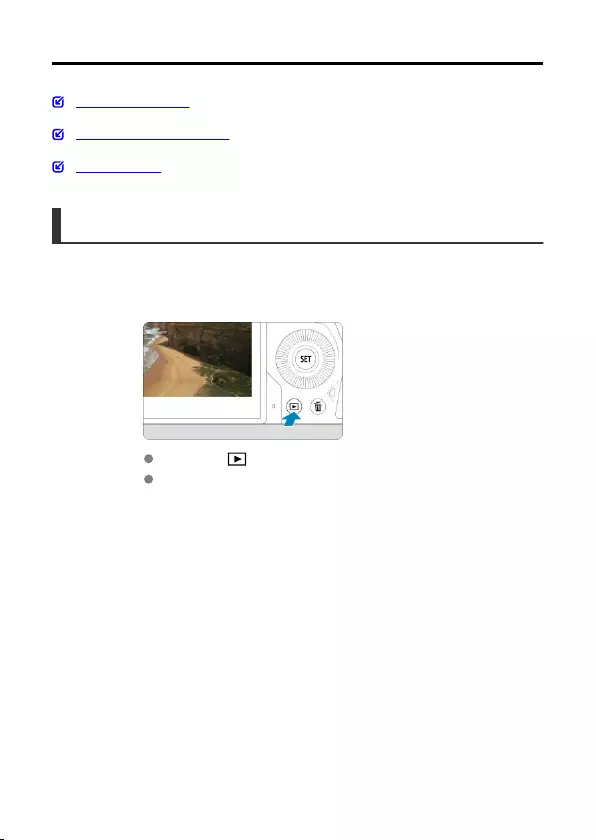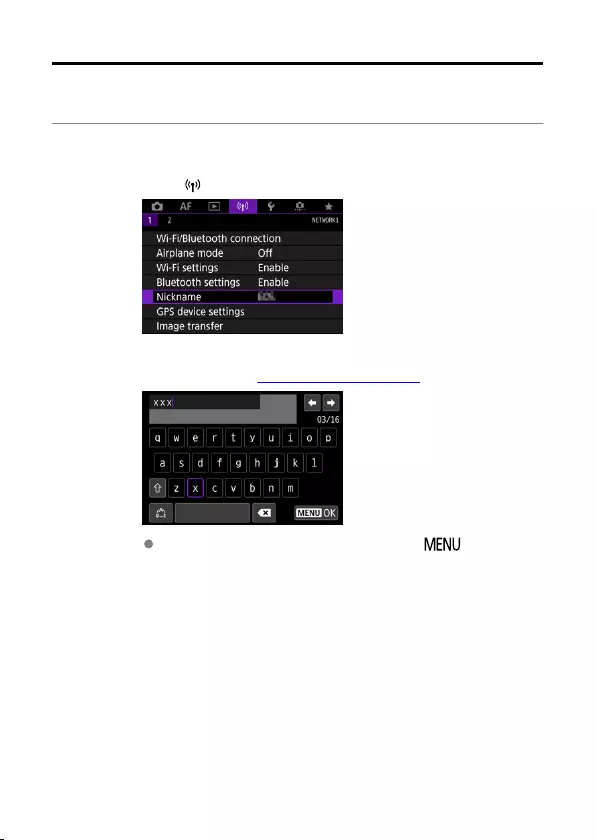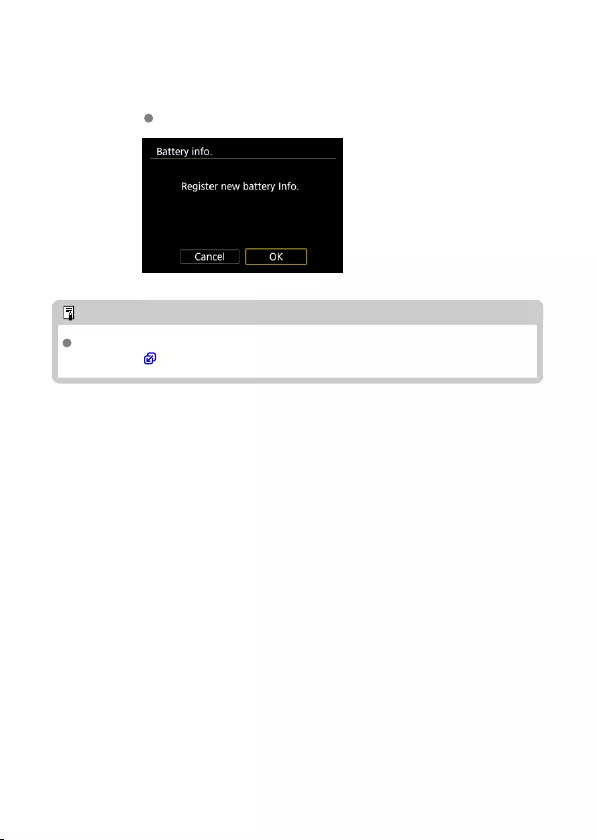Canon R5 User Manual
Displayed below is the user manual for R5 by Canon which is a product in the Digital Cameras category. This manual has pages.
Related Manuals

Advanced User Guide
E
CT2-D091-B © CANON INC. 2020

Contents
Introduction. . . . . . . . . . . . . . . . . . . . . . . . . . . . . . . . . . . . . . . . . . . . . . . . 9
Package Contents. . . . . . . . . . . . . . . . . . . . . . . . . . . . . . . . . . . . . . . . . . . . . . 10
Instruction Manuals. . . . . . . . . . . . . . . . . . . . . . . . . . . . . . . . . . . . . . . . . . . . . 12
Quick Start Guide. . . . . . . . . . . . . . . . . . . . . . . . . . . . . . . . . . . . . . . . . . . . . . . 13
About This Guide. . . . . . . . . . . . . . . . . . . . . . . . . . . . . . . . . . . . . . . . . . . . . . . 17
Compatible Cards. . . . . . . . . . . . . . . . . . . . . . . . . . . . . . . . . . . . . . . . . . . . . . 19
Safety Instructions. . . . . . . . . . . . . . . . . . . . . . . . . . . . . . . . . . . . . . . . . . . . . . 20
Handling Precautions. . . . . . . . . . . . . . . . . . . . . . . . . . . . . . . . . . . . . . . . . . . . 23
Part Names. . . . . . . . . . . . . . . . . . . . . . . . . . . . . . . . . . . . . . . . . . . . . . . . . . . 27
Software. . . . . . . . . . . . . . . . . . . . . . . . . . . . . . . . . . . . . . . . . . . . . . . . . . . . . . 41
Preparation and Basic Operations. . . . . . . . . . . . . . . . . . . . . . . . . . . . . 45
Charging the Battery. . . . . . . . . . . . . . . . . . . . . . . . . . . . . . . . . . . . . . . . . . . . 46
Inserting/Removing Batteries. . . . . . . . . . . . . . . . . . . . . . . . . . . . . . . . . . . . . . 49
Inserting/Removing Cards. . . . . . . . . . . . . . . . . . . . . . . . . . . . . . . . . . . . . . . . 52
Using the Screen. . . . . . . . . . . . . . . . . . . . . . . . . . . . . . . . . . . . . . . . . . . . . . . 59
Turning on the Power. . . . . . . . . . . . . . . . . . . . . . . . . . . . . . . . . . . . . . . . . . . . 61
Attaching/Detaching RF Lenses. . . . . . . . . . . . . . . . . . . . . . . . . . . . . . . . . . . . 65
Attaching/Detaching EF/EF-S Lenses. . . . . . . . . . . . . . . . . . . . . . . . . . . . . . . 69
Using the Viewfinder. . . . . . . . . . . . . . . . . . . . . . . . . . . . . . . . . . . . . . . . . . . . 73
Basic Operations. . . . . . . . . . . . . . . . . . . . . . . . . . . . . . . . . . . . . . . . . . . . . . . 74
Menu Operations and Settings. . . . . . . . . . . . . . . . . . . . . . . . . . . . . . . . . . . . . 89
Quick Control. . . . . . . . . . . . . . . . . . . . . . . . . . . . . . . . . . . . . . . . . . . . . . . . . . 95
Touch-Screen Operation. . . . . . . . . . . . . . . . . . . . . . . . . . . . . . . . . . . . . . . . . 96
Shooting Mode. . . . . . . . . . . . . . . . . . . . . . . . . . . . . . . . . . . . . . . . . . . . 98
A+: Fully Automatic Shooting (Scene Intelligent Auto). . . . . . . . . . . . . . . . . . 99
A+: Fully Automatic Techniques (Scene Intelligent Auto). . . . . . . . . . . . . . . 103
Fv: Flexible-Priority AE. . . . . . . . . . . . . . . . . . . . . . . . . . . . . . . . . . . . . . . . . . 106
P: Program AE. . . . . . . . . . . . . . . . . . . . . . . . . . . . . . . . . . . . . . . . . . . . . . . . 109
Tv: Shutter-Priority AE. . . . . . . . . . . . . . . . . . . . . . . . . . . . . . . . . . . . . . . . . . 112
Av: Aperture-Priority AE. . . . . . . . . . . . . . . . . . . . . . . . . . . . . . . . . . . . . . . . . 115

M: Manual Exposure. . . . . . . . . . . . . . . . . . . . . . . . . . . . . . . . . . . . . . . . . . . 119
BULB: Long (Bulb) Exposures. . . . . . . . . . . . . . . . . . . . . . . . . . . . . . . . . . . . 122
Shooting and Recording. . . . . . . . . . . . . . . . . . . . . . . . . . . . . . . . . . . . 126
Still Photo Shooting. . . . . . . . . . . . . . . . . . . . . . . . . . . . . . . . . . . . . . . . . . 127
Tab Menus: Still Photo Shooting. . . . . . . . . . . . . . . . . . . . . . . . . . . . . . . . . . 129
Image Quality. . . . . . . . . . . . . . . . . . . . . . . . . . . . . . . . . . . . . . . . . . . . . . . . . 135
Dual Pixel RAW. . . . . . . . . . . . . . . . . . . . . . . . . . . . . . . . . . . . . . . . . . . . . . . 141
Still Photo Cropping/Aspect Ratio. . . . . . . . . . . . . . . . . . . . . . . . . . . . . . . . . 143
Auto Exposure Bracketing (AEB). . . . . . . . . . . . . . . . . . . . . . . . . . . . . . . . . . 147
ISO Speed Settings for Still Photos. . . . . . . . . . . . . . . . . . . . . . . . . . . . . . . . 149
HDR PQ Settings. . . . . . . . . . . . . . . . . . . . . . . . . . . . . . . . . . . . . . . . . . . . . . 157
Auto Lighting Optimizer. . . . . . . . . . . . . . . . . . . . . . . . . . . . . . . . . . . . . . . . . 161
Highlight Tone Priority. . . . . . . . . . . . . . . . . . . . . . . . . . . . . . . . . . . . . . . . . . 163
Anti-Flicker Shooting. . . . . . . . . . . . . . . . . . . . . . . . . . . . . . . . . . . . . . . . . . . 164
Shooting with Speedlites. . . . . . . . . . . . . . . . . . . . . . . . . . . . . . . . . . . . . . . . 166
Flash Function Settings. . . . . . . . . . . . . . . . . . . . . . . . . . . . . . . . . . . . . . . . . 170
White Balance. . . . . . . . . . . . . . . . . . . . . . . . . . . . . . . . . . . . . . . . . . . . . . . . 183
White Balance Correction. . . . . . . . . . . . . . . . . . . . . . . . . . . . . . . . . . . . . . . 192
Color Space. . . . . . . . . . . . . . . . . . . . . . . . . . . . . . . . . . . . . . . . . . . . . . . . . . 196
Picture Style Selection. . . . . . . . . . . . . . . . . . . . . . . . . . . . . . . . . . . . . . . . . . 197
Picture Style Customization. . . . . . . . . . . . . . . . . . . . . . . . . . . . . . . . . . . . . . 201
Picture Style Registration. . . . . . . . . . . . . . . . . . . . . . . . . . . . . . . . . . . . . . . . 205
Clarity. . . . . . . . . . . . . . . . . . . . . . . . . . . . . . . . . . . . . . . . . . . . . . . . . . . . . . . 208
Lens Aberration Correction. . . . . . . . . . . . . . . . . . . . . . . . . . . . . . . . . . . . . . 209
Long Exposure Noise Reduction. . . . . . . . . . . . . . . . . . . . . . . . . . . . . . . . . . 216
High ISO Speed Noise Reduction. . . . . . . . . . . . . . . . . . . . . . . . . . . . . . . . . 218
Dust Delete Data Acquisition. . . . . . . . . . . . . . . . . . . . . . . . . . . . . . . . . . . . . 220
Multiple Exposures. . . . . . . . . . . . . . . . . . . . . . . . . . . . . . . . . . . . . . . . . . . . . 224
HDR Mode. . . . . . . . . . . . . . . . . . . . . . . . . . . . . . . . . . . . . . . . . . . . . . . . . . . 235
Focus Bracketing. . . . . . . . . . . . . . . . . . . . . . . . . . . . . . . . . . . . . . . . . . . . . . 240
Interval Timer Shooting. . . . . . . . . . . . . . . . . . . . . . . . . . . . . . . . . . . . . . . . . 244
Shutter Mode. . . . . . . . . . . . . . . . . . . . . . . . . . . . . . . . . . . . . . . . . . . . . . . . . 248
Releasing Shutter without Card. . . . . . . . . . . . . . . . . . . . . . . . . . . . . . . . . . . 250

Image Stabilizer (IS Mode). . . . . . . . . . . . . . . . . . . . . . . . . . . . . . . . . . . . . . . 251
Shooting with the Touch Shutter. . . . . . . . . . . . . . . . . . . . . . . . . . . . . . . . . . 254
Image Review. . . . . . . . . . . . . . . . . . . . . . . . . . . . . . . . . . . . . . . . . . . . . . . . 256
High-Speed Display. . . . . . . . . . . . . . . . . . . . . . . . . . . . . . . . . . . . . . . . . . . . 259
Metering Timer. . . . . . . . . . . . . . . . . . . . . . . . . . . . . . . . . . . . . . . . . . . . . . . . 261
Exposure Simulation. . . . . . . . . . . . . . . . . . . . . . . . . . . . . . . . . . . . . . . . . . . 262
Shooting Information Display. . . . . . . . . . . . . . . . . . . . . . . . . . . . . . . . . . . . . 263
Viewfinder Display Format. . . . . . . . . . . . . . . . . . . . . . . . . . . . . . . . . . . . . . . 275
Display Performance. . . . . . . . . . . . . . . . . . . . . . . . . . . . . . . . . . . . . . . . . . . 276
Metering Mode Selection. . . . . . . . . . . . . . . . . . . . . . . . . . . . . . . . . . . . . . . . 277
Manual Exposure Compensation. . . . . . . . . . . . . . . . . . . . . . . . . . . . . . . . . . 279
Exposure Lock (AE Lock). . . . . . . . . . . . . . . . . . . . . . . . . . . . . . . . . . . . . . . . 281
General Still Photo Shooting. . . . . . . . . . . . . . . . . . . . . . . . . . . . . . . . . . . . . 283
Movie Recording. . . . . . . . . . . . . . . . . . . . . . . . . . . . . . . . . . . . . . . . . . . . 286
Tab Menus: Movie Recording. . . . . . . . . . . . . . . . . . . . . . . . . . . . . . . . . . . . 288
Movie Recording. . . . . . . . . . . . . . . . . . . . . . . . . . . . . . . . . . . . . . . . . . . . . . 292
Movie Recording Quality. . . . . . . . . . . . . . . . . . . . . . . . . . . . . . . . . . . . . . . . 308
Recording Cropped Movies. . . . . . . . . . . . . . . . . . . . . . . . . . . . . . . . . . . . . . 320
Sound Recording. . . . . . . . . . . . . . . . . . . . . . . . . . . . . . . . . . . . . . . . . . . . . . 321
Canon Log Settings. . . . . . . . . . . . . . . . . . . . . . . . . . . . . . . . . . . . . . . . . . . . 325
HDR Movie Recording. . . . . . . . . . . . . . . . . . . . . . . . . . . . . . . . . . . . . . . . . . 332
Time-Lapse Movies. . . . . . . . . . . . . . . . . . . . . . . . . . . . . . . . . . . . . . . . . . . . 334
Movie Self-Timer. . . . . . . . . . . . . . . . . . . . . . . . . . . . . . . . . . . . . . . . . . . . . . 348
Image Stabilizer (IS Mode). . . . . . . . . . . . . . . . . . . . . . . . . . . . . . . . . . . . . . . 349
Shutter Button Function for Movies. . . . . . . . . . . . . . . . . . . . . . . . . . . . . . . . 353
Zebra Settings. . . . . . . . . . . . . . . . . . . . . . . . . . . . . . . . . . . . . . . . . . . . . . . . 355
Time Code. . . . . . . . . . . . . . . . . . . . . . . . . . . . . . . . . . . . . . . . . . . . . . . . . . . 358
Other Menu Functions. . . . . . . . . . . . . . . . . . . . . . . . . . . . . . . . . . . . . . . . . . 365
General Movie Recording Precautions. . . . . . . . . . . . . . . . . . . . . . . . . . . . . 375
AF/Drive. . . . . . . . . . . . . . . . . . . . . . . . . . . . . . . . . . . . . . . . . . . . . . . . 378
Tab Menus: AF (Still Photos). . . . . . . . . . . . . . . . . . . . . . . . . . . . . . . . . . . . . 379
Tab Menus: AF (Movie Recording). . . . . . . . . . . . . . . . . . . . . . . . . . . . . . . . 383
AF Operation. . . . . . . . . . . . . . . . . . . . . . . . . . . . . . . . . . . . . . . . . . . . . . . . . 386

Selecting the AF Method. . . . . . . . . . . . . . . . . . . . . . . . . . . . . . . . . . . . . . . . 390
Continuous AF. . . . . . . . . . . . . . . . . . . . . . . . . . . . . . . . . . . . . . . . . . . . . . . . 410
Movie Servo AF. . . . . . . . . . . . . . . . . . . . . . . . . . . . . . . . . . . . . . . . . . . . . . . 411
Touch & Drag AF Settings. . . . . . . . . . . . . . . . . . . . . . . . . . . . . . . . . . . . . . . 414
Manual Focus. . . . . . . . . . . . . . . . . . . . . . . . . . . . . . . . . . . . . . . . . . . . . . . . . 417
Servo AF Characteristics. . . . . . . . . . . . . . . . . . . . . . . . . . . . . . . . . . . . . . . . 426
Customizing AF Functions. . . . . . . . . . . . . . . . . . . . . . . . . . . . . . . . . . . . . . . 437
Selecting the Drive Mode. . . . . . . . . . . . . . . . . . . . . . . . . . . . . . . . . . . . . . . . 450
Using the Self-Timer. . . . . . . . . . . . . . . . . . . . . . . . . . . . . . . . . . . . . . . . . . . 453
Remote Control Shooting. . . . . . . . . . . . . . . . . . . . . . . . . . . . . . . . . . . . . . . . 455
Playback. . . . . . . . . . . . . . . . . . . . . . . . . . . . . . . . . . . . . . . . . . . . . . . . 460
Tab Menus: Playback. . . . . . . . . . . . . . . . . . . . . . . . . . . . . . . . . . . . . . . . . . . 462
Image Playback. . . . . . . . . . . . . . . . . . . . . . . . . . . . . . . . . . . . . . . . . . . . . . . 465
Magnified Image Display. . . . . . . . . . . . . . . . . . . . . . . . . . . . . . . . . . . . . . . . 471
Index Display (Multiple-Image Display). . . . . . . . . . . . . . . . . . . . . . . . . . . . . 474
Voice Memo Recording and Playback. . . . . . . . . . . . . . . . . . . . . . . . . . . . . . 477
Movie Playback. . . . . . . . . . . . . . . . . . . . . . . . . . . . . . . . . . . . . . . . . . . . . . . 483
Editing a Movie’s First and Last Scenes. . . . . . . . . . . . . . . . . . . . . . . . . . . . 486
4K/8K Movie Frame Grab. . . . . . . . . . . . . . . . . . . . . . . . . . . . . . . . . . . . . . . 489
Playback on a TV Set. . . . . . . . . . . . . . . . . . . . . . . . . . . . . . . . . . . . . . . . . . . 491
Protecting Images. . . . . . . . . . . . . . . . . . . . . . . . . . . . . . . . . . . . . . . . . . . . . 493
Erasing Images. . . . . . . . . . . . . . . . . . . . . . . . . . . . . . . . . . . . . . . . . . . . . . . 497
Rotating Still Photos. . . . . . . . . . . . . . . . . . . . . . . . . . . . . . . . . . . . . . . . . . . . 504
Changing Movie Orientation Information. . . . . . . . . . . . . . . . . . . . . . . . . . . . 506
Rating Images. . . . . . . . . . . . . . . . . . . . . . . . . . . . . . . . . . . . . . . . . . . . . . . . 508
Copying Images. . . . . . . . . . . . . . . . . . . . . . . . . . . . . . . . . . . . . . . . . . . . . . . 516
Print Ordering (DPOF). . . . . . . . . . . . . . . . . . . . . . . . . . . . . . . . . . . . . . . . . . 524
Photobook Set-up. . . . . . . . . . . . . . . . . . . . . . . . . . . . . . . . . . . . . . . . . . . . . 529
RAW Processing (RAW/DPRAW). . . . . . . . . . . . . . . . . . . . . . . . . . . . . . . . . 534
DPRAW Processing. . . . . . . . . . . . . . . . . . . . . . . . . . . . . . . . . . . . . . . . . . . . 543
Resizing JPEG/HEIF Images. . . . . . . . . . . . . . . . . . . . . . . . . . . . . . . . . . . . . 550
Cropping JPEG/HEIF Images. . . . . . . . . . . . . . . . . . . . . . . . . . . . . . . . . . . . 552
Converting HEIF to JPEG. . . . . . . . . . . . . . . . . . . . . . . . . . . . . . . . . . . . . . . 555

Slide Show. . . . . . . . . . . . . . . . . . . . . . . . . . . . . . . . . . . . . . . . . . . . . . . . . . . 557
Setting Image Search Conditions. . . . . . . . . . . . . . . . . . . . . . . . . . . . . . . . . . 560
Browsing Images with the Main Dial. . . . . . . . . . . . . . . . . . . . . . . . . . . . . . . 564
Switching the Main Dial and Quick Control Dial 2. . . . . . . . . . . . . . . . . . . . . 566
Rate/Voice Memo Button Function. . . . . . . . . . . . . . . . . . . . . . . . . . . . . . . . 567
Customizing Playback Information Display. . . . . . . . . . . . . . . . . . . . . . . . . . 569
Displaying the Highlight Alert. . . . . . . . . . . . . . . . . . . . . . . . . . . . . . . . . . . . . 573
AF Point Display. . . . . . . . . . . . . . . . . . . . . . . . . . . . . . . . . . . . . . . . . . . . . . . 574
Playback Grid. . . . . . . . . . . . . . . . . . . . . . . . . . . . . . . . . . . . . . . . . . . . . . . . . 575
Movie Play Count. . . . . . . . . . . . . . . . . . . . . . . . . . . . . . . . . . . . . . . . . . . . . . 576
HDMI HDR Output. . . . . . . . . . . . . . . . . . . . . . . . . . . . . . . . . . . . . . . . . . . . . 578
Wireless Features. . . . . . . . . . . . . . . . . . . . . . . . . . . . . . . . . . . . . . . . 579
Tab Menus: Wireless Features. . . . . . . . . . . . . . . . . . . . . . . . . . . . . . . . . . . 580
Wi-Fi/Bluetooth Connection. . . . . . . . . . . . . . . . . . . . . . . . . . . . . . . . . . . . . . 582
Connecting to a Smartphone. . . . . . . . . . . . . . . . . . . . . . . . . . . . . . . . . . . . . 584
Connecting to a Computer via Wi-Fi. . . . . . . . . . . . . . . . . . . . . . . . . . . . . . . 626
Sending Images to a Web Service. . . . . . . . . . . . . . . . . . . . . . . . . . . . . . . . . 642
Image Transfer to FTP Servers. . . . . . . . . . . . . . . . . . . . . . . . . . . . . . . . . . . 649
Wi-Fi Connection via Access Points. . . . . . . . . . . . . . . . . . . . . . . . . . . . . . . 673
Connecting to a Wireless Remote Control. . . . . . . . . . . . . . . . . . . . . . . . . . . 681
Reconnecting via Wi-Fi. . . . . . . . . . . . . . . . . . . . . . . . . . . . . . . . . . . . . . . . . 686
Registering Multiple Connection Settings. . . . . . . . . . . . . . . . . . . . . . . . . . . 688
Airplane Mode. . . . . . . . . . . . . . . . . . . . . . . . . . . . . . . . . . . . . . . . . . . . . . . . 690
Wi-Fi Settings. . . . . . . . . . . . . . . . . . . . . . . . . . . . . . . . . . . . . . . . . . . . . . . . . 691
Bluetooth Settings. . . . . . . . . . . . . . . . . . . . . . . . . . . . . . . . . . . . . . . . . . . . . 692
Nickname. . . . . . . . . . . . . . . . . . . . . . . . . . . . . . . . . . . . . . . . . . . . . . . . . . . . 693
GPS Device Settings. . . . . . . . . . . . . . . . . . . . . . . . . . . . . . . . . . . . . . . . . . . 694
Changing or Deleting Connection Settings. . . . . . . . . . . . . . . . . . . . . . . . . . 699
Resetting Communication Settings. . . . . . . . . . . . . . . . . . . . . . . . . . . . . . . . 702
View Info Screen. . . . . . . . . . . . . . . . . . . . . . . . . . . . . . . . . . . . . . . . . . . . . . 703
Virtual Keyboard Operations. . . . . . . . . . . . . . . . . . . . . . . . . . . . . . . . . . . . . 704
Responding to Error Messages. . . . . . . . . . . . . . . . . . . . . . . . . . . . . . . . . . . 705
Wireless Communication Function Precautions. . . . . . . . . . . . . . . . . . . . . . . 719

Security. . . . . . . . . . . . . . . . . . . . . . . . . . . . . . . . . . . . . . . . . . . . . . . . . . . . . 720
Checking Network Settings. . . . . . . . . . . . . . . . . . . . . . . . . . . . . . . . . . . . . . 721
Wireless Communication Status. . . . . . . . . . . . . . . . . . . . . . . . . . . . . . . . . . 722
Set-up. . . . . . . . . . . . . . . . . . . . . . . . . . . . . . . . . . . . . . . . . . . . . . . . . . 724
Tab Menus: Set-up. . . . . . . . . . . . . . . . . . . . . . . . . . . . . . . . . . . . . . . . . . . . . 725
Selecting Cards for Recording/Playback. . . . . . . . . . . . . . . . . . . . . . . . . . . . 729
Folder Settings. . . . . . . . . . . . . . . . . . . . . . . . . . . . . . . . . . . . . . . . . . . . . . . . 736
File Numbering. . . . . . . . . . . . . . . . . . . . . . . . . . . . . . . . . . . . . . . . . . . . . . . . 740
File Naming. . . . . . . . . . . . . . . . . . . . . . . . . . . . . . . . . . . . . . . . . . . . . . . . . . 745
Formatting. . . . . . . . . . . . . . . . . . . . . . . . . . . . . . . . . . . . . . . . . . . . . . . . . . . 748
Auto Rotate. . . . . . . . . . . . . . . . . . . . . . . . . . . . . . . . . . . . . . . . . . . . . . . . . . 751
Adding Orientation Information to Movies. . . . . . . . . . . . . . . . . . . . . . . . . . . 753
Date/Time/Zone. . . . . . . . . . . . . . . . . . . . . . . . . . . . . . . . . . . . . . . . . . . . . . . 755
Language. . . . . . . . . . . . . . . . . . . . . . . . . . . . . . . . . . . . . . . . . . . . . . . . . . . . 759
Video System. . . . . . . . . . . . . . . . . . . . . . . . . . . . . . . . . . . . . . . . . . . . . . . . . 760
Help. . . . . . . . . . . . . . . . . . . . . . . . . . . . . . . . . . . . . . . . . . . . . . . . . . . . . . . . 761
Beeps. . . . . . . . . . . . . . . . . . . . . . . . . . . . . . . . . . . . . . . . . . . . . . . . . . . . . . . 764
Headphone Volume. . . . . . . . . . . . . . . . . . . . . . . . . . . . . . . . . . . . . . . . . . . . 765
Power Saving. . . . . . . . . . . . . . . . . . . . . . . . . . . . . . . . . . . . . . . . . . . . . . . . . 766
Eco Mode. . . . . . . . . . . . . . . . . . . . . . . . . . . . . . . . . . . . . . . . . . . . . . . . . . . . 767
Screen/Viewfinder Display. . . . . . . . . . . . . . . . . . . . . . . . . . . . . . . . . . . . . . . 768
Screen Brightness. . . . . . . . . . . . . . . . . . . . . . . . . . . . . . . . . . . . . . . . . . . . . 770
Viewfinder Brightness. . . . . . . . . . . . . . . . . . . . . . . . . . . . . . . . . . . . . . . . . . 771
Screen and Viewfinder Color Tone. . . . . . . . . . . . . . . . . . . . . . . . . . . . . . . . 772
Fine-Tuning Viewfinder Color Tone. . . . . . . . . . . . . . . . . . . . . . . . . . . . . . . . 773
UI Magnification. . . . . . . . . . . . . . . . . . . . . . . . . . . . . . . . . . . . . . . . . . . . . . . 774
HDMI Resolution. . . . . . . . . . . . . . . . . . . . . . . . . . . . . . . . . . . . . . . . . . . . . . 775
Touch Control. . . . . . . . . . . . . . . . . . . . . . . . . . . . . . . . . . . . . . . . . . . . . . . . . 776
Multi-Function Lock. . . . . . . . . . . . . . . . . . . . . . . . . . . . . . . . . . . . . . . . . . . . 777
Shutter at Shutdown. . . . . . . . . . . . . . . . . . . . . . . . . . . . . . . . . . . . . . . . . . . . 778
Sensor Cleaning. . . . . . . . . . . . . . . . . . . . . . . . . . . . . . . . . . . . . . . . . . . . . . . 779
Resetting the Camera. . . . . . . . . . . . . . . . . . . . . . . . . . . . . . . . . . . . . . . . . . 784
Custom Shooting Mode (C1-C3). . . . . . . . . . . . . . . . . . . . . . . . . . . . . . . . . . 786

Battery Information. . . . . . . . . . . . . . . . . . . . . . . . . . . . . . . . . . . . . . . . . . . . . 789
Copyright Information. . . . . . . . . . . . . . . . . . . . . . . . . . . . . . . . . . . . . . . . . . . 797
Other Information. . . . . . . . . . . . . . . . . . . . . . . . . . . . . . . . . . . . . . . . . . . . . . 800
Custom Functions/My Menu. . . . . . . . . . . . . . . . . . . . . . . . . . . . . . . . . 801
Tab Menus: Customization. . . . . . . . . . . . . . . . . . . . . . . . . . . . . . . . . . . . . . 802
Custom Function Setting Items. . . . . . . . . . . . . . . . . . . . . . . . . . . . . . . . . . . 805
Tab Menus: My Menu. . . . . . . . . . . . . . . . . . . . . . . . . . . . . . . . . . . . . . . . . . 832
Registering My Menu. . . . . . . . . . . . . . . . . . . . . . . . . . . . . . . . . . . . . . . . . . . 833
Reference. . . . . . . . . . . . . . . . . . . . . . . . . . . . . . . . . . . . . . . . . . . . . . . 840
Importing Images to a Computer. . . . . . . . . . . . . . . . . . . . . . . . . . . . . . . . . . 841
Using a USB Power Adapter to Charge/Power the Camera. . . . . . . . . . . . . 845
Using a Battery Grip. . . . . . . . . . . . . . . . . . . . . . . . . . . . . . . . . . . . . . . . . . . . 848
Troubleshooting Guide. . . . . . . . . . . . . . . . . . . . . . . . . . . . . . . . . . . . . . . . . . 860
Error Codes. . . . . . . . . . . . . . . . . . . . . . . . . . . . . . . . . . . . . . . . . . . . . . . . . . 877
System Map. . . . . . . . . . . . . . . . . . . . . . . . . . . . . . . . . . . . . . . . . . . . . . . . . . 878
ISO Speed in Movie Recording. . . . . . . . . . . . . . . . . . . . . . . . . . . . . . . . . . . 881
Information Display. . . . . . . . . . . . . . . . . . . . . . . . . . . . . . . . . . . . . . . . . . . . 882
EF Lenses Supporting 12 Shots/Sec. Continuous Shooting. . . . . . . . . . . . . 896
Specifications. . . . . . . . . . . . . . . . . . . . . . . . . . . . . . . . . . . . . . . . . . . . . . . . . 898
Trademarks and Licensing. . . . . . . . . . . . . . . . . . . . . . . . . . . . . . . . . . 917

Introduction
Before starting to shoot, be sure to read the following
To avoid shooting problems and accidents, first read the Safety Instructions and Handling
Precautions. Also read this Advanced User Guide carefully to ensure that you use the
camera correctly.
Take some test shots, and understand about product liability
After shooting, play images back and check whether they have been properly recorded. If
the camera or memory card is faulty and images cannot be recorded or transferred to a
computer, Canon cannot be held liable for any loss or inconvenience caused.
Copyrights
Copyright laws in some countries prohibit the unauthorized use of images recorded with the
camera (or music/images with music transferred to the memory card) for purposes other
than personal enjoyment.
Also be aware that certain public performances, exhibitions, etc. may prohibit photography
even for private enjoyment.
Connecting other devices
Use the included interface cable or a Canon cable when connecting the camera to a
computer or other device. When connecting an interface cable, also use the included
cable protector ( ).
•Package Contents
•Instruction Manuals
•Quick Start Guide
•About This Guide
•Compatible Cards
•Safety Instructions
•Handling Precautions
•Part Names
•Software
9

Package Contents
Before use, make sure the following items are included in the package. If anything is
missing, contact your dealer.
Camera
(with body cap)
Battery Pack LP-E6NH
(with protective cover)
Battery Charger LC-E6/LC-E6E*
Strap
Interface Cable IFC-100U
Cable Protector
* Battery Charger LC-E6 or LC-E6E is provided. (The LC-E6E comes with a power cord.)
The camera does not come with a memory card ( ) or HDMI cable.
If you purchased a Lens Kit, check that the lenses are included.
Be careful not to lose any of these items.
No software CD-ROM is included. Software ( ) can be downloaded from the Canon
website.
10

Caution
When you need Lens Instruction Manuals, download them from the Canon website
( ).
The Lens Instruction Manuals (PDF files) are for lenses sold individually. Note that
when purchasing the Lens Kit, some of the accessories included with the lens may
not match those listed in the Lens Instruction Manual.
11

Instruction Manuals
The Instruction Manual included with the camera provides basic instructions for the
camera and Wi-Fi functions.
Advanced User Guide
Complete instructions are provided in this Advanced User Guide.
For the latest Advanced User Guide, refer to the following website.
https://cam.start.canon/C003/
Lens/Software Instruction Manual
Download from the following website.
https://cam.start.canon/
Note
Select [ : Manual/software URL] to display the QR code on the camera screen.
12

Set the shooting mode to [ ] ( ).
Press the < > button, then turn the < > dial to select [ ].
All the necessary camera settings will be set automatically.
Focus on the subject ( ).
An AF point [ ] appears over any face detected.
Press the shutter button halfway, and the camera will focus on the
subject.
Take the picture ( ).
Press the shutter button completely to take the picture.
15
7.
8.
9.

About This Guide
Icons in This Guide
Basic Assumptions for Operational Instructions and Sample Photos
Icons in This Guide
<>Indicates the Main dial.
< > Indicates Quick control dial 1.
< > Indicates Quick control dial 2.
< > Indicates the Multi-controller.
< > Indicates the lens control ring.
< > Indicates the Set button.
*Indicates the duration (in * seconds) of the operation for the button you pressed, as
timed after you release the button.
In addition to the above, the icons and symbols used on the camera’s buttons and
displayed on the screen are also used in this guide when discussing relevant operations
and functionality.
to the right of titles indicates functions only available in [ ], [ ], [ ], [ ],
[ ], or [ ] mode.
Links to pages with related topics.
Warning to prevent shooting problems.
Supplemental information.
Tips or advice for better shooting.
Troubleshooting advice.
17

Basic Assumptions for Operational Instructions and
Sample Photos
Before following any instructions, make sure the power switch is set to < > and the
Multi-function lock feature is off ( , ).
It is assumed that all the menu settings and Custom Functions are set to their defaults.
Illustrations in this guide show the camera with the RF24-105mm F4 L IS USM lens
attached as an example.
Sample photos displayed on the camera and used in this guide are for illustration only.
In references to using EF or EF-S lenses, it is assumed that a mount adapter is used.
18

Compatible Cards
The following cards can be used with the camera regardless of capacity. If the card is new
or was previously formatted (initialized) by another camera or computer, format it
with this camera ( ).
CFexpress cards
* Type-B compatible
SD/SDHC/SDXC memory cards
UHS-II and UHS-I cards supported.
Cards That Can Record Movies
When recording movies, use a card with ample performance (fast enough writing and
reading speeds) for the movie recording quality ( ).
In this manual, “CFexpress card” refers specifically to CFexpress cards, “SD card”
refers to SD/SDHC/SDXC memory cards collectively, and “card” refers to all memory
cards in general.
*A card is not included. Please purchase it separately.
19

WARNING:
Safety Instructions
Be sure to read these instructions in order to operate the product safely.
Follow these instructions to prevent injury or harm to the operator of the product or others.
Denotes the risk of serious injury or death.
Keep the product out of the reach of young children.
A strap wrapped around a person's neck may result in strangulation.
The parts or provided items of cameras or accessories are dangerous if swallowed. If
swallowed, seek immediate medical assistance.
The battery is dangerous if swallowed. If swallowed, seek immediate medical assistance.
Use only power sources specified in this instruction manual for use with the product.
Do not disassemble or modify the product.
Do not expose the product to strong shocks or vibration.
Do not touch any exposed internal parts.
Stop using the product in any case of unusual circumstances such as the presence of
smoke or a strange smell.
Do not use organic solvents such as alcohol, benzine or paint thinner to clean the
product.
Do not get the product wet. Do not insert foreign objects or liquids into the product.
Do not use the product where flammable gases may be present.
This may cause electric shock, explosion or fire.
Do not leave a lens or a camera/camcorder with a lens attached, exposed without the
lens cap attached.
The lens may concentrate the light and cause fire.
Do not touch the product connected to a power outlet during lightning storms.
This may cause electric shock.
Observe the following instructions when using a battery charger or AC adapter.
• Use batteries/battery packs only with their specified product.
• Do not heat batteries/battery packs or expose them to fire.
• Do not charge batteries/battery packs using non-authorized battery chargers.
• Do not expose the terminals to dirt or let them come into contact with metallic pins
or other metal objects.
• Do not use leaking batteries/battery packs.
• When disposing of batteries/battery packs, insulate the terminals with tape or other
means.
• Do not touch the battery charger or AC adapter connected to a power outlet during
lightning storms.
This may cause electric shock, explosion or fire.
If a battery/battery pack leaks and the material contacts your skin or clothing, flush the
exposed area thoroughly with running water. In case of eye contact, flush thoroughly with
copious amounts of clean running water and seek immediate medical assistance.
20

Observe the following instructions when using a battery charger.
• Periodically remove any dust buildup from the power plug and power outlet using a
dry cloth.
• Do not plug in or unplug the product with wet hands.
• Do not use the product if the power plug is not fully inserted into the power outlet.
• Do not expose the power plug and terminals to dirt or let them come into contact
with metallic pins or other metal objects.
Do not place heavy objects on the power cord. Do not damage, break or modify the
power cord.
Do not wrap the product in cloth or other materials when in use or shortly after use when
the product is still warm in temperature.
Do not unplug the product by pulling the power cord.
Do not leave the product connected to a power source for long periods of time.
Do not charge batteries/battery packs at temperatures outside the range of 5 - 40 °C
(41 - 104 °F).
This may cause electric shock, explosion or fire.
Do not allow the product to maintain contact with the same area of skin for extended
periods of time during use.
This may result in low-temperature contact burns, including skin redness and blistering,
even if the product does not feel hot. The use of a tripod or similar equipment is
recommended when using the product in hot places and for people with circulation problems
or less sensitive skin.
Follow any indications to turn off the product in places where its use is forbidden.
Not doing so may cause other equipment to malfunction due to the effect of electromagnetic
waves and even result in accidents.
21

CAUTION: Follow the cautions below. Otherwise
physical injury or property damage may
result.
Do not fire the flash near the eyes.
It may hurt the eyes.
Do not look at the screen or through the viewfinder for prolonged periods of time.
This may induce symptoms similar to motion sickness. In such a case, stop using the
product immediately and rest for a while before resuming use.
Flash emits high temperatures when fired. Keep fingers, any other part of your body,
and objects away from the flash unit while taking pictures.
This may cause burns or malfunction of the flash.
Do not leave the product in places exposed to extremely high or low temperatures.
The product may become extremely hot/cold and cause burns or injury when touched.
Strap is intended for use on the body only. Hanging the strap with any product attached
on a hook or other object may damage the product. Also, do not shake the product or
expose the product to strong impacts.
Do not apply strong pressure on the lens or allow an object to hit it.
This may cause injury or damage to the product.
Only mount the product on a tripod that is sufficiently sturdy.
Do not carry the product when it is mounted on a tripod.
This may cause injury or may result in an accident.
Do not touch any parts inside the product.
This may cause injury.
If any abnormal skin reaction or irritation occurs during or following the use of this
product, refrain from further use and get medical advice/attention.
22

Handling Precautions
Camera care
This camera is a precision instrument. Do not drop it or subject it to physical shock.
The camera is not waterproof and cannot be used underwater.
To maximize the camera’s dust- and drip- resistance, keep the terminal cover, battery
compartment cover, card slot cover, and all other covers firmly closed.
This camera is designed to be dust- and drip- resistant, in order to help prevent sand,
dust, dirt, or water that falls on it unexpectedly from getting inside, but it is impossible to
prevent dirt, dust, water, or salt from getting inside at all. As far as possible, do not allow
dirt, dust, water, or salt to get on the camera.
If water gets on the camera, wipe it off with a dry and clean cloth. If dirt, dust, or salt gets
on the camera, wipe it off with a clean, well-wrung wet cloth.
Using the camera in dusty or dirty locations may lead to damage.
Cleaning the camera after use is recommended. Allowing dirt, dust, water, or salt to
remain on the camera may cause a malfunction.
If you accidentally drop the camera into water or are concerned that moisture (water),
dirt, dust, or salt may have gotten inside it, promptly consult the nearest Canon Service
Center.
Never leave the camera near anything having a strong magnetic field such as a magnet
or electric motor. Also, avoid using or leaving the camera near anything emitting strong
radio waves, such as a large antenna. Strong magnetic fields can cause camera
malfunction or destroy image data.
Do not leave the camera in excessive heat, such as in a car in direct sunlight. High
temperatures can cause the camera to malfunction.
The camera contains precision electronic circuitry. Never attempt to disassemble the
camera yourself.
Do not block shutter curtain operation with your finger or other objects. Doing so may
cause a malfunction.
Only use a commercially available blower to blow away dust on the lens, viewfinder, or
other parts. Do not use cleaners that contain organic solvents to clean the camera body
or lens. For stubborn dirt, take the camera to the nearest Canon Service Center.
Do not touch the camera’s electrical contacts with your fingers. This is to prevent the
contacts from corroding. Corroded contacts can cause camera malfunction.
If the camera is suddenly brought in from the cold into a warm room, condensation may
form on the camera and internal parts. To prevent condensation, first put the camera in
a sealed plastic bag and let it adjust to the warmer temperature before taking it out of
the bag.
If condensation forms on the camera, to avoid damage, do not use the camera or
remove the lens, card, or battery. Turn the camera off and wait until the moisture has
fully evaporated before resuming use. Even after the camera is completely dry, if it is still
internally cold, do not remove the lens, card, or battery until the camera has adjusted to
the ambient temperature.
If the camera will not be used for an extended period, remove the battery and store the
camera in a cool, dry, well-ventilated location. Even while the camera is in storage,
press the shutter button a few times once in a while to check that the camera is still
working.
Avoid storing the camera where there are chemicals that result in rust and corrosion
such as in a chemical lab.
23

If the camera has not been used for an extended period, test all its functions before
using it. If you have not used the camera for some time or if there is an important shoot
such as a foreign trip coming up, have the camera checked by your nearest Canon
Service Center or check the camera yourself and make sure it is working properly.
The camera may become hot after repeated continuous shooting or still photo/movie
shooting over an extended period. This is not a malfunction.
If there is a bright light source inside or outside the image area, ghosting may occur.
Screen, viewfinder, and LCD panel
Although the screen and viewfinder are manufactured with very high precision
technology with over 99.99% effective pixels, 0.01% or fewer of the pixels may be dead,
and there may also be spots of black, red, or other colors. This is not a malfunction.
They do not affect the images recorded.
If the screen is left on for a prolonged period, screen burn-in may occur where you see
remnants of what was displayed. However, this is only temporary and will disappear
when the camera is left unused for a few days.
The screen display may seem slightly slow in low temperatures or may look black in
high temperatures. It will return to normal at room temperature.
Cards
To protect the card and its recorded data, note the following:
Do not drop, bend, or wet the card. Do not subject it to excessive force, physical shock,
or vibration.
Do not touch the card’s electronic contacts with your fingers or anything metallic.
Do not affix any stickers, etc. on the card.
Do not store or use the card near anything that has a strong magnetic field, such as a
television, speakers, or magnets. Also avoid places prone to having static electricity.
Do not leave the card in direct sunlight or near a heat source.
Store the card in a case.
Do not store the card in hot, dusty, or humid locations.
24

Lens
After detaching the lens from the camera, put down the lens with the rear end up and
attach the rear lens cap to avoid scratching the lens surface and electrical contacts
(1).
25

Smudges on the image sensor
Besides dust entering the camera from outside, in rare cases, lubricant from the camera’s
internal parts may adhere to the front of the sensor. If smudges are visible on images, have
the sensor cleaned by a nearest Canon Service Center.
Battery
Tips for using the battery and charger
Store in a cool, dry, well-ventilated location.
When storing the battery for extended periods, charge it about once a year.
When charging the battery, aim to charge it to approx. 50% instead of fully charging it
( ).
At room temperature (23°C/73°F), it takes approx. 60 min. to charge a depleted battery
to about approx. 50%. Battery charging time varies greatly depending on ambient
temperature.
If the battery is not used for an extended period, the trace amount of current that
continues to flow inside the battery when it is removed from the camera may eventually
lead to over-discharge and prevent further use, even after charging.
26

(1) < > button
(2) Movie shooting button
(3) < > Main dial
(4) < > Multi-function button
(5) Shutter button
(6) < > LCD panel info switching/illumination button
(7) Self-timer lamp/AF-assist beam
(8) Remote control sensor
(9) Grip (battery compartment)
(10) DC coupler cord hole
(11) Depth-of-field preview button
(12) Contacts
(13) Lens mount
(14) Flash sync contacts
(15) Hot shoe
(16) RF lens mount index
(17) Power switch
(18) Strap mount
(19) < > Focal plane mark
(20) Microphone
(21) Shutter curtain/image sensor
(22) Lens release button
(23) Lens lock pin
(24) Remote control terminal
(25) Body cap
28

(15)
(20)
(6)
(8)
(7)
(12)
(13)
(14)
(9)
(10)
(11)
(16)
(17)
(19)
(3)
(4)
(5)
(21)
(24)
(25)
(22)
(23)
(2)
(1)
(18)
29

(1) Eyecup
(2) Viewfinder eyepiece
(3) < > Menu button
(4) Speaker
(5) Terminal cover
(6) LCD panel
(7) < > Multi-function lock button
(8) < > Quick control dial 2
(9) < > AF start button
(10) < > Multi-controller (can also be pressed straight in)
(11) < > Magnify/Reduce button
(12) < > Quick Control button
(13) < > Info button
(14) < > Set button
(15) Access lamp
(16) < > Erase button
(17) < > Playback button
(18) Voice memo microphone
(19) Viewfinder sensor
(20) < > Rating/Voice memo button
(21) < > External microphone IN terminal
(22) < > Digital terminal
(23) < > HDMI micro OUT terminal
(24) < > Headphone terminal
(25) < > PC terminal
30

(1) Dioptric adjustment knob
(2) Accessory positioning hole
(3) Screen
(4) Tripod socket
(5) Serial number (body number)
(6) < > AE lock button
(7) < > AF point selection button
(8) Strap mount
(9) Card slot cover
(10) Card eject button
(11) Card slot 2
(12) Card slot 1
(13) Battery compartment cover lock
(14) Battery compartment cover
(15) < > Quick control dial 1
31

LCD Panel Information Display
Information displayed varies depending on camera status. For icon details, see Information
Display.
Viewfinder information display
Information displayed varies depending on camera status.
Battery Charger LC-E6
Charger for Battery Pack LP-E6NH/LP-E6N/LP-E6 ( ).
(1) Battery slot
(2) Charge lamp
(3) Power plug
32

Attaching the Strap
Pass the end of the strap through the strap mount from the bottom, then pass it through the
strap buckle as shown. Pull the strap to take up any slack and make sure the strap will not
loosen from the buckle.
34

Using the Cable Protector
When connecting the camera to a computer, use the included interface cable or a Canon
cable.
When connecting an interface cable, also use the included cable protector. Using the
cable protector helps prevent accidental disconnection and terminal damage.
Using the included interface cable and a commercially available
HDMI cable
1.
(1) Cable protector
(2) Clamp
2.
35

3.
Using a slim cable
36

Using a thick cable
(3) Included interface cable
4.
Using a slim cable
Using a thick cable
37

5.
Using a slim cable
Using a thick cable
38

6.
Using a slim cable
Using a thick cable
(4) HDMI cable (sold separately)
39

Using an optional Canon interface cable
When using an optional Canon interface cable, pass the cable through the clamp (5) as
shown before attaching the clamp to the cable protector.
Caution
Using the camera when the interface cable is connected without the cable protector
may damage the digital terminal.
Make sure the interface cable is securely connected to the digital terminal.
Note
Use a commercially available HDMI cable when connecting the camera to a
television. Also consider using the cable protector when connecting an HDMI cable.
40

Software
Software Overview
Downloading and Installing EOS Software or Other Dedicated Software
Downloading the Software Instruction Manual
Software Overview
This section summarizes software used with EOS cameras. Note that downloading and
installing the software requires an internet connection. The software cannot be downloaded
or installed in environments without an internet connection.
EOS Utility
Enables you to transfer your captured still photos and movies from the camera to a
connected computer, set various camera settings from the computer, and shoot remotely
from the computer.
Digital Photo Professional
Software recommended for users who shoot RAW images. Enables image viewing, editing,
printing, and more.
Picture Style Editor
Enables you to edit existing Picture Styles or create and save original Picture Style files.
This software is for users who are familiar with image processing.
GPS Log File Utility
Utility for converting GPS log files (.LOG) to KMZ format.
41

Downloading and Installing EOS Software or Other
Dedicated Software
Always install the latest version of the software.
Update any previous versions that are installed by overwriting them with the latest version.
Caution
Do not connect the camera to a computer before you install the software. The
software will not be installed correctly.
The software cannot be installed unless the computer is connected to the internet.
Previous versions cannot display images from this camera correctly. Also,
processing RAW images from this camera is not possible.
42

1. Download the software.
Connect to the internet from a computer and access the following
Canon website.
https://cam.start.canon/
Select your country or region of residence and download the software.
Depending on the software, you may need to enter the camera’s serial
number. The serial number is on the bottom of the camera.
Decompress it on the computer.
For Windows
Click the displayed installer file to start the installer.
For macOS
A dmg file will be created and displayed. Follow the steps below to
startup the installer.
1.Double-click the dmg file.
• A drive icon and installer file will appear on the desktop.
If the installer file does not appear, double-click the drive
icon to display it.
2.Double-click the installer file.
• The installer starts.
2. Follow the on-screen instructions to install the software.
43

Preparation and Basic Operations
This chapter describes preparatory steps before you start shooting and the basic camera
operations.
•Charging the Battery
•Inserting/Removing Batteries
•Inserting/Removing Cards
•Using the Screen
•Turning on the Power
•Attaching/Detaching RF Lenses
•Attaching/Detaching EF/EF-S Lenses
•Using the Viewfinder
•Basic Operations
•Menu Operations and Settings
•Quick Control
•Touch-Screen Operation
45

Charging the Battery
1. Detach the protective cover provided with the battery.
2. Fully insert the battery into the charger.
Do the opposite to remove the battery.
46

3. Recharge the battery.
For LC-E6
As shown by the arrow, fl ip out the battery charger’s prongs and insert
the prongs into a power outlet.
For LC-E6E
Connect the power cord to the charger and insert the plug into a power
outlet.
Recharging starts automatically and the charge lamp blinks in orange.
Charge Level
Charge Lamp
Color Display
0–49%
Orange
Blinks once per second
50–74% Blinks twice per second
75% or higher Blinks three times per second
Fully charged Green Turned on
Charging a depleted battery takes approx. 2 hr. and 30 min. at room temperature
(23°C/73°F). The time required to charge the battery will vary greatly depending on the
ambient temperature and the battery’s remaining capacity.
For safety, charging in low temperatures (5–10°C/41–50°F) takes longer (up to approx.
4 hr.).
47

Upon purchase, the battery is not fully charged.
Charge the battery before use.
Charge the battery on the day before or on the day it is to be used.
Charged batteries gradually lose their charge, even when they are not used.
After charging the battery, remove it and disconnect the charger from the power
outlet.
You can attach the protective cover in a different orientation to indicate whether
the battery is charged or not.
If the battery is charged, attach the provided protective cover so that the battery-shaped
hole < > is aligned over the blue sticker on the battery. If the battery is exhausted,
attach the protective cover in the opposite orientation.
When not using the camera, remove the battery.
If the battery is left in the camera for a prolonged period, a small amount of power
current will keep being released, resulting in excess discharge and shorter battery life.
Store the battery with the protective cover attached. Storing the battery when it is fully
charged may lower the battery performance.
The battery charger can also be used in foreign countries.
The battery charger is compatible with a 100 V AC to 240 V AC 50/60 Hz power source.
If necessary, attach a commercially available plug adapter for the respective country or
region. To avoid damage, do not connect to portable voltage transformers.
If the battery becomes exhausted quickly even after having been fully charged,
the battery has reached the end of its service life.
Check the battery recharge performance ( ) and purchase a new battery, as needed.
Caution
After disconnecting the charger’s power plug, do not touch the prongs for approx.
10 sec.
If the battery’s remaining capacity ( ) is 94% or higher, the battery will not be
charged.
The provided charger cannot charge any battery other than Battery Pack LP-E6NH/
LP-E6N/LP-E6.
48

Inserting/Removing Batteries
Insertion
Removal
Insert a fully charged Battery Pack LP-E6NH (or LP-E6N/LP-E6) in the camera.
Insertion
1. Slide the battery compartment cover lock and open the cover.
2. Insert the battery.
Insert the end with the electrical contacts.
Insert the battery until it locks in place.
49

3. Close the cover.
Press the cover until it snaps shut.
Caution
You cannot use batteries other than Battery Pack LP-E6NH/LP-E6N/LP-E6.
50

Inserting/Removing Cards
Insertion
Formatting the Card
Removal
This camera accepts two cards. Recording is possible as long as there is at least one
card in the camera.
With two cards inserted, you can select one card to record to, or you can record the same
image to both cards at once ( ).
Caution
Make sure the SD card’s write-protect switch (1) is set upward to enable
writing and erasing.
Insertion
1. Slide the cover to open it.
52

2. Insert the card.
Card 1 (CFexpress card)
Card 2 (SD card)
The card in the rear card slot is [ ] (CFexpress card), and the one in
front of it is [ ] (SD card).
CFexpress card: With the card label facing you, insert the open side of
the card (2) into the card slot. Inserting cards the wrong way may
damage the camera.
The gray card-eject button pops out.
SD card: With the card label facing you, insert the card into the card
slot until it clicks into place.
53

3. Close the cover.
Close the cover and slide it in the direction shown by the arrows until it
snaps shut.
54

Removal
1. Open the cover.
Set the power switch to < >.
Check that the access lamp (1) is off, then open the cover.
If [Saving...] is displayed on the screen, close the cover.
2. Remove the card.
CFexpress card: Press the card eject button (2) to eject the card.
SD card: Gently press the card in, then release it to eject it.
Pull the card straight out, then close the cover.
Caution
Do not remove cards immediately after a red [ ] icon is displayed as you are
shooting. Cards may be hot, due to high internal camera temperature. Set the power
switch to < > and stop shooting for a while before removing cards. Removing hot
cards immediately after shooting may cause you to drop and damage them. Be careful
when removing cards.
57

Note
The number of shots available varies depending on remaining card capacity and
settings such as image quality and ISO speed.
Setting [ : Release shutter without card] to [Disable] will prevent you from
forgetting to insert a card ( ).
Caution
When the access lamp is lit or blinking, it indicates that images are being
written to, read from, or erased from the card, or data is being transferred. Do
not open the card slot cover during this time. To avoid corrupting image data
or damaging cards or the camera, never do any of the following while the
access lamp is lit or blinking.
•Removing the card.
•Removing the battery.
•Shaking or striking the camera.
•Unplugging or plugging in a power cord
(when using optional household power outlet accessories).
If the card already contains recorded images, the image number may not start from
0001 ( ).
If a card-related error message is displayed on the screen, remove and reinsert the
card. If the error persists, use a different card.
If you can transfer images on the card to a computer, transfer all the images and
then format the card with the camera ( ). The card may then return to normal.
Do not touch the card’s contacts with your fingers or metal objects. Do not expose
the contacts to dust or water. If smudges adhere to the contacts, contact failure
may result.
Multimedia cards (MMC) cannot be used. (Card error will be displayed.)
Use of UHS-II microSDHC/SDXC cards with a microSD to SD adapter is not
recommended.
When using UHS-II cards, use SDHC/SDXC cards.
58

Using the Screen
You can change the direction and angle of the screen.
1. Flip out the screen.
2. Rotate the screen.
When the screen is out, you can tilt it up or down or rotate it to face the
subject.
Indicated angles are only approximate.
3. Face it toward you.
Normally, use the camera with the screen facing you.
59

Caution
Avoid forcing the screen into position as you rotate it, which puts undue pressure
on the hinge.
When a cable is connected to a camera terminal, the rotation angle range of the
flipped-out screen will be limited.
Note
Keep the screen closed and facing the camera body when the camera is not in use.
You can protect the screen.
A mirror image (right/left reversed) of subjects is displayed when the screen faces
subjects in front of the camera.
60

Turning on the Power
Setting the Date, Time, and Time Zone
Changing the Interface Language
Automatic Sensor Cleaning
Battery Level Indicator
< >
The camera turns on.
< >
The camera is turned off and does not function. Set the power switch to this position
when not using the camera.
Note
If you set the power switch to < > while an image is being recorded to the
card, [Saving...] will be displayed and the power will turn off after the recording
finishes.
Setting the Date, Time, and Time Zone
If you turn on the camera and the date/time/zone setting screen appears, see Date/Time/
Zone to set the date/time/zone.
61

Automatic Sensor Cleaning
Whenever the power switch is set to < >, the sensor is cleaned automatically
(which may make a faint sound). During the sensor cleaning, the screen will display
[ ]. To enable automatic sensor cleaning when the power switch is set to < > as
well, you can set this in [ : Sensor cleaning] ( ).
If you repeatedly turn the power switch to < > or < > within a short time
period, the [ ] icon may not be displayed, but this does not indicate the camera is
malfunctioning.
63

Battery Level Indicator
When the power switch is set to < >, the battery level will be indicated.
Display
Level (%) 100–70 69–50 49–20 19–10 9–1 0
Note
Doing any of the following will exhaust the battery faster:
• Pressing the shutter button halfway for a prolonged period.
• Activating the AF frequently without taking a picture.
• Using Image Stabilizer.
• Using the Wi-Fi function or Bluetooth function.
The number of available shots may decrease depending on the actual shooting
conditions.
Lens operations are powered by the camera’s battery. Certain lenses may exhaust
the battery faster than others.
See [ : Battery info.] to check the battery status ( ).
In low ambient temperatures, shooting may not be possible even with a sufficient
battery level.
64

Attaching/Detaching RF Lenses
Attaching a Lens
Detaching a Lens
Caution
Do not look at the sun directly through any lens. Doing so may cause loss of vision.
When attaching or detaching a lens, set the camera’s power switch to < >.
If the front part (focusing ring) of the lens rotates during autofocusing, do not touch
the rotating part.
Tips for avoiding smudges and dust
When changing lenses, do it quickly in a place with minimal dust.
When storing the camera without a lens attached, be sure to attach the body cap to
the camera.
Remove smudges and dust on the body cap before attaching it.
65

Attaching a Lens
1. Remove the caps.
Remove the rear lens cap and the body cap by turning them as shown
by the arrows.
2. Attach the lens.
Align the red mount index on the lens with the red mount index on the
camera and turn the lens as shown by the arrow until it clicks in place.
66

3. Set the lens’s focus mode switch to < >.
< > stands for autofocus.
< > stands for manual focus. Autofocus will not operate.
For RF lenses without a focus mode switch, set to [AF] or [MF] in the
camera menu, in [ : Focus mode].
4. Remove the front lens cap.
67

Detaching a Lens
While pressing the lens release button, turn the lens as shown by the arrow.
Turn the lens until it stops, then detach it.
Attach lens caps to the lens you removed.
68

Attaching/Detaching EF/EF-S Lenses
Attaching a Lens
Detaching a Lens
All EF and EF-S lenses can be used by attaching an optional Mount Adapter EF-EOS R.
The camera cannot be used with EF-M lenses.
Attaching a Lens
1. Remove the caps.
Remove the rear lens cap and the body cap by turning them as shown
by the arrows.
69

2. Attach the lens to the adapter.
Align the red or white mount index on the lens with the corresponding
mount index on the adapter and turn the lens as shown by the arrow
until it clicks into place.
(1) Red index
(2) White index
3. Attach the adapter to the camera.
Align the red mount indexes (3) on the adapter and camera and turn
the lens as shown by the arrow until it clicks into place.
70

4. Set the lens’s focus mode switch to < >.
< > stands for autofocus.
< > stands for manual focus. Autofocus will not operate.
5. Remove the front lens cap.
71

Detaching a Lens
1. While pressing the lens release button, turn the adapter as shown by
the arrow.
Turn the lens until it stops, then detach it.
2. Detach the lens from the adapter.
Hold down the lens release lever on the adapter and turn the lens
counterclockwise.
Turn the lens until it stops, then detach it.
Attach lens caps to the lens you removed.
Caution
For lens precautions, see Attaching/Detaching RF Lenses.
72

Using the Viewfinder
Look through the viewfinder to activate it. You can also restrict display to either the screen or
viewfinder ( ).
Adjusting the Viewfinder
1. Turn the dioptric adjustment knob.
Turn the knob left or right to make the viewfinder display look sharp.
Caution
The viewfinder and screen cannot be activated at the same time.
At some aspect ratios, black bars are displayed on the top and bottom or left and
right edges of the screen. These areas are not recorded.
73

Holding the Camera
Viewing the screen as you shoot
As you shoot, you can tilt the screen to adjust it. For details, see Using the Screen.
(1) Normal angle
(2) Low angle
(3) High angle
Shooting through the viewfinder
To obtain sharp images, hold the camera still to minimize camera shake.
(1) Horizontal shooting
(2) Vertical shooting
1.With your right hand, hold the camera firmly by the camera grip.
2.With your left hand, support the lens from below.
3.Rest your right index finger lightly on the shutter button.
4.Rest your arms and elbows lightly against the front of your body.
5.To maintain a stable stance, place one foot slightly ahead of the other.
6.Hold the camera near your face and look through the viewfinder.
75

Shutter Button
The shutter button has two steps. You can press the shutter button halfway. Then you can
further press the shutter button completely.
Pressing halfway
This activates autofocusing and the automatic exposure system that sets the shutter speed
and aperture value.
The exposure value (shutter speed and aperture value) is displayed on the screen, in the
viewfinder, or on the LCD panel for 8 sec. (metering timer/ ).
Pressing completely
This releases the shutter and takes the picture.
Preventing camera shake
Hand-held camera movement during the moment of exposure is called camera shake. It
can cause blurred pictures. To prevent camera shake, note the following:
• Hold the camera still, as shown in Holding the Camera.
• Press the shutter button halfway to autofocus, then slowly press the shutter button
completely.
76

Note
The camera will still pause before taking a picture if you press the shutter button
completely without pressing it halfway first, or if you press the shutter button
halfway and immediately press it completely.
Even during menu display or image playback, you can return to shooting standby
by pressing the shutter button halfway.
77

< > Main Dial
(1) After pressing a button, turn the <> dial.
Press a button such as < > or < >, then turn the < > dial.
If you press the shutter button halfway, the camera will go back to shooting standby.
Used for operations such as setting the ISO speed, drive mode, AF operation, white
balance, and flash exposure compensation.
(2) Turn only the <> dial.
Turn the < > dial while looking at the screen, viewfinder, or LCD panel.
Use this dial to set the shutter speed, aperture value, etc.
Note
The operations in (1) can be performed even when controls are locked with the
Multi-function lock ( ).
78

< > Quick Control Dial 1
(1) After pressing a button, turn the <> dial.
Press a button such as < > or < >, then turn the < > dial.
If you press the shutter button halfway, the camera will go back to shooting standby.
Used for operations such as selecting the ISO speed, drive mode, AF operation, white
balance, and flash exposure compensation.
(2) Turn only the <> dial.
Turn the < > dial while looking at the screen, viewfinder, or LCD panel.
Used for operations such as setting the exposure compensation amount and the
aperture value setting for manual exposures.
Note
The operations in (1) can be performed even when controls are locked with the
Multi-function lock ( ).
79

< > Quick Control Dial 2
(1) After pressing a button, turn the <> dial.
Press a button such as < >, then turn the < > dial.
If you press the shutter button halfway, the camera will go back to shooting standby.
Used for operations such as switching between main tabs on the menu screen.
(2) Turn only the <> dial.
Turn the < > dial while looking at the screen, viewfinder, or LCD panel.
Used for operations such as setting the ISO speed.
Note
The operations in (1) can be performed even when controls are locked with the
Multi-function lock ( ).
80

< > Multi-Controller
< > is an eight-direction key with center button. To use it, press lightly with the tip of your
thumb.
Used for operations such as white balance correction, AF point/magnifying frame
movement in still photo shooting or movie recording, magnifying frame movement during
playback, or Quick Control settings.
Can also be used to select or set menu items.
81

< > Button
You can set the shooting mode.
Press the < > button, then turn the < > dial to select a shooting mode.
To switch between shooting still photos and recording movies, press the < >
button and then the <> button.
82

< >: AF Start Button
Equivalent to pressing the shutter button halfway (except in [ ] mode).
84

< >: Multi-Function Lock Button
With [ : Multi function lock] configured ( ), you can press the < > button to
prevent settings from being changed by accidentally touching the Main dial, Quick Control
dials, Multi-controller, control ring, or touch-screen panel. Press the <> button
again to unlock the controls.
85

< > LCD Panel Info Switching/Illumination Button
Each press of the < > button changes the information on the LCD panel.
Illuminate the LCD panel by holding down the < > button ( ).
Access the [Screen brightness] setting by pressing the < > button on the playback
screen.
86

< > Control Ring
By default, exposure compensation can be set by turning the control ring of RF lenses or
mount adapters while pressing the shutter button halfway in [ ], [ ], [ ], [ ], or [ ]
mode. Otherwise, you can assign a different function to the control ring by customizing
operations in [ : Customize dials] ( ).
87

< >: Info Button
Each press of the < > button changes the information shown.
The following sample screens are for still photos.
88

Menu Screen in [ ] Mode
In [ ] mode, some tabs and menu items are not displayed.
90

Menu Screen in [ ]/[ ]/[ ]/[ ]/[ ]/[ ] Mode
(1) Main tabs
(2) Secondary tabs
(3) Menu items
(4) : Shooting
(5) : Autofocus
(6) : Playback
(7) : Wireless features
(8) : Set-up
(9) : Custom Functions
(10) : My Menu
(11) Menu settings
91

Menu Setting Procedure
1. Display the menu screen.
Press the < > button to display the menu screen.
2. Select a tab.
Each time you turn the < > dial, the main tab (group of functions)
will switch. You can also switch tabs by pressing the <> button.
Turn the < > dial to select a secondary tab.
3. Select an item.
Turn the < > dial to select an item, then press < >.
92

4. Select an option.
Turn the < > dial to select an option.
The current setting is indicated in blue.
5. Set an option.
Press < > to set it.
6. Exit the setting.
Press the < > button to return to shooting standby.
Note
The description of menu functions hereafter assumes that you have pressed the
< > button to display the menu screen.
Menu operations are also possible by tapping the menu screen or using < >.
To cancel the operation, press the < > button.
93

Dimmed Menu Items
Example: When Highlight tone priority has been set
Dimmed menu items cannot be set. The menu item is dimmed if another function setting is
overriding it.
You can see the overriding function by selecting the dimmed menu item and pressing
< >.
If you cancel the overriding function’s setting, the dimmed menu item will become settable.
Caution
You may not be able to see the overriding function for certain dimmed menu items.
Note
You can reset menu functions to the default settings by selecting [Basic settings]
in [ : Reset camera] ( ).
94

Quick Control
You can directly and intuitively select and set the settings displayed.
1. Press the < > button ( ).
2. Select a setting item and set your preferred option.
To select an item, turn the < > dial or press < > up or down.
To adjust the setting, turn the < > or < > dial, or press < >
left or right. Some items are set by pressing a button after this.
Press < > vertically or horizontally to select an item on the screen
shown above.
To adjust the setting, turn the < >, < >, or < > dial. Some
items are set by pressing a button after this.
95

Touch-Screen Operation
Tapping
Dragging
Tapping
Sample screen (Quick Control)
Use your finger to tap (touch briefly and then remove your finger from) the screen.
For example, when you tap [ ], the Quick Control screen appears. By tapping [ ],
you can return to the preceding screen.
Note
To have the camera beep for touch operations, set [ : Beep] to [Enable] ( ).
Responsiveness to touch operations can be adjusted in [ : Touch control] ( ).
96

Dragging
Sample screen (Menu screen)
Slide your finger while touching the screen.
97

A+: Fully Automatic Shooting (Scene Intelligent Auto)
[ ] is a fully automatic mode. The camera analyzes the scene and sets the optimum
settings automatically. It can also adjust focus automatically on either the still or moving
subject by detecting the motion of the subject ( ).
1. Set the shooting mode to [ ].
Press the < > button, then turn the < > dial to select [ ].
2. Aim the camera at what you will shoot (the subject).
An AF point may be displayed on the subject, under some shooting
conditions.
When an AF point is displayed on the screen, aim it over the subject.
99

3. Focus on the subject.
Press the shutter button halfway to focus.
You can also focus by tapping a person’s face or another subject on
the screen (Touch AF) when [ : Continuous AF] is set to [Disable].
Under low light, the AF-assist beam ( ) is automatically activated if
needed.
For stationary subjects, the AF point is displayed in green when the
subject is in focus, and the camera beeps. (One-Shot AF)
For moving subjects, the AF point is displayed in blue and tracks
subject movement. The camera does not beep. (Servo AF)
4. Take the picture.
Press the shutter button completely to take the picture.
The image just captured will be displayed for approx. 2 sec. on the
screen.
Caution
Subject movement (whether subjects are still or moving) may not be detected
correctly for some subject or shooting conditions.
100

Note
AF operation (One-Shot AF or Servo AF) is set automatically when you press the
shutter button halfway. Note that AF operation cannot be switched during shooting.
[ ] mode makes the colors look more impressive in nature, outdoor, and sunset
scenes. If you prefer other color tones, set the shooting mode to [ ], [ ], [ ],
[ ], or [ ] and select a Picture Style other than [ ] before shooting ( ).
101

Minimizing blurred photos
Use a sturdy tripod that can bear the weight of the shooting equipment. Mount the
camera securely on the tripod.
Using a remote switch (sold separately, ) or a wireless remote control (sold
separately, ) is recommended.
FAQ
Focusing is not possible (indicated by an orange AF point).
Aim the AF point over an area with good contrast, then press the shutter button halfway
( ). If you are too close to the subject, move away and shoot again.
Multiple AF points are displayed simultaneously.
If multiple AF points are displayed simultaneously, all of these positions are in focus. As
long as one AF point is displayed on the subject, you can take the picture.
Pressing the shutter button halfway does not focus on the subject.
If the lens’s focus mode switch is set to < > (manual focus), set it to < >
(autofocus).
The shutter speed display is blinking.
Since it is too dark, taking the picture may result in a blurred subject due to camera
shake. Using a tripod or a Canon EL/EX series Speedlite (sold separately, ) is
recommended.
The bottom of pictures taken with flash is unnaturally dark.
If a hood is attached to the lens, it may obstruct light from the flash. If the subject is
close, detach the hood before taking the picture with flash.
102

A+: Fully Automatic Techniques (Scene Intelligent
Auto)
Recomposing the Shot
Shooting Moving Subjects
Scene Icons
Recomposing the Shot
Depending on the scene, positioning the subject toward the left or right to include a
balanced background will result in a picture with better perspective.
Pressing the shutter button halfway to focus on a still subject will lock the focus on that
subject. Recompose the shot while keeping the shutter button pressed halfway, and then
press the shutter button completely to take the picture. This is called “focus lock.”
103

Shooting Moving Subjects
After you press the shutter button halfway and a blue AF point appears, the camera detects
subject movement and focuses using Servo AF. Keep the subject on the screen as you hold
down the shutter button halfway, and at the decisive moment, press the shutter button
completely.
104

Fv: Flexible-Priority AE
In this mode, you can set shutter speed, aperture value, and ISO speed manually or
automatically and combine these settings with your choice of exposure compensation.
Shooting in [ ] mode, with control over each of these parameters, is equivalent to shooting
in [ ], [ ], [ ], or [ ] mode.
*[] stands for Flexible value.
1. Set the shooting mode to [ ].
Press the < > button, then turn the < > dial to select [ ].
2. Set the shutter speed, aperture value, and ISO speed.
Turn the < > dial to select an item to set. [ ] appears to the left
of the selected item.
Turn the < > dial to set the option.
To reset the setting to [AUTO], press the <> button.
106

3. Set the amount of exposure compensation.
Turn the < > dial and select the exposure level indicator. [ ]
appears to the left of the exposure level indicator.
Turn the < > dial to set the option.
To reset the setting to [±0], press the <> button.
Combinations of functions in [ ] mode
Shutter Speed Aperture Value ISO Speed Exposure
Compensation Shooting Mode
[AUTO] [AUTO]
[AUTO]
Available Similar to [ ]
Manual selection
Manual selection [AUTO]
[AUTO]
Available Similar to [ ]
Manual selection
[AUTO] Manual selection
[AUTO]
Available Similar to [ ]
Manual selection
Manual selection Manual selection
[AUTO] Available
Similar to [ ]
Manual selection –
Caution
Blinking of the values indicates a risk of underexposure or overexposure. Adjust the
exposure until the value stops blinking.
Slow synchro is not used under low light when you have set up [ ] mode to
resemble [ ] or [ ] mode, even when [Slow synchro] in [ : External
Speedlite control] is set to [1/250-30sec. auto] (or [1/200-30sec. auto]).
107

Note
Values for shutter speed, aperture value, and ISO speed that are set to [AUTO] are
underlined.
You can set shutter speed, aperture value, and ISO speed to [AUTO] and exposure
compensation amount to [±0] in step 2 or 3 by holding down the < > button.
108

P: Program AE
The camera automatically sets the shutter speed and aperture value to suit the subject’s
brightness.
*[] stands for Program.
*AE stands for Auto Exposure.
1. Set the shooting mode to [ ].
Press the < > button, then turn the < > dial to select [ ].
2. Focus on the subject.
Aim the AF point over the subject and press the shutter button halfway.
Once the subject is in focus, the AF point turns green (with One-Shot
AF).
The shutter speed and aperture value are set automatically.
109

3. Check the display.
As long as the exposure value is not blinking, standard exposure will be
obtained.
4. Take the picture.
Compose the shot and press the shutter button completely.
Caution
If the “30"” shutter speed and the lowest aperture value blink, it indicates
underexposure.
Increase the ISO speed or use flash.
If the “1/8000” shutter speed and the highest aperture value blink, it indicates
overexposure.
Lower the ISO speed or use an ND filter (sold separately) to reduce the amount of
light entering the lens.
110

Note
Differences between [ ] and [ ] modes
[ ] mode limits available functions and sets the AF method, metering mode, and
many other functions automatically to prevent bad shots. In contrast, [ ] mode only
sets the shutter speed and aperture value automatically, and you can freely set the
AF method, metering mode, and other functions.
Program shift
In [ ] mode, you can freely change the combination (program) of shutter speed
and aperture value set automatically by the camera while maintaining the same
exposure. This is called Program shift.
With Program shift, you can press the shutter button halfway, then turn the < >
dial until the desired shutter speed or aperture value is displayed.
Program shift will be canceled automatically when the metering timer ends
(exposure setting display turns off).
Program shift cannot be used with flash.
111

Tv: Shutter-Priority AE
In this mode, you set the shutter speed and the camera automatically sets the aperture
value to obtain the standard exposure matching the brightness of the subject. A faster
shutter speed can freeze the action of a moving subject. A slower shutter speed can create
a blurred effect, giving the impression of motion.
*[] stands for Time value.
Blurred motion
(Slow speed: 1/30 sec.)
Frozen motion
(Fast speed: 1/2000 sec.)
1. Set the shooting mode to [ ].
Press the < > button, then turn the < > dial to select
[ ].
112

2. Set the desired shutter speed.
Turn the < > dial to set it.
3. Focus on the subject.
Press the shutter button halfway.
The aperture value is set automatically.
4. Check the display and shoot.
As long as the aperture value is not blinking, the standard exposure will
be obtained.
Caution
If the lowest aperture value blinks, it indicates underexposure.
Turn the < > dial to set a slower shutter speed until the aperture value stops
blinking or set a higher ISO speed.
If the highest aperture value blinks, it indicates overexposure.
Turn the < > dial to set a faster shutter speed until the aperture value stops
blinking, or set a lower ISO speed.
113

Note
Shutter speed display
For example, “0"5” indicates 0.5 sec. and “15"”, 15 sec.
Shutter speeds from “8000” to “4” on the LCD panel indicate the denominator of the
fractional shutter speed.
114

Av: Aperture-Priority AE
Depth-of-Field Preview
In this mode, you set the desired aperture value and the camera sets the shutter speed
automatically to obtain the standard exposure matching the subject brightness. A higher f/
number (smaller aperture hole) will make more of the foreground and background fall within
acceptable focus. On the other hand, a lower f/number (larger aperture hole) will make less
of the foreground and background fall within acceptable focus.
* [ ] stands for Aperture value (aperture opening).
Blurred background
(With a low aperture value: f/5.6)
Sharp foreground and background
(With a high aperture value: f/32)
1. Set the shooting mode to [ ].
Press the < > button, then turn the < > dial to select
[ ].
115

2. Set the desired aperture value.
Turn the < > dial to set it.
3. Focus on the subject.
Press the shutter button halfway.
The shutter speed is set automatically.
4. Check the display and shoot.
As long as the shutter speed is not blinking, the standard exposure will
be obtained.
Caution
If the “30"” shutter speed blinks, it indicates underexposure.
Turn the < > dial to decrease the aperture value (open the aperture) until the
shutter speed blinking stops or set a higher ISO speed.
If the “1/8000” shutter speed blinks, it indicates overexposure.
Turn the < > dial to increase aperture value (close the aperture) until the
shutter speed blinking stops or set a lower ISO speed.
116

Note
Aperture value display
The higher the value, the smaller the aperture opening will be. The aperture value
displayed varies depending on the lens. If no lens is attached to the camera, “F00”
will be displayed for the aperture.
117

Depth-of-Field Preview
Press the depth-of-field preview button to stop down the lens to the current aperture value
setting and check the area in focus (depth of field).
Note
The larger the aperture value, the wider the area in focus, from the foreground to
the background.
The depth-of-field effect is readily apparent on images as you change the aperture
value and press the depth-of-field preview button.
Exposure is locked (AE lock) as you hold down the depth-of-field preview button.
118

M: Manual Exposure
Exposure Compensation with ISO Auto
In this mode, you set both the shutter speed and aperture value as desired. To determine
the exposure, refer to the exposure level indicator or use a commercially available exposure
meter.
* [ ] stands for Manual.
1. Set the shooting mode to [ ].
Press the < > button, then turn the < > dial to select [ ].
2. Set the ISO speed ( ).
Turn the < > dial to set it.
With ISO Auto, you can set exposure compensation ( ).
3. Set the shutter speed and aperture value.
To set the shutter speed, turn the < > dial, and to set the aperture
value, turn the < > dial.
119

4. Focus on the subject.
Press the shutter button halfway.
Check the exposure level mark [ ] to see how far the current exposure
level is from the standard exposure level.
(1) Standard exposure index
(2) Exposure level mark
5. Set the exposure and take the picture.
Check the exposure level indicator and set the desired shutter speed
and aperture value.
Exposure Compensation with ISO Auto
If the ISO speed is set to [AUTO] for manual exposure shooting, you can set exposure
compensation ( ) as follows:
Tap the exposure level indicator
[ : Expo.comp./AEB]
Quick Control screen
Turn the control ring while pressing the shutter button halfway
Caution
Exposure may not be as expected when ISO Auto is set, because the ISO speed is
adjusted to ensure standard exposure for your specified shutter speed and
aperture value. In this case, set the exposure compensation.
Exposure compensation is not applied in flash photography with ISO Auto, even if
you have set an exposure compensation amount.
120

Note
In [ ] mode with ISO Auto, [ ] (evaluative metering), and [ : AE lock meter.
mode after focus] set to the default setting ( ), holding down the shutter button
halfway locks the ISO speed after the camera focuses with One-Shot AF.
When ISO Auto is set, you can press the < > button to lock the ISO speed.
If you press the < > button and recompose the shot, you can see the exposure
level difference on the exposure level indicator compared to when the <>
button was pressed.
Any existing exposure compensation amount is maintained if you switch to [ ]
mode with ISO Auto after using exposure compensation in [ ], [ ], or [ ]
mode ( ).
To coordinate exposure compensation in ½-stop increments with ISO speed set in
⅓-stop increments when [ : Exposure level increments] is set to [1/2-stop] and
used with ISO Auto, exposure compensation is further adjusted by adjusting shutter
speed. However, the shutter speed displayed will not change.
121

BULB: Long (Bulb) Exposures
Bulb Timer
In this mode, the shutter stays open as long as you hold down the shutter button completely,
and closes when you let go of the shutter button. Use bulb exposures for night scenes,
fireworks, astrophotography, and other subjects requiring long exposures.
1. Set the shooting mode to [ ].
Press the < > button, then turn the < > dial to select
[ ].
2. Set the desired aperture value.
Turn the < > dial to set it.
122

3. Take the picture.
The exposure will continue for as long as you keep the shutter button
pressed completely.
Elapsed exposure time is displayed on the LCD panel.
Caution
Do not point the camera toward an intense light source, such as the sun or an
intense artificial light source. Doing so may damage the image sensor or the
camera’s internal components.
Long bulb exposures produce more noise in the image than usual.
ISO 400 is used when the camera is set to ISO Auto.
When shooting bulb exposures with the self-timer instead of the bulb timer, keep
pressing the shutter button completely (for the self-timer time and bulb exposure
time).
Note
You can reduce the noise generated during long exposures by using [ : Long
exp. noise reduction] ( ).
Using a tripod and the bulb timer is recommended for bulb exposures.
You can also shoot bulb exposures with Remote Switch TC-80N3 (sold
separately, ).
You can also use Remote Controller RC-6 or Wireless Remote Control BR-E1
(both sold separately) for bulb exposures. When you press the remote controller’s
release (transmit) button, the bulb exposure will start immediately or 2 sec. later.
Press the button again to stop the bulb exposure.
Bulb Timer
You can set the exposure time for bulb exposures in advance. This feature eliminates the
need to keep holding down the shutter button during bulb exposures, which can reduce
camera shake.
Note that the bulb timer can only be set and will only take effect in [ ] (bulb exposure)
mode.
123

1. Select [ : Bulb timer].
2. Select [Enable].
Select [Enable], then press the <> button.
3. Set the exposure time.
Select an option (hours : minutes : seconds).
Press < > to display [ ].
Set a value, then press < >. (Returns to [ ].)
124

4. Select [OK].
5. Take the picture.
After you press the shutter button completely, the bulb exposure
continues for your specified time.
[ ] and the exposure time are displayed on the LCD panel
during bulb timer shooting.
To clear the timer setting, select [Disable] in step 2.
Caution
Bulb exposure stops if you press the shutter button completely and release it during
the timer.
Bulb exposure continues even after your specified exposure time if you keep
pressing the shutter button completely (which overrides automatic stopping when
your specified exposure time elapses).
The bulb timer is cleared (and reverts to [Disable]) when you switch shooting
modes.
125

Still Photo Shooting
To prepare for still photo shooting, press the < > button, then press the < >
button to access the [Shooting mode] screen shown here.
to the right of titles indicates functions only available in [ ], [ ], [ ], [ ], [ ], or
[ ] mode.
•Tab Menus: Still Photo Shooting
•Image Quality
•Dual Pixel RAW
•Still Photo Cropping/Aspect Ratio
•Auto Exposure Bracketing (AEB)
•ISO Speed Settings for Still Photos
•HDR PQ Settings
•Auto Lighting Optimizer
•Highlight Tone Priority
•Anti-Flicker Shooting
•Shooting with Speedlites
•Flash Function Settings
•White Balance
•White Balance Correction
•Color Space
•Picture Style Selection
•Picture Style Customization
•Picture Style Registration
•Clarity
•Lens Aberration Correction
•Long Exposure Noise Reduction
•High ISO Speed Noise Reduction
•Dust Delete Data Acquisition
•Multiple Exposures
127

•HDR Mode
•Focus Bracketing
•Interval Timer Shooting
•Shutter Mode
•Releasing Shutter without Card
•Image Stabilizer (IS Mode)
•Shooting with the Touch Shutter
•Image Review
•High-Speed Display
•Metering Timer
•Exposure Simulation
•Shooting Information Display
•Viewfinder Display Format
•Display Performance
•Metering Mode Selection
•Manual Exposure Compensation
•Exposure Lock (AE Lock)
•General Still Photo Shooting
128

Shooting 3
(1) White balance
(2) Custom White Balance
(3) WB Shift/Bkt.
(4) Color space
(5) Picture Style
•Picture Style Selection
•Picture Style Customization
•Picture Style Registration
(6) Clarity
(7) Lens aberration correction
Shooting 4
(1) Long exp. noise reduction
(2) High ISO speed NR
(3) Dust Delete Data
130

Shooting 7
(1) IS (Image Stabilizer) mode
(2) Touch Shutter
(3) Image review
(4) High speed display
(5) Metering timer
(6) Expo. simulation
(7) Shooting info. disp.
Shooting 8
(1) VF display format
(2) Disp. performance
Caution
[ : IS (Image Stabilizer) mode] is not displayed in [ ], [ ], [ ], [ ], [ ],
or [ ] shooting mode when an IS-equipped lens is attached.
132

Image Quality
RAW Images
Guide to Image Quality Settings
Maximum Burst for Continuous Shooting
You can select the pixel count and the image quality. JPEG and HEIF image quality options
include / / / / / / , and RAW image quality options include /
.
1. Select [ : Image quality].
The screen displayed varies depending on [ Record func.] settings
in [ : Record func+card/folder sel.].
135

2. Set the image quality.
Standard/Auto switch card/Record to multiple
For RAW images, turn the < > dial, and for JPEG images, turn the
< > dial.
Press < > to set it.
Record separately
When [ Record func.] in [ : Record func+card/folder sel.] is set
to [Rec. separately], turn the <> dial to select [ ] or [ ], then
press < >. Note that recording separately to and is not
available for RAW images.
Select an image quality on the screen displayed, then press < >.
136

Note
HEIF can be specified when [HDR shooting ] in [ : HDR PQ settings] is
set to [Enable]. You can convert these images to JPEG images after shooting ( ).
is set if you set both RAW and JPEG/HEIF to [ ].
Two versions of each shot are recorded at your specified image quality when you
have selected both RAW and JPEG/HEIF. Both images have the same file number
but each has a different file extension, with .JPG for JPEG, .HIF for HEIF and .CR3
for RAW.
is in (Fine) quality.
Meaning of image quality icons: RAW, Compact RAW, JPEG, HEIF,
Large, Medium, Small.
137

RAW Images
RAW images are raw data from the image sensor that are recorded to the card digitally as
or , based on your selection. produces RAW images with smaller file
sizes than .
RAW images can be processed using [ : RAW processing (RAW/DPRAW)] ( ) and
saved as JPEG or HEIF images. As the RAW image itself does not change, you can
process the RAW image to create any number of JPEG or HEIF images with various
processing conditions.
You can use Digital Photo Professional (EOS software) to process RAW images. You can
make various adjustments to images depending upon how they will be used and can
generate JPEG, HEIF, or other types of images reflecting the effects of those adjustments.
Note
To display RAW images on a computer, using Digital Photo Professional (EOS
software, hereafter DPP) is recommended.
Older versions of DPP Ver. 4.x do not support display, processing, editing, or other
operations with RAW images captured by this camera. If a previous version of DPP
Ver. 4.x is installed on your computer, obtain and install the latest version of DPP
from the Canon website to update it ( ), which will overwrite the previous version.
Similarly, DPP Ver. 3.x or earlier does not support display, processing, editing, or
other operations with RAW images captured by this camera.
Commercially available software may not be able to display RAW images captured
by this camera. For compatibility information, contact the software manufacturer.
138

Maximum Burst for Continuous Shooting
The approximate maximum burst is displayed at the upper left of the shooting screen and
lower right of the viewfinder.
Note
If the maximum burst is displayed as “99”, it indicates that you can shoot 99 or
more shots continuously. Fewer shots are available for a value of 98 or lower, and
when [BUSY] is displayed on the screen, internal memory is full and shooting will
stop temporarily. If you stop continuous shooting, the maximum burst will increase.
After all captured images have been written to a card, you can once again shoot at
the maximum burst listed in Still photo file size / Number of possible shots /
Maximum burst for continuous shooting.
140

Dual Pixel RAW
Shooting or images with this feature enabled produces special Dual Pixel RAW
images containing dual pixel information from the image sensor. This is called Dual Pixel
RAW shooting.
When processing these images on the camera, you can adjust the images by applying
portrait relighting ( ) and background clarity ( ).
When processing the images in Digital Photo Professional software for EOS cameras, you
can take advantage of the dual pixel data to fine-tune apparent resolution (using depth
information), shift the camera viewpoint slightly, and reduce ghosting.
Results will vary depending on shooting conditions, so before using this feature,
refer to the Digital Photo Professional instruction manual for details on Dual Pixel
RAW characteristics and image processing.
1. Select [ : Dual Pixel RAW].
2. Select [Enable].
3. Set the image quality to or .
Set the image quality to , +JPEG, +HEIF, ,
+JPEG, or +HEIF.
4. Take the picture.
A RAW image containing dual pixel data (Dual Pixel RAW image) is
captured.
141

Caution
Startup takes longer when the power switch is set to < > or the camera
resumes operation from auto power off.
Continuous shooting speed is slower when you shoot with Dual Pixel RAW ( ).
Maximum burst is also lower.
[ ] and [ ] drive modes are not available. Setting the mode to [ ] or [ ]
has the effect of setting it to [ ].
Noise may be slightly more noticeable in RAW, RAW+JPEG, or RAW+HEIF
images.
These features are not available: multiple exposures, HDR shooting, electronic
shutter, and one-touch image quality setting.
Note
Amount and effect of Dual Pixel RAW correction
Larger lens apertures increase the amount and effect of correction.
The amount and effect of correction may not be sufficient with some lenses and in
some shooting scenes.
The amount and effect of correction varies depending on the camera orientation
(vertical or horizontal).
The amount and effect of correction may not be sufficient under some shooting
conditions.
See Portrait Relighting and Background Clarity for details on the amount and effect
of correction for these options.
142

Still Photo Cropping/Aspect Ratio
Normally with RF or EF lenses, images are captured at the sensor size of approx.
36.0×24.0mm in full-frame shooting, but in cropped shooting, you can isolate and magnify
the center of the image approx. 1.6 (APS-C size) as if using a telephoto lens, or you can set
an aspect ratio as needed before shooting. EF-S lenses capture a 3:2 area in the center,
magnified approx. 1.6× (APS-C size).
1. Select [ : Cropping/aspect ratio].
2. Select an option.
Select [Full-frame], [1.6x (crop)], [1:1 (aspect ratio)], [4:3 (aspect
ratio)], or [16:9 (aspect ratio)].
With EF-S lenses, [1.6x (crop)] is set automatically, and no other
option is available.
To proceed without changing shooting area display, press < > and
go to step 4.
143

3. Select how the shooting area is displayed.
On the screen in step 2, press the < > button.
Select the type of display, then press < >.
Caution
/ / / image quality options are not available when
[1.6x (crop)] is set, or with EF-S lenses.
Shooting with [1.6x (crop)] and image quality set to / /
/ produces / / / images, respectively.
Shooting with an EF-S lens when [1:1 (aspect ratio)], [4:3
(aspect ratio)], or [16:9 (aspect ratio)] is set automatically clears
the setting and shoots with [1.6x (crop)] at a 3:2 aspect ratio.
144

4. Take the picture.
Setting examples
When is set
When is set or an EF-S lens is used
When / is set
When / is set
145

When [1.6x (crop)] is set or an EF-S lens is used, an image magnified
approx. 1.6× is displayed.
When [1:1 (aspect ratio)], [4:3 (aspect ratio)], or [16:9 (aspect ratio)]
is set, the image within the black masked or outlined area is captured.
Caution
Areas outside the cropped area are not recorded in RAW shooting when [1.6x
(crop)] is set, or with EF-S lenses.
[Shooting area] has no effect on display when [1.6x (crop)] is set, or with EF-S
lenses.
[ : Add cropping information] is only available when [Full-frame] is set.
When external flash units are used, flash auto zoom (automatic adjustment of flash
coverage) based on the [ : Cropping/aspect ratio] setting is not performed.
Note
For details on pixel counts when cropping or an aspect ratio is set, see Still photo
pixel count.
Nearly 100% field of view coverage is maintained vertically and horizontally when
cropping or an aspect ratio is set.
Aspect ratio information is added to RAW images when an aspect ratio is set,
which are captured at full size. When the RAW images are played back, the image
area used for shooting is indicated by lines. Note that only the shooting image area
is shown in Slide Show.
146

Auto Exposure Bracketing (AEB)
In exposure bracketing, three consecutive images are captured at different exposures within
your specified range of up to ±3 stops (in 1/3-stop increments) by automatically adjusting the
shutter speed, aperture value, or ISO speed.
*AEB stands for Auto Exposure Bracketing.
1. Select [ : Expo.comp./AEB].
2. Set the AEB range.
Turn the < > dial to set the AEB range (1). By turning the < >
dial, you can set the exposure compensation amount.
Press < > to set it.
When you close the menu, the AEB range will be displayed on the
screen.
147

3. Take the picture.
Standard exposure
Decreased exposure
Increased exposure
Three bracketed shots are taken, according to the specified drive
mode, in this sequence: Standard exposure, decreased exposure, and
increased exposure.
AEB will not be automatically canceled. To cancel AEB, follow step 2 to
turn off the AEB range display.
Caution
Exposure compensation in AEB may be less effective with [ : Auto Lighting
Optimizer] ( ) set to an option other than [Disable].
Note
[ ] blinks in the lower left of the screen during AEB.
If the drive mode is set to [ ], press the shutter button three times for each shot.
In [ ], [ ], or [ ] mode, holding down the shutter button completely captures
three images, one after another, before the camera automatically stops shooting.
When [ ] or [ ] is set, three consecutive shots are captured after a delay of 10
or 2 sec.
You can set AEB in combination with exposure compensation.
AEB is not available in flash photography or bulb exposures, or with Multi Shot
Noise Reduction, HDR mode, focus bracketing, or when electronic shutter is set.
AEB will be canceled automatically if you do any of the following: Setting the power
switch to < > or when the flash is fully charged.
148

ISO Speed Settings for Still Photos
ISO Speed Range When Set Manually
ISO Speed Range Used with ISO Auto
Minimum Shutter Speed for ISO Auto
Set the ISO speed (image sensor’s sensitivity to light) to suit the ambient light level. In [ ]
mode, ISO speed is set automatically.
For details on ISO speed in movie recording, see ISO Speed in Movie Recording.
1. Set the ISO speed.
With an image displayed on the screen, set by turning the < > dial.
ISO speed can be set within ISO 100–51200 in 1/3-stop increments.
Select [AUTO] to set the ISO speed automatically.
For details on the ISO Auto range, see ISO speed (recommended
exposure index) in still photo shooting.
ISO speed guide
Low ISO speeds reduce image noise but may increase the risk of camera/subject shake
or reduce the area in focus (shallower depth of field), in some shooting conditions.
High ISO speeds enable low-light shooting, a larger area in focus (deeper depth of field),
and longer flash range but may increase image noise.
149

Note
ISO speed can also be set in the ISO speed item by pressing the < > button
with an image displayed on the screen.
Can also be set on the [ISO speed] screen in [ : ISO speed settings].
To expand the available ISO speed range from L (equivalent to ISO 50) to H
(equivalent to ISO 102400), adjust [ISO speed range] in [ : ISO speed
settings] ( ).
Caution
Image noise (dots of light or banding) and irregular colors may increase and
apparent resolution may decrease at H (equivalent to ISO 102400), because this is
an expanded ISO speed.
Because L (equivalent to ISO 50) is an expanded ISO speed setting, the dynamic
range will be somewhat narrower compared to the standard setting.
Setting [ : Highlight tone priority] to [Enable] or [Enhanced] ( ) will prevent
you from selecting L (equivalent to ISO 50), ISO 100/125/160, or H (equivalent to
ISO 102400).
When shooting with a high ISO speed, high temperature, long exposure, or multiple
exposure, image noise (graininess, dots of light, banding, etc.), irregular colors, or
color shift may become noticeable.
When shooting in conditions that produce an extreme amount of noise, such as a
combination of high ISO speed, high temperature, and long exposure, images may
not be recorded properly.
If you use a high ISO speed and flash to shoot a close subject, overexposure may
result.
150

ISO Speed Range When Set Manually
You can set the manual ISO speed setting range (minimum and maximum limits). You can
set the minimum limit within L (equivalent to ISO 50) to ISO 51200, and the maximum limit
within ISO 100 to H (equivalent to ISO 102400).
1. Select [ : ISO speed settings].
2. Select [ISO speed range].
3. Set [Minimum].
Select the [Minimum] box, then press < >.
Select the ISO speed, then press < >.
151

4. Set [Maximum].
Select the [Maximum] box, then press < >.
Select the ISO speed, then press < >.
5. Select [OK].
152

ISO Speed Range Used with ISO Auto
You can set the automatic ISO speed range for ISO Auto within ISO 100–51200. The
minimum can be set within ISO 100–25600 and the maximum within ISO 200–51200, in 1-
stop increments.
1. Select [Auto range].
2. Set [Minimum].
Select the [Minimum] box, then press < >.
Select the ISO speed, then press < >.
153

Minimum Shutter Speed for ISO Auto
To prevent shutter speeds from being set too low automatically, you can set the minimum
shutter speed for ISO Auto.
This is effective in [ ] or [ ] mode when shooting subjects in motion with a wide-angle
lens, or when using a telephoto lens. It can also reduce camera shake and blurred subjects.
1. Select [Min. shutter spd.].
155

2. Set the desired minimum shutter speed.
Auto
If you select [Auto], turn the < > dial to set the difference relative
to standard speed (toward Slower or Faster), then press < >.
Manual
If you select [Manual], turn the < > dial to select the shutter speed,
then press < >.
Caution
If a correct exposure cannot be obtained with the maximum ISO speed limit set
with [Auto range], a shutter speed slower than the [Min. shutter spd.] will be set
to obtain the standard exposure.
This function will not be applied to flash photography.
Note
When [Auto(Standard)] is set, the minimum shutter speed will be the reciprocal of
the lens focal length. A single step from [Slower] to [Faster] is equivalent to a
single stop of the shutter speed.
156

HDR PQ Settings
PQ in HDR PQ refers to the gamma curve of the input signal for displaying HDR images.
HDR PQ settings enable the camera to produce HDR images conforming to the PQ
specification defined in ITU-R BT.2100 and SMPTE ST.2084. (Actual display depends on
monitor performance.)
Shots are captured as HEIF or RAW images.
* HDR stands for High Dynamic Range.
* PQ stands for Perceptual Quantization.
1. Select [ : HDR PQ settings].
2. Set [HDR shooting ].
Select [Enable].
157

3. Set [HDR assist disp: shooting].
On the screen, converted images are displayed that resemble how the
images would look on an HDR display device.
Select [Exposure prior. (mid-tones)] or [Tones prior. (highlights)].
[ ] Exposure prior. (mid-tones)
Provides reference display that emphasizes exposure of subjects (such
as people) with intermediate brightness.
[ ] Tones prior. (highlights)
Provides reference display that emphasizes gradation of bright subjects
(such as the sky).
158

4. Set [HDR assist disp: playback].
Converted images are displayed on the screen for playback, giving an
impression similar to how they would appear on an HDR display
device.
Select [Exposure prior. (mid-tones)] or [Tones prior. (highlights)].
[ ] Exposure prior. (mid-tones)
Provides reference display that emphasizes exposure of subjects (such
as people) with intermediate brightness.
[ ] Tones prior. (highlights)
Provides reference display that emphasizes gradation of bright subjects
(such as the sky).
5. Set the image quality.
For details, see Image Quality.
Note
Settings for [HDR assist disp: shooting] also apply to images displayed on the
screen immediately after you shoot.
159

Caution
Expanded ISO speeds (L, H) are not available in HDR shooting.
Some scenes may look different from how they appear on an HDR display device.
Histograms of images captured with [HDR shooting ] set to [Enable] are
not based on images as converted for HDR assist display. Image areas shown in
gray in the histogram roughly indicate signal values that are not used.
[ : Disp. performance] is not available when [HDR shooting ] is set to
[Enable]. It is set to [Smooth].
For images captured with [HDR shooting ] set to [Enable], before
playback on an HDR display device, set [ : HDMI HDR output] to [On] ( ).
Note that regardless of the [HDMI HDR output] setting, HDR images are used for
Live View display on HDR display devices.
160

Auto Lighting Optimizer
Brightness and contrast can be corrected automatically if shots look dark or contrast is too
low or high.
In [ ] mode, [Standard] is set automatically.
1. Select [ : Auto Lighting Optimizer].
2. Set a correction option.
Caution
Noise may increase and apparent resolution may change, under some shooting
conditions.
If the effect of Auto Lighting Optimizer is too strong and results are not at your
preferred brightness, set to [Low] or [Disable].
If a setting other than [Disable] is set and you use exposure compensation or flash
exposure compensation to darken the exposure, the image may still come out
bright. If you want a darker exposure, set this function to [Disable].
161

Highlight Tone Priority
You can reduce overexposed, clipped highlights.
1. Select [ : Highlight tone priority].
2. Set an option.
[Enable]: Improves gradation in highlights. The gradation between the
grays and highlights becomes smoother.
[Enhanced]: Reduces overexposed highlights even more than
[Enable], under some shooting conditions.
Caution
Noise may increase slightly.
The available ISO range starts at ISO 200. Expanded ISO speeds cannot be set.
With [Enhanced], results in some scenes may not look as expected.
163

Anti-Flicker Shooting
Uneven exposure and color may result if you shoot at fast shutter speeds under flickering
light sources such as fluorescent lights, due to uneven vertical exposure. Anti-flicker
shooting enables you to take pictures when exposure and colors are less affected by
flickering.
1. Select [ : Anti-flicker shoot.].
2. Select [Enable].
3. Take the picture.
164

Caution
When [Enable] is set and you shoot under a flickering light source, the shutter-
release time lag may become longer. Also, the continuous shooting speed may
become slower, and the shooting interval may become irregular.
Flicker at a frequency other than 100 Hz or 120 Hz cannot be detected. Also, if the
flickering frequency of the light source changes during continuous shooting, effects
of the flicker cannot be reduced.
In [ ], [ ], or [ ] mode, color tone of captured images may vary if the shutter
speed changes during continuous shooting or if you take multiple shots of the same
scene at different shutter speeds. To avoid inconsistent color tone, shoot in [ ],
[ ], or [ ] mode at a fixed shutter speed.
Color tone of captured images may vary between [Enable] and [Disable].
Shutter speed, aperture value, and ISO speed may change when you start
shooting with AE lock.
If the subject is against a dark background or if there is a bright light in the image,
flicker may not be properly detected.
Flicker reduction may not be possible under special lighting.
Depending on the light source, flicker may not be detected properly.
Depending on the light sources or shooting conditions, the expected result may not
be obtained even if you use this function.
Note
Taking test shots in advance is recommended.
Detect flicker manually if the screen flickers (as when the light source changes) by
pressing the <> button, selecting [Anti-flicker shoot.], then pressing the
< > button.
Flicker is not reduced in [ ] mode.
Flicker reduction also works with flash photography. However, the expected result
may not be obtained for wireless flash photography.
165

Shooting with Speedlites
EL/EX Series Speedlites for EOS Cameras
Canon Speedlites Other Than the EL/EX Series
Non-Canon Flash Units
EL/EX Series Speedlites for EOS Cameras
Features of EL/EX series Speedlites (sold separately) can be used in flash photography with
the camera.
For instructions, refer to the EL/EX series Speedlite’s Instruction Manual.
Flash exposure compensation
You can adjust flash output (flash exposure compensation). With an image displayed on
the screen, press the < > button, turn the < > dial to select the flash exposure
compensation item, then turn the <> dial to set the flash exposure compensation
amount. You can set the flash exposure compensation up to ±3 stops in 1/3-stop
increments.
FE lock
This enables you to obtain appropriate flash exposure for a specific part of the subject.
Aim the viewfinder center over the subject, press the camera’s <> button, then
compose the shot and take the picture.
Caution
Setting [ : Auto Lighting Optimizer] ( ) to an option other than [Disable] may
still cause images to look bright even if you set lower flash exposure compensation
for darker images.
In flash photography, set [ : Shutter mode] to an option other than [Electronic]
( ).
166

Note
The Speedlite will automatically fire an AF-assist beam as needed, if autofocusing
is difficult under low light.
You can also set flash exposure compensation on the Quick Control screen ( ) or
in the [Flash function settings] setting of [ : External Speedlite control] ( ).
The camera can turn on certain Speedlites automatically when the camera is
turned on. For details, refer to the instruction manual of Speedlites that support this
feature.
167

Canon Speedlites Other Than the EL/EX Series
With an EZ/E/EG/ML/TL series Speedlite set to A-TTL or TTL autoflash mode, the flash
can be fired at full output only.
Set the camera’s shooting mode to [ ] or [ ] and adjust the aperture value before
shooting.
When using a Speedlite that has manual flash mode, shoot in the manual flash mode.
168

Non-Canon Flash Units
Sync speed
The camera can synchronize with non-Canon compact flash units at up to 1/250 sec. (or
up to 1/200 sec. with [ : Shutter mode] set to [Mechanical]). With large studio flash
units, the flash duration is longer than that of a compact flash unit and varies depending
on the model. Before shooting, confirm that flash sync is performed correctly by taking
some test shots at a sync speed of approx. 1/60 sec. to 1/30 sec.
Caution
Using the camera with a dedicated flash unit or flash accessory for cameras of
other manufacturers poses a risk of malfunction and even damage.
Do not attach a high-voltage flash unit to the camera’s hot shoe. It may not fire.
169

Flash Function Settings
Flash Firing
E-TTL Balance
E-TTL II Flash Metering
Continuous Flash Control
Slow Synchro
Flash Function Settings
Flash Custom Function Settings
Clearing Flash Function Settings/Clearing All Speedlite Custom Functions
Functions of EL/EX Series Speedlites compatible with flash function settings can be set via
a camera menu screen. Attach the Speedlite to the camera and turn on the Speedlite before
setting the flash functions.
For details on the Speedlite’s functions, refer to the Speedlite’s Instruction Manual.
1. Select [ : External Speedlite control].
170

2. Select an option.
Flash Firing
To enable flash photography, set to [Enable]. To enable only the AF-assist beam of the
Speedlite, set to [Disable].
171

E-TTL Balance
You can set your preferred appearance (balance) for flash shots. This setting enables you to
adjust the ratio of ambient light to Speedlite light output.
Set the balance to [Ambience priority] to lower the proportion of flash output and uses
ambient light to produce lifelike shots with a natural mood. Especially useful when
shooting dark scenes (indoors, for example). After switching to [ ] or [ ] mode,
consider setting [Slow synchro] in [ : External Speedlite control] to [1/250-30sec.
auto] (or [1/200-30sec. auto]) and using slow-sync shooting.
Set the balance to [Flash priority] to make the flash the main source of light. Useful for
reducing shadows on subjects and in the background from ambient light.
Caution
Although [Ambience priority] is effective in dark scenes, there may be no
difference from results with [Standard] in some scenes.
172

E-TTL II Flash Metering
Set to [Eval (FacePrty)] for flash metering suitable for shots of people.
The continuous shooting speed for high-speed continuous shooting is slower than when
[Evaluative] or [Average] is selected.
Set to [Evaluative] for flash metering that emphasizes firing in continuous shooting.
If [Average] is set, the flash exposure will be averaged for the entire metered scene.
Note
Depending on the scene, flash exposure compensation may be necessary.
Caution
Even when [Eval (FacePrty)] is set, some subjects and shooting conditions may
prevent you from obtaining the expected result.
173

Continuous Flash Control
Set to [E-TTL each shot] to perform flash metering for each shot. Set to [E-TTL 1st shot] to
perform flash metering for only the first shot before continuous shooting. The flash output
level for the first shot is applied to all subsequent shots. Useful when prioritizing continuous
shooting speed without recomposing shots.
Caution
Any subject movement in continuous shooting may cause exposure problems.
174

Slow Synchro
You can set the flash-sync speed for flash photography in [ ] or [ ] mode. Note that the
maximum flash synchronization speed varies depending on the [ : Shutter mode] setting.
It is 1/250 sec. when set to [Elec. 1st-curtain] and 1/200 sec. when set to [Mechanical].
: 1/250-30sec. auto ( : 1/200-30sec. auto)
The shutter speed is set automatically within a range of 1/250 (or 1/200) sec. to 30 sec.
to suit the brightness. High-speed sync is also possible.
: 1/250-1/60sec. auto ( : 1/200-1/60sec. auto)
Prevents a slow shutter speed from being set automatically in low-light conditions. It is
effective for preventing subject blur and camera shake. Light from the flash provides
standard exposure for subjects, but note that backgrounds may be dark.
: 1/250 sec. (fixed) ( : 1/200 sec. (fixed))
The shutter speed is fixed at 1/250 sec. (or 1/200 sec.), which is more effective in
preventing subject blur and camera shake than with [1/250-1/60sec. auto] (or
[1/200-1/60sec. auto]). Note that under low light, backgrounds will be darker than with
[1/250-1/60sec. auto] (or [1/200-1/60sec. auto]).
Caution
High-speed sync is not available in [ ] or [ ] mode when set to [1/250 sec.
(fixed)] or [1/200 sec. (fixed)].
175

Flash Function Settings
The information displayed on the screen, position of display, and available options vary
depending on the Speedlite model, its Custom Function settings, the flash mode, and other
factors. For details on the Speedlite’s functions, refer to the Speedlite’s Instruction Manual.
Sample display
(1) Flash mode
(2) Wireless functions/
Firing ratio control (RATIO)
(3) Flash zoom (flash coverage)
(4) Shutter synchronization
(5) Flash exposure compensation
(6) Flash exposure bracketing
Caution
Functions are limited when using EX series Speedlites that are not compatible with
flash function settings.
176

Flash mode
You can select the flash mode to suit your desired flash photography.
[E-TTL II flash metering] is the standard mode of EL/EX series Speedlites for automatic
flash photography.
[Manual flash] is for setting the Speedlite’s [Flash output level] yourself.
[CSP] (Continuous shooting priority mode) is available when using a compatible
Speedlite. This mode automatically reduces flash output by one stop and increases ISO
speed by one stop. Useful in continuous shooting, and helps conserve flash battery
power.
Regarding other flash modes, refer to the Instruction Manual of a Speedlite compatible
with the respective flash mode.
Caution
Adjust exposure compensation ( ) as needed in case of overexposure from flash
photography with [CSP] in [ ], [ ], or [ ] mode.
Note
With [CSP], ISO speed is automatically set to [Auto].
177

Wireless functions
You can use radio or optical wireless transmission to shoot with wireless multiple-flash
lighting.
For details on wireless flash, refer to the Instruction Manual of a Speedlite compatible with
wireless flash photography.
Firing ratio control (RATIO)
With a macro flash, you can set the firing ratio control.
For details on firing ratio control, refer to the Instruction Manual of the macro flash.
Flash zoom (flash coverage)
With Speedlites having a zooming flash head, you can set the flash coverage.
178

Shutter synchronization
Normally, set this to [First-curtain synchronization] so that the flash fires immediately after
the shooting starts.
Set to [Second-curtain synchronization] and use low shutter speeds for natural-looking
shots of subject motion trails, such as car headlights.
Set to [High-speed synchronization] for flash photography at higher shutter speeds than
the maximum flash sync shutter speed. This is effective when shooting with an open
aperture in [ ] mode to blur the background behind subjects outdoors in daylight, for
example.
Caution
When using second-curtain synchronization, set the shutter speed to 1/60 sec. or
slower. If the shutter speed is 1/80 sec. or faster, first-curtain synchronization will
be applied automatically even if [Second-curtain synchronization] is set.
Flash exposure compensation
Just as exposure compensation is adjustable, you can also adjust flash output.
Note
If flash exposure compensation is set with the Speedlite, you cannot set the flash
exposure compensation with the camera. If it is set with both the camera and
Speedlite, the Speedlite’s setting overrides the camera’s.
179

Flash exposure bracketing
Speedlites equipped with flash exposure bracketing (FEB) can change the external flash
output automatically as three shots are taken at once.
180

Flash Custom Function Settings
For details on the Speedlite’s Custom Functions, refer to the Instruction Manual of the
Speedlite.
1. Select [Flash C.Fn settings].
2. Set the desired functions.
Select the number.
Select an option.
Caution
With an EX series Speedlite, the Speedlite will always fire at full output if the [Flash
metering mode] Custom Function is set to [TTL flash metering] (autoflash).
The Speedlite’s Personal Function (P.Fn) cannot be set or canceled from the
camera’s [ : External Speedlite control] screen. Set it directly on the Speedlite.
181

Clearing Flash Function Settings/Clearing All Speedlite
Custom Functions
1. Select [Clear settings].
2. Select the settings to be cleared.
Select [Clear flash settings] or [Clear all Speedlite C.Fn's].
Select [OK] on the confirmation screen to clear all flash settings or
Custom Function settings.
182

White Balance
White Balance
[ ] Auto White Balance
[ ] Custom White Balance
[ ] Color Temperature
White balance (WB) is for making the white areas look white. Normally, the Auto [ ]
(Ambience priority) or [ ] (White priority) setting will obtain the correct white balance. If
natural-looking colors cannot be obtained with Auto, you can select the white balance to
match the light source or set it manually by shooting a white object.
In [ ] mode, [ ] (Ambience priority) is set automatically.
1. Press the < > button ( ).
With an image displayed on the screen, press the < > button.
2. Select the white balance item.
Turn the < > dial to select the white balance setting item.
183

3. Select a white balance setting.
Turn the < > dial to make a selection.
Note
For [ ] and [ ] setting instructions, see [ ] Auto White Balance.
To set your preferred color temperature, select [ ] in [ : White balance], then
turn the < > dial.
(Approx.)
Display Mode Color Temperature (K: Kelvin)
Auto (Ambience priority)
3000–7000
Auto (White priority)
Daylight 5200
Shade 7000
Cloudy, twilight, sunset 6000
Tungsten light 3200
White fluorescent light 4000
When using Flash Automatically set*
Custom 2000–10000
Color temperature 2500–10000
* Applicable with Speedlites having a color temperature transmission function. Otherwise, it will be
fixed to approx. 6000K.
184

White Balance
The human eye adapts to changes in lighting so that white objects look white under all kinds
of lighting. Digital cameras determine white from the color temperature of lighting and, based
on this, apply image processing to make color tones look natural in your shots.
185

[ ] Auto White Balance
With [ ] (Ambience priority), you can slightly increase the intensity of the image’s warm
color cast when shooting a tungsten-light scene.
If you select [ ] (White priority), you can reduce the intensity of the image’s warm color
cast.
1. Select [ : White balance].
2. Select [ ].
With [ ] selected, press the < > button.
3. Select an option.
186

Caution
Precautions when set to [ ] (White priority)
The warm color cast of subjects may fade.
When multiple light sources are included in the scene, the warm color cast of the
picture may not be reduced.
When using flash, the color tone will be the same as with [ ] (Ambience priority).
187

[ ] Custom White Balance
With custom white balance, you can manually set the white balance for the specific light
source of the shooting location. Make sure to perform this procedure under the light source
at the actual location of the shoot.
1. Shoot a white object.
Aim the camera at a plain white object, so that white fills the screen.
Set the lens’s focus mode switch to < > and shoot to obtain
standard exposure for the white object.
You can use any of the white balance settings.
2. Select [ : Custom White Balance].
188

3. Import the white balance data.
Turn the < > dial to select the image captured in step 1, then press
< >.
Select [OK] to import the data.
4. Select [ : White balance].
5. Select the custom white balance.
Select [ ].
Caution
If the exposure obtained in step 1 differs greatly from the standard exposure, a
correct white balance may not be obtained.
The following images cannot be selected: Images captured with the Picture Style
set to [Monochrome], multiple-exposure images, cropped images, and images
shot with another camera.
189

Note
Instead of shooting a white object, you can also shoot a gray card or standard 18%
gray reflector (commercially available).
190

[ ] Color Temperature
A value can be set representing the white balance color temperature.
1. Select [ : White balance].
2. Set the color temperature.
Select [ ].
Turn the < > dial to set a color temperature, then press < >.
The color temperature can be set from approx. 2500K to 10000K in
100K increments.
Note
When setting the color temperature for an artificial light source, set the white
balance correction (magenta or green bias) as necessary.
When setting [ ] to a value measured with a commercially available color
temperature meter, take some test shots in advance and adjust the setting as
needed to compensate for any difference between the color temperature meter and
the camera.
191

White Balance Correction
White Balance Correction
White Balance Auto Bracketing
You can correct the white balance that is set. This adjustment will have the same effect as
using a commercially available color temperature conversion filter or color compensating
filter.
White Balance Correction
1. Select [ : WB Shift/Bkt.].
192

2. Set the white balance correction.
Sample setting: A2, G1
Use < > to move the “■” mark on the screen to your preferred
position.
B is for blue, A for amber, M for magenta, and G for green. White
balance is corrected in the direction you move the mark.
On the right of the screen, [Shift] indicates the direction and correction
amount, respectively.
Pressing the < > button will cancel all the [WB Shift/Bkt.] settings.
Press < > to exit the setting.
Note
One level of the blue/amber correction is equivalent to approx. 5 mireds of a color
temperature conversion filter. (Mired: Unit of measure for color temperature used to
indicate values such as the density of a color temperature conversion filter.)
193

White Balance Auto Bracketing
White balance bracketing enables you to capture three images at once with different color
tones.
Setting the white balance bracketing amount
In step 2 for White Balance Correction, when you turn the < > dial, the “■” mark on
the screen will change to “■ ■ ■” (3 points).
Turning the dial clockwise sets the B/A bracketing, and turning it counterclockwise sets
the M/G bracketing.
B/A bias ±3 levels
On the right of the screen, [Bracket] indicates the bracketing direction and correction
amount.
Pressing the < > button will cancel all the [WB Shift/Bkt.] settings.
Press < > to exit the setting.
Caution
During white balance bracketing, the maximum burst for continuous shooting will
be lower.
Since three images are recorded for one shot, it takes longer to record the image to
the card.
194

Note
The images will be bracketed in the following sequence: 1. Standard white balance,
2. Blue (B) bias, and 3. Amber (A) bias, or 1. Standard white balance, 2. Magenta
(M) bias, and 3. Green (G) bias.
You can also set white balance correction and AEB together with white balance
bracketing. If you set AEB in combination with white balance bracketing, a total of
nine images will be recorded for a single shot.
The white balance icon blinks to indicate that white balance bracketing has been
set.
You can change the bracketing sequence ( ) and number of shots ( ) for the
white balance bracketing.
Bracket stands for bracketing.
195

Color Space
The range of reproducible colors is called the “color space.” For normal shooting, sRGB is
recommended.
In [ ] mode, [sRGB] is set automatically.
1. Select [ : Color space].
2. Set a color space option.
Select [sRGB] or [Adobe RGB], then press <>.
Adobe RGB
This color space is mainly used for commercial printing and other professional applications.
Recommended when using equipment such as Adobe RGB-compatible monitors or DCF 2.0
(Exif 2.21 or later) compatible printers.
Note
File names of still photos shot in the Adobe RGB color space begin with “_”.
The ICC profile is not appended. For the descriptions about the ICC profile, refer to
the Digital Photo Professional Instruction Manual (EOS software).
196

Picture Style Selection
Picture Style Characteristics
Symbols
Just by selecting a preset Picture Style, you can obtain image characteristics effectively
matching your photographic expression or the subject.
In [ ] mode, [ ] (Auto) is set automatically.
1. Select [ : Picture Style].
2. Select a Picture Style.
197

Picture Style Characteristics
Auto
The color tone will be adjusted automatically to suit the scene. The colors will look vivid
for blue skies, greenery and sunsets, particularly in nature, outdoor, and sunset scenes.
Note
If the desired color tone is not obtained with [Auto], use another Picture Style.
Standard
The image looks vivid, sharp, and crisp. Suitable for most scenes.
Portrait
For smooth skin tones, with slightly less sharpness. Suited for close-up portraits.
Skin tone can be adjusted by changing [Color tone] as described in Settings and
Effects.
Landscape
For vivid blues and greens, and very sharp and crisp images. Effective for impressive
landscapes.
Fine Detail
For detailed rendering of fine subject contours and subtle textures. The colors will be
slightly vivid.
Neutral
For retouching later on a computer. Makes images subdued, with lower contrast and
natural color tones.
Faithful
For retouching later on a computer. Faithfully reproduces the actual colors of subjects as
measured in daylight with a color temperature of 5200K. Makes images subdued, with
lower contrast.
Monochrome
Creates black-and-white images.
Caution
Color images cannot be recovered from JPEG images shot with the
[Monochrome] Picture Style.
198

User Def. 1–3
You can add a new style based on presets such as [Portrait] or [Landscape] or a
Picture Style file, then adjust it as needed ( ). With any User Defined Picture Style that
has not yet been registered, pictures will be taken with the same characteristics settings
as with the default settings of [Standard].
199

Symbols
Icons on the Picture Style selection screen represent [Strength], [Fineness], and
[Threshold] for [Sharpness] as well as [Contrast] and other parameters. The numbers
indicate the values for these settings specified for the respective Picture Style.
Sharpness
Strength
Fineness
Threshold
Contrast
Saturation
Color tone
Filter effect (Monochrome)
Toning effect (Monochrome)
Caution
For movie recording, “*, *” is indicated for the [Fineness] and [Threshold]
parameters of [Sharpness]. [Fineness] and [Threshold] cannot be set for movie
recording.
200

Picture Style Customization
Settings and Effects
Monochrome Adjustment
You can customize any Picture Style by changing it from the default settings. For details on
customizing [Monochrome], see Monochrome Adjustment.
1. Select [ : Picture Style].
2. Select a Picture Style.
Select the Picture Style to adjust, then press the < > button.
201

3. Select an option.
Select an option, then press < >.
For details on settings and effects, see Settings and Effects.
4. Set the effect level.
Adjust the effect level, then press < >.
Press the < > button to save the adjusted setting and return to
the Picture Style selection screen.
Any settings you change from default values are displayed in blue.
202

Note
For movie recording, [Fineness] and [Threshold] for [Sharpness] cannot be set
(not displayed).
By selecting [Default set.] in step 3, you can restore the parameter settings of the
respective Picture Style to the defaults.
To shoot with the Picture Style you adjusted, first select the adjusted Picture Style,
then shoot.
Settings and Effects
Sharpness
Strength 0: Weak outline emphasis 7: Strong outline emphasis
Fineness*11: Fine 5: Grainy
Threshold*21: Low 5: High
Contrast –4: Low contrast +4: High contrast
Saturation –4: Low saturation +4: High saturation
Color tone –4: Reddish skin tone +4: Yellowish skin tone
* 1: Indicates the edge thinness that enhancement applies to. The smaller the number, the finer the
outlines that can be emphasized.
*2: Contrast threshold between edges and surrounding image areas, which determines edge
enhancement. The smaller the number, the more the outline will be emphasized when the contrast
difference is low. However, noise tends to be more noticeable when the number is smaller.
203

Monochrome Adjustment
Filter effect
With a filter effect applied to a monochrome image, you can make white clouds or green
trees stand out more.
Filter Sample Effects
N:None Normal black-and-white image with no filter effects.
Ye:Yellow Blue sky will look more natural, and white clouds will look crisper.
Or:Orange The blue sky will look slightly darker. The sunset will look more brilliant.
R:Red The blue sky will look quite dark. Fall leaves will look crisper and brighter.
G:Green Skin tones and lips will appear muted. Green tree leaves will look crisper and
brighter.
Note
Increasing [Contrast] will make the filter effect more pronounced.
Toning effect
By applying a toning effect, you can create a monochrome image in the selected color.
Effective when you want to create memorable images.
204

Picture Style Registration
You can select a base Picture Style such as [Portrait] or [Landscape], adjust it as desired,
and register it under [User Def. 1] – [User Def. 3]. Useful when creating several Picture
Styles with different settings.
Picture Styles that you have registered on the camera using EOS Utility (EOS software, )
can also be modified here.
1. Select [ : Picture Style].
2. Select [User Def.].
Select [User Def. *], then press the < > button.
205

3. Press < >.
With [Picture Style] selected, press < >.
4. Select a base Picture Style.
Select the base Picture Style, then press < >.
Also select styles this way when adjusting styles registered to the
camera with EOS Utility (EOS software).
5. Select an option.
Select an option, then press < >.
206

6. Set the effect level.
Adjust the effect level, then press < >.
For details, see Picture Style Customization.
Press the < > button to save the adjusted setting and return to
the Picture Style selection screen.
The base Picture Style will be indicated on the right of [User Def. *].
Blue style names in [User Def. *] have been changed from default
values.
Caution
If a Picture Style is already registered under [User Def. *], changing the base
Picture Style will clear the parameter settings of the previously registered User
Defined Picture Style.
You can restore the default [User Def. *] style and settings by selecting [Basic
settings] in [ : Reset camera].
Note
To shoot with a registered Picture Style, select the registered [User Def. *], then
shoot.
For instructions on registering a Picture Style file to the camera, refer to the EOS
Utility Instruction Manual.
207

Clarity
You can adjust image clarity, as determined by the contrast of image edges.
Set toward the negative end to make images look softer or toward the positive end for a
sharper appearance.
1. Select [ : Clarity].
2. Set the effect level.
Caution
Setting clarity may darken or lighten the areas around boundaries in high-contrast
images.
The effect of this setting is not shown in images on the screen in still photo
shooting.
208

Lens Aberration Correction
Peripheral Illumination Correction
Distortion Correction
Digital Lens Optimizer
Chromatic Aberration Correction
Diffraction Correction
Vignetting, image distortion, and other issues may be caused by lens optical characteristics.
The camera can compensate for these phenomena by using [Lens aberration correction].
1. Select [ : Lens aberration correction].
2. Select an option.
209

3. Select a setting.
Confirm that the name of the attached lens and (except for diffraction
correction) [Correction data available] are displayed.
If [Correction data not available] or [ ] is displayed, see Digital Lens
Optimizer.
Caution
Not available when shooting multiple exposures.
Peripheral Illumination Correction
Vignetting (dark image corners) can be corrected.
Caution
Depending on shooting conditions, noise may appear on the image periphery.
The higher the ISO speed, the lower the amount of correction will be.
Note
The amount of correction applied will be lower than the maximum correction
amount applied with Digital Photo Professional (EOS software).
Peripheral illumination is corrected automatically in [ ] mode when correction
data is registered on the camera.
210

Distortion Correction
Distortion (image warping) can be corrected.
Caution
To correct distortion, the camera captures a narrower image area than the area
seen in viewfinder shooting, which crops the image a little and slightly lowers the
apparent resolution.
Applying distortion correction may change the angle of view slightly.
The amount of image cropped may vary between still photos and movies.
Note
With RF lenses, distortion correction during movie recording is supported.
211

Digital Lens Optimizer
Various aberrations from lens optical characteristics can be corrected, along with diffraction
and low-pass filter-induced loss of resolution.
If [Correction data not available] or [ ] is displayed by [Digital Lens Optimizer], you can
use EOS Utility to add the lens correction data to the camera. For details, refer to the EOS
Utility Instruction Manual.
Caution
Image processing after you shoot takes longer when set to [High] (which causes
the access lamp to be illuminated longer).
Maximum burst is lower with [High]. Image recording to the card also takes longer.
Depending on shooting conditions, noise may be intensified together with the
effects of correction. Image edges may also be emphasized. Adjust Picture Style
sharpness or set [Digital Lens Optimizer] to [Disable] as needed before shooting.
The higher the ISO speed, the lower the amount of correction will be.
For movie recording, [Digital Lens Optimizer] will not appear. (Correction is not
possible.)
The effect of Digital Lens Optimizer cannot be checked on the screen at the time of
shooting.
Note
With [Digital Lens Optimizer] set to [Standard] or [High], [Chromatic aberr corr]
and [Diffraction correction] are not displayed, but they are both set to [Enable] for
shooting.
212

Chromatic Aberration Correction
Chromatic aberration (color fringing around subjects) can be corrected.
Note
[Chromatic aberr corr] is not displayed when [Digital Lens Optimizer] is set to
[Standard] or [High].
213

Diffraction Correction
Diffraction (loss of sharpness caused by the aperture) can be corrected.
Caution
Depending on shooting conditions, noise may be intensified together with the
effects of correction.
The higher the ISO speed, the lower the amount of correction will be.
Note
“Diffraction correction” corrects degraded resolution not only from diffraction but
also from the low-pass filter and other factors. Thus, correction is also effective for
exposures with the aperture wide open.
[Diffraction correction] is not displayed when [Digital Lens Optimizer] is set to
[Standard] or [High].
Caution
General precautions for lens aberration correction
Lens aberration correction cannot be applied to existing JPEG images.
When using a non-Canon lens, setting the corrections to [Disable] is
recommended even if [Correction data available] is displayed.
Magnifying the periphery of the image may display parts of the image that will not
be recorded.
The amount of correction (except diffraction correction) is less for lenses that do
not provide distance information.
214

Note
General notes for lens aberration correction
Effects of lens aberration correction vary by lens and shooting conditions. Also, the
effect may be difficult to discern depending on the lens used, shooting conditions,
etc.
If the correction is difficult to discern, magnifying and checking the image after
shooting is recommended.
Corrections are applied even when an extender or life-size converter is attached.
If the correction data for the attached lens is not registered to the camera, the result
will be the same as when the correction is set to [Disable] (except for diffraction
correction).
If necessary, refer to the EOS Utility Instruction Manual as well.
215

Long Exposure Noise Reduction
Noise that tends to occur in long exposures at shutter speeds of one sec. or slower can be
reduced.
1. Select [ : Long exp. noise reduction].
2. Set a reduction option.
Auto
For images exposed for 1 sec. or longer, noise reduction is performed
automatically if noise typical of long exposures is detected. This setting
is effective enough in most cases.
Enable
Noise reduction is performed for all images exposed for 1 sec. or
longer. The [Enable] setting may reduce noise that cannot be detected
with the [Auto] setting.
216

Caution
With [Auto] or [Enable] set, noise reduction after you shoot may take as long as
exposure for the shot.
Images may look grainier with the [Enable] setting than with the [Disable] or [Auto]
setting.
[BUSY] is displayed as noise is reduced, and the shooting screen is not displayed
until processing is finished, when you can shoot again.
217

High ISO Speed Noise Reduction
You can reduce the image noise generated. This function is especially effective when
shooting at high ISO speeds. When shooting at low ISO speeds, the noise in the darker
parts of the image (shadow areas) can further be reduced.
1. Select [ : High ISO speed NR].
2. Set the level.
Low, Standard, High
The camera applies an amount of noise reduction corresponding to
your specified level.
Multi Shot Noise Reduction
Applies noise reduction with higher image quality than [High]. For a
single photo, four shots are taken continuously and aligned and
merged automatically into a single JPEG image.
Note that [Multi Shot Noise Reduction] is not available with image
quality set to RAW or RAW+JPEG.
218

Caution
Precautions on Multi Shot Noise Reduction
If there is significant misalignment in the image due to camera shake, the noise
reduction effect may become smaller.
Be careful about camera shake in handheld shots. Using a tripod is recommended.
If you shoot a moving subject, the moving subject may leave afterimages.
Auto image alignment may not function properly with repetitive patterns (lattice,
stripes, etc.) or flat, single-tone images.
If the subject’s brightness changes as the four consecutive shots are taken,
irregular exposure in the image may result.
After shooting, it may take some time to record an image to the card after
performing noise reduction and merging the images. “BUSY” is displayed as
images are processed, and shooting is not possible until processing is finished.
[Multi Shot Noise Reduction] is not available when any of these features are set:
bulb exposures, AEB or WB bracketing, RAW or RAW+JPEG, long exposure noise
reduction, multiple exposures, HDR mode, HDR PQ, focus bracketing, or electronic
shutter.
Flash photography is not available. Note that the AF-assist beam of Speedlites may
be fired, depending on the [ : AF-assist beam firing] setting.
[Multi Shot Noise Reduction] is not available (not displayed) when recording
movies.
The camera automatically switches to [Standard] when RAW or RAW+JPEG
image quality is set.
The camera automatically switches to [Standard] if you set the power switch to
< >, replace the battery or card, or switch to [ ] or [ ] mode or movie
recording.
219

Dust Delete Data Acquisition
Preparation
Dust Delete Data Appending
Dust Delete Data used to erase dust spots can be appended to images in case sensor
cleaning leaves dust on the sensor. The Dust Delete Data is used by Digital Photo
Professional (EOS software) to erase the dust spots automatically.
Preparation
Use an RF or EF lens.
Prepare a solid white object such as a sheet of paper.
Set the lens focal length to 50 mm or longer.
Set the lens’s focus mode switch to < > and set the focus to infinity (∞). If the lens
has no distance scale, rotate the camera to face toward you and turn the focusing ring
clockwise all the way.
1. Select [ : Dust Delete Data].
220

2. Select [OK].
After the automatic self-cleaning of the sensor is performed, a message
will appear. Although there will be a mechanical sound of the shutter
during the cleaning, no picture is taken.
221

3. Shoot a plain white object.
Shoot with a plain white object (such as a new sheet of white paper)
filling the screen, at a distance of 20–30 cm (0.7–1.0 ft.).
Since the image will not be saved, the data can still be obtained even if
there is no card in the camera.
When the picture is taken, the camera will start collecting the Dust
Delete Data. When the Dust Delete Data is obtained, a message will
appear.
If the data is not obtained successfully, an error message will appear.
Check the information in Preparation, select [OK], and shoot again.
222

Dust Delete Data Appending
The camera will append the Dust Delete Data obtained to all shots from now on. Acquiring
Dust Delete Data before shooting is recommended.
For details about using Digital Photo Professional (EOS software) to erase dust spots
automatically, refer to the Digital Photo Professional Instruction Manual.
File size is essentially unaffected by Dust Delete Data appended to images.
Caution
Dust Delete Data is not obtained when EF-S lenses are used, or when [ :
Cropping/aspect ratio] is set to [1.6x (crop)].
Dust Delete Data is not added to images when [Distortion correction] is set to
[Enable].
If the object has any pattern or design, it may be recognized as dust data and affect
the accuracy of the dust deletion with the Digital Photo Professional (EOS
software).
223

2. Set [Multiple exposure].
Select an option, then press < >.
To exit shooting multiple exposures, select [Disable].
On:Func/Ctrl
Convenient when shooting multiple exposures gradually as you check
the results. During continuous shooting, the continuous shooting speed
will decrease greatly.
On:ContShtng
Used for continuous multiple exposures of moving subjects.
Continuous shooting is possible, but the following operations are
disabled during shooting: menu screen viewing, image review after
capture, image playback, and undo last image ( ).
Note that the single exposures used for merging are discarded, and
only the multiple-exposure image is saved.
Caution
Multiple exposures may not be available with some lenses.
225

3. Set [Multi-expos ctrl].
Select a merging option, then press < >.
Additive
The exposure of each single image captured is added cumulatively.
Based on [No. of exposures], set negative exposure compensation.
Follow these basic guidelines to set the exposure compensation
amount.
Exposure compensation setting guidelines, by number of
exposures
Two exposures: –1 stop, three exposures: –1.5 stops, four exposures:
–2 stops
Average
Based on the [No. of exposures], negative exposure compensation is
set automatically as you shoot multiple exposures. If you shoot multiple
exposures of the same scene, the exposure of the subject’s
background will be automatically controlled to obtain the standard
exposure.
Bright/Dark
Brightness (or darkness) of the base image and added images is
compared at the same position, and bright (or dark) portions are
retained. Some overlapping colors may be mixed, depending on the
relative brightness (or darkness) of the images.
226

4. Set [No. of exposures].
Select the number of exposures, then press < >.
5. Specify the images to save.
To save all single exposures and the multiple-exposure image, select
[All images] and press < >.
To save only the multiple-exposure image, select [Result only] and
press < >.
227

6. Set [Continue Mult-exp].
Select an option, then press < >.
With [1 shot only], multiple-exposure shooting will be canceled
automatically after the shooting ends.
With [Continuously], multiple-exposure shooting continues until the
setting in step 2 is set to [Disable].
7. Shoot the first exposure.
When [On:Func/Ctrl] is set, the captured image will be displayed.
The [ ] icon blinks.
The number of remaining exposures is indicated on the screen (1) for
reference.
Pressing the < > button enables you to view the captured image
( ).
228

8. Shoot the next exposures.
Images captured so far are displayed merged. For only image display,
press the < > button repeatedly.
As you shoot, you can view the multiple-exposure image so far, check
exposure, and see how the images will be merged by holding down the
depth-of-field preview button (or the button assigned to [Depth-of-field
preview] in [ : Customize buttons]).
Multiple-exposure shooting will end when the set number of exposures
are taken.
Note
With [On:Func/Ctrl], you can press the < > button to view the multiple-
exposure image so far or delete the previous single exposure ( ).
As shooting information, the multiple-exposure image has information captured for
the last shot.
229

Caution
The image quality, ISO speed, Picture Style, high ISO speed noise reduction, color
space, etc. set for the first single exposure will also be set for the subsequent
exposures.
If [ : Picture Style] is set to [Auto], [Standard] will be applied for shooting.
With [On:Func/Ctrl] and [Additive] set, any noise, irregular colors, banding, or
similar issues affecting images displayed as you shoot may look different in the
final multiple-exposure image.
With multiple exposures, the more exposures there are, the more noticeable the
noise, irregular colors, and banding will be.
Image processing after you finish shooting multiple exposures takes longer when
[Additive] is set (which causes the access lamp to be illuminated longer).
Brightness and noise of the final multiple-exposure image will be different from that
of multiple-exposure images captured and displayed merged in step 8.
Multiple-exposure shooting is canceled if you set the power switch to < > or
switch batteries or cards.
Multiple-exposure shooting ends if you switch to [ ]/[ ]/[ ]/[ ]/[ ]
shooting modes.
If you connect the camera to a computer, multiple-exposure shooting will not be
possible. If you connect the camera to a computer during shooting, multiple-
exposure shooting will end.
Merging Multiple Exposures with a RAW Image Recorded
on the Card
You can select a RAW image recorded on the card as the first single exposure. The
selected RAW image will remain intact.
1. Select [Select image for multi. expo.].
230

2. Select the first image.
Turn the < > dial to select the first image, then press < >.
Select [OK].
The file number of the selected image will be displayed at the bottom of
the screen.
3. Take the picture.
When you select the first image, the number of remaining exposures as
set with [No. of exposures] will decrease by 1.
Images you can select
Lens Attached Cropped
Shooting Supported Images
RF or EF lens
Disabled RAW images captured at full size
Enabled RAW images from cropped shooting or taken with an EF-S
lens
EF-S lens –
Caution
JPEG/HEIF images cannot be selected.
These images cannot be selected as the first single exposure: images shot with
[ : Highlight tone priority] set to [Enable] or [Enhanced] or with [ :
Cropping/aspect ratio] set to an option other than [Full-frame] or [1.6x (crop)].
[Disable] is applied for [ : Lens aberration correction] and [ : Auto Lighting
Optimizer], regardless of the settings of the image selected as the first single
exposure.
The ISO speed, Picture Style, high ISO speed noise reduction, color space, etc. set
for the first image will also be applied for the subsequent images.
If Picture Style is [Auto] for the image selected as the first image, [Standard] will
be applied for shooting.
You cannot select an image taken with another camera.
Images that cannot be merged may be displayed.
231

Note
You can also select a RAW image used in multiple-exposure shooting.
Select [Deselect img] to cancel image selection.
232

Checking and Deleting Multiple Exposures During
Shooting
To view the multiple-exposure image so far, check exposure, and see how the images are
merged, you can press the <> button before you finish shooting your specified number
of exposures (when [On:Func/Ctrl] is set, but not with [On:ContShtng]).
Pressing the <> button will display the operations possible during multiple-exposure
shooting.
Option Description
Return to previous
screen The screen before you pressed the < > button will reappear.
Undo last image Deletes the last image you shot (enabling you to replace it by shooting again).
The number of remaining exposures will increase by 1.
Save and exit
With [Save source imgs: All images], saves all single exposures and the
multiple-exposure image created so far and exits multiple-exposure shooting.
With [Save source imgs: Result only], saves only the multiple-exposure
image created so far and exits multiple-exposure shooting.
Exit without saving Exits the multiple-exposure shooting without saving the image.
Caution
During multiple-exposure shooting, you can only play back multiple-exposure
images.
FAQ
Are there any restrictions on the image quality?
All single exposures and the multiple-exposure image are captured at your specified
image quality.
Can I merge images recorded on the card?
With [Select image for multi. expo.], you can select the first single exposure from the
images recorded on the card ( ). Note that you cannot merge multiple images already
recorded on the card.
233

How are multiple-exposure files numbered?
With the camera set to save all images, multiple-exposure image files are named with
the next number after the number of the last single exposure used to create them.
Will auto power off take effect during multiple-exposure shooting?
During multiple-exposure shooting, auto power off will not take effect. Note that before
you start multiple-exposure shooting, auto power off automatically takes effect at the
time set in the [Auto power off] option of [ : Power saving], which will cancel multiple-
exposure shooting.
234

HDR Mode
Effects
You can shoot still photos with clipped highlights and shadows reduced for a high dynamic
range of tones even in high-contrast scenes. HDR shooting is effective for landscape and
still-life shots.
With HDR shooting, three images of different exposures (standard exposure,
underexposure, and overexposure) are captured consecutively for each shot and then
merged together automatically. The HDR image is recorded as a JPEG image.
* HDR stands for High Dynamic Range.
1. Select [ : HDR Mode].
2. Set [Adjust dyn range].
Selecting [Auto] will have the dynamic range set automatically
depending on the image’s overall tonal range.
The higher the number, the wider the dynamic range will be.
To exit HDR shooting, select [Disable HDR].
235

3. Set [Effect].
See Effects for details on the settings and effects.
4. Set [Continuous HDR].
With [1 shot only], HDR shooting is canceled automatically after you
finish shooting.
With [Every shot], HDR shooting continues until the setting in step 2 is
set to [Disable HDR].
5. Set [Auto Image Align].
For handheld shooting, select [Enable]. When using a tripod, select
[Disable].
236

6. Specify the images to save.
To save the three images captured and the resulting HDR image,
select [All images].
To save only the HDR image, select [HDR img only].
7. Take the picture.
When you press the shutter button completely, three consecutive
images will be captured, and the HDR image will be recorded to the
card.
237

Caution
RAW HDR images are captured in JPEG image quality. RAW+JPEG HDR
images are captured in the specified JPEG image quality.
Expanded ISO speeds (L, H) are not available in HDR shooting. HDR shooting is
possible within ISO 100–51200 (varies depending on the settings of [Minimum]
and [Maximum] for [ISO speed range]).
The flash will not fire during HDR shooting.
AEB is not available.
If you shoot a moving subject, the moving subject may leave afterimages.
In HDR shooting, three images are captured with different shutter speeds set
automatically. For this reason, even in [ ], [ ], and [ ] modes, the shutter
speed will change, relative to your specified speed.
To prevent camera shake, a high ISO speed may be set.
When shooting HDR images with [Auto Image Align] set to [Enable], AF point
display information ( ) and Dust Delete Data ( ) will not be appended to the
image.
If you perform handheld HDR shooting with [Auto Image Align] set to [Enable],
image periphery will be slightly trimmed and resolution will be slightly lowered.
Also, if the images cannot be aligned properly due to camera shake, etc., auto
image alignment may not take effect. Note that when shooting with excessively
bright (or dark) exposure settings, auto image alignment may not work properly.
If you perform handheld HDR shooting with [Auto Image Align] set to [Disable],
the three images may not be properly aligned and the HDR effect may be reduced.
Using a tripod is recommended.
Auto image alignment may not function properly with repetitive patterns (lattice,
stripes, etc.) or flat, single-tone images.
Subjects such as the sky or white walls may not be rendered with smooth gradation
and may have noise or irregular exposure or colors.
HDR shooting under fluorescent or LED lighting may result in unnatural color
reproduction of the illuminated areas.
With HDR shooting, the images will be merged, then saved to the card, so it may
take some time. [BUSY] appears on the screen as images are processed, and
shooting is not possible until processing is finished.
238

Effects
[ ] Natural
For images preserving a wide tonal range where the highlight and shadow details would
otherwise be lost. Clipped highlights and shadows will be reduced.
[ ] Art standard
While the clipped highlights and shadows will be reduced more than with [Natural], the
contrast will be lower, and the gradation flatter to have the picture look like a painting.
The subject outlines will have bright (or dark) edges.
[ ] Art vivid
The colors are more saturated than with [Art standard], and the low contrast and flat
gradation create a graphic art effect.
[ ] Art bold
The colors are the most saturated, making the subject pop out, and the picture looks like
an oil painting.
[ ] Art embossed
The color saturation, brightness, contrast and gradation are decreased to make the
picture look flat, so that the picture looks faded and old. The subject outlines will have
intensely bright (or dark) edges.
Art standard Art vivid Art bold Art embossed
Saturation Standard High Higher Low
Outline emphasis Standard Weak Strong Stronger
Brightness Standard Standard Standard Dark
Gradation Flat Flat Flat Flatter
Note
Each effect will be applied based on the characteristics of the Picture Style ( )
currently set.
239

Focus Bracketing
Focus bracketing enables continuous shooting with the focal distance changed automatically
after a single shot. From these images, you can create a single image in focus over a wide
area by using an application that supports depth compositing, such as Digital Photo
Professional (EOS software).
1. Select [ : Focus bracketing].
2. Set [Focus bracketing].
Select [Enable].
240

3. Set [Number of shots].
Specify the number of images captured per shot.
Can be set in a range of [2]–[999].
4. Set [Focus increment].
Specify how much to shift the focus. This amount is automatically
adjusted to suit the aperture value at the time of shooting.
Larger aperture values increase the focus shift and make focus
bracketing cover a wider range under the same focus increment and
number of shots.
After completing the settings, press < >.
241

5. Set [Exposure smoothing].
You can suppress changes in image brightness during focus bracketing
by setting [Exposure smoothing] to [Enable], which compensates for
differences between the displayed and actual aperture value (effective
f/number), which varies by focal position.
6. Take the picture.
To save your shots in a new folder, tap [ ] and select [OK].
Focus at the nearer end of your preferred focal range, then press the
shutter button completely.
Once shooting begins, release the shutter button.
The camera shoots continuously, shifting the focal position toward
infinity.
Shooting ends after your specified number of images, or at the far end
of the focal range.
242

Caution
Focus bracketing is intended for still photo shooting on a tripod.
Shooting with a wider angle of view is recommended. After depth compositing, you
can crop the image if necessary.
For details on lenses compatible with this feature, visit the Canon website.
Set [Exposure smoothing] to [Disable] with the following lenses, because they
may cause changes in image brightness.
• EF100mm f/2.8L Macro IS USM
• EF180mm f/3.5L Macro USM
• EF-S60mm f/2.8 Macro USM
Suitable [Focus increment] settings vary by subject. An unsuitable [Focus
increment] setting may cause unevenness in composite images, or shooting may
take more time because more shots are taken. Take some test shots to decide a
suitable [Focus increment] setting.
Combining the images will take longer when you have specified a higher numbers
of shots.
Flash photography is not possible.
Shooting under flickering light may cause uneven images. In this case, lowering the
shutter speed may give better results.
Focus bracketing is not available when the lens’s focus mode switch is set to
< >.
Canceling shooting in progress may cause exposure problems in the last image.
Avoid using the last image when combining the images in Digital Photo
Professional.
Note
Using a tripod, remote switch (sold separately, ), or wireless remote control (sold
separately, ) is recommended.
For best results, set the aperture value in a range of f/5.6–11 before shooting.
Details such as shutter speed, aperture value, and ISO speed are determined by
conditions for the first shot.
To cancel shooting, press the shutter button completely again.
[Focus bracketing] reverts to [Disable] when the power switch is set to < >.
243

Interval Timer Shooting
With the interval timer, you can set the shooting interval and number of shots, so that the
camera takes individual shots repeatedly according to your interval until your specified
number of shots are taken.
1. Select [ : Interval timer].
2. Select [Enable].
Select [Enable], then press the <> button.
244

3. Set the shooting interval and number of shots.
Select an option to set (hours : minutes : seconds / number of shots).
Press < > to display [ ].
Set the desired number, then press < >. (Returns to [ ].)
Interval
Can be set in a range of [00:00:01]–[99:59:59].
No. of shots
Can be set in a range of [01]–[99]. To keep the interval timer on
indefinitely until you stop it, set [00].
4. Select [OK].
The interval timer settings will be displayed on the menu screen.
(1) Interval
(2) Number of shots
245

5. Take the picture.
First shot is taken and shooting continues according to the interval
timer settings.
During interval timer shooting, [ ] will blink.
After the set number of shots are taken, the interval timer shooting will
stop and be automatically canceled.
Note
Using a tripod is recommended.
Taking test shots in advance is recommended.
Even during interval timer shooting, you can still shoot as usual by pressing the
shutter button completely. Note that the camera will prepare for the next interval
timer shot approx. 5 sec. in advance, which will temporarily prevent operations
such as adjusting shooting settings, accessing menus, and playing back images.
If the next scheduled interval timer shot is not possible because the camera is
shooting or processing images, it will be skipped. For this reason, fewer shots than
specified will be taken.
Even during interval timer operation, auto power off is triggered after approx. 8 sec.
of inactivity, as long as [Auto power off] under [ : Power saving] is not set to
[Disable]. When set to [ : Eco mode], the display dims after 2 sec., and auto
power off takes effect 6 sec. after this. The camera will automatically turn on again
approx. 1 min. before the next shot.
Can also be combined with AEB, white balance bracketing, multiple exposures,
and HDR mode.
To stop interval timer shooting, select [Disable] or set the power switch to
< >.
246

Caution
Do not point the camera toward an intense light source, such as the sun or an
intense artificial light source. Doing so may damage the image sensor or the
camera’s internal components.
Setting the lens’s focus mode switch to < > prevents the camera from shooting
unless subjects are in focus. Consider setting the mode to <> and focusing
manually before shooting.
If the shooting time is long, using the household power outlet accessories (sold
separately) is recommended.
Shooting long exposures or using shutter speeds longer than the shooting interval
will prevent shooting at the specified interval. For this reason, fewer shots than
specified will be taken. Using shutter speeds nearly the same as the shooting
interval may also reduce the number of shots.
If the time it takes to record to the card exceeds the shooting interval due to the
shooting functions set or card performance, some of the shots may not be taken
with the set intervals.
When using flash with interval timer shooting, set an interval longer than the flash
charge time. Intervals that are too short may prevent the flash from firing.
Intervals that are too short may prevent shooting or autofocusing.
Interval timer shooting is canceled and reset to [Disable] if you set the power
switch to < >, set the shooting mode to [ ]/[ ]/[ ]/[ ]/[ ], or use
EOS Utility (EOS software).
During interval timer shooting, you cannot use Remote Control Shooting or remote-
release shooting with a Speedlite.
247

Shutter Mode
You can choose the method of shutter release.
1. Select [ : Shutter mode].
2. Select an option.
Mechanical
Shooting activates the mechanical shutter. Recommended when shooting with the
aperture of a bright lens wide open.
Elec. 1st-curtain
Shooting only activates the second-curtain shutter.
Electronic
Enables you to shoot without a shutter sound.
In continuous shooting, the camera always shoots at high speed (up to approx. 20
shots/sec.). Also during continuous shooting, the white frame is displayed repeatedly.
248

Caution
Defocused image areas may be incomplete when shooting near maximum aperture
at high shutter speeds, depending on shooting conditions. If you dislike the
appearance of defocused image areas, shooting as follows may give better results.
• Shoot with an option other than [Elec. 1st-curtain].
• Lower the shutter speed.
• Increase the aperture value.
Precautions when set to [Electronic]
Be responsible when using electronic shutter, and respect subject privacy and
portrait rights.
Some restrictions on shutter speed apply. Shutter speeds slower than 0.5 sec. are
not available.
The continuous shooting speed may become slower depending on the shooting
conditions.
Images of fast-moving subjects may look distorted.
With some lenses and under some shooting conditions, lens focusing and aperture
adjustment may be audible.
Bands of light may be displayed and captured images may be affected by light and
dark banding if you shoot with electronic shutter during flash firing by other
cameras or under fluorescent lighting or other flickering light sources.
Zooming during continuous shooting may cause changes in exposure even at the
same f/number. For details, refer to the Canon website.
[Elec. 1st-curtain] is used for bulb exposures.
AEB shooting and flash photography are not available.
Some functions will be restricted, but you can return to shooting with previous
settings by switching to a setting other than [Electronic].
[Enable] is used for [ High speed display] when [Expo. simulation] is set to
[Enable] in drive modes other than [ ].
249

Releasing Shutter without Card
You can set the camera not to shoot unless there is a card in the camera. The default
setting is [Enable].
1. Select [ : Release shutter without card].
2. Select [Disable].
250

Image Stabilizer (IS Mode)
Focal Length
Image stabilization by the camera reduces camera shake in still photo shooting. It can
provide effective stabilization even when your lens is not equipped with Image Stabilizer.
When using a lens equipped with Image Stabilizer, set the lens’s Image Stabilizer switch to
< >.
1. Select [ : IS (Image Stabilizer) mode].
2. Select [IS mode].
Select [On].
251

3. Select [Still photo IS].
[Always]: Provides constant image stabilization.
[Only for shot]: Image stabilization is active only at the moment of
shooting.
Caution
[ : IS (Image Stabilizer) mode] is not displayed in [ ], [ ], [ ], [ ], [ ],
or [ ] shooting mode when an IS-equipped lens is attached.
In some cases, this may not provide sufficient stabilization for certain lenses.
Note
For details on image stabilization for movie recording, see Movie Digital IS.
Focal Length
Image stabilization based on your specified lens focal length is possible by setting the focal
length when using lenses that do not support lens communication.
252

1. Select [Focal length].
2. Set the focal length.
Turn the < > dial to select the digit of the focal length.
Press < > to display [ ].
Set the desired number, then press < >. (Returns to [ ].)
3. Select [OK].
Caution
Set [ : Release shutter w/o lens] to [Enable]. [Disable] prevents image
stabilization.
[Focal length] is not displayed when lenses are attached that support lens
communication.
Note
Focal length can be set in a range of 1–1000 mm (in 1 mm increments).
253

Shooting with the Touch Shutter
Just by tapping the screen, you can focus and take the picture automatically.
1. Enable the Touch Shutter.
Tap [ ] in the lower left of the screen.
Each time you tap the icon, it will toggle between [ ] and [ ].
[ ] (Touch Shutter: Enable)
The camera will focus on the spot you tap, then the picture will be
taken.
[ ] (Touch Shutter: Disable)
You can tap a spot to perform focusing on the spot. Press the shutter
button completely to take the picture.
254

2. Tap the screen to shoot.
Tap the face or subject on the screen.
On the point you tap, the camera focuses (Touch AF) with your
specified AF method.
When [ ] is set, the AF point turns green when focus is achieved,
then the picture is taken automatically.
If focus is not achieved, the AF point turns orange and the picture
cannot be taken. Tap the face or subject on the screen again.
Caution
The camera shoots in single shooting mode regardless of the drive mode setting
([ ], [ ], or [ ]).
Tapping the screen focuses with [One-Shot AF], even if [AF operation] is set to
[Servo AF].
Tapping the screen in magnified view will not focus or take the picture.
When shooting by tapping with [Review duration] in [ : Image review] set to
[Hold], you can take the next shot by pressing the shutter button halfway or tapping
[ ].
Note
To shoot with bulb exposure, tap the screen twice. Tap once to start exposure and
again to stop it. Be careful not to shake the camera when tapping the screen.
255

Note
When [Hold] is set, images are displayed as long as the time set in the [Display
off] option of [ : Power saving].
257

Viewfinder Review
Set to [Enable] for viewfinder display of your shots immediately after you shoot.
1. Select [ : Image review].
2. Select [Viewfinder review].
3. Select an option.
Note
[Viewfinder review] settings take effect when [Image review] is set to an option
other than [Off].
258

High-Speed Display
High-speed display that switches between each shot and the live image is available when
shooting with [ : AF operation] set to [Servo AF] and the drive mode set to [ ] [High
speed continuous]. Display is more responsive, making it easier to follow fast-moving
subjects.
1. Select [ : High speed display].
2. Select an option.
Select [Enable] for display that switches between each shot and the
live image.
Caution
Images may waver or flicker during high-speed display. This occurs more often at
high shutter speeds. However, this does not affect shooting results.
High-speed display is not performed for shutter speeds slower than 1/30 sec.,
aperture values higher than f/11, conditions that make autofocusing difficult, flash
photography, or ISO expansion. It may also stop as you are shooting.
259

Note
High-speed display is always used when [ : Shutter mode] is set to [Electronic].
260

Metering Timer
You can set how long the metering timer runs (which determines the duration of exposure
value display/AE lock) after it is triggered by an action such as pressing the shutter button
halfway.
1. Select [ : Metering timer].
2. Set a time option.
261

Exposure Simulation
With exposure simulation, image brightness more closely matches the actual brightness
(exposure) of your shots.
1. Select [ : Expo. simulation].
2. Set an option.
Enable ( )
The displayed image brightness will be close to the actual brightness (exposure) of the
resulting image. If you set exposure compensation, the image brightness will change
accordingly.
During
Normally, the image is displayed at standard brightness, so it is easy to see ( ).
Only when you hold down the depth-of-field preview button will image brightness
resemble actual brightness (exposure) of the resulting image ( ).
Disable ( )
The image is displayed at standard brightness, so it is easy to see. Even if you set
exposure compensation, the image is displayed at the standard brightness.
262

Shooting Information Display
Customizing Information on the Screen
Customizing Information in the Viewfinder
Viewfinder Vertical Display
Grid
Histogram
Setting Focus Distance Display
Clearing Settings
You can customize the details and screens of information shown on the screen or in the
viewfinder when you shoot.
Customizing Information on the Screen
1. Select [ : Shooting info. disp.].
263

2. Select [Screen info. settings].
3. Select screens.
Turn the < > dial to select screens of information to show on the
camera.
For information you prefer not to display, press < > to clear the
checkmark [ ].
To edit the screen, press the < > button.
264

4. Edit the screen.
Turn the < > dial to select options to show on the screen of
information.
For items you prefer not to display, press < > to clear the checkmark
[ ].
Select [OK] to register the setting.
265

Customizing Information in the Viewfinder
1. Select [ : Shooting info. disp.].
2. Select [VF info/toggle settings].
3. Select screens.
Turn the < > dial to select screens of information to show on the
camera.
For information you prefer not to display, press < > to clear the
checkmark [ ].
To edit the screen, press the < > button.
266

4. Edit the screen.
Turn the < > dial to select options to show on the screen of
information.
For items you prefer not to display, press < > to clear the checkmark
[ ].
Select [OK] to register the setting.
267

Viewfinder Vertical Display
You can select how viewfinder information is displayed when you are shooting still photos
vertically.
1. Select [ : Shooting info. disp.].
2. Select [VF vertical display].
268

3. Select an option.
On
Information is automatically rotated, making it easier to read.
Off
Information is not automatically rotated.
269

Grid
A grid can be displayed on the screen and viewfinder.
1. Select [ : Shooting info. disp.].
2. Select [Grid display].
3. Select an option.
270

Histogram
You can select the content and display size of the histogram.
1. Select [ : Shooting info. disp.].
2. Select [Histogram disp].
3. Select an option.
Select the content ([Brightness] or [RGB]) and display size ([Large] or
[Small]).
271

Setting Focus Distance Display
You can display focus distance when using RF lenses. In focus distance display, you can
select the timing and unit of measurement.
1. Select [ : Shooting info. disp.].
2. Select [Focus distance disp].
3. Select the timing of display.
272

4. Select the unit of measurement.
Note
For certain RF lenses, magnification is also displayed.
273

Clearing Settings
1. Select [ : Shooting info. disp.].
2. Select [Reset].
3. Select [OK].
274

Viewfinder Display Format
1. Select [ : VF display format].
2. Select an option.
275

Display Performance
You can select the performance parameter to prioritize in shooting screen display for still
photos.
1. Select [ : Disp. performance].
2. Select an option.
276

Metering Mode Selection
You can select one of four methods to measure the subject brightness.
In [ ] mode, evaluative metering is set automatically.
1. Press the < > button ( ).
With an image displayed, press the < > button.
2. Select the metering mode.
To select an item, turn the < > dial or press < > up or down.
To select the metering mode, turn the < > or < > dial, or press
< > left or right.
Evaluative metering
General-purpose metering mode suited even for backlit subjects. The camera adjusts the
exposure automatically to suit the scene.
Partial metering
Effective where there are much brighter lights around the subject due to backlight, etc.
Covers approx. 6.1% of the area at the center of the screen.
Spot metering
Effective when metering a specific part of the subject. Covers approx. 3.1% of the area at
the center of the screen. The spot metering area is indicated on the screen.
277

Center-weighted average
The metering across the screen is averaged, with the center of the screen weighted more
heavily.
Note
By default, the camera will set the exposure as follows.
With [ ], holding down the shutter button halfway locks the exposure value (AE
lock) after the camera focuses with One-Shot AF. With [ / / ], the exposure
value is set at the moment the picture is taken (without locking the exposure value
when the shutter button is pressed halfway).
With [ : AE lock meter. mode after focus] ( ), you can set whether or not to
lock the exposure (AE lock) once subjects are in focus with One-Shot AF.
278

Manual Exposure Compensation
Exposure compensation can brighten (increased exposure) or darken (decreased exposure)
the standard exposure set by the camera.
Exposure compensation is available in [ ], [ ], [ ], [ ], and [ ] modes.
For details on exposure compensation when [ ] mode and ISO Auto are both set, see M:
Manual Exposure, and see Fv: Flexible-Priority AE for [ ] mode.
1. Check the exposure.
Press the shutter button halfway and check the exposure level
indicator.
2. Set the compensation amount.
Increased exposure, to brighten images
Decreased exposure, to darken images
Set it by looking at the screen as you turn the < > dial.
A [ ] icon is displayed to indicate exposure compensation.
3. Take the picture.
To cancel exposure compensation, set the exposure level [ ] to the
standard exposure index ([ ]).
Caution
If [ : Auto Lighting Optimizer] ( ) is set to any setting other than [Disable], the
image may still look bright even if decreased exposure compensation is set to
darken images.
279

Note
The exposure compensation amount will remain in effect even after you set the
power switch to < >.
280

Exposure Lock (AE Lock)
AE Lock Effects
You can lock the exposure when you want to set the focus and exposure separately or when
you will take multiple shots at the same exposure setting. Press the < > button to lock the
exposure, then recompose and take the picture. This is called AE lock. It is effective for
shooting backlit subjects, etc.
1. Focus on the subject.
Press the shutter button halfway.
The exposure value will be displayed.
2. Press the < > button ( ).
A [ ] icon is displayed in the lower left of the screen to indicate that
exposure is locked (AE lock).
Each time you press the < > button, the current exposure setting is
locked.
281

3. Recompose and take the picture.
When you are to take more pictures while maintaining the AE lock,
keep holding down the <> button and press the shutter button to
take another picture.
Note
AE lock is not possible with bulb exposures.
AE Lock Effects
Metering Mode
Selection
AF point selection
Automatic Selection Manual Selection
Exposure centered on the AF point in
focus is locked.
Exposure centered on the selected AF
point is locked.
Center-weighted exposure is locked.
* When [ ] is set with the lens’s focus mode switch set to < >, center-weighted exposure is
locked.
282

General Still Photo Shooting
Information Display
General Still Photo Shooting Precautions
Information Display
For details on the icons displayed for still photo shooting, see Information Display.
Note
White display of the [ ] icon indicates that your shots will be about as bright as
the image displayed.
If the [ ] icon is blinking, it indicates that the image is displayed at a brightness
that differs from the actual shooting result because of low- or bright-light conditions.
However, the actual image recorded will reflect the exposure setting. Note that the
noise may be more noticeable than the actual image recorded.
Exposure simulation may not be performed under some shooting settings. The
[ ] icon and histogram will be displayed in gray. The image will be displayed on
the screen at the standard brightness. The histogram may not be properly
displayed in low- or bright-light conditions.
The histogram can be displayed when [ : Expo. simulation] is set to [Enable]
( ).
283

General Still Photo Shooting Precautions
Caution
Do not point the camera toward an intense light source, such as the sun or an
intense artificial light source. Doing so may damage the image sensor or the
camera’s internal components.
Image quality
When you shoot at high ISO speeds, noise (such as dots of light and banding) may
become noticeable.
Shooting in high temperatures may cause noise and irregular colors in the image.
Frequent shooting over an extended period may cause high internal temperatures
and affect image quality. When you are not shooting, always turn off the camera.
If you shoot a long exposure while the camera’s internal temperature is high, image
quality may decline. Stop shooting and wait a few minutes before shooting again.
White [ ] and red [ ] internal temperature warning icons
White [ ] or red [ ] icons indicate high internal camera temperature, caused by
factors such as extended shooting or use in hot environments.
The white [ ] icon indicates that the image quality of still photos will decline. Stop
shooting for a while and allow the camera to cool down.
Shooting at low ISO speeds instead of high speeds is recommended when the
white [ ] icon is displayed.
The red [ ] icon indicates that shooting will soon be terminated automatically.
Shooting will not be possible again until the camera cools down internally, so stop
shooting temporarily or turn off the camera and let it cool down a while.
Shooting in hot environments over extended periods will cause the white [ ] or
red [ ] icon to appear sooner. When you are not shooting, always turn off the
camera.
If the camera’s internal temperature is high, the quality of images shot with a high
ISO speed or long exposure may decline even before the white [ ] icon is
displayed.
Shooting results
In magnified view, the shutter speed and aperture value will be displayed in orange.
If you take the picture in magnified view, the exposure may not come out as
desired. Return to the normal view before taking the picture.
Even if you take the picture in magnified view, the image will be captured with the
image area of the normal view.
284

Images and display
Under low- or bright-light conditions, the displayed image may not reflect the
brightness of the captured image.
Although noise may be noticeable in images under low light (even at low ISO
speeds), there will be less noise in your shots, due to differences in image quality
between displayed and captured images.
The screen may flicker if the light source (lighting) changes. In this case, stop
shooting temporarily and resume under the light source you will use.
Pointing the camera at different direction may momentarily prevent correct display
of brightness. Wait until the brightness level stabilizes before shooting.
If there is a very bright light source in the image, the bright area may appear black
on the screen. However, the actual captured image will correctly show the bright
area.
Under low light, bright [ : Screen brightness] settings may cause noise or
irregular colors in images. However, the noise or irregular colors will not be
recorded in the captured image.
When you magnify the image, the image sharpness may look more pronounced
than in the actual image.
Lens
If the attached lens has an Image Stabilizer and you set the Image Stabilizer switch
to < >, the Image Stabilizer will operate at all times even if you do not press
the shutter button halfway. The Image Stabilizer consumes battery power and may
decrease the number of available shots depending on the shooting conditions.
When the Image Stabilizer is not necessary, such as when using a tripod, it is
recommended that you set the Image Stabilizer switch to <>.
With EF lenses, focus preset during shooting is only available when using (super)
telephoto lenses equipped with this function released in and after the second half of
2011.
Note
The field of view is approx. 100% (with image quality set to JPEG ).
If the camera is idle over an extended period, the screen will turn off automatically
after the time set in [Auto power off] or [Viewfinder off] under [ : Power saving].
The camera then turns off automatically after the time set in [Auto power off] ( ).
Using a commercially available HDMI cable, you can display images on a television
( ). Note that no sound will be output.
285

Movie Recording
To prepare for movie recording, press the < > button, then press the < >
button to access the [Shooting mode] screen shown here.
to the right of titles indicates functions only available in [ ], [ ], [ ], or [ ] mode.
Caution
When switching from still photo shooting to movie recording, check the camera
settings again before recording movies.
Note
You can record movies by pressing the movie shooting button during still photo
shooting.
Movies recorded in [ ] shooting mode are recorded with [ ] mode quality.
Movies recorded in shooting modes other than [ ] are recorded with [ ] mode
quality.
•Tab Menus: Movie Recording
•Movie Recording
•Movie Recording Quality
•Movie Cropping
•Sound Recording
•Canon Log Settings
•HDR Movie Recording
•Time-Lapse Movies
•Movie Self-Timer
•Image Stabilizer (IS Mode)
•Shutter Button Function for Movies
•Zebra Settings
•Time Code
286

Movie Recording
/ Autoexposure Recording
Shutter-Priority AE
Aperture-Priority AE
Scene Icons
ISO Speed in [ ]/[ ]/[ ]/[ ] Mode
Manual Exposure Recording
ISO Speed in [ ] Mode
Shutter Speed
Still Photo Shooting
Information Display (Movie Recording)
/ Autoexposure Recording
Exposure is controlled automatically to suit the brightness.
1. Set the recording mode to [ ] or [ ].
Press the < > button, then turn the < > dial to select [ ]
or [ ].
292

3. Record the movie.
Press the movie shooting button to start recording a movie. You can
also start recording a movie by tapping [ ] on the screen.
While the movie is being recorded, the [ REC] icon (1) will be
displayed in the upper right of the screen.
Sound is recorded with the movie microphone (2).
To stop recording the movie, press the movie shooting button again.
You can also stop recording a movie by tapping [ ] on the screen.
294

Shutter-Priority AE
[ ] recording mode enables you to set your preferred shutter speed for movies. ISO
speed and aperture values are set automatically to suit the brightness and obtain standard
exposure.
1. Set the recording mode to [ ].
Press the < > button, then turn the < > dial to select
[ ].
2. Set the shutter speed (1).
Set it by looking at the screen as you turn the < > dial.
The available shutter speeds vary depending on the frame rate.
295

3. Focus and record the movie.
Same as steps 2 and 3 for Autoexposure Recording.
Caution
Avoid adjusting shutter speed while recording movies, which will record changes in
exposure.
When recording a movie of a moving subject, a shutter speed of approx. 1/25 sec.
to 1/125 sec. is recommended. The faster the shutter speed, the less smooth the
subject’s movement will look.
If you change the shutter speed while recording under fluorescent or LED lighting,
image flicker may be recorded.
296

Aperture-Priority AE
[ ] recording mode enables you to set your preferred aperture value for movies. ISO
speed and shutter speed are set automatically to suit the brightness and obtain standard
exposure.
1. Set the recording mode to [ ].
Press the < > button, then turn the < > dial to select [ ].
2. Set the aperture value (1).
Set it by looking at the screen as you turn the < > dial.
297

3. Focus and record the movie.
Same as steps 2 and 3 for Autoexposure Recording.
Caution
Avoid adjusting the aperture value while recording movies, which will record
changes in exposure caused by aperture adjustment.
Note
Notes for [ ], [ ], [ ], and [ ] modes
You can lock the exposure (AE lock) by pressing the < > button (except in [ ]
mode). After applying AE lock during movie recording, you can cancel it by
pressing the <> button. (AE lock setting is retained until you press the < >
button.)
Exposure compensation can be set in a range of up to ±3 stops by turning the
<> dial (except in [ ] mode).
In [ ] and [ ] mode, the ISO speed, shutter speed, and aperture value are not
recorded in movie Exif information.
The camera is compatible with Speedlite functionality to activate the LED light
automatically under low light when recording movies in [ ], [ ], [ ], and [ ]
modes. For details, refer to the Instruction Manual of the EX series Speedlite
equipped with an LED light.
298

Manual Exposure Recording
You can manually set the shutter speed, aperture value, and ISO speed for movie recording.
1. Set the recording mode to [ ].
Press the < > button, then turn the < > dial to select [ ].
301

2. Set the shutter speed, aperture value, and ISO speed.
Press the shutter button halfway and check the exposure level
indicator.
Turn the < > dial to set the shutter speed (1), the < > dial to set
the aperture value (2), and the <> dial to set the ISO speed (3).
Available shutter speeds vary by frame rate ( ).
302

3. Focus and record the movie.
Same as steps 2 and 3 for Autoexposure Recording.
Caution
ISO speed cannot be expanded to L (equivalent to ISO 50) in movie recording.
During movie recording, avoid changing the shutter speed, aperture value, or ISO
speed, which may record changes in the exposure or create more noise at high
ISO speeds.
When recording a movie of a moving subject, a shutter speed of approx. 1/25 sec.
to 1/125 sec. is recommended. The faster the shutter speed, the less smooth the
subject’s movement will look.
If you change the shutter speed while recording under fluorescent or LED lighting,
image flicker may be recorded.
Note
Exposure compensation with ISO Auto can be set in a range of ±3 stops.
When ISO Auto is set, you can press the < > button to lock the ISO speed. After
locking the ISO speed during movie recording, you can cancel it by pressing the
< > button. (ISO speed lock is maintained until you press the < > button.)
If you press the < > button and recompose the shot, you can see the exposure
level difference on the exposure level indicator ( ) compared to when the < >
button was pressed.
303

Shutter Speed
Available shutter speeds in [ ] and [ ] mode vary depending on the frame rate of your
specified movie recording quality.
Frame Rate
Shutter Speed (Sec.)
Normal Movie Recording High Frame Rate Movie
Recording HDR Movie Recording
–
1/4000–1/125
–
1/4000–1/100
1/4000–1/8 –
[ ] 1/4000–1/60
[]1/1000–1/60
[ ] 1/4000–1/50
[ ]1/1000–1/50
–
305

Still Photo Shooting
Still photo shooting is not supported in movie recording mode. To shoot still photos,
stop recording and change the [Shooting mode] setting to still photos first.
306

Information Display (Movie Recording)
For details on the icons on the movie recording screen, see Information Display.
Caution
The remaining time displayed for movie recording is only a guideline.
Movie recording may stop before the initially displayed recording time elapses if the
red [ ] icon appears due to high internal camera temperature during recording
( ).
307

Movie Recording Quality
Movie Recording Size
8K/4K Movie Recording
Image Area
Cards That Can Record Movies
High Frame Rate
4K HQ Mode
Movie Files Exceeding 4 GB
Total Movie Recording Time and File Size Per Minute
Movie Recording Time Limit
You can set the image size, frame rate, and compression method in the [Movie rec. size]
menu of [ : Movie rec quality].
The frame rate displayed on the [Movie rec. size] screen switches automatically depending
on the [ : Video system] setting ( ).
308

Movie Recording Size
Image size Aspect Ratio
8192×4320 17:9
7680×4320 16:9
4096×2160 17:9
3840×2160 16:9
1920×1080 16:9
Caution
If you change the [ : Video system] setting, also set [ : Movie rec quality]
again.
Other devices may not play movies such as 8K, 4K, / , or High Frame
Rate movies normally, because playback is processing-intensive.
Apparent resolution and noise vary slightly depending on movie recording quality,
cropped shooting settings, and the lens used.
Note
To obtain better performance with the card, formatting the card with the camera
before recording movies is recommended ( ).
Movies cannot be recorded in HD or VGA quality.
309

8K/4K Movie Recording
Recording 8K or 4K movies requires a stable card with a fast writing speed. For details,
see Cards That Can Record Movies.
8K/4K or High Frame Rate movie recording greatly increases the processing load, which
may increase the internal camera temperature faster or higher than for regular movies. If
[ ] or a red [ ] icon appears during movie recording, the card may be hot, so
stop recording the movie and let the camera cool down before removing the card.
(Do not remove the card immediately.)
From a 8K or 4K movie, you can select any frame to save to the card as a JPEG still
image ( ).
HDMI video output of 8K movies results in 4K movies.
310

Image Area
The movie image area varies depending on factors such as movie recording quality and
cropped shooting settings and the lens used.
RF or EF lenses: With [ : Movie cropping] set to [Disable]
(1) (time-lapse) / (time-lapse) / (time-lapse)
(2) (8192×4320) / (4096×2160)
(3) (7680×4320) / (3840×2160) / (1920×1080)
RF or EF lenses: With [ : Movie cropping] set to [Enable]
EF-S lenses
(4) (time-lapse) / (time-lapse)
(5) (4096×2160)
(6) (3840×2160) / (1920×1080)
Caution
Recording of 8K, 4K, and High Frame Rate movies is not supported with EF-S
lenses, or with [ : Movie cropping] set to [Enable].
Recording with Movie digital IS ( ) further crops the image around the center of
the screen.
311

Frame rate (fps: frames per second)
[ ] 119.9 fps/[ ] 59.94 fps/[ ] 29.97 fps
For areas where the TV system is NTSC (North America, Japan, South Korea, Mexico,
etc.). For [ ], see High Frame Rate.
[ ] 100.00 fps/[ ] 50.00 fps/[ ] 25.00 fps
For areas where the TV system is PAL (Europe, Russia, China, Australia, etc.). For
[ ], see High Frame Rate.
[ ] 24.00 fps/[ ] 23.98 fps
Mainly for cinematic purposes. (23.98 fps) is available when [ : Video system] is
set to [For NTSC].
Compression method
[ ] ALL-I (For editing/I-only)
Compresses each frame, one at a time, for recording. Although file sizes are larger than
with IPB (Standard), movies are more suitable for editing.
[ ] IPB (Standard)
Compresses multiple frames at a time efficiently for recording. File sizes are smaller
than with ALL-I (For editing), which enables movie recording over longer periods (with a
card of the same capacity).
[ ] IPB (Light)
Since the movie is recorded at a bit rate lower than with IPB (Standard), the file size will
be smaller than with IPB (Standard) and the playback compatibility will be higher. This
will make the available recording time longer than with IPB (Standard) (with a card
having the same capacity).
Movie recording format
[ ] RAW
When [ ] is selected, movies are recorded as RAW movie files (file extension
“.CRM”).
[ ] MP4
When [ ], [ ], or [ ] is selected, movies are recorded as MP4 movie files
(file extension “.MP4”).
312

RAW movies
RAW movies are raw, unprocessed data from the image sensor that are recorded to the
card digitally.
You can use Digital Photo Professional (EOS software) to process RAW movies. You can
make various adjustments to images depending upon how they will be used and can
generate JPEG, HEIF, or other types of images reflecting the effects of those adjustments.
Caution
RAW movies cannot be processed using [ : RAW processing (RAW/DPRAW)].
Note
To display RAW movies on a computer, using Digital Photo Professional (EOS
software, hereafter DPP) is recommended.
Older versions of DPP Ver. 4.x do not support display, processing, editing, or other
operations with RAW movies recorded by this camera. If a previous version of DPP
Ver. 4.x is installed on your computer, obtain and install the latest version of DPP
from the Canon website to update it ( ), which will overwrite the previous version.
Similarly, DPP Ver. 3.x or earlier does not support display, processing, editing, or
other operations with RAW movies recorded by this camera.
Commercially available software may not be able to display RAW movies recorded
by this camera. For compatibility information, contact the software manufacturer.
To prioritize gradation in highlights, set Canon Log to [On]. This is recommended
for Cinema EOS and RAW movies.
313

Cards That Can Record Movies
For details on CFexpress cards that can record at each level of movie recording quality,
check the Canon website.
See Card performance requirements for details on SD cards.
Test cards by recording a few movies to make sure they can record correctly at your
specified size ( ).
Caution
Before recording 8K or 4K movies, format cards by selecting [Low level format] in
[ : Format card] ( ).
If you use a slow-writing card when recording movies, the movie may not be
recorded properly. Also, if you play back a movie on a card with a slow reading
speed, the movie may not be played back properly.
When recording movies, use high-performance cards with a writing speed
sufficiently higher than the bit rate.
When movies cannot be recorded properly, format the card and try again. If
formatting the card does not resolve the problem, refer to the card manufacturer’s
website, etc.
Unsupported movie recording
The following files cannot be recorded to SD cards. Pressing the movie shooting
button will not start recording.
• RAW movies
• 8K ALL-I
• 4K 119.9/100.0 fps (High Frame Rate movies)
• 4K ALL-I HEVC (YUV422, 10-bit)
• 4K 59.94/50.00 fps ALL-I H.264 (YUV420, 8-bit)
Note
To obtain better performance with the card, formatting the card with the camera
before recording movies is recommended ( ).
To check the card’s writing/reading speed, refer to the card manufacturer’s website,
etc.
314

High Frame Rate
You can record 4K movies at a high frame rate of 119.9 fps or 100.0 fps. This is ideal for
recording movies that will be played back in slow motion. The maximum recording time per
movie is 7 min. 29 sec.
Movies are recorded in / or /
quality.
Sound is not recorded in High Frame Rate movies.
Time code display during movie recording advances 4 sec. per second.
Because High Frame Rate movies are recorded as 29.97 fps/25.00 fps movie files, they
are played in slow motion at 1/4 speed.
Caution
Precautions when set to [High Frame Rate: Enable]
Time codes are not recorded when [Count up] is set to [Free run] in [ : Time
code] ( ).
Check the [Movie rec. size] setting if you return this setting to [Disable].
The screen may flicker if you record High Frame Rate movies under fluorescent or
LED lighting.
For a moment when you start or stop recording High Frame Rate movies, the
movie is not updated, and the frame stops momentarily. Be aware of this when
recording movies to external devices via HDMI.
Movie frame rates shown on the screen as you record High Frame Rate movies do
not correspond to the frame rate of the movie recorded.
Headphones cannot be used (no sound is audible).
ISO speed can be set within ISO 100–12800. Note that ISO expansion is not
available.
The frame rate of HDMI video output is 59.94 fps or 50.00 fps.
315

4K HQ Mode
You can record movies at a higher level of quality than normal 4K movies.
Movie recording sizes for 4K HQ mode are displayed.
316

Movie Files Exceeding 4 GB
Using SD/SDHC cards formatted with the camera
If you use the camera to format an SD/SDHC card, the camera will format it in FAT32.
With a FAT32-formatted card, if you record a movie and the file size exceeds 4 GB, a
new movie file will be created automatically.
When you play back the movie, you will have to play back each movie file individually.
Movie files cannot be played back automatically in consecutive order. After the movie
playback ends, select the next movie and play it back.
Using SDXC cards formatted with the camera
If you use the camera to format an SDXC card, the camera will format it in exFAT.
When using an exFAT-formatted card, even if the file size exceeds 4 GB during movie
recording, the movie will be saved as a single file (rather than being split into multiple
files).
Caution
When importing movie files exceeding 4 GB to a computer, use either EOS Utility
or a card reader ( ). It may not be possible to save movie files exceeding 4 GB if
you attempt this using standard features of the computer’s operating system.
317

Movie Recording Time Limit
When recording non-High Frame Rate movies
The maximum recording time per movie is 29 min. 59 sec. Once 29 min. 59 sec. is
reached, recording automatically stops. You can start recording a movie again by
pressing the movie shooting button (which records the movie as a new file).
When recording High Frame Rate movies
The maximum recording time per movie is 7 min. 29 sec. Once 7 min. 29 sec. is
reached, recording automatically stops. You can start recording a High Frame Rate
movie again by pressing the movie shooting button (which records the movie as a new
file).
Caution
The camera’s internal temperature may rise and less recording time may be
available after extended movie playback or Live View display.
319

Movie Cropping
With RF or EF lenses, movies can be cropped around the center of the image, as if using a
telephoto lens.
Recording movies with EF-S lenses has the same effect as this movie cropping feature.
1. Select [ : Movie cropping].
2. Select [Enable].
Caution
8K, High Frame Rate, and 4K HQ movies cannot be recorded with movie cropping.
The center of the screen is further cropped, reducing the recording area, when [
Digital IS] in [ : IS (Image Stabilizer) mode] is set to [On] or [Enhanced].
Note
The recording area available with movie cropping is the same as when recording
movies with EF-S lenses.
For details on the recording area, see Image Area.
320

Sound Recording
Sound Recording/Sound-Recording Level
Wind Filter
Attenuator
You can record movies while recording sound with the built-in monaural microphone or an
external stereo microphone. You can also freely adjust the sound-recording level.
Use [ : Sound recording] to set sound recording functions.
Caution
Sounds from Wi-Fi operations may be captured with built-in or external
microphones. During sound recording, using the wireless communication function
is not recommended.
When connecting an external microphone or headphones to the camera, be sure to
insert the plug all the way in.
The camera’s built-in microphone may also record mechanical sounds of the lens
or sounds of camera/lens operations if AF operations are performed or the camera
or lens is operated during movie recording. In this case, using an external
microphone may reduce these sounds. If the sounds are still distracting with an
external microphone, it may be more effective to remove the external microphone
from the camera and position it away from the camera and lens.
Do not connect anything other than an external microphone to the camera’s
external microphone IN terminal.
Noise reduction is not applied to the audio played through headphones. Thus, the
audio recorded with the movie will be different.
Do not change the [ : Sound recording] settings when listening with
headphones. This may cause sudden loud output that may hurt your ears.
321

Note
In [ ] mode, the settings available for [ : Sound recording] are [On] or [Off].
Set to [On] for automatic adjustment of the recording level.
Audio is also output when the camera is connected to televisions via HDMI, except
when [Sound rec.] is set to [Disable]. In case of feedback from television audio
output, move the camera away from the television or turn down the volume.
The volume balance between L/R (left/right) cannot be adjusted.
Sound is recorded at a 48 kHz/16-bit sampling rate.
Sound Recording/Sound-Recording Level
Auto
The sound-recording level is adjusted automatically. Auto level control will take effect
automatically in response to the sound level.
Manual
You can adjust the sound-recording level as needed. Select [Rec. level] and turn the
< > dial while looking at the level meter to adjust the sound-recording level. Look at
the peak hold indicator, and adjust so that the level meter sometimes lights up on the
right of the “12” (–12 dB) mark for the loudest sounds. If it exceeds “0”, the sound will be
distorted.
Disable
Sound will not be recorded.
322

Wind Filter
Set to [Enable] to reduce wind noise when there is wind outdoors. Only activated when the
camera’s built-in microphone is used. When the wind filter function takes effect, part of the
low bass sounds will also be reduced.
323

Attenuator
Automatically suppresses sound distortion caused by loud noises. Even if [Sound rec.] is
set to [Auto] or [Manual] for recording, sound distortion may still result if there is a very loud
sound. In this case, setting it to [Enable] is recommended.
Microphone
Normally, the built-in microphone records in mono.
Any external microphones with a 3.5 mm mini-jack connected to the camera’s external
microphone IN terminal ( ) are used instead. Using Directional Stereo Microphone
DM-E1 (sold separately) is recommended.
Headphones
By connecting commercially available headphones with a 3.5 mm mini-jack to the
headphone terminal ( ), you can listen to the sound as movies are recorded. To adjust
headphone volume, press the <> button, select [ ], and adjust by turning the
< > or < > dial or press < > left or right ( ).
You can also use headphones during movie playback.
324

Canon Log Settings
Shooting Settings
Canon Log Image Quality
Canon Log gamma curve takes full advantage of image sensor characteristics to ensure
wide dynamic range for movies that will be processed in postproduction. With minimal loss
of detail in shadows and highlights, movies retain more visual information across the
dynamic range.
To work with Canon Log movies in postproduction, you can apply look-up tables (LUTs).
LUT data can be downloaded from the Canon website.
1. Select [ : Canon Log settings].
2. Select [Canon Log].
325

Canon Log
On
Enables 10-bit recording of Canon Log movies to the card. Movies can also be recorded
to an external device that supports 10-bit recording.
Note
YCbCr 4:2:2 (10-bit) color sampling and the BT.709/BT.2020 color space are used
in Canon Log recording.
327

View Assist.
When played on the camera, these movies may look darker and have lower contrast than
movies recorded with a Picture Style applied, due to Canon Log image characteristics,
which are intended to ensure a wide dynamic range. For clearer display that makes it easier
to check details, set [View Assist.] to [On].
Setting this feature to [On] does not affect movies recorded to the card, which are
recorded using Canon Log characteristics. Similarly, HDMI video output has Canon Log
characteristics, and View Assist is not used for it.
Note
[ ] is shown on the information display screen during movie recording with View
Assist.
When set to [On], View Assist is also used with magnified display.
Color Matrix
Using a color matrix, you can specify how colors are reproduced, to plan for postproduction
processing.
Cinema EOS Original
Reproduces colors equivalent to those of the EOS-1D C.
Neutral
Reproduces colors similar to actual subject colors.
328

Characteristics
Adjust as needed. Select an option ([Sharpness: Strength], [Saturation], or [Hue]), adjust
the effect level, then press <>.
Sharpness: Strength 0: Weak outline emphasis 7: Strong outline emphasis
Saturation −4: Low +4: High
Hue*
Reds −4: Toward magenta +4: Toward yellow
Greens -4: Toward yellow +4: Toward cyan
Blues -4: Toward cyan +4: Toward magenta
* Reds, greens, and blues cannot be adjusted separately.
Color space
[Color space] can be set when [Canon Log] is set to [On] and [Color Matrix] to [Neutral].
Choose [BT.709] or [BT.2020] as the color space for HDMI output.
329

Shooting Settings
Manually setting the ISO speed to 100–320 will make the dynamic range narrower.
Canon Log offers a dynamic range of approx. 800% at ISO 400 or higher.
ISO 100, 125, 160, 200, 250, and 320 are expanded ISO speeds. [ ] is displayed when
an ISO speed is set.
330

Canon Log Image Quality
With Canon Log, movies may be affected by horizontal banding, depending on the
subject or shooting conditions. Record a few test movies and check the results in
advance. In particular, noise may become more noticeable if you enhance the contrast
when color-grading your movies.
With Canon Log, skies, white walls, and similar subjects may be affected by noise or
uneven gradation, exposure, or colors.
Horizontal banding is more likely to occur when recording somewhat dark, flat subjects.
This image noise may even occur at relatively low ISO speeds around ISO 400.
If noise is noticeable, try recording under brighter conditions and adjusting brightness in
color grading. Noise can also be reduced by recording at ISO speeds lower than ISO
400, although dynamic range is narrower.
Caution
General Canon Log shooting precautions
With Canon Log, autofocusing may be more difficult for subjects under low light, or
for low-contrast subjects.
Noise may appear at image edges if [Peripheral illum corr] in [ : Lens
aberration correction] is set to [Enable] when Canon Log is set.
Canon Log 2 and Canon Log 3 are not supported.
Histograms of images captured with [Canon Log] set to [On] are not based on
images as converted for View Assist display. Image areas shown in gray in the
histogram roughly indicate signal values that are not used.
ISO 100–320 is not available when recording RAW movies with Canon Log set.
Note
Playing movies recorded with Canon Log
View Assist is not used during movie playback.
331

HDR Movie Recording
You can record high dynamic range movies that retain detail in highlights of high-contrast
scenes.
1. Select [ : HDR Movie Recording].
Select [Enable].
2. Record an HDR movie.
Record the movie in the same way as normal movie recording.
For details on file sizes and the recording time available, see Movie
recording.
332

Caution
HDR movie recording is not available with [ : IS (Image Stabilizer) mode] set to
[ Digital IS], or when set to [ : Time-lapse movie], [ : Highlight tone
priority], [ : Canon Log settings], or [ : HDR PQ settings].
Since multiple frames are merged to create an HDR movie, certain parts of the
movie may look distorted. This is more noticeable in handheld recording affected
by camera shake, so consider using a tripod. Note that even if a tripod is used for
recording, afterimages or noise may become more noticeable, compared to normal
playback, when the HDR movie is played back frame-by-frame or in slow motion.
Image color and brightness may change significantly for a moment if you change
settings for HDR movie recording. Also, the movie will not be updated for a
moment, and the frame stops momentarily. Be aware of this when recording
movies to external devices via HDMI.
Note
The recording size is (NTSC) or (PAL).
333

Time-Lapse Movies
Approx. Time Available for Recording Time-Lapse Movies
Still photos captured at your specified interval can be automatically combined to create an
8K, 4K, or Full HD time-lapse movie. A time-lapse movie shows how a subject changes in a
much shorter period of time than the actual time it took. It is effective for a fixed-point
observation of changing scenery, growing plants, celestial motion, etc.
Time-lapse movies are recorded in MP4 format at the following quality:
(NTSC) / (PAL) in 8K recording, (NTSC) /
(PAL) in 4K recording, and (NTSC) / (PAL) in Full HD
recording.
Note that the frame rate is updated automatically to match the [ : Video system] setting
( ).
1. Select [ : Time-lapse movie].
2. Select [Time-lapse].
Select [Enable].
334

3. Set [Interval].
Select [Interval].
As you set the number, refer to the [ ] time required (1) and [ ]
playback time (2).
Select an option (hours : minutes : seconds).
Press < > to display [ ].
Set the desired number, then press < >. (Returns to [ ].)
Can be set in a range of [00:00:02]–[99:59:59]. (An interval of once per
second is not available.)
Select [OK] to register the setting.
335

4. Set [No. of shots].
Select [No. of shots].
As you set the number, refer to the time required ([ ]) and playback
time ([ ]).
Select the digit.
Press < > to display [ ].
Set the desired number, then press < >. (Returns to [ ].)
Can be set in a range of [0002]–[3600].
Make sure the playback time ([ ]) is not displayed in red.
Select [OK] to register the setting.
The playback time ([ ]) is displayed in red if the card does not have
enough free space to record the specified number of shots. Although
the camera can continue recording, the recording will stop when the
card becomes full.
Playback time ([ ]) is displayed in red if the [No. of shots] setting
results in a file size exceeding 4 GB for a card not formatted in exFAT
( ). If you keep recording in this condition and the movie file size
reaches 4 GB, the time-lapse movie recording will stop.
Note
For details on cards that can record time-lapse movies (card
performance requirements), see Card performance requirements.
If the number of shots is set to 3600, the time-lapse movie will be
approx. 2 min. in NTSC and approx. 2 min. 24 sec. in PAL.
336

5. Select [Movie rec. size].
(7680×4320)
The movie is recorded in 8K quality. The aspect ratio is 16:9.
Additionally, the frame rate is 29.97 fps ( ) for NTSC and 25.00 fps
( ) for PAL, and movies are recorded in MP4 ( ) format with
ALL-I ( ) compression.
(3840×2160)
The movie is recorded in 4K quality. The aspect ratio is 16:9.
Additionally, the frame rate is 29.97 fps ( ) for NTSC and 25.00 fps
( ) for PAL, and movies are recorded in MP4 ( ) format with
ALL-I ( ) compression.
(1920×1080)
The movie will be recorded in Full High-Definition (Full HD) quality. The
aspect ratio is 16:9. Additionally, the frame rate is 29.97 fps ( ) for
NTSC and 25.00 fps ( ) for PAL, and movies are recorded in MP4
( ) format with ALL-I ( ) compression.
337

6. Set [Auto exposure].
Fixed 1st frame
When taking the first shot, metering is performed to set the exposure
automatically to match the brightness. The exposure setting for the first
shot will be applied to subsequent shots. Other shooting-related
settings for the first shot will also be applied for subsequent shots.
Each frame
Metering is also performed for each subsequent shot to set the
exposure automatically to match the brightness. Note that any
functions such as Picture Style and white balance that are set to [Auto]
will be set automatically for each subsequent shot.
Caution
Significant changes in brightness between shots may prevent the
camera from shooting at the specified interval when [Interval] is
set to less than 3 sec. and [Auto exposure] is set to [Each
frame].
338

7. Set [Screen auto off].
Disable
Even during time-lapse movie recording, the image will be displayed.
(The screen turns off only at the time of shooting.) Note that the screen
will turn off when approx. 30 min. elapse after the shooting started.
Enable
Note that the screen will turn off when approx. 10 sec. elapse after the
shooting started.
Caution
Even if [Screen auto off] is set to [Disable], the screen turns off
during exposure. Also note that images may not be displayed if
the interval between shots is too brief.
Note
During time-lapse movie recording, you can press the < >
button to turn on/off the screen.
339

8. Set [Beep as img taken].
Set to [Disable] to prevent the camera from beeping for each shot.
9. Check the settings.
Time required (1)
Indicates the time required to shoot the set number of shots with the
set interval. If it exceeds 24 hours, “*** days” will be displayed.
Playback time (2)
Indicates the movie recording time (equivalent to the time required for
playback) once the movie is created from still photos taken at regular
intervals.
10. Close the menu.
Press the < > button to turn off the menu screen.
340

11. Read the message.
Read the message and select [OK].
12. Take a test shot.
As in still photo shooting, set the exposure and shooting functions, then
press the shutter button halfway to focus.
Press the shutter button completely to take a test shot, which is
recorded to the card as a still photo.
If there are no problems with the test shot, go to the next step.
To take more test shots, repeat this step.
Note
Test shots are captured in JPEG quality.
In [ ] or [ ] mode, you can set the shutter speed in a range of
1/4000 to 30 sec.
You can set the maximum limit for Auto ISO in [ ], [ ], and
[ ] mode or in [ ] mode with ISO Auto, in the [ Max for
Auto] option of [ : ISO speed settings] ( ).
If you have set [Half-press] in [ : Shutter btn function for
movies] to [Meter.+ Servo AF], it is automatically changed to
[Meter.+One-Shot AF] when you set up time-lapse movie
recording.
341

13. Press the movie shooting button.
The camera is now ready to start recording a time-lapse movie.
To return to step 12, press the movie shooting button again.
342

14. Record the time-lapse movie.
Press the < > button and double-check the Time required (1) and
Interval (2) shown on the screen.
Press the shutter button completely to start recording the time-
lapse movie.
AF will not work during time-lapse movie recording.
A recording icon “●” is displayed on the screen as the time-lapse movie
is recorded.
When the set number of shots are taken, the time-lapse movie
recording ends.
To cancel recording time-lapse movies, set [Time-lapse] to
[Disable].
343

Note
Using a tripod is recommended.
Taking test shots as in step 12 and recording test movies for time-lapse movies
beforehand is recommended.
Field of view (coverage) for recording 8K, 4K, and Full HD time-lapse movies is
approx. 100%.
To cancel time-lapse movie recording in progress, either press the shutter button
completely or press the movie shooting button. The time-lapse movie shot so far
will be recorded on the card.
If the time required for recording is more than 24 hours but not more than 48 hours,
“2 days” will be indicated. If three or more days are required, the number of days
will be indicated in 24-hour increments.
Even if the time-lapse movie’s playback time is less than 1 sec., a movie file will still
be created. In this case, “00'00"” is indicated in [Playback time].
If the recording time is long, using the household power outlet accessories (sold
separately) is recommended.
YCbCr 4:2:0 (8-bit) color sampling and the BT.709 color space are used for 8K/4K/
Full HD time-lapse movies.
344

Caution
Do not point the camera toward an intense light source, such as the sun or an
intense artificial light source. Doing so may damage the image sensor or the
camera’s internal components.
Time-lapse movies cannot be recorded when the camera is connected to a
computer with the interface cable, or when an HDMI cable is connected.
Movie Servo AF will not function.
For time-lapse movies in [ ] mode, aperture is fixed and exposure is controlled
using ISO speed.
If the shutter speed is 1/30 sec. or slower, the exposure of the movie may not be
displayed properly (may differ from that of the resulting movie).
Do not zoom the lens during time-lapse movie recording. Zooming the lens may
cause the image to be out of focus, the exposure to change, or the lens aberration
correction not to function properly.
Recording time-lapse movies under flickering light may cause noticeable screen
flickering, and images may be captured with horizontal stripes (noise) or irregular
exposure.
Images displayed as time-lapse movies are recorded may look different from the
resulting movie (in details such as inconsistent brightness from flickering light
sources, or noise from a high ISO speed).
When recording a time-lapse movie under low light, the image displayed during
shooting may look different from what is actually recorded in the movie. In such
cases, the [ ] icon will blink.
If you move the camera from left to right (panning) or shoot a moving subject during
time-lapse movie recording, the image may look extremely distorted.
During time-lapse movie recording, auto power off will not take effect. Also, you
cannot adjust the shooting function and menu function settings, play back images,
etc.
No sound or time codes are recorded for time-lapse movies.
To start or stop time-lapse movie recording, you can press the shutter button
completely, regardless of the [ : Shutter btn function for movies] setting.
Significant changes in brightness between shots may prevent the camera from
shooting at the specified interval when [Interval] is set to less than 3 sec. and
[Auto exposure] is set to [Each frame].
If the shutter speed exceeds the shooting interval (such as for long exposures), or if
a slow shutter speed is set automatically, the camera may not be able to shoot at
the set interval. Shooting may also be prevented by shooting intervals nearly the
same as the shutter speed.
If the next scheduled shot is not possible, it will be skipped. This may shorten the
recording time of the created time-lapse movie.
If the time it takes to record to the card exceeds the shooting interval due to the
shooting functions set or card performance, some of the shots may not be taken
with the set intervals.
The captured images are not recorded as still photos. Even if you cancel the time-
lapse movie recording after only one shot is taken, it will be recorded as a movie
file.
345

Set [ : Time-lapse movie] to [Disable] if you will connect the camera to a
computer with the interface cable and use EOS Utility (EOS software). Options
other than [Disable] will prevent the camera from communicating with the
computer.
Image stabilization is not applied in time-lapse movie recording.
Time-lapse movie shooting ends if the power switch is set to < >, for example,
and the setting is changed to [Disable].
Even if a flash is used, it will not fire.
The following operations cancel standby for time-lapse movie recording and switch
the setting to [Disable].
• Selecting either [Clean now ] in [ : Sensor cleaning] or [Basic settings]
in [Reset camera]
Image quality may be lower if you start time-lapse movie recording while the white
[ ] temperature warning icon ( ) is displayed. It is recommended that you start
time-lapse movie recording after the white [ ] icon disappears (camera’s internal
temperature decreases).
With [Auto exposure] set to [Each frame], the ISO speed, shutter speed, and
aperture value may not be recorded in the time-lapse movie Exif information in
some shooting modes.
Note
You can use Wireless Remote Control BR-E1 (sold separately) to start and stop
time-lapse movie recording.
With Wireless Remote Control BR-E1
First, pair Wireless Remote Control BR-E1 with the camera ( ).
Set [ : Remote control] to [Enable].
After you take some test shots and the camera is ready to shoot (as in step
13, ), set the release timing/movie shooting switch on the BR-E1 to <●>
(immediate release) or <2> (2-sec. delay).
If the remote control’s switch has been set to < >, the time-lapse movie
recording cannot start.
Camera Status/Remote
Control Setting
<●> Immediate Release
<2> 2-sec. Delay <> Movie Recording
Test-recording screen Test recording To recording standby
Recording standby Starts recording To test-recording screen
During time-lapse movie
recording Ends recording Ends recording
346

Movie Self-Timer
Movie recording can be started by the self-timer.
1. Select [ : Movie self-timer].
2. Select an option.
3. Record the movie.
After you press the movie button or tap [ ], the camera displays the
number of seconds left before recording and beeps.
Note
To cancel the self-timer, either tap the screen or press < >.
348

Image Stabilizer (IS Mode)
IS Mode
Movie Digital IS
The camera’s IS mode and movie digital IS features reduce camera shake as movies are
recorded. They can provide effective stabilization even when your lens is not equipped with
Image Stabilizer. When using a lens equipped with Image Stabilizer, set the lens’s Image
Stabilizer switch to < >.
IS Mode
1. Select [ : IS (Image Stabilizer) mode].
2. Select [IS mode].
Select [On].
349

Caution
[IS mode] is not displayed when an IS-equipped lens is attached.
350

Movie Digital IS
1. Select [ : IS (Image Stabilizer) mode].
2. Select a [ Digital IS] option.
Off ( )
Image stabilization with Movie digital IS is disabled.
On ( )
Camera shake will be corrected. The image will be slightly magnified.
Enhanced ( )
Compared to when [On] is set, stronger camera shake can be corrected. The image will
be more magnified.
351

Caution
Movie digital IS will not function when the lens’s optical Image Stabilizer switch is
set to < >.
With non-IS lenses, setting [ Digital IS] to [On] or [Enhanced] also sets [IS
mode] to [On].
Although movies can also be recorded with Movie digital IS when using EF-S
lenses or movie cropping, the image area is further reduced.
With a lens whose focal length is longer than 1000 mm, Movie digital IS will not
function.
Stabilization by Movie digital IS may be less effective at some movie recording
sizes.
The wider the angle of view (wide angle), the more effective the image stabilization
will be. The narrower the angle of view (telephoto), the less effective the image
stabilization will be.
When using a tripod, setting Movie digital IS to [Off] is recommended.
Depending on the subject and shooting conditions, the subject may blur noticeably
(the subject momentarily looks out of focus) due to the effects of the Movie digital
IS.
Consider setting to [Off] when using a TS-E lens or fish-eye lens.
Since Movie digital IS magnifies the image, the image looks more grainy. Noise,
dots of light, etc. may also become noticeable.
Note
For details on configuring image stabilization for still photo shooting, see Image
Stabilizer (IS Mode).
With some lenses, even more effective stabilization (indicated by “+” next to the IS
icon) is possible when the lens’s IS is used in conjunction with [IS mode] and
[Movie digital IS] on the camera. For details on lenses compatible with this feature,
visit the Canon website.
352

Shutter Button Function for Movies
You can set the functions performed by pressing the shutter button halfway or completely
during movie recording.
Caution
In movie recording, the [Shutter btn function for movies] setting overrides any
function assigned to the shutter button in [ : Customize buttons].
1. Select [ : Shutter btn function for movies].
353

2. Select an option.
Half-press
Specify the function performed by pressing the shutter button halfway.
Fully-press
Specify the function performed by pressing the shutter button
completely.
With [Fully-press] set to [Start/stop mov rec], you can start/stop movie
recording not only with the movie shooting button but also by pressing the
shutter button completely, or by using Remote Switch TC-80N3 (sold
separately).
354

Zebra Settings
To help you adjust exposure before or during movie recording, you can display a striped
pattern over or around image areas of a specified brightness.
1. Select [ : Zebra settings].
2. Select [Zebra].
Select [On].
355

3. Select [Zebra pattern].
[Zebra 1]: Displays left-slanting stripes around areas of the specified
brightness.
[Zebra 2]: Displays right-slanting stripes over areas that exceed the
specified brightness.
[Zebra 1+2]: Displays both [Zebra 1] and [Zebra 2].
An overlapping zebra pattern is displayed where the [Zebra 1] and
[Zebra 2] display areas overlap.
4. Set the level.
Zebra 1 level
Zebra 2 level
Set by turning the < > or < > dial or pressing < > up or down.
356

Note
The maximum brightness value does not reach 100% when HDR-PQ is set. Note
that the maximum brightness value varies depending on [ : Highlight tone
priority] and [ : Picture Style] settings.
The maximum brightness value does not reach 100% when Canon Log or an
expanded ISO speed is set.
Checking the zebra display level in advance is recommended when you will set
[Zebra pattern].
357

Time Code
Count Up
Start Time Setting
Movie Recording Count
Movie Play Count
HDMI
Drop Frame
Time codes record the time automatically as movies are recorded. Time codes always
record elapsed hours, minutes, seconds, and frames. They are mainly used when movies
are edited.
To set up the time code, use [ : Time code].
Caution
Time codes may not be displayed correctly if your movies are played back on
devices other than the camera.
358

Count Up
Rec run
The time code advances only during movie recording. Time codes in each movie file
recorded continue from the last time code in the previous file.
Free run
The time code keeps advancing, even when you are not recording.
Caution
When set to [Free run], time codes are not added to High Frame Rate movies that
you record.
When set to [Free run], time codes will be affected by any changes to settings for
time, zone, or daylight saving time ( ).
359

Start Time Setting
You can set the initial time of the time code.
Manual input setting
Enables you to set any starting hour, minute, second, and frame.
Reset
Resets the time set with [Manual input setting] or [Set to camera time] to “00:00:00.”
or “00:00:00:” ( ).
Set to camera time
Matches the hour, minute, and second set as the time on the camera. Sets the frame
value to “00.”
360

Movie Recording Count
You can select how time is displayed on the movie recording screen.
Rec time
During recording standby, displays the available recording time. During recording,
displays the time that has elapsed since movie recording began (1).
Time code
Displays the time code during movie recording (2).
Caution
Display of the available recording time may change during recording standby.
361

Movie Play Count
You can select how time is displayed on the movie playback screen.
Rec time
Displays the recording or playback time during movie playback.
Time code
Displays the time code during movie playback.
Note
Time codes are always recorded to movie files (except for High Frame Rate movies
set to [Free run]), regardless of the [Movie rec count] setting.
The [Movie play count] setting in [ : Time code] is linked to the [ : Movie
play count], so that these settings always match.
The “frame” count is not displayed during movie recording or playback.
362

HDMI
Time code
Time codes can be added to movies as you record them to an external device via HDMI.
•Off
No time code is added to HDMI video output.
•On
Time codes are added to HDMI video output. When [On] is set, [Rec Command] is
displayed.
Rec Command
For HDMI video output recorded by an external device, you can synchronize recording
to when you start and stop recording movies on the camera.
•Off
Recording is started and stopped by the external device.
•On
Recording by an external device is synchronized to starting/stopping recording on
the camera.
Caution
Time codes are not added to HDMI video output when you record High Frame Rate
movies with [Count up] in [Time code] set to [Free run].
To determine compatibility of external recording devices with [Time code] and [Rec
Command] functions, check with the device manufacturer.
Even with [Time code] set to [Off], external recording devices may add time codes
to movies, depending on their specifications. For details on device specifications
relevant to adding time code to HDMI input, check with the device manufacturer.
363

Drop Frame
The time code’s frame count will cause a discrepancy between the actual time and the time
code if the frame rate is set to (119.9 fps), (59.94 fps), or (29.97 fps). The
discrepancy is corrected automatically when [Enable] is set.
Enable
Corrects the discrepancy automatically by skipping time code numbers (DF: drop
frame).
Disable
The discrepancy is not corrected (NDF: non-drop frame).
Time codes are displayed as follows.
•Enable (DF)
00:00:00. (Playback: 00:00:00.00)
•Disable (NDF)
00:00:00: (Playback: 00:00:00:00)
Note
The [Drop frame] setting item is not displayed when the frame rate is set to
(24.00 fps), (23.98 fps), or when [ : Video system] is set to [For PAL].
364

Other Menu Functions
[2]
[3]
[4]
[6]
[7]
[8]
[2]
Exposure comp.
Exposure compensation can be adjusted in a range of ±3 stops, in 1/3-stop increments.
For details on exposure compensation, see Manual Exposure Compensation.
ISO speed settings
•ISO speed
In [ ] mode, you can set the ISO speed manually. You can also select ISO Auto.
•ISO speed range
You can set the manual ISO speed setting range (minimum and maximum). ISO
expansion can also be configured.
•Max for Auto
You can set the maximum limit for ISO Auto in movie recording in [ ], [ ], or
[ ] mode or in [ ] mode with ISO Auto.
•Max for Auto
You can set the maximum limit for ISO Auto in 8K/4K/Full HD time-lapse movie
recording in [ ], [ ], or [ ] mode or in [ ] mode with ISO Auto.
365

HDR PQ settings
For details on HDR PQ settings, see HDR PQ Settings.
Auto Lighting Optimizer
Brightness and contrast can be corrected automatically. For details on Auto Lighting
Optimizer, see Auto Lighting Optimizer.
Highlight tone priority
You can reduce overexposed, clipped highlights as you record movies. For details on
Highlight tone priority, see Highlight Tone Priority.
Av 1/8-stop incr.
•Menu Screen
You can set aperture values on a finer scale when recording movies with an RF
lens.
Select [Enable] to change the aperture increment in [ ] or [ ] mode from 1/3
stop (or 1/2 stop) to 1/8 stop.
Caution
[Av 1/8-stop incr.] is not available (not displayed) when EF or EF-S lenses are
used.
When set to [Enable], setting options in [ : Exposure level increments] are
disabled and have no effect.
366

Auto slow shutter
You can choose whether to record movies that are brighter and less affected by image
noise than when set to [Disable] by automatically slowing the shutter speed under low
light.
Available in [ ] or [ ] recording mode. Applies when the frame rate of the movie
recording size is or .
•Disable
Enables you to record movies with smoother, more natural movement, less affected
by subject shake than when set to [Enable]. Note that under low light, movies may
be darker than when set to [Enable].
•Enable
Enables you to record brighter movies than when set to [Disable] by automatically
reducing the shutter speed to 1/30 sec. (NTSC) or 1/25 sec. (PAL) under low light.
Note
Setting to [Disable] is recommended when recording moving subjects under low
light, or when afterimages such as trails may occur.
367

[ 3]
White balance
For details on white balance, see White Balance.
Custom White Balance
For details on custom white balance, see Custom White Balance.
WB correction
For details on white balance correction, see White Balance Correction.
Picture Style
For details on Picture Styles, see Picture Style Selection.
Clarity
For details on clarity, see Clarity.
368

[ 4]
Lens aberration correction
Peripheral illumination, distortion, chromatic aberration, and diffraction can be corrected
as you record movies. For details on lens aberration correction, see Lens Aberration
Correction.
High ISO speed NR
For details on High ISO speed noise reduction, see High ISO Speed Noise Reduction.
369

[ 6]
Remote control
By setting to [Enable], you can start or stop movie recording with Remote Controller
RC-6 or Wireless Remote Control BR-E1 (both sold separately).
370

[ 8]
Overheat control
Set to [On] to conserve battery power and help prevent the camera from overheating
while waiting to shoot.
As a result, it may enable you to record movies over a longer period.
Caution
Image quality on the standby screen may differ from image quality on the screen
during movie recording.
Briefly when you start recording movies, image display may remain on the current
frame instead of being updated.
372

HDMI display
You can specify how movies are displayed as they are recorded via HDMI to an external
device. Movie output itself corresponds to the [Movie rec. size] setting.
The default setting is [ + ].
• +
Enables movie display both on the camera screen and on the other device, via
HDMI output.
Camera operations such as image playback or menu display are shown on the other
device via HDMI, not on the camera screen.
•
Deactivates the camera screen during output via HDMI, so that the screen is blank.
Shooting information, AF points, and other information is shown on the external
device via HDMI, but you can stop output of this information by pressing the
< > button.
Before recording movies externally, confirm that no information is being sent by the
camera by making sure no shooting information, AF points, and so on is displayed
on external monitors or other devices.
For longer HDMI output
To continue HDMI output for longer than 30 min., select [ +], then set [Auto power
off] in [ : Power saving] to [Disable] ( ). HDMI output will continue after the camera
screen turns off when the time set in [Display off] elapses.
Caution
HDMI output without information prevents display of warnings about the card
space, battery level, or high internal temperature ( ) via HDMI.
During HDMI output, display of the next image may take some time if you switch
between movies of different recording qualities or frame rates.
Avoid operating the camera when recording movies to external devices, which may
cause information to be displayed in the HDMI video output.
Brightness and color of movies recorded with the camera may look different from
that of HDMI video output recorded by external devices, depending on the viewing
environment.
373

General Movie Recording Precautions
Caution
Precautions for movie recording
Do not point the camera toward an intense light source, such as the sun or an
intense artificial light source. Doing so may damage the image sensor or the
camera’s internal components.
If you record something that has fine detail, moire or false colors may result.
If [ ] or [ ] is set and the ISO speed or aperture value changes during
movie recording, the white balance may also change.
If you record a movie under fluorescent or LED lighting, the movie image may
flicker.
If you perform AF with a USM lens during movie recording in low light, horizontal
banding noise may be recorded in the movie. The same type of noise may occur if
you focus manually with certain lenses equipped with an electronic focusing ring.
Recording a few test movies is recommended if you intend to perform zooming
during movie recording. Zooming as you record movies may cause exposure
changes or lens sounds to be recorded, an uneven audio level, inaccurate lens
aberration correction, or loss of focus.
Large aperture values may delay or prevent accurate focusing.
Performing AF during movie recording may cause the following kinds of issues:
significant temporary loss of focus, recording of changes in movie brightness,
temporary stopping of movie recording, or recording of mechanical lens sounds.
Avoid covering the built-in microphones with your fingers or other objects.
Connecting or disconnecting an HDMI cable during movie recording will end
recording.
If necessary, also see General Still Photo Shooting Precautions.
The camera may become hot in movie recording while connected via Wi-Fi. Use a
tripod or take other measures to avoid handheld recording.
Red [ ] internal temperature warning icon
If the camera’s internal temperature increases due to prolonged movie recording or
under a high ambient temperature, a red [ ] icon will appear.
The red [ ] icon indicates that movie recording will soon be terminated
automatically. If this happens, you will not be able to record again until the
camera’s internal temperature decreases, so turn off the power and let the camera
cool down a while. Note that the time until movie recording stops automatically
when the red [ ] icon is displayed varies depending on shooting conditions.
Recording a movie at a high temperature for a prolonged period will cause the red
[ ] icon to appear earlier. When you are not recording, always turn off the camera.
375

[ ] icon
[ ] may be displayed if repeated movie recording or extended use of Live View
display increases the camera’s internal temperature. Turn off the camera or take
other measures when [ ] is displayed, and wait until the camera cools down.
The camera will turn off automatically if you continue recording while [ ] is
displayed. The camera may also turn off automatically if you continue using Live
View display while [ ] is displayed.
Recording and image quality
If the attached lens has an Image Stabilizer and you set the Image Stabilizer switch
to < >, the Image Stabilizer will operate at all times even if you do not press the
shutter button halfway. This will consume battery power, and it may reduce the total
movie recording time. When the Image Stabilizer is not necessary, such as when
using a tripod, it is recommended that you set the Image Stabilizer switch to
<>.
If the brightness changes as you record a movie with auto exposure, the movie
may appear to stop momentarily. In this case, record movies with manual
exposure.
If there is a very bright light source in the image, the bright area may appear black
on the screen. Movies are recorded almost exactly as they appear on the screen.
Image noise or irregular colors may occur when shooting at high ISO speeds, high
temperatures, slow shutter speeds, or under low light. Movies are recorded almost
exactly as they appear on the screen, except in time-lapse movie recording or with
Canon Log View Assist.
Video and audio quality of recorded movies may be worse on other devices, and
playback may not be possible, even if the devices support MP4 formats.
If you use a card with a slow writing speed, an indicator may appear on the right
of the screen during movie recording. The indicator shows how much data has
not yet been written to the card (remaining capacity of the internal buffer
memory), and it increases more quickly the slower the card is. If the indicator (1)
becomes full, movie recording will stop automatically.
If the card has a fast writing speed, the indicator will not appear or the level (if
displayed) will not increase much. First, record a few test movies to see if the card
can write fast enough.
If the indicator shows that the card is full, and movie recording stops automatically,
the sound near the end of the movie may not be recorded properly.
If the card’s writing speed is slow (due to fragmentation) and the indicator appears,
formatting the card may make the writing speed faster.
376

Audio restrictions
Note that the following restrictions apply in [ ] mode when [ : Movie rec
quality] is set to (NTSC) or (PAL), or when [ :
Audio compression] is set to [Enable].
• Sound will not be recorded for approx. the last two frames.
• When you play back movies in Windows, movie images and sound may
become slightly out of synchronization.
Note
Notes for movie recording
Each time you record a movie, a new movie file is created on the card.
Field of view (coverage) is approx. 100%.
Focusing is also possible by pressing the < > button.
To enable starting/stopping movie recording by pressing the shutter button
completely, set [Fully-press] for [ : Shutter btn function for movies] to [Start/
stop mov rec] ( ).
The built-in microphone ( ) records in mono.
Any external microphones such as Directional Stereo Microphone DM-E1 (sold
separately) connected to the camera’s external microphone IN terminal are used
instead of the build-in microphones ( ).
Most external microphones equipped with a 3.5 mm mini-jack can be used.
Focus preset during movie recording is available when using (super) telephoto
lenses equipped with this function released in and after the second half of 2011.
YCbCr 4:2:0 (8-bit) color sampling and the BT.709 color space are used for 8K
(except RAW), 4K, and Full HD movies.
377

AF/Drive
This chapter describes autofocus operation and drive modes and introduces menu settings
on the AF [ ] tab.
to the right of titles indicates functions only available in [ ], [ ], [ ], [ ], [ ], or
[ ] mode.
Note
< > stands for autofocus. < > stands for manual focus.
•Tab Menus: AF (Still Photos)
•Tab Menus: AF (Movie Recording)
•AF Operation
•Selecting the AF Method
•Continuous AF
•Movie Servo AF
•Touch & Drag AF Settings
•Manual Focus
•Servo AF Characteristics
•Customizing AF Functions
•Selecting the Drive Mode
•Using the Self-Timer
•Remote Control Shooting
378

Tab Menus: AF (Still Photos)
AF1
(1) AF operation
(2) AF method
(3) Subject to detect
(4) Eye detection
(5) Continuous AF
(6) Touch & drag AF settings
Note
When lenses without a focus mode switch are used, [Focus mode] is
displayed on the [ 1] tab.
AF2
(1) MF peaking settings
(2) Focus guide
(3) AF-assist beam firing
379

AF3
(1) Case 1
(2) Case 2
(3) Case 3
(4) Case 4
(5) Case A
(6) Tracking sensitivity
(7) Accel./decel. tracking
AF4
(1) Lens electronic MF
(2) One-Shot AF release prior.
(3) Switching tracked subjects
(4) Lens drive when AF impossible
(5) Limit AF methods
(6) AF method selection control
(7) Orientation linked AF point
380

AF5
(1) Initial Servo AF pt for
(2) Focus ring rotation
(3) RF lens MF focus ring sensitivity
(4) sensitivity- AF pt select
In [ ] mode, the following screens are displayed.
AF1
(1) Subject to detect
(2) Eye detection
(3) Continuous AF
(4) Movie Servo AF
(5) Touch & drag AF settings
(6) Focus guide
(7) AF-assist beam firing
381

Note
If focus is not achieved, the AF point will turn orange. With One-Shot AF, shooting
is not possible even by pressing the shutter button completely. Recompose the
shot and try to focus again. Or, see Shooting Conditions That Make Focusing
Difficult.
With Servo AF, the camera shoots even when subjects are not in focus.
387

One-Shot AF for Still Subjects
This AF operation is suited for still subjects. When you press the shutter button halfway, the
camera will focus only once.
When focus is achieved, the AF point will turn green and the beeper will sound.
The focus remains locked while you hold down the shutter button halfway, allowing you
to recompose the image before taking the picture.
For details on the continuous shooting speed for continuous shooting, see Selecting the
Drive Mode.
Note
If [ : Beep] is set to [Disable], the beeper will not sound when focus is achieved.
See Lens electronic MF when using a lens that supports electronic manual
focusing.
388

Servo AF for Moving Subjects
This AF operation is suited for moving subjects. While you hold down the shutter button
halfway, the camera will keep focusing on the subject continuously.
When focus is achieved, the AF point will turn blue. The beeper will not sound even
when focus is achieved.
The exposure is set at the moment the picture is taken.
For details on the continuous shooting speed for continuous shooting, see Selecting the
Drive Mode.
In [ ] mode, by default, the camera automatically switches to Servo AF in response to
subject movement.
Caution
Depending on the lens used, the distance to the subject and the subject’s speed,
the camera may not be able to achieve correct focus.
Zooming during continuous shooting may throw off the focus. Zoom first, then
recompose and shoot.
389

Selecting the AF Method
AF Method
Selecting the AF Method
(Face)+Tracking:
Subject to Detect
Eye Detection
Spot AF / 1-Point AF / Expand AF Area: / Expand AF Area: Around / Zone AF /
Large Zone AF: Vertical / Large Zone AF: Horizontal
Magnified View
AF Shooting Tips
Shooting Conditions That Make Focusing Difficult
AF Range
AF Method
: +Tracking
The camera detects and focuses on faces of people or animals. An AF point [ ] appears
over any face detected, which is then tracked.
If no face is detected, the entire AF area is used for auto selection AF.
390

: Expand AF area:
Focuses using one AF point [ ] and AF points outlined here in blue. Effective for moving
subjects, which are difficult to track with 1-point AF.
Focusing on your preferred subject is easier than with Zone AF.
When Servo AF is used, first you will focus using an AF point [ ].
: Expand AF area: Around
Focuses using one AF point [ ] and surrounding AF points outlined here in blue, which
makes it easier to focus on moving subjects than with Expand AF area: . Servo AF
operation is the same as for Expand AF area: .
392
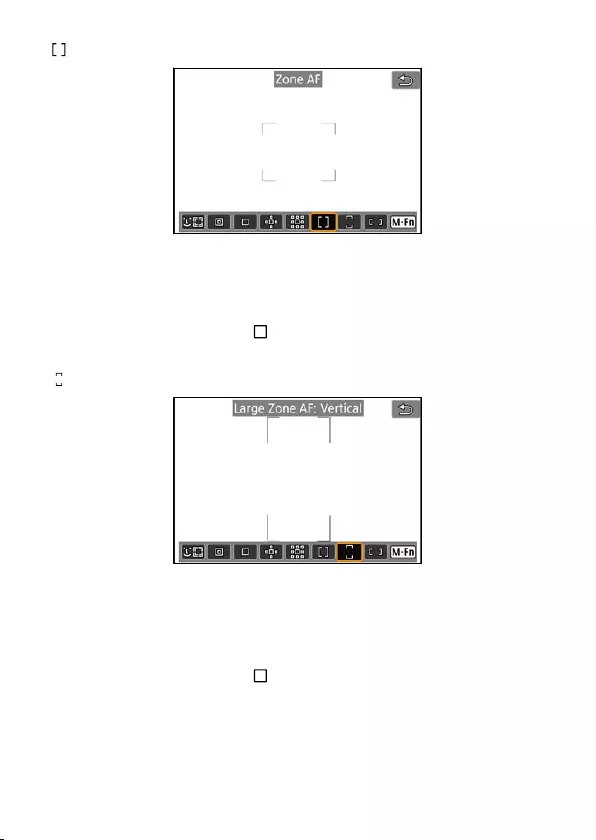
: Zone AF
Uses auto selection AF in Zone AF frames to cover a larger area than Expand AF area,
which makes focusing easier than with Expand AF area.
Focusing areas are determined not only based on the nearest subject but also based on a
variety of other conditions such as faces (of people or animals), subject motion, and subject
distance.
AF points in focus are displayed with [ ].
: Large Zone AF: Vertical
Uses auto selection AF in a vertical Large Zone AF frame to cover a larger area than Zone
AF, which makes focusing easier than with 1-point AF/Expand AF area and also effective for
moving subjects.
Focusing areas are determined not only based on the nearest subject but also based on a
variety of other conditions such as faces (of people or animals), subject motion, and subject
distance.
AF points in focus are displayed with [ ].
393

: Large Zone AF: Horizontal
Uses auto selection AF in a horizontal Large Zone AF frame to cover a larger area than
Zone AF, which makes focusing easier than with 1-point AF/Expand AF area and also
effective for moving subjects.
Focusing areas are determined not only based on the nearest subject but also based on a
variety of other conditions such as faces (of people or animals), subject motion, and subject
distance.
AF points in focus are displayed with [ ].
394

Selecting the AF Method
You can select the AF method to suit the shooting conditions or subject.
If you prefer to focus manually, see Manual Focus.
1. Select [ : AF method].
2. Select the AF method.
Note
In [ ] mode, [ +Tracking] is set automatically.
To set the AF method, you can also press the < > button and then the
< > button.
The following descriptions apply to the camera with AF operation set to [One-Shot
AF] ( ). With [Servo AF] ( ) set, the AF point will turn blue when focus is
achieved.
395

(Face)+Tracking:
The camera detects and focuses on faces of people or animals. If a face moves, the AF
point [ ] also moves to track the face.
You can set [ : Eye detection] to [Enable] to shoot with the subject’s eyes in focus ( ).
1. Check the AF point.
An AF point [ ] appears over any face detected.
To choose a face to focus on when multiple faces can be detected,
press the < > button to change the AF point to [ ], then use
< >. As you use < >, the AF point changes again to [ ].
You can also tap the screen to choose a face.
396

2. Focus and take the picture.
Once you press the shutter button halfway and the subject is in focus,
the AF point turns green and the camera beeps.
An orange AF point indicates that the camera could not focus on
subjects.
Note
Selecting the face of a person or animal manually by tapping the screen or using
< > changes the AF frame to [ ] and locks onto that subject for tracking, and
the camera tracks the subject even if it moves within the screen.
To release locked tracking, tap [ ] or press < >.
397

Caution
Tapping the screen to focus will focus with [One-Shot AF], regardless of the AF
operation setting.
If the subject’s face is significantly out of focus, face detection will not be possible.
Adjust the focus manually ( ) so that the face can be detected, then perform AF.
Objects other than a human face or animal face or body may be detected.
Face detection will not work if the face is very small or large in the picture, too
bright or too dark, or partially hidden.
Face detection for animals is not possible when the subject is too far away or does
not face the camera steadily. AF points are displayed over the entire body.
Detection is not possible for birds camouflaged in a forest, or similar situations.
AF may not detect subjects or people’s faces at the edges of the screen.
Recompose the shot to center the subject or bring the subject closer to the center.
Note
For human subjects, the active [ ] may cover only a part of the face, not the whole
face.
The size of the AF point changes depending on the subject.
Setting the initial Servo AF position
You can manually set the initial Servo AF position when [ : Initial Servo AF pt for ]
is set to an option other than [Auto] ( ).
1. Set the AF method to [ +Tracking] ( ).
2. Set AF operation to [Servo AF] ( ).
398
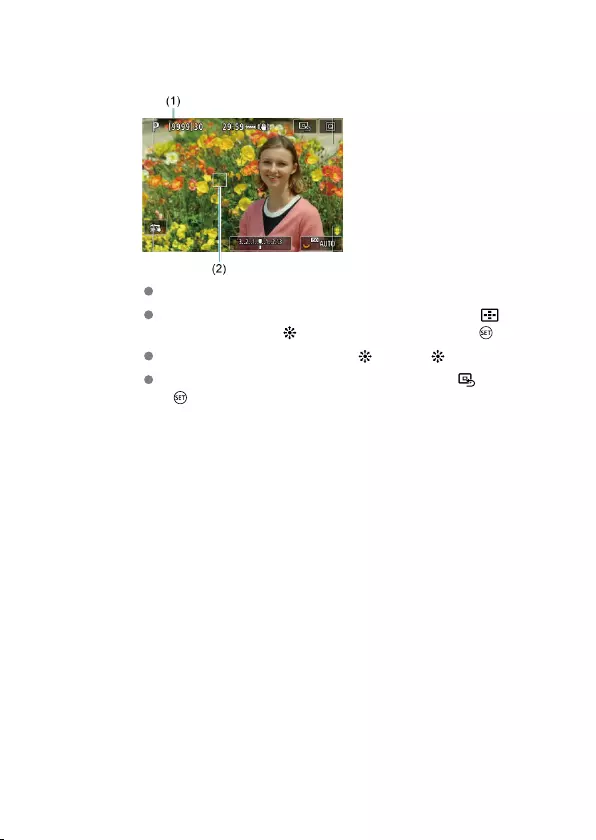
3. Set the AF point.
An Area AF frame (1) and AF point (2) are displayed.
To move the AF point into position for focusing, press the < >
button and then use <>, or tap the screen, then press < >.
To center the AF point while using < >, press < > straight in.
To center the AF point after you have confirmed it, tap [ ] or press
< >.
399

Subject to Detect
You can specify conditions for automatic selection of the main subject to track.
Takes effect when the AF method is Face+Tracking, Zone AF, or Large Zone AF (vertical or
horizontal).
People
Prioritizes the faces or heads of people as the main subjects to track.
When a person’s face or head cannot be detected, the camera may track all or part of
their body.
Animals
Detects animals (dogs, cats, or birds) and people and prioritizes detection results for
animals as the main subjects to track.
For animals, the camera attempts to detect faces or bodies, and AF points are shown
over any faces detected.
When an animal’s face or entire body cannot be detected, the camera may track part of
their body.
No priority
The camera determines the main subject automatically from the subject information
detected.
400

Eye Detection
With the AF method set to [ +Tracking], you can shoot with the eyes of people or animals
in focus.
1. Select [ : Eye detection].
2. Select [Enable].
401

3. Aim the camera at the subject.
An AF point is displayed around their eye.
To choose an eye to focus on, press the < > button to change the
AF point to [ ], then use < >. As you use < >, the AF point
changes again to [ ].
You can also tap the screen to choose an eye.
If your selected eye is not detected, an eye to focus on is selected
automatically.
4. Take the picture.
Caution
Subject eyes may not be detected correctly, depending on the subject and shooting
conditions.
Note
To switch to [Eye detection: Disable] without using menu operations, press the
< > button and then the < > button. To switch to [Eye detection: Enable],
press the < > button again.
402

Spot AF / 1-Point AF / Expand AF Area: / Expand AF
Area: Around / Zone AF / Large Zone AF: Vertical / Large
Zone AF: Horizontal
You can manually set the AF point or Zone AF frame. Here, 1-point AF screens are used as
an example.
1. Check the AF point.
The AF point (1) will appear.
With Expand AF area: or Expand AF area: Around, adjacent AF
points are also displayed.
With Zone AF, Large Zone AF: Vertical, or Large Zone AF: Horizontal,
the specified Zone AF frame is displayed.
403

2. Move the AF point.
Press the < > button, use < > to move the AF point into position
for focusing, then press < > (but note that with some lenses, it may
not move to the edge of the screen).
To center the AF point while using < >, press < > straight in.
You can also focus by tapping a position on the screen.
To center the AF point or Zone AF frame, tap [ ] or press < >.
3. Focus and take the picture.
Aim the AF point over the subject and press the shutter button halfway.
When focus is achieved, the AF point will turn green and the beeper
will sound.
If focus is not achieved, the AF point will turn orange.
404

Caution
The camera continues to switch the active AF point [ ] to track subjects when
Zone AF or Large Zone AF (vertical or horizontal) is set to Servo AF, but tracking
may not be possible under some shooting conditions, such as when subjects are
small.
Focusing may be difficult when using a peripheral AF point. In this case, select an
AF point in the center.
Tapping the screen to focus will focus with [One-Shot AF], regardless of the AF
operation setting.
Note
With [ : Orientation linked AF point], you can set separate AF points for
vertical and horizontal shooting ( ).
405

Magnified View
To check the focus when the AF method is other than [ +Tracking], magnify display by
approx. 6× or 15× by pressing the <> button (or tapping [ ]).
Magnification is centered on the AF point for [Spot AF], [1-point AF], [Expand AF area:
], and [Expand AF area: Around] and on the Zone AF frame for [Zone AF], [Large
Zone AF: Vertical], and [Large Zone AF: Horizontal].
Autofocusing is performed with magnified display if you press the shutter button halfway
when set to [Spot AF], and [1-point AF]. When set to AF methods other than [Spot AF]
and [1-point AF], autofocusing is performed after restoring normal display.
With Servo AF, if you press the shutter button halfway in the magnified view, the camera
will return to the normal view for focusing.
Caution
If focusing is difficult in the magnified view, return to the normal view and perform
AF.
If you perform AF in the normal view and then use the magnified view, accurate
focus may not be achieved.
AF speed differs between the normal view and magnified view.
Continuous AF and Movie Servo AF are not available when display is magnified.
With the magnified view, achieving focus becomes more difficult due to camera
shake. Using a tripod is recommended.
406

AF Shooting Tips
Even when focus is achieved, pressing the shutter button halfway will focus again.
Image brightness may change before and after autofocusing.
Depending on the subject and shooting conditions, it may take longer to focus, or the
continuous shooting speed may decrease.
If the light source changes as you shoot, the screen may flicker, and focusing may be
difficult. In this case, restart the camera and resume shooting with AF under the light
source you will use.
If focusing is not possible with AF, focus manually ( ).
For subjects at the edge of the screen that are slightly out of focus, try centering the
subject (or AF point, or Zone AF frame) to bring them into focus, then recompose the
shot before shooting.
With certain lenses, it may take more time to achieve focus with autofocus, or accurate
focusing may not be achieved.
407

Shooting Conditions That Make Focusing Difficult
Subject with low-contrast such as the blue sky, solid-color flat surfaces or when highlight
or shadow details are clipped.
Subjects in low light.
Stripes and other patterns where there is contrast only in the horizontal direction.
Subjects with repetitive patterns (Example: Skyscraper windows, computer keyboards,
etc.).
Fine lines and subject outlines.
Under light sources with constantly changing brightness, colors, or patterns.
Night scenes or points of light.
The image flickers under fluorescent or LED lighting.
Extremely small subjects.
Subjects at the edge of the screen.
Strongly backlit or reflective subjects (Example: Car with a highly reflective surfaces,
etc.).
Near and distant subjects covered by an AF point (Example: Animal in a cage, etc.).
Subjects that keep moving within the AF point and will not stay still due to camera shake
or subject blur.
Performing AF when the subject is very far out of focus.
Soft focus effect is applied with a soft focus lens.
A special effect filter is used.
Noise (dots of light, banding, etc.) appears on the screen during AF.
408

AF Range
The available autofocus range varies depending on the lens, aspect ratio, and image quality
used, and whether you are recording 4K or 8K movies and using features such as movie
cropping or Movie digital IS.
409

Continuous AF
This function keeps subjects generally in focus. The camera is ready to focus immediately
when you press the shutter button halfway.
1. Select [ : Continuous AF].
2. Select [Enable].
Caution
Fewer shots are available when set to [Enable], because the lens is driven
continuously and battery power is consumed.
410

Movie Servo AF
With this function enabled, the camera focuses on the subject continuously during movie
recording.
1. Select [ : Movie Servo AF].
411

2. Select [Enable].
Enable
• The camera focuses on the subject continuously even when you
are not pressing the shutter button halfway.
• To keep the focus at a specific position, or if you prefer not to
record mechanical sounds from the lens, you can temporarily stop
Movie Servo AF by tapping [ ] in the lower left of the screen.
• When Movie Servo AF is paused, if you return to movie recording
after operations such as pressing the <> or < > button
or changing the AF method, Movie Servo AF will resume.
Disable
Press the shutter button halfway or press the <> button to
focus.
412

Caution
Precautions when set to [Movie Servo AF: Enable]
Shooting conditions that make focusing difficult
• A fast-moving subject approaching or moving away from the camera.
• A subject moving at a close distance to the camera.
• When shooting with a higher aperture value.
• Also see Shooting Conditions That Make Focusing Difficult.
Since the lens is driven continuously and the battery power is consumed, the
possible movie recording time ( ) will be shortened.
The camera’s built-in microphone may also record mechanical sounds of the lens
or sounds of camera/lens operations if AF operations are performed or the camera
or lens is operated during movie recording. In this case, using an external
microphone may reduce these sounds. If the sounds are still distracting with an
external microphone, it may be more effective to remove the external microphone
from the camera and position it away from the camera and lens.
Movie Servo AF pauses during zooming or magnified view.
During movie recording, if a subject approaches or moves away or if the camera is
moved vertically or horizontally (panning), the recorded image may momentarily
expand or contract (change in image magnification).
413

Positioning Method
You can set how positions are specified by tapping or dragging.
1. Set [Positioning method].
Absolute
The AF point moves to the tapped or dragged position on the screen.
Relative
The AF point moves in the direction you drag, by an amount
corresponding to the amount you drag, no matter where you tap the
screen.
415

Active Touch Area
You can specify the area of the screen used for tap and drag operations.
1. Set [Active touch area].
Note
Tapping the screen when [ +Tracking] is set displays a round orange frame [ ].
After you lift your finger at the position to move the AF point to, [ ] is displayed
and that subject is tracked. To cancel subject selection, press <>.
416

Manual Focus
Setting MF Peaking (Outline Emphasis)
Focus Guide
AF-Assist Beam Firing
If focusing is not possible with autofocus, you can magnify the image and focus manually.
1. Set the lens’s focus mode switch to < >.
Turn the lens focusing ring to set the approximate focus.
2. Magnify the image.
Each press of the < > button changes the magnification ratio, as
follows.
417

3. Move the magnified area.
Use < > to move the magnified area into position for focusing.
To center the magnified area, press < > straight in or press < >.
4. Focus manually.
While looking at the magnified image, turn the lens focusing ring to
focus.
After achieving focus, press the < > button to return to the normal
view.
Note
In magnified view, the exposure is locked.
Even when focusing manually, you can use Touch Shutter to shoot.
418

Setting MF Peaking (Outline Emphasis)
Edges of subjects in focus can be displayed in color to make focusing easier. You can set
the outline color and adjust the sensitivity (level) of edge detection.
1. Select [ : MF peaking settings].
2. Select [Peaking].
Select [On].
3. Set [Level] and [Color].
Set as necessary.
419

Caution
In magnified view, peaking display is not shown.
During HDMI output, peaking display is not shown on equipment connected via
HDMI. Note that peaking display is shown on the camera screen when [ : HDMI
display] is set to [ +].
MF peaking may be hard to discern at high ISO speeds, especially when ISO
expansion is set. If necessary, lower the ISO speed or set [Peaking] to [Off].
Note
Peaking display shown on the screen is not recorded in images.
MF peaking may be hard to discern when Canon Log is set. If necessary, set [View
Assist.] to [On].
420

Focus Guide
Setting [Focus guide] to [On] provides a guide frame that shows which direction to adjust
focus and the extent of adjustment needed. The guide frame is displayed near any eyes that
are detected for the main subject when [ : AF method] is set to [ +Tracking] and [ :
Eye detection] is set to [Enable].
1. Select [ : Focus guide].
2. Select [On].
After pressing the < > button, you can use < > to move the guide
frame in the direction you press (except in [ ] mode).
To center the guide frame while using < >, press < > straight in.
To set the guide frame after moving it with < >, press < >.
You can also move and set the guide frame by tapping the screen.
To center the guide frame, tap [ ] or press < >.
421
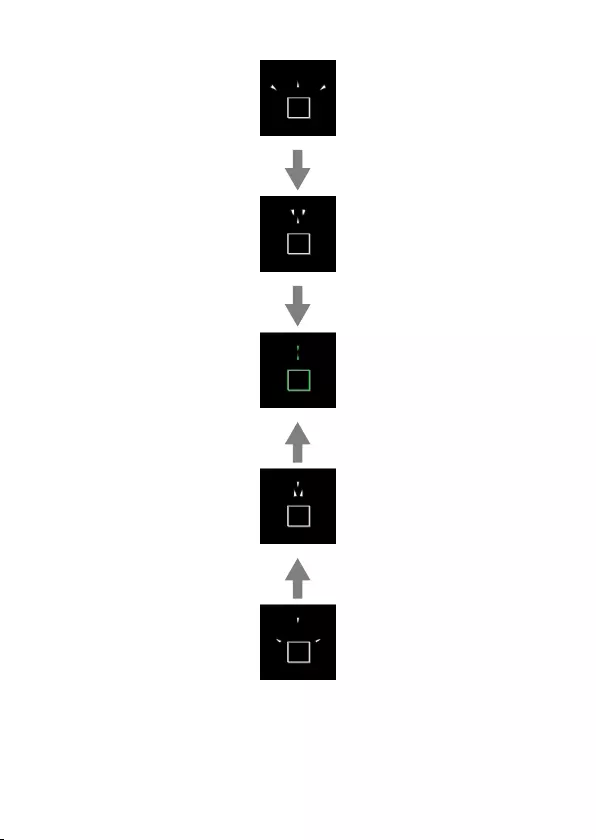
The guide frame indicates the current position in focus and adjustment amount as follows.
Significantly out of focus toward infinity
Slightly out of focus toward infinity
In focus
Slightly out of focus toward close range
Significantly out of focus toward close range
422
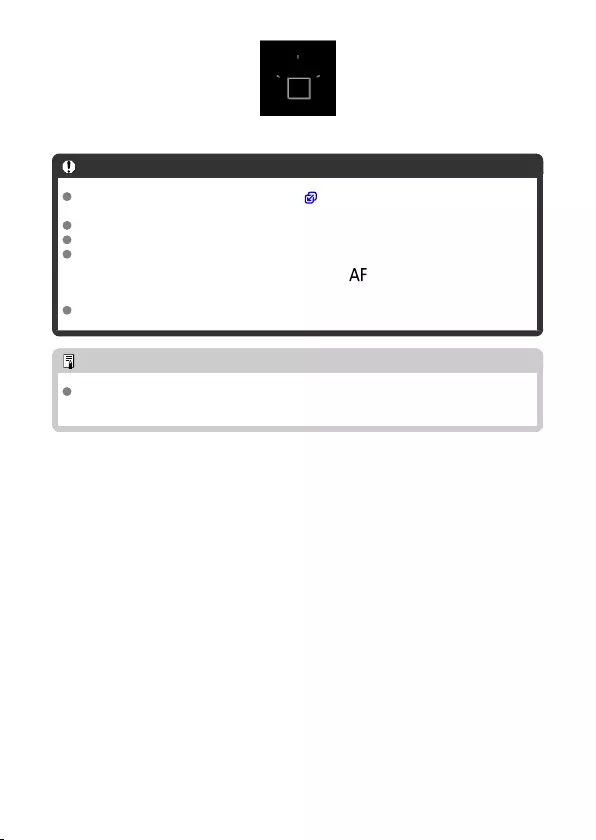
Adjustment information not detected
Caution
Under difficult shooting conditions for AF ( ), the guide frame may not be
displayed correctly.
Higher aperture values are more likely to prevent correct guide frame display.
No AF points are displayed while the guide frame is displayed.
The guide frame is not displayed in these situations.
• When the lens’s focus mode switch is set to < >
• When display is magnified
The guide frame is not displayed correctly during shifting or tilting of TS-E lenses.
Note
The camera’s auto power off counter does not count time spent adjusting the focus
with a lens’s electronic focusing ring.
423

AF-Assist Beam Firing
You can enable or disable AF-assist beam firing of the camera or a Speedlite for EOS
cameras.
1. Select [AF-assist beam firing].
2. Select an option.
[ON] Enable
Enables firing of the AF-assist beam, when needed.
[OFF] Disable
Disables firing of the AF-assist beam. Set if you prefer not to fire the
AF-assist beam.
[LED] LED AF assist beam only
Enables LED AF-assist beam firing by Speedlites equipped with this
feature, when these flash units are attached. If your Speedlite is not
LED-equipped, the camera’s AF-assist beam is fired instead.
424

Caution
If a Speedlite’s [AF-assist beam firing] Custom Function is set to [Disable], the
AF-assist beam will not be emitted.
425

Servo AF Characteristics
Case Details
Case 1: Versatile Multi-Purpose Setting
Case 2: Continue to Track Subjects, Ignoring Possible Obstacles
Case 3: Instantly Focus on Subjects Suddenly Entering AF Points
Case 4: For Subjects That Accelerate or Decelerate Quickly
Case A: Tracking Automatically Adapts to Subject Movement
Parameters
Adjusting Case Parameters
Shooting with AI Servo AF/Servo AF can be easily tailored to your subjects or shooting
situations by selecting a Case option. This feature is called the “AF Configuration Tool.”
1. Select the [ 3] tab.
2. Select a case.
Turn the < > dial to select a case icon, then press < >.
Your selected case is now set. Selected cases are displayed in blue.
426

Case Details
Cases 1 to A are five combinations of settings for “Tracking sensitivity” and “Accel./decel.
tracking.” Referring to the following table, select the case for your subject and shooting
situation.
Case Icon Description Examples of Shooting
Situations
Case 1 /Versatile multi purpose setting Moving subjects in general
Case 2 Continue to track subjects,
ignoring possible obstacles Tennis, freestyle skiing
Case 3 Instantly focus on subjects
suddenly entering AF points
Start of a cycling race, downhill
skiing
Case 4 /For subjects that accelerate or
decelerate quickly
Soccer, rhythmic gymnastics,
motorsports, basketball
Case A Tracking automatically adapts to
subject movement
Moving subjects in general,
especially in dynamic shooting
situations
427

Case 1: Versatile Multi-Purpose Setting
Default
• Tracking sensitivity: 0
• Accel./decel. tracking: 0
Standard setting suited to moving subjects in general. Suitable for many kinds of subjects
and scenes.
In the following situations, select [Case 2] to [Case 4] instead: non-subjects moving across
AF points, elusive subjects, or subjects that suddenly appear or change speed.
428
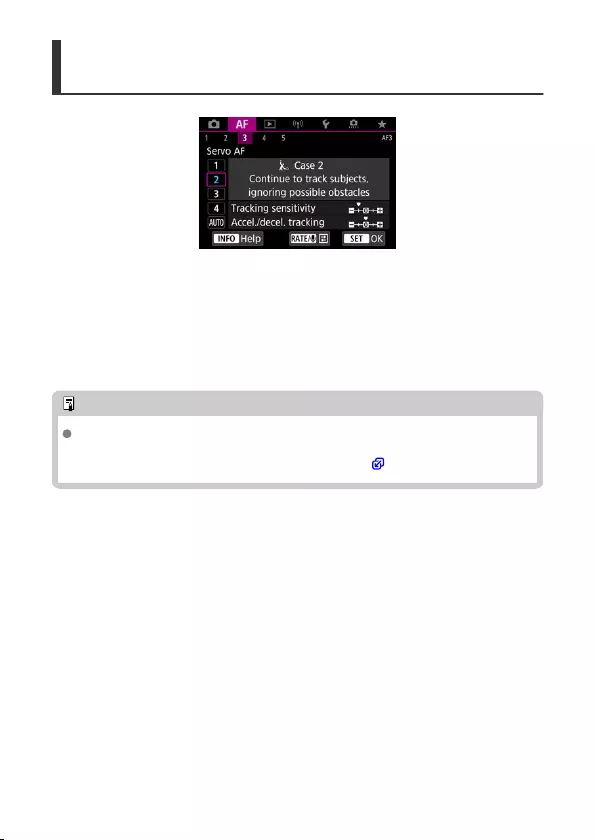
Case 2: Continue to Track Subjects, Ignoring Possible
Obstacles
Default
• Tracking sensitivity: Locked on: –1
• Accel./decel. tracking: 0
Setting to continue focusing on the subject even if non-subjects move across AF points, or if
the subject strays from AF points. Effective if you prefer the focus not to switch to non-
subjects or the background.
Note
Try setting [Tracking sensitivity] to [–2] if non-subjects tend to steal the focus or
AF points tend to stray from the subject much of the time, preventing the camera
from tracking the target subject under default settings ( ).
429

Case 3: Instantly Focus on Subjects Suddenly Entering
AF Points
Default
• Tracking sensitivity: Responsive: +1
• Accel./decel. tracking: +1
Setting to focus on a series of subjects at different distances in the AF points, one after
another. Focus switches to any new subject that appears in front of the target subject. Also
effective when you want to always focus on the closest subject.
Note
Try setting [Tracking sensitivity] to [+2] if you prefer focusing that immediately
switches to new subjects that appear suddenly ( ).
430

Case 4: For Subjects That Accelerate or Decelerate
Quickly
Default
• Tracking sensitivity: Responsive: 0
• Accel./decel. tracking: +1
Setting to keep tracking and focusing on subjects even if they suddenly change speed.
Effective for subjects having sudden movements, sudden acceleration/deceleration, or
sudden stops.
Note
Try setting [Accel./decel. tracking] to [+2] to keep up with subjects that change
speed significantly from moment to moment ( ).
431

Case A: Tracking Automatically Adapts to Subject
Movement
Useful when you prefer to shoot with parameters set automatically, based on how subjects
change.
Tracking sensitivity and acceleration/deceleration tracking are set automatically.
432
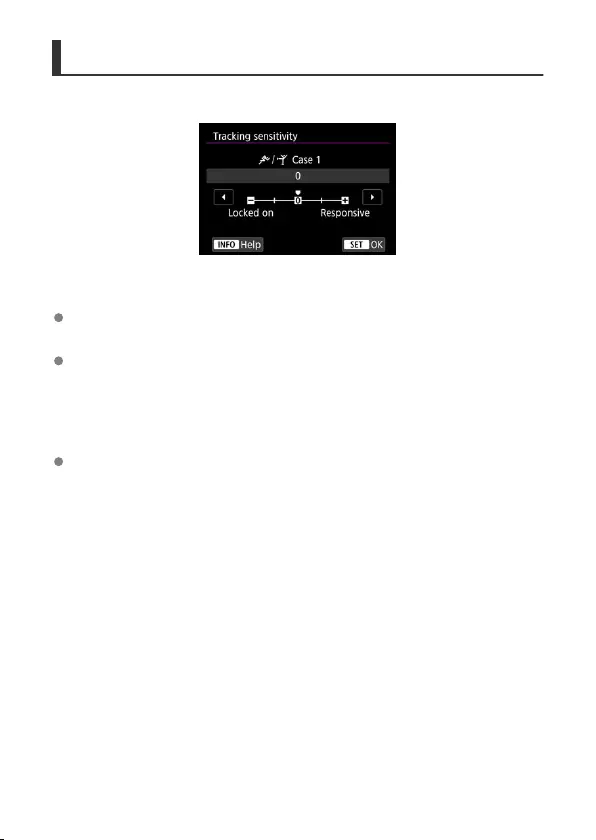
Parameters
Tracking sensitivity
Setting for Servo AF subject-tracking sensitivity in response to non-subjects moving across
AF points or subjects straying from AF points.
0
Standard setting. Suitable for moving subjects in general.
Locked on: –2 / Locked on: –1
The camera will try to continue focusing on the subject even if non-subjects move
across AF points or if the subject strays from the AF points. The –2 setting makes the
camera keep tracking the target subject longer than the –1 setting.
However, if the camera focuses on a wrong subject, it may take slightly longer to switch
and focus on the target subject.
Responsive: +2 / Responsive: +1
The camera can focus consecutively on subjects at different distances that are covered
by the AF points. Also effective when you want to always focus on the closest subject.
The +2 setting is more responsive than the +1 setting when focusing on the next
subject.
However, the camera will be more prone to focus on an unintended subject.
433

Accel./decel. tracking
Setting for AI Servo AF/Servo AF subject-tracking sensitivity in response to sudden,
significant changes in speed, as when subjects suddenly start or stop moving.
0
Suited for subjects that move at a steady speed (minor changes in moving speed).
–2 / –1
Suited for subjects that move at a steady speed (minor changes in moving speed).
Effective when a setting of 0 makes focus unstable, due to slight subject movement or
an obstruction in front of the subject.
+2 / +1
Effective for subjects having sudden movements, sudden acceleration/deceleration, or
sudden stops. Even if the moving subject’s speed suddenly changes significantly, the
camera continues to focus on the target subject. For example, the camera is less likely
to focus behind a subject that suddenly starts approaching you, or in front of an
approaching subject that suddenly stops moving. Setting +2 can track dramatic changes
in the moving subject’s speed better than with +1.
However, since the camera will be sensitive to even slight movements of the subject,
focusing may become unstable for short periods.
434

Adjusting Case Parameters
You can manually adjust the parameters ((1) Tracking sensitivity and (2) Acceleration/
deceleration tracking) for cases 1 to 4.
1. Select a case.
Turn the < > dial to select the number of a case to adjust.
2. Press the < > button.
The selected parameter is outlined in purple.
3. Select a parameter to adjust.
435
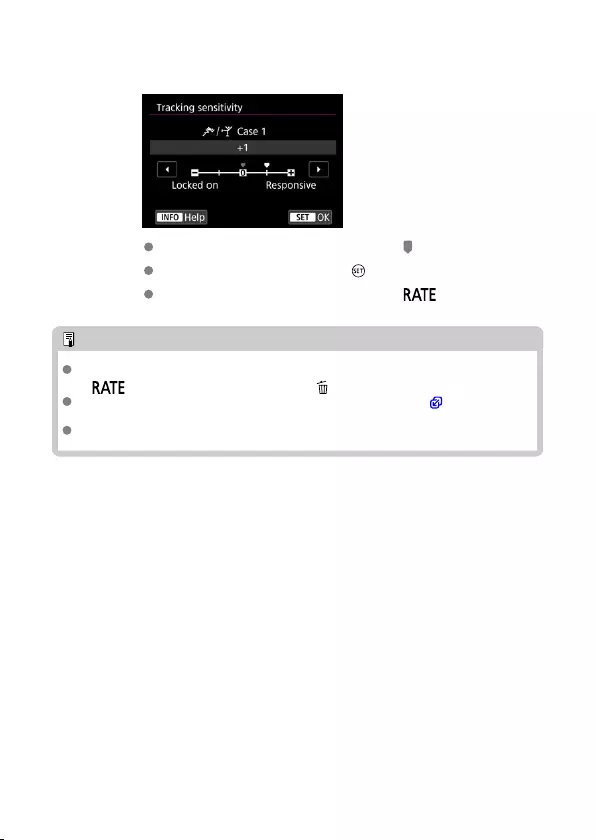
4. Make the adjustment.
Default settings are indicated by a light gray [ ] icon.
To confirm the adjustment, press < >.
To return to the screen in step 1, press the < > button.
Note
To restore default parameter settings for (1) and (2) to each case, press the
<> button in step 2, then press the < > button.
You can also register (1) and (2) parameter settings to My Menu ( ). This enables
you to adjust settings for the selected case.
To shoot with a case you have adjusted, first select the adjusted case, then shoot.
436
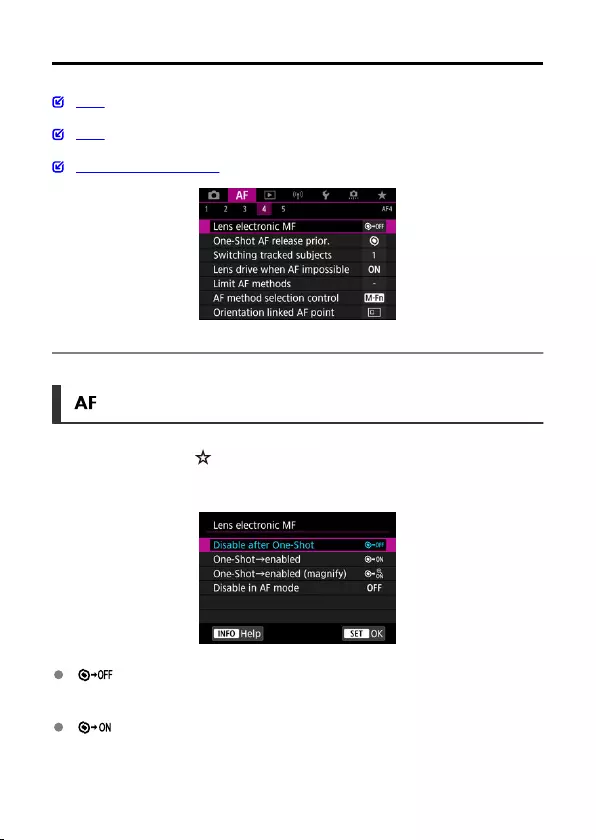
Customizing AF Functions
[AF4]
[AF5]
[AF3] (In Movie Recording)
You can configure AF functions in detail to suit your shooting style or subject.
[ 4]
Lens electronic MF
For EF lenses equipped with electronic manual focusing, you can specify how manual focus
adjustment is used with One-Shot AF.
[ ] Disable after One-Shot
After the AF operation, manual focusing adjustment is disabled.
[ ] One-Shot→enabled
You can manually adjust the focus after the AF operation if you keep holding down the
shutter button halfway.
437
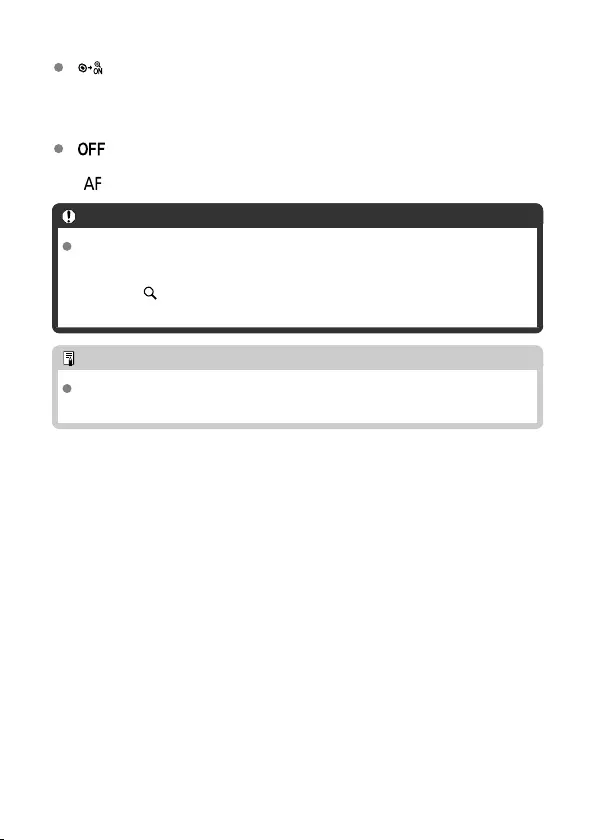
[ ] One-Shot→enabled (magnify)
You can manually adjust the focus after the AF operation if you keep holding down the
shutter button halfway. You can magnify the area in focus and adjust the focus manually
by turning the lens focusing ring.
[ ] Disable in AF mode
Manual focus adjustment is disabled when the lens’s focus mode switch is set to
< >.
Caution
With [One-Shot→enabled (magnify)], display may not be magnified even if you
turn the lens focusing ring while pressing the shutter button halfway immediately
after shooting. If so, you can magnify display by releasing the shutter button,
waiting for [ ] display, then pressing the shutter button halfway as you turn the
lens focusing ring.
Note
For details on your lens’s manual focus specifications, refer to the Lens Instruction
Manual.
438

One-Shot AF release prior.
You can specify whether to prioritize focus or release timing for One-Shot AF (except when
shooting with Touch Shutter).
[ ] Focus
The picture will not be taken until focus is achieved. Useful when you want to achieve
focus before capturing the image.
[ ] Release
Prioritizes shutter release over focus. Useful when capturing the decisive moment is
most important.
Note that the camera shoots whether or not the subject is in focus.
439
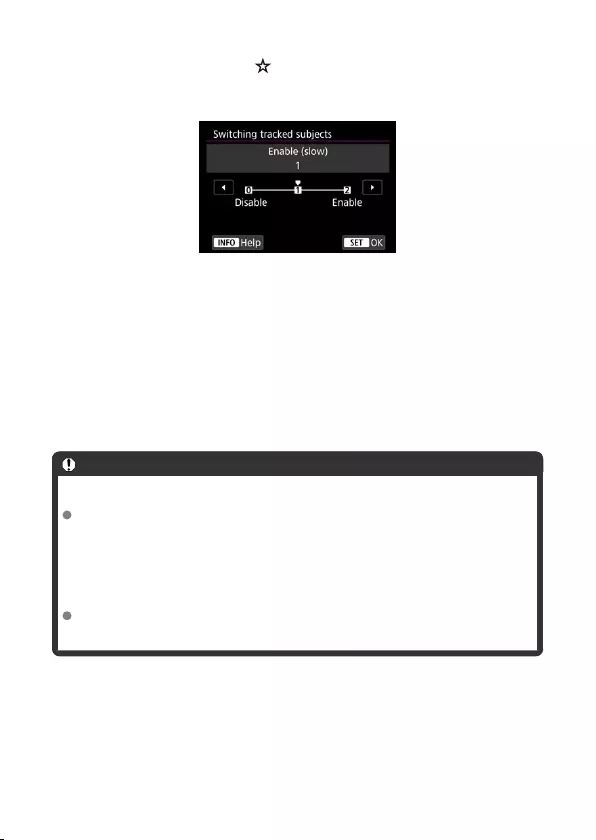
Switching tracked subjects
You can specify how easily the camera switches AF points to track subjects.
Applies to Face+Tracking, Zone AF, or Large Zone AF (vertical or horizontal) AF methods.
•Disable
Tracks the subject initially determined for AF, to the extent possible.
•Enable (slow)
Tracks the main subject initially determined for AF, to the extent possible. Switches to
other subjects if the camera can no longer determine if the tracked subject is the main
subject.
•Enable
Switches to track other subjects in response to shooting conditions.
Caution
Precautions when set to [Disable]
The camera may not be able to continue tracking subjects under some subject
conditions.
• If subjects move vigorously
• If subjects face a different direction or change their posture
• If AF points stray from subjects, or if subjects are hidden behind obstructions
and you can no longer see them
Subjects selected by touch are tracked to the extent possible, regardless of the
[Subject to detect] setting.
440
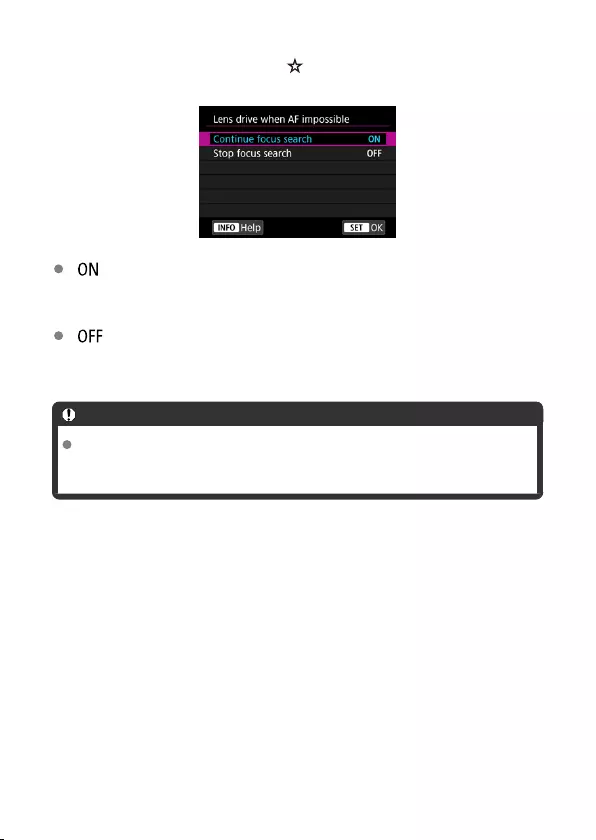
Lens drive when AF impossible
You can specify lens operation that applies when autofocusing on a subject is not possible.
[ ] Continue focus search
If focus cannot be achieved with autofocus, the lens is driven to search for the precise
focus.
[ ] Stop focus search
If autofocus starts and the focus is far off or if focus cannot be achieved, the lens drive
will not be performed. This prevents the lens from becoming grossly out of focus due to
the focus search drive.
Caution
[Stop focus search] is recommended for super telephoto lenses or other lenses
that are driven over a large focus area, to avoid significant delay from focus search
drive if the lens becomes greatly out of focus.
441
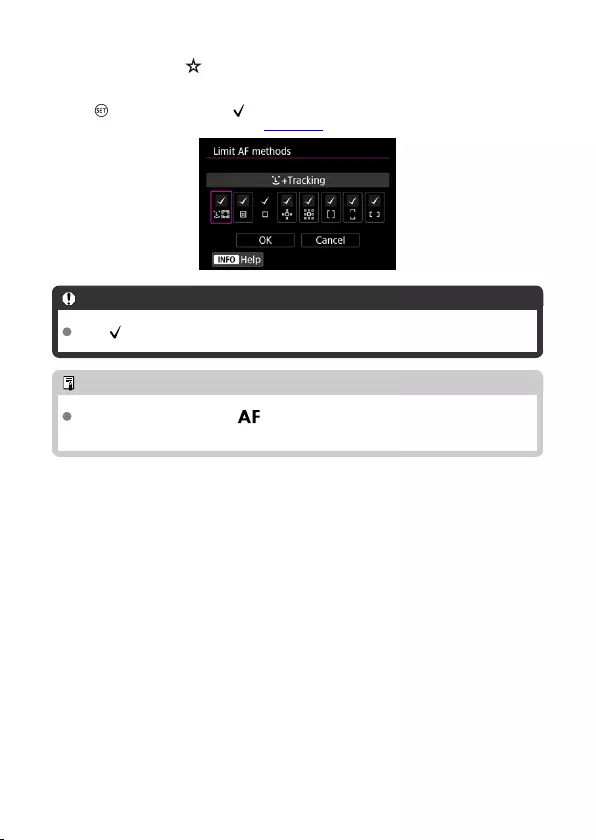
Limit AF methods
You can limit the AF methods available to those that you will use. Select AF methods and
press < > to add a checkmark [ ] and make them available. Select [OK] to register the
setting. For details on AF methods, see AF Method.
Caution
The [ ] mark cannot be removed from [Manual selection:1 pt AF].
Note
An asterisk “*” to the right of [ : Limit AF methods] indicates that the default
setting has been modified.
442

AF method selection control
You can set how AF method selection methods are switched.
[ ] →M-Fn button
Press the < > button, then the < > button. Each press switches the AF
method.
[ ] →Main Dial
Press the < > button, then turn the < > dial to switch the AF method.
Note
When [ →Main Dial] is set, use <> to move the AF point horizontally.
443

Orientation linked AF point
You can set separate AF points or Zone AF frames to use in vertical and horizontal
shooting.
[ ] Same for both vert/horiz
The same AF points or Zone AF frames are used in both vertical and horizontal
shooting.
[ ] Separate AF pts: Pt only
Separate AF points or Zone AF frames can be set for each camera orientation ((1)
Horizontal, (2) Vertical with the camera grip up, (3) Vertical with the camera grip down).
Useful when switching to other AF points or Zone AF frames automatically based on
camera orientation.
AF points or Zone AF frames you assign to each of the three camera orientations are
retained.
Caution
The default setting of [Same for both vert/horiz] is restored if you select [Basic
settings] in [ : Reset camera] ( ). Settings for orientations (1)–(3) are cleared,
and the camera is set to use the center AF point in 1-point AF.
The setting may be cleared if you switch lenses.
444
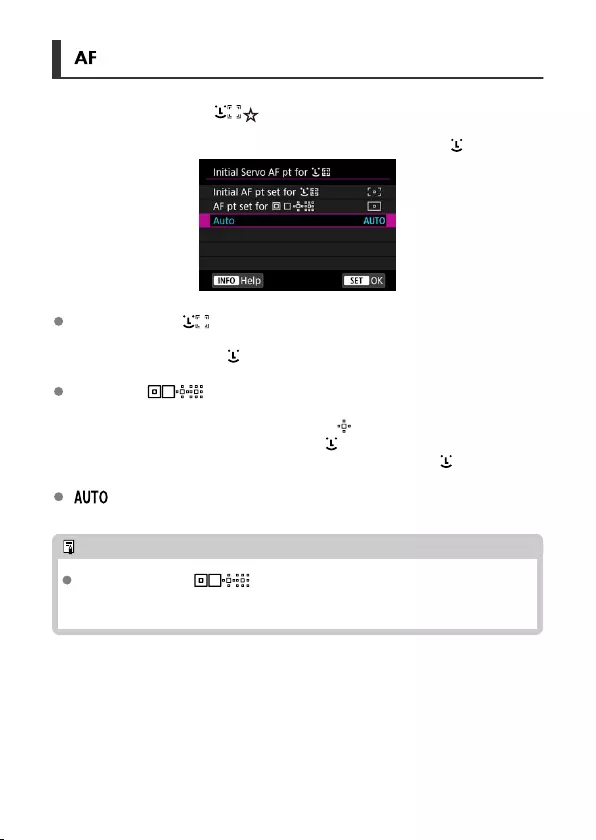
[ 5]
Initial Servo AF pt for
You can set the initial AF point for Servo AF when the AF method is set to [ +Tracking].
Initial AF pt set for
Servo AF starts from the manually set AF point when AF operation is set to [Servo AF]
and the AF method is set to [ +Tracking].
AF pt set for
Servo AF starts from the AF point that was set manually before switching from Spot AF,
1-point AF, or Expand AF area (manual selection ) or Expand AF area (manual
selection: surround) to [Auto selection AF] or [ +Tracking]. Useful for starting Servo
AF from the AF point set before switching to [Auto selection AF] or [ +Tracking].
: Auto
The initial AF point for Servo AF is set automatically to suit the shooting conditions.
Note
When [AF pt set for ] is set, Servo AF starts from a zone corresponding
to your manually selected AF point even if you switch the AF method to Zone AF or
Large Zone AF (vertical or horizontal).
445
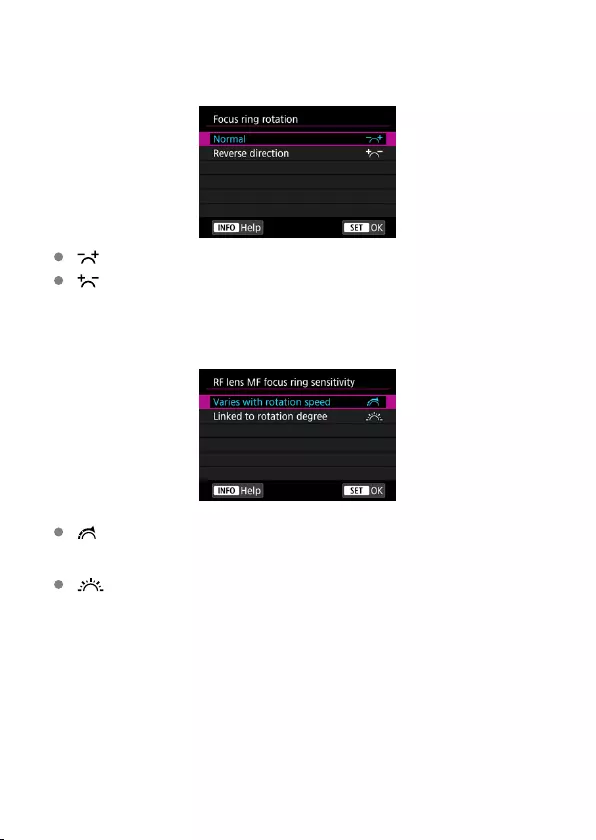
Focus ring rotation
You can reverse the direction that the focusing ring of RF lens is rotated to adjust settings.
[ ] Normal
[ ] Reverse direction
RF lens MF focus ring sensitivity
You can set the sensitivity of the RF lens focusing ring.
[ ] Varies with rotation speed
Focusing ring sensitivity varies depending on rotation speed.
[ ] Linked to rotation degree
The focal position is adjusted based on the amount of rotation, regardless of the rotation
speed.
446

sensitivity- AF pt select
You can adjust Multi-controller sensitivity, which applies to AF point positioning.
447
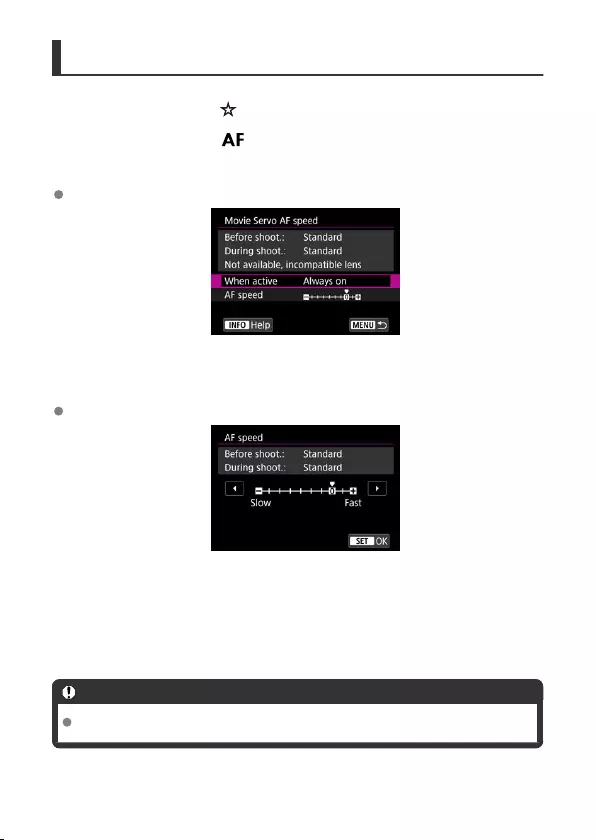
[AF3] (In Movie Recording)
Movie Servo AF speed
This function is available when [ : Movie Servo AF] is set to [Enable].
You can set the AF speed and operating conditions for Movie Servo AF. The function is
enabled when using a lens supporting slow focus transition during movie recording.*
When active
You can set [Always on] to have the AF speed take effect at all times for movie
recording (before and during movie recording) or set [During shooting] to have the AF
speed take effect only during movie recording.
AF speed
You can adjust the AF speed (focus transition speed) from the standard speed (0) to
slow (one of seven levels) or fast (one of two levels) to obtain the desired effect for the
movie creation.
* Lenses supporting slow focus transition during movie recording
USM and STM lenses released in and after 2009 are compatible. For details, refer to the
Canon website.
Caution
With certain lenses, even if you adjust the AF speed, the speed may not change.
448
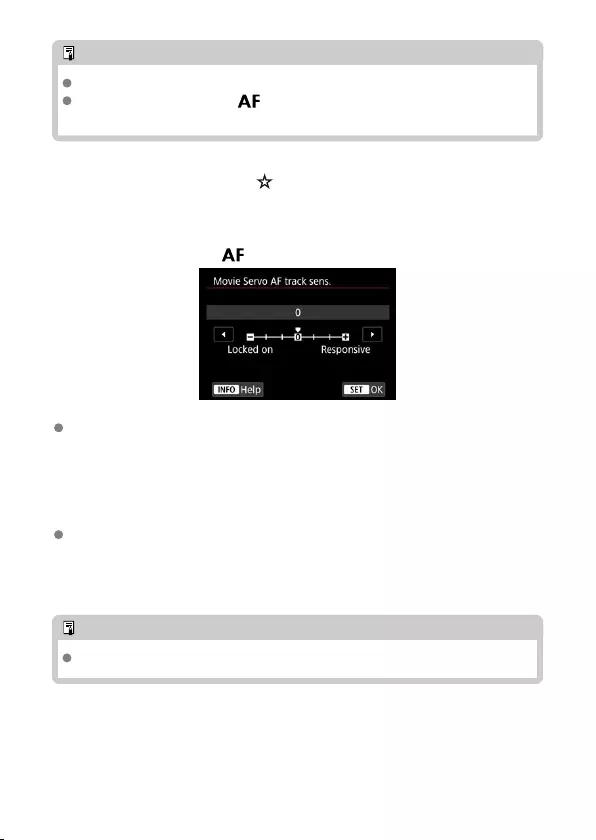
Note
Operation when inactive is equivalent to when [AF speed] is set to [Standard (0)].
An asterisk “*” to the right of [ : Movie Servo AF speed] indicates that the
default setting has been modified.
Movie Servo AF track sens.
You can adjust the tracking sensitivity (to one of seven levels), which affects responsiveness
if the subject strays from the AF point during Movie Servo AF, as when interfering objects
move across AF points or when you pan.
This function is available when [ : Movie Servo AF] is set to [Enable].
Locked on: –3/–2/–1
With this setting, the camera is less likely to track a different subject if the subject strays
from the AF point. The closer the setting is to the minus (–) symbol, the less the camera
is inclined to track a different subject. It is effective when you want to prevent the AF
points from rapidly tracking something that is not the intended subject during panning or
when an obstacle cuts across the AF points.
Responsive: +1/+2/+3
This makes the camera more responsive when tracking a subject that covers the AF
point. The closer the setting is to the plus (+) symbol, the more responsive the camera
is. It is effective when you want to keep tracking a moving subject as its distance from
the camera changes or to rapidly focus on another subject.
Note
Operation when inactive is equivalent to when set to [0].
449

Selecting the Drive Mode
Single and continuous drive modes are provided. You can select the drive mode suiting the
scene or subject.
1. Press the < > button ( ).
With an image displayed on the screen, press the < > button.
2. Select the drive mode item.
Turn the < > dial to select the drive mode item.
450
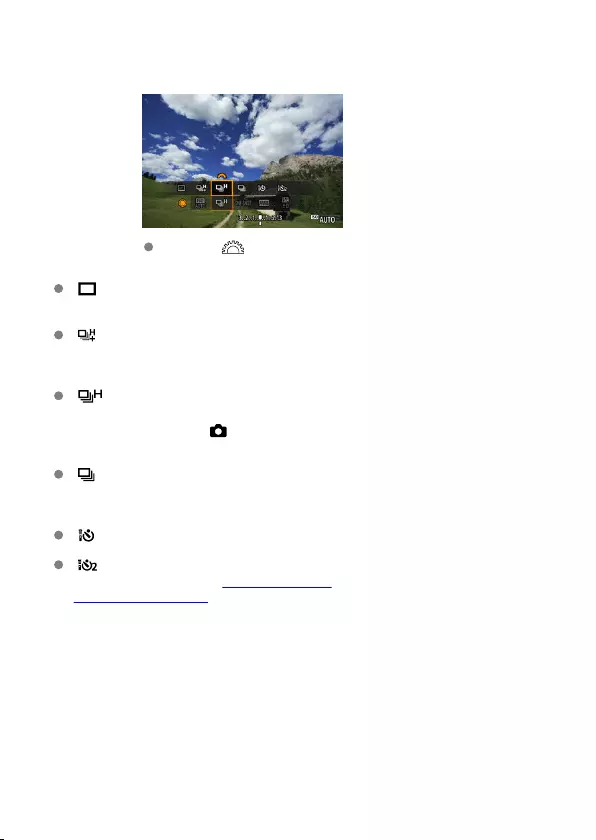
3. Select the drive mode.
Turn the < > dial to make a selection.
[ ] Single shooting
When you hold down the shutter button completely, only one shot will be taken.
[ ] High-speed continuous shooting +
When you hold down the shutter button completely, you can shoot continuously at max.
approx. 12 shots/sec. while you keep holding it down.
[ ] High-speed continuous shooting
When you hold down the shutter button completely, you can shoot continuously at max.
approx. 8.0 shots/sec. ([ : Shutter mode] set to [Mechanical]: max. approx. 6.0
shots/sec.) while you keep holding it down.
[ ] Low-speed continuous shooting
When you hold down the shutter button completely, you can shoot continuously at max.
approx. 3.0 shots/sec. while you keep holding it down.
[ ] Self-timer: 10 sec./remote control
[ ] Self-timer: 2 sec./remote control
For self-timer shooting, see Using the Self-Timer. For remote control shooting, see
Remote Control Shooting.
451
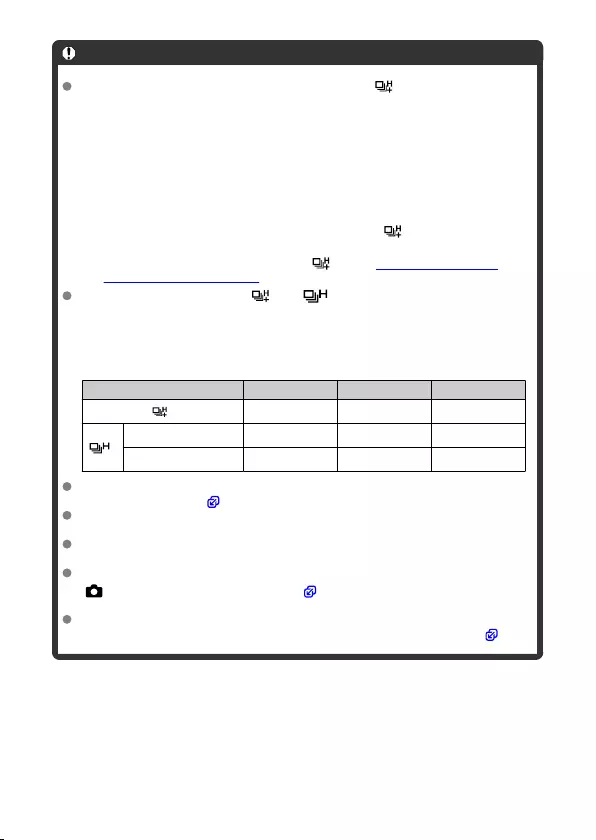
Caution
Approx. 12 shots/sec. continuous shooting speed with [ ] is available under the
following conditions.
• Room temperature (23°C/73°F)
• Battery level (LP-E6NH): At least approx. 60% (or using an optional Battery
Grip BG-R10, a battery level of at least approx. 60% with two LP-E6NH)
• Shutter speed: 1/1000 sec. or faster
• Wi-Fi connection: Not connected
• Flicker reduction: None
• Set to maximum aperture, when using RF lenses or [ ]-compatible EF
lenses*
*For details on EF lenses compatible with [ ], refer to EF Lenses Supporting 12
Shots/Sec. Continuous Shooting.
Continuous shooting speed for [ ] and [ ] changes as follows in response to
factors such as battery level, temperature, flicker reduction, shutter speed, aperture
value, subject conditions, brightness, AF operation, type of lens, use of flash, and
shooting settings.
(Approx. shots/sec.)
Icon Display Green White White (Blinking)
[]12 9.2 6.8
[ ]
For [Elec. 1st-curtain] 8.0 6.0 4.9
For [Mechanical] 6.0 5.1 3.9
Continuous shooting speed may become slower when using batteries with weak
recharge performance ( ).
Shooting continuously at up to approx. 12 shots/sec. is not possible using Wireless
File Transmitter WFT-R10.
Continuous shooting speed with Servo AF may be slower depending on subject
conditions or the lens used.
Continuous shooting speed may be lower when shooting under flickering light with
[: Anti-flicker shoot.] set to [Enable] ( ). Also, the continuous shooting
interval may become irregular and the release time lag may become longer.
When internal memory becomes full during continuous shooting, the continuous
shooting speed may drop off because shooting will be temporarily disabled ( ).
452
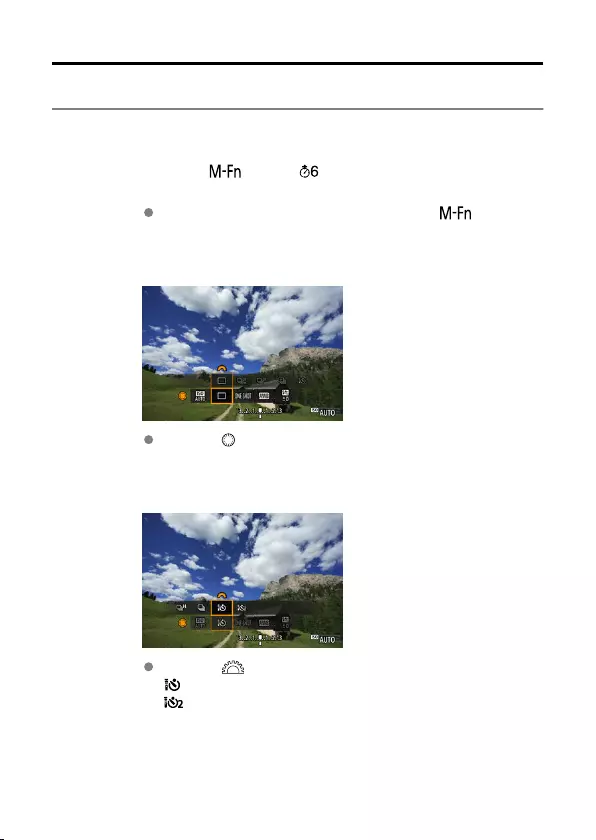
Using the Self-Timer
Use the self-timer when you want to be in the picture such as a commemorative photograph.
1. Press the < > button ( ).
With an image displayed on the screen, press the < > button.
2. Select the drive mode item.
Turn the < > dial to select the drive mode item.
3. Select the self-timer.
Turn the < > dial to select the self-timer.
: Shoot in 10 sec.
: Shoot in 2 sec.
453
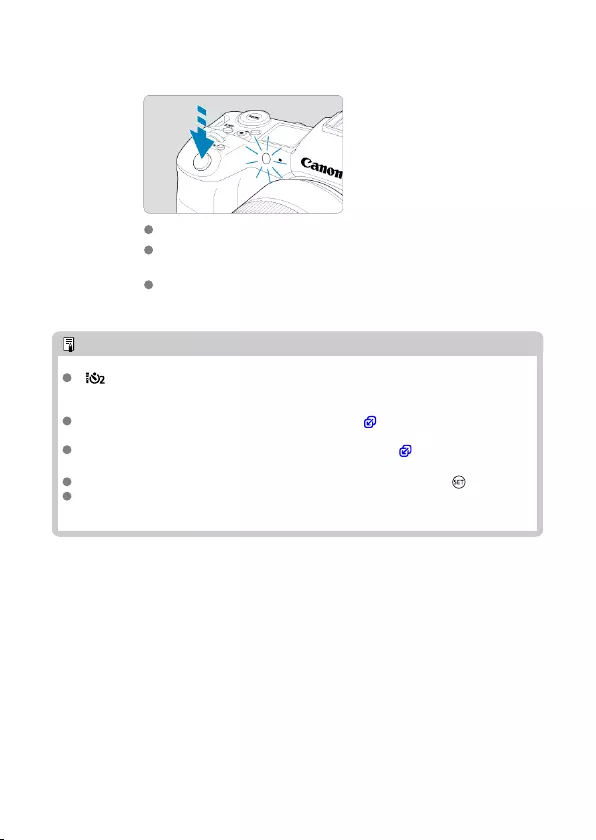
4. Take the picture.
Focus on the subject, then press the shutter button completely.
To check operation, look at the self-timer lamp, listen for beeps, or
watch the countdown in seconds on the screen.
Self-timer lamp blinking accelerates and the camera beeps quickly
approx. 2 sec. before the picture is taken.
Note
[ ] is used to start shooting without touching the camera (to avoid camera shake)
when it is mounted on a tripod for shots such as still lifes or long exposures, for
example.
After taking self-timer shots, playing back the image ( ) to check focus and
exposure is recommended.
When using the self-timer to shoot yourself, use focus lock ( ) on an object at the
same distance as where you will stand.
To cancel the self-timer after it starts, either tap the screen or press < >.
Auto power off time may be extended when the camera is set for remote control
shooting.
454
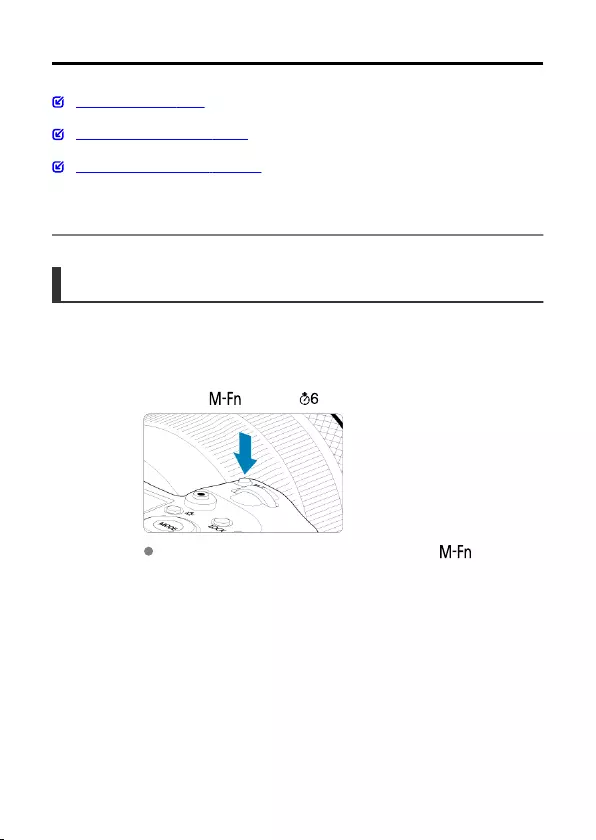
Remote Control Shooting
Remote Controller RC-6
Wireless Remote Control BR-E1
Remote Switch RS-80N3/TC-80N3
For remote control shooting, you can use an optional Remote Controller RC-6 (infrared) or
Wireless Remote Control BR-E1 (Bluetooth), or an optional Remote Switch RS-80N3 or
Timer Remote Controller TC-80N3 (both wired).
Remote Controller RC-6
You can shoot remotely up to approx. 5 meters/16.4 feet away from the front of the camera.
You can either shoot immediately or with a 2-sec. delay.
1. Press the < > button ( ).
With an image displayed on the screen, press the < > button.
455
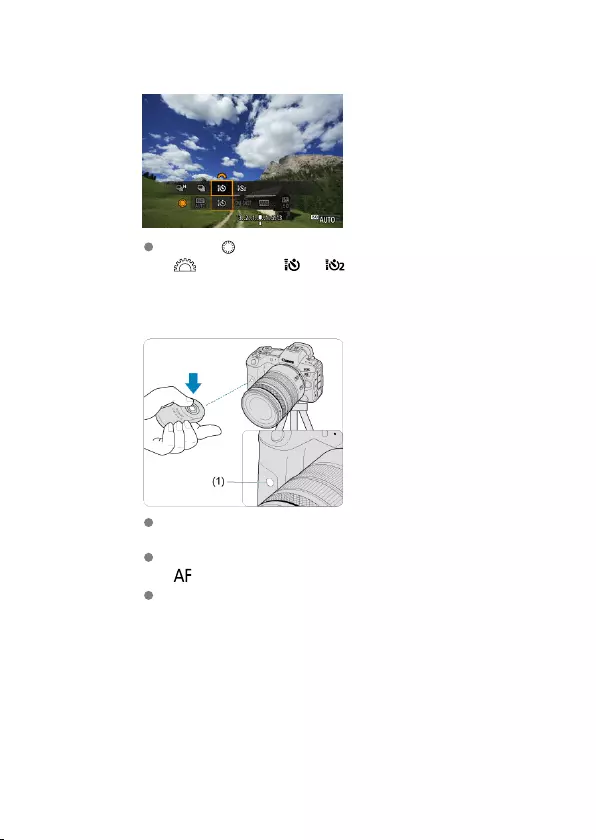
2. Select the self-timer/remote control.
Turn the < > dial to select the drive mode item, then turn the
< > dial to select [ ] or [ ].
3. Press the release (transmit) button on the remote controller.
Point the remote controller toward the camera’s remote control sensor
(1), then press the release (transmit) button.
Autofocusing is performed when the focus mode switch is set to
< >.
The remote control lamp lights up, and the camera shoots.
456

Caution
Infrared remote controllers such as the RC-6 cannot be used for remote control
shooting when the camera is paired via Bluetooth with a smartphone or wireless
remote control.
Fluorescent or LED lighting may trigger accidental shutter release. Try to keep the
camera away from these light sources.
Operating a TV remote control or similar device aimed at the camera may trigger
accidental shutter release.
Firing flash units of other cameras near the camera may trigger accidental shutter
release. Do not expose the remote control sensor to flash fired by other cameras.
457

Wireless Remote Control BR-E1
You can shoot remotely up to approx. 5 meters/16.4 feet from the camera.
After pairing the camera and BR-E1 ( ), set the drive mode to [ ] or [ ] for still photo
shooting ( ). For movie recording, set [ : Remote control] to [Enable].
For operating instructions, refer to the BR-E1 instruction manual.
Note
RC-6 and BR-E1
Auto power off time may be extended when the camera is set for remote control
shooting.
RC-6 and BR-E1 can also be used for movie recording ( ).
458
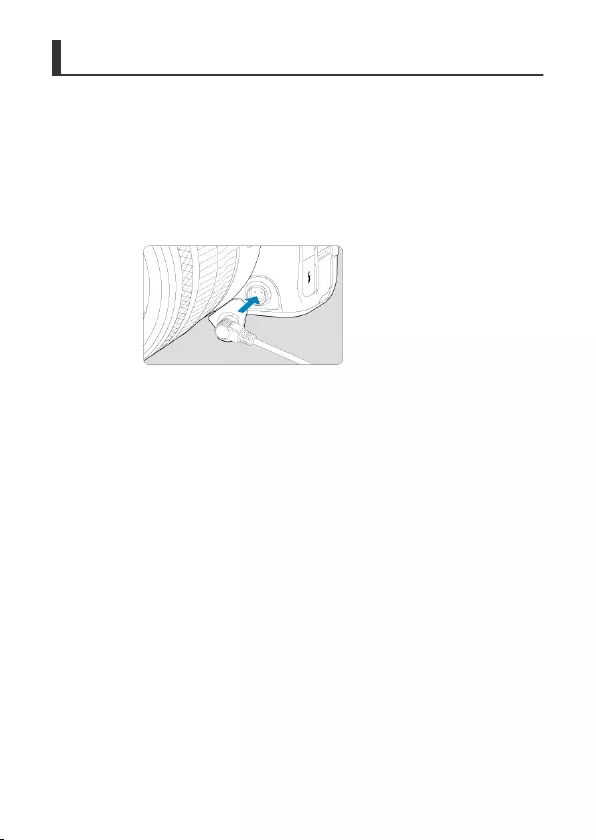
Remote Switch RS-80N3/TC-80N3
Once connected to the camera, the switch enables you to shoot remotely over a wired
connection.
For operating instructions, refer to the accessory instruction manual.
1. Open the terminal cover.
2. Connect the plug to the remote control terminal.
459

Playback
This chapter covers topics related to playback—playing back captured still photos and
movies—and introduces menu settings on the playback ([ ]) tab.
Caution
Normal display or selection on this camera may not be possible for images
captured on other cameras, or images from this camera that have been edited or
renamed on a computer.
•Tab Menus: Playback
•Image Playback
•Magnified Image Display
•Index Display (Multiple-Image Display)
•Voice Memo Recording and Playback
•Movie Playback
•Editing a Movie’s First and Last Scenes
•4K/8K Movie Frame Grab
•Playback on a TV Set
•Protecting Images
•Erasing Images
•Rotating Still Photos
•Changing Movie Orientation Information
•Rating Images
•Print Ordering (DPOF)
•Photobook Set-up
•Copying Images
•RAW Processing (RAW/DPRAW)
•DPRAW Processing
•Resizing JPEG/HEIF Images
•Cropping JPEG/HEIF Images
•Converting HEIF to JPEG
•Slide Show
•Setting Image Search Conditions
•Browsing Images with the Main Dial
•Switching the Main Dial and Quick Control Dial 2
•Rate/Voice Memo Button Function
•Customizing Playback Information Display
460
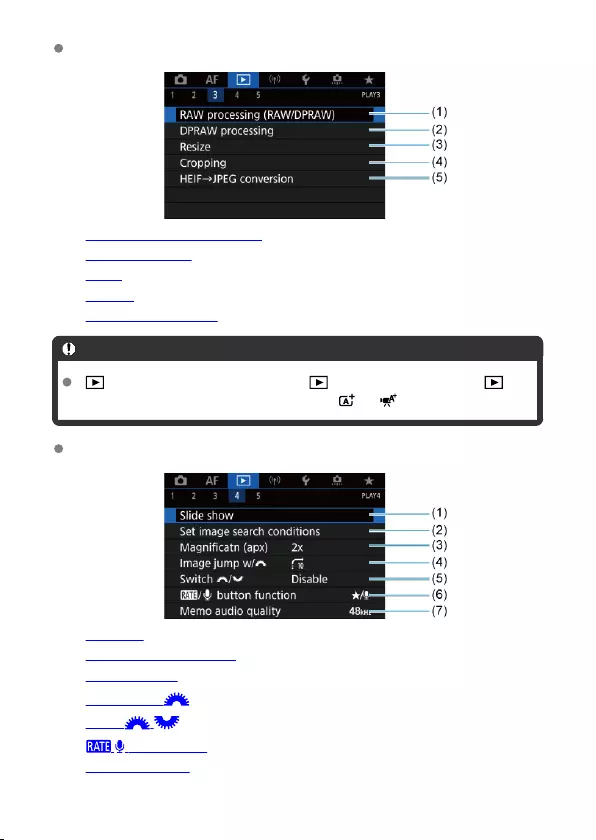
Playback 3
(1) RAW processing (RAW/DPRAW)
(2) DPRAW processing
(3) Resize
(4) Cropping
(5) HEIF→JPEG conversion
Caution
[ : RAW processing (RAW/DPRAW)], [ : DPRAW processing], and [ :
HEIF→JPEG conversion] are not displayed in [ ] or [ ] mode.
Playback 4
(1) Slide show
(2) Set image search conditions
(3) Magnificatn (apx)
(4) Image jump w/
(5) Switch /
(6) / button function
(7) Memo audio quality
463
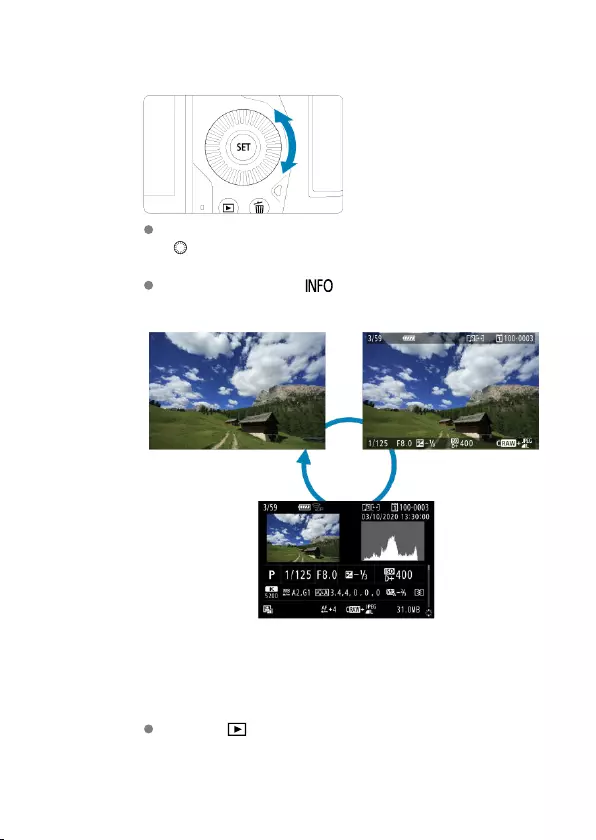
No information Basic information display
Shooting information display
2. Browse images.
To play back images starting with your most recent shot, turn the
< > dial counterclockwise. To play back images starting with the first
captured image, turn the dial clockwise.
Each time you press the < > button, the display will change.
3. Exit image playback.
Press the < > button to exit image playback and return to shooting
standby.
466

Note
Lines indicating the image area are shown on RAW images captured with [ :
Cropping/aspect ratio] set to [1:1 (aspect ratio)], [4:3 (aspect ratio)], or [16:9
(aspect ratio)] ( ).
If the search conditions are set with [ : Set image search conditions] ( ), only
the filtered images will be displayed.
467
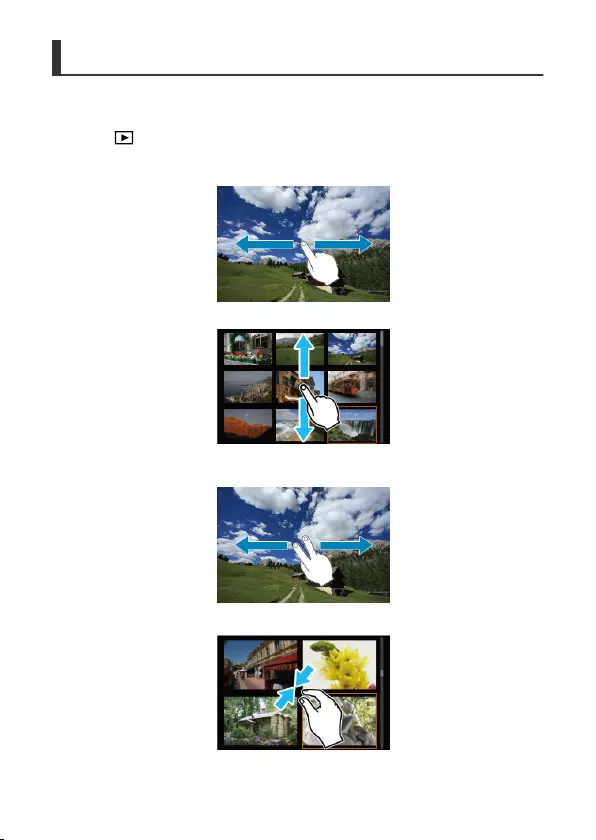
Touch Playback
The camera features a touch-screen panel that you can touch to control playback.
Supported touch operations are like those used with smartphones and similar devices. First,
press the < > button to prepare for touch playback.
Browse images
Jump display
Index display
469

Magnified view
Note
You can also magnify display by double-tapping with one finger.
470

Magnified Image Display
Setting the Initial Magnification Ratio and Position
You can magnify display of your captured images.
1. Magnify the image.
Turn the < > dial clockwise.
The magnified view will appear. The position of the magnified area (1)
is displayed in the lower right of the screen, along with [ ].
To magnify images, turn the < > dial clockwise.
To reduce magnification, turn the < > dial counterclockwise. For
index display ( ), keep turning the dial.
471

2. Scroll the image.
Use < > to scroll around the magnified image.
Press the < > or < > button to exit magnified view.
Note
To switch to other images while maintaining magnified view, turn the < > dial.
Magnification is not available for movies.
472
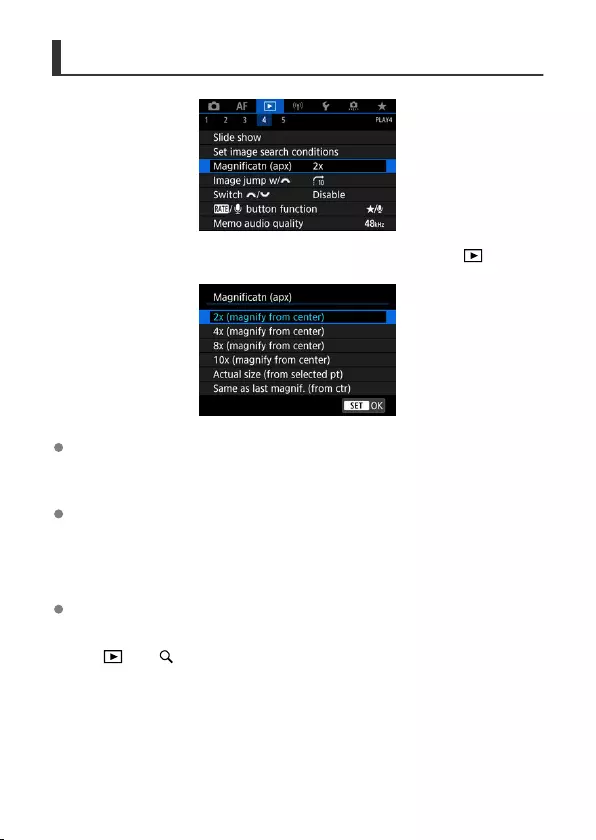
Setting the Initial Magnification Ratio and Position
You can set the initial magnification ratio and magnified position by selecting [ :
Magnificatn (apx)].
2x, 4x, 8x, 10x (magnify from center)
The magnified view starts at the image center at the selected magnification ratio.
Actual size (from selected pt)
The recorded image’s pixels will be displayed at approx. 100%. The magnified view
starts at the AF point that achieved focus. If the photo is taken with manual focus, the
magnified view starts at the image center.
Same as last magnif. (from ctr)
The magnification will be the same as the last time you exited the magnified view with
the < > or < > button. The magnified view starts at the image center.
473
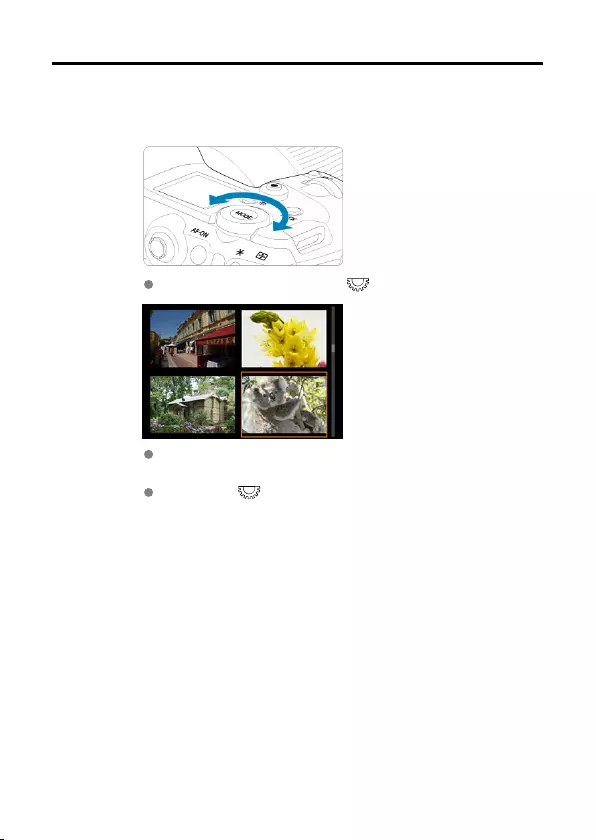
Index Display (Multiple-Image Display)
1. Switch to the index display.
During image playback, turn the < > dial counterclockwise.
The 4-image index display will appear. The selected image is
highlighted with an orange frame.
Turning the < > dial further counterclockwise will switch the display
from 9 to 36 to 100 images. Turning the dial clockwise cycles through
100, 36, 9, 4, and single-image display.
474
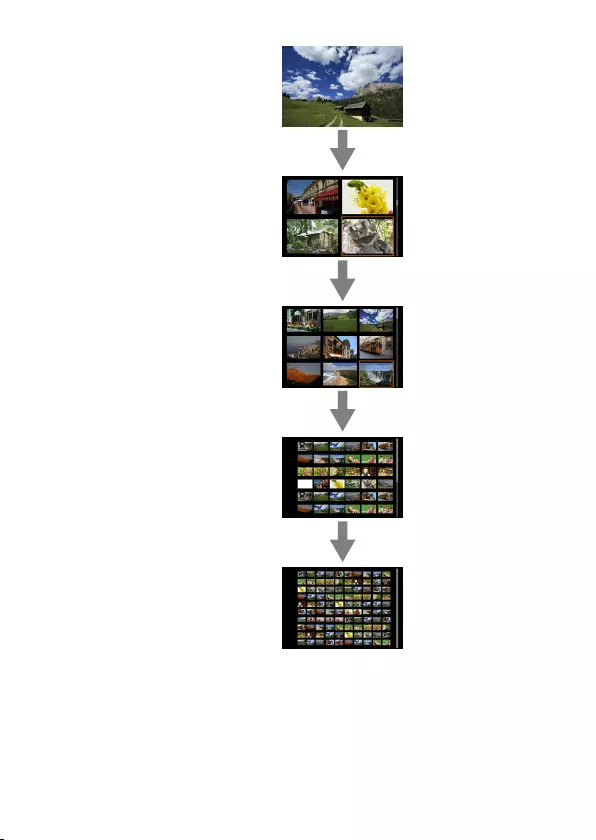
475

2. Browse images.
Use < > or the < > dial to move the orange frame for image
selection.
Press < > in the index display to display the selected image in the
single-image display.
476

Voice Memo Recording and Playback
Recording Voice Memos
Memo Audio Quality
Playing Voice Memos
You can add (record) voice memos to your shots. Voice memos are recorded as WAV audio
files with the same file number as the image. They can be played back by the camera or a
computer.
Recording Voice Memos
1. Switch to playback.
2. Select an image to add a voice memo to.
Turn the < > dial to select an image to add a voice memo to.
477
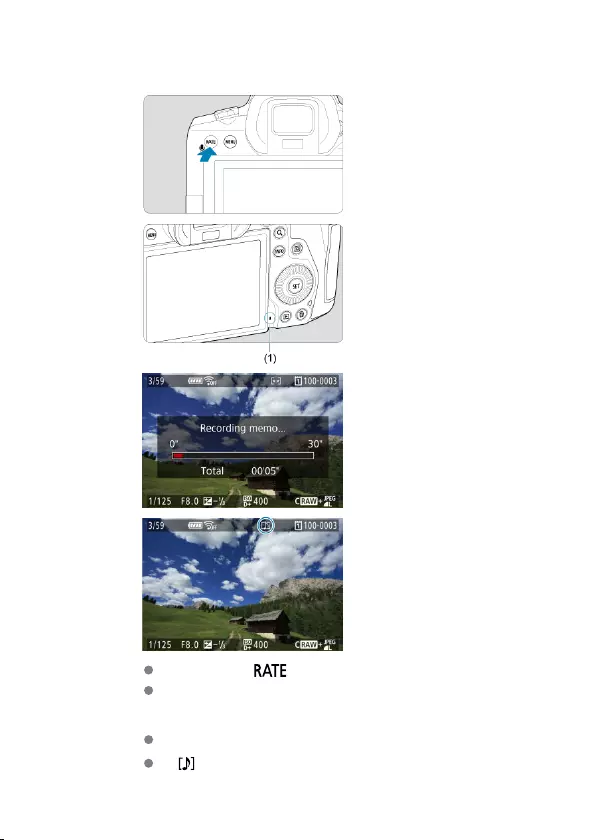
3. Record a voice memo.
Hold down the < > button for approx. 2 sec.
Keep holding down the button after [Recording memo...] appears, and
speak into the voice memo microphone (1). Each recording can be up
to approx. 30 sec.
To end the voice memo, release the button.
A [ ] icon is displayed at the top of the screen.
478

Caution
Voice memos cannot be added to movies or protected images.
Voice memos cannot be recorded with an external microphone.
Note
Audio quality of voice memo recording can be changed in [ : Memo audio
quality].
To record voice memos longer than 30 sec., repeat step 3.
You can record a single voice memo during image review (immediately after
shooting) by following step 3.
Even during transfer to an FTP server, you can add a voice memo to images from
the playback screen. However, voice memos cannot be added to the image
currently being transferred.
479

Memo Audio Quality
You can set the audio quality for recording voice memos.
1. Select [ : Memo audio quality].
2. Select an option.
48 kHz: High quality (48 kHz)
Enables voice memo recording at the same level of audio quality as
movies.
8 kHz: Low quality (8 kHz)
Enables smaller voice memo file sizes than with [High quality (48
kHz)].
Caution
Additional voice memo recording for images with existing voice memos is
performed at the same level of audio quality as the first recording, regardless of this
setting.
480
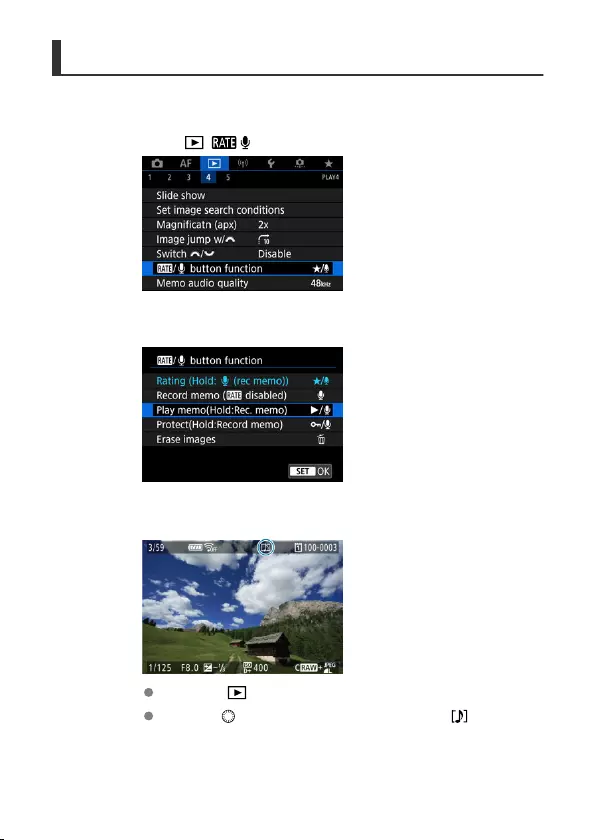
Playing Voice Memos
1. Select [ : / button function].
2. Select [Play memo(Hold:Rec. memo)].
3. Select an image for voice memo playback.
Press the < > button to switch to image playback.
Turn the < > dial to select an image labeled with a [ ] icon at the
top of the screen.
481
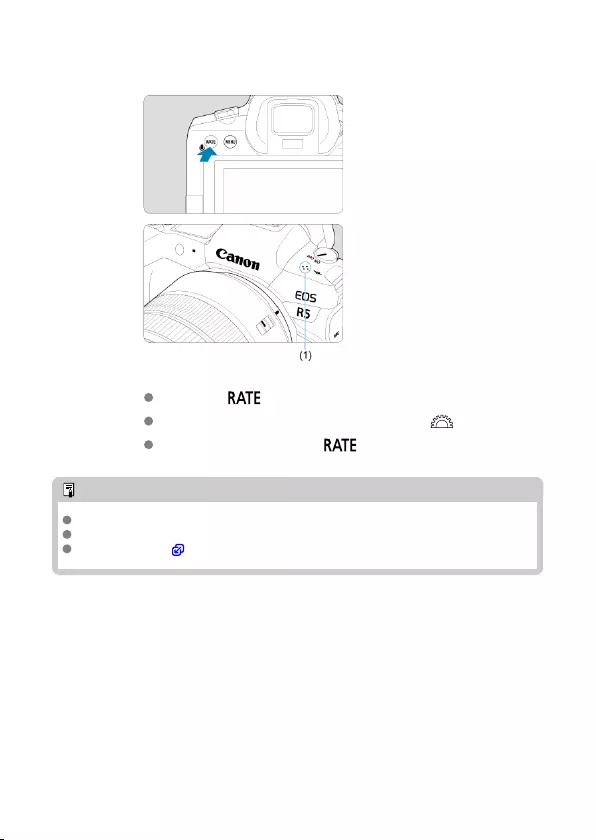
4. Play back the voice memo.
(1) Speaker
Press the < > button to play the voice memo.
You can adjust the sound volume by turning the < > dial.
To stop playback, press the < > button.
Note
Multiple voice memos added to an image are played back consecutively.
Added voice memos cannot be erased by themselves using the camera.
Erasing images ( ) also erases any voice memos added to the images.
482
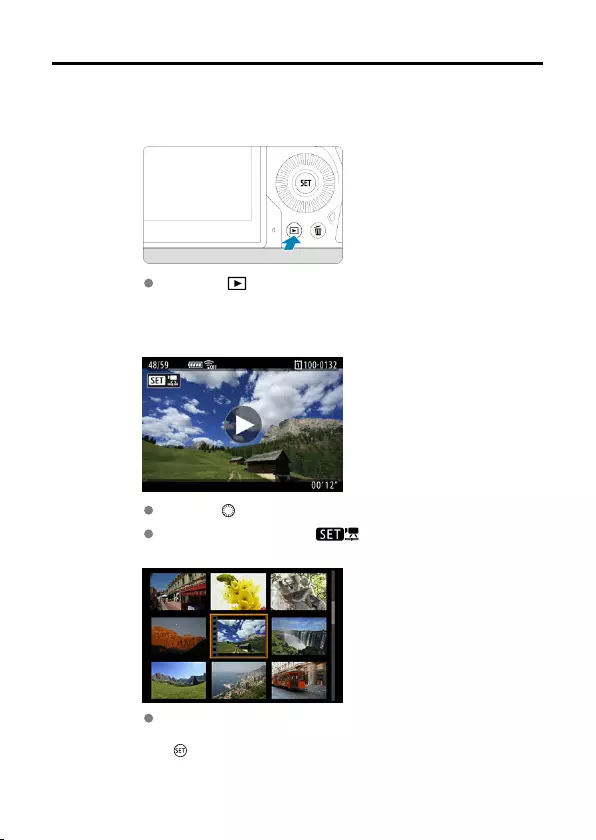
Movie Playback
1. Switch to playback.
Press the < > button.
2. Select a movie.
Turn the < > dial to select a movie to play.
In single-image display, the [ ] icon displayed in the upper left of
the screen indicates a movie.
In index display, perforations at the left edge of a thumbnail indicate a
movie. Movies cannot be played back from index display, so press
< > to switch to single-image display.
483
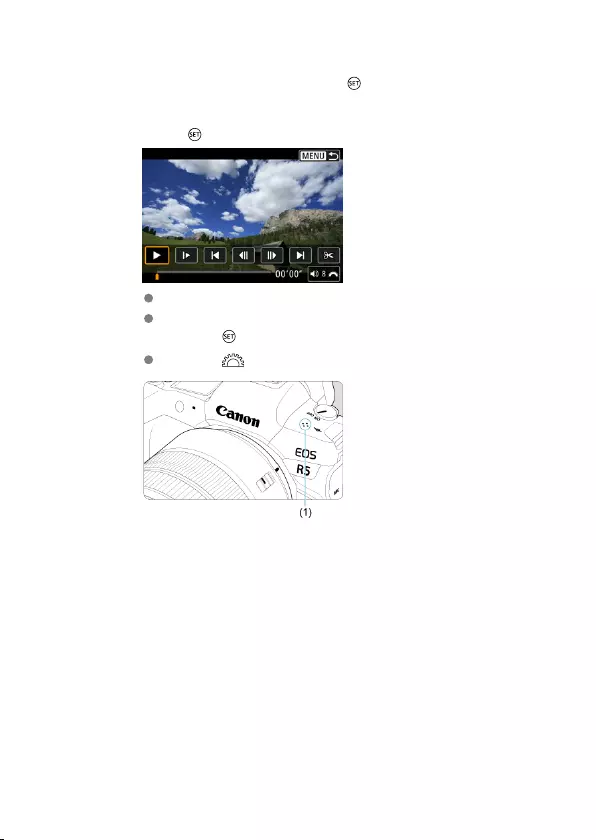
3. In the single-image display, press < >.
4. Press < > to play back the movie.
The movie will start playing back.
You can pause playback and display the movie playback panel by
pressing <>. Press it again to resume the playback.
Turn the < > dial to adjust the volume (even during playback).
(1) Speaker
484
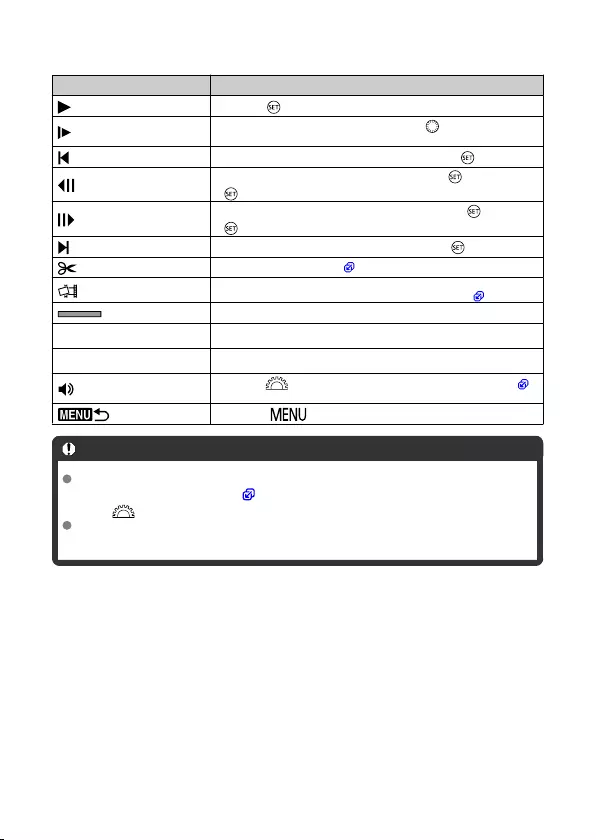
Movie playback panel
Item Playback Operations
Playback Pressing < > toggles between playback and stop.
Slow motion Adjust the slow motion speed by turning the < > dial. The slow
motion speed is indicated in the upper right of the screen.
Skip backward Skips backward approx. 4 sec. each time you press < >.
Previous frame Displays the previous frame each time you press < >. Holding
< > down will rewind the movie.
Next frame Plays the movie frame-by-frame each time you press < >. Holding
<> down will fast forward the movie.
Skip forward Skips forward approx. 4 sec. each time you press < >.
Edit Displays the editing screen ( ).
Frame Grab Available when you play 8K or 4K movies. Enables you to extract the
current frame and save it as a JPEG or HEIF still image ( ).
Playback position
mm' ss" Playback time (minutes:seconds, when [Movie play count] is set to
[Rec time])
hh:mm:ss.ff (DF)
hh:mm:ss:ff (NDF)
Time code (hours:minutes:seconds:frames, when [Movie play count]
is set to [Time code])
Volume Turn the < > dial to adjust the volume of the built-in speaker ( )
or headphones.
Press the < > button to return to single-image display.
Caution
Adjust the volume using television controls when the camera is connected to a
television for movie playback ( ), because volume cannot be adjusted by turning
the < > dial.
Movie playback may stop if the card’s read speed is too slow or movie files have
corrupted frames.
485
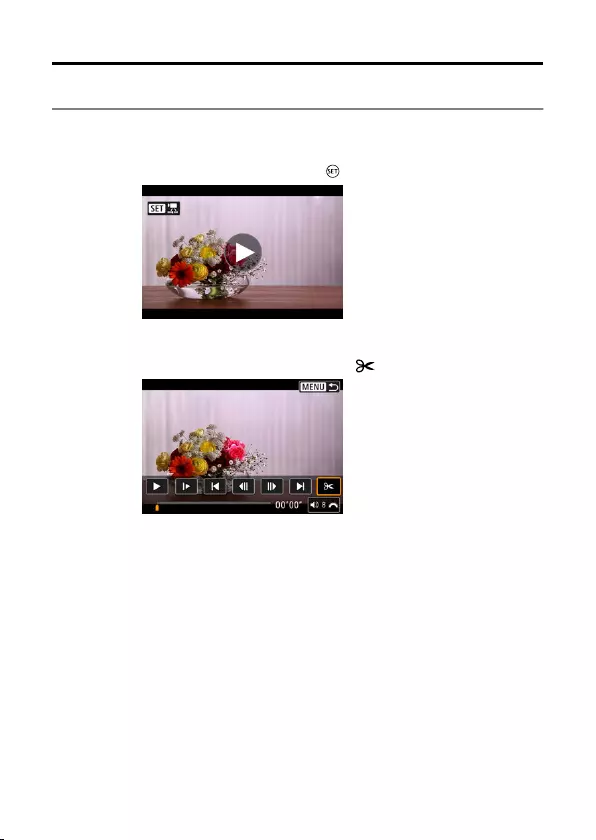
Editing a Movie’s First and Last Scenes
You can edit out the first and last scenes of a movie in approx. 1-sec. increments.
1. In single-image display, press < >.
2. On the movie playback panel, select [ ].
486

3. Specify the part to be edited out.
Select either [ ] (Cut beginning) or [ ] (Cut end).
Press < > left or right to go back or forward one frame. Keep
pressing the multi-controller to fast rewind or fast forward frames. Each
turn of the < > dial goes back or forward one frame.
After deciding which part to edit out, press < >. The portion indicated
by a line at the bottom of the screen will remain.
4. Check the edited movie.
Select [ ] to play back the edited movie.
To change the edited part, go back to step 3.
To cancel the editing, press the < > button.
487
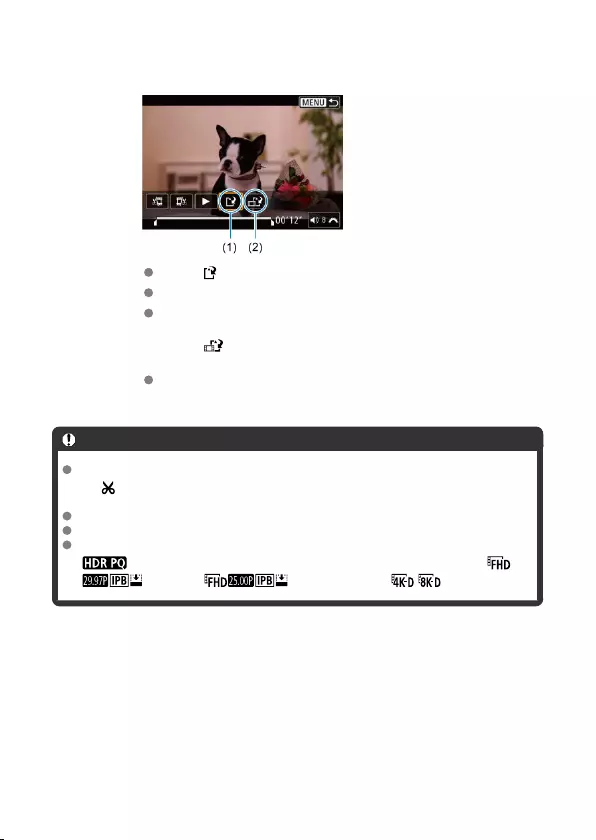
5. Save.
Select [ ] (1).
The save screen will appear.
To save it as a new file, select [New file], or to save it and overwrite the
original movie file, select [Overwrite].
Select [ ] (2) to save a compressed version of the file. 4K and 8K
movies are converted to Full HD movies before compression.
On the confirmation screen, select [OK] to save the edited movie and
return to the movie playback screen.
Caution
Because editing is performed in approx. 1 sec. increments (at the position indicated
by [ ] at the bottom of the screen), the actual position where movies are trimmed
may differ from your specified position.
Movies shot with another camera cannot be edited with this camera.
You cannot edit a movie when the camera is connected to a computer.
Compress and save is not available for movies recorded with [HDR shooting
] set to [Enable] or [Canon Log] set to [On], for movies recorded in
(NTSC) or (PAL) sizes, or for / movies.
488
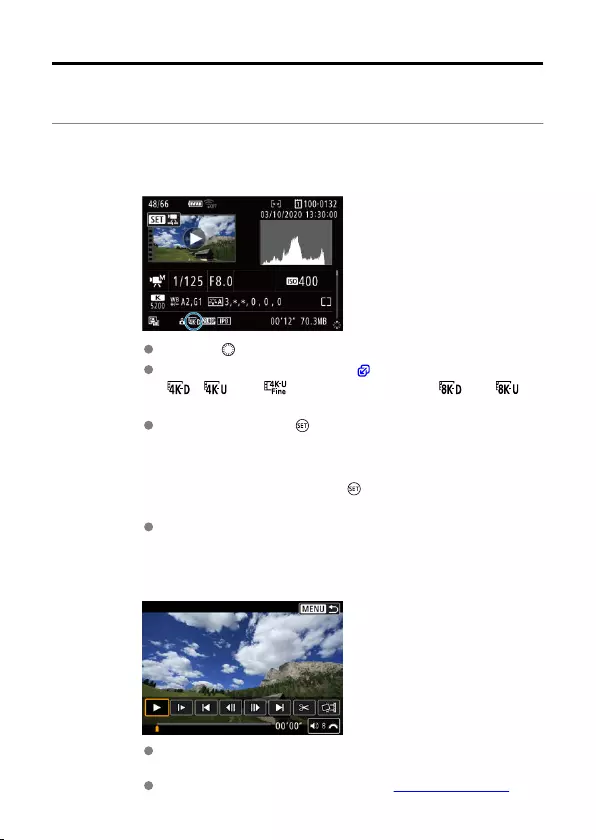
4K/8K Movie Frame Grab
From 4K or 8K movies, you can select individual frames to save as JPEG or HEIF still
images. This function is called “Frame Grab.”
1. Select a 4K or 8K movie.
Turn the < > dial to select a movie in 4K or 8K quality.
On the shooting information screen ( ), 4K movies are labeled with
[ ], [ ], and [ ] icons, and 8K movies with [ ] and [ ]
icons.
In index display, press < > to switch to single-image display.
2. In the single-image display, press < >.
The movie playback panel will appear.
3. Select a frame to grab.
Use the movie playback panel to select the frame to grab as a still
image.
For movie playback panel instructions, see Movie playback panel.
489
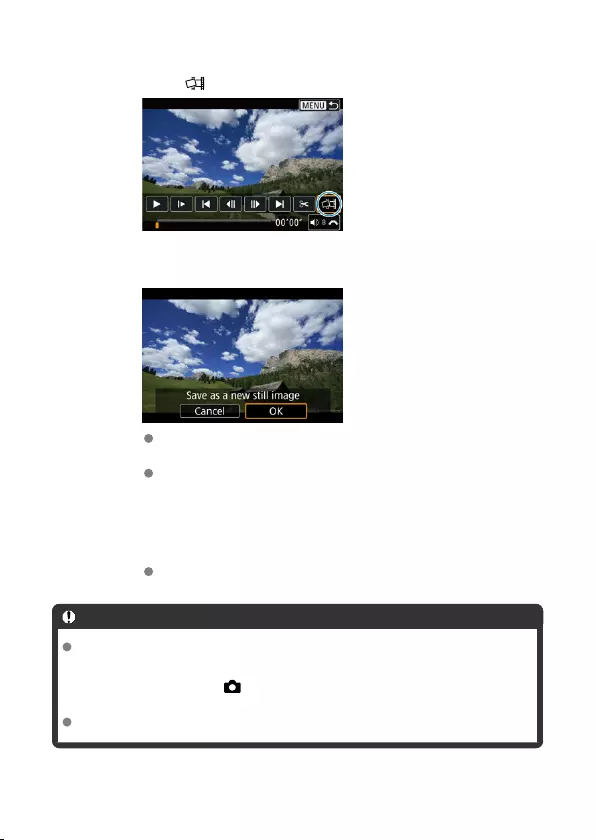
4. Select [ ].
5. Save.
Select [OK] to save the current frame as a JPEG still image.
Frame grabs from HDR movie files are saved as HEIF images.
Check the destination folder and image file number.
6. Select the image to display.
Select [View original movie] or [View extracted still image].
Caution
Frame grabbing is not possible from the following 4K movies, or from 8K movies.
• RAW movies
• Movies recorded with [ : Canon Log settings] set to [On]
• Movies recorded with other cameras
Frame grabbing is not possible while the camera is connected to a computer.
490
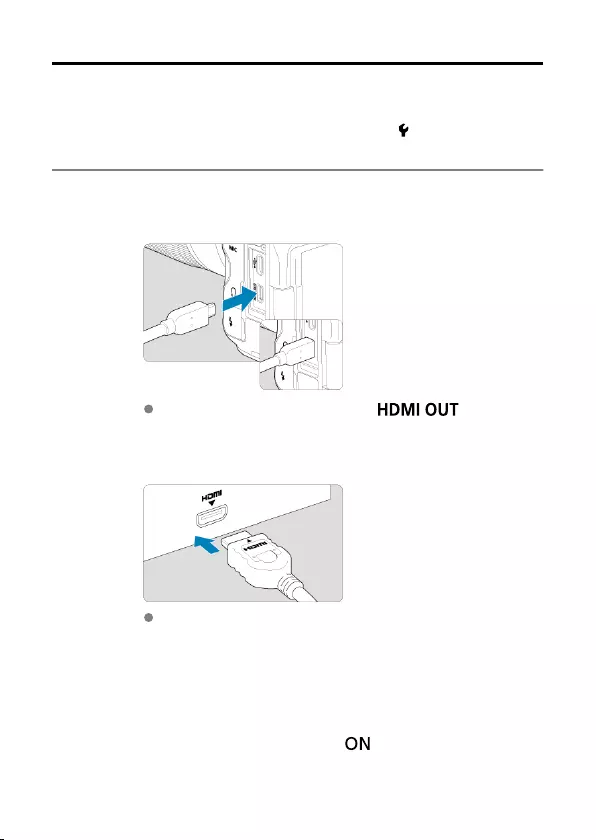
Playback on a TV Set
By connecting the camera to a television with a commercially available HDMI cable, you can
play back the captured still photos and movies on the television.
If the image does not appear on the TV screen, confirm that [ : Video system] is
correctly set to [For NTSC] or [For PAL] (depending on the video system of your
television).
1. Connect the HDMI cable to the camera.
Insert the HDMI cable in the camera’s < > terminal.
2. Connect the HDMI cable to the television.
Connect the HDMI cable to the television’s HDMI IN port.
3. Turn on the television and switch the television’s video input to select
the connected port.
4. Set the camera’s power switch to < >.
491
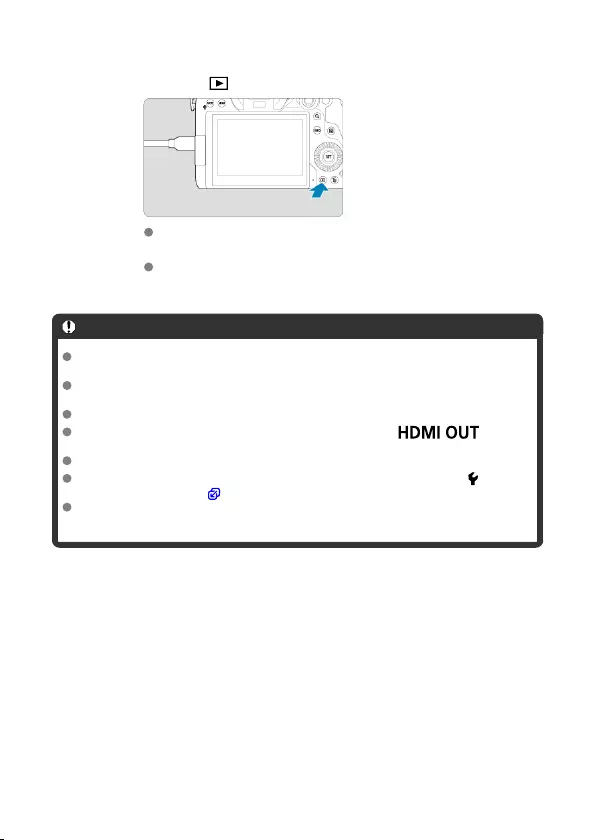
5. Press the < > button.
Images are now displayed on the television, with nothing displayed on
the camera screen.
The images will automatically be displayed at the optimum resolution
matching the connected television.
Caution
Adjust movie sound volume with the television. The sound volume cannot be
adjusted with the camera.
Before connecting or disconnecting the cable between the camera and television,
turn off the camera and television.
Depending on the television, part of the image displayed may be cut off.
Do not connect any other device’s output to the camera’s < >
terminal. Doing so may cause a malfunction.
Certain televisions may not display the images due to incompatibility.
It may take some time before images are displayed. To avoid delay, set [ : HDMI
resolution] to [1080p] ( ).
Touch-screen operations are not supported while the camera is connected to a
television.
492

Protecting Images
Protecting Individual Images via the Menu
Specifying the Range of Images to Protect
Protecting All Images in a Folder or on a Card
You can protect important images from being accidentally erased.
Caution
If you format the card ( ), the protected images will also be erased.
Note
Once an image is protected, it cannot be erased by the camera’s erase function. To
erase a protected image, you must first cancel the protection.
If you erase all the images ( ), only the protected images will remain. This is
convenient when you want to erase all unneeded images at once.
Protecting Individual Images via the Menu
1. Select [ : Protect images].
493
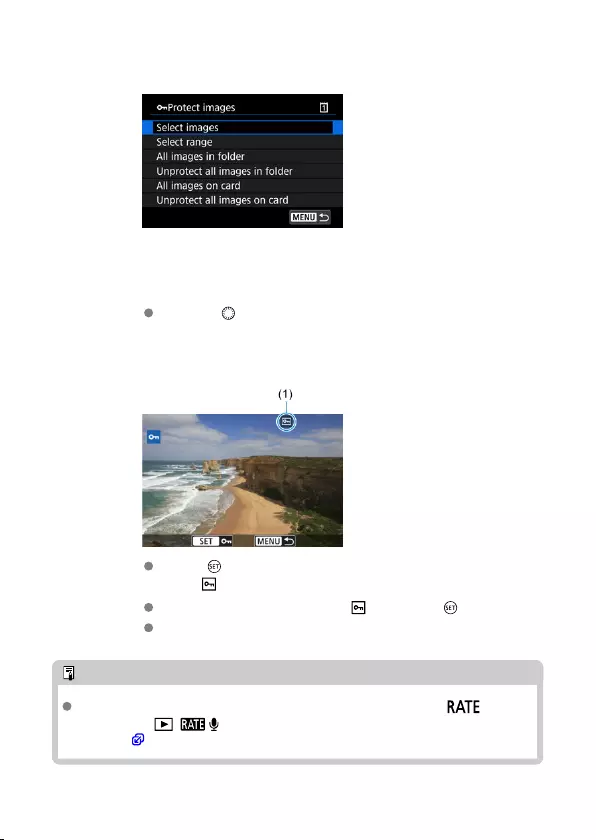
2. Select [Select images].
3. Select the image to protect.
Turn the < > dial to select an image to protect.
4. Protect the image.
Press < > to protect the selected image, after which it will be labeled
with a [ ] icon (1) at the top of the screen.
To cancel protection and clear the [ ] icon, press < > again.
To protect another image, repeat steps 3 and 4.
Note
You can protect individual images during playback by pressing the < >
button when [ : / button function] is assigned to [Protect(Hold:Record
memo)] ( ).
494

Specifying the Range of Images to Protect
While looking at the images in the index display, you can specify the first and last images for
a range to protect all the specified images at once.
1. Select [Select range].
Select [Select range] in [ : Protect images].
2. Specify the range of images.
Select the first image (start point).
Next, select the last image (end point). The images in the specified
range will be protected and the [ ] icon will appear.
To select another image to protect, repeat step 2.
495
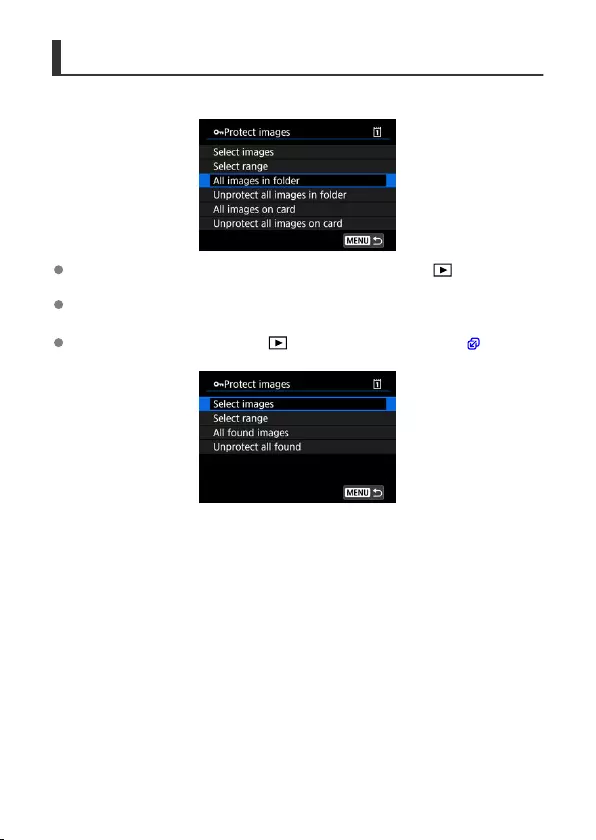
Protecting All Images in a Folder or on a Card
You can protect all the images in a folder or on a card at once.
When you select [All images in folder] or [All images on card] in [ : Protect
images], all the images in the folder or on the card will be protected.
To cancel protection, select [Unprotect all images in folder] or [Unprotect all images
on card].
If the search conditions are set with [ : Set image search conditions] ( ), the
display will change to [All found images] and [Unprotect all found].
• If you select [All found images], all the images filtered by the search conditions will be
protected.
• If you select [Unprotect all found], the protection of all the filtered images will be
canceled.
496
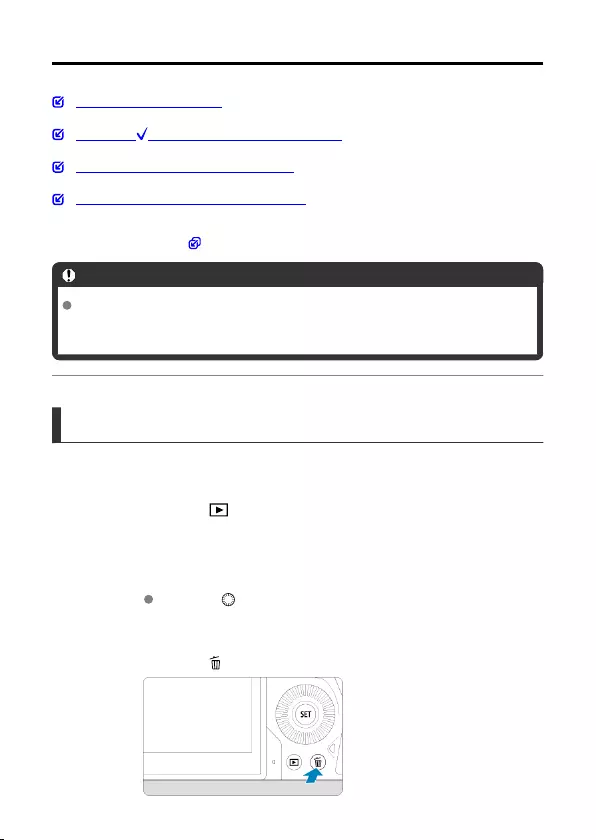
Erasing Images
Erasing Images Individually
Selecting ([ ]) Multiple Images to Erase Together
Specifying the Range of Images to Erase
Erasing All Images in a Folder or on a Card
You can either select and erase unnecessary images individually or erase them in one
batch. Protected images ( ) will not be erased.
Caution
Once an image is erased, it cannot be recovered. Make sure you no longer
need the image before erasing it. To prevent important images from being
erased accidentally, protect them.
Erasing Images Individually
1. Press the < > button.
2. Select the image to be erased.
Turn the < > dial to select the image to erase.
3. Press the < > button.
497
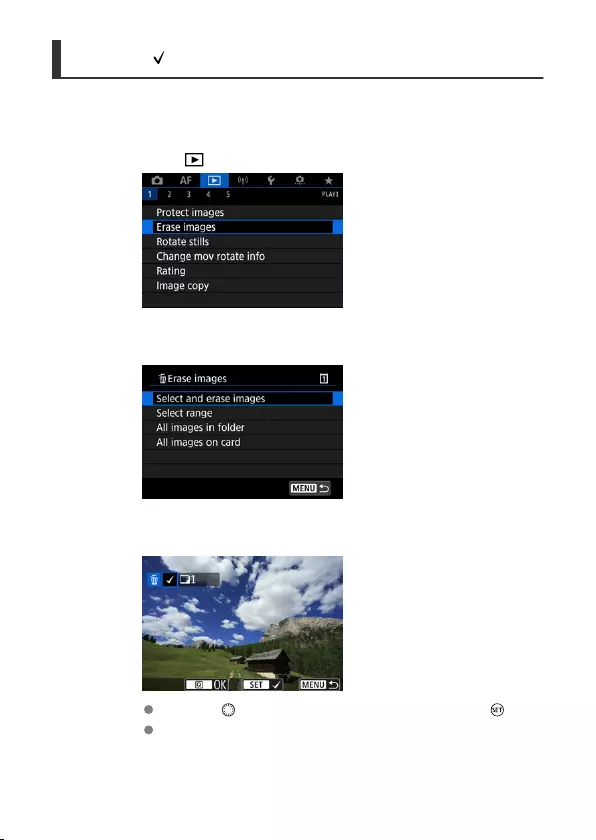
Selecting ([ ]) Multiple Images to Erase Together
By adding checkmarks to the images to be erased, you can erase all those images at once.
1. Select [ : Erase images].
2. Select [Select and erase images].
3. Select an image.
Turn the < > dial to select an image to erase, then press < >.
To select another image to be erased, repeat step 3.
499

4. Erase the images.
Press the < > button, then press [OK].
500

Specifying the Range of Images to Erase
While looking at the images in the index display, you can specify the first and last images for
a range to erase all the specified images at once.
1. Select [Select range].
Select [Select range] in [ : Erase images].
2. Specify the range of images.
Select the first image (start point).
Next, select the last image (end point). A checkmark [ ] will be
appended to all the images within the range between first and last
images.
To select another image to be erased, repeat step 2.
3. Press the < > button.
501

4. Erase the images.
Select [OK].
502
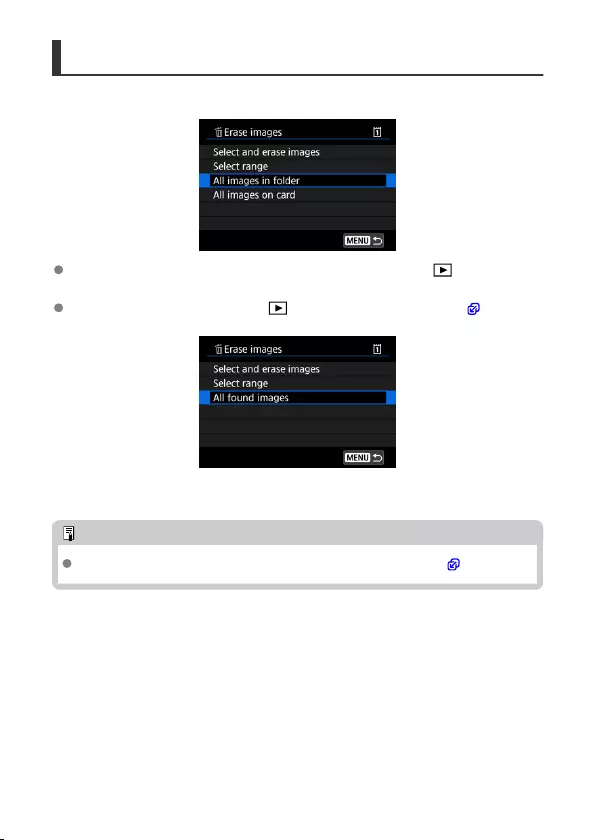
Erasing All Images in a Folder or on a Card
You can erase all the images in a folder or on a card at once.
When you select [All images in folder] or [All images on card] in [ : Erase images],
all the images in the folder or on the card will be erased.
If the search conditions are set with [ : Set image search conditions] ( ), the
display will change to [All found images].
• If you select [All found images], all the images filtered by the search conditions will be
erased.
Note
To erase all the images including protected images, format the card ( ).
503

Rotating Still Photos
You can use this feature to rotate the displayed image to the desired orientation.
1. Select [ : Rotate stills].
2. Select an image to rotate.
Turn the < > dial to select the image.
504

3. Rotate the image.
Each time you press < >, the image will rotate clockwise as follows:
90°→270°→0°.
To rotate another image, repeat steps 2 and 3.
Note
If you set [ : Auto rotate] to [On ] ( ) before taking pictures, you need not
rotate the image with this function.
If the rotated image is not displayed in the rotated orientation during image
playback, set [ : Auto rotate] to [On ].
Movies cannot be rotated.
505
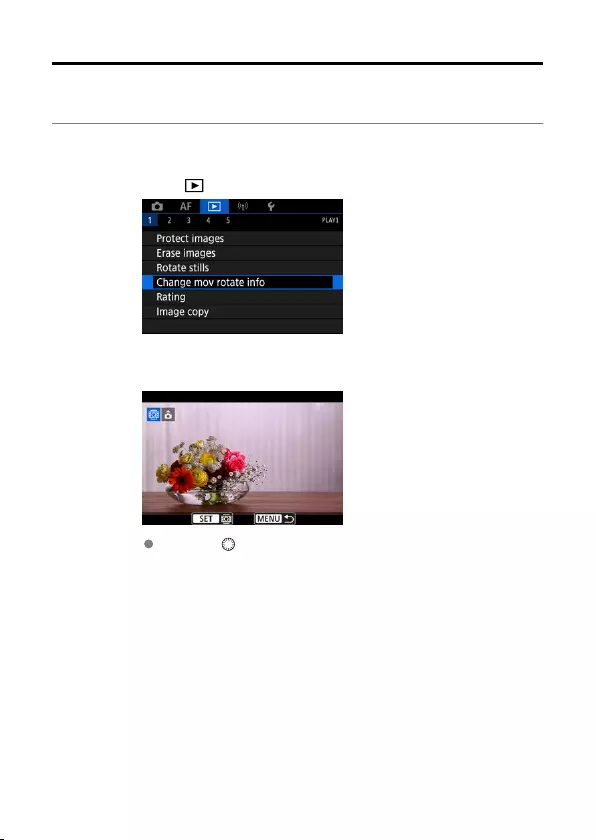
Changing Movie Orientation Information
You can manually edit movie playback orientation information (which determines which side
is up).
1. Select [ : Change mov rotate info].
2. Select a movie.
Turn the < > dial to select a movie with orientation information to
change.
506
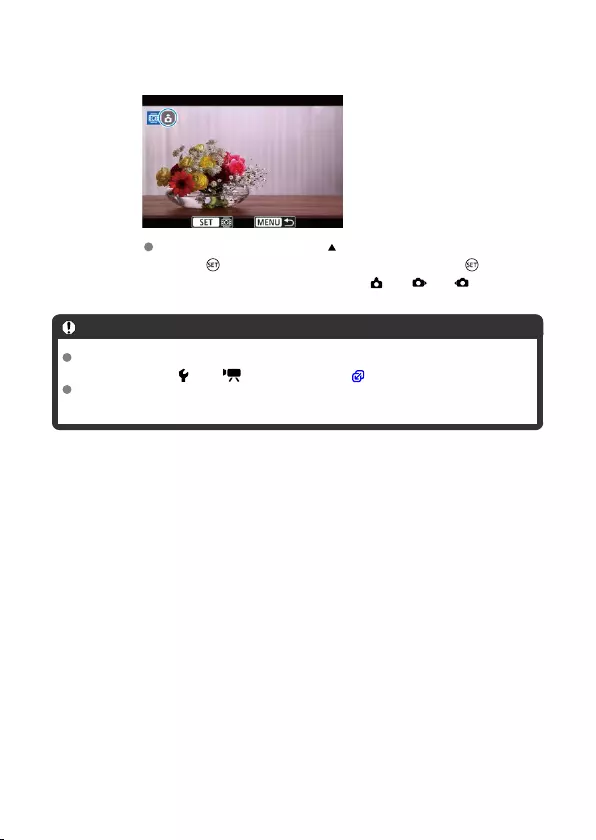
3. Change the orientation information.
As you watch the camera and icon in the upper left of the screen,
press < > to specify which side is up. Each press of < > edits the
movie rotation information as follows: [ ] → [ ] → [ ].
Caution
Movies are played horizontally on the camera and via HDMI video output,
regardless of the [ : Add rotate info] setting ( ).
Movie orientation information of movies recorded with other cameras cannot be
edited with this camera.
507
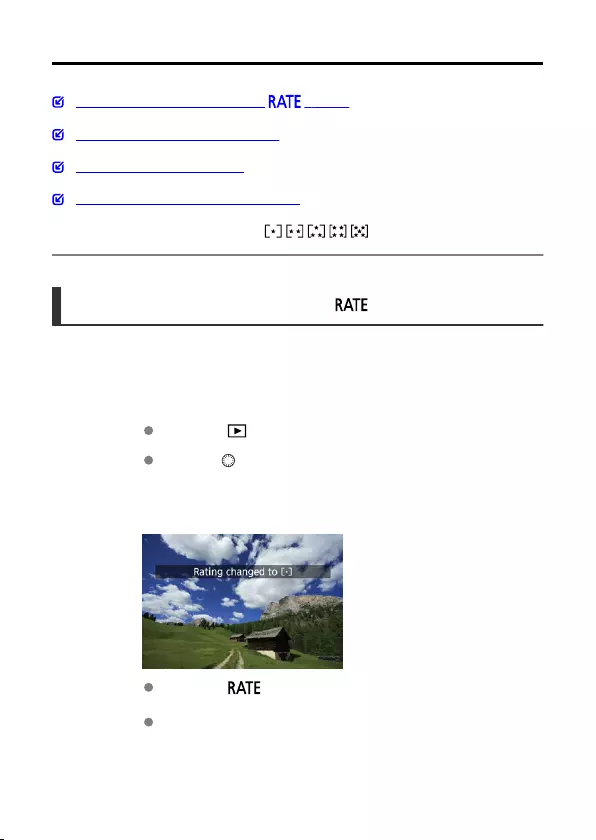
Rating Images
Rating Individual Images With the < > Button
Rating Individual Images via the Menu
Rating by Specifying the Range
Rating All Images in a Folder or on a Card
You can rate images on a scale of 1–5 ( / / / / ). This function is called rating.
*Rating images can help you organize them.
Rating Individual Images With the < > Button
1. Select the image to be rated.
Press the < > button to switch to image playback.
Turn the < > dial to select the image to be rated.
2. Rate the image.
Press the < > button to rate the image, after which a message is
displayed on the screen.
To rate another image, repeat steps 1 and 2.
508

Note
In the detailed settings for [Rating (Hold: (rec memo))] in [ : / button
function], you can select the rating to apply.
509
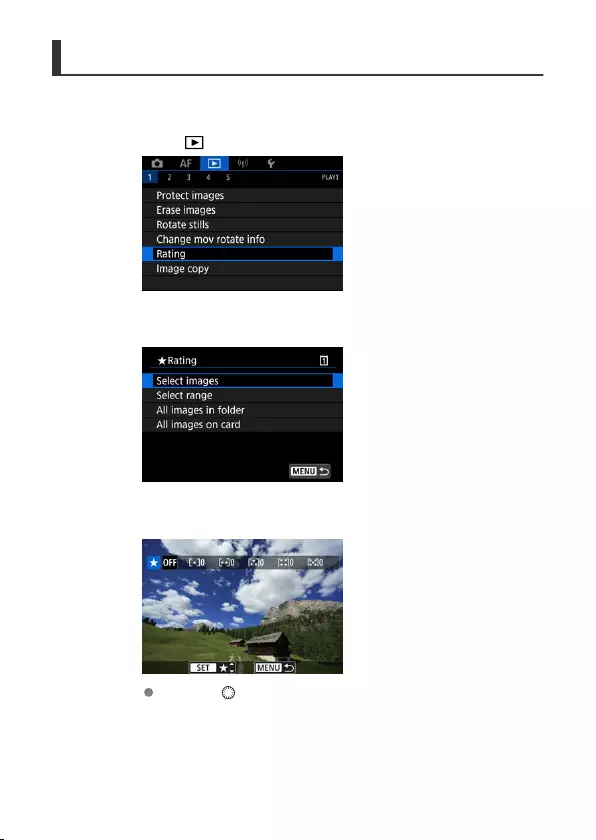
Rating Individual Images via the Menu
1. Select [ : Rating].
2. Select [Select images].
3. Select the image to be rated.
Turn the < > dial to select the image to be rated.
510

4. Rate the image.
Press < >, and a blue highlight frame will appear as shown in the
screen shown above.
Turn the < > dial to select a rating mark, then press < >.
When you append a rating mark to the image, the number beside the
set rating will increase by one.
To rate another image, repeat steps 3 and 4.
511
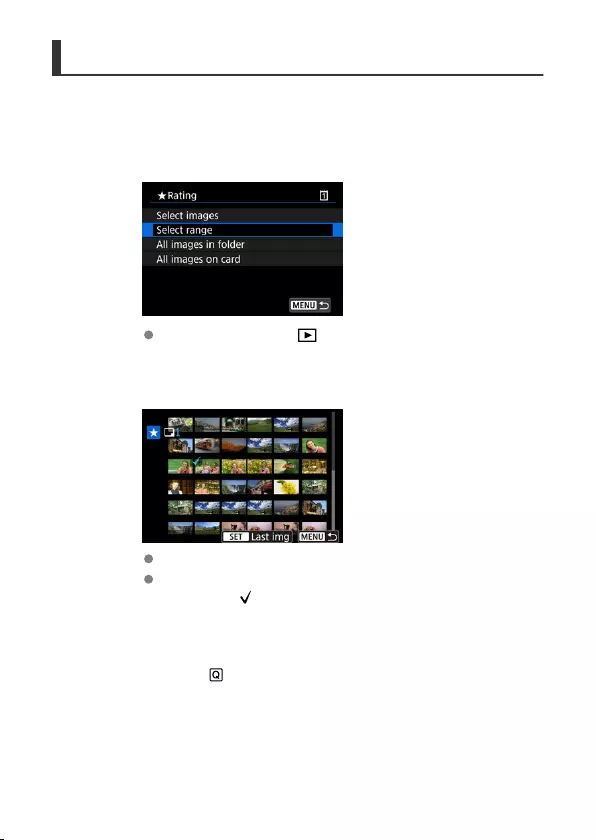
Rating by Specifying the Range
While looking at the images in the index display, you can specify the first and last images for
a range to rate all the specified images at once.
1. Select [Select range].
Select [Select range] in [ : Rating].
2. Specify the range of images.
Select the first image (start point).
Next, select the last image (end point).
A checkmark [ ] will be appended to all the images within the range
between first and last images.
3. Press the < > button.
512

4. Rate the images.
Turn the < > dial to select a rating mark, then select [OK].
All the images in the specified range will be rated (same rating) at
once.
513

Rating All Images in a Folder or on a Card
You can rate all the images in a folder or on a card at once.
Under [ : Rating], when you select [All images in folder] or [All images on card], all
the images in the folder or on the card will be rated.
Turn the < > dial to select a rating, then select [OK].
When you are not rating images or canceling the rating, select [ ].
If the search conditions are set with [ : Set image search conditions] ( ), the
display will change to [All found images].
If you select [All found images], all the images filtered by the search conditions will be
rated as specified.
514

Note
Values next to ratings are displayed as [###] if more than 1,000 images have that
rating.
With [ : Set image search conditions] and [ : Image jump w/ ], you can
display only the images given a specific rating.
515
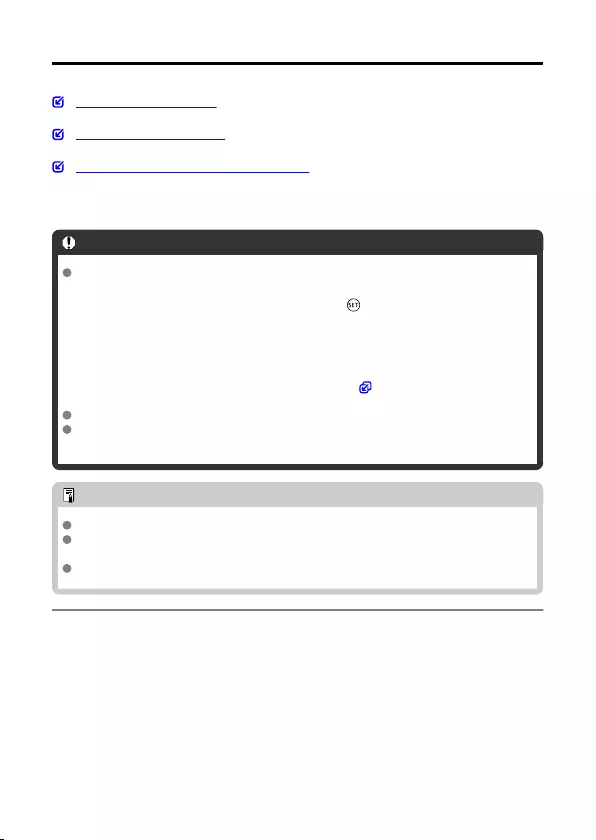
Copying Images
Copying Individual Images
Copying a Range of Images
Copying All Images in a Folder or on a Card
You can copy the images on one card to the other card to save duplicates.
All images in a folder or on a card can also be copied at the same time.
Caution
If the target folder or card already has an image with the same file number, [Skip
image and continue], [Replace existing image], and [Cancel copy] are
displayed. Select a copying method, then press < >.
• [Skip image and continue]: Any images with the same file number are
skipped and not copied.
• [Replace existing image]: Any images with the same file number (including
protected images) are overwritten.
Overwriting images that had print order information ( ) will require you to set the
print order information again.
Print order and image transfer information is not included in copies of images.
Shooting is not possible during the copying process. Select [Cancel] before
shooting.
Note
Copies of images have the same file name as the original image.
With [Sel.Image], images in multiple folders cannot be copied at the same time.
Select images to copy from one folder at a time.
Any voice memos added to images are also copied.
516
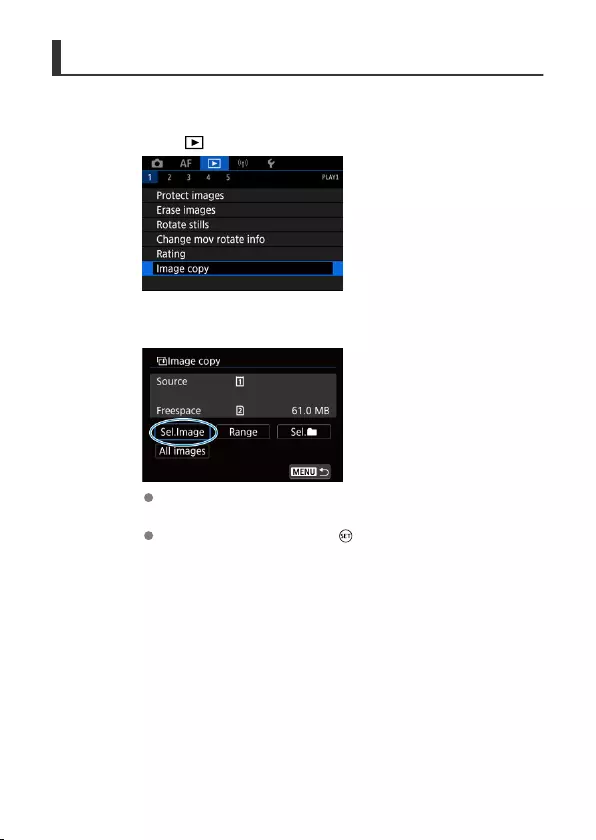
Copying Individual Images
1. Select [ : Image copy].
2. Select [Sel.Image].
Check the source and target card numbers and the free space on the
target card.
Select [Sel.Image], then press < >.
517
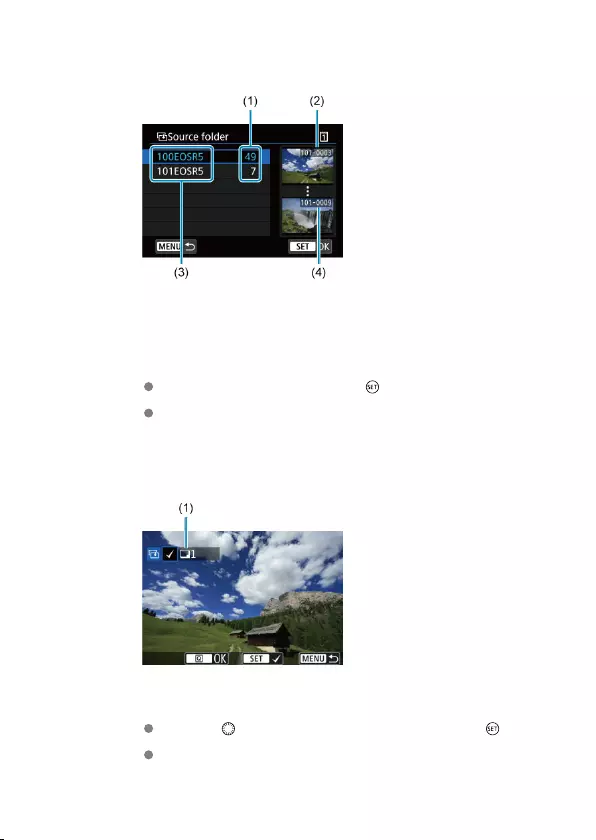
3. Select the folder.
(1) Number of images in folder
(2) Lowest file number
(3) Folder name
(4) Highest file number
Select the source folder, then press < >.
When selecting the folder, refer to the images displayed at right of the
screen.
4. Select an image to copy.
(1) Total images selected
Turn the < > dial to select an image to copy, then press < >.
To select another image to copy, repeat step 4.
518

5. Press the < > button.
6. Select [OK].
Check the target card, then select [OK].
7. Select the target folder.
Select the folder to copy the image to, then press < >.
To create a new folder, select [Create folder].
519
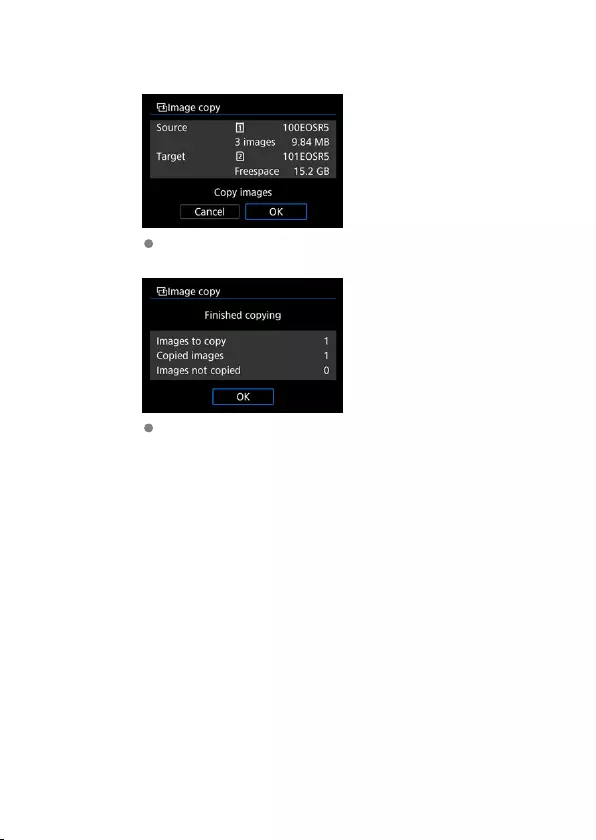
8. Select [OK].
Check the information about the source and target card, then select
[OK].
Results are displayed after copying is finished. Select [OK] to return to
the screen in step 2.
520

Copying a Range of Images
You can copy all specified images at once by selecting the first and last images in a range
as you look at images in the index display.
1. Select [Range].
2. Select the folder.
Select the source folder, then press < >.
When selecting the folder, refer to the images displayed at right of the
screen.
521

3. Specify the range of images.
Select the first image (start point).
Next, select the last image (end point). A checkmark [ ] will be
appended to all the images within the range between first and last
images.
To select another image to copy, repeat step 3.
522
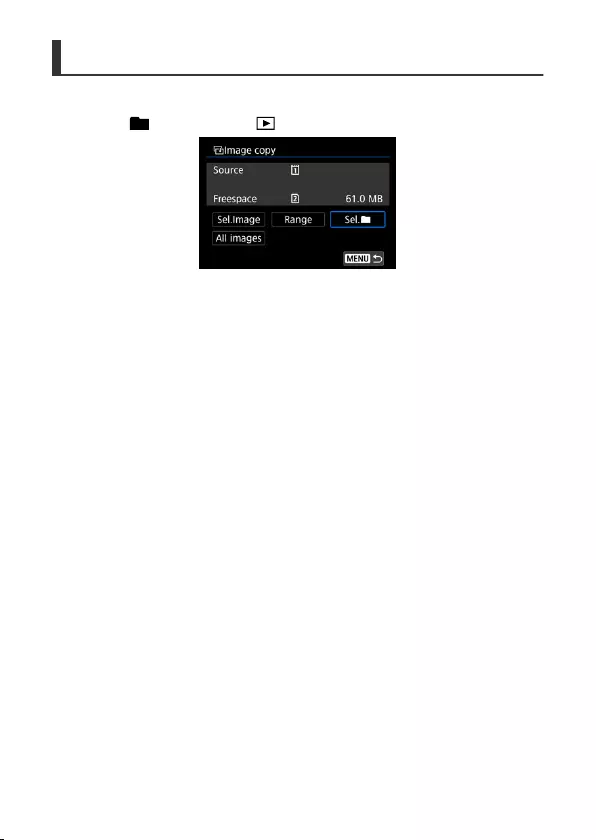
Copying All Images in a Folder or on a Card
You can copy all the images in a folder or on a card at once.
Selecting [Sel. ] or [All images] in [ : Image copy] copies all the images it contains.
523
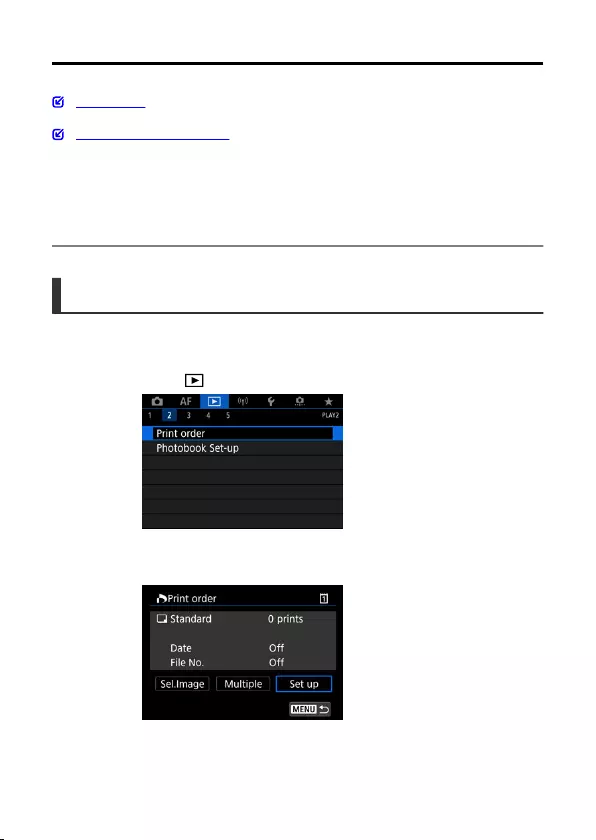
Print Ordering (DPOF)
Print Options
Selecting Images for Printing
DPOF (Digital Print Order Format) enables you to print images recorded on the card
according to your printing instructions such as the image selection, quantity to print, etc. You
can print multiple images in one batch or create a print order for a photofinisher.
You can set the print settings such as print type, date imprinting, file number imprinting, etc.
The print settings will be applied to all the images specified for printing. (They cannot be set
individually for each image.)
Print Options
1. Select [ : Print order].
2. Select [Set up].
524
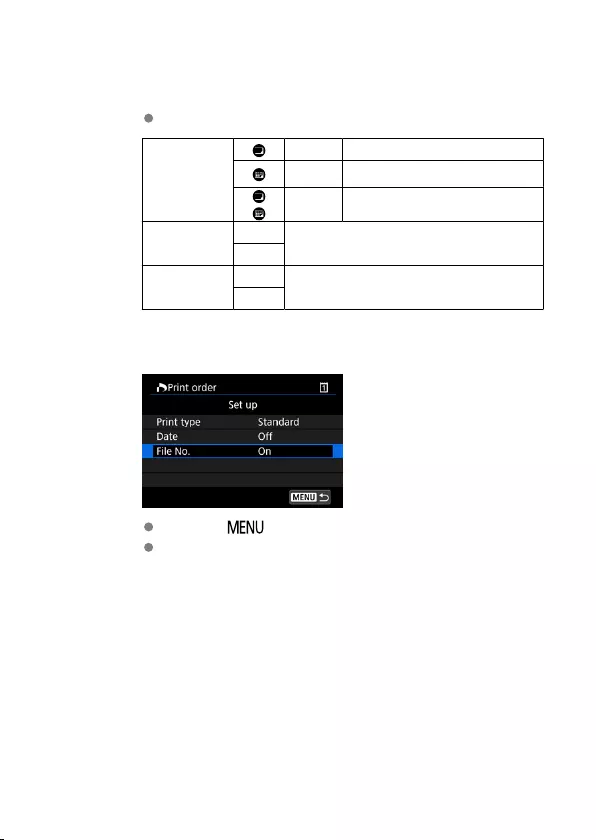
3. Set the options as desired.
Set [Print type], [Date], and [File No.] options.
Print type
Standard Prints one image on one sheet.
Index Multiple thumbnail images are printed
on one sheet.
Both Prints both the standard and index
prints.
Date
On [On] imprints the recorded date of the captured
image.
Off
File No.
On
[On] imprints the file number.
Off
4. Exit the setting.
Press the < > button.
Next, select [Sel.Image] or [Multiple] to specify the images to be
printed.
525

Caution
If you print an image with a large image size using the [Index] or [Both] setting
( ), the index print may not be printed with certain printers. In this case, resize the
image ( ), then print the index print.
Even if [Date] and [File No.] are set to [On], the date or file number may not be
imprinted, depending on the print type setting and printer.
With [Index] prints, the [Date] and [File No.] cannot both be set to [On] at the same
time.
When printing with DPOF, use the card for which print order specifications are set.
You cannot print in the specified print order if you extract just the images from the
card for printing.
Certain DPOF-compliant printers and photofinishers may not be able to print the
images as you specified. When using a printer, refer to the printer’s instruction
manual. When requesting service from a photofinisher, ask in advance.
Do not use this camera to configure print settings for images with DPOF settings
set up on another camera. All the print orders may be overwritten inadvertently.
Also, the print order may not be possible, depending on the image type.
526

Selecting Images for Printing
Sel.Image
Select and specify the images individually.
Press the < > button to save the print order to the card.
Standard/Both
(1) Quantity
(2) Total images selected
Press < > to print a copy of the displayed image. By turning the < > dial, you can
set a print quantity of up to 99 copies.
Index
(3) Checkmark
(4) Index icon
Press < > to add a checkmark [ ] to the box. The image will be included in the index
print.
527

Multiple
Select range
Select [Select range] in [Multiple]. Selecting the first and last images of the range
marks all the images in the range with a checkmark [ ], and one copy of each image
will be specified for printing.
All images in a folder
Select [Mark all in folder] and select the folder. A print order for one copy of all the
images in the folder will be specified.
If you select [Clear all in folder] and select the folder, the print order for all the images
in the folder will be canceled.
All images on a card
If you select [Mark all on card], one copy of all the images on the card will be specified
for printing.
If you select [Clear all on card], the print order will be cleared for all the images on the
card.
If the search conditions are set with [ : Set image search conditions] ( ) and you
select [Multiple], the display will change to [Mark all found images] and [Clear all found
images].
All found images
If you select [Mark all found images], one copy of all the images filtered by the search
conditions will be specified for printing.
If you select [Clear all found images], all the print order of the filtered images will be
cleared.
Caution
RAW images or movies cannot be specified for printing. Note that RAW images or
movies will not be specified for printing even if you specify all images with
[Multiple].
528
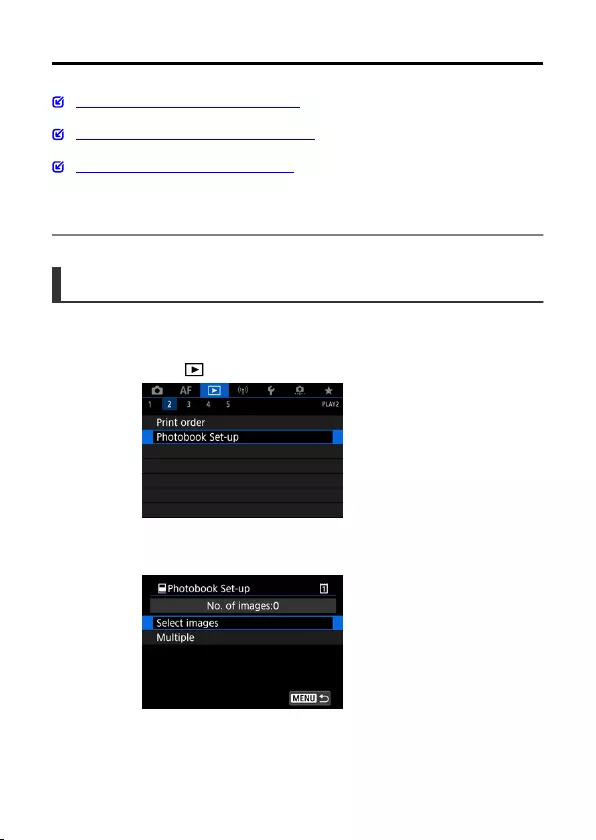
Photobook Set-up
Specifying Individual Images via the Menu
Specifying the Image Range for a Photobook
Specifying All Images in a Folder or Card
You can specify up to 998 images to be printed in a photobook. When you use EOS Utility
(EOS software) to import images to a computer, the specified images for a photobook will be
copied to a dedicated folder. This function is useful for ordering photobooks online.
Specifying Individual Images via the Menu
1. Select [ : Photobook Set-up].
2. Select [Select images].
529

3. Select the image to be specified.
Use the < > dial to select the image to be specified for a photobook,
then press < >.
To select other images to be specified for a photobook, repeat step 3.
530
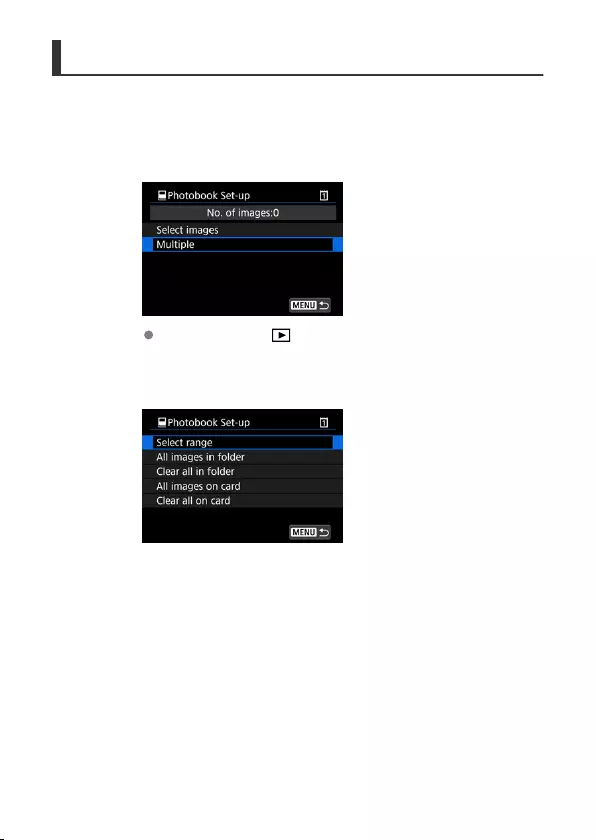
Specifying the Image Range for a Photobook
While looking at the images in the index display, you can specify the range (start point to
end point) of images to be specified for a photobook at once.
1. Select [Multiple].
Select [Multiple] in [ : Photobook Set-up].
2. Select [Select range].
531

3. Specify the range of images.
Select the first image (start point).
Next, select the last image (end point).
A checkmark [ ] will be appended to all the images within the range
between first and last images.
532
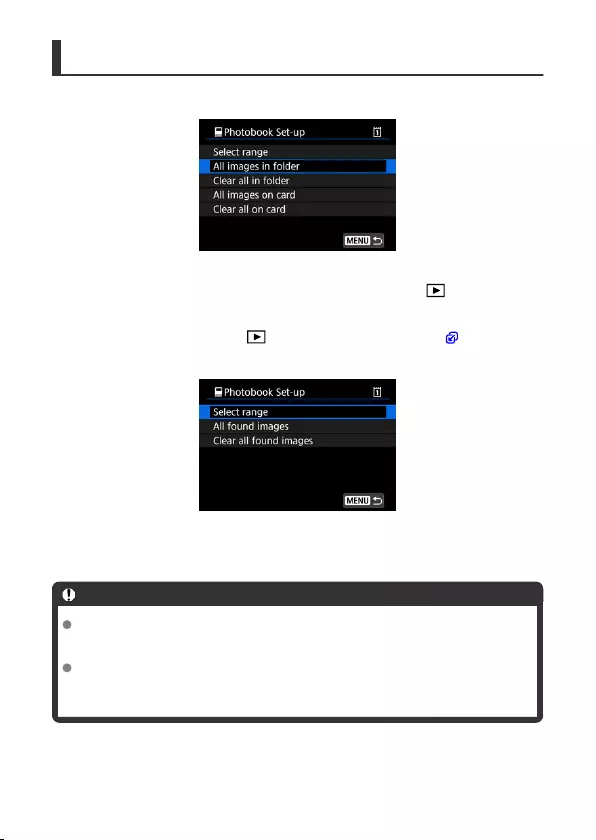
Specifying All Images in a Folder or Card
You can specify all the images in a folder or on a card at once for a photobook.
All images in the folder or on the card are specified for the photobook when you select [All
images in folder] or [All images on card] in the [Multiple] option for [ : Photobook Set-
up].
To clear selection, select [Clear all in folder] or [Clear all on card].
If the search conditions are set with [ : Set image search conditions] ( ) and you
select [Multiple], the display will change to [All found images] and [Clear all found
images].
[All found images]: All images filtered by the search conditions are specified for the
photobook.
[Clear all found images]: Clears photobook designation of all filtered images.
Caution
RAW images or movies cannot be specified for the photobook. Note that RAW
images or movies will not be specified for the photobook even if you specify all
images with [Multiple].
Do not use this camera to configure photobook settings for images with photobook
settings set up on another camera. All the photobook settings may be overwritten
inadvertently.
533

RAW Processing (RAW/DPRAW)
Magnified View
Processing Images with Specified Aspect Ratios
RAW Image Processing Options
You can process or images with the camera to create JPEG or HEIF images.
RAW images are not affected, so different conditions can be applied to create JPEG or HEIF
images.
You can also use Digital Photo Professional (EOS software) to process RAW images.
Caution
Processing into HEIF is not available for or images captured with
multiple exposure, expanded ISO speed (L or H), or electronic shutter selected.
1. Select [ : RAW processing (RAW/DPRAW)].
534
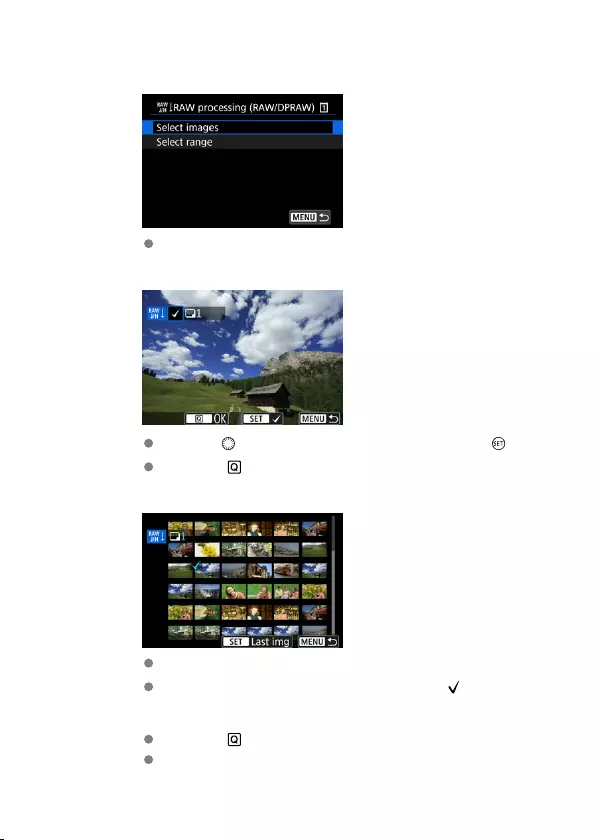
2. Select an option, then select images.
You can select multiple images to process at once.
Select images
Turn the < > dial to select images to process, then press < >.
Press the < > button.
Select range
Select the first image (start point).
Next, select the last image (end point). A checkmark [ ] will be
appended to all the images within the range between first and last
images.
Press the < > button.
To process other images, repeat this step.
535
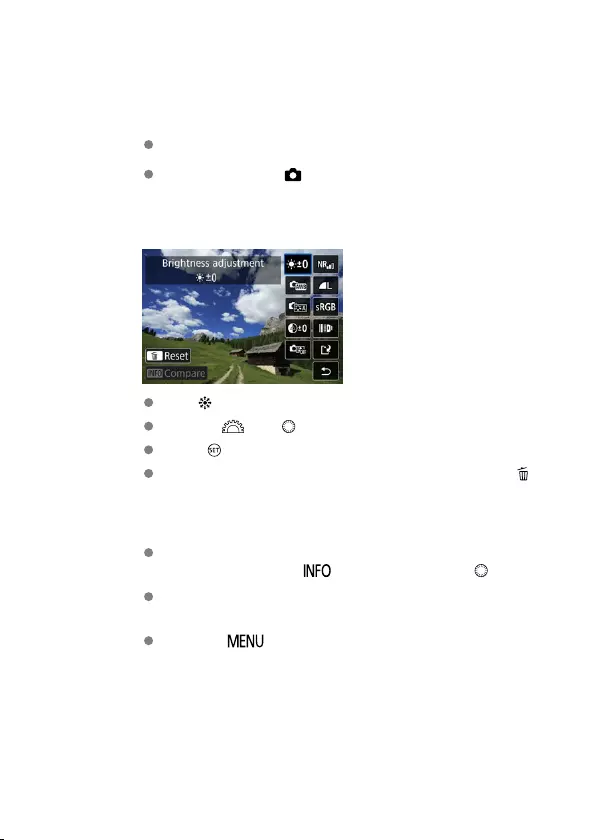
3. Set the desired processing conditions.
Use shot settings
Images are processed using image settings at the time of capture.
Images captured with [ : HDR PQ settings] set to [Enable] are
processed to create HEIFs, and images captured with this function set
to [Disable] are processed to create JPEGs.
Set up processing→JPEG/Set up processing→HEIF
Use < > to select an item.
Turn the < > or < > dial to switch the setting.
Press < > to access the function setting screen.
To return to the image settings at the time of shooting, press the < >
button.
Comparison screen
You can switch between the [After change] and [Shot settings]
screens by pressing the <> button and turning the < > dial.
Items in orange on the [After change] screen have been modified
since the time of capture.
Press the < > button to return to the processing conditions
screen.
536

4. Save.
When using [Set up processing→JPEG] or [Set up
processing→HEIF], select [ ] (Save).
Read the message and select [OK].
To process other images, select [Yes] and repeat steps 2–4.
5. Select the image to display.
Select [Original image] or [Processed img.].
Your selected image is displayed.
Magnified View
You can magnify images displayed for [Set up processing→JPEG] or [Set up
processing→HEIF] by pressing the < > button. The magnification ratio varies depending
on the [Image quality] setting. With <>, you can scroll around the magnified image.
To cancel the magnified view, press the <> button again.
537

Caution
Results of processing with [Digital Lens Optimizer] set to [High] are only applied
in magnified view. Results are not applied in normal display.
538
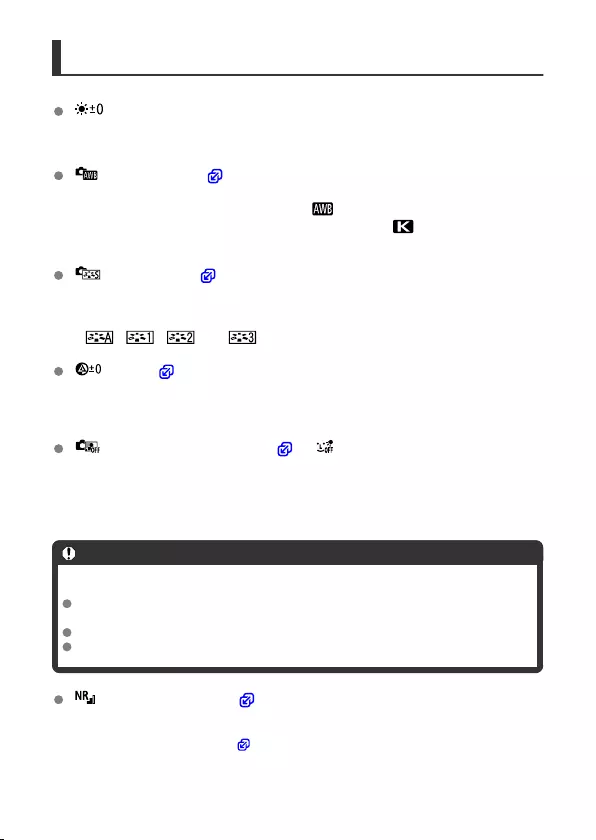
RAW Image Processing Options
Brightness adjustment
You can adjust the image brightness up to ±1 stop in 1/3-stop increments.
White balance ( )
You can select the white balance. Selecting [ ] enables you to select [Auto:
Ambience priority] or [Auto: White priority]. If you select [ ], you can set the color
temperature.
Picture Style ( )
You can select the Picture Style. You can adjust the sharpness, contrast, and other
parameters.
*[], [ ], [ ], and [ ] are not available when [Set up processing→HEIF] is set.
Clarity ( )
You can adjust clarity in a range of –4 to +4.
*Not available when [Set up processing→HEIF] is set.
Auto Lighting Optimizer ( ) + Adj face lighting
You can specify Auto Lighting Optimizer details. With automatic, optimal adjustment of
lighting on faces, you can effectively correct images captured with oblique lighting or
illuminated by flash.
*Not available when [Set up processing→HEIF] is set.
Caution
When adjustment of face lighting is set
Suitable adjustment may not be possible in some shooting situations unless faces
can be detected in detail and are not too dark.
Noise may increase.
Adjustment may be less effective at high ISO speeds.
High ISO speed NR ( )
You can set the noise reduction processing for high ISO speeds. If the effect is difficult
to discern, magnify the image ( ).
540

Image quality ( )
You can set the image quality when creating a JPEG or HEIF image.
Color space ( )
You can select either sRGB or Adobe RGB. Since the camera screen is not compatible
with Adobe RGB, the difference in the image will hardly be perceptible when either color
space is set.
*[] is displayed when [Set up processing→HEIF] is set but is not an option for
selection.
Lens aberr correction
• Peripheral illum corr ( )
A phenomenon that makes the image corners look darker due to the lens
characteristics can be corrected. If [Enable] is set, the corrected image will be
displayed. If the effect is difficult to discern, magnify the image ( ) and check the
four corners. Less correction is applied than for maximum correction with Digital
Photo Professional (EOS software, ). If the effects of correction are not apparent,
use Digital Photo Professional to apply the peripheral illumination correction.
• Distortion correction ( )
Image distortion due to lens characteristics can be corrected. If [Enable] is set, the
corrected image will be displayed. The image periphery will be trimmed in the
corrected image.
Since the image resolution may look slightly lower, adjust the sharpness with the
Picture Style’s sharpness parameter setting as necessary.
• Digital Lens Optimizer ( )
Correct lens aberration, diffraction, and low-pass filter-induced loss of resolution by
applying optical design values. To check the effect of setting this option to [High] or
[Standard], use magnified view ( ). Without magnification, the effect when Digital
Lens Optimizer is set to [High] is not applied. Selecting [High] or [Standard]
corrects both chromatic aberration and diffraction, although these options are not
displayed.
• Chromatic aberr corr ( )
Chromatic aberrations (color fringing along the subject’s outline) due to the lens
characteristics can be corrected. If [Enable] is set, the corrected image will be
displayed. If the effect is difficult to discern, magnify the image ( ).
541
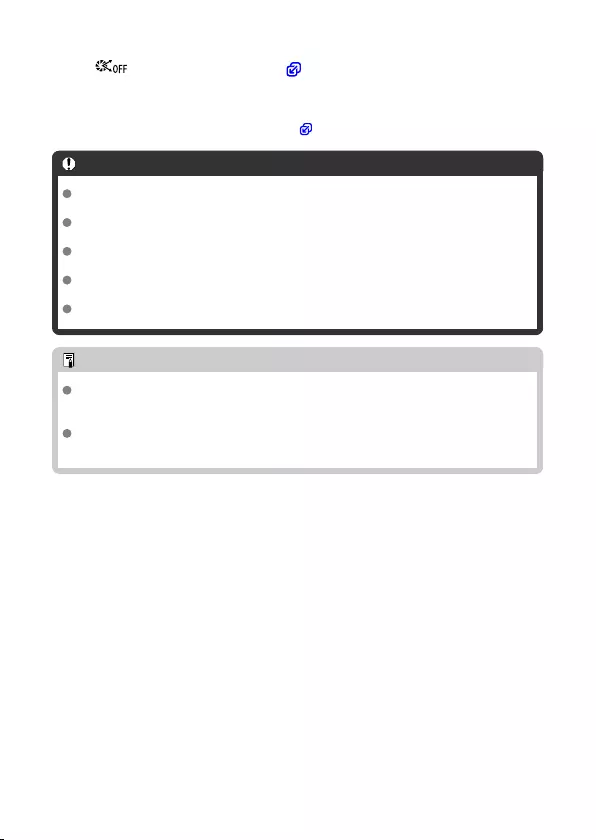
• Diffraction correction ( )
The diffraction by the lens aperture degrading the image sharpness can be
corrected. If [Enable] is set, the corrected image will be displayed. If the effect is
difficult to discern, magnify the image ( ).
Caution
Processing RAW images in the camera will not produce exactly the same results
as processing RAW images with Digital Photo Professional (EOS software).
If you perform [Brightness adjustment], noise, banding, etc. may be intensified
with the effects of adjustment.
When [Digital Lens Optimizer] is set, noise may be intensified together with the
effects of correction.
When [Digital Lens Optimizer] is set, image edges may be emphasized, under
some shooting conditions. Adjust sharpness of the Picture Style as needed.
Processing with [Digital Lens Optimizer] set to [High] may take some time.
Note
Effects of lens aberration correction vary by lens and by shooting conditions. Also,
the effect may be difficult to discern depending on the lens used, shooting
conditions, etc.
RAW movies cannot be processed. Process them with Digital Photo Professional
(EOS software).
542
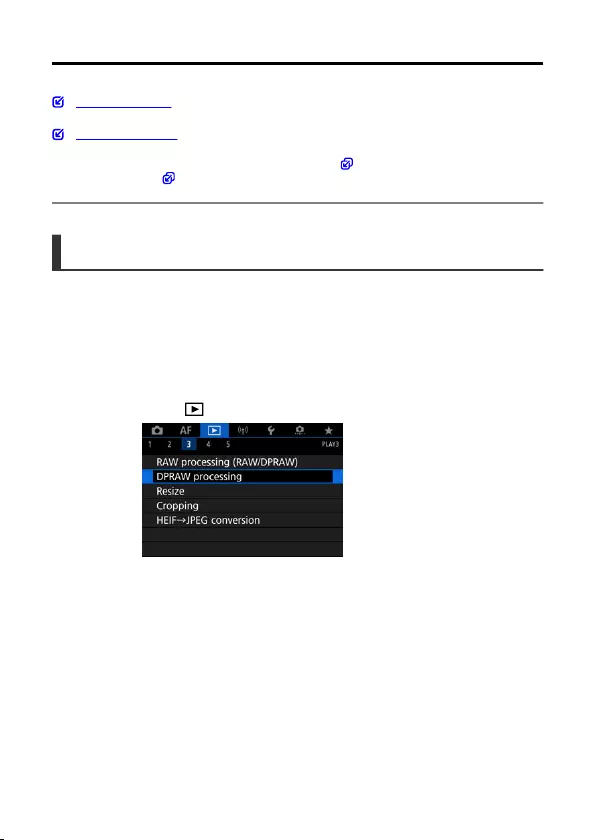
DPRAW Processing
Portrait Relighting
Background Clarity
When you use the camera in RAW image processing ( ) for images captured with Dual
Pixel RAW enabled ( ), dual pixel data and detailed face information can be used in image
correction.
Portrait Relighting
Oblique or insufficient lighting on human subjects can be corrected by applying a virtual light
source.
Unlike the Auto Lighting Optimizer feature that adjusts lighting in the face area automatically,
portrait relighting is for manual adjustment of lighting. You can apply correction to the face
as well as the body and other areas.
1. Select [ : DPRAW processing].
543

2. Select [Portrait relighting].
Turn the < > dial to select an image to adjust, then press < >.
544
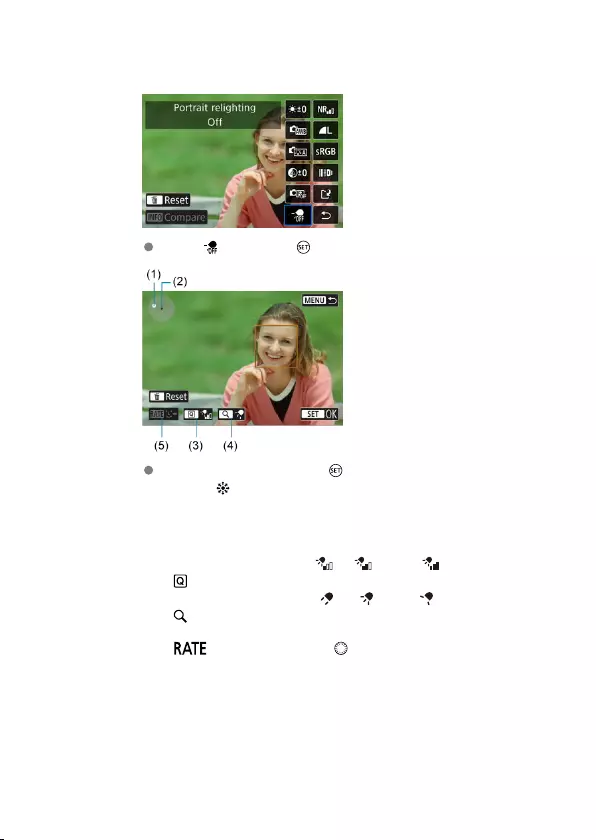
3. Adjust the image.
Select [ ], then press < >.
Adjust the image, then press < >.
(1) Use < > to position the light source.
(2) represents the position of the selected face. By adjusting (1) relative
to (2), you can adjust the direction of lighting. Overlapping positions of
(1) and (2) place the light source directly in front of the face.
You can also drag to adjust the direction of lighting.
(3) To set the light intensity ( low/ standard/ high), press the
< > button.
(4) To set the light coverage ( spot/ medium/ wide), press the
< > button.
(5) For images with multiple human subjects, you can press the
< > button and turn the < > dial to select a face for adjustment
before you specify processing conditions. You can also tap the screen
to select a face.
545

Comparison screen
You can switch between the [After change] and [Shot settings]
screens by pressing the [ ] button, then turning the < > dial.
Items in orange on the [After change] screen have been modified
since the time of capture.
Caution
Selection is possible from up to 10 people.
Faces cannot be selected unless they are large enough and away
from the edge of the screen, and the camera must be able to
acquire detailed face information.
4. Save.
Select [ ] (Save), read the message, and select [OK].
546
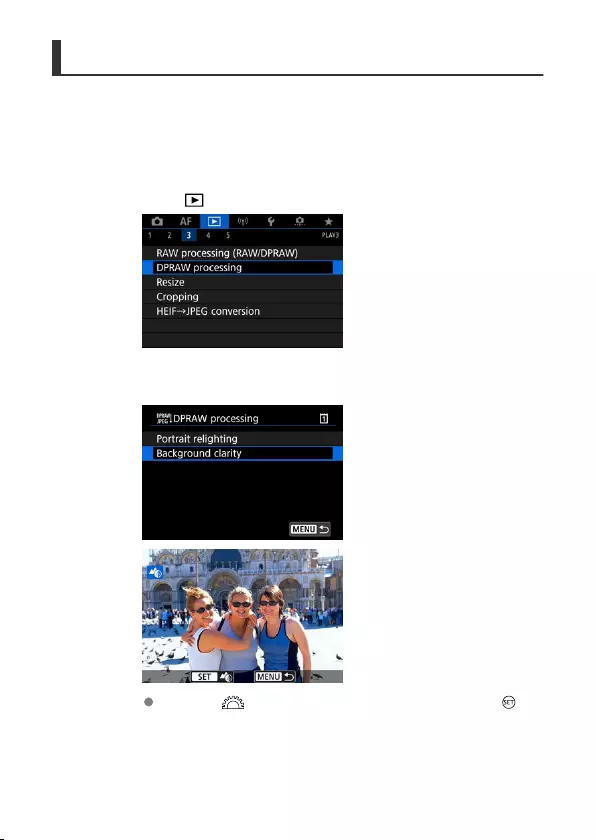
Background Clarity
To adjust hazy backgrounds in images of people and landscapes, you can set the level of
clarity in a range of 0–4.
For clarity adjustment in RAW image processing, you can set the level of image edge
contrast in a range of -4 to +4.
1. Select [ : DPRAW processing].
2. Select [Background clarity].
Turn the < > dial to select an image to adjust, then press < >.
547
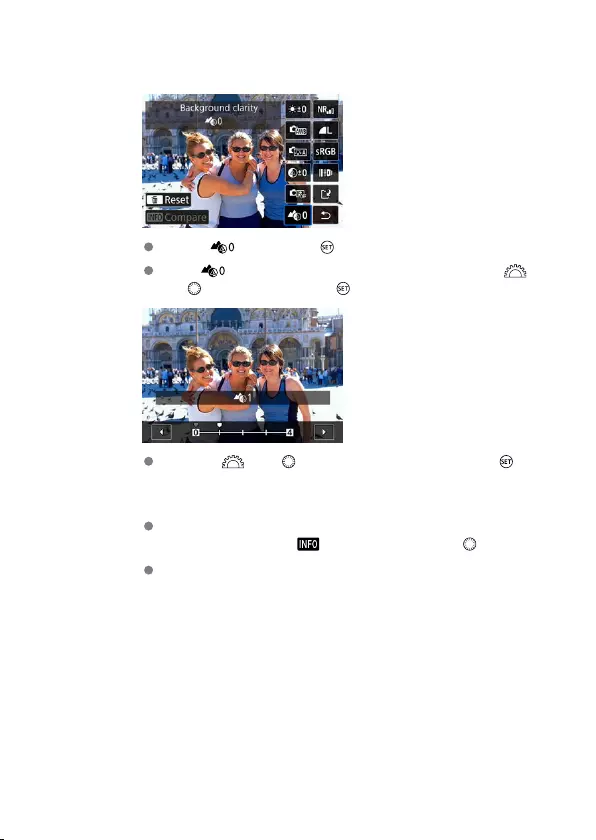
3. Adjust the image.
Select < >, then press < >.
With < > selected, you can select the level by turning the < >
or < > dial without pressing < >.
Turn the < > or < > dial to select the level, then press < >.
Comparison screen
You can switch between the [After change] and [Shot settings]
screens by pressing the [ ] button, then turning the < > dial.
Items in orange on the [After change] screen have been modified
since the time of capture.
548
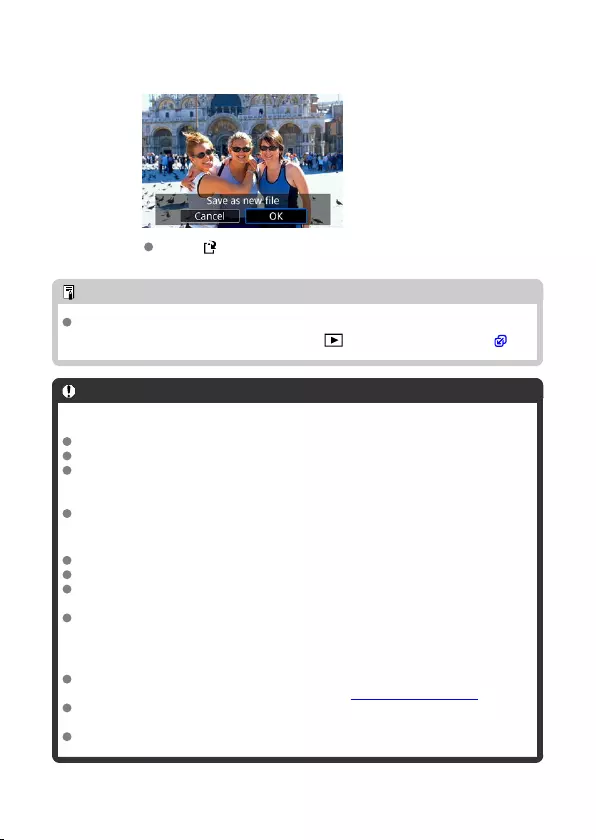
4. Save.
Select [ ] (Save), read the message, and select [OK].
Note
For settings other than [Portrait relighting] and [Background clarity], you can
specify processing based on setting items of [ : RAW image processing] ( ).
Caution
Portrait relighting and background clarity
HEIF images cannot be processed this way.
Magnified view is not available during adjustment.
Images for which the camera could not acquire detailed face information cannot be
selected. When shooting, try to ensure that faces are large enough and near the
center of the screen.
Portrait relighting and background clarity cannot be used together.
Portrait Relighting
Images are displayed horizontally even if shot in vertical orientation.
Results of processing may differ from the preview. Check images after processing.
If areas other than the selected subject are adjusted, this can be reduced by
narrowing the adjustment area.
Adjustment may be applied to other subjects near the selected subject. This can be
reduced by narrowing light source coverage.
Background Clarity
Background clarity is less effective for images with significant background blurring.
To control the amount of background blurring, see Av: Aperture-Priority AE.
Fringing may appear on subjects that include adjacent bright and dark areas. This
can be avoided by reducing the level of adjustment.
Areas other than the background may also be adjusted.
549
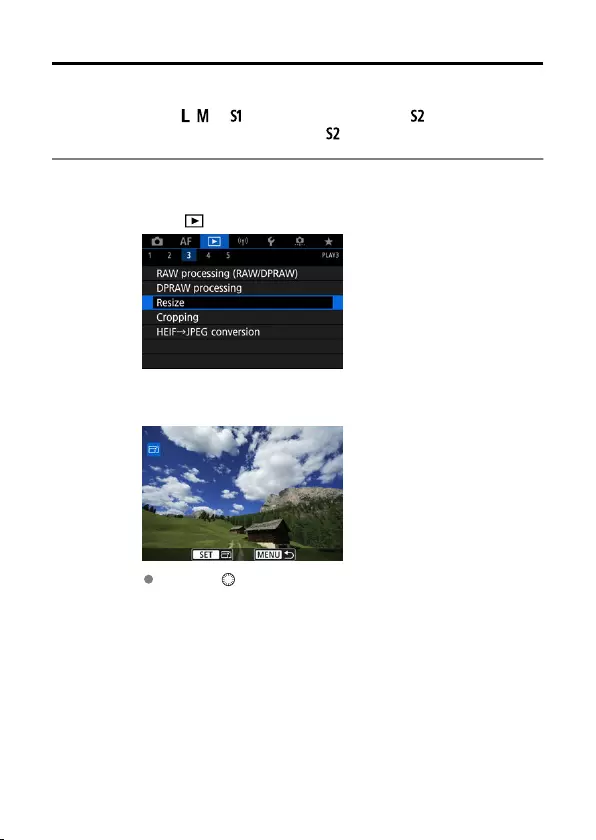
Resizing JPEG/HEIF Images
You can resize a JPEG or HEIF image to reduce the pixel count and save it as a new image.
Resizing is available for , , or JPEGs or HEIFs (sizes except ), including those
captured in RAW+JPEG and RAW+HEIF shooting. images and RAW images or movies
cannot be resized.
1. Select [ : Resize].
2. Select an image.
Turn the < > dial to select the image to resize.
550
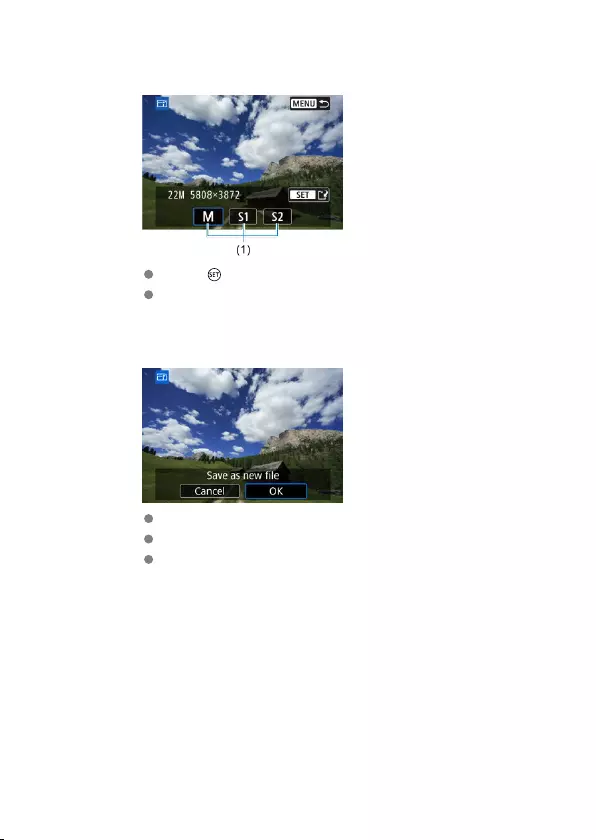
3. Select the desired image size.
Press < > to display the image sizes.
Select the desired image size (1).
4. Save.
Select [OK] to save the resized image.
Check the destination folder and image file number, then select [OK].
To resize another image, repeat steps 2 to 4.
551
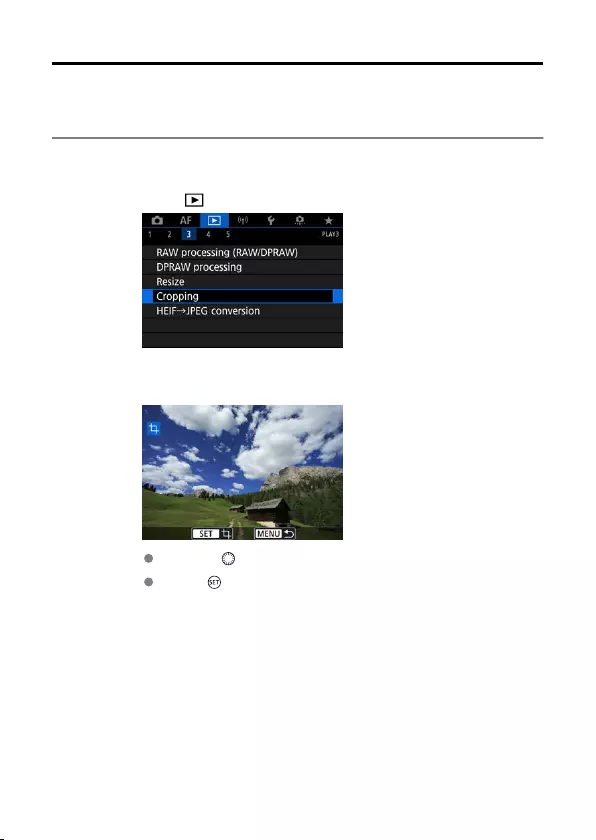
Cropping JPEG/HEIF Images
You can crop a captured JPEG image and save it as another image. Cropping is available
for JPEG or HEIF images. RAW images and frame-grab images from 4K or 8K movies
cannot be cropped.
1. Select [ : Cropping].
2. Select an image.
Turn the < > dial to select the image to crop.
Press < > to display the cropping frame.
552
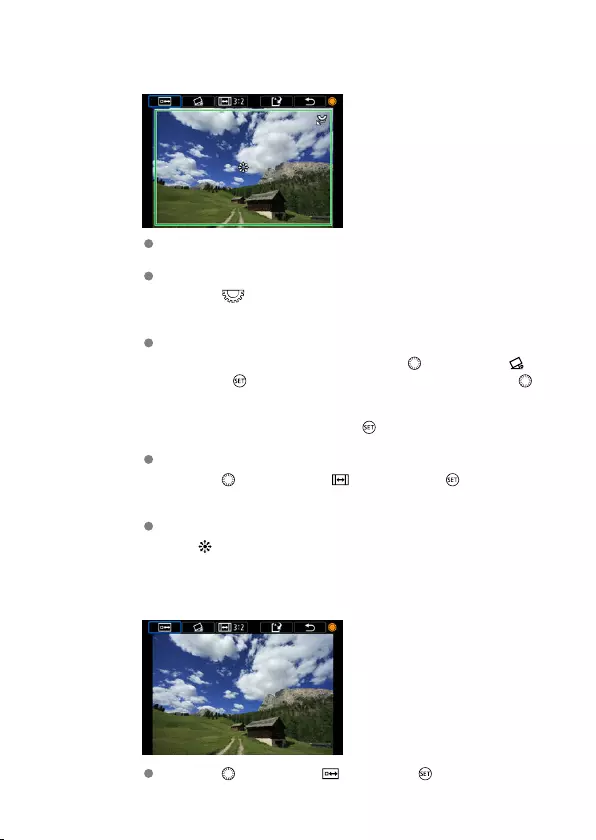
3. Set the cropping frame.
The image area within the cropping frame will be cropped.
Resizing the cropping frame size
Turn the < > dial to resize the cropping frame size. The smaller the
cropping frame, the more magnified the cropped image will look.
Correcting tilt
You can correct image tilt by ±10°. Turn the < > dial to select [ ],
then press < >. While checking tilt relative to the grid, turn the < >
dial (in 0.1° increments) or tap the left or right arrow (in 0.5°
increments) in the upper left of the screen to correct tilt. After
completing the tilt correction, press <>.
Changing the cropping frame aspect ratio and orientation
Turn the < > dial and select [ ]. Each press of < > changes the
cropping frame aspect ratio.
Moving the cropping frame
Use < > to move the cropping frame vertically or horizontally.
4. Check the image area to be cropped.
Turn the < > dial to select [ ], then press < >. The image area
to crop is displayed.
553
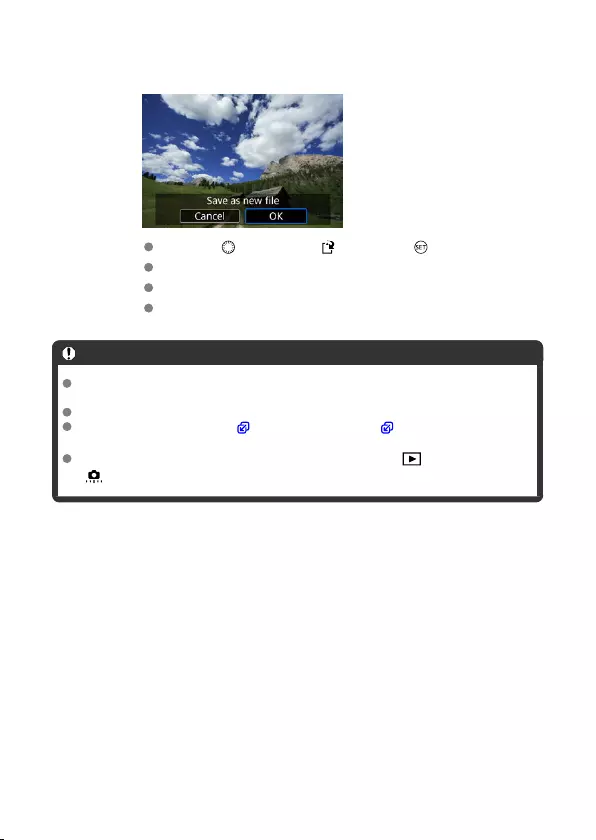
5. Save.
Turn the < > dial to select [ ], then press < >.
Select [OK] to save the cropped image.
Check the destination folder and image file number, then select [OK].
To crop another image, repeat steps 2 to 5.
Caution
The position and size of the cropping frame may change depending on the angle
set for tilt correction.
Once a cropped image is saved, it cannot be cropped again or resized.
AF point display information ( ) and Dust Delete Data ( ) will not be appended
to the cropped images.
Available aspect ratios vary depending on whether you use [ : Cropping] or
[: Add cropping information].
554

Converting HEIF to JPEG
You can convert HEIF images captured in HDR shooting and save them as JPEG images.
1. Select [ : HEIF→JPEG conversion].
2. Select an image.
Turn the < > dial to select an HEIF image to convert to JPEG.
Press < > to convert to JPEG.
555
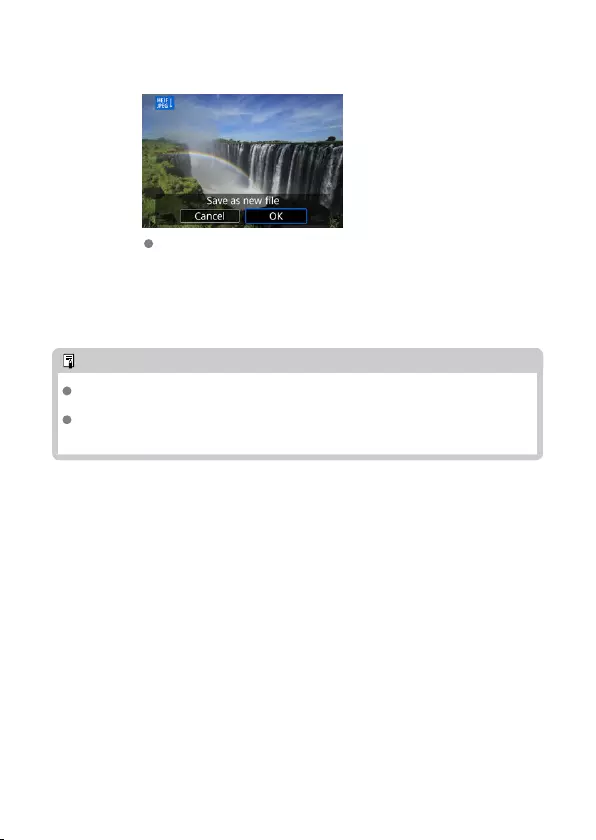
3. Save.
Select [OK] to save the JPEG image.
• Check the destination folder and image file number, then select
[OK].
• To convert another image, repeat steps 2 and 3.
Note
Some scenes may look different after conversion (if original and converted images
are compared).
Conversion is not available for cropped images, or for frame-grab images from 4K
or 8K movies.
556
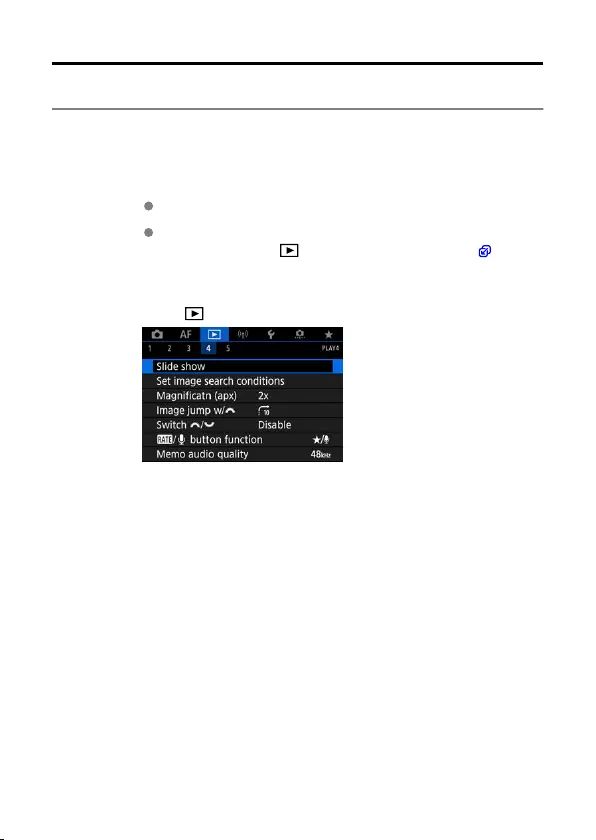
Slide Show
You can play back the images on the card as an automatic slide show.
1. Specify the images to be played back.
To play back all the images on the card, go to step 2.
If you want to specify the images to be played back in the slide show,
filter the images with [ : Set image search conditions] ( ).
2. Select [ : Slide show].
557
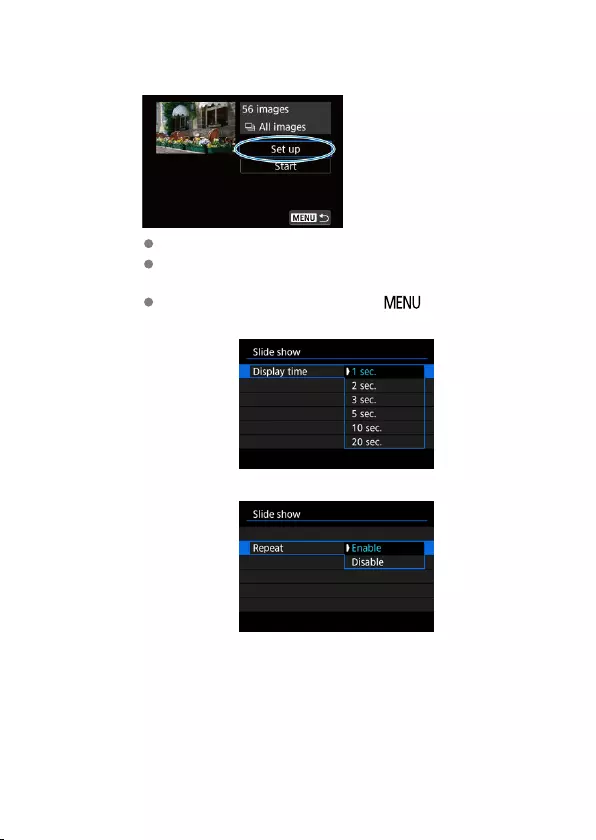
3. Set the playback as desired.
Select [Set up].
Set the [Display time] and [Repeat] (repeated playback) settings for
the still photos.
After completing the settings, press the < > button.
Display time
Repeat
558

4. Start the slide show.
Select [Start].
After [Loading image...] is displayed, the slide show will start.
5. Exit the slide show.
To exit the slide show and return to the setting screen, press the
< > button.
Note
To pause the slide show, press < >. During pause, [ ] will be displayed in the
upper left of the screen. Press < > again to resume the slide show.
During the automatic playback of still photos, you can press the < > button to
switch the display format ( ).
During movie playback, you can adjust the sound volume by turning the < >
dial.
During auto playback or when playback is paused, you can turn the < > dial to
view another image.
During auto playback, auto power off will not take effect.
The display time may differ depending on the image.
559
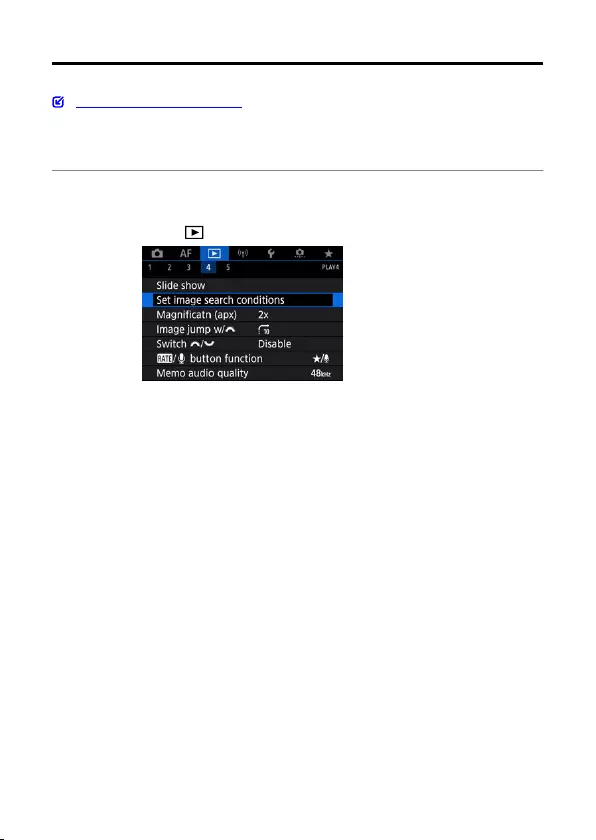
Setting Image Search Conditions
Clearing the Search Conditions
You can filter image display according to your search conditions. After setting the image
search conditions, you can play back and display only the found images. You can also
protect, rate, play a slide show, erase, and apply other operations to filtered images.
1. Select [ : Set image search conditions].
560
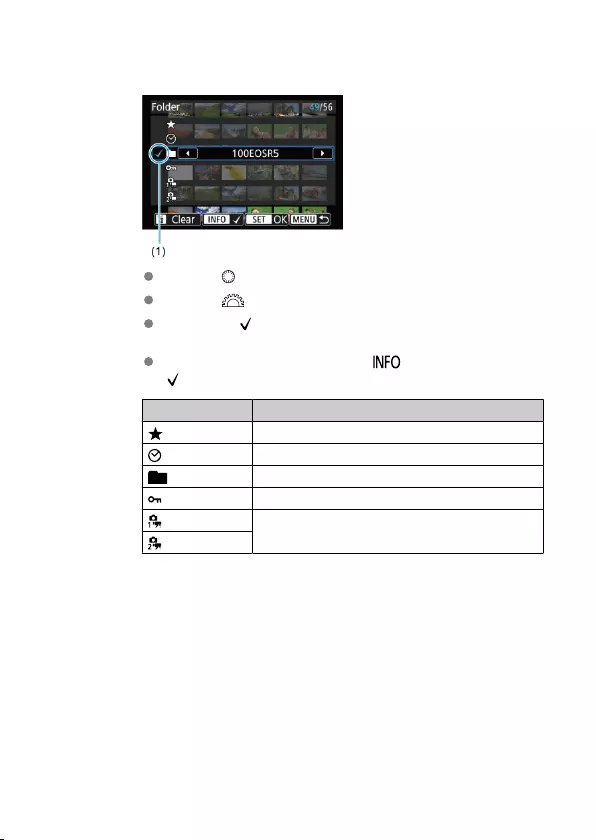
2. Set the search conditions.
Turn the < > dial to select an option.
Turn the < > dial to set the option.
A checkmark [ ] (1) is appended to the left of the option. (Specified as
the search condition.)
If you select the option and press the < > button, the checkmark
[ ] will be removed (which cancels the search condition).
Option Description
Rating Displays images with the selected (rating) condition.
Date Displays images taken on the selected shooting date.
Folder Displays images in the selected folder.
Protect Displays images with the selected (protect) condition.
Type of file (1) Displays images of the selected file type.
Type of file (2)
561
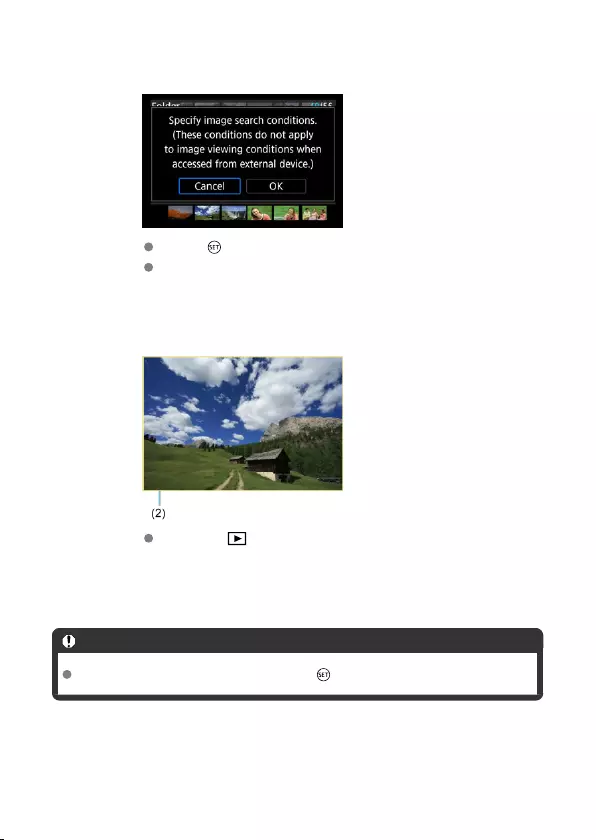
3. Apply the search conditions.
Press < > and read the message displayed.
Select [OK].
The search condition is applied.
4. Display the found images.
Press the < > button.
Only the images that match the set conditions (filtered) will be played
back.
When the images are filtered for display, the screen will have an outer
yellow frame (2).
Caution
If no images match the search conditions, < > cannot be pressed in step 3.
562

Note
Search conditions may be cleared after operations involving camera power or card
changes and editing, adding, or erasing images.
Auto power off time may be extended while the [ : Set image search
conditions] screen is displayed.
Clearing the Search Conditions
Access the screen in step 2, then press the <> button to clear all the search conditions.
563

Browsing Images with the Main Dial
In single-image display, you can turn the <> dial to jump through the images forward or
backward according to the jump method set.
1. Select [ : Image jump w/ ].
2. Select the jump method.
Note
With [Jump images by the specified number], you can turn the
< > dial to select the number of images to jump by.
With [Display by image rating], turn the <> dial to select the
rating ( ). Selecting will show all rated images as you
browse.
564

3. Browse by jumping.
(1) Jump method
(2) Playback position
Press the < > button.
In single-image display, turn the < > dial.
You can browse by the jump method set.
565
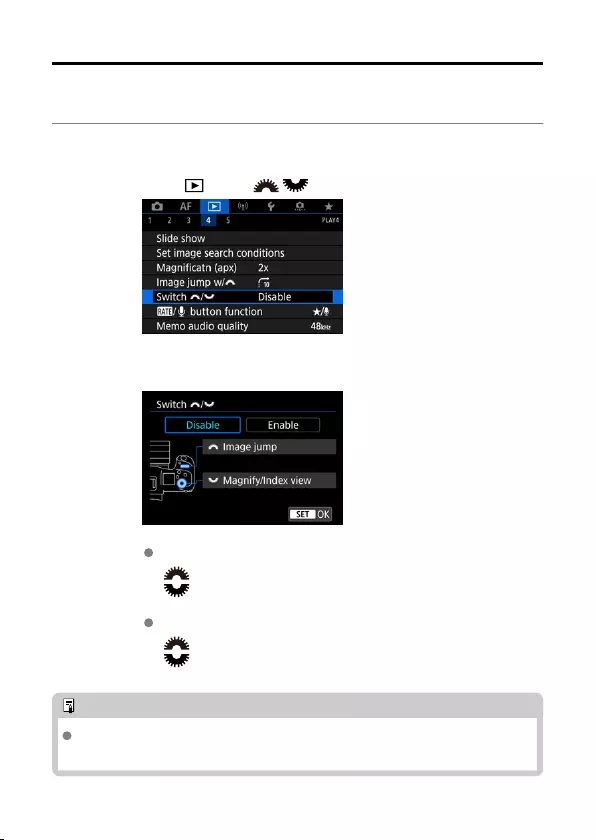
Switching the Main Dial and Quick Control Dial 2
You can switch the functions assigned to these dials, as used on the image playback
screen.
1. Select [ : Switch / ].
2. Select an option.
[Disable]
Image jump
Magnify/Index view
[Enable]
Magnify/Index view
Image jump
Note
Corresponding icons in menus and on screens such as the Quick Control and
Magnify/Reduce screen are changed accordingly.
566

Rate/Voice Memo Button Function
You can assign image rating/protection/erasure or voice memo recording/playback to the
< > button.
1. Select [ : / button function].
567
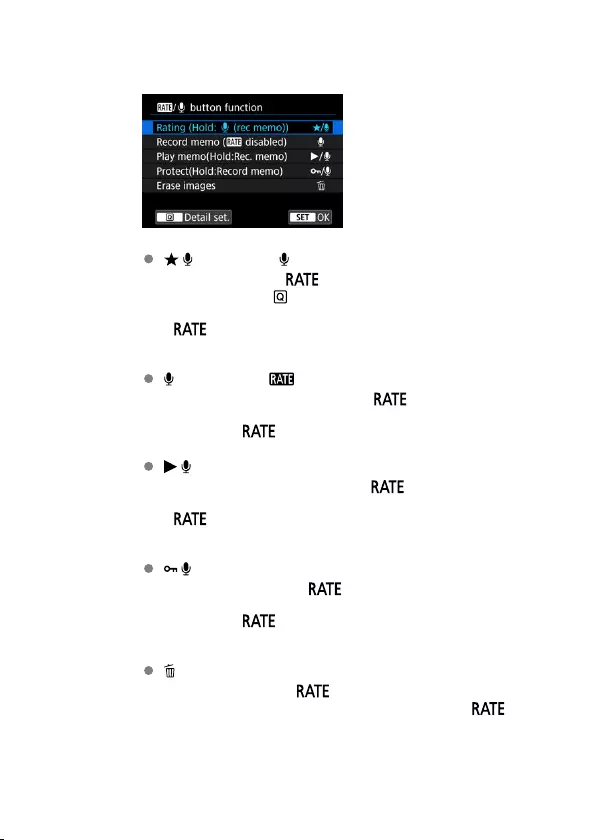
2. Select an option.
/ : Rating (Hold: (rec memo))
Assigns rating to the < > button. (Default setting.)
You can press the < > button to select the rating to use.
During playback, you can rate images or clear ratings by pressing the
< > button. You can also hold it down for 2 sec. to start recording
a voice memo.
: Record memo ( disabled)
Assigns voice memo recording to the <> button.
During image playback, you can start recording a voice memo by
pressing the <> button.
/ : Play memo(Hold:Rec. memo)
Assigns voice memo playback to the <> button.
During image playback, you can play a voice memo by pressing the
< > button. You can also hold it down for 2 sec. to start recording
a voice memo.
/ : Protect(Hold:Record memo)
Assigns protection to the < > button.
During playback, you can protect images or clear protection by
pressing the <> button. You can also hold it down for 2 sec. to
start recording a voice memo.
: Erase images
Assigns erasure to the <> button.
During playback, you can erase images by pressing the <>
button.
568
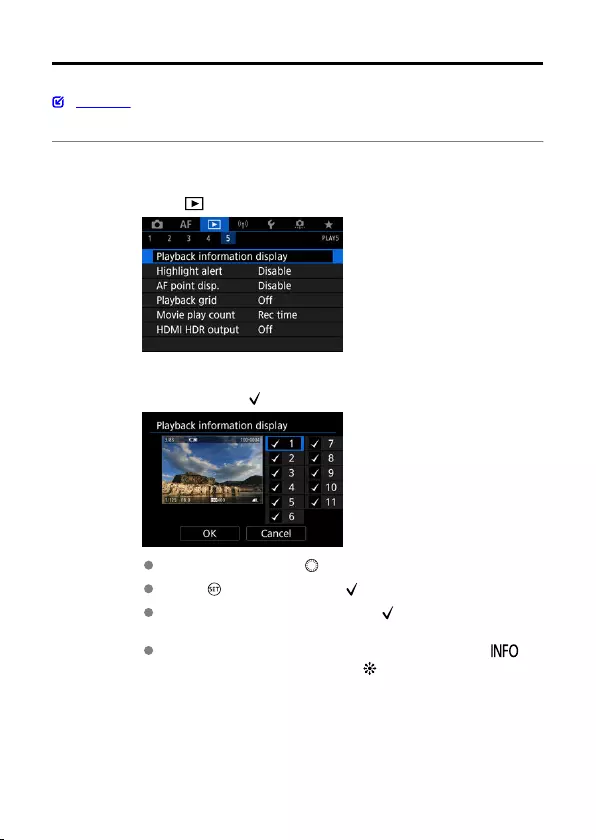
Customizing Playback Information Display
Histogram
You can specify screens and accompanying information displayed during image playback.
1. Select [ : Playback information display].
2. Add a checkmark [ ] next to the number of screens to display.
Select numbers with the < > dial.
Press < > to add a checkmark [ ].
Repeat these steps to add a checkmark [ ] to the number of each
screen to display, then select [OK].
Your selected information can be accessed by pressing the < >
button during playback, or by using < > when shooting information is
displayed.
569

Histogram
The histograms show signal levels across the tonal range. Brightness display (for checking
the general exposure level and overall gradation) and RGB display (for checking saturation
and gradation of red, green, and blue) are available. You can switch the histogram displayed
by pressing the < > button when [ ] is displayed in the lower left of the [ :
Playback information display] screen.
570
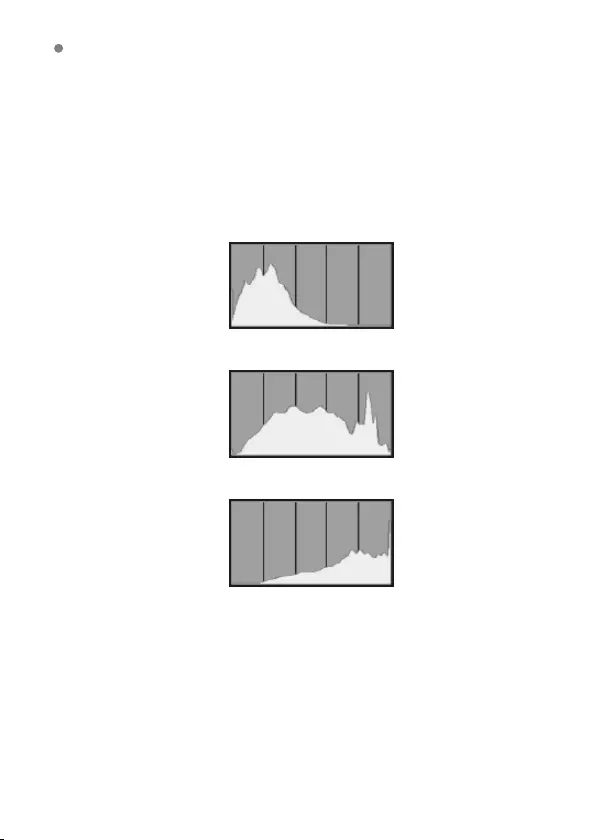
[Brightness] display
This histogram is a graph showing the distribution of the image’s brightness level, with
the horizontal axis indicating the brightness level (darker on the left and brighter on the
right) and the vertical axis indicating the pixel count at each brightness level. The more
pixels there are toward the left, the darker the image, and the more pixels there are
toward the right, the brighter the image. If there are too many pixels on the left, detail in
shadows will be lost, and if there are too many pixels on the right, detail in highlights will
be lost. The gradation in-between will be reproduced. By checking the image and its
brightness histogram, you can see the exposure level inclination and the overall
gradation.
Sample histograms
Dark image
Normal brightness
Bright image
571

[RGB] display
This histogram is a graph showing the distribution of each primary color’s brightness
level in the image (RGB or red, green, and blue), with the horizontal axis indicating the
color’s brightness level (darker on the left and brighter on the right) and the vertical axis
indicating the pixel count at each color brightness level. The more pixels there are
toward the left, the darker and less prominent the color, and the more pixels there are
toward the right, the brighter and denser the color. If there are too many pixels on the
left, the corresponding color information will be lacking, and if there are too many pixels
on the right, the color will be too saturated, without gradation. By checking the image’s
RGB histogram, you can see the color’s saturation and gradation conditions, as well as
the white balance bias.
572
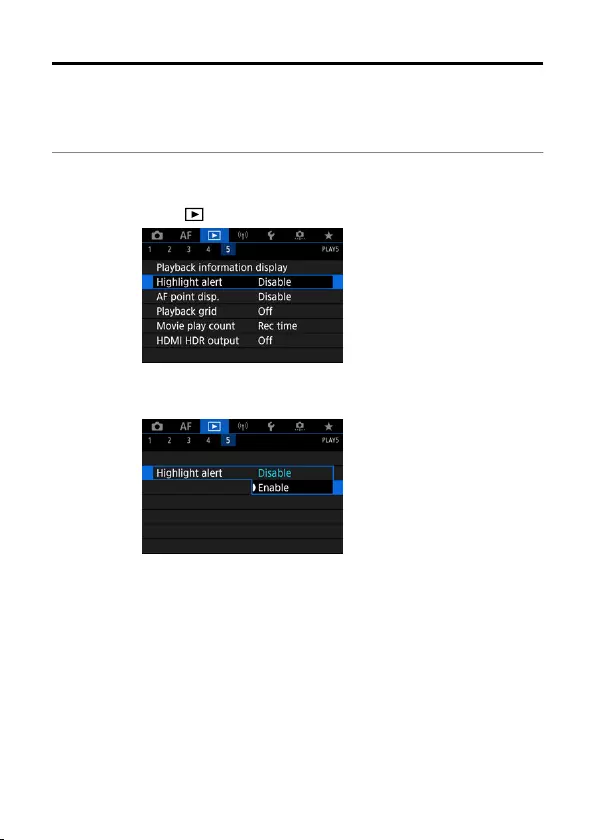
Displaying the Highlight Alert
You can specify blinking display of overexposed highlights on the playback screen. To
obtain more detailed gradation in the blinking areas where you want the gradation to be
faithfully reproduced, set the exposure compensation to a negative amount and shoot again
for a better result.
1. Select [ : Highlight alert].
2. Select [Enable].
573

AF Point Display
You can display the AF points that were used to focus, which will be outlined in red on the
playback screen. If automatic AF point selection is set, multiple AF points may be displayed.
1. Select [ : AF point disp.].
2. Select [Enable].
574
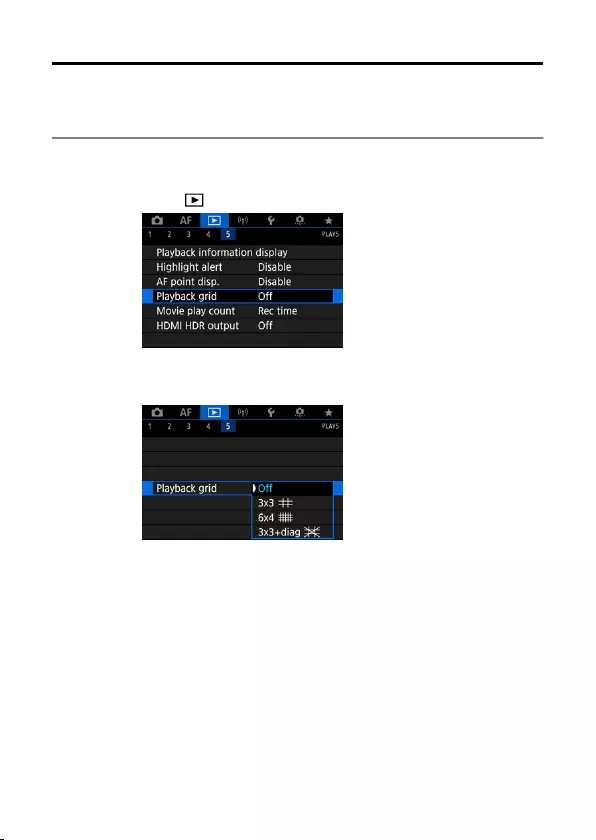
Playback Grid
You can display a grid over still photos shown in single-image display on the playback
screen. This function is convenient for checking the image’s vertical or horizontal tilt as well
as composition.
1. Select [ : Playback grid].
2. Select an option.
575
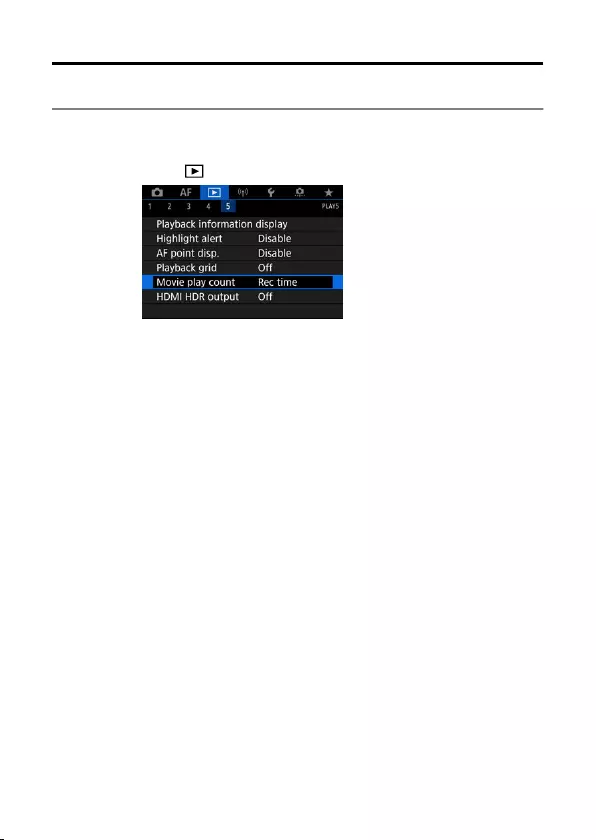
Movie Play Count
You can select how time is displayed on the movie playback screen.
1. Select [ : Movie play count].
576
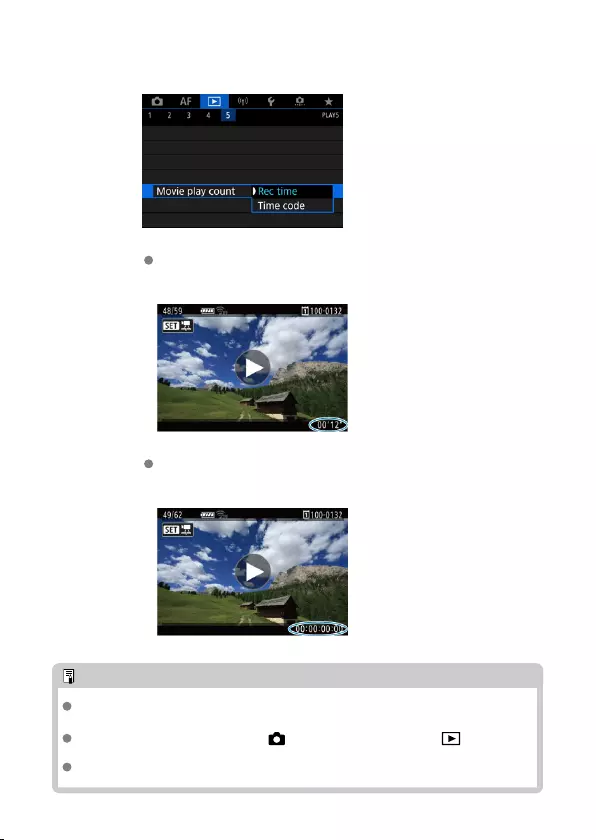
2. Select an option.
Rec time
Displays the recording or playback time during movie playback.
Time code
Displays the time code during movie playback.
Note
Time codes are always recorded to movie files (except for High Frame Rate movies
set to [Free run]), regardless of the [Movie rec count] setting.
The [Movie play count] setting in [ : Time code] is linked to the [ : Movie
play count], so that these settings always match.
The “frame” count is not displayed during movie recording or playback.
577

HDMI HDR Output
You can view RAW or HEIF images in HDR by connecting the camera to an HDR TV.
1. Select [ : HDMI HDR output].
2. Select [On].
Note
Make sure the HDR TV is set up for HDR input. For details on how to switch inputs
on the TV, refer to the TV manual.
Depending on the TV used, images may not look as expected.
On HDR TVs, some information may not be displayed.
Quick Control RAW processing of displayed images is recommended if you will
process RAW images while viewing HDMI HDR output.
578

Wireless Features
This chapter describes how to connect the camera to a smartphone, computer, FTP server,
or Web service wirelessly via Bluetooth or Wi-Fi and send images, as well as how to use a
wireless remote control or GPS device.
Caution
Important
Note that Canon cannot be held liable for any loss or damage caused by erroneous
wireless communication settings when using the camera. In addition, Canon cannot
be held liable for any other loss or damage caused by use of the camera.
When using wireless communication functions, establish appropriate security at
your own risk and discretion. Canon cannot be held liable for any loss or damage
caused by unauthorized access or other security breaches.
•Tab Menus: Wireless Features
•Wi-Fi/Bluetooth Connection
•Connecting to a Smartphone
•Connecting to a Computer via Wi-Fi
•Sending Images to a Web Service
•Image Transfer to FTP Servers
•Wi-Fi Connection via Access Points
•Connecting to a Wireless Remote Control
•Reconnecting via Wi-Fi
•Registering Multiple Connection Settings
•Airplane Mode
•Wi-Fi Settings
•Bluetooth Settings
•Nickname
•GPS Device Settings
•Changing or Deleting Connection Settings
•Resetting Communication Settings
•View Info Screen
•Virtual Keyboard Operations
•Responding to Error Messages
•Wireless Communication Function Precautions
•Security
•Checking Network Settings
•Wireless Communication Status
579

Caution
Wireless communication is not available while the camera is connected via an
interface cable to a computer or other device.
Other devices, such as computers, cannot be used with the camera by connecting
them with an interface cable while the camera is connected to devices via Wi-Fi.
The camera cannot be connected via Wi-Fi if there is no card in it (except for [ ],
[ ], or [ ]).
The Wi-Fi connection will be terminated if you set the camera’s power to < >,
or open the card slot cover or battery compartment cover (but FTP transfer
connections will continue even with the power set to <>).
With a Wi-Fi connection established, the camera’s auto power off does not
function.
581

Wi-Fi/Bluetooth Connection
1. Select [ : Wi-Fi/Bluetooth connection].
2. Select an option for the camera to connect to.
Connect to smartphone ( )
Control the camera remotely and browse images on the camera over a Wi-Fi connection by
using the dedicated Camera Connect app on smartphones or tablets (collectively referred to
as “smartphones” in this manual). After pairing the camera with a smartphone supporting
Bluetooth low energy technology (hereafter, “Bluetooth”), you only need to use the
smartphone to connect via Wi-Fi.
Remote control (EOS Utility) ( )
Connect the camera to a computer via Wi-Fi and operate the camera remotely using EOS
Utility (EOS software). Images on the camera can also be sent to the computer.
Transfer images to FTP server ( )
Your images can be transferred to an FTP server on the network the camera is connected
to.
582

Upload to Web service ( )
Images can be sent automatically to the image.canon cloud service for Canon customers
after you complete member registration (free of charge). Original files of images sent to
image.canon are retained for 30 days, without storage limitations, and can be downloaded to
computers or transferred to other Web services.
Connect to Wireless Remote ( )
This camera can also be connected to Wireless Remote Control BR-E1 (sold separately) via
Bluetooth for remote control shooting.
583
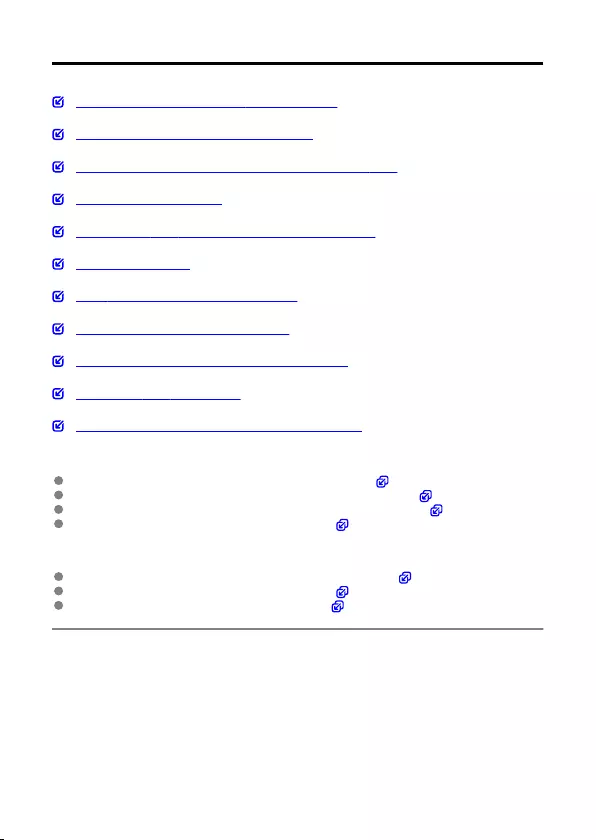
Connecting to a Smartphone
Turning on Bluetooth and Wi-Fi on a Smartphone
Installing Camera Connect on a Smartphone
Connecting to a Bluetooth-Compatible Smartphone via Wi-Fi
Camera Connect Functions
Maintaining a Wi-Fi Connection When the Camera Is Off
Canceling the Pairing
Wi-Fi Connection without Using Bluetooth
Automatic Image Transfer as You Shoot
Sending Images to a Smartphone from the Camera
Terminating Wi-Fi Connections
Settings to Make Images Viewable from Smartphones
You can do the following after pairing the camera with a Bluetooth-compatible smartphone.
Establish a Wi-Fi connection using only the smartphone ( ).
Establish a Wi-Fi connection with the camera even when it is off ( ).
Geotag images with GPS information acquired by the smartphone ( ).
Control the camera remotely from a smartphone ( ).
You can also do the following after connecting the camera to a smartphone via Wi-Fi.
Browse and save images on the camera from a smartphone ( ).
Control the camera remotely from a smartphone ( ).
Send images to a smartphone from the camera ( ).
584

Turning on Bluetooth and Wi-Fi on a Smartphone
Turn on Bluetooth and Wi-Fi from the smartphone settings screen. Note that pairing with the
camera is not possible from the smartphone’s Bluetooth settings screen.
Note
To establish a Wi-Fi connection via an access point, see Wi-Fi Connection via
Access Points.
585

Installing Camera Connect on a Smartphone
The dedicated app Camera Connect (free of charge) must be installed on the smartphone
on which Android or iOS is installed.
Use the latest version of the smartphone OS.
Camera Connect can be installed from Google Play or App Store. Google Play or App
Store can also be accessed using the QR codes that appear when the camera is paired
or connected via Wi-Fi to a smartphone.
Note
For the operating system versions supported by Camera Connect, refer to the
download site of Camera Connect.
Sample screens and other details in this guide may not match the actual user
interface elements after camera firmware updates or updates to Camera Connect,
Android, or iOS.
586
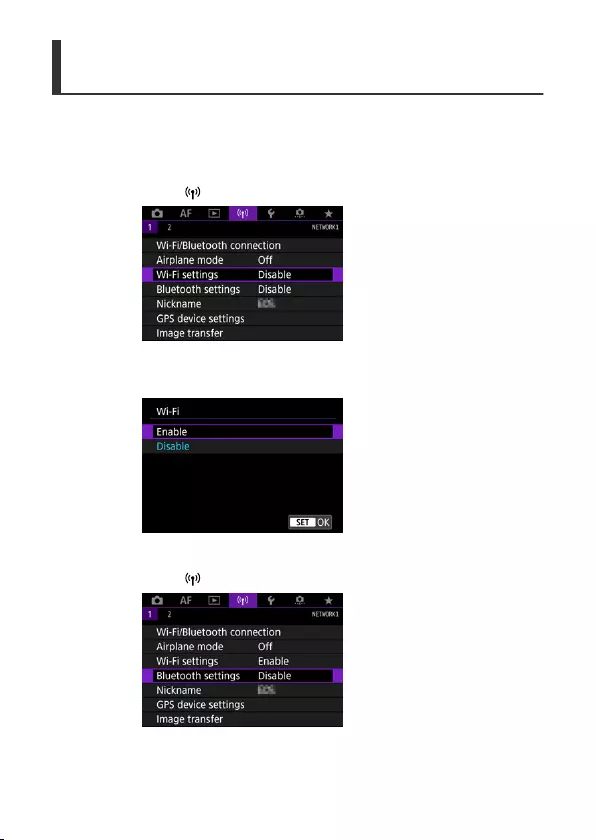
Connecting to a Bluetooth-Compatible Smartphone via
Wi-Fi
Steps on the camera (1)
1. Select [ : Wi-Fi settings].
2. Select [Enable].
3. Select [ : Bluetooth settings].
587
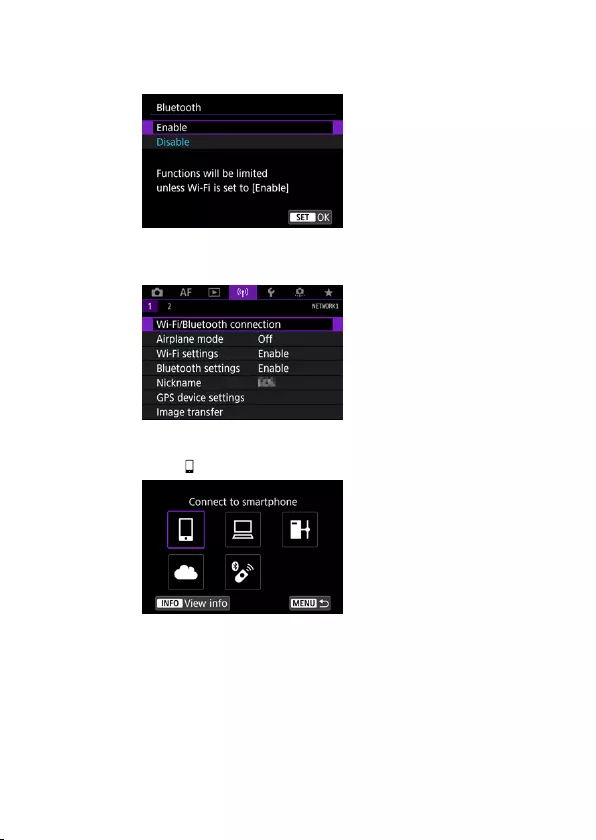
4. Select [Enable].
5. Select [Wi-Fi/Bluetooth connection].
6. Select [ Connect to smartphone].
588
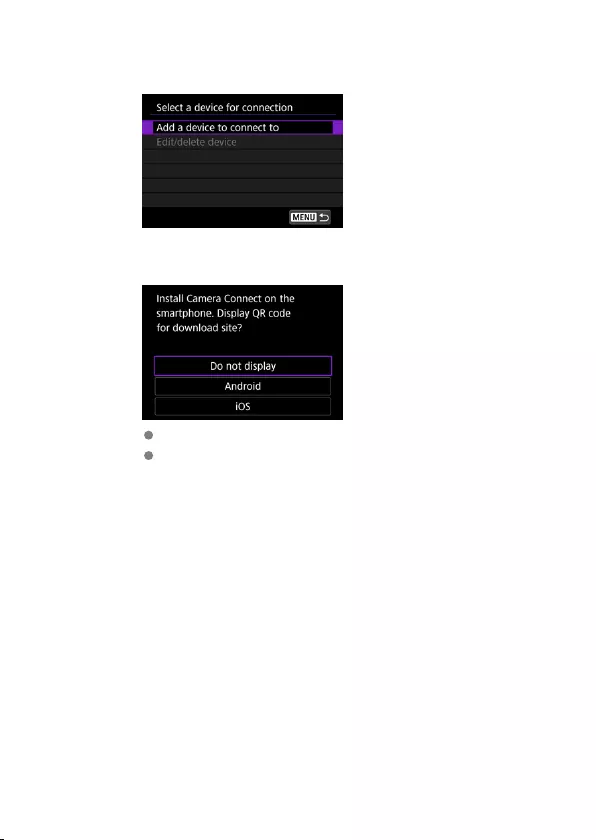
7. Select [Add a device to connect to].
8. Select an option.
If Camera Connect is already installed, select [Do not display].
If Camera Connect is not installed, select [Android] or [iOS], scan the
displayed QR code with the smartphone to access Google Play or App
Store and install Camera Connect.
589

9. Select [Pair via Bluetooth].
Press < > to start pairing.
To pair with a different smartphone after pairing with one initially, select
[OK] on the screen shown above.
590
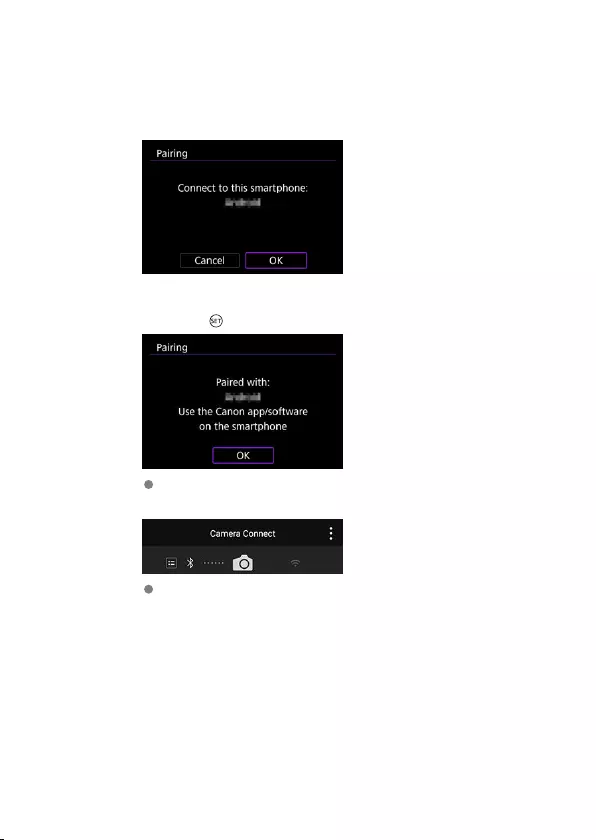
Steps on the camera (2)
13. Select [OK].
14. Press the < > button.
Pairing is now complete, and the camera is connected to the
smartphone via Bluetooth.
A Bluetooth icon appears on the main Camera Connect screen.
592
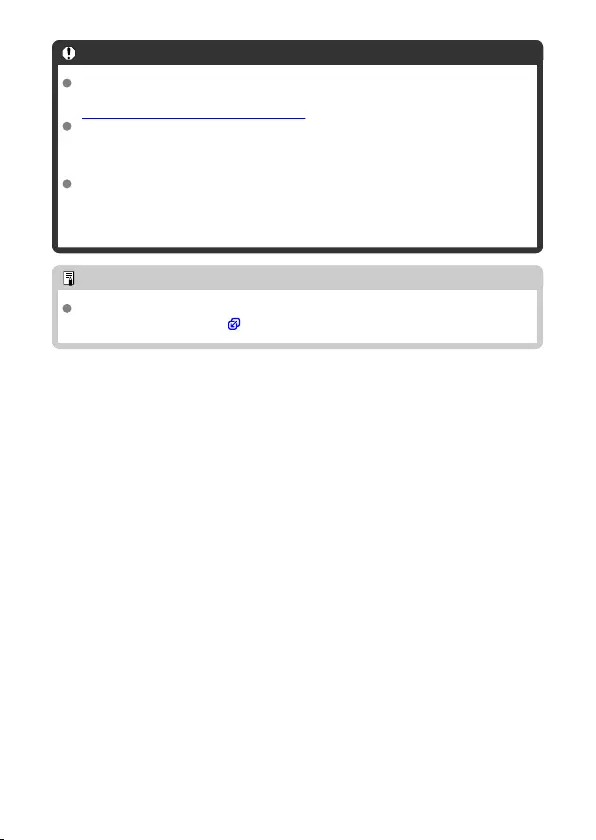
Caution
The camera cannot be connected to two or more devices at the same time via
Bluetooth. To switch to a different smartphone for the Bluetooth connection, see
Changing or Deleting Connection Settings.
Bluetooth connection consumes battery power even after the camera’s auto power
off is activated. Therefore, the battery level may be low when you use the camera.
Troubleshooting pairing
Keeping pairing records for previously paired cameras on your smartphone will
prevent it from pairing with this camera. Before you try pairing again, remove
pairing records for previously paired cameras from your smartphone’s Bluetooth
settings screen.
Note
With a Bluetooth connection established, you can operate the camera to send
images to the smartphone ( ).
593
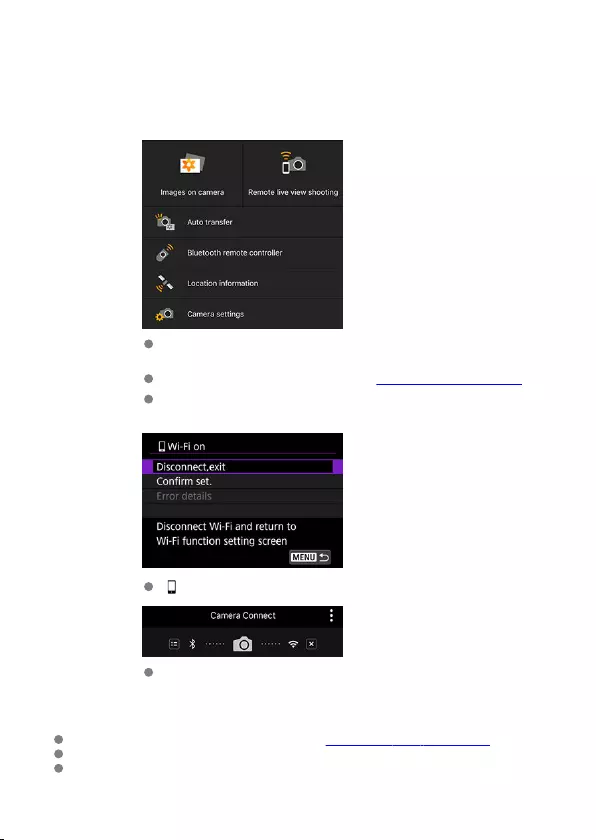
Steps on the smartphone (2)
15. Tap a Camera Connect function.
In iOS, tap [Join] when a message is displayed to confirm camera
connection.
For the Camera Connect functions, see Camera Connect Functions.
When a Wi-Fi connection is established, the screen for the selected
function will appear.
[Wi-Fi on] is displayed on the camera screen.
The Bluetooth and Wi-Fi icons are lit on the main Camera Connect
screen.
The Wi-Fi connection to a Bluetooth-compatible smartphone is now complete.
For how to terminate the Wi-Fi connection, see Terminating Wi-Fi Connections.
Terminating the Wi-Fi connection will switch the camera to the Bluetooth connection.
To reconnect via Wi-Fi, start Camera Connect and tap the function you will use.
594

[ Wi-Fi on] screen
Disconnect,exit
Terminates the Wi-Fi connection.
Confirm set.
You can check the settings.
Error details
When a Wi-Fi connection error occurs, you can check the details of the error.
595

Camera Connect Functions
Images on camera
Images can be browsed, deleted, or rated.
Images can be saved on a smartphone.
Remote live view shooting
Enables remote shooting as you view a live image on the smartphone.
Auto transfer
Enables camera and app setting adjustment for automatic transfer of your shots ( ).
Bluetooth remote controller
Enables remote control of the camera from a smartphone paired via Bluetooth. (Not
available when connected via Wi-Fi.)
Auto power off is disabled while you are using the Bluetooth remote controller feature.
Location information
Not supported on this camera.
Camera settings
Camera settings can be changed.
596
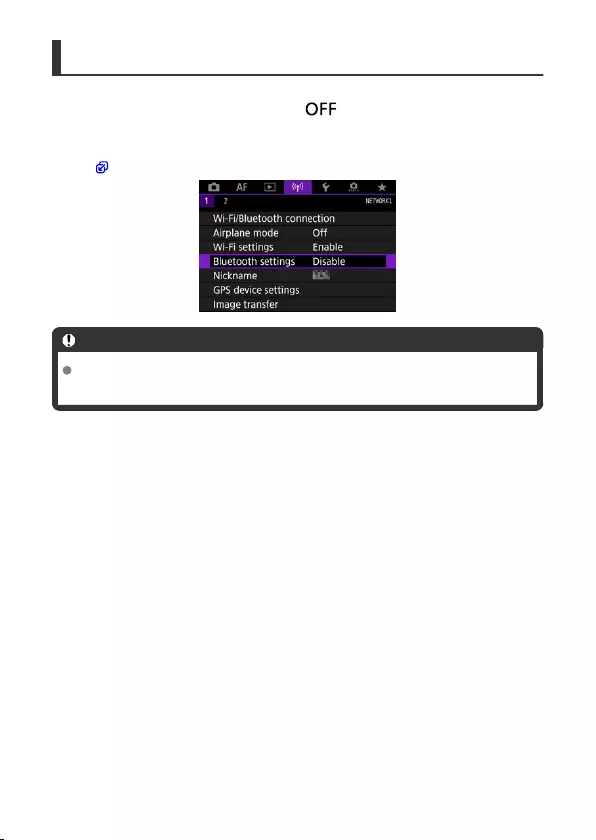
Maintaining a Wi-Fi Connection When the Camera Is Off
Even when the camera power switch is set to <>, as long as it is paired to a
smartphone via Bluetooth, you can use the smartphone to connect via Wi-Fi and browse
images on the camera or perform other operations.
If you prefer not to connect via Wi-Fi to the camera when it is off, either set [Airplane mode]
to [On] ( ) or set [Bluetooth settings] to [Disable].
Caution
This function can no longer be used if the wireless settings are reset or the
smartphone connection information is erased.
597
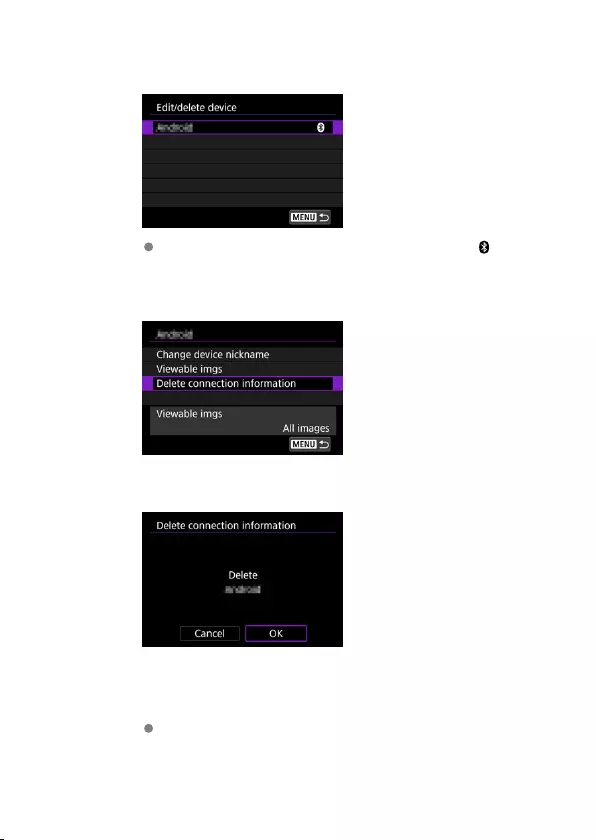
4. Select the smartphone to cancel pairing with.
Smartphones currently paired with the camera are labeled [ ].
5. Select [Delete connection information].
6. Select [OK].
7. Clear the camera information on the smartphone.
In the smartphone’s Bluetooth setting menu, clear the camera
information registered on the smartphone.
599
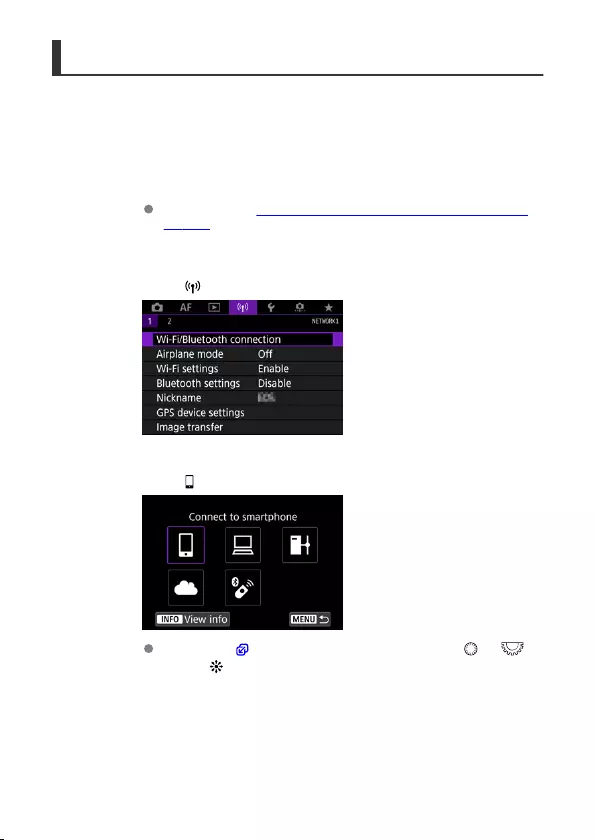
Wi-Fi Connection without Using Bluetooth
Steps on the camera (1)
1. Set Wi-Fi settings to [Enable].
See steps 1–2 in Connecting to a Bluetooth-Compatible Smartphone
via Wi-Fi.
2. Select [ : Wi-Fi/Bluetooth connection].
3. Select [ Connect to smartphone].
If the history ( ) is displayed, switch screens with the < > < >
dial or <>.
600
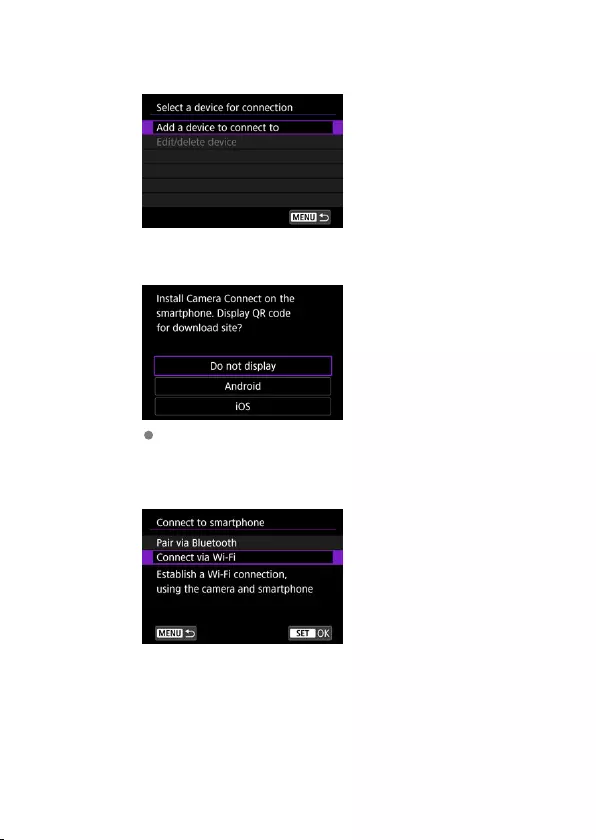
4. Select [Add a device to connect to].
5. Select an option.
If Camera Connect is already installed, select [Do not display].
6. Select [Connect via Wi-Fi].
601
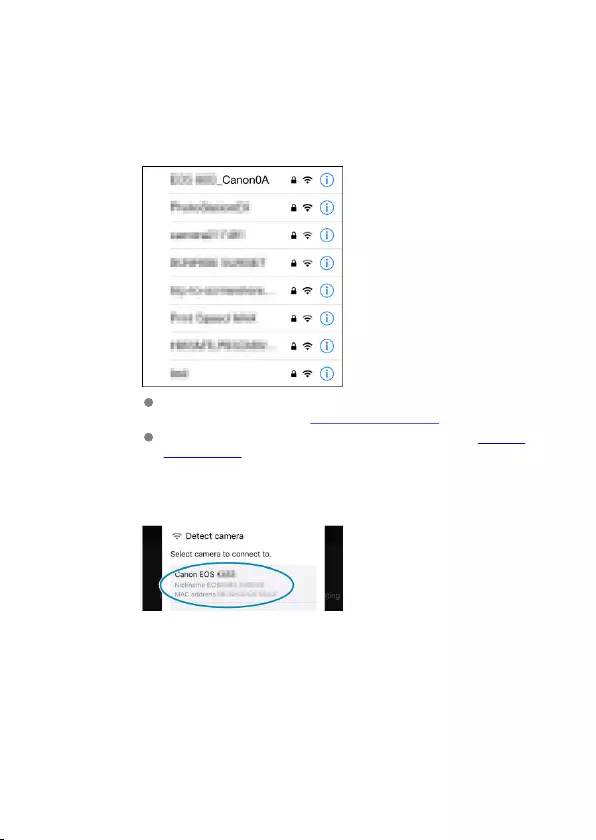
Steps on the smartphone
8. Operate the smartphone to establish a Wi-Fi connection.
Smartphone’s screen (sample)
Activate the smartphone’s Wi-Fi function, then tap the SSID (network
name) checked in step 7 in Steps on the camera (1).
For the password, enter the password checked in step 7 in Steps on
the camera (1).
9. Start Camera Connect and tap the camera to connect to via Wi-Fi.
603
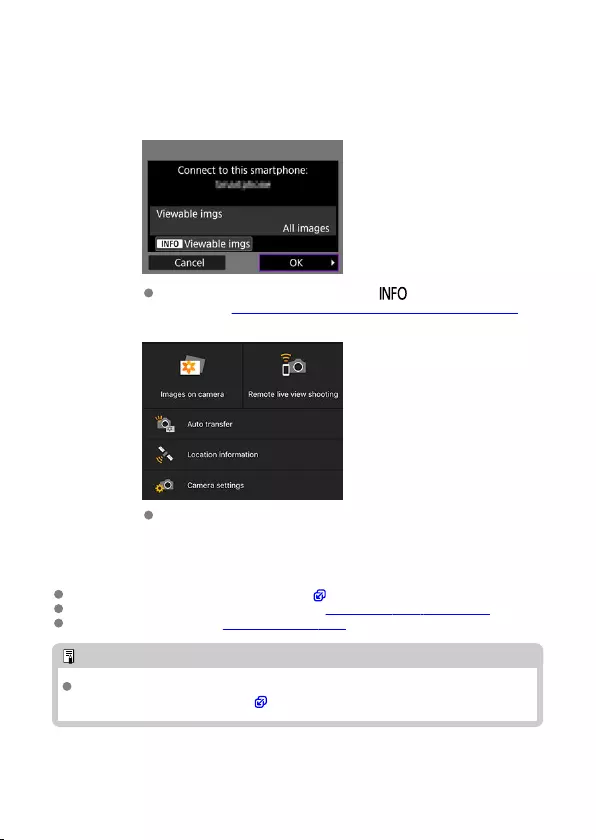
Steps on the camera (2)
10. Select [OK].
To specify viewable images, press the < > button. Configure as
described in Settings to Make Images Viewable from Smartphones,
starting in step 5.
The main window of Camera Connect will be displayed on the
smartphone.
The Wi-Fi connection to a smartphone is now complete.
Operate the camera using Camera Connect ( ).
For how to terminate the Wi-Fi connection, see Terminating Wi-Fi Connections.
To reconnect via Wi-Fi, see Reconnecting via Wi-Fi.
Note
When connected via Wi-Fi, you can send images to a smartphone from the Quick
Control screen during playback ( ).
604
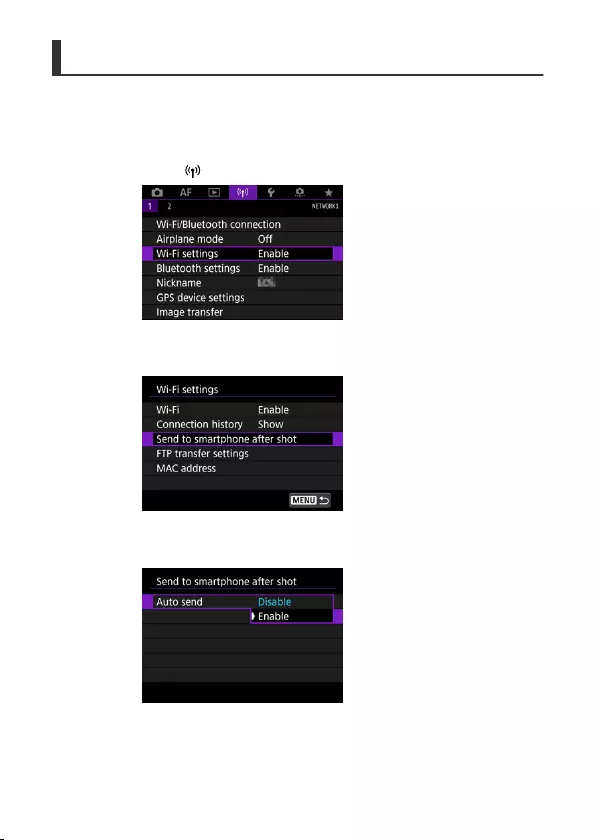
Automatic Image Transfer as You Shoot
Your shots can be automatically sent to a smartphone. Before following these steps, make
sure the camera and smartphone are connected via Wi-Fi.
1. Select [ : Wi-Fi settings].
2. Select [Send to smartphone after shot].
3. Set [Auto send] to [Enable].
605

4. Set [Size to send].
5. Take the picture.
606

Sending Images to a Smartphone from the Camera
You can use the camera to send images to a smartphone paired via Bluetooth (Android
devices only) or connected via Wi-Fi.
1. Switch to playback.
2. Press the < > button.
3. Select [ Send images to smartphone].
If you perform this step while connected via Bluetooth, a message is
displayed, and the connection switches to a Wi-Fi connection.
4. Select sending options and send the images.
607
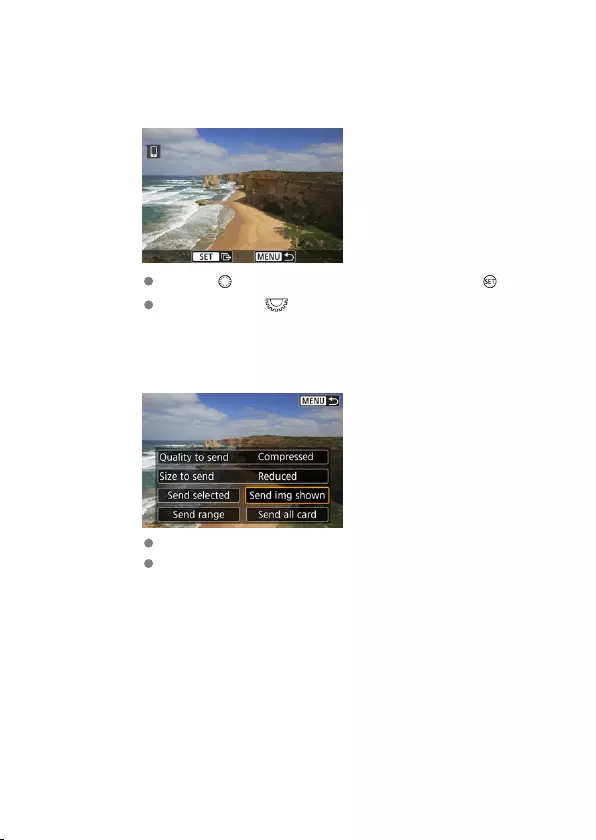
(1) Sending images individually
1. Select an image to send.
Use the < > dial to select an image to send, then press < >.
You can turn the < > dial counterclockwise to select the image
using the index display.
2. Select [Send img shown].
In [Size to send], you can select the image sending size.
When sending movies, you can select the image quality of movies to
send in [Quality to send].
608
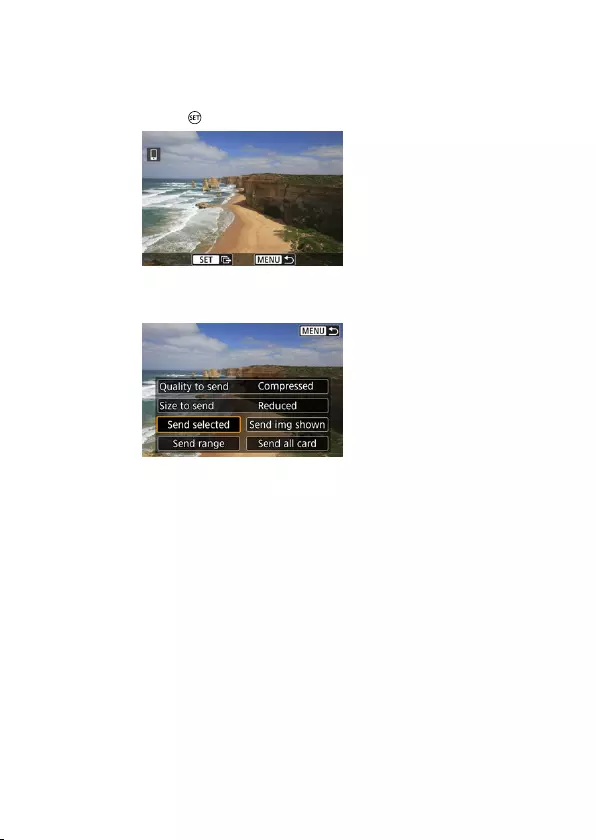
(2) Sending multiple selected images
1. Press < >.
2. Select [Send selected].
609

3. Select images to send.
Use the < > dial to select images to send, then press < >.
You can turn the < > dial counterclockwise to switch to select the
images from 3-image display. To return to single-image display, turn
the < > dial clockwise.
After selecting the images to send, press the < > button.
610

4. Select [Size to send].
On the displayed screen, select an image size.
When sending movies, select the image quality in [Quality to send].
5. Select [Send].
611
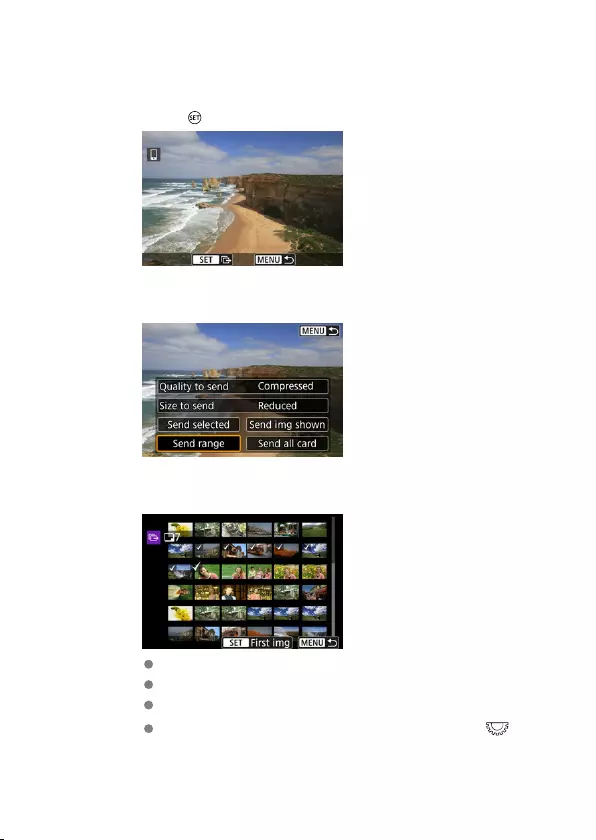
(3) Sending a specified range of images
1. Press < >.
2. Select [Send range].
3. Specify the range of images.
Select the first image (start point).
Select the last image (end point).
To cancel the selection, repeat this step.
To change the number of images in index display, turn the < >
dial.
612
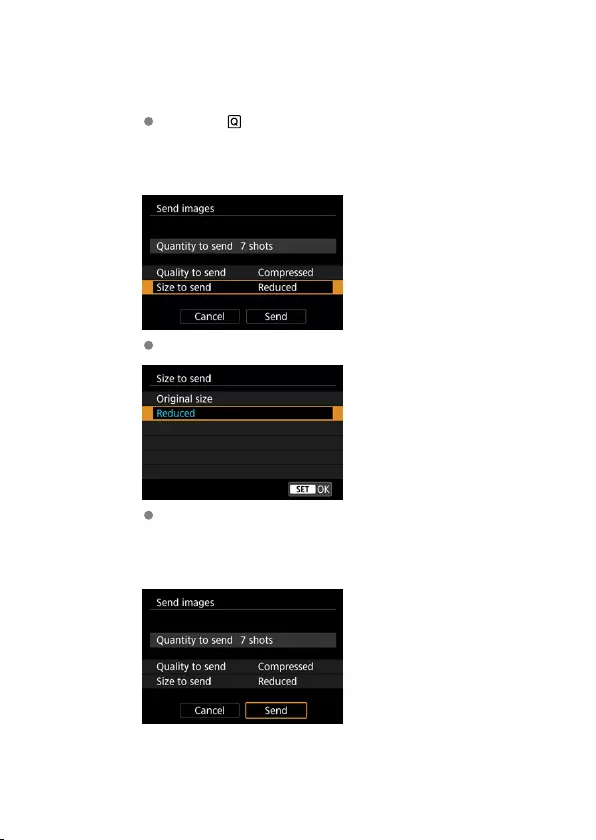
4. Confirm the range.
Press the < > button.
5. Select [Size to send].
On the displayed screen, select an image size.
When sending movies, select the image quality in [Quality to send].
6. Select [Send].
613
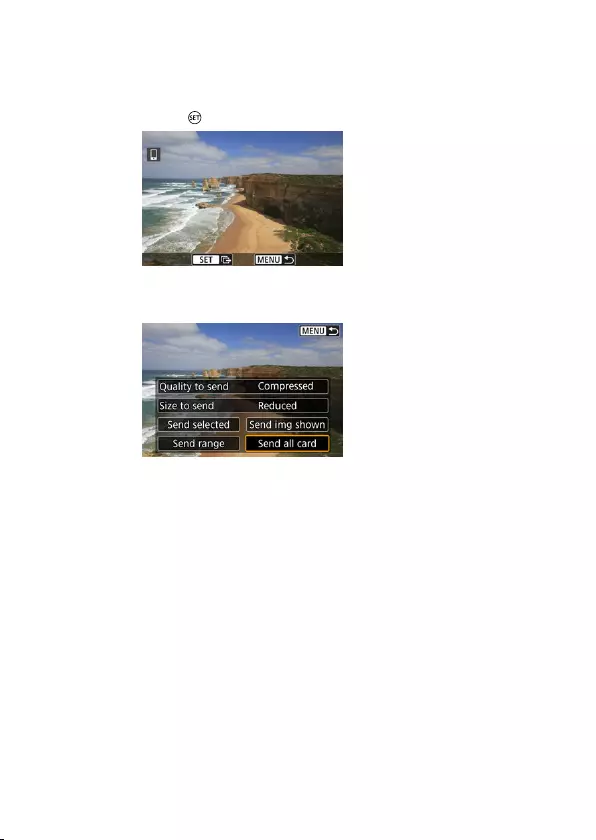
(4) Sending all images on the card
1. Press < >.
2. Select [Send all card].
614
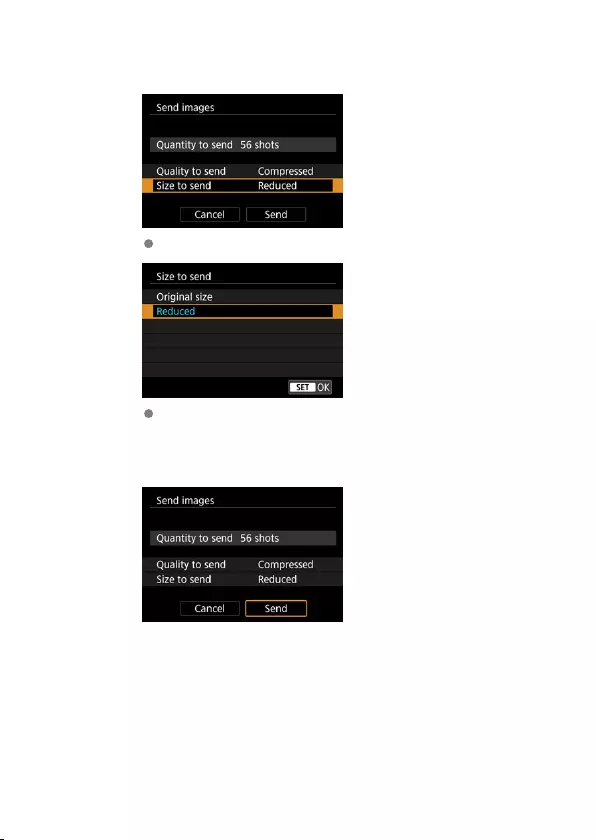
3. Select [Size to send].
On the displayed screen, select an image size.
When sending movies, select the image quality in [Quality to send].
4. Select [Send].
615
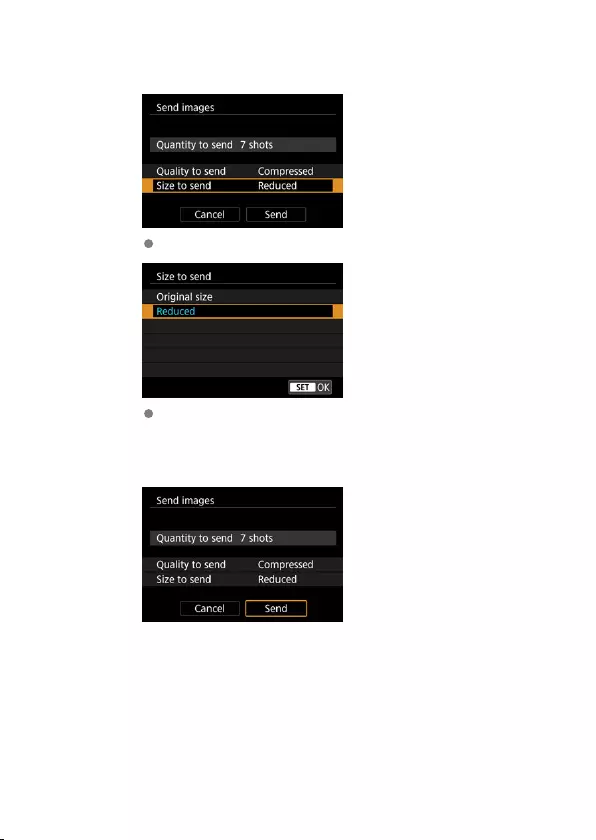
3. Select [Size to send].
On the displayed screen, select an image size.
When sending movies, select the image quality in [Quality to send].
4. Select [Send].
617
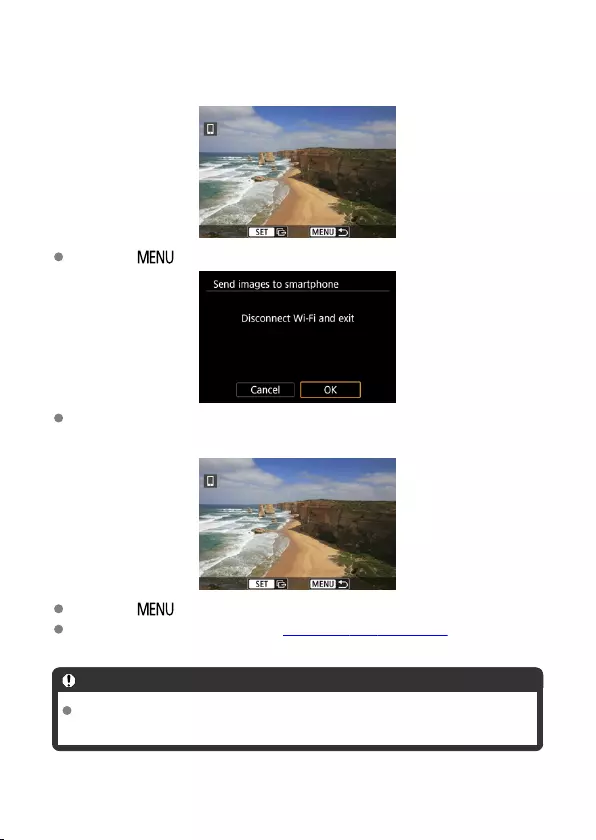
Ending image transfer
Sending images from the camera when paired via Bluetooth (Android devices only)
Press the < > button on the image transfer screen.
Select [OK] to end image transfer and the Wi-Fi connection.
Sending images from the camera over a Wi-Fi connection
Press the < > button on the image transfer screen.
To terminate the Wi-Fi connection, see Terminating Wi-Fi Connections.
Caution
During the image transfer operation, a picture cannot be taken even if the camera’s
shutter button is pressed.
618

Note
You can cancel the image transfer by selecting [Cancel] during the transfer.
You can select up to 999 files at a time.
With a Wi-Fi connection established, disabling the smartphone’s power saving
function is recommended.
Selecting the reduced size for still photos applies to all still photos sent at that time.
Note that size still photos are not reduced.
Selecting compression for movies applies to all movies sent at that time. Note that
and movies are not reduced.
When you use a battery to power the camera, make sure it is fully charged.
619

Terminating Wi-Fi Connections
Perform either of the following operations.
On the Camera Connect screen, tap [ ].
On the [ Wi-Fi on] screen, select [Disconnect,exit].
If the [ Wi-Fi on] screen is not displayed, select [ : Wi-Fi/Bluetooth connection].
Select [Disconnect,exit], then select [OK] on the confirmation screen.
620
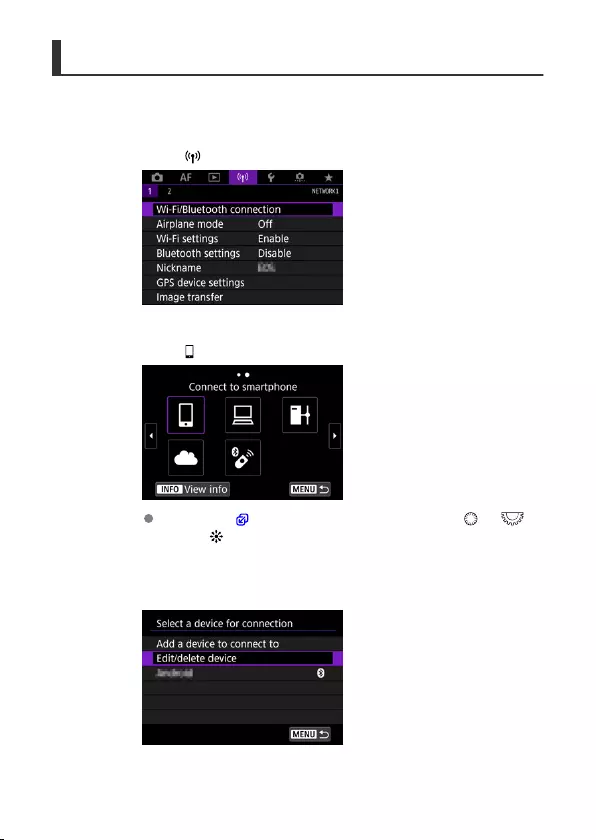
Settings to Make Images Viewable from Smartphones
Images can be specified after the Wi-Fi connection is terminated.
1. Select [ : Wi-Fi/Bluetooth connection].
2. Select [ Connect to smartphone].
If the history ( ) is displayed, switch screens with the < > < >
dial or <>.
3. Select [Edit/delete device].
621
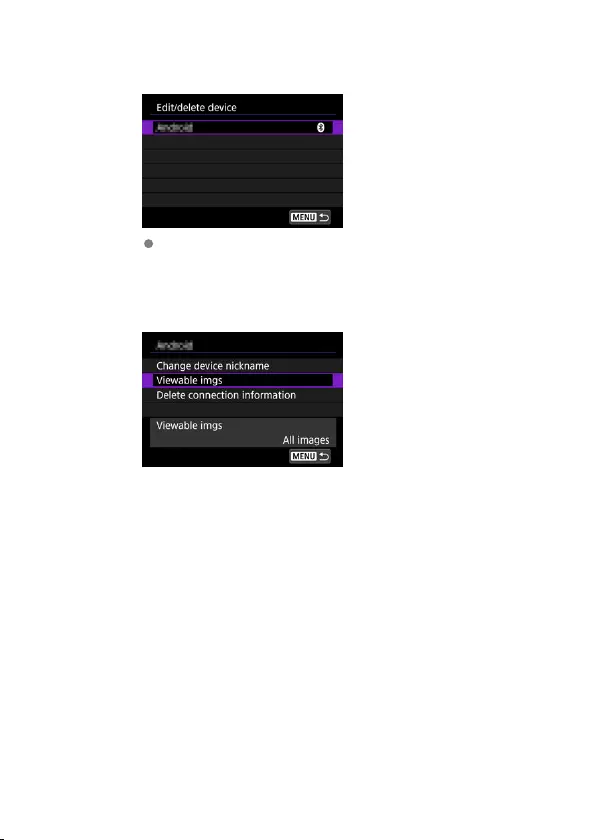
4. Select a smartphone.
Select the name of the smartphone on which you want to make the
images viewable.
5. Select [Viewable imgs].
622
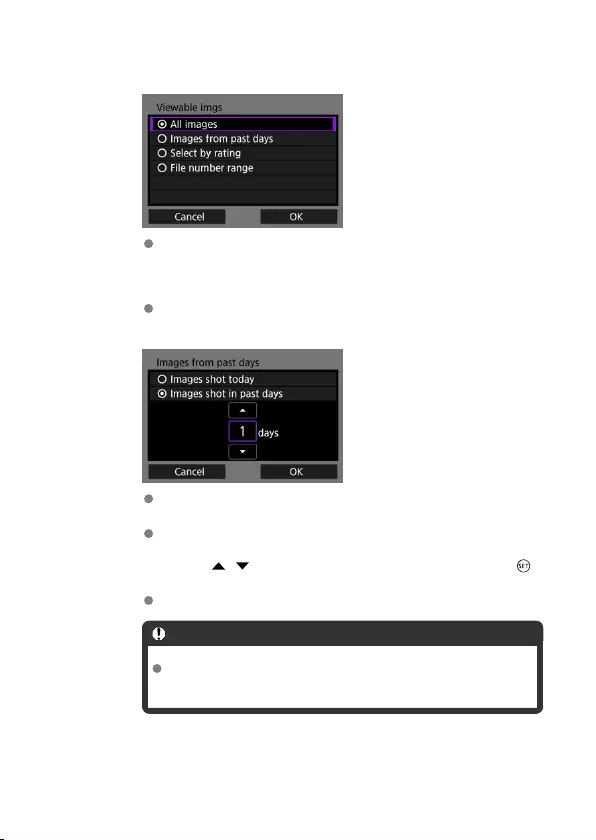
6. Select an option.
Select [OK] to access the setting screen.
[All images]
All images stored on the card become viewable.
[Images from past days]
Specify viewable images on the shooting-date basis. Images shot up to
nine days ago can be specified.
When [Images shot in past days] is selected, images shot up to the
specified number of days before the current date become viewable.
Use the [ ] [ ] keys to specify the number of days, then press < >
to confirm the selection.
Once you select [OK], the viewable images are set.
Caution
If [Viewable imgs] is set to any setting other than [All images],
remote shooting is not possible.
623
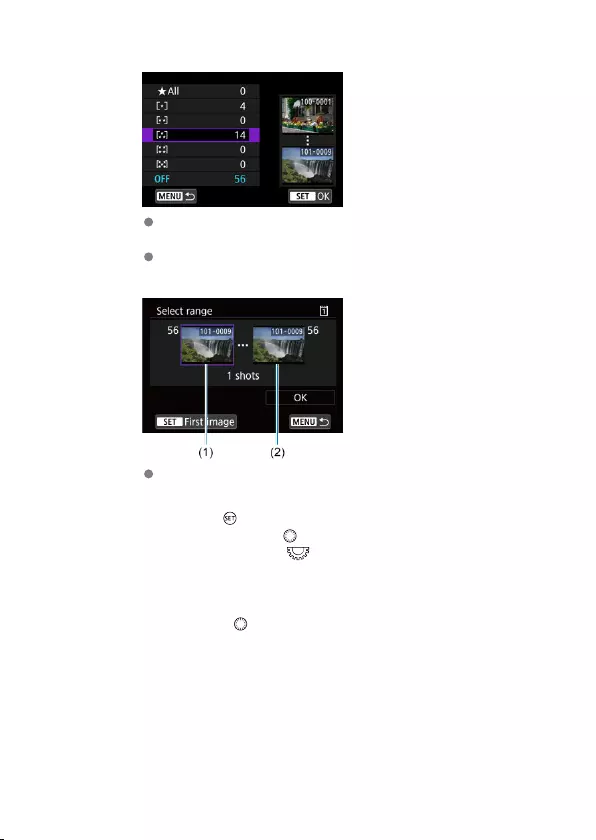
[Select by rating]
Specify viewable images depending on whether a rating is appended
(or not appended) or by the type of rating.
Once you select the type of rating, the viewable images are set.
[File number range] (Select range)
Select the first and last images from images arranged by the file
number to specify the viewable images.
1.Press < > to display the image selection screen. To select
images, use the < > dial or other controls.
You can turn the < > dial counterclockwise to select the image
using the index display.
2.Select an image as the starting point (1).
3.Use the < > dial to select an image as the ending point (2).
4.Select [OK].
624
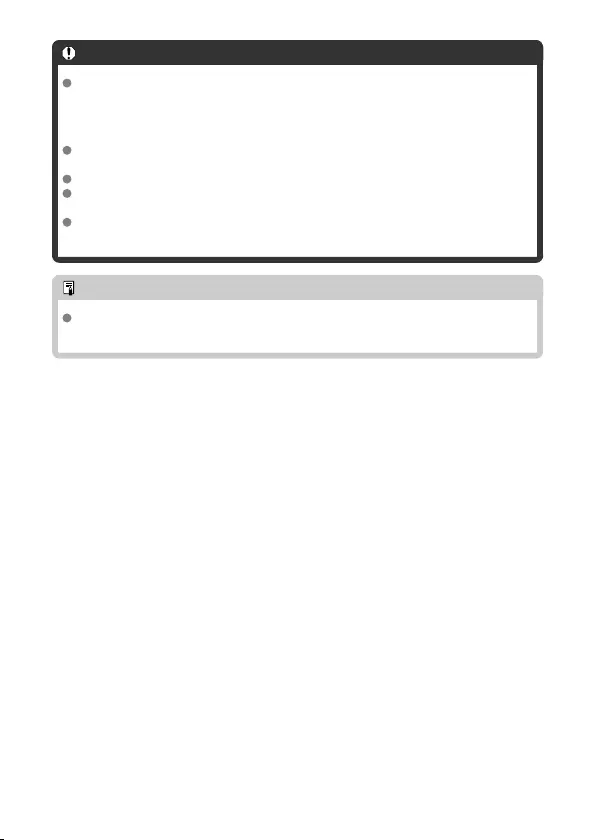
Caution
If the Wi-Fi connection is terminated while recording a movie with remote shooting,
the following will occur.
• Any movie recording in progress in movie recording mode will continue.
• Any movie recording in progress in still photo shooting mode will end.
With a Wi-Fi connection to a smartphone established, certain functions are
unavailable.
In remote shooting, the AF speed may become slower.
Depending on the communication status, image display or shutter release timing
may be delayed.
When saving images to a smartphone, you cannot take a picture even if you press
the camera’s shutter button. Also, the camera screen may turn off.
Note
With a Wi-Fi connection established, disabling the smartphone’s power saving
function is recommended.
625

Connecting to a Computer via Wi-Fi
Operating the Camera Using EOS Utility
Direct Transfer
Creating and Registering Captions
This section describes how to connect the camera to a computer via Wi-Fi and perform
camera operations using EOS Utility (EOS software). Install the latest version of EOS Utility
on the computer before setting up a Wi-Fi connection.
For computer operating instructions, refer to the computer user manual.
Operating the Camera Using EOS Utility
Using EOS Utility, you can import images from the camera, control the camera, and perform
other operations.
Steps on the camera (1)
1. Set Wi-Fi settings to [Enable].
See steps 1–2 in Connecting to a Bluetooth-Compatible Smartphone
via Wi-Fi.
2. Select [ : Wi-Fi/Bluetooth connection].
626
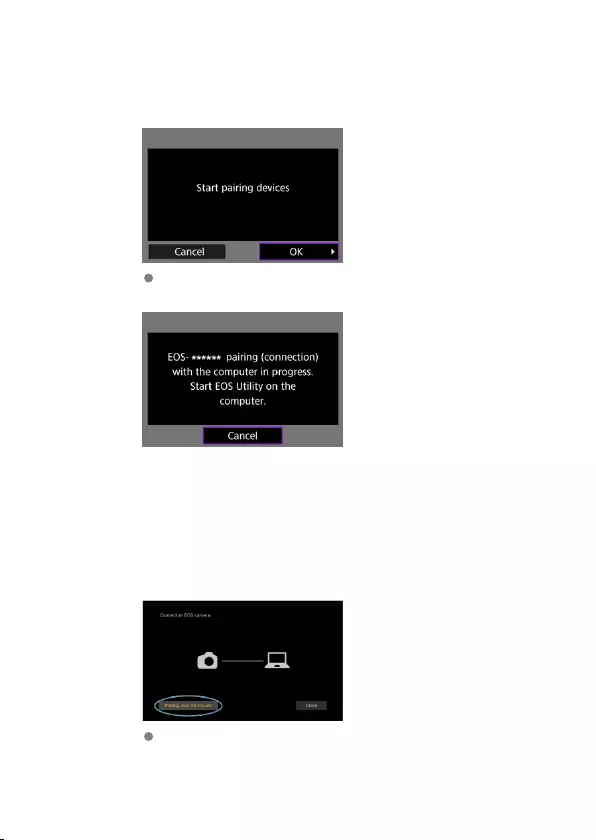
Steps on the camera (2)
7. Select [OK].
The following message is displayed. “******” represents the last six
digits of the MAC address of the camera to be connected.
Steps on the computer (2)
8. Start EOS Utility.
9. In EOS Utility, click [Pairing over Wi-Fi/LAN].
If a firewall-related message is displayed, select [Yes].
629
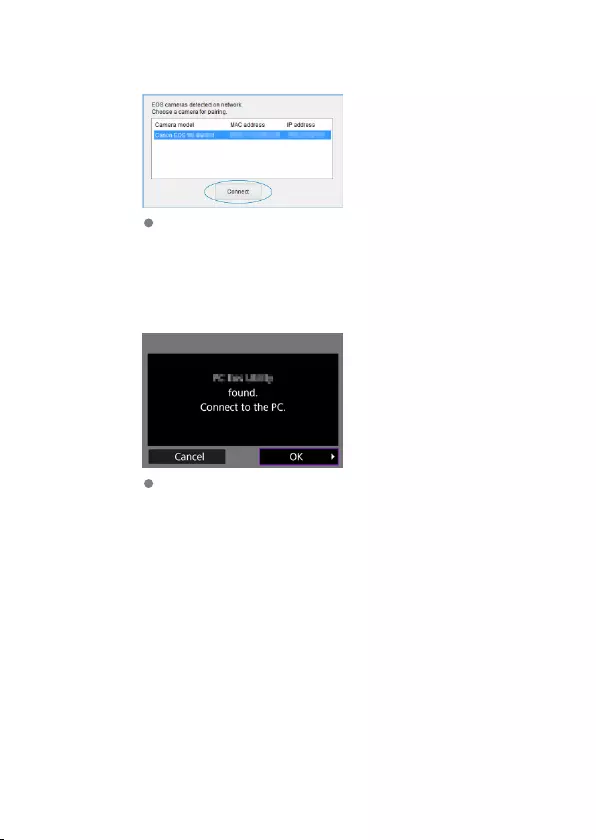
10. Click [Connect].
Select the camera to connect to, then click [Connect].
Steps on the camera (3)
11. Establish a Wi-Fi connection.
Select [OK].
630

[ Wi-Fi on] screen
Disconnect,exit
Terminates the Wi-Fi connection.
Confirm set.
You can check the settings.
Error details
When a Wi-Fi connection error occurs, you can check the details of the error.
The Wi-Fi connection to a computer is now complete.
Operate the camera using EOS Utility on the computer.
To reconnect via Wi-Fi, see Reconnecting via Wi-Fi.
Caution
If the Wi-Fi connection is terminated while recording a movie with remote shooting,
the following will occur.
• Any movie recording in progress in movie recording mode will continue.
• Any movie recording in progress in still photo shooting mode will end.
You cannot use the camera to shoot in still photo shooting mode when it is set to
movie recording mode in EOS Utility.
With a Wi-Fi connection to EOS Utility established, certain functions are
unavailable.
In remote shooting, the AF speed may become slower.
Depending on the communication status, image display or shutter release timing
may be delayed.
In Remote Live View shooting, the rate of image transmission is slower compared
to a connection via an interface cable. Therefore, moving subjects cannot be
displayed smoothly.
631
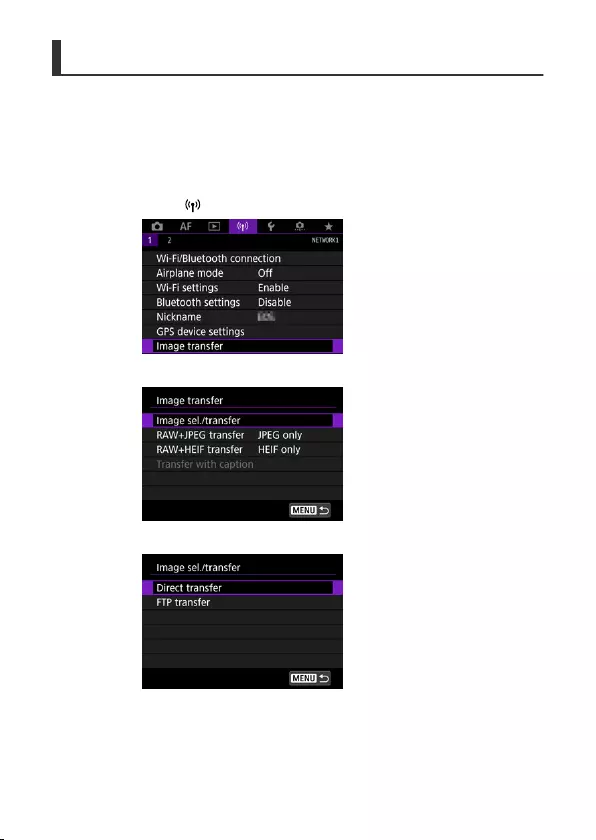
Direct Transfer
With the camera connected to EOS Utility and the main EOS Utility window displayed, you
can use the camera to transfer images to computer.
Selecting images to transfer
1. Select [ : Image transfer].
2. Select [Image sel./transfer].
3. Select [Direct transfer].
632
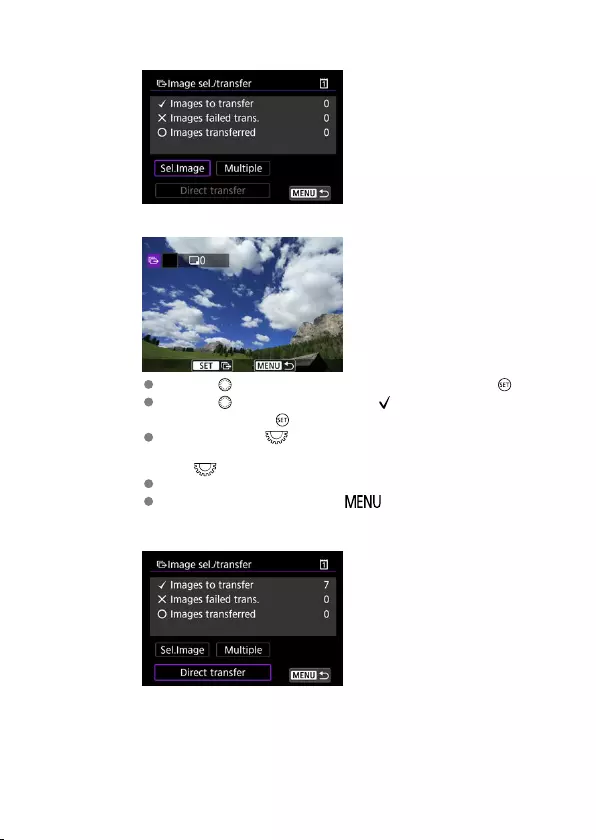
4. Select [Sel.Image].
5. Select images to transfer.
Use the < > dial to select an image to transfer, then press < >.
Use the < > dial to add a checkmark [ ] in the upper left of the
screen, then press < >.
You can turn the < > dial counterclockwise to switch to selecting
images from 3-image display. To return to single-image display, turn
the < > dial clockwise.
To select other images to transfer, repeat step 5.
After image selection, press the < > button.
6. Select [Direct transfer].
633

7. Select [OK].
The selected images are transferred to the computer.
634
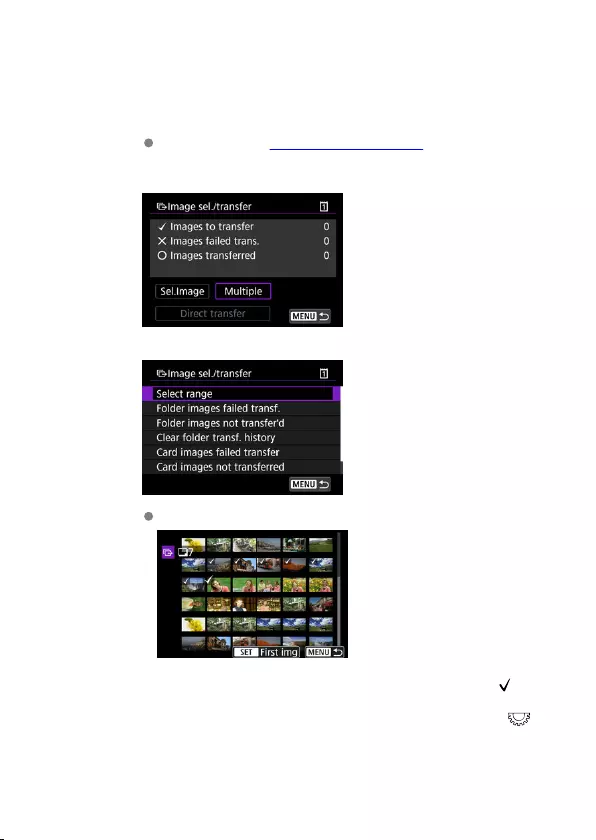
Selecting multiple images
Multiple images can be transferred at once after you choose a selection method.
1. Access the [Image sel./transfer] screen.
Follow steps 1–3 in Selecting Images to Transfer.
2. Select [Multiple].
3. Select a selection method to use.
Select range
• Select [Select range]. Selecting the first and last images of the
range marks all the images in the range with a checkmark [ ], and
one copy of each image will be sent.
• To change the number of images in index display, turn the < >
dial.
635
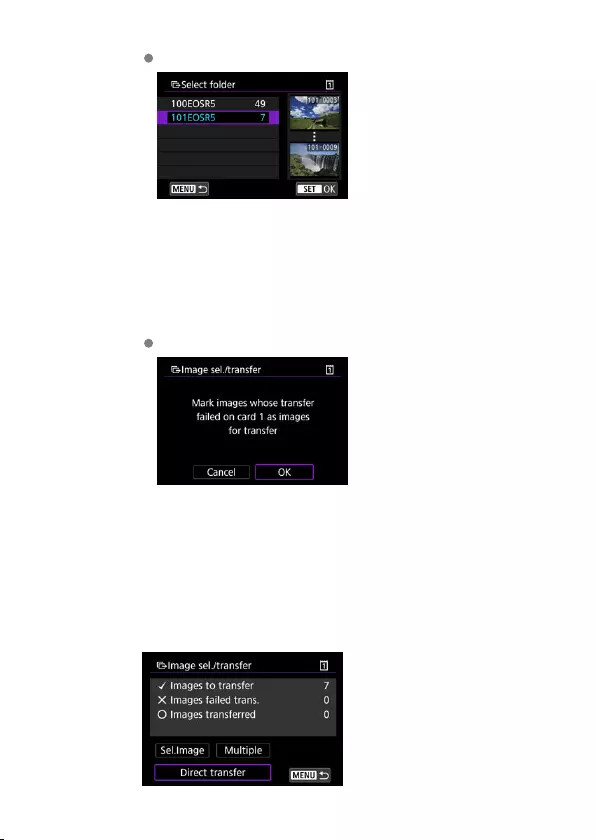
In a folder
• Selecting [Folder images failed transf.] selects all images in the
selected folder for which transfer failed.
• Selecting [Folder images not transfer'd] selects all unsent
images in the selected folder.
• Selecting [Clear folder transf. history] clears the transfer history
of images in the selected folder. After clearing the transfer history,
you can select [Folder images not transfer'd] and transfer all
images in the folder again.
In a card
• Selecting [Card images failed transfer] selects all images in the
selected card for which transfer failed.
• Selecting [Card images not transferred] selects all unsent images
in the selected card.
• Selecting [Clear card's transf. history] clears the transfer history
of images in the selected card. After clearing the transfer history,
you can select [Card images not transferred] and transfer all
images in the card again.
4. Select [Direct transfer].
636

5. Select [OK].
The selected images are transferred to the computer.
637
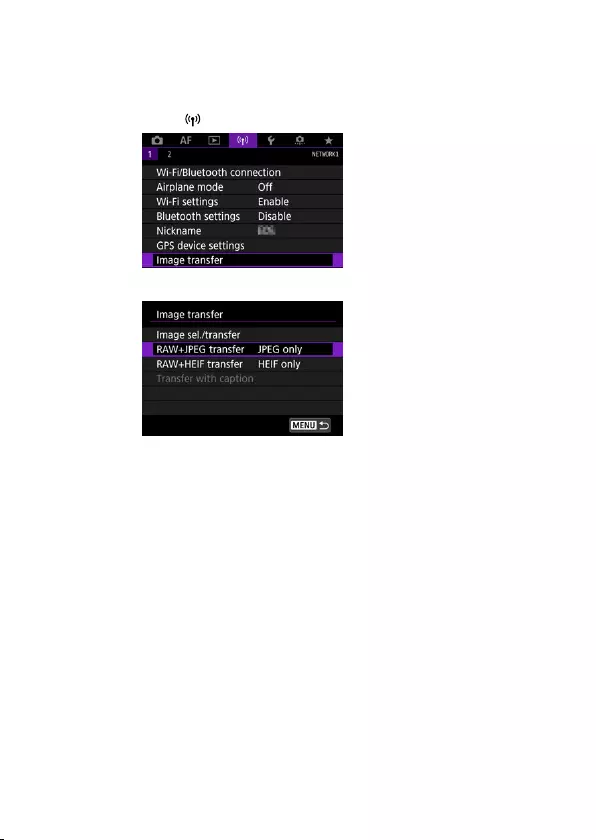
Transferring RAW+JPEG or RAW+HEIF images
For RAW+JPEG or RAW+HEIF images, you can specify which image to transfer.
1. Select [ : Image transfer].
2. Select the type of images to transfer.
638
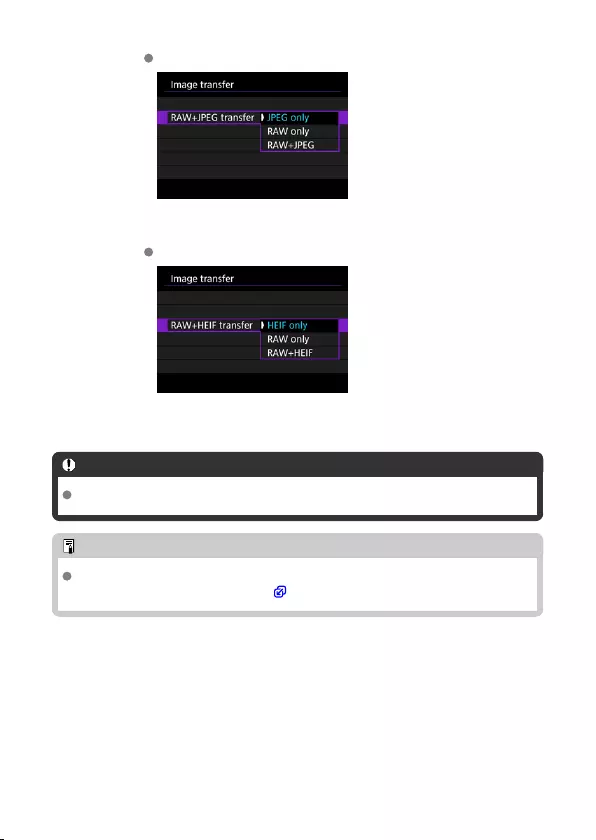
RAW+JPEG transfer
• Select [RAW+JPEG transfer], then select [JPEG only], [RAW
only], or [RAW+JPEG].
RAW+HEIF transfer
• Select [RAW+HEIF transfer], then select [HEIF only], [RAW only],
or [RAW+HEIF].
Caution
Some menu items are not available during image transfer.
Note
This setting is linked to [RAW+JPEG transfer] and [RAW+HEIF transfer] settings
on the [Transfer type/size] screen ( ).
639
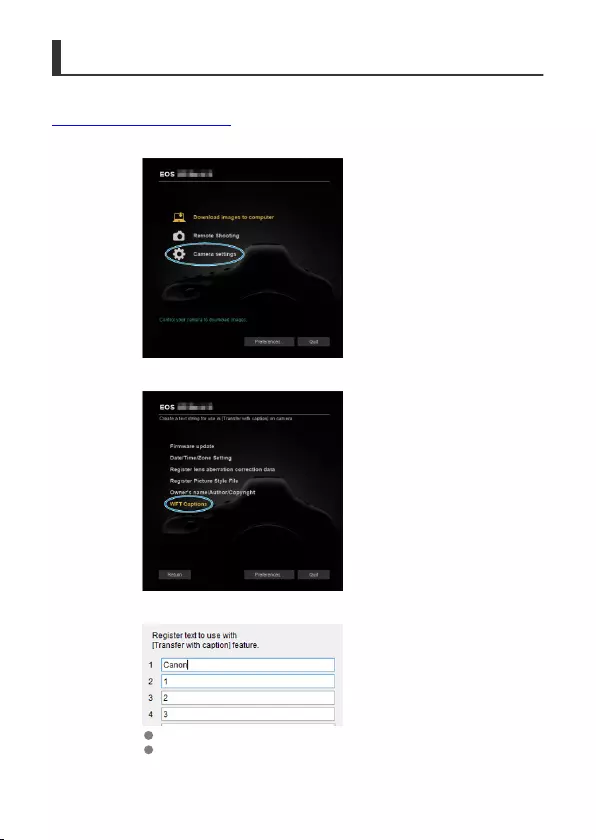
Creating and Registering Captions
You can create captions and register them on the camera to use them as described in
Adding a Caption Before Transfer.
1. Start EOS Utility and select [Camera settings].
2. Select [WFT Captions].
3. Enter the caption or captions.
Enter up to 31 characters (in ASCII format).
To acquire caption data stored on the camera, select [Load settings].
640

4. Set the captions on the camera.
Select [Apply to camera] to set your new captions on the camera.
641

Sending Images to a Web Service
This section describes how to send images to image.canon.
Registering Image.Canon and Setting Up Auto Send
You can register image.canon on the camera and prepare to send your shots automatically.
A computer or smartphone with a browser and internet connection is required.
You will need to enter an email address used on your computer or smartphone.
For instructions on how to use image.canon services and details on countries and
regions where it is available, visit the image.canon site (https://image.canon/).
Separate ISP connection and access point fees may apply.
Steps on the camera (1)
1. Set Wi-Fi settings to [Enable].
See steps 1–2 in Connecting to a Bluetooth-Compatible Smartphone
via Wi-Fi.
2. Select [ : Wi-Fi/Bluetooth connection].
642

6. Enter your email address.
Enter your email address, then select [OK].
7. Enter a four-digit number.
Enter a four-digit number of your choice, then select [OK].
644
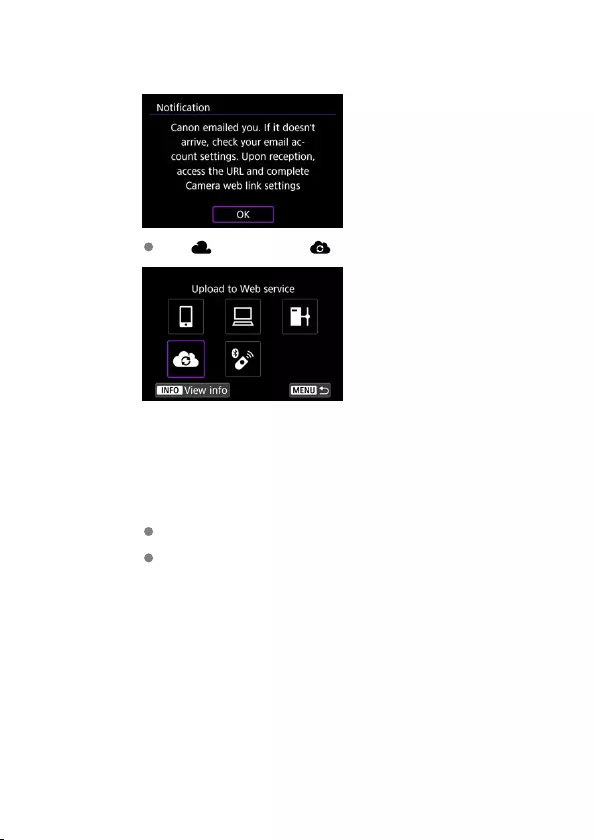
8. Select [OK].
The [ ] icon changes to [ ].
Steps on the computer or smartphone
9. Set up camera web link.
Access the page in the notification message.
Follow the instructions to complete the settings on the camera web link
settings page.
645
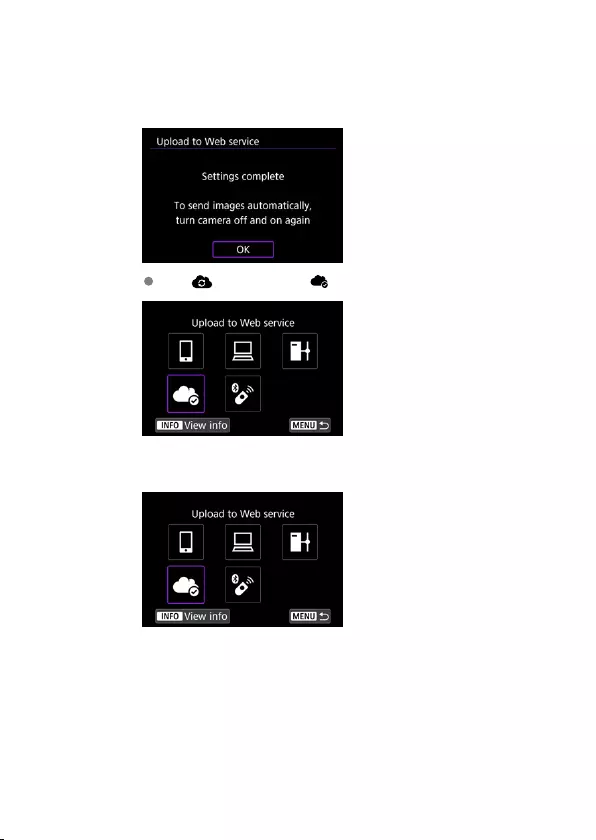
Steps on the camera (2)
10. Select [OK].
The [ ] icon changes to [ ].
11. Select [Upload to Web service].
646
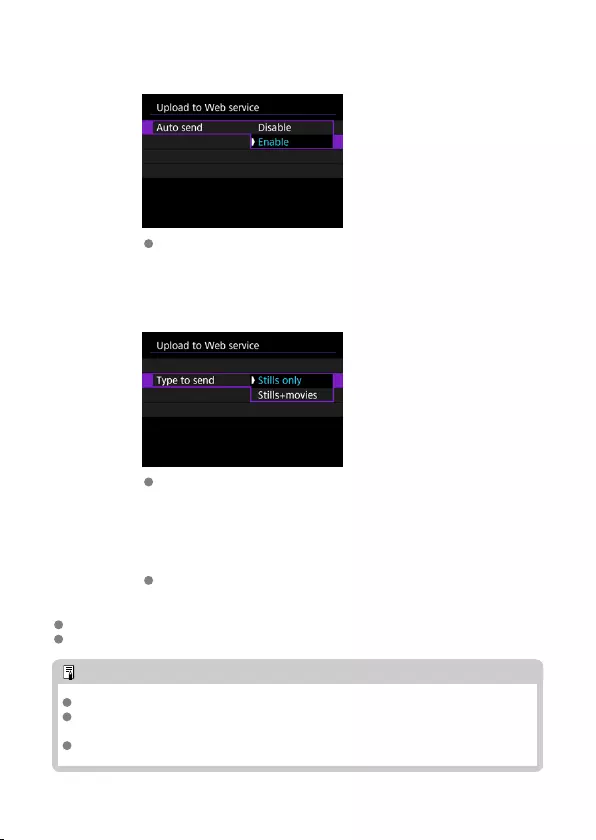
12. Select [Auto send].
Once [Enable] is set, images are automatically sent when you turn the
camera on.
13. Select [Type to send].
Set to [Stills only] or [Stills+movies].
14. Restart the camera.
The images are now sent automatically.
To switch networks, select [Switch network] and follow steps 5–8.
To remove the connection, select [Clear camera web link settings] and then [OK].
Note
All image files on cards are sent when [Auto send] is set to [Enable].
When [Auto send] is set to [Enable], auto send starts after the camera starts up
(or recovers from auto power off).
Any images captured during auto sending are also sent.
647

Caution
Auto send does not start during interval timer shooting.
Transfer stops in the following cases.
• [Airplane mode] is set to [On]
• Movie recording is started
• A USB connection is started
• Battery capacity is low
• The camera’s power switch is set to < >
648

Image Transfer to FTP Servers
Preparation
Connecting to the Access Point
Configuring FTP Server Connection Settings
FTP Transfer Settings
Transferring Multiple Images at Once
Adding a Caption Before Transfer
Auto Retry If Transfer Fails
Viewing Transferred Images
Your images can be transferred to an FTP server on the network the camera is connected
to.
Preparation
A computer running one of the following OSes is required. The computer must also be set
up in advance to function as an FTP server.
Windows 10 (ver. 1607 or later)
Windows 8.1, Windows 8.1 Pro
For instructions on setting up the computer to function as an FTP server, refer to
documentation for your computer.
Connect the computer to use as an FTP server to the access point in advance.
649
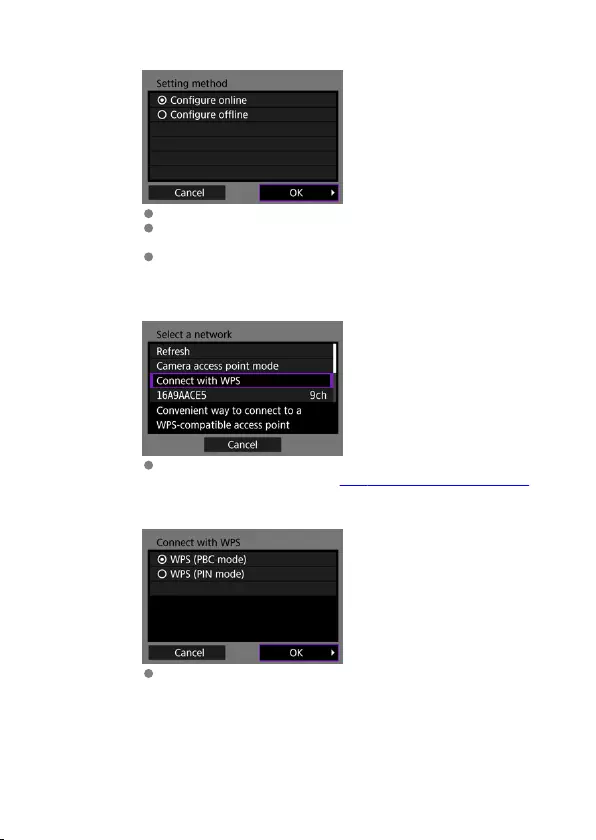
5. Select [Setting method].
Select an option and then [OK] to go to the next screen.
Select [Configure online] to configure connection settings and then
join the network.
Select [Configure offline] to configure FTP server connection settings
without connecting.
6. Select [Connect with WPS].
Follow these steps to connect via WPS (PBC mode). To connect to
access points in other ways, see Wi-Fi Connection via Access Points.
7. Select [WPS (PBC mode)].
Select [OK].
651
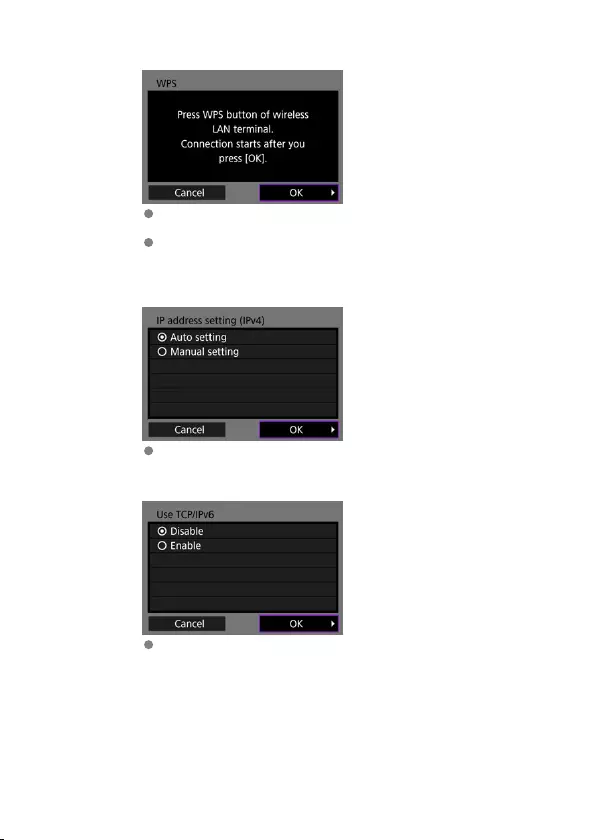
8. Press the WPS button on the access point.
For details on where the WPS button is and how long to press it, refer
to the access point user manual.
Select [OK] to initiate connection with the access point. The following
screen is displayed once the camera is connected to the access point.
9. Select an IP address setting option.
Select [OK].
10. Select an IPv6 option.
Select [OK].
652

Configuring FTP Server Connection Settings
1. Select an FTP mode.
For secure FTP transfer using a root certificate, select [FTPS]. For
details on root certificate settings, see Set Root Certif.
Select [OK] to go to the next screen.
2. Select [Address setting].
Select [OK] to go to the next screen.
The virtual keyboard is displayed if you have specified [Auto setting]
for the IP address or [Manual setting] for the DNS address.
A screen for numerical input is displayed if you have specified
[Disable] for the DNS address.
653
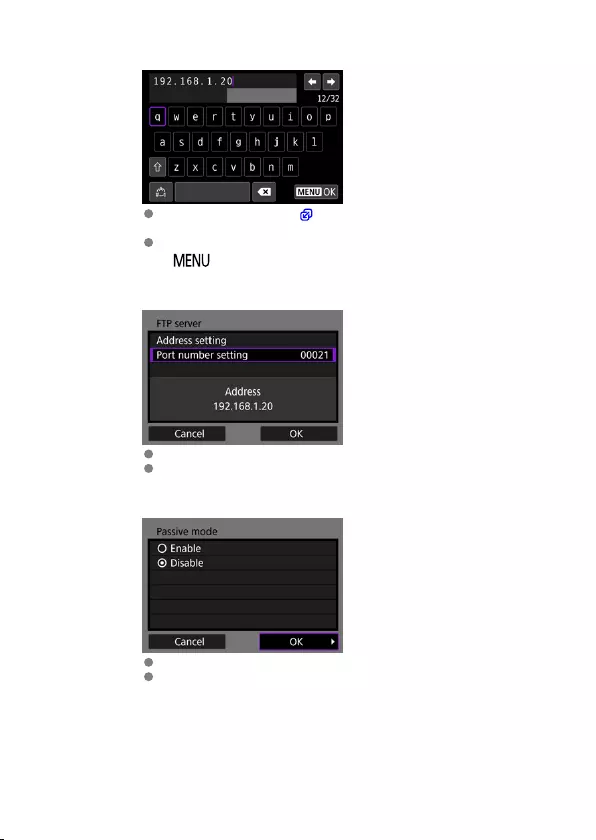
3. Enter the FTP server IP address.
Use the virtual keyboard ( ) to enter the IP address. If DNS is used,
enter the domain name.
To set the entered values and return to the screen for step 2, press the
< > button.
4. Configure the port number.
Normally, set [Port number setting] to 00021.
Select [OK] to go to the next screen.
5. Configure the passive mode setting.
Select [OK] to go to the next screen.
If an Error 41 (Cannot connect to FTP server) is displayed in step 8,
setting [Passive mode] to [Enable] may resolve it.
654
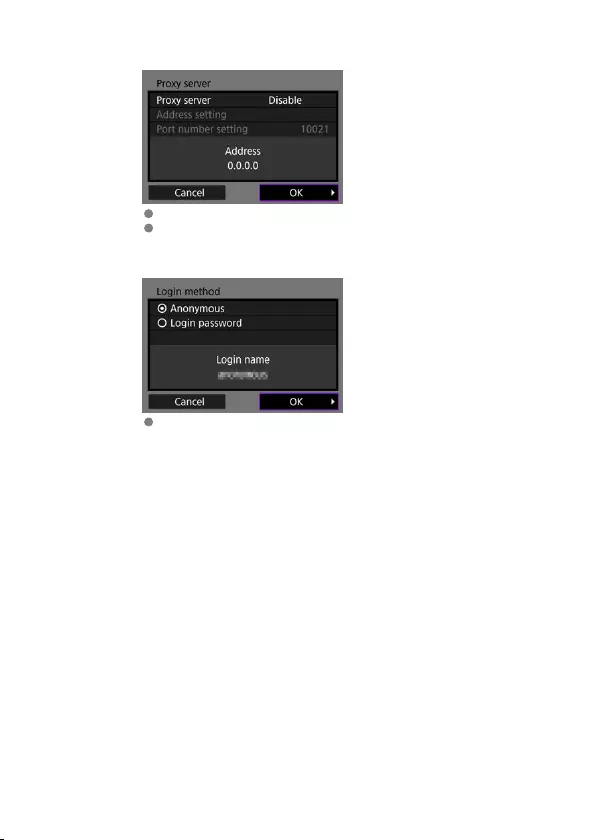
6. Configure proxy server settings.
Not displayed if you selected [FTPS] in step 1.
Select [OK] to go to the next screen.
7. Configure the login method.
Select [OK] to go to the next screen.
655
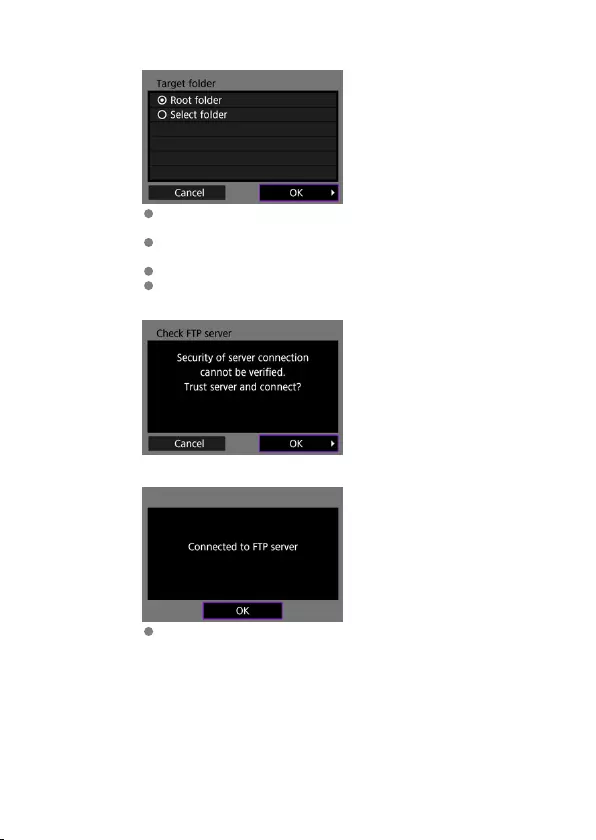
8. Specify a target folder.
Select [Root folder] to have images saved in the root folder, as
specified in FTP server settings.
Select [Select folder] to specify a target folder in the root folder. If the
folder does not exist, it is created automatically.
Select [OK] to go to the next screen.
When the following message appears, select [OK] to trust the target
server.
9. Select [OK].
Not displayed in offline configuration.
Connection settings for FTP transfer are now complete.
656

FTP Transfer Settings
You can configure settings related to FTP transfer and power saving.
1. Select [ : Wi-Fi settings].
2. Select [FTP transfer settings].
657
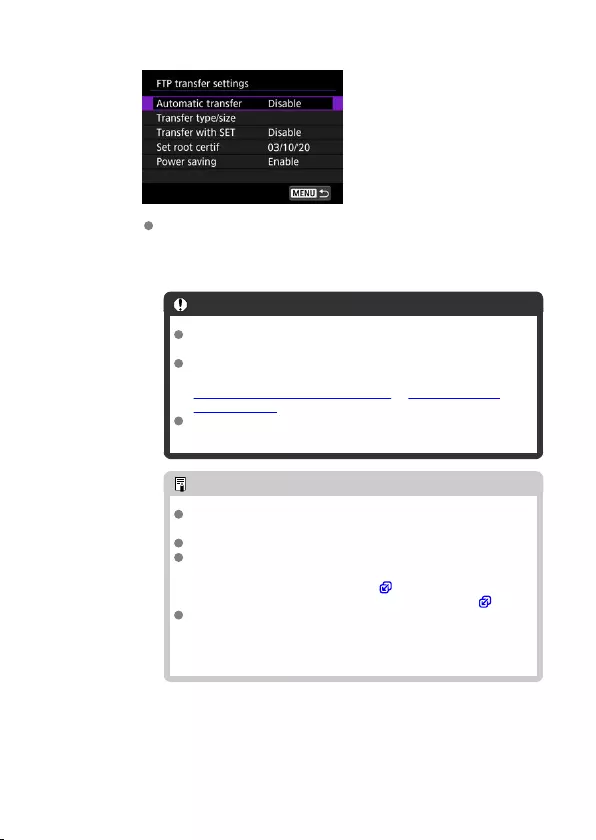
3. Select an option to configure.
Automatic transfer
Select [Enable] for automatic image transfer to the FTP server
immediately after shooting. You can continue shooting still photos as
usual while images are being transferred.
Caution
Before shooting, make sure a card is in the camera. If you
shoot without recording images, they cannot be transferred.
Automatic transfer of movies during recording is not
supported. After recording, transfer movies as described in
Transferring Multiple Images at Once or Adding a Caption
Before Transfer.
Images cannot be erased during image transfer.
Note
During continuous shooting, images are transferred to the
FTP server in the order they are captured.
Captured images are also stored on the card.
In the case of any images for which transfer fails or is
interrupted, the camera attempts transfer again automatically
when the connection is recovered ( ). You can also try again
later to manually transfer all of these images at once ( ).
Repeated automatic transfer is not attempted if network
settings (such as FTP server settings) are changed before
automatic FTP transfer begins.
658
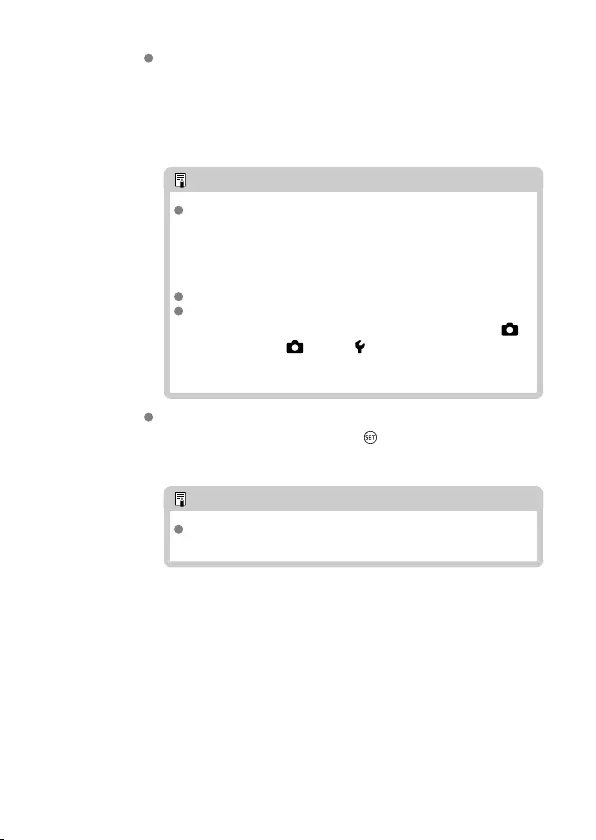
Transfer type/size
In [JPEG size to trans.], you can specify the size of images to transfer.
For example, to transfer smaller JPEGs when the camera is set to
record larger JPEGs to one card and smaller JPEGs to the other, set to
[SmallerJPEG].
In [RAW+JPEG transfer] or [RAW+HEIF transfer], you can specify
the type of images to transfer.
Note
When the camera is set to record RAW images to one card
and JPEGs or HEIFs to the other, specify which images to
transfer in the [RAW+JPEG transfer] or [RAW+HEIF
transfer] setting. Similarly, specify your transfer preference
when RAW+JPEG images or RAW+HEIF images are
simultaneously recorded to a single card.
Captured images are also stored on the card.
When images of the same size are recorded to both cards
simultaneously, images recorded to the card selected for [
Record/play] or [ Play] in [ : Record func+card/folder
sel.] are given priority for transfer.
Transfer with SET
When set to [Enable], simply press < > to transfer the image
displayed. You can continue shooting still photos as usual while images
are being transferred.
Note
Movies cannot be transferred this way.
659
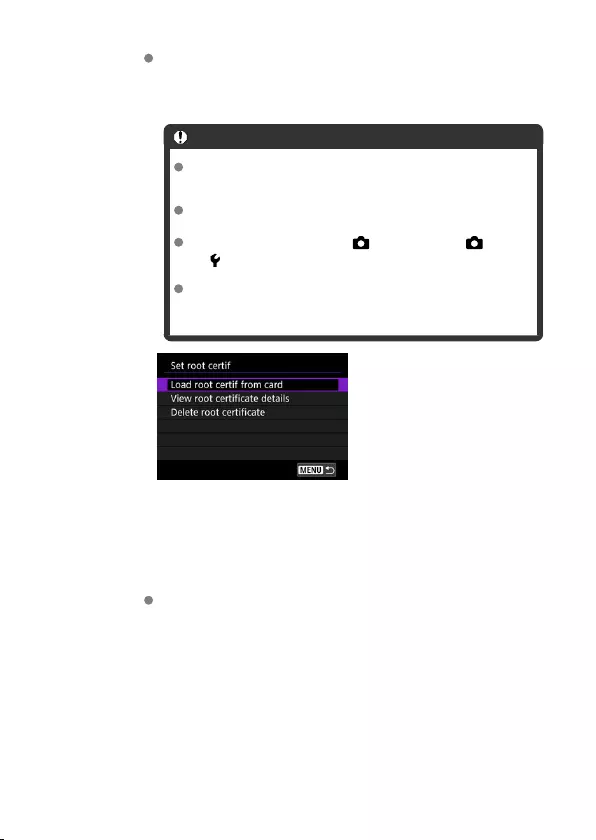
Set root certif
If you specified [FTPS] FTP mode when configuring connection
settings, the root certificate used by the FTPS server must be imported
to the camera.
Caution
Only the root certificate with a file name of “ROOT.CER,”
“ROOT.CRT,” or “ROOT.PEM” can be imported to the
camera.
Only one root certificate file can be imported to the camera.
Insert a card containing the root certificate file in advance.
The priority card selected for [ Record/play] or [ Play]
in [ : Record func+card/folder sel.] is used to import a
certificate.
It may not be possible to trust servers you try to connect to in
FTPS connections with a self-signed certificate.
Select [Load root certif from card] to import the root certificate on the
card.
To check who the root certificate was issued to and issued by, and the
period of validity, select [View root certificate details].
To delete the root certificate imported to the camera, select [Delete
root certificate].
Power saving
When [Enable] is set and no image is transferred for a certain period,
the camera will log off from the FTP server and end the Wi-Fi
connection. The connection is re-established automatically when the
camera is ready for image transfer again. If you prefer not to end the
Wi-Fi connection, set to [Disable].
660
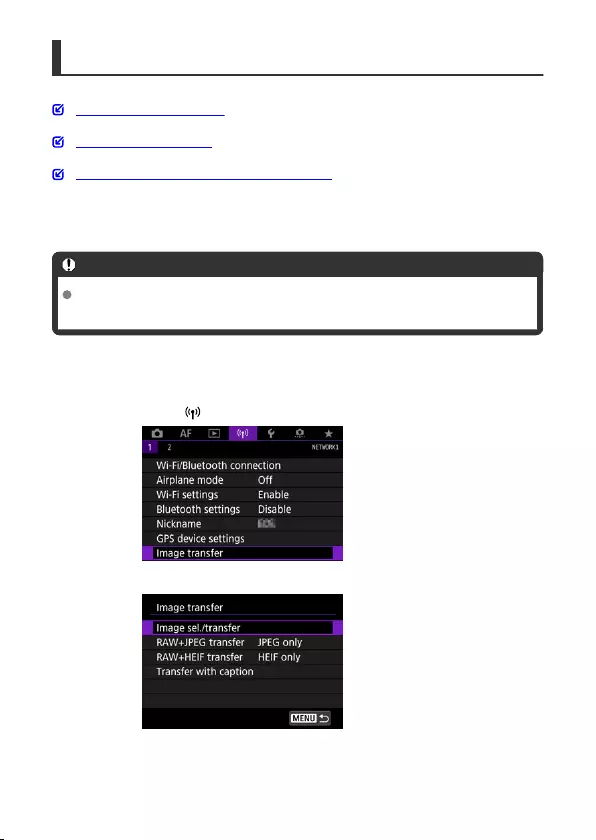
Transferring Multiple Images at Once
Selecting images to transfer
Selecting multiple images
Transferring RAW+JPEG or RAW+HEIF images
After shooting, you can select multiple images and transfer them all at once, or you can
transfer unsent images or images that could not be sent previously.
You can continue shooting still photos as usual during transfer.
Caution
Image transfer in progress is paused if you switch to movie mode. To resume
image transfer, switch to photo mode.
Selecting images to transfer
1. Select [ : Image transfer].
2. Select [Image sel./transfer].
661

3. Select [FTP transfer].
4. Select [Sel.Image].
5. Select the image to transfer.
Use the < > dial to select an image to transfer, then press < >.
Use the < > dial to add a checkmark [ ] in the upper left of the
screen, then press < >.
You can turn the < > dial counterclockwise to switch to select the
images from 3-image display. To return to single-image display, turn
the < > dial clockwise.
To select other images to transfer, repeat step 5.
After image selection, press the < > button.
662
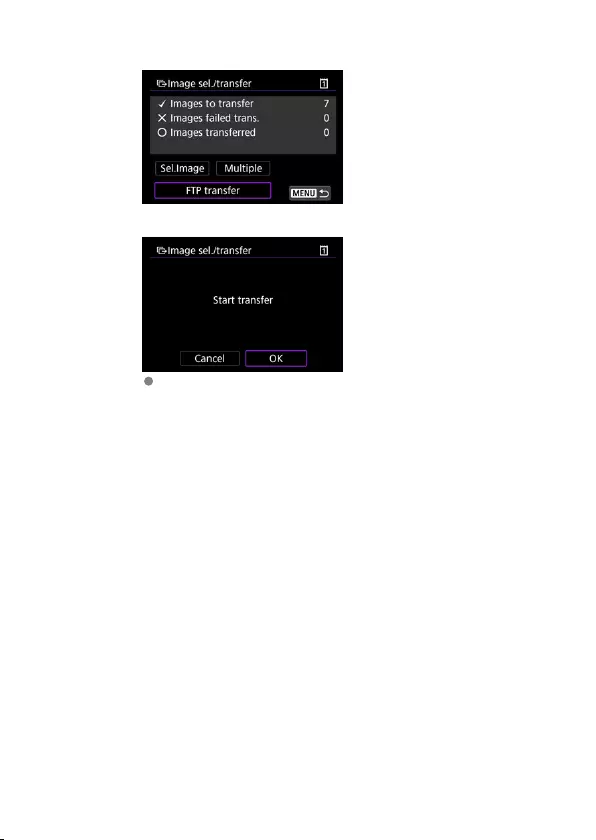
6. Select [FTP transfer].
7. Select [OK].
The selected images are transferred to the FTP server.
663
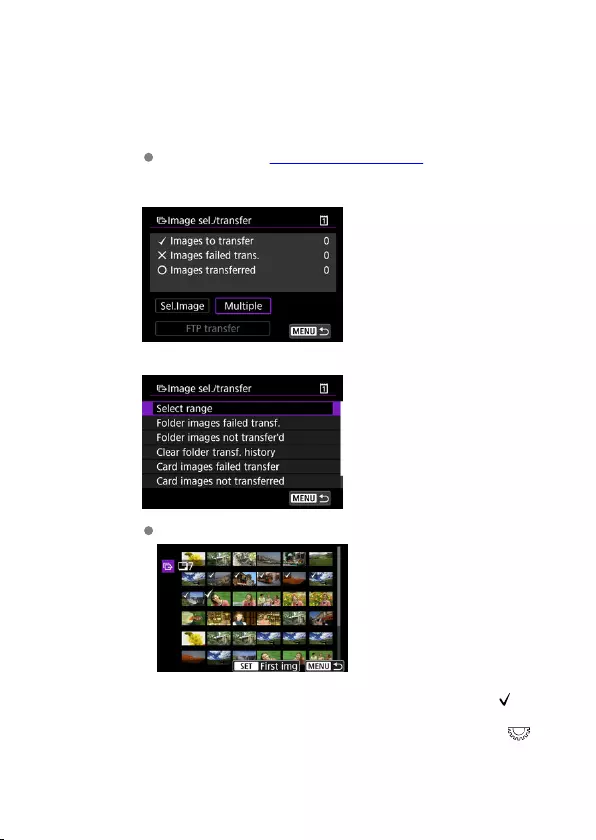
Selecting multiple images
Multiple images can be transferred at once after you choose a selection method. You can
continue shooting still photos as usual while images are being transferred.
1. Access the [Image sel./transfer] screen.
Follow steps 1–3 in Selecting Images to Transfer.
2. Select [Multiple].
3. Select a selection method to use.
Select range
• Select [Select range]. Selecting the first and last images of the
range marks all the images in the range with a checkmark [ ], and
one copy of each image will be sent.
• To change the number of images in index display, turn the < >
dial.
664
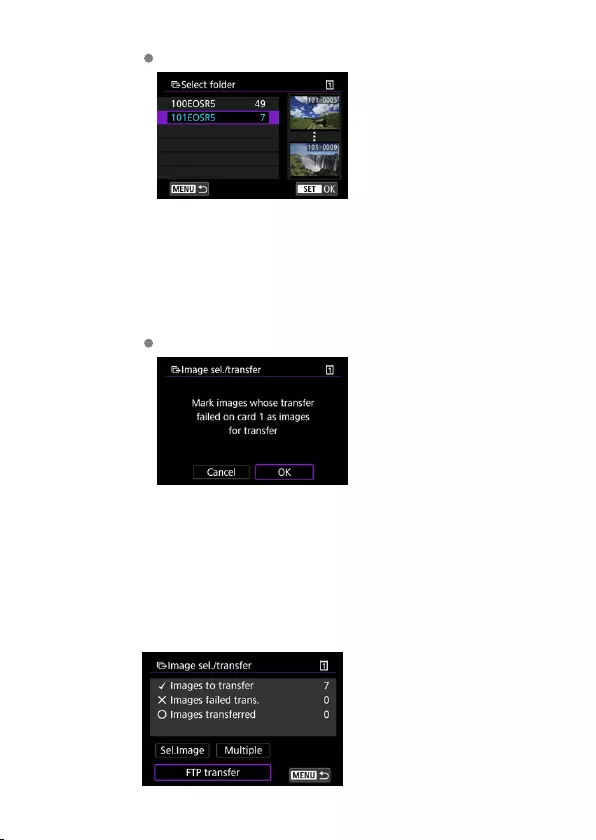
In a folder
• Selecting [Folder images failed transf.] selects all images in the
selected folder for which transfer failed.
• Selecting [Folder images not transfer'd] selects all unsent
images in the selected folder.
• Selecting [Clear folder transf. history] clears the transfer history
of images in the selected folder. After clearing the transfer history,
you can select [Folder images not transfer'd] and transfer all
images in the folder again.
In a card
• Selecting [Card images failed transfer] selects all images in the
selected card for which transfer failed.
• Selecting [Card images not transferred] selects all unsent images
in the selected card.
• Selecting [Clear card's transf. history] clears the transfer history
of images in the selected card. After clearing the transfer history,
you can select [Card images not transferred] and transfer all
images in the card again.
4. Select [FTP transfer].
665

5. Select [OK].
The selected images are transferred to the FTP server.
666
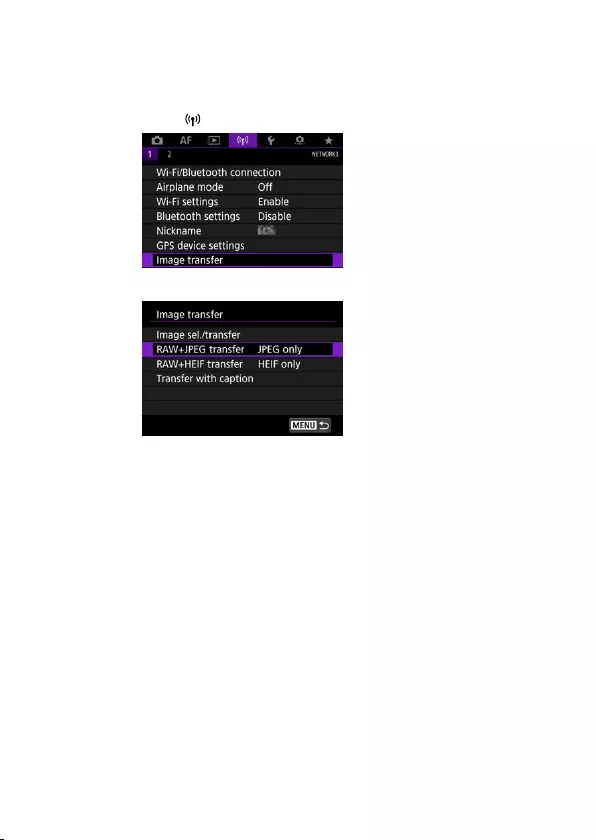
Transferring RAW+JPEG or RAW+HEIF images
For RAW+JPEG or RAW+HEIF images, you can specify which image to transfer.
1. Select [ : Image transfer].
2. Select the type of images to transfer.
667
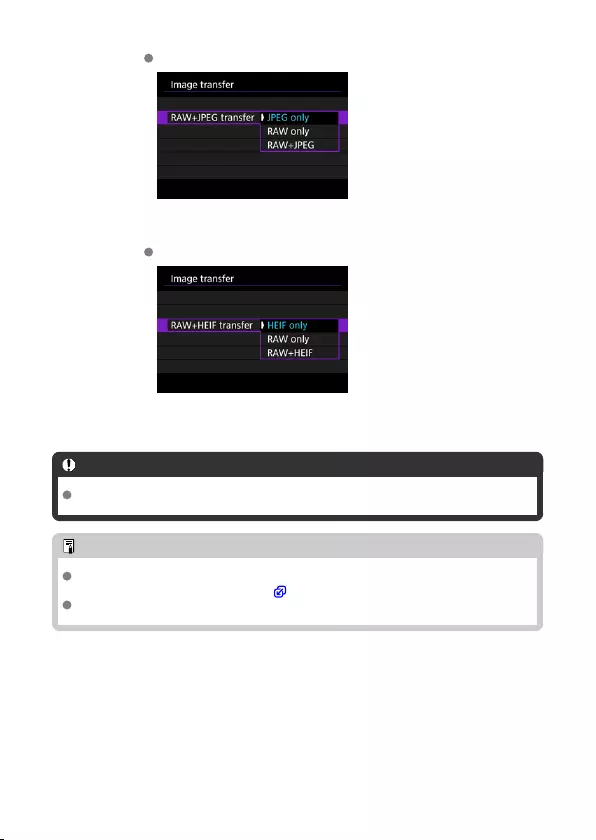
RAW+JPEG transfer
• Select [RAW+JPEG transfer], then select [JPEG only], [RAW
only], or [RAW+JPEG].
RAW+HEIF transfer
• Select [RAW+HEIF transfer], then select [HEIF only], [RAW only],
or [RAW+HEIF].
Caution
Some menu items are not available during image transfer.
Note
This setting is linked to [RAW+JPEG transfer] and [RAW+HEIF transfer] settings
on the [Transfer type/size] screen ( ).
Image transfer in progress is paused if you switch to movie mode.
668
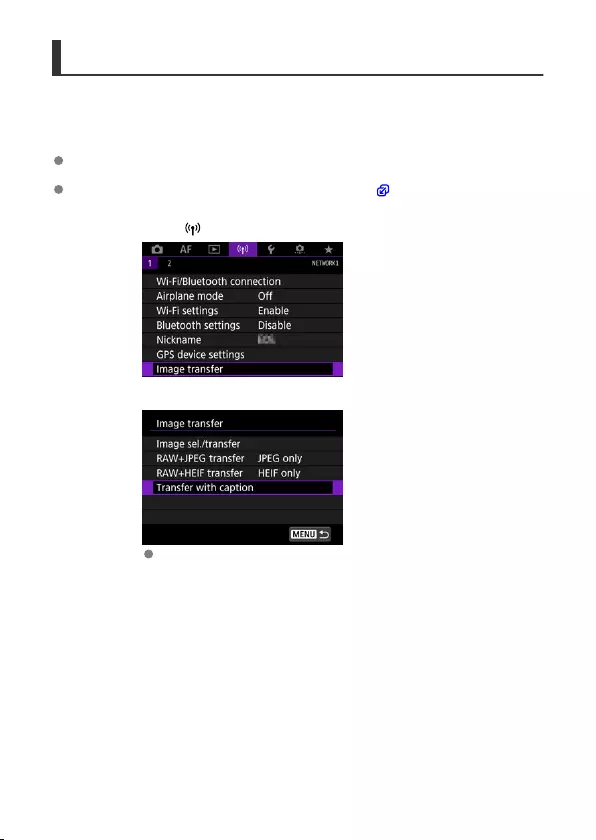
Adding a Caption Before Transfer
You can add a registered caption to each image before transfer. This is convenient if you
want to inform the recipient of the printing quantity, for example. Captions are also added to
images saved to the camera.
You can check captions added to images by examining the Exif information, in the user
comments.
Captions can be created and registered with EOS Utility ( ).
1. Select [ : Image transfer].
2. Select [Transfer with caption].
The last image viewed is displayed.
669
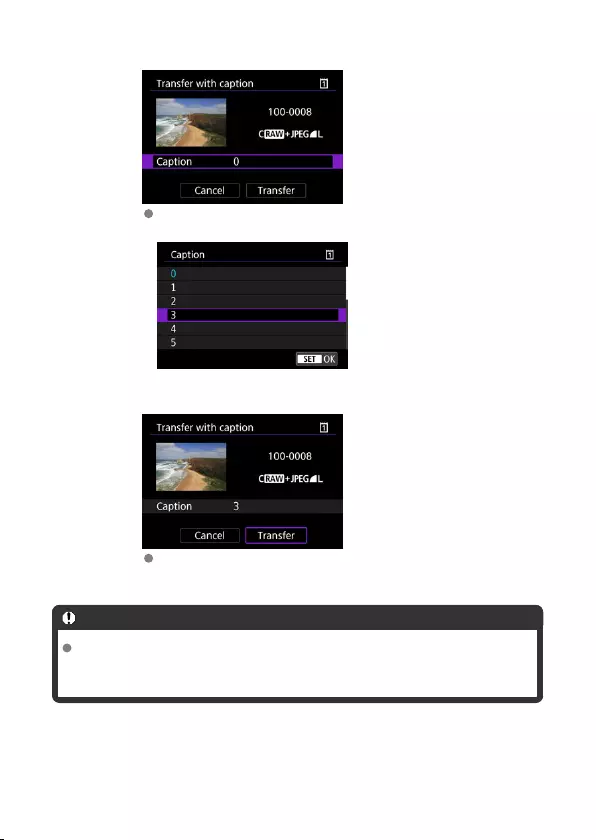
3. Specify the caption.
Select [Caption], and on the screen displayed, select the content of the
caption.
4. Select [Transfer].
The image is transferred with the caption. After transfer, display returns
to the [Image transfer] screen.
Caution
Other images cannot be selected from the [Transfer with caption] screen. To
select another image for transfer with a caption, view that image before following
these steps.
670
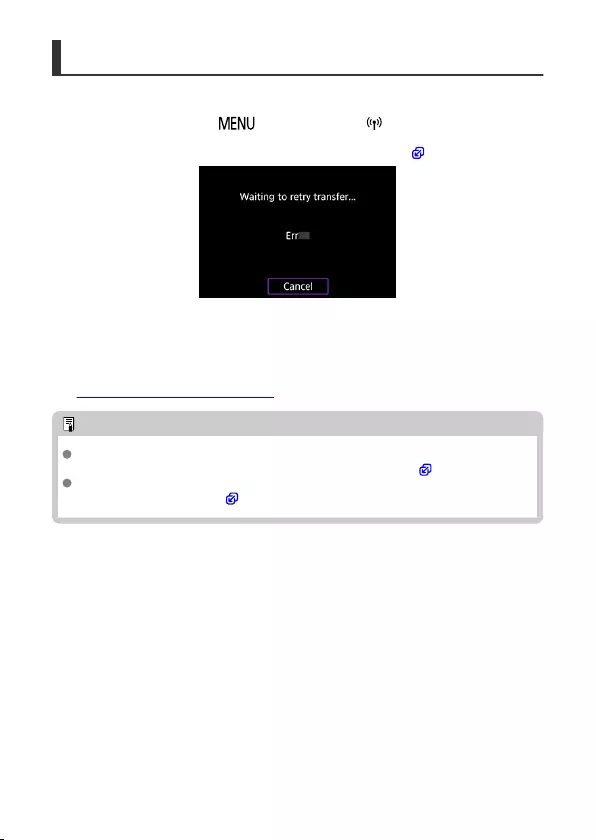
Auto Retry If Transfer Fails
If transfer fails, the camera’s access lamp blinks in red. In this case, the following screen is
displayed after you press the <> button and select [ : Wi-Fi/Bluetooth
connection].
To resolve the error displayed, see the troubleshooting information ( ).
Once you have resolved the issue, the images that could not be sent initially will be
transferred automatically. With this option activated, transfer is attempted again
automatically after failure, whether automatic transfer is used or captured images are
transferred manually via FTP. Note that if you cancel transfer or turn the camera off, auto
retry is not attempted.
See Transferring Multiple Images at Once and transfer images as needed.
Note
To automatically log off and end the Wi-Fi connection after transfer, you can
configure power-saving on the [FTP transfer settings] screen ( ).
If you prefer not to end the Wi-Fi connection, set [Power saving] on the [FTP
transfer settings] screen ( ) to [Disable].
671

Viewing Transferred Images
Images transferred to the FTP server are stored in the following folder as specified in the
FTP server settings.
Target folder of the FTP server
Under the default settings of the FTP server, images are stored in [C drive] → [Inetpub]
folder → [ftproot] folder, or in a subfolder of this folder.
If the root folder of the transfer destination has been changed in the FTP server settings,
ask the FTP server administrator where images are transferred.
672
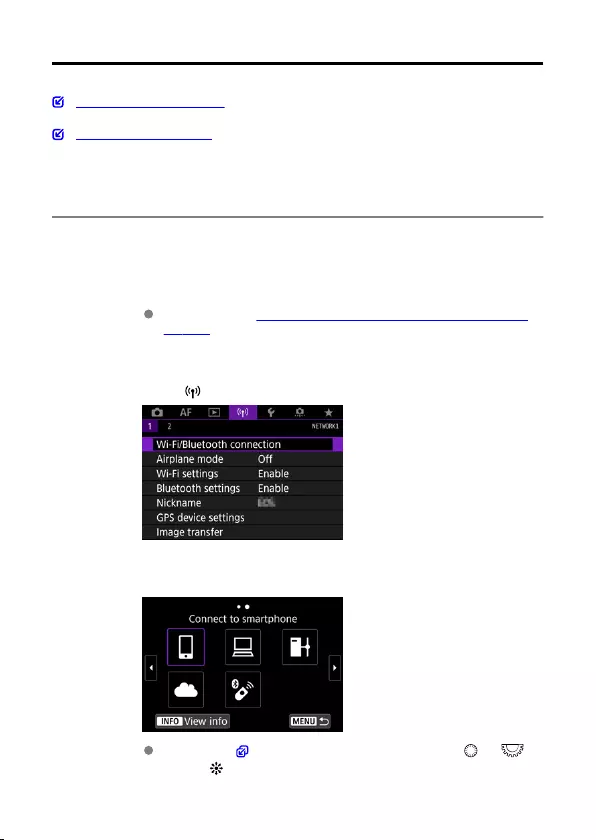
Wi-Fi Connection via Access Points
Camera Access Point Mode
Manual IP Address Setup
This section describes how to join a Wi-Fi network via an access point compatible with WPS
(PBC mode).
First, check the position of the WPS button and how long to press it. It may take approx. 1
min. to establish a Wi-Fi connection.
1. Set Wi-Fi settings to [Enable].
See steps 1–4 in Connecting to a Bluetooth-Compatible Smartphone
via Wi-Fi.
2. Select [ : Wi-Fi/Bluetooth connection].
3. Select an option.
If the history ( ) is displayed, switch screens with the < > < >
dial or < >.
673
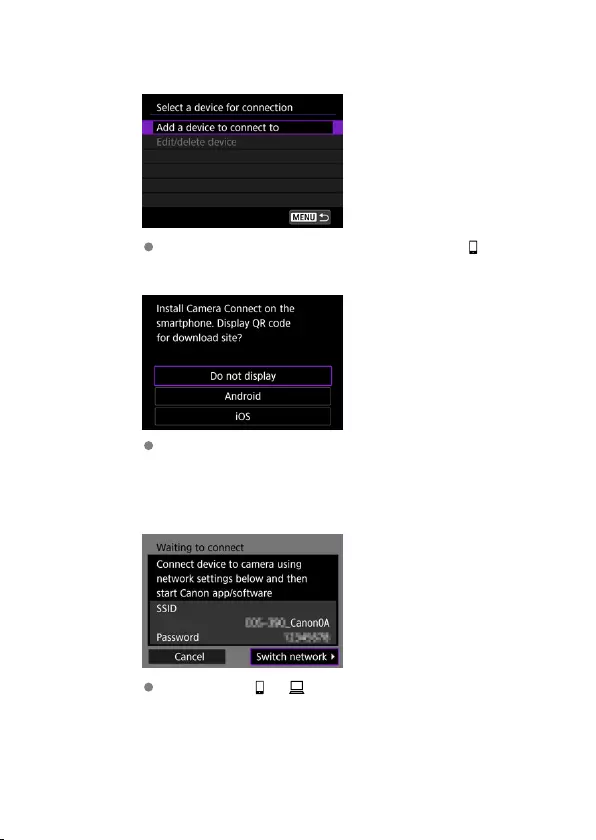
4. Select [Add a device to connect to].
The following message is displayed if you have selected [ Connect
to smartphone]. If Camera Connect is already installed, select [Do not
display].
On the [Connect to smartphone] screen displayed next, select
[Connect via Wi-Fi].
5. Select [Switch network].
Displayed when [ ] or [ ] is selected.
674

10. Specify the settings for the Wi-Fi function.
[ Connect to smartphone]
On the smartphone’s Wi-Fi setting screen, tap the SSID (network
name) shown on the camera screen, then enter the password of the
access point for the connection.
Go to step 8 in Wi-Fi Connection without Using Bluetooth.
[ Remote control (EOS Utility)]
Go to step 7 or 8 in Operating the Camera Using EOS Utility.
[ Transfer images to FTP server]
Go to step 10 in Connection via Access Points.
[ Upload to Web service]
Go to step 5 in Registering Image.Canon and Setting Up Auto Send.
677
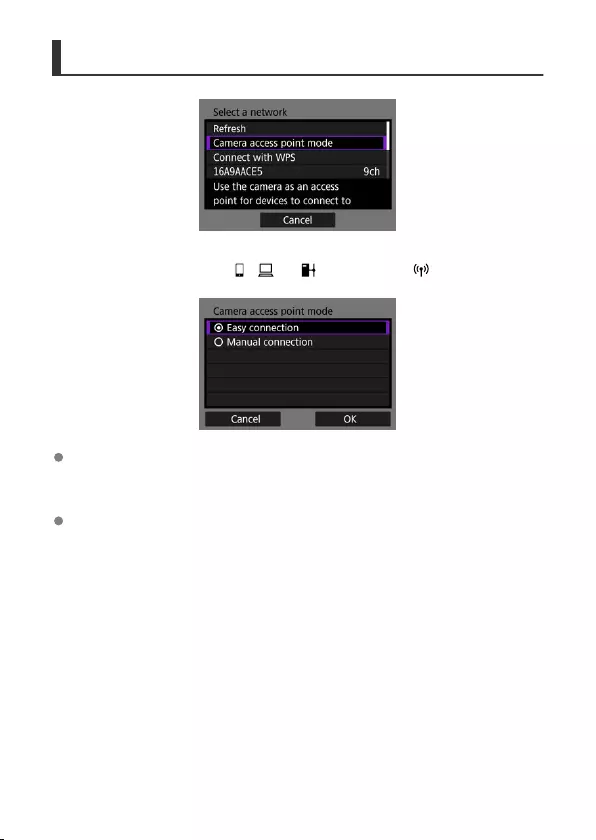
Camera Access Point Mode
Camera access point mode is a connection mode for connecting the camera directly to each
device via Wi-Fi. Displayed when [ ], [ ], or [ ] is selected after [ : Wi-Fi/Bluetooth
connection].
Easy connection
Use the other device to establish a Wi-Fi connection with the SSID shown on the
camera screen.
Manual connection
Enter the SSID of the other device to establish a connection. Follow the instructions on
the camera screen to complete the connection settings.
678

Manual IP Address Setup
The options displayed vary depending on the Wi-Fi function.
1. Select [Manual setting].
Select [OK].
2. Select an option.
Select an option to access the screen for numerical input.
To use a gateway, select [Enable], then select [Address].
679
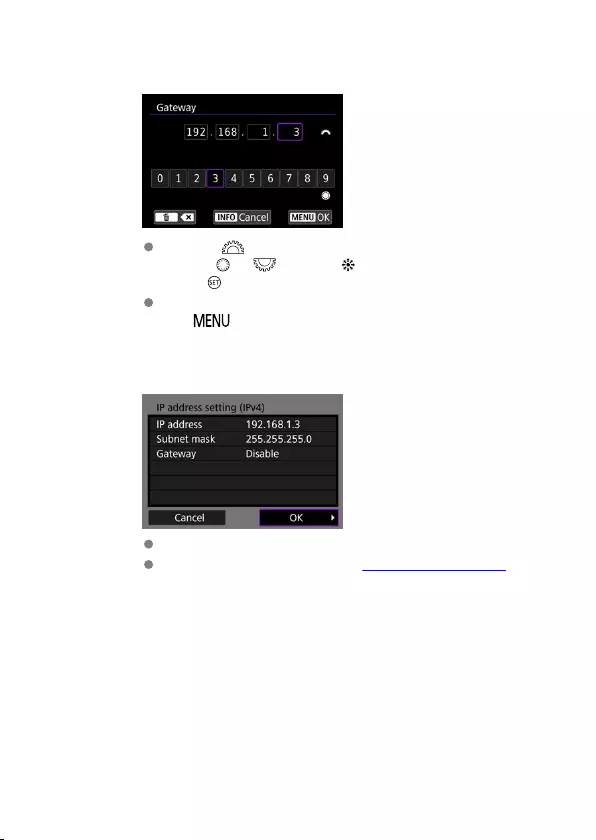
3. Enter the number.
Turn the < > dial to move the input position in the upper area, and
use the < > < > dials or < > to select numbers to enter.
Press < > to enter the selected number.
To set the entered numbers and return to the screen for step 2, press
the < > button.
4. Select [OK].
When you have completed setting the necessary items, select [OK].
If you are not sure what to enter, see Checking Network Settings, or
ask the network administrator or another person knowledgeable about
the network.
680
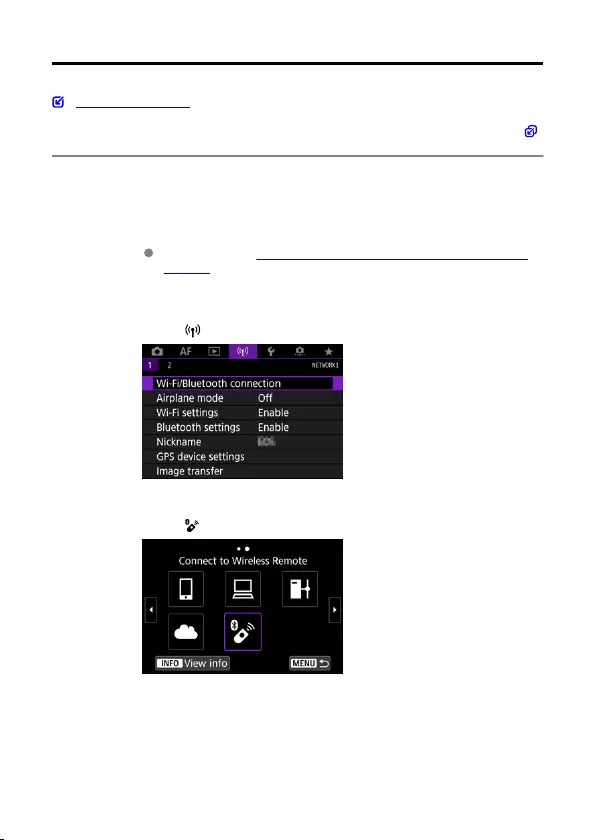
Connecting to a Wireless Remote Control
Canceling the Pairing
This camera can also be connected to Wireless Remote Control BR-E1 (sold separately, )
via Bluetooth for remote control shooting.
1. Set Wi-Fi settings to [Enable].
See steps 1–4 in Connecting to a Bluetooth-Compatible Smartphone
via Wi-Fi.
2. Select [ : Wi-Fi/Bluetooth connection].
3. Select [ Connect to Wireless Remote].
681
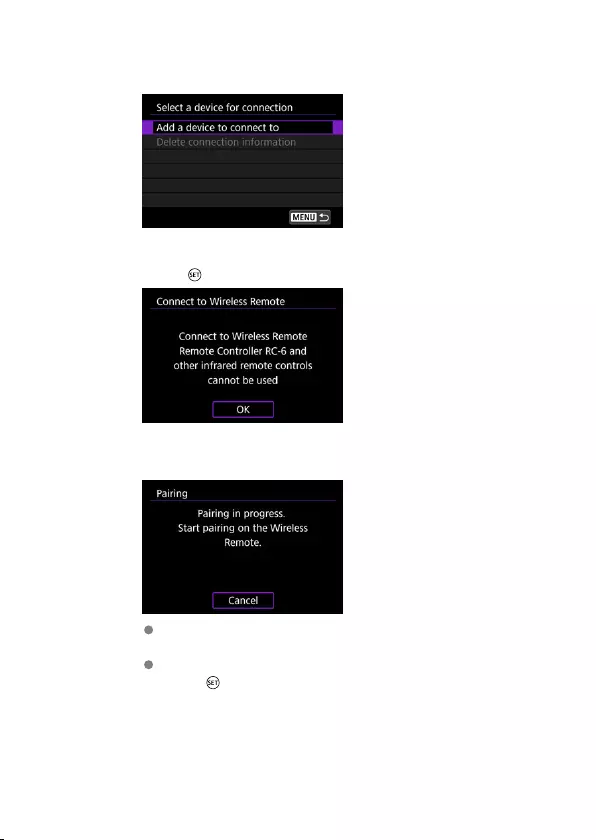
4. Select [Add a device to connect to].
5. Press < >.
6. Pair the devices.
When the [Pairing] screen appears, press and hold the <W> and <T>
buttons on the BR-E1 simultaneously for at least 3 sec.
After a message confirms that the camera is paired with the BR-E1,
press < >.
682
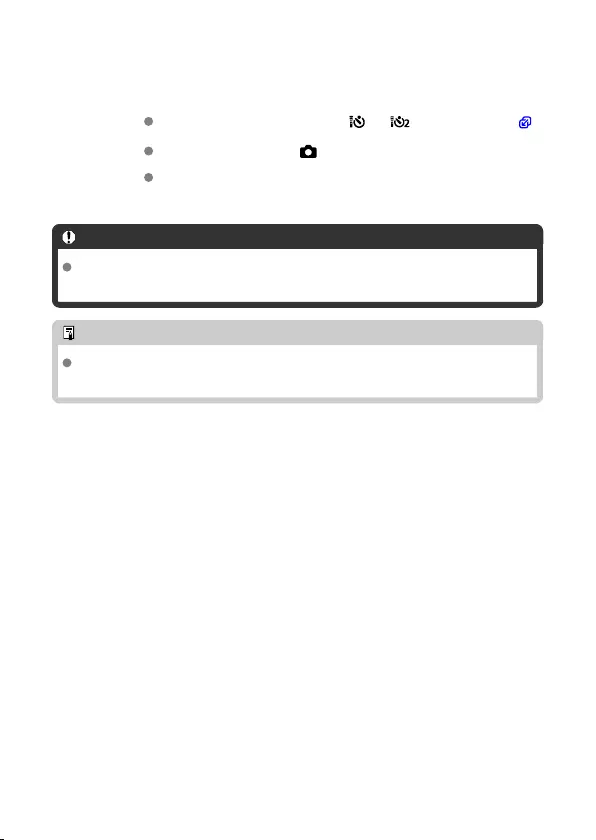
7. Set up the camera for remote shooting.
When shooting still photos, select [ ] or [ ] as the drive mode ( ).
For movie recording, set [ : Remote control] to [Enable].
For instructions after the pairing is complete, refer to the BR-E1’s
Instruction Manual.
Caution
Bluetooth connections consume battery power even after the camera’s auto power
off is activated.
Note
When you will not use Bluetooth, setting this function to [Disable] in step 1 is
recommended.
683

Canceling the Pairing
Before pairing with a different BR-E1, clear the information about the connected remote
control.
1. Select [ : Wi-Fi/Bluetooth connection].
2. Select [ Connect to Wireless Remote].
3. Select [Delete connection information].
684

4. Select [OK].
685
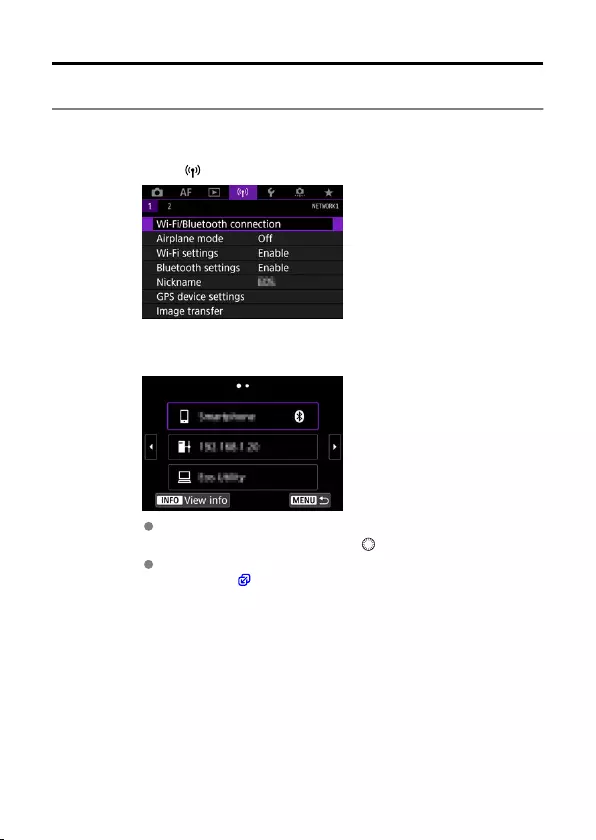
Reconnecting via Wi-Fi
Follow these steps to reconnect via Wi-Fi using registered connection settings.
1. Select [ : Wi-Fi/Bluetooth connection].
2. Select an option.
Select an option to connect to via Wi-Fi from the displayed history. If
the option is not displayed, use the <> dial to switch screens.
If [Connection history] is set to [Do not display], the history will not
be displayed ( ).
686

3. Operate the connected device.
[] Smartphone
Start Camera Connect.
If the smartphone’s connection destination has been changed, restore
the setting to connect via Wi-Fi to the camera or the same access point
as the camera.
When directly connecting the camera to a smartphone via Wi-Fi,
“_Canon0A” is displayed at the end of the SSID.
[] Computer
On the computer, start the EOS software.
If the computer’s connection destination has been changed, restore the
setting to connect via Wi-Fi to the camera or the camera’s access
point.
When directly connecting the camera to a computer via Wi-Fi,
“_Canon0A” is displayed at the end of the SSID.
[] FTP transfer
If the FTP server’s settings were changed to connect to other devices,
restore the settings to connect via Wi-Fi to the camera or the camera’s
access point.
When the camera is directly connected to an FTP server via Wi-Fi,
“_Canon0A” is displayed at the end of the SSID.
687
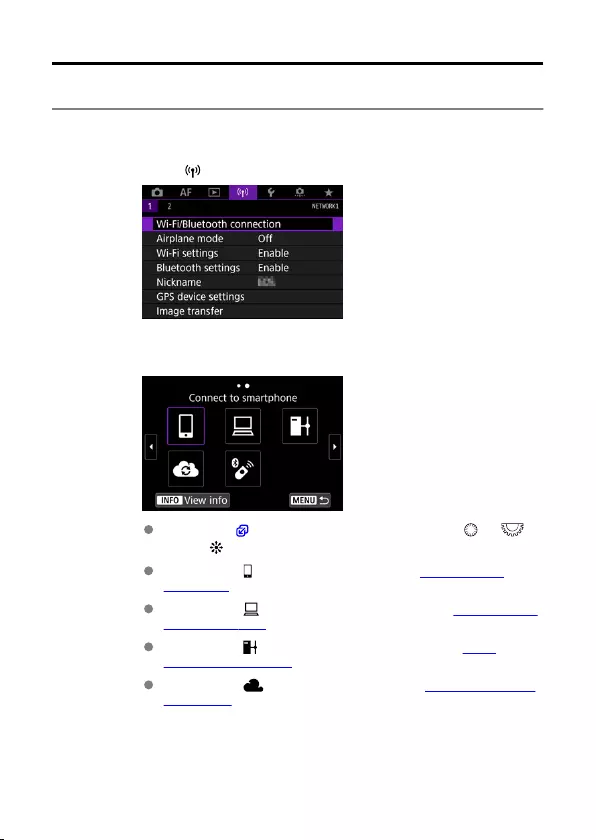
Registering Multiple Connection Settings
You can register up to 10 connection settings for the wireless communication functions.
1. Select [ : Wi-Fi/Bluetooth connection].
2. Select an option.
If the history ( ) is displayed, switch screens with the < > < >
dial or <>.
For details on [ Connect to smartphone], see Connecting to a
Smartphone.
For details on [ Remote control (EOS Utility)], see Connecting to a
Computer via Wi-Fi.
For details on [ Transfer images to FTP server], see Image
Transfer to FTP Servers.
For details on [ Upload to Web service], see Sending Images to a
Web Service.
688
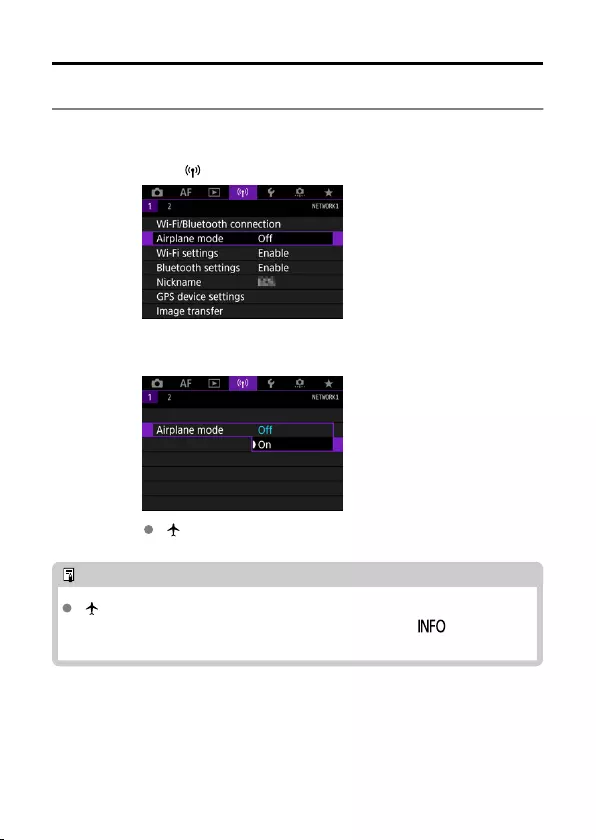
Airplane Mode
You can temporarily disable Wi-Fi and Bluetooth functions.
1. Select [ : Airplane mode].
2. Set to [On].
[ ] is displayed on the screen.
Note
[ ] may not be displayed in still photo shooting, movie recording, or playback,
depending on display settings. If it is not displayed, press the <> button
repeatedly to access detailed information display.
690
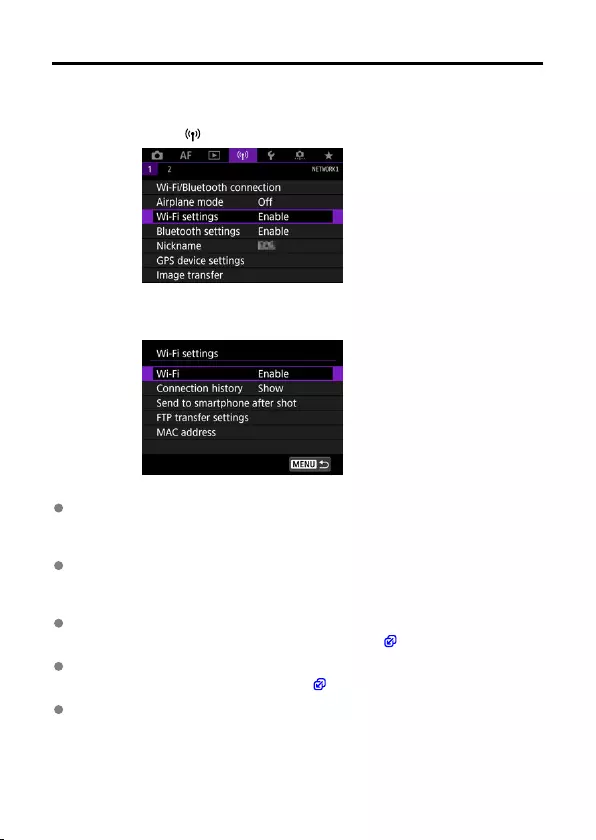
Wi-Fi Settings
1. Select [ : Wi-Fi settings].
2. Select an option.
Wi-Fi
When the use of electronic devices and wireless devices is prohibited, such as on board
airplanes or in hospitals, set it to [Disable].
Connection history
You can set the connection history for devices connected via Wi-Fi to [Show] or [Do not
display].
Send to smartphone after shot
Images can be transferred to a smartphone automatically ( ).
FTP transfer settings
Images can be transferred to an FTP server ( ).
MAC address
You can check the MAC address of the camera.
691
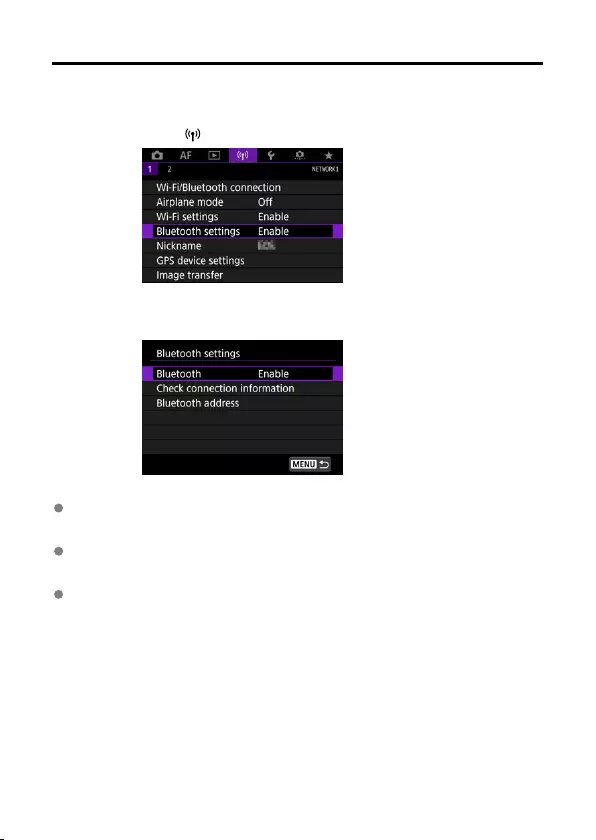
Bluetooth Settings
1. Select [ : Bluetooth settings].
2. Select an option.
Bluetooth
If you will not use the Bluetooth function, select [Disable].
Check connection information
You can check the name and communication status of the paired device.
Bluetooth address
You can check the camera’s Bluetooth address.
692
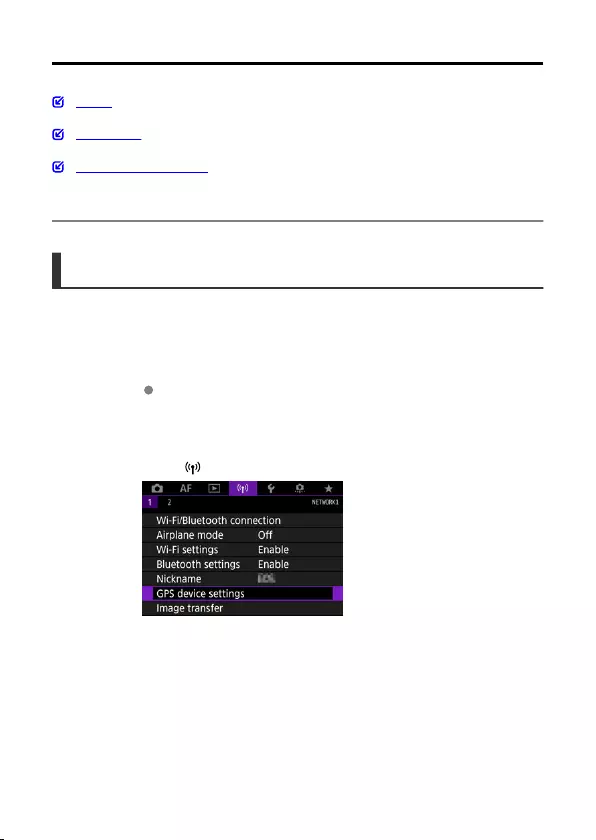
GPS Device Settings
GP-E2
Smartphone
GPS Connection Display
You can geotag images with GPS Receiver GP-E2 (sold separately) or a Bluetooth-
compatible smartphone.
GP-E2
1. Attach GP-E2 to the camera.
Attach GP-E2 to the camera’s hot shoe and turn it on. For details, refer
to the GP-E2 Instruction Manual.
2. Select [ : GPS device settings].
694
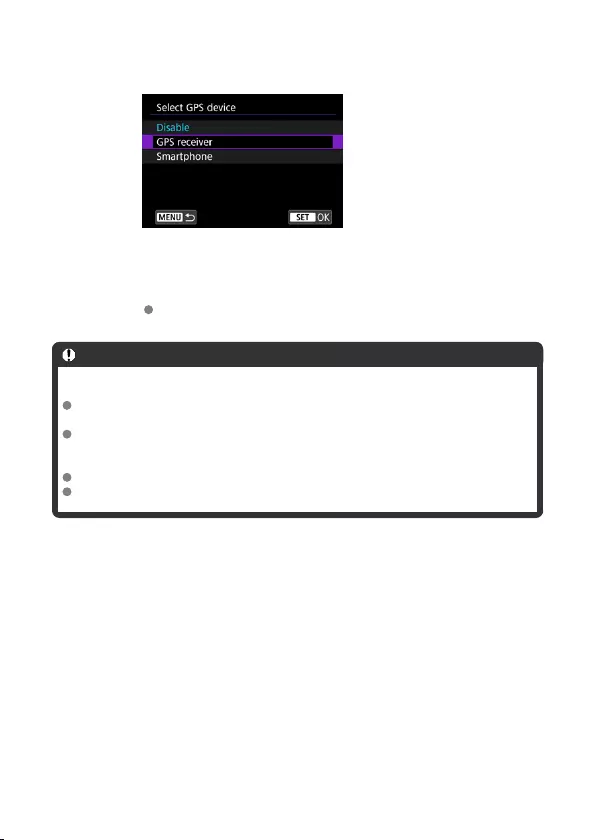
3. In [Select GPS device], select [GPS receiver].
4. Take the picture.
For details on [Set up], refer to the GP-E2 Instruction Manual.
Caution
Precautions when using GP-E2
Before use, check the countries and regions where use of GPS is allowed, and
follow local regulations.
Update the GP-E2 firmware to Ver. 2.0.0 or later.
Firmware updating requires an interface cable. For updating instructions, visit the
Canon website.
GP-E2 cannot be connected to the camera with a cable.
The camera does not record the shooting direction.
695
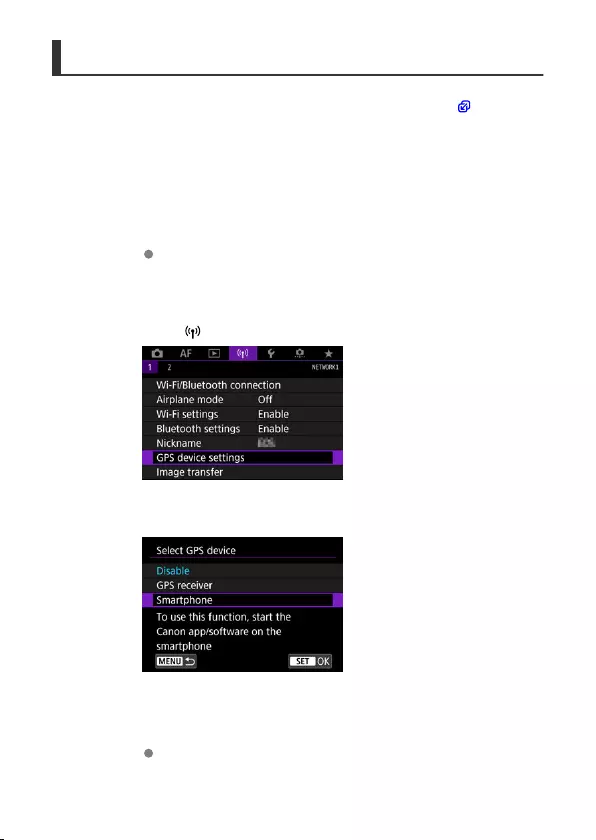
Smartphone
Complete these settings after installing the dedicated Camera Connect app ( ) on the
smartphone.
1. On the smartphone, activate location services.
2. Establish a Bluetooth connection.
Start Camera Connect and pair the camera and smartphone via
Bluetooth.
3. Select [ : GPS device settings].
4. In [Select GPS device], select [Smartphone].
5. Take the picture.
Images are geotagged with the information from the smartphone.
696
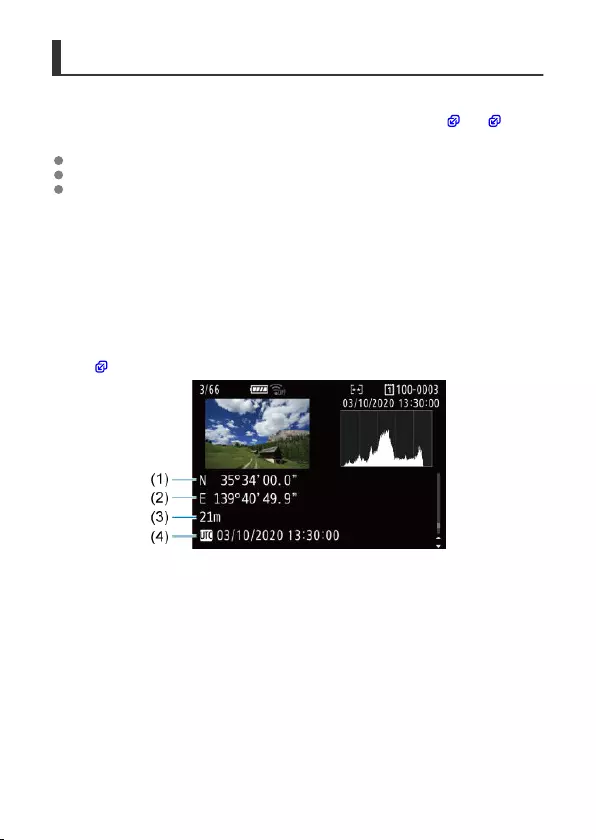
GPS Connection Display
You can check the status of smartphone location information acquisition in the GPS
connection icon on the screens for still photo shooting or movie recording ( and ,
respectively).
Gray: Location services are off
Blinking: Location information cannot be acquired
On: Location information acquired
For details on how GPS connection status is indicated when GP-E2 is used, refer to the
GP-E2 Instruction Manual.
Geotagging images as you shoot
Images you shoot while the GPS icon is on are geotagged.
Geotagging information
You can check the location information added to your shots on the shooting information
screen ( ).
(1) Latitude
(2) Longitude
(3) Elevation
(4) UTC (Coordinated Universal Time)
697
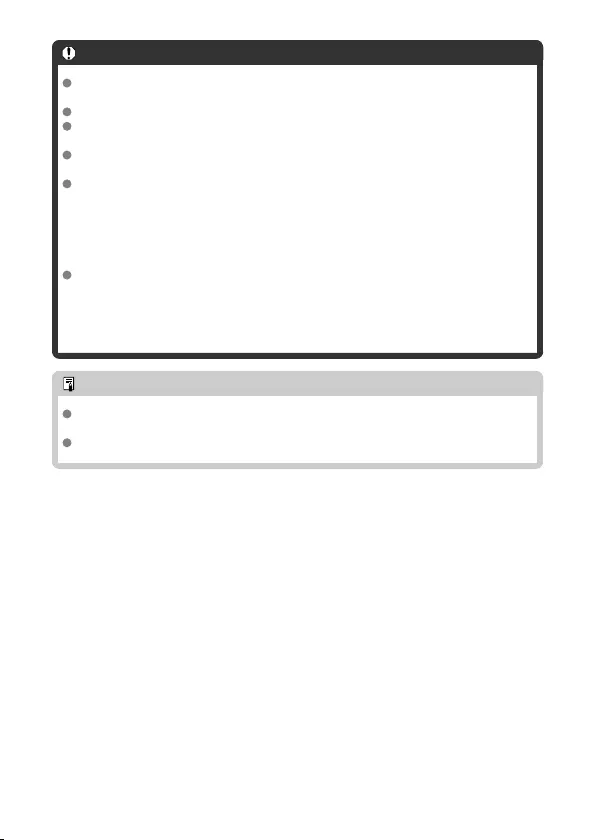
Caution
The smartphone can acquire location information only while it is paired with the
camera via Bluetooth.
Direction information is not acquired.
Acquired location information may not be accurate, depending on traveling
conditions or smartphone status.
It may take some time to acquire location information from the smartphone after
you turn the camera on.
Location information is no longer acquired after any of the following operations.
• Pairing with a wireless remote control via Bluetooth
• Turning the camera off
• Quitting Camera Connect
• Deactivating location services on the smartphone
Location information is no longer acquired in any of the following situations.
• The camera power turns off
• The Bluetooth connection is ended
• The smartphone’s remaining battery level is low
Note
Coordinated Universal Time, abbreviated as UTC, is essentially the same as
Greenwich Mean Time.
For movies, the GPS information initially acquired is added.
698
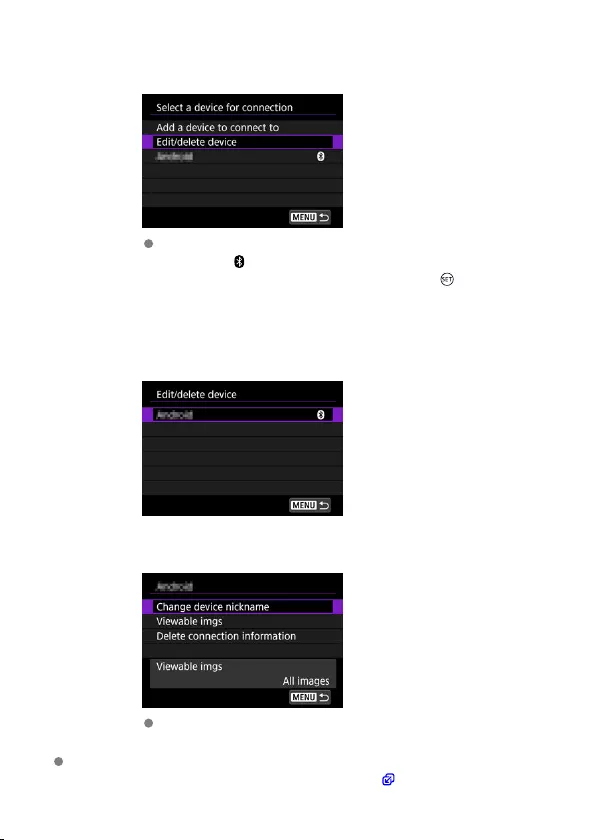
3. Select [Edit/delete device].
You can change the Bluetooth connection by selecting a smartphone
labeled with [ ] in gray. After the [Connect to smartphone] screen is
displayed, select [Pair via Bluetooth], then press < > on the next
screen.
4. Select the device for which to change or delete the connection
settings.
5. Select an option.
Change or delete the connection settings on the displayed screen.
Change device nickname
You can change the nickname using the virtual keyboard ( ).
700

Resetting Communication Settings
All wireless communication settings can be deleted. By deleting the wireless communication
settings, you can prevent their information from being exposed when you lend or give your
camera to other people.
1. Select [ : Reset communication settings].
2. Select [OK].
Caution
If you have paired the camera with a smartphone, on the smartphone’s Bluetooth
settings screen, delete the connection information of the camera for which you
restored default wireless communication settings.
Note
All wireless communication settings can be cleared by selecting the
[Communication settings] option for [Other settings] in [ : Reset camera].
702
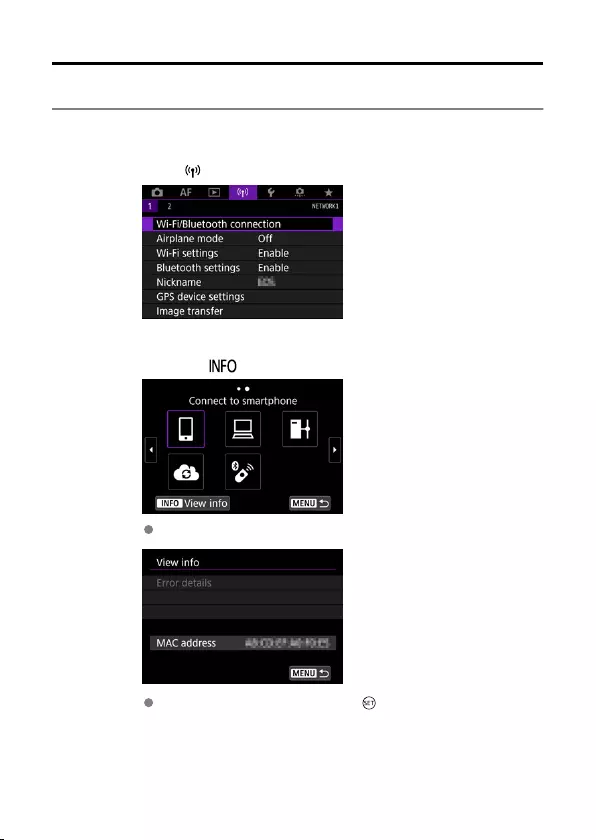
View Info Screen
You can check error details and the camera’s MAC address.
1. Select [ : Wi-Fi/Bluetooth connection].
2. Press the < > button.
The [View info] screen will appear.
When an error has occurred, press < > to display the error content.
703
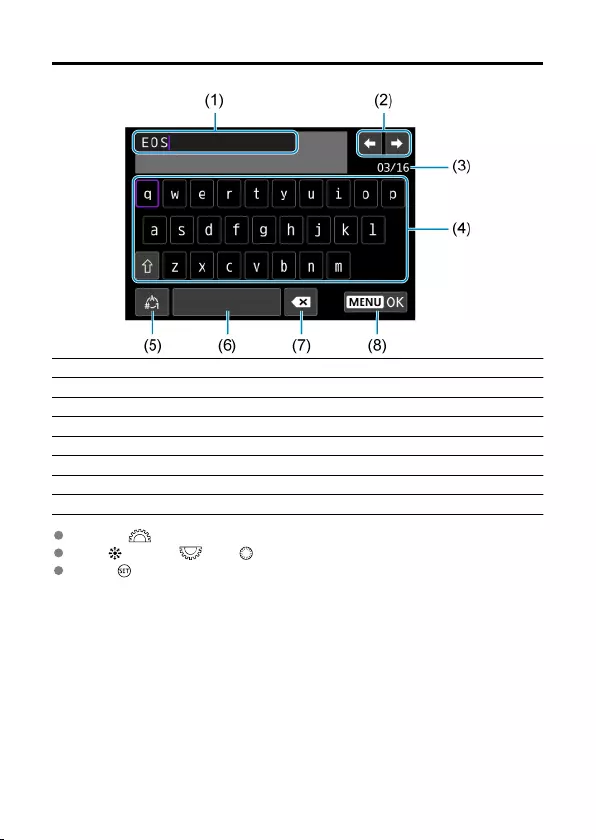
Virtual Keyboard Operations
(1) Input area, for entering text
(2) Cursor keys, for moving in the input area
(3) Current no. of characters/no. available
(4) Keyboard
(5) Switch input modes
(6) Space
(7) Delete a character in the input area
(8) Exit input
Use the < > dial to move within (1).
Use < > or the < > or < > dial to move within (2) and (4)–(7).
Press < > to confirm input or when switching input modes.
704
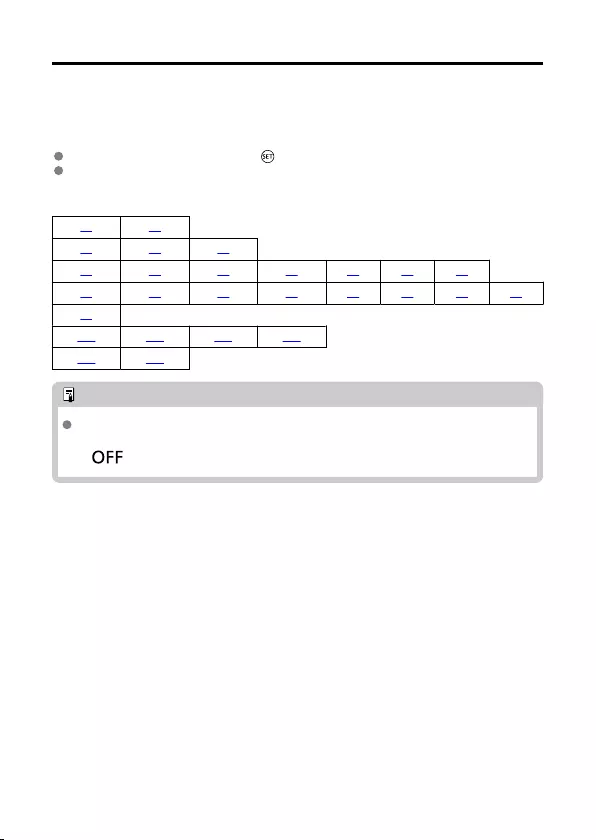
Responding to Error Messages
When an error occurs, display the details of the error by following one of the procedures
below. Then, eliminate the cause of the error by referring to the examples shown in this
chapter.
On the [View info] screen, press < >.
Select [Error details] on the [Wi-Fi on].
Click the following error numbers to jump to the corresponding section.
11 12
21 22 23
41 43 44 45 46 47 48
61 63 64 65 66 67 68 69
91
121 125 126 127
151 152
Note
When an error occurs, [Err**] is displayed in the upper right of the [Wi-Fi/
Bluetooth connection] screen. It disappears when the camera’s power is set to
< >.
705

11: Connection target not found
In the case of [ ], is Camera Connect running?
• Establish a connection using Camera Connect ( ).
In the case of [ ], is EOS Utility running?
• Start EOS Utility and try to connect again ( ).
Are the camera and the access point set to use the same encryption key for
authentication?
• This error occurs if the encryption keys do not match when the authentication
method for encryption is [Open system].
Check upper- and lower-case letters, and make sure the correct encryption key for
authentication is set on the camera ( ).
12: Connection target not found
Are the target device and access point turned on?
• Turn on the target device and access point, then wait a while. If a connection still
cannot be established, perform the procedures to establish the connection again.
706

21: No address assigned by DHCP server
What to check on the camera
On the camera, IP address is set to [Auto setting]. Is this the correct setting?
• If no DHCP server is used, specify the settings after setting the IP address to
[Manual setting] on the camera ( ).
What to check on the DHCP server
Is the power of the DHCP server on?
• Turn on the DHCP server.
Are there enough addresses for assignment by the DHCP server?
• Increase the number of addresses assigned by the DHCP server.
• Remove devices assigned addresses by the DHCP server from the network to
reduce the number of addresses in use.
Is the DHCP server working correctly?
• Check the DHCP server settings to make sure it is working correctly as a DHCP
server.
• If applicable, ask your network administrator to ensure the DHCP server is available.
707

22: No response from DNS server
What to check on the camera
On the camera, the DNS address is set to [Manual setting]. Is this the correct
setting?
• If no DNS server is used, set the camera’s DNS address setting to [Disable] ( ).
On the camera, does the DNS server’s IP address setting match the server’s
actual address?
• Configure the IP address on the camera to match the actual DNS server address
( , ).
What to check on the DNS server
Is the power of the DNS server on?
• Turn on the DNS server.
Are the DNS server settings for IP addresses and the corresponding names
correct?
• On the DNS server, make sure IP addresses and the corresponding names are
entered correctly.
Is the DNS server working correctly?
• Check the DNS server settings to make sure it is working correctly as a DNS server.
• If applicable, ask your network administrator to ensure the DNS server is available.
What to check on the network as a whole
Does your network include a router or similar device that serves as a gateway?
• If applicable, ask your network administrator for the network gateway address and
set it on the camera ( , ).
• Make sure that the gateway address setting is correctly entered on all network
devices including the camera.
708

23: Device with same IP address exists on selected network
Is another device on the camera network using the same IP address as the
camera?
• Change the camera’s IP address to avoid using the same address as another
device on the network. Otherwise, change the IP address of the device that has a
duplicate address.
• If the camera’s IP address is set to [Manual setting] in network environments using
a DHCP server, change the setting to [Auto setting] ( ).
Note
Responding to error messages 21–23
Also check the following points when responding to errors numbered 21–23.
Are the camera and the access point set to use the same password for
authentication?
• This error occurs if the passwords do not match when the authentication
method for encryption is set to [Open system]. Check upper- and lower-case
letters, and make sure the correct password for authentication is set on the
camera ( ).
709
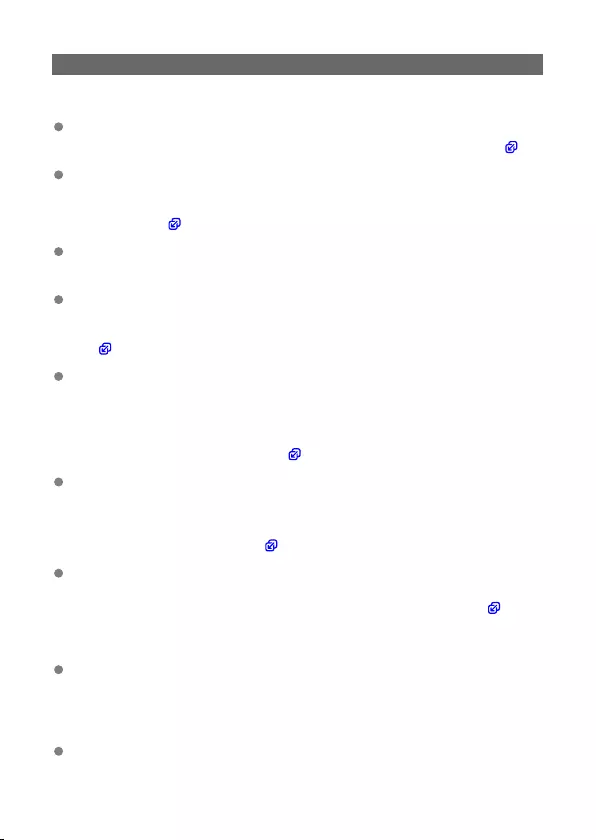
41: Cannot connect to FTP server
What to check on the camera
The camera’s proxy server setting is [Enable]. Is this the correct setting?
• If no proxy server is used, set the camera’s proxy server setting to [Disable] ( ).
Do the camera’s [Address setting] and [Port No.] settings match those of the
proxy server?
• Configure the camera’s proxy server address and port number to match those of the
proxy server ( ).
Are the camera’s proxy server settings correctly set on the DNS server?
• Make sure the proxy server’s [Address] is correctly set on the DNS server.
On the camera, does the FTP server’s IP address setting match the server’s actual
address?
• Configure the IP address on the camera to match the actual FTP server address
( ).
Are the camera and the access point set to use the same encryption key for
authentication?
• This error occurs if the encryption keys do not match when the authentication
method for encryption is [Open system].
Check upper- and lower-case letters, and make sure the correct encryption key for
authentication is set on the camera ( ).
On the camera, does the [Port number setting] for the FTP server match the actual
port number of the FTP server?
• Configure the same port number (usually 21 for FTP/FTPS or 22 for SFTP) on the
camera and FTP server. Configure the port number on the camera to match the
actual FTP server port number ( ).
Are the camera’s FTP server settings correctly set on the DNS server?
• Make sure the FTP server’s [Server name] is correctly set on the DNS server. Make
sure the [Server name] for the FTP server is correctly set on the camera ( ).
What to check on the FTP server
Is the FTP server working correctly?
• Configure the computer correctly to function as an FTP server.
• If applicable, ask your network administrator for the FTP server address and port
number, then set them on the camera.
Is the FTP server on?
• Turn on the FTP server. The server may have been turned off because of an
energy-saving mode.
710

On the camera, does the FTP server’s IP address setting (in [Address]) match the
server’s actual address?
• Configure the IP address on the camera to match the actual FTP server address
( ).
Is a firewall or other security software enabled?
• Some security software uses a firewall to restrict access to the FTP server. Change
the firewall settings to allow access to the FTP server.
• You may be able to access the FTP server by setting [Passive mode] to [Enable]
on the camera ( ).
Are you connecting to the FTP server via a broadband router?
• Some broadband routers use a firewall to restrict access to the FTP server. Change
the firewall settings to allow access to the FTP server.
• You may be able to access the FTP server by setting [Passive mode] to [Enable]
on the camera ( ).
What to check on the proxy server
Is the proxy server on?
• Turn on the proxy server.
Is the proxy server working correctly?
• Check the proxy server settings to make sure the server is working correctly as a
proxy server.
• If applicable, ask your network administrator for the proxy server’s address setting
and port number, then set them on the camera.
What to check on the network as a whole
Does your network include a router or similar device that serves as a gateway?
• If applicable, ask your network administrator for the network gateway address and
set it on the camera ( , ).
• Make sure that the gateway address setting is correctly entered on all network
devices including the camera.
711

43: Cannot connect to FTP server. Error code received from server.
What to check on the proxy server
Is the proxy server on?
• Turn on the proxy server.
Is the proxy server working correctly?
• Check the proxy server settings to make sure the server is working correctly as a
proxy server.
• If applicable, ask your network administrator for the proxy server’s address setting
and port number, then set them on the camera.
What to check on the network as a whole
Does your network include a router or similar device that serves as a gateway?
• If applicable, ask your network administrator for the network gateway address and
set it on the camera ( , ).
• Make sure that the gateway address setting is correctly entered on all network
devices including the camera.
What to check on the FTP server
Have you exceeded the maximum number of FTP server connections?
• Disconnect some network devices from the FTP server or increase the maximum
number of connections.
44: Cannot disconnect FTP server. Error code received from server.
This error occurs from a failure to disconnect from the FTP server for some
reason.
• Restart the FTP server and camera.
712

45: Cannot login to FTP server. Error code received from server.
What to check on the camera
On the camera, is the [Login name] set correctly?
• Check the login name for accessing the FTP server. Check upper- and lower-case
letters, and make sure the correct login name is set on the camera ( ).
On the camera, is the [Login password] set correctly?
• Check upper- and lower-case letters, and make sure the correct login password is
set on the camera ( ).
What to check on the FTP server
Do the user rights for the FTP server allow reading, writing, and log access?
• Configure the FTP server's user rights to allow reading, writing, and log access.
Is the folder specified as the transfer destination on the FTP server named with
ASCII characters?
• Use ASCII characters for the folder name.
713

46: For the data session, error code received from FTP server
What to check on the FTP server
The connection was terminated by the FTP server.
• Restart the FTP server.
Do the user rights for the FTP server allow reading, writing, and log access?
• Configure the FTP server's user rights to allow reading, writing, and log access.
Do user rights allow access to the target folder on the FTP server?
• Configure the user rights for access to the target folder on the FTP server to allow
saving images from the camera.
Is the FTP server on?
• Turn on the FTP server. The server may have been turned off because of an
energy-saving mode.
Is the hard disk of the FTP server full?
• Increase available space on the hard disk.
47: Image file transfer completion not confirmed by FTP server
This error occurs from a failure to receive confirmation from the FTP server that
image file transfer is complete for some reason.
• Restart the FTP server and camera and send the images again.
48: Security of the connection to the target server cannot be verified.
If you trust this server and connect, set [Trust target server] to
[Enable].
This error occurs from a failure to confirm security of the target server connection
when connecting via FTPS.
• Confirm that the certificate is set correctly.
• Change [Trust target server] to [Enable] if you prefer to trust target servers
regardless of certificate settings.
714
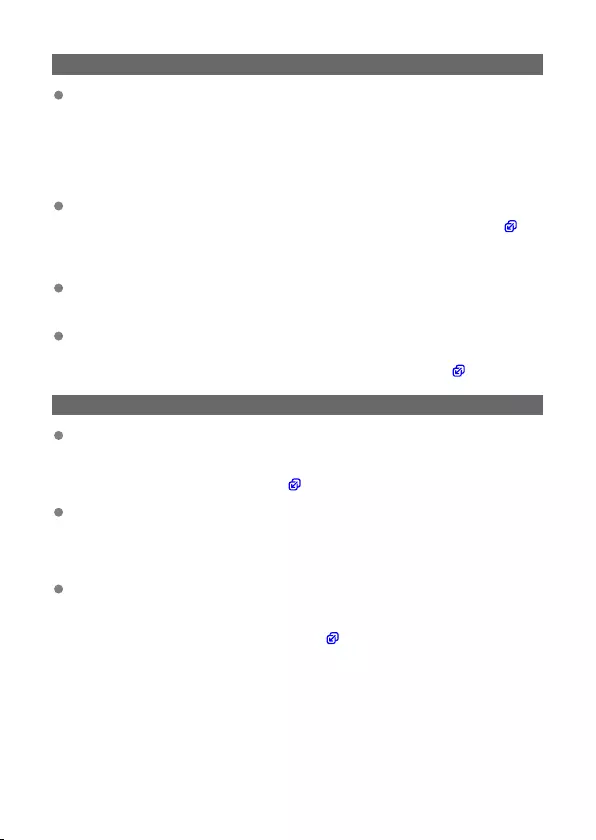
61: Selected SSID wireless LAN network not found
Are any obstacles blocking the line of sight between the camera and the antenna
of the access point?
• Move the antenna of the access point to a position clearly visible from the point of
view of the camera.
What to check on the camera
Does the SSID set on the camera match that of the access point?
• Check the SSID at the access point, then set the same SSID on the camera ( ).
What to check at the access point
Is the access point turned on?
• Turn on the power of the access point.
If filtering by MAC address is active, is the MAC address of the camera in use
registered at the access point?
• Register the MAC address of the camera used to the access point ( ).
63: Wireless LAN authentication failed
Are the camera and the access point set to use the same encryption key for
authentication?
• Check upper- and lower-case letters, and make sure the correct encryption key for
authentication is set on the camera ( ).
Are the camera and the access point set to use the same password for
authentication?
• Check upper- and lower-case letters, and make sure the correct password for
authentication is set on the camera.
If filtering by MAC address is active, is the MAC address of the camera in use
registered at the access point?
• Register the MAC address of the camera at the access point. The MAC address can
be checked on the [MAC address] screen ( ).
715

64: Cannot connect to wireless LAN terminal
Are the camera and the access point set to use the same encryption method?
• The camera supports the following encryption methods: WEP, TKIP, and AES ( ).
If filtering by MAC address is active, is the MAC address of the camera in use
registered at the access point?
• Register the MAC address of the camera used to the access point. The MAC
address can be checked on the [MAC address] screen ( ).
65: Wireless LAN connection lost
Are any obstacles blocking the line of sight between the camera and the antenna
of the access point?
• Move the antenna of the access point to a position clearly visible from the point of
view of the camera.
The wireless LAN connection was lost, for some reason, and the connection
cannot be restored.
• The following are possible reasons: excessive access to the access point from
another device, a microwave oven or similar appliance in use nearby (interfering
with IEEE 802.11n/g/b (2.4 GHz band)), or influence of rain or high humidity.
66: Incorrect wireless LAN password
Are the camera and the access point set to use the same encryption key for
authentication?
• Check upper- and lower-case letters, and make sure the correct encryption key for
authentication is set on the camera and access point ( ).
Note that if the encryption authentication method is [Open system], an Error 41 is
displayed ( ).
67: Incorrect wireless LAN encryption method
Are the camera and the access point set to use the same encryption method?
• The camera supports the following encryption methods: WEP, TKIP, and AES ( ).
If filtering by MAC address is active, is the MAC address of the camera in use
registered at the access point?
• Register the MAC address of the camera used to the access point. The MAC
address can be checked on the [MAC address] screen ( ).
716

68: Cannot connect to wireless LAN terminal. Retry from the
beginning.
Did you hold down the access point’s WPS (Wi-Fi Protected Setup) button for the
specified period of time?
• Hold down the WPS button for the period of time specified in the access point’s
instruction manual.
Are you trying to establish a connection near the access point?
• Try establishing the connection when both devices are within reach of each other.
69: Multiple wireless LAN terminals have been found. Cannot
connect. Retry from the beginning.
Connection is in progress by other access points in Pushbutton Connection
mode (PBC mode) of WPS (Wi-Fi Protected Setup).
• Wait a while before trying to establish the connection.
91: Other error
A problem other than error code number 11 to 83 occurred.
• Turn the camera’s power switch off and on.
121: Not enough free space on server
The target Web server does not have enough free space.
• Delete unnecessary images on the Web server, check the free space on the Web
server, then try sending the data again.
125: Check the network settings
Is the network connected?
• Check the connection status of the network.
126: Could not connect to server
image.canon is under maintenance or temporarily busy.
• Try accessing the service again later.
717

127: An error has occurred
A problem other than error code number 121 to 126 occurred while the camera is
connected to the Web service.
• Try again to establish the Wi-Fi connection to image.canon.
151: Transmission canceled
Automatic image transfer was somehow interrupted.
• To resume automatic image transfer, set the camera’s power switch to < >,
and then set it to < >.
152: Card's write protect switch is set to lock
Is the card’s write-protect switch set to the locked position?
• Slide the card’s write-protect switch to the writing position.
718

Wireless Communication Function Precautions
If the transmission rate drops, the connection is lost, or other problems occur when using the
wireless communication functions, try the following corrective actions.
Distance between the camera and the smartphone
If the camera is too far from the smartphone, a Wi-Fi connection may not be established
even when Bluetooth connection is possible. In this case, bring the camera and the
smartphone closer together, then establish a Wi-Fi connection.
Installation location of access point antenna
When using indoors, install the device in the room where you are using the camera.
Install the device where people or objects do not come between the device and the
camera.
Nearby electronic devices
If the Wi-Fi transmission rate drops because of the influence of the following electronic
devices, stop using them or move further away from the devices to transmit communication.
The camera communicates over Wi-Fi via IEEE 802.11b/g/n using radio waves in the
2.4 GHz band. For this reason, the Wi-Fi transmission rate will drop if there are
Bluetooth devices, microwave ovens, cordless telephones, microphones, smartphones,
other cameras, or similar devices operating on the same frequency band nearby.
Precautions for using multiple cameras
When connecting multiple cameras to one access point via Wi-Fi, make sure the
cameras’ IP addresses are different.
When multiple cameras are connected to one access point via Wi-Fi, the transmission
rate drops.
When there are multiple IEEE 802.11b/g/n (2.4 GHz band) access points, leave a gap of
five channels between each Wi-Fi channel to reduce radio wave interference. For
example, use channels 1, 6, and 11, channels 2 and 7, or channels 3 and 8.
Using wireless remote control BR-E1
BR-E1 cannot be used while the camera and smartphone are paired via Bluetooth.
Change the camera connection to the wireless remote control in [Connect to Wireless
Remote] under [ : Wi-Fi/Bluetooth connection].
719

Security
If security settings have not been properly set, the following problems may occur.
Transmission monitoring
Third parties with malicious intent may monitor wireless LAN transmissions and attempt
to acquire the data you are sending.
Unauthorized network access
Third parties with malicious intent may gain unauthorized access to the network you are
using to steal, modify, or destroy information. Additionally, you could fall victim to other
types of unauthorized access such as impersonation (where someone assumes an
identity to gain access to unauthorized information) or springboard attacks (where
someone gains unauthorized access to your network as a springboard to cover their
tracks when infiltrating other systems).
It is recommended to make use of the systems and functions to thoroughly secure your
network, preventing these types of problems from occurring.
720

Checking Network Settings
Windows
Open the Windows [Command Prompt], then enter ipconfig/all and press the <Enter> key.
In addition to the IP address assigned to the computer, the subnet mask, gateway, and DNS
server information are also displayed.
macOS
In macOS, open the [Terminal] application, enter ifconfig -a, and press the <Return> key.
The IP address assigned to the computer is indicated in the [enX] item (X: number) next to
[inet], in the format “***.***.***.***”.
For information about the [Terminal] application, refer to the macOS help.
To avoid using the same IP address for the computer and other devices on the network,
change the rightmost number when configuring the IP address assigned to the camera in
the processes described in Manual IP Address Setup.
Example: 192.168.1.10
721
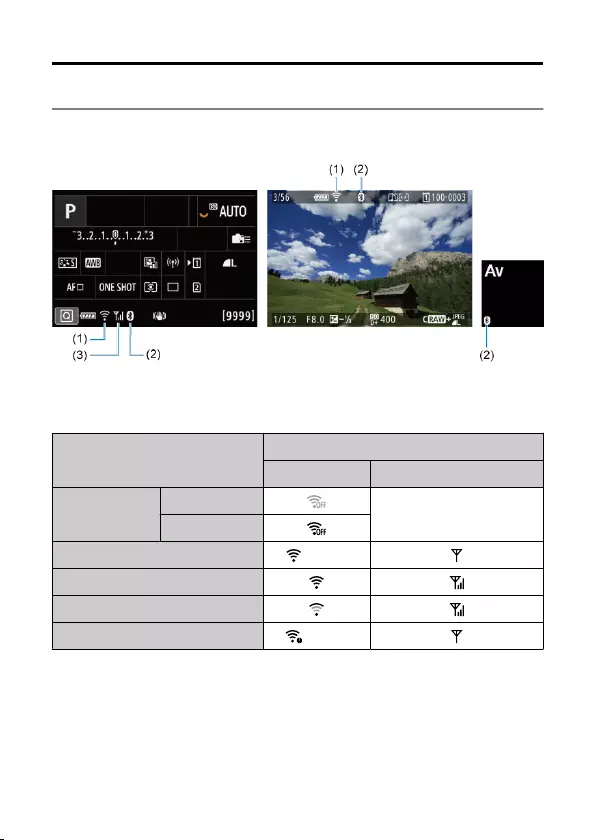
Wireless Communication Status
Wireless communication status can be checked on the screen.
Quick Control screen
Information display screen during playback
(1) Wi-Fi function
(2) Bluetooth function
(3) Wireless signal strength
Communication Status
Screen
Wi-Fi Function Wireless Signal Strength
Not connected
Wi-Fi: Disable
Off
Wi-Fi: Enable
Connecting (Blinking)
Connected
Sending data
Connection error (Blinking)
722

Bluetooth Function Indicator
Bluetooth Function Connection Status Screen
Other than [Disable]
Bluetooth connected
Bluetooth not connected
[Disable] Bluetooth not connected Not displayed
723

Set-up
This chapter describes menu settings on the set-up ([ ]) tab.
to the right of titles indicates functions only available in [ ], [ ], [ ], [ ], [ ], or
[ ] mode.
•Tab Menus: Set-up
•Selecting Cards for Recording/Playback
•Folder Settings
•File Numbering
•File Naming
•Formatting
•Auto Rotate
•Adding Orientation Information to Movies
•Date/Time/Zone
•Language
•Video System
•Help
•Beeps
•Headphone Volume
•Power Saving
•Eco Mode
•Screen/Viewfinder Display
•Screen Brightness
•Viewfinder Brightness
•Screen and Viewfinder Color Tone
•Fine-Tuning Viewfinder Color Tone
•UI Magnification
•HDMI Resolution
•Touch Control
•Multi-Function Lock
•Shutter at Shutdown
•Sensor Cleaning
•Resetting the Camera
•Custom Shooting Mode (C1–C3)
•Battery Information
•Copyright Information
•Other Information
724

Selecting Cards for Recording/Playback
Recording Method with Two Cards Inserted
Recording/Playback Selection with Two Cards Inserted
Recording is possible when card [ ] or [ ] is in the camera (except under some
conditions). With only one card inserted, there is no need to follow these steps.
With two cards inserted, you can select the recording method and card to use for recording
and playback as follows.
Recording Method with Two Cards Inserted
1. Select [ : Record func+card/folder sel.].
729
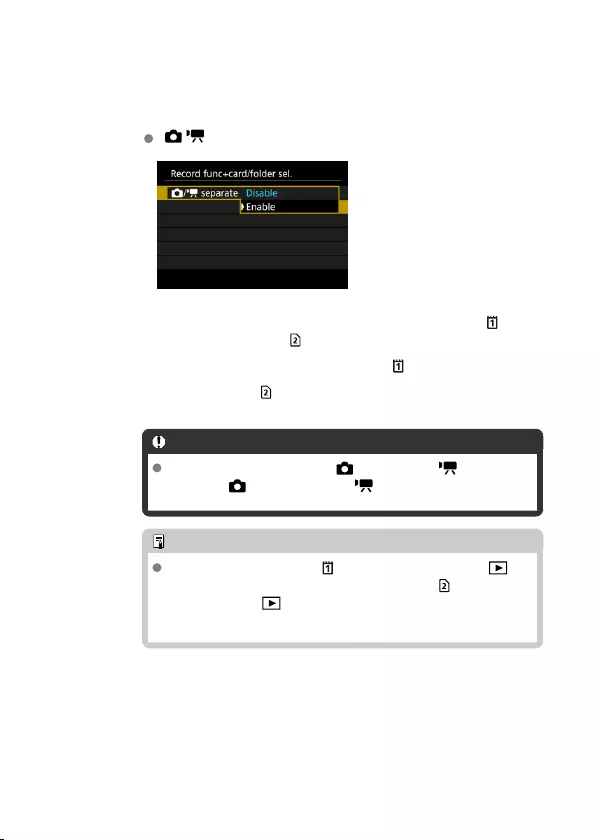
2. Set the recording method.
/ separate
• Select [Enable] for automatic configuration of the recording method
for still photos and movies. Movies are recorded to card [ ] and
still photos to card [ ].
• Movie recording is not possible if card [ ] is full or not inserted.
• Without card [ ] inserted, still photos can be captured but not
saved. Still photo shooting is not possible if the card is full.
Caution
Specifying [Enable] will make [ Rec options], [ Rec
options], [ Record/play], and [ Record/play] unavailable.
Note
When set to [Enable], card [ ] is used for playback if the < >
button is pressed in movie recording mode. Card [ ] is used for
playback if the <> button is pressed in still photo shooting
mode.
730
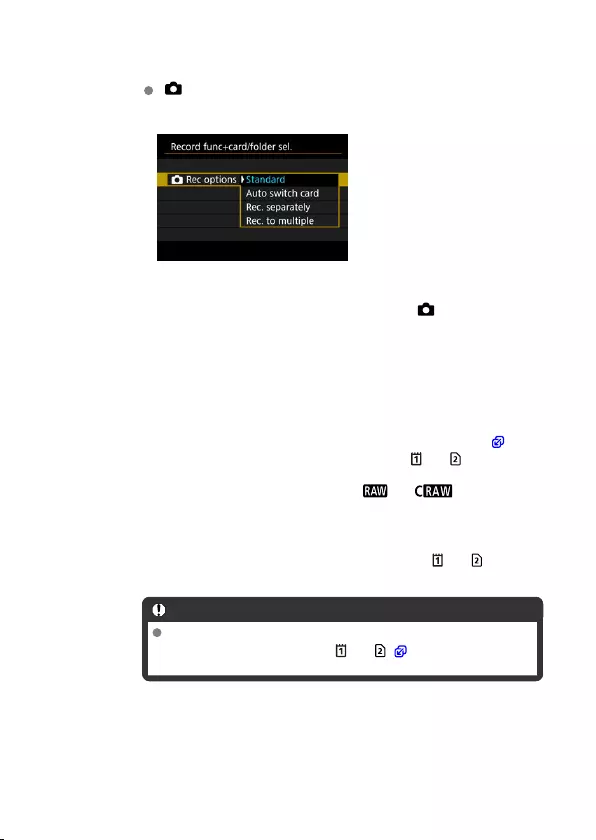
Rec options
Set the recording method for still photos.
•Standard
Records still photos to the card selected in [ Record/play].
•Auto switch card
Same as [Standard], but shooting ends when the card becomes
full. When you resume shooting, the camera switches to the other
card automatically. At this time, a new folder is created.
•Rec. separately
Enables you to set a specific image quality for each card ( ). For
each shot, a still photo is recorded to card and in your
specified image quality.
Note that recording separately to and is not available
for RAW images.
•Rec. to multiple
For each shot, a still photo is recorded to card and in the
same image quality.
Caution
Maximum burst for [Rec. separately] is lower if you specify
different image sizes for cards and ( ).
731

Note
Rec. separately/Rec. to multiple
Images are recorded with the same file number to card and .
The number of shots available as shown in the viewfinder and on
the Quick Control screen is for the card with less free space.
[Card* full] is displayed when one of the cards becomes full, and
shooting is no longer possible. To continue shooting, either
replace the card or set [ Rec options] to [Standard] and select
the card with free space.
See Folder Settings for details on [Folder] in [ : Record func
+card/folder sel.].
732
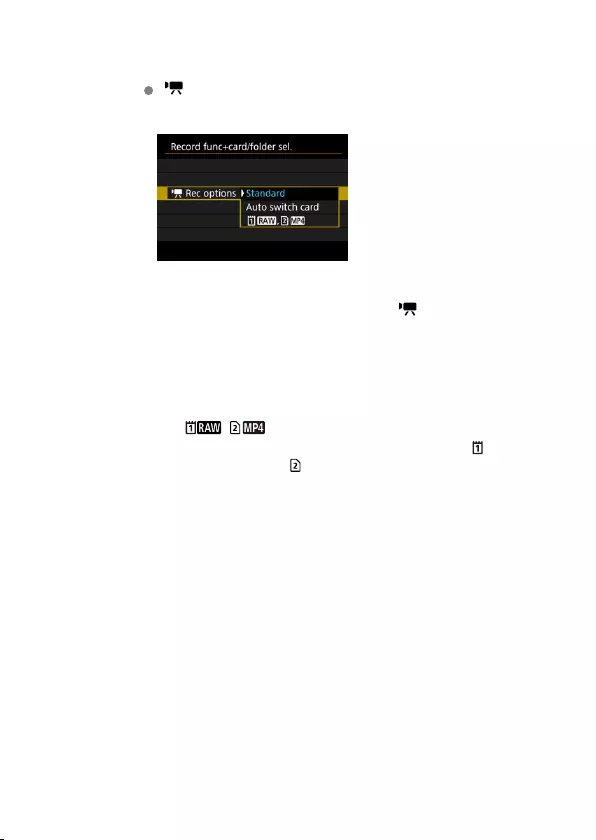
Rec options
Set the recording method for movies.
•Standard
Records movies to the card selected in [ Record/play].
•Auto switch card
Same as [Standard], but recording ends when the card becomes
full. When you resume recording, the camera switches to the other
card for recording. A new folder is created after switching cards.
•,
For each recording, a RAW movie is recorded to card and an
MP4 movie to card , both with the same file number. When one
card becomes full, recording is no longer possible.
733
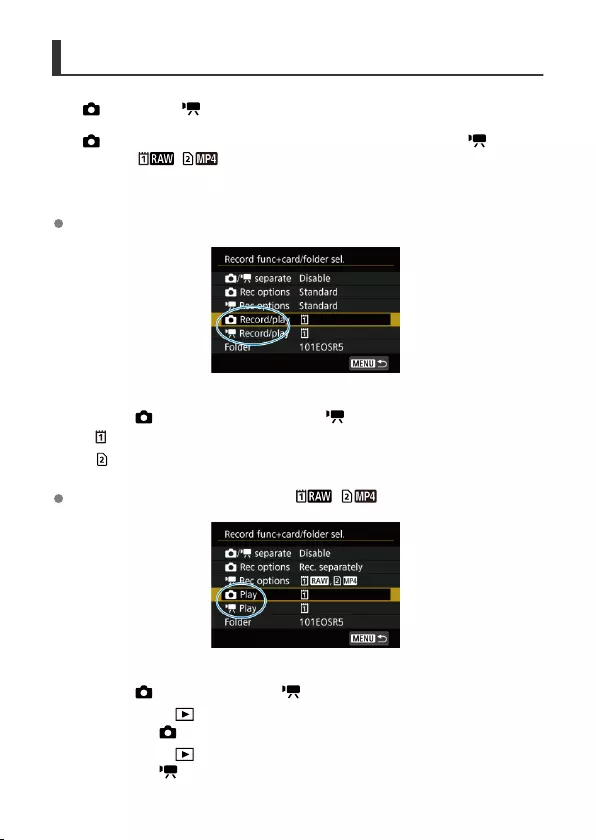
Recording/Playback Selection with Two Cards Inserted
With [ Rec options]/[ Rec options] set to [Standard] or [Auto switch card], select
the card for recording and playback.
With [ Rec options] set to [Rec. separately] or [Rec. to multiple], or with [ Rec
options] set to [ , ], select the card for playback.
Setting size via the menu
Standard/Auto switch card
Select [Record/play].
• Select [ Record/play] for still photos or [ Record/play] for movies.
: Use card 1 for recording and playback
: Use card 2 for recording and playback
Rec. separately/Rec. to multiple/ ,
Select [Play].
• Select [ Play] for still photos or [ Play] for movies.
• Pressing the < > button in still photo shooting mode plays images from the card
selected in [ Play].
• Pressing the < > button in movie recording mode plays images from the card
selected in [ Play].
734

Note
With [Priority: ] set, the camera switches to the priority card when cards are
inserted or removed.
735

3. Select [Create folder].
4. Select [OK].
To rename the folder, select [Change folder name].
737
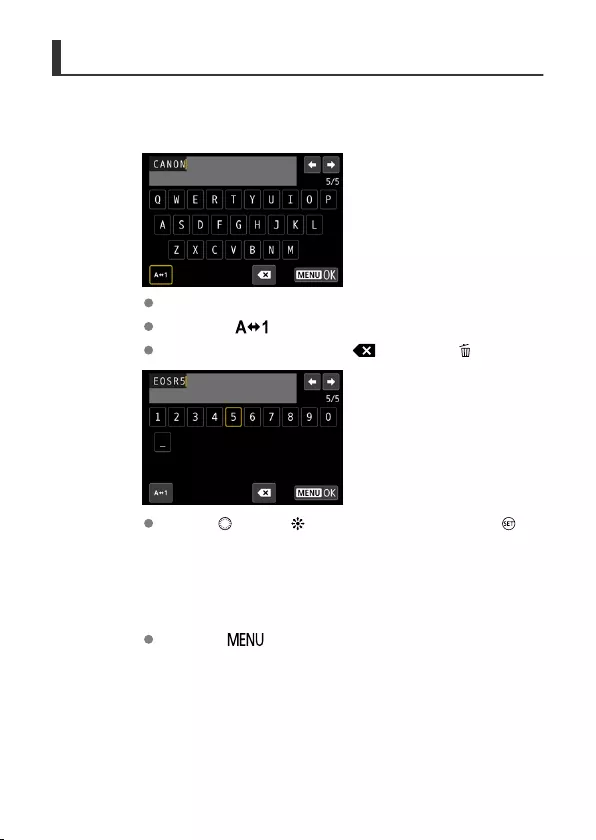
Renaming Folders
1. Enter letters and numbers of your choice.
You can enter five characters.
By selecting [ ], you can change the input mode.
To delete single characters, select [ ] or press the < > button.
Use the < > dial or < > to select a character, then press < > to
enter it.
2. Exit the setting.
Press the < > button, then press [OK].
738
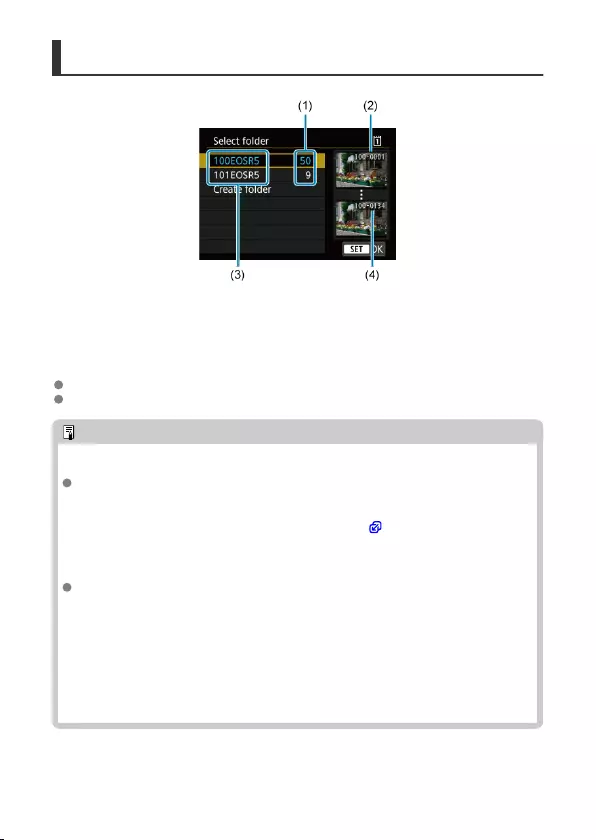
Selecting a Folder
(1) Number of images in folder
(2) Lowest file number
(3) Folder name
(4) Highest file number
Select a folder on the folder selection screen.
Captured images are stored in your selected folder.
Note
Folders
Folders are named as in “100EOSR5,” with a three-digit folder number followed by
five letters or numbers. A folder can contain up to 9999 images (file number 0001–
9999). When a folder becomes full, a new folder with the folder number increased
by one is created automatically. Also, if manual reset ( ) is executed, a new folder
will be created automatically. Folders numbered from 100 to 999 can be created.
Creating folders with a computer
With the card open on the screen, create a new folder with “DCIM” as the name.
Open the DCIM folder and create as many folders as necessary to save and
organize your images. “100ABC_D” is the required format for folder names, and
the first three digits must be a folder number in the range 100–999. The last five
characters can be any combination of upper- and lower-case letters from A to Z,
numerals, and the underscore “_”. The space cannot be used. Also note that two
folder names cannot share the same three-digit folder number (for example,
“100ABC_D” and “100W_XYZ”) even if the remaining five characters in each name
are different.
739

2. Set the item.
Select [Numbering].
Select [Continuous] or [Auto reset].
If you want to reset the file numbering, select [Manual reset] ( ).
Select [OK] to create a new folder, and the file number will start with
0001.
Caution
If the file number in folder 999 reaches 9999, shooting will not be possible even if
the card still has free space. After a message requesting you to replace the card is
displayed, switch to a new card.
741
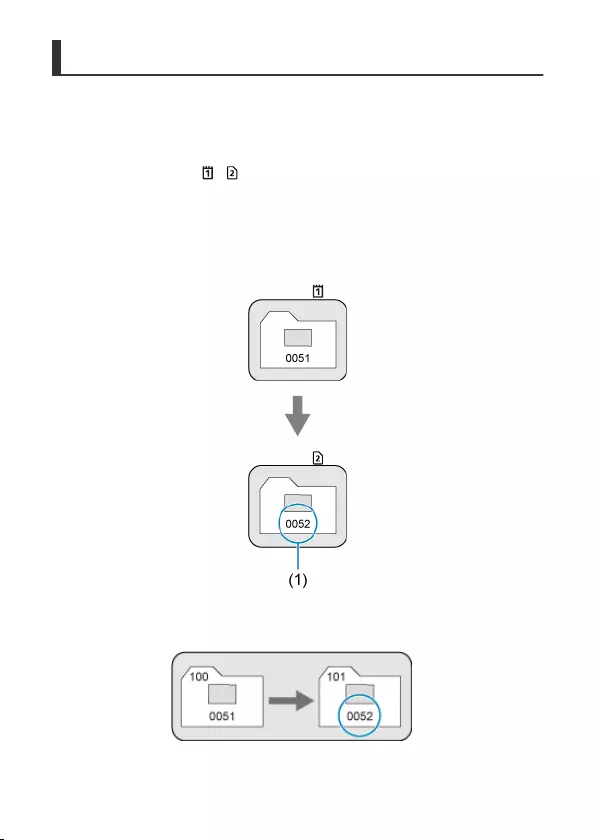
Continuous
For continuous file numbering regardless of switching cards or
creating folders
File numbering is continuous up to 9999, even if you replace a card, create a folder, or
switch the target card (as in → ). This is useful when you want to save images
numbered anywhere between 0001 to 9999 on multiple cards or in multiple folders into one
folder on a computer.
Note that file numbering may continue from any existing images in cards or folders that you
switch to. If you want to use continuous file numbering, it is recommended that you use a
newly formatted card each time.
File numbering after replacing cards or switching target cards
Card A ( )
Card B ( )
(1) Next sequential file number
File numbering after creating a folder
Card A
742

Auto Reset
For restarting file numbering from 0001 after switching cards or
creating folders
File numbering is reset to 0001 if you replace a card, create a folder, or switch the target
card (as in → ). This is useful if you want to organize images by cards or folders.
Note that file numbering may continue from any existing images in cards or folders that you
switch to. If you want to save images with the file numbering starting from 0001, use a newly
formatted card each time.
File numbering after replacing cards or switching target cards
Card A ( )
Card B ( )
(1) File numbering is reset
File numbering after creating a folder
Card A
743

Manual Reset
For resetting file numbering to 0001 or starting from 0001 in new
folders
When you reset the file numbering manually, a new folder is created automatically and the
file numbering of images saved to that folder starts from 0001.
This is useful, for example, if you want to use different folders for the images taken
yesterday and the ones taken today.
744
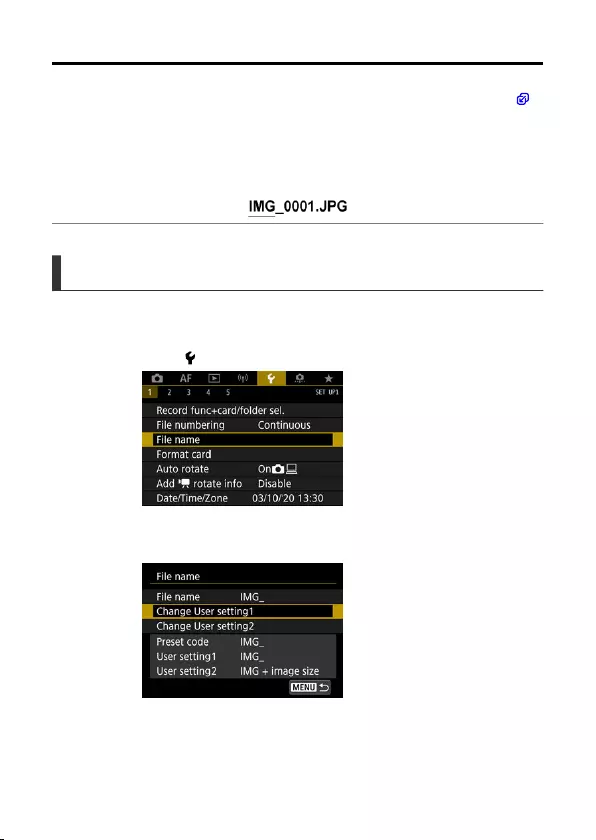
File Naming
File names consist of four alphanumeric characters followed by a four-digit file number ( )
and file extension. You can change the first four alphanumeric characters, which by default
are unique for each camera and set when the camera is shipped.
User setting 1 enables you to register four characters of your choice. User setting 2 adds
three initial, registered characters of your choice to a fourth character representing the
image size that is added automatically after you shoot.
(Example)
Registering/Changing File Names
1. Select [ : File name].
2. Select [Change User setting*].
745
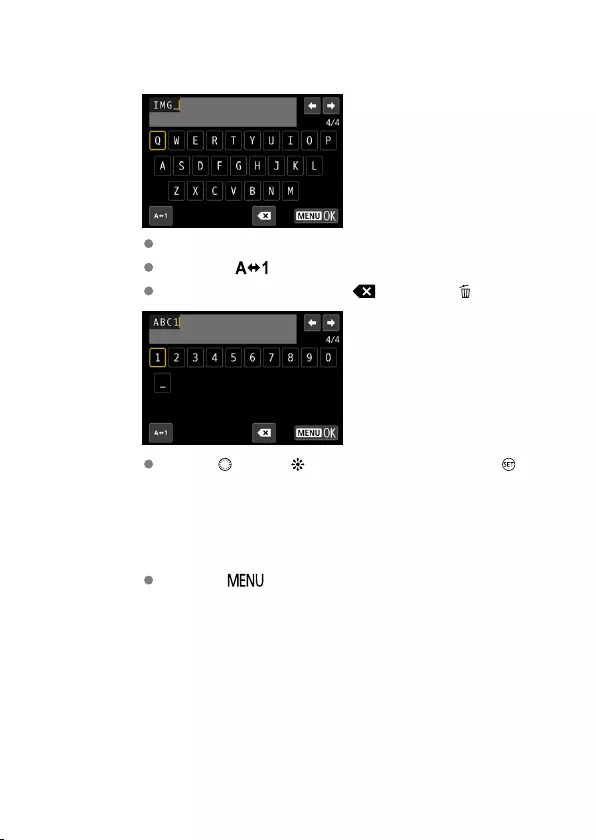
3. Enter letters and numbers of your choice.
Enter four characters for User setting 1 or three for User setting 2.
By selecting [ ], you can change the input mode.
To delete single characters, select [ ] or press the < > button.
Use the < > dial or < > to select a character, then press < > to
enter it.
4. Exit the setting.
Press the < > button, then press [OK].
746
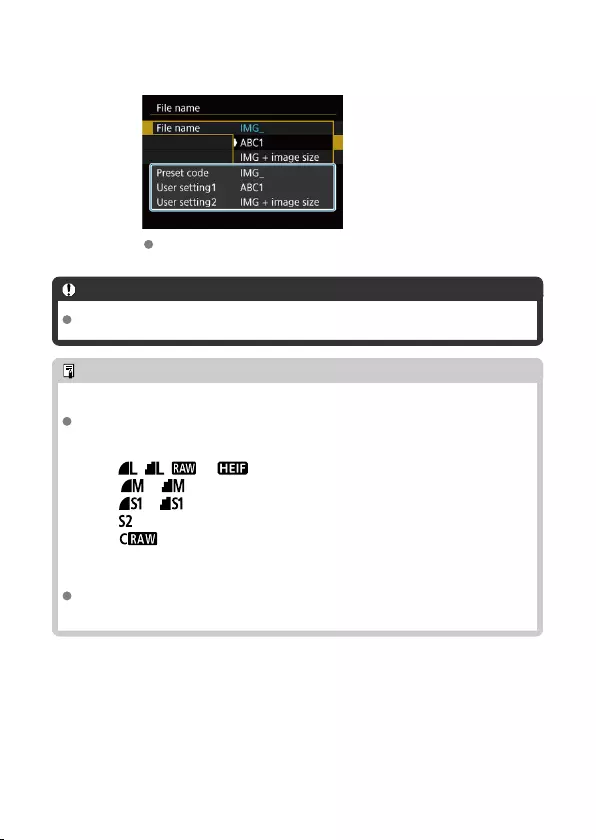
5. Select a registered file name.
Select [File name], then choose a registered file name.
Caution
An underscore (“_”) cannot be used as the first character.
Note
User setting 2
Shooting after you have selected “*** + image size” (as registered to User setting 2)
will add a character representing the current image size to your file name as the
fourth character. Meanings of added characters are as follows.
“***L”: , , , or
“***M”: or
“***S”: or
“***T”:
“***C”:
The automatically added fourth character enables you to determine image sizes
without opening the files after transferring them to a computer. Based on file
extensions, you can also distinguish RAW, JPEG, and HEIF images.
Movies recorded with User setting 2 are named with the fourth character as an
underscore.
747
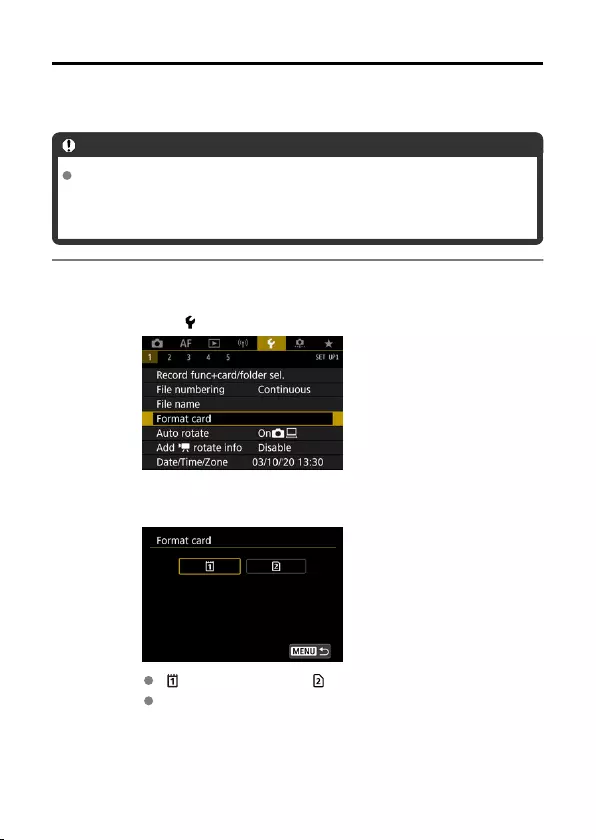
Formatting
If the card is new or was previously formatted (initialized) by another camera or computer,
format the card with this camera.
Caution
When the card is formatted, all images and data on the card will be erased.
Even protected images will be erased, so make sure there is nothing you
need to keep. If necessary, transfer the images and data to a computer, etc.
before formatting the card.
1. Select [ : Format card].
2. Select a card.
[ ] represents card 1, and [ ], card 2.
Select the card.
748

3. Format the card.
Select [OK].
For low-level formatting, press the < > button to add a checkmark
[ ] to [Low level format], then select [OK].
749
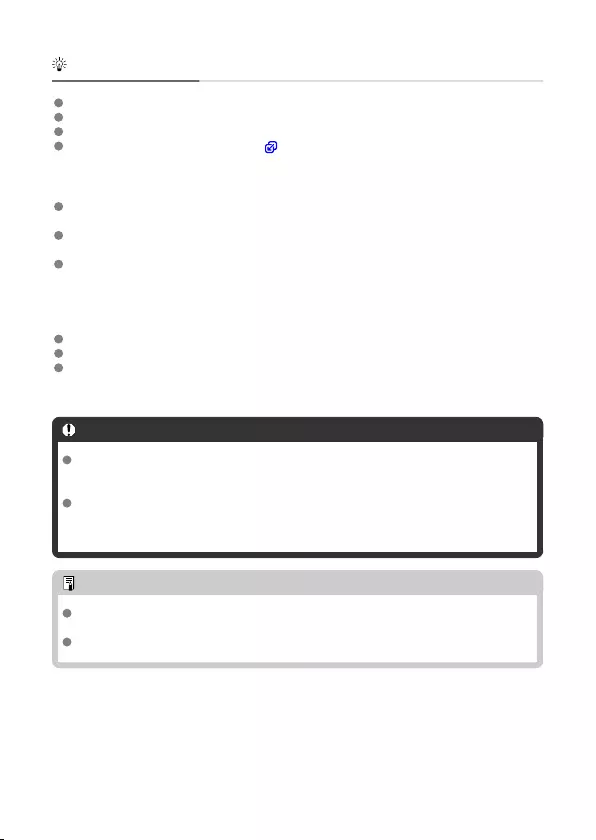
Conditions requiring card formatting
The card is new.
The card was formatted by a different camera or a computer.
The card is full of images or data.
A card-related error is displayed ( ).
Low-level formatting
Perform low-level formatting if the card’s writing or reading speed seems slow or if you
want to totally erase the data on the card.
Since low-level formatting will format all recordable sectors on the card, the formatting
will take longer than normal formatting.
During low-level formatting, you can cancel formatting by selecting [Cancel]. Even in
this case, normal formatting will already be complete and you can use the card as usual.
Card file formats
CFexpress cards are exFAT formatted.
SD/SDHC cards will be formatted in FAT32. SDXC cards will be formatted in exFAT.
Individual movies recorded to exFAT-formatted cards are recorded as a single file
(without splitting them into multiple files) even if they exceed 4 GB, so the resulting
movie file will exceed 4 GB.
Caution
It may not be possible to use cards formatted with this camera in other cameras.
Also note that exFAT-formatted cards may not be recognized by some computer
operating systems or card readers.
Formatting or erasing data on a card does not completely erase the data. Be aware
of this when selling or discarding the card. When disposing of cards, take steps to
protect personal information if necessary, as by physically destroying cards.
Note
The card capacity displayed on the card format screen may be smaller than the
capacity indicated on the card.
This device incorporates exFAT technology licensed from Microsoft.
750

Auto Rotate
You can change the auto rotation setting that straightens images shot in vertical orientation
when they are displayed.
1. Select [ : Auto rotate].
751
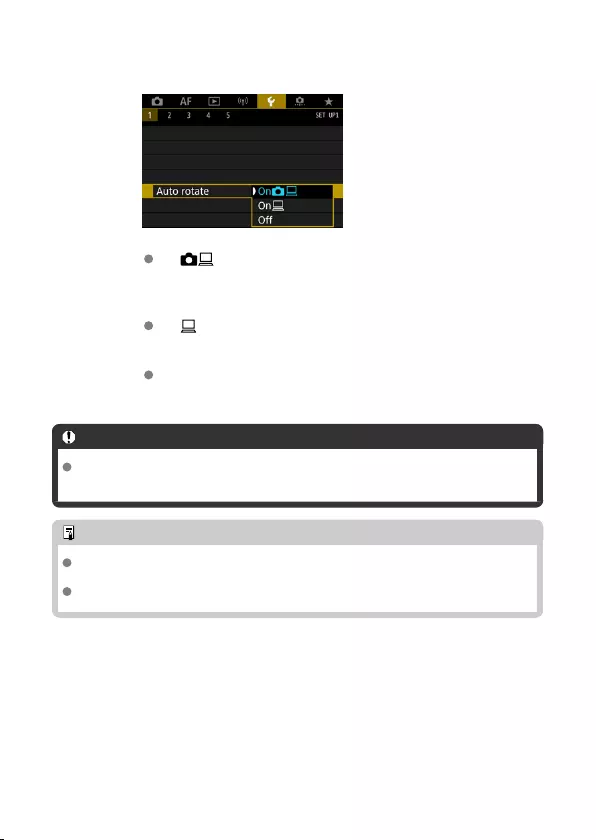
2. Select an option.
On
Automatically rotates images for display on both the camera and
computers.
On
Automatically rotates images only for display on computers.
Off
Images are not automatically rotated.
Caution
Images captured with auto rotation set to [Off] will not rotate during playback even
if you later set auto rotation to [On].
Note
If a picture is taken while the camera is aimed up or down, automatic rotation to the
proper orientation for viewing may not be performed correctly.
If images are not rotated automatically on a computer, try using EOS software.
752
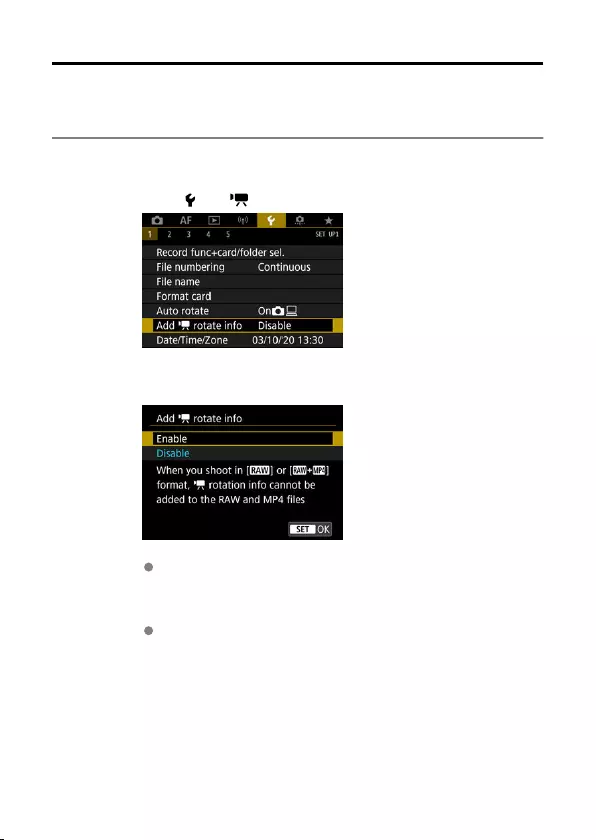
Adding Orientation Information to Movies
For movies recorded with the camera held vertically, orientation information indicating which
side is up can be added automatically to enable playback in the same orientation on
smartphones or other devices.
1. Select [ : Add rotate info].
2. Select an option.
Enable
Play movies on smartphones or other devices in the orientation in
which they were recorded.
Disable
Play movies horizontally on smartphones or other devices, regardless
of the recording orientation.
753

Caution
[Add rotate info] is not available for RAW or MP4 files when the movie
recording format is or + .
Movies are played horizontally on the camera and via HDMI video output,
regardless of this setting.
754
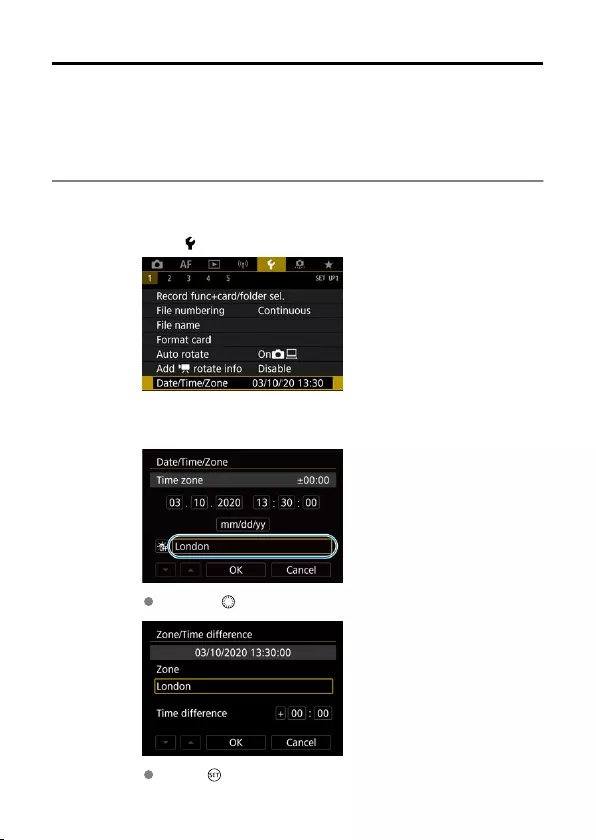
Date/Time/Zone
When you turn on the power for the first time or if the date/time/zone have been reset, follow
these steps to set the time zone first.
By setting the time zone first, you can simply adjust this setting as needed in the future and
the date/time will be updated to match it.
Since the captured images will be appended with the shooting date and time information, be
sure to set your date/time.
1. Select [ : Date/Time/Zone].
2. Set the time zone.
Turn the < > dial to select [Time zone].
Press < >.
755
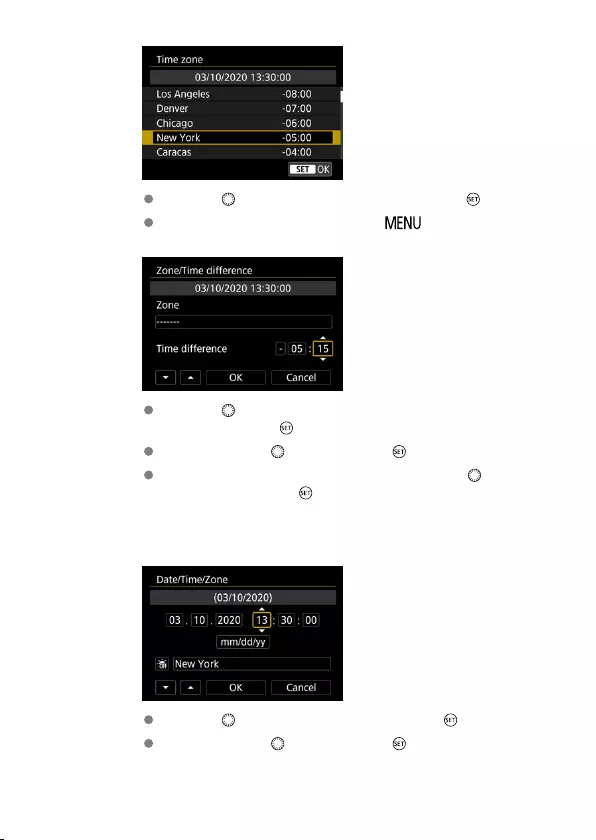
Turn the < > dial to select the time zone, then press < >.
If your time zone is not listed, press the < > button, then set the
difference from UTC in [Time difference].
Turn the < > dial to select a [Time difference] item (+/–/hour/
minute), then press < >.
Set by turning the < > dial, then press < >.
After entering the time zone or time difference, turn the < > dial to
select [OK], then press < >.
3. Set the date and time.
Turn the < > dial to select an option, then press < >.
Set by turning the < > dial, then press < >.
756
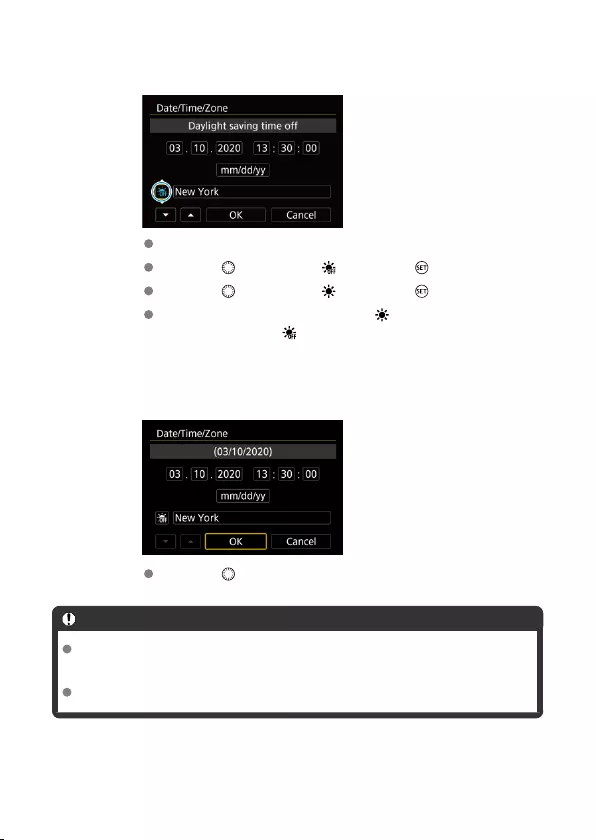
4. Set daylight saving time.
Set it as necessary.
Turn the < > dial to select [ ], then press < >.
Turn the < > dial to select [ ], then press < >.
When the daylight saving time is set to [ ], the time set in step 3 will
advance by 1 hour. If [ ] is set, the daylight saving time will be
canceled and the time will go back by 1 hour.
5. Exit the setting.
Turn the < > dial to select [OK].
Caution
The date, time, and time zone settings may be reset when the camera is stored
without the battery, when the battery is exhausted, or when it is exposed to freezing
temperatures for an extended period. If this happens, set them once again.
After changing [Zone/Time difference], check that the correct date/time are set.
757

Note
Auto power off time may be extended while the [ : Date/Time/Zone] screen is
displayed.
758
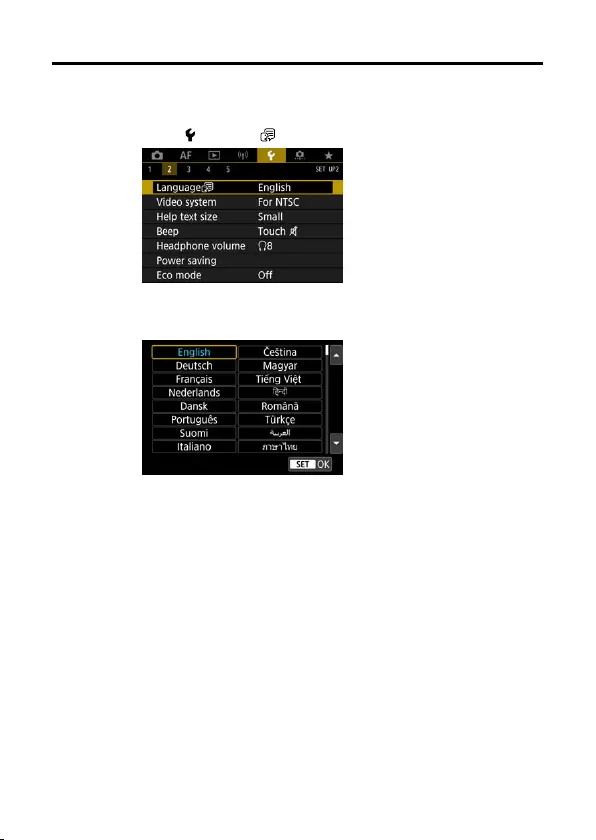
Language
1. Select [ : Language ].
2. Set the desired language.
759
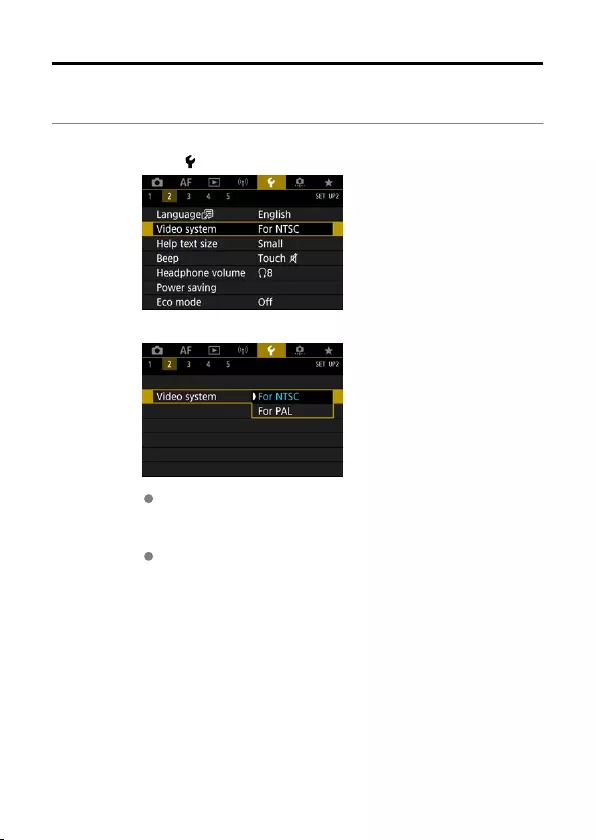
Video System
Set the video system of any television used for display. This setting determines the frame
rates available when you record movies.
1. Select [ : Video system].
2. Select an option.
For NTSC
For areas where the TV system is NTSC (North America, Japan, South
Korea, Mexico, etc.).
For PAL
For areas where the TV system is PAL (Europe, Russia, China,
Australia, etc.).
760
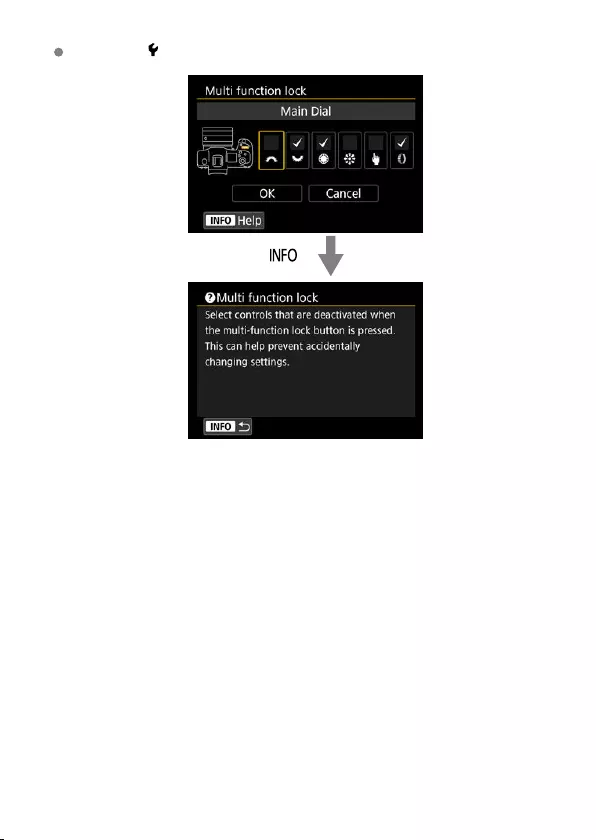
Example: [ : Multi function lock]
< >
762
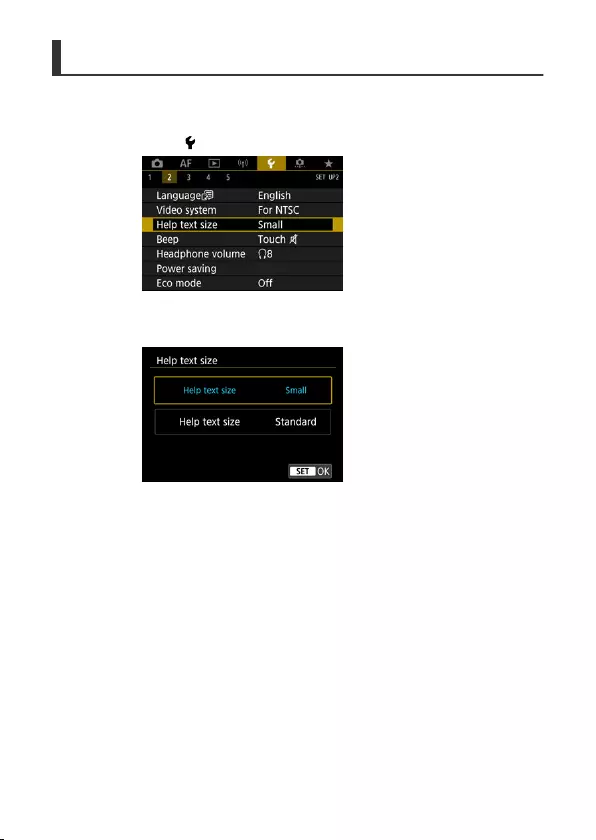
Changing the Help Text Size
1. Select [ : Help text size].
2. Select an option.
763

Beeps
1. Select [ : Beep].
2. Select an option.
Enable
The camera beeps after focusing and in response to touch operations.
Touch
Disables beeping for touch operations.
Disable
Disables beeping for focus confirmation, self-timer shooting, and touch
operations.
764
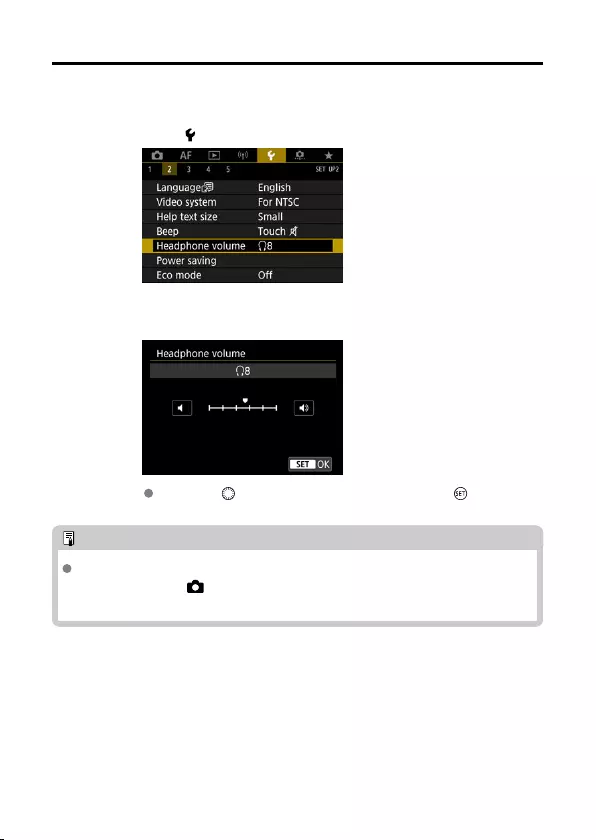
Headphone Volume
1. Select [ : Headphone volume].
2. Adjust the volume.
Turn the < > dial to adjust the volume, then press < >.
Note
You can check sound from the built-in microphone or an external microphone on
headphones when [ : Sound recording] is set to an option other than [Disable]
and [High Frame Rate] is set to [Disable].
765

Power Saving
You can adjust the timing of when the screen, camera, and viewfinder turn off automatically
after the camera is left idle (Display off, Auto power off, and Viewfinder off).
1. Select [ : Power saving].
2. Select an option.
Note
Even when [Auto power off] is set to [Disable], the screen will turn off after the
time set in [Display off].
[Display off] and [Auto power off] settings have no effect when [ : Eco mode] is
set to [On].
766
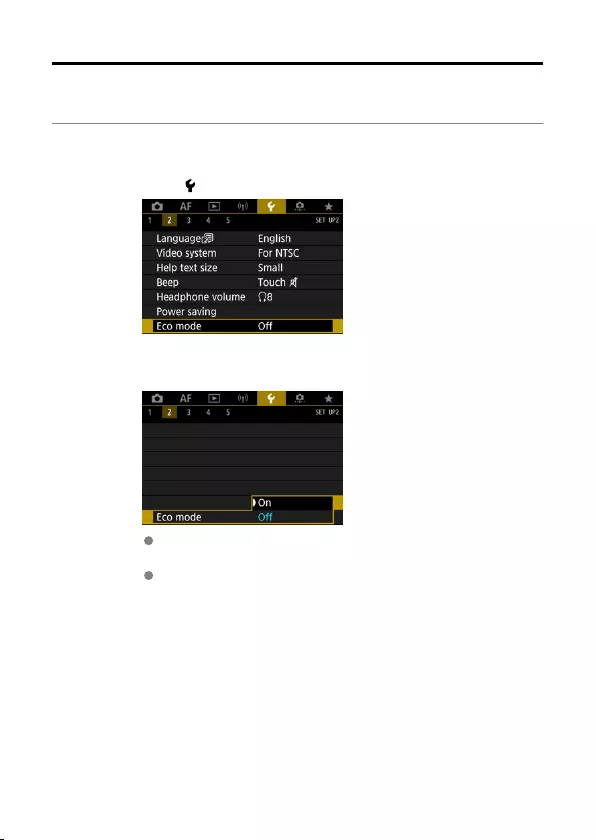
Eco Mode
Enables you to conserve battery power in shooting mode. When the camera is not in use,
the screen darkens to reduce battery consumption.
1. Select [ : Eco mode].
2. Select [On].
The screen darkens when the camera is not used for approx. two
seconds. Approx. ten seconds after darkening, the screen turns off.
To activate the screen and prepare for shooting when the screen is off,
press the shutter button halfway.
767
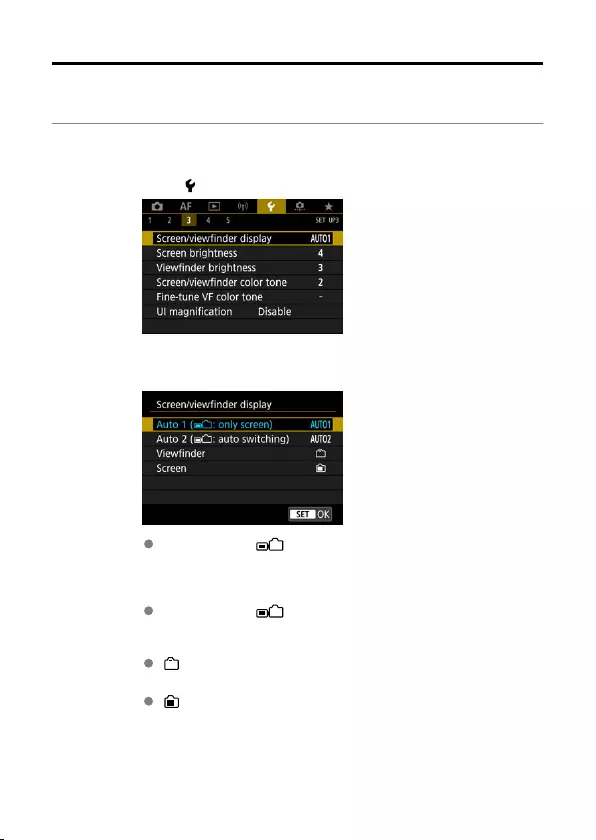
Screen/Viewfinder Display
You can specify to use the screen or viewfinder for display, to avoid accidentally activating
the eye sensor when the screen is open.
1. Select [ : Screen/viewfinder display].
2. Select an option.
AUTO1: Auto 1 ( : only screen)
Always use the screen for display when it is swung out.
Use the screen for display when it is closed and facing you, and switch
to viewfinder display when you look through the viewfinder.
AUTO2: Auto 2 ( : auto switching)
Always use the screen for display, but switch to the viewfinder when
you look through it.
: Viewfinder
Always use the viewfinder for display.
: Screen
Always use the screen for display when it is closed and facing you.
768

Note
You can also switch between viewfinder and screen display by pressing a button
you have customized by assigning to switching. With this setting set to [AUTO1] or
[AUTO2], the camera responds to the eye sensor accordingly.
With [AUTO1] set, the camera responds to the eye sensor when the screen is
closed and facing you but does not respond when it is swung out.
769
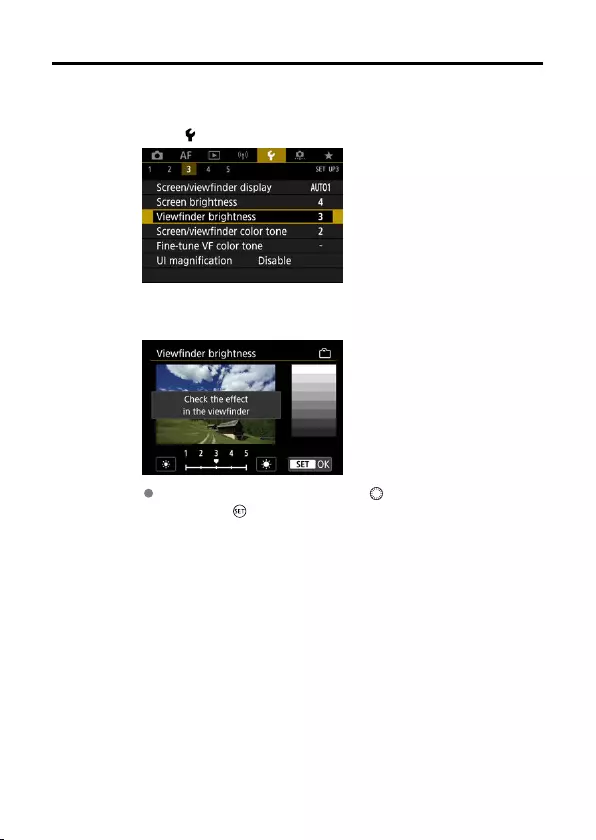
Viewfinder Brightness
1. Select [ : Viewfinder brightness].
2. Make the adjustment.
Referring to the gray image, turn the < > dial to adjust brightness,
then press <>. Check the effect in the viewfinder.
771
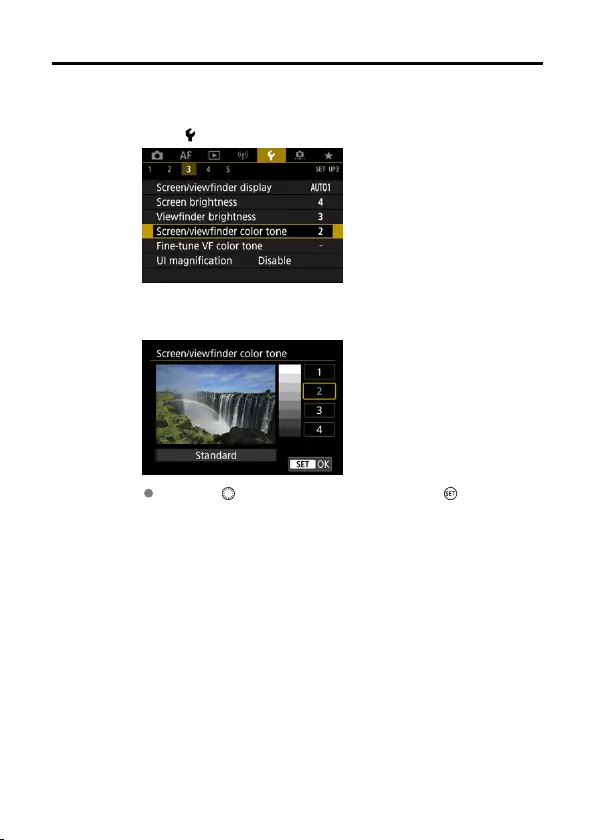
Screen and Viewfinder Color Tone
1. Select [ : Screen/viewfinder color tone].
2. Make the adjustment.
Turn the < > dial to select an option, then press < >.
772

Fine-Tuning Viewfinder Color Tone
1. Select [ : Fine-tune VF color tone].
2. Make the adjustment.
Referring to the gray image, use < > for adjustment, then press
< >. Check the effect in the viewfinder.
773
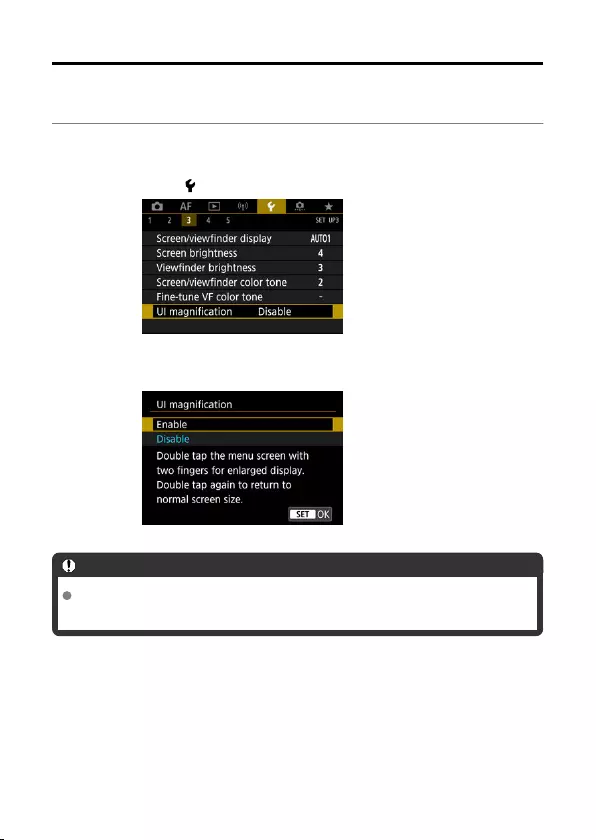
UI Magnification
You can magnify menu screens by double-tapping with two fingers. Double-tap again to
restore the original display size.
1. Select [ : UI magnification].
2. Select [Enable].
Caution
Use camera controls when configuring menu functions with the display magnified.
Touch-screen operations are not supported.
774

HDMI Resolution
Set the image output resolution used when the camera is connected to a television or
external recording device with an HDMI cable.
1. Select [ : HDMI resolution].
2. Select an option.
Auto
The images will automatically be displayed at the optimum resolution
matching the connected television.
1080p
Output at 1080p resolution. Select if you prefer to avoid display or
delay issues when the camera switches resolution.
775
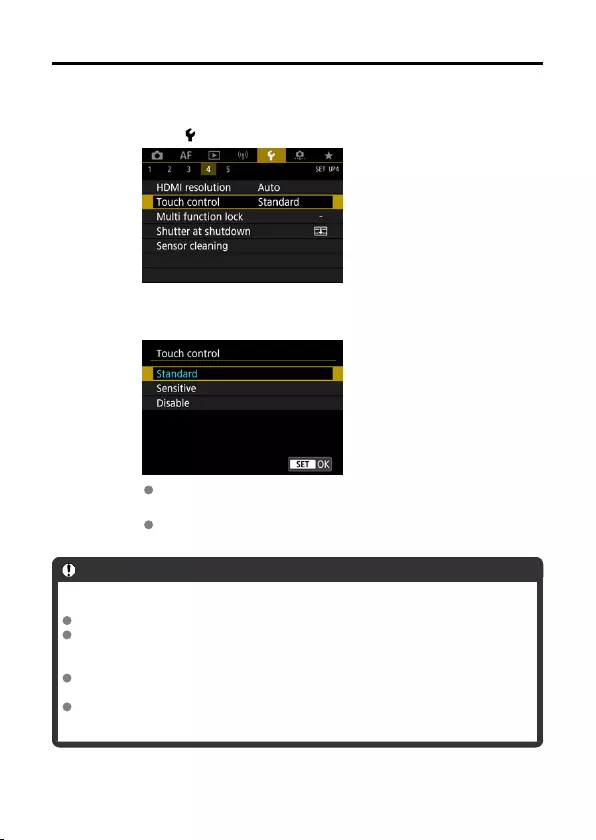
Touch Control
1. Select [ : Touch control].
2. Select an option.
[Sensitive] makes the touch-screen panel more responsive than
[Standard].
To disable touch operations, select [Disable].
Caution
Precautions for touch-screen panel operations
Do not use sharp objects such as fingernails or ballpoint pens for touch operations.
Do not use wet fingers for touch operations. If the screen has any moisture or if
your fingers are wet, the touch-screen panel may not respond or malfunction may
occur. In this case, turn off the power and wipe off the moisture with a cloth.
Attaching a commercially available protective sheet or a sticker on the screen may
impair responsiveness to touch operations.
The camera may not respond as well if you quickly perform touch operation when
[Sensitive] is set.
776
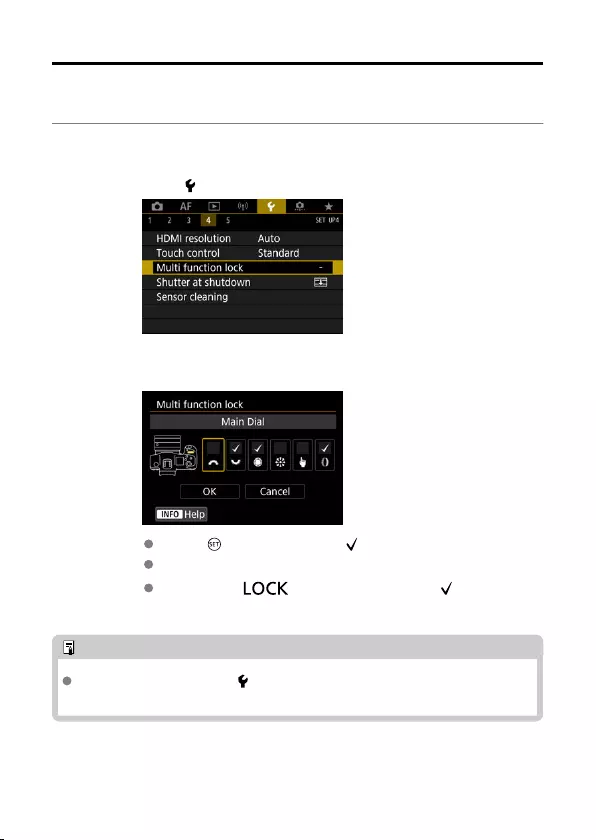
Multi-Function Lock
Specify camera controls to lock when the Multi-function lock is enabled. This can help
prevent accidentally changing settings.
1. Select [ : Multi function lock].
2. Select camera controls to lock.
Press < > to add a checkmark [ ].
Select [OK].
Pressing the < > button locks the selected [ ] camera
controls.
Note
An asterisk “*” to the right of [ : Multi function lock] indicates that the default
setting has been modified.
777
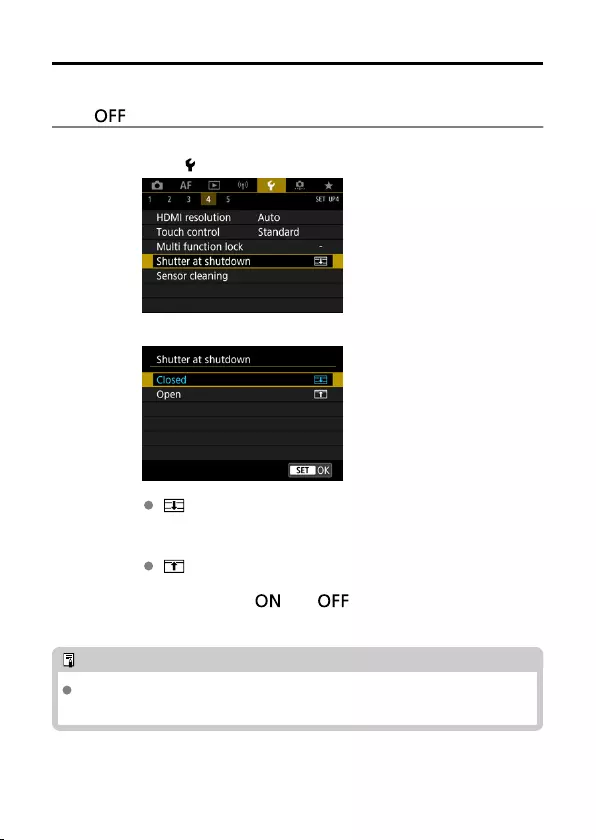
Shutter at Shutdown
You can set whether to leave the shutter open or close it when the camera’s power switch is
set to < >.
1. Select [ : Shutter at shutdown].
2. Select an option.
: Closed
Closes the shutter. Normally set to closed, to prevent dust from
adhering to the sensor when you switch lenses.
: Open
Leaves the shutter open. This keeps camera quieter when the power
switch is set to < > or < >. Useful when you want to shoot
quietly.
Note
Regardless of the setting, the shutter remains as it is when auto power off is
activated.
778
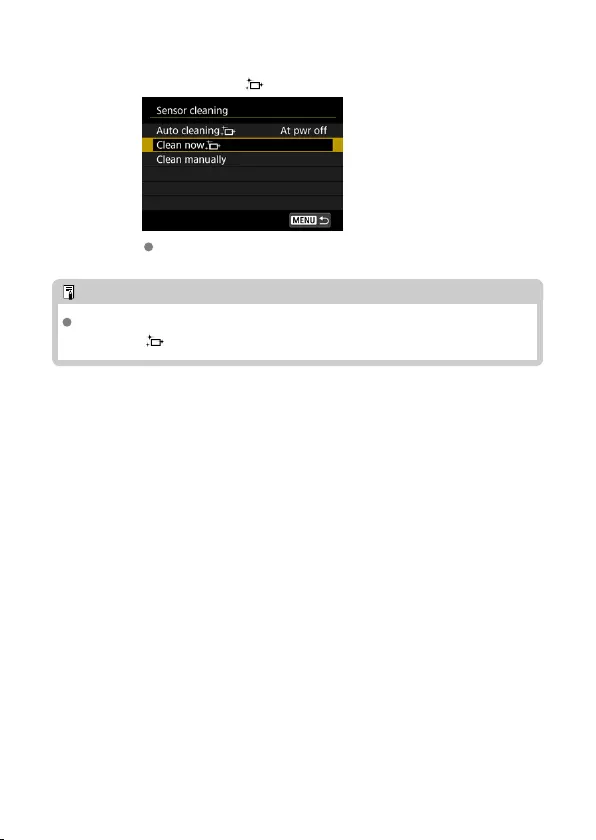
2. Select [Clean now ].
Select [OK] on the confirmation screen.
Note
Even if you repeat the sensor cleaning, the result will not improve much. Note that
[Clean now ] may not be available immediately after cleaning.
780
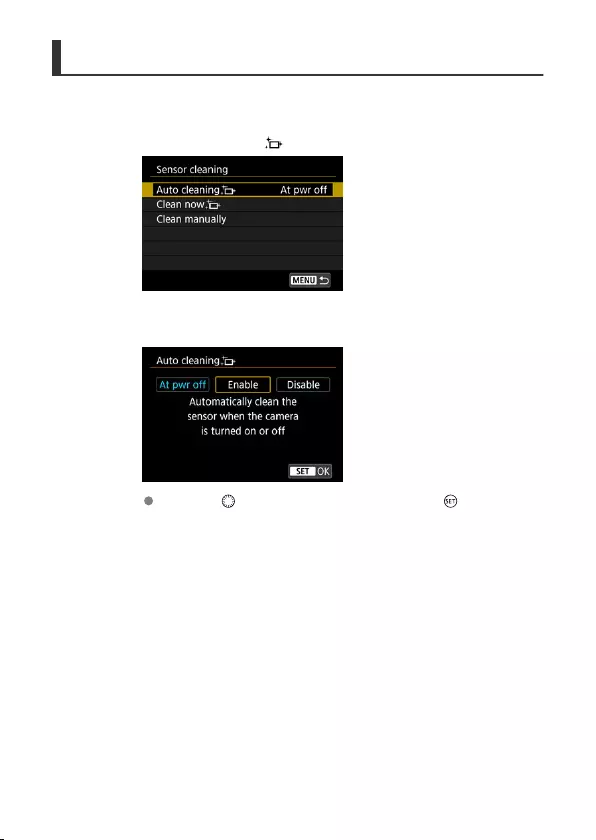
Cleaning Automatically
1. Select [Auto cleaning ].
2. Select an option.
Turn the < > dial to select an option, then press < >.
781
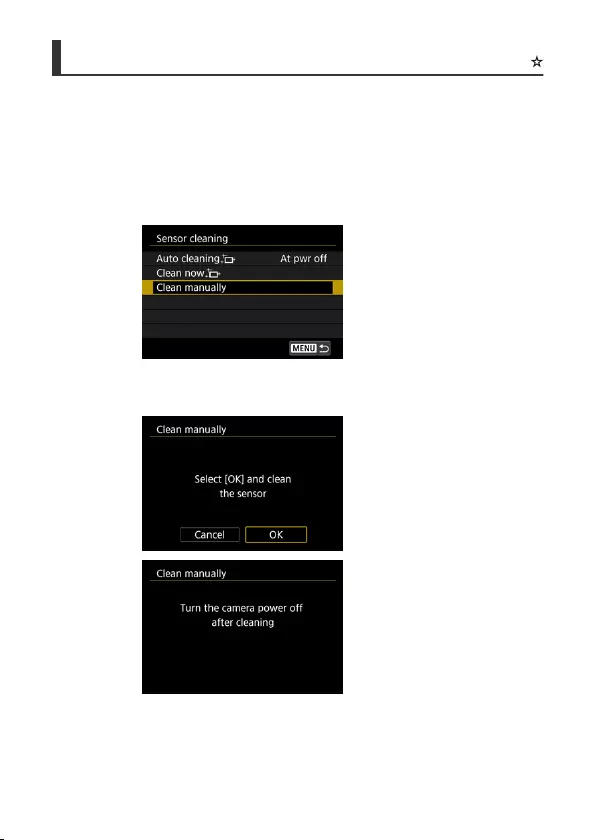
Cleaning Manually
Dust that could not be removed by automatic cleaning can be removed manually with a
commercially available blower or similar tool.
Always use a fully charged battery.
The image sensor is extremely delicate. If the sensor needs to be cleaned directly, having it
done by a Canon Service Center is recommended.
1. Select [Clean manually].
2. Select [OK].
3. Remove the lens and clean the sensor.
782
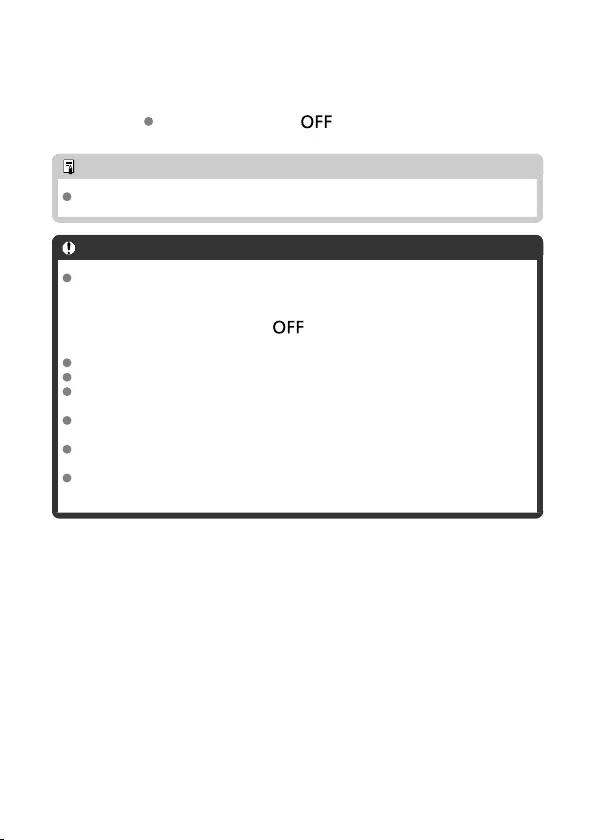
4. End the cleaning.
Set the power switch to < >.
Note
Using the household power outlet accessories (sold separately) is recommended.
Caution
While cleaning the sensor, never do any of the following. If the power is cut
off, the shutter will close. These may result in damaging the image sensor
and shutter curtains.
•Setting the power switch to < >.
•Removing or inserting the battery.
The surface of the image sensor is extremely delicate. Clean the sensor with care.
Use a plain blower without any brush attached. A brush can scratch the sensor.
Do not insert the blower tip inside the camera beyond the lens mount. If the power
is turned off, the shutter will close and the shutter curtains may get damaged.
Never use pressurized air or gas to clean the sensor. Pressurized air may damage
the sensor, and sprayed gas may freeze on the sensor and scratch it.
If the battery level becomes low while cleaning the sensor, the beeper will sound as
a warning. Stop cleaning the sensor.
If a smudge that cannot be removed with a blower remains, having the sensor
cleaned by a Canon Service Center is recommended.
783
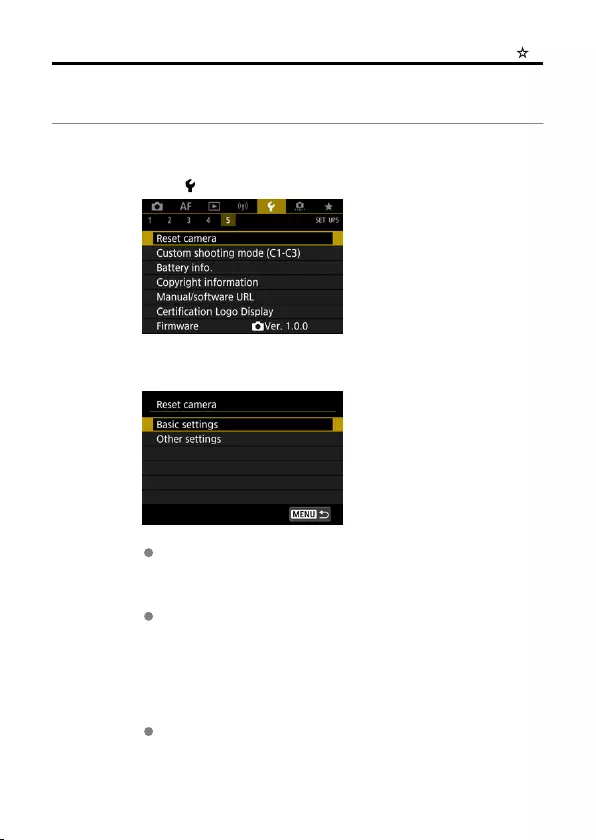
Resetting the Camera
The camera’s settings for shooting functions and menu functions can be restored to their
defaults.
1. Select [ : Reset camera].
2. Select an option.
Basic settings
Restores default settings for camera shooting functions and menu
settings.
Other settings
Settings for individual selected items can be reset.
3. Clear the settings.
Select [OK] on the confirmation screen.
784

Note
Still photo Custom shooting modes are reset when [Custom shooting mode (C1-
C3)] in [Other settings] is selected in still photo shooting mode, and movie Custom
shooting modes are reset when this option is selected in movie recording mode.
785
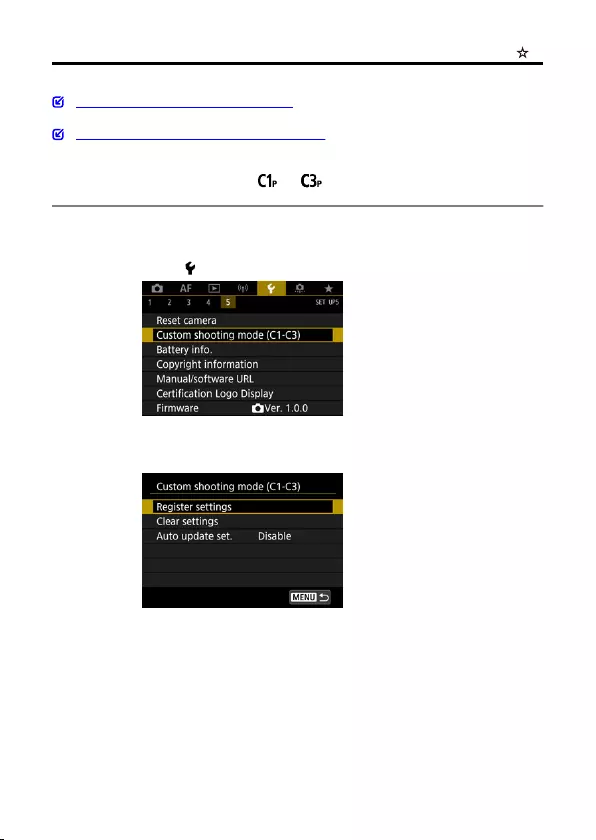
Custom Shooting Mode (C1–C3)
Automatic Update of Registered Settings
Canceling Registered Custom Shooting Modes
Current camera settings such as shooting, menu, and Custom Function settings can be
registered in Custom shooting modes [ ] to [ ]. You can register different functions to
use when shooting still photos or movies.
1. Select [ : Custom shooting mode (C1-C3)].
2. Select [Register settings].
786

3. Register the desired items.
Select the Custom shooting mode to register, then select [OK] on the
[Register settings] screen.
The current camera settings are registered to Custom shooting mode
C*.
Automatic Update of Registered Settings
If you change a setting while shooting in Custom shooting mode, the mode can be
automatically updated with the new setting (Auto update). To enable this automatic update,
set [Auto update set.] to [Enable] in step 2.
787

Canceling Registered Custom Shooting Modes
If you select [Clear settings] in step 2, the settings of each mode can be restored to default
settings, as they were before registration.
Note
You can also change shooting and menu settings in Custom shooting modes.
788
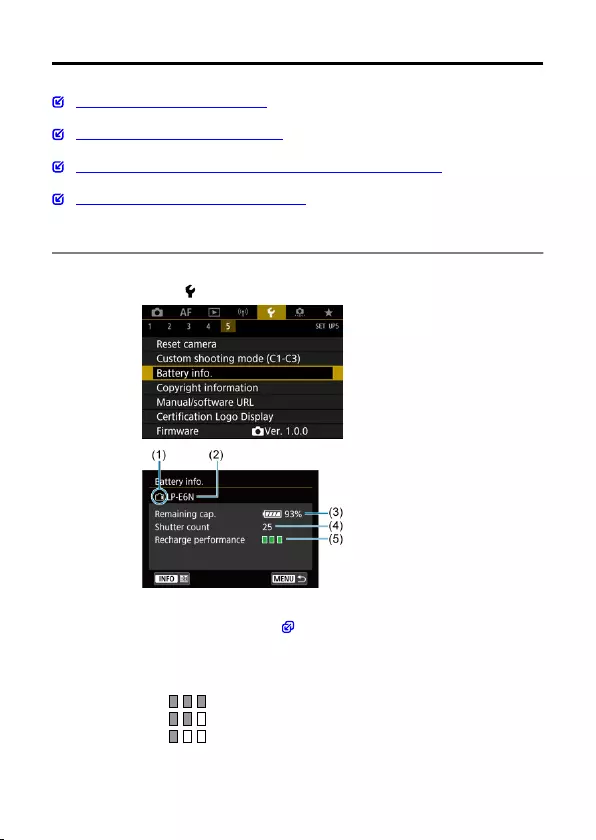
Battery Information
Registering Batteries to the Camera
Labeling Batteries with Serial Numbers
Checking the Remaining Capacity of a Registered Battery Not in Use
Deleting the Registered Battery Information
You can check the conditions of the battery you are using. By registering multiple batteries
to the camera, you can check their approximate remaining capacity and usage history.
1. Select [ : Battery info.].
(1) Battery position
(2) Model of battery or household power source used.
(3) Battery level indicator ( ) with the remaining battery level, in 1%
increments.
(4) The number of shots taken with the current battery. The number is reset
when the battery is charged.
(5) State of battery recharge performance, in three levels.
(Green): Battery recharge performance is good.
(Green): Battery recharge performance is slightly degraded.
(Red): Purchasing a new battery is recommended.
789

Caution
Using a genuine Canon Battery Pack LP-E6NH/LP-E6N is recommended. If you
use batteries that are not genuine Canon products, the camera’s full performance
may not be attained or malfunction may result.
Note
The shutter count is the number of still photos taken (not including movie
recording).
Battery information is also displayed when an optional Battery Grip BG-R10 is
used.
If a battery communication error message is displayed, follow the instructions in the
message.
790
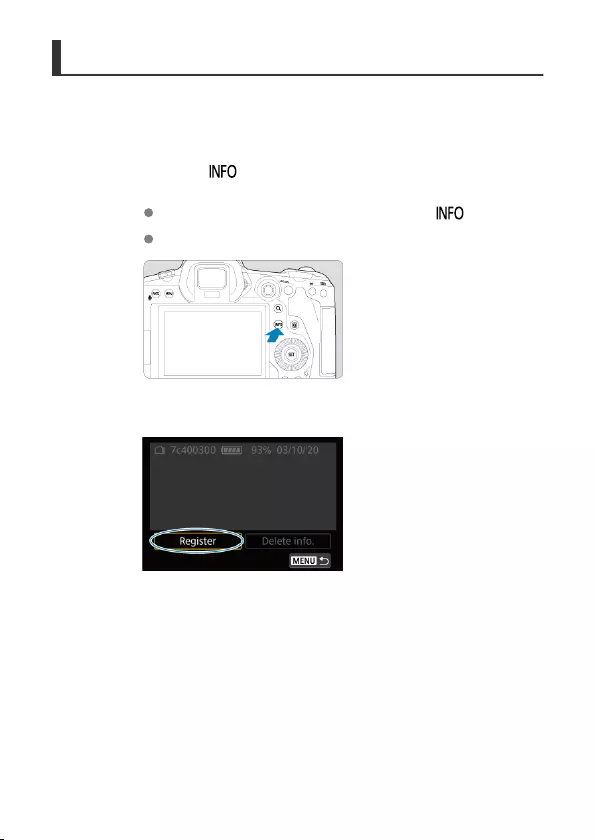
Registering Batteries to the Camera
You can register up to six LP-E6NH/LP-E6N/LP-E6 battery packs to the camera. To register
multiple batteries to the camera, follow the procedure below for each battery.
1. Press the < > button.
With the battery info. screen displayed, press the < > button.
If the battery is not registered, it will be grayed out.
2. Select [Register].
791
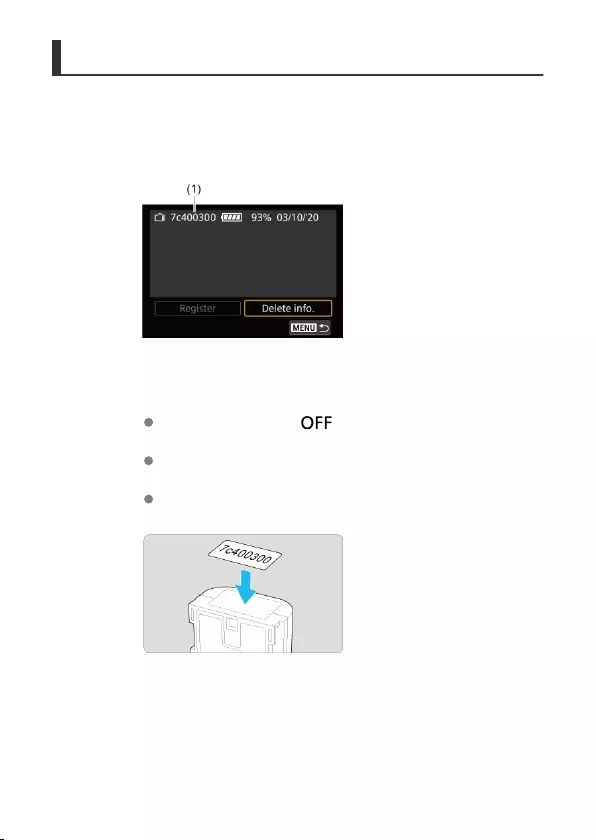
Labeling Batteries with Serial Numbers
It is convenient to label registered LP-E6NH/LP-E6N/LP-E6 battery packs with their serial
numbers, using commercially available labels.
1. On a label approx. 25×15 mm, write the serial number (1).
2. Apply the label.
Set the power switch to < >.
Remove the battery from the camera.
Apply the label as shown in the illustration (on the side with no
electrical contacts).
793

Caution
Do not apply the label on any part other than as shown in the illustration in step 2.
Otherwise, the misplaced label may make it difficult to insert the battery or
impossible to turn on the power.
When you use Battery Grip BG-R10 (sold separately), the label may peel off after
repeated insertion and removal from the battery magazine. If it peels off, apply a
new label.
794
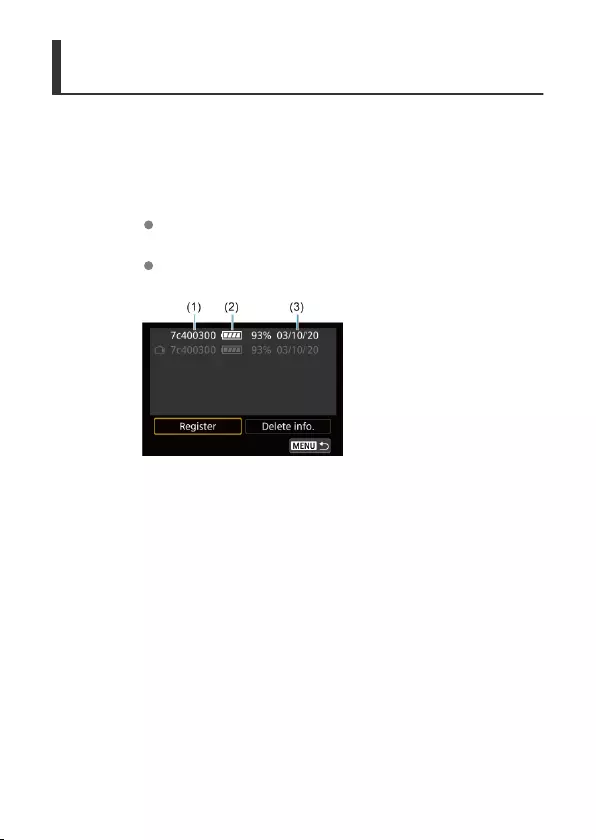
Checking the Remaining Capacity of a Registered Battery
Not in Use
You can check the remaining capacity of batteries not currently in use, as well as their last
date of use.
1. Find the matching serial number.
On the battery history screen, find the battery serial number (1)
matching the serial number that the battery is labeled with.
You can check the respective battery’s approximate remaining capacity
(2) and the date when it was last used (3).
795
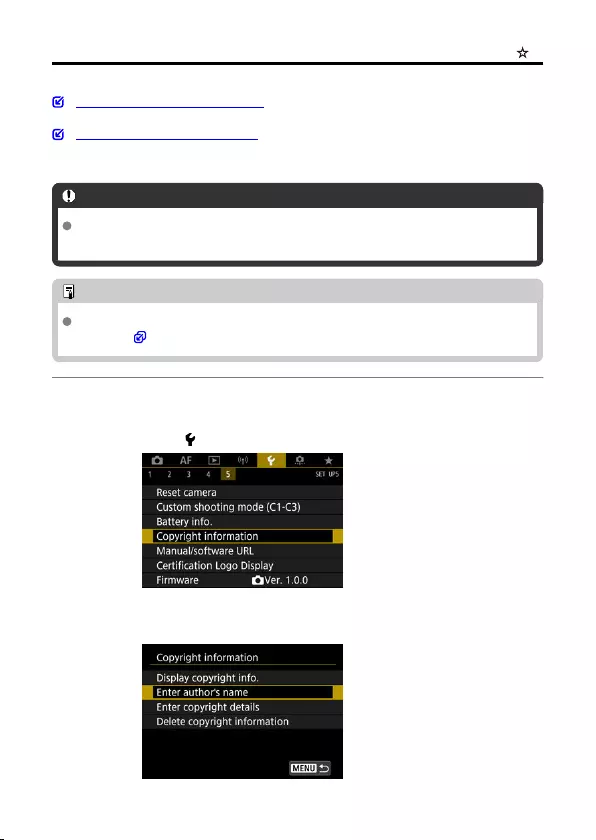
Copyright Information
Checking the Copyright Information
Deleting the Copyright Information
When you set the copyright information, it will be recorded to the image as Exif information.
Caution
If the entry for “Author” or “Copyright” is long, it may not be displayed entirely when
you select [Display copyright info.].
Note
You can also set or check copyright information with EOS Utility (EOS
software, ).
1. Select [ : Copyright information].
2. Select an option.
797

3. Enter text.
Use the < > dial or < > to select a character, then press < > to
enter it.
By selecting [ ], you can change the input mode.
To delete single characters, select [ ] or press the < > button.
4. Exit the setting.
Press the < > button, then press [OK].
Checking the Copyright Information
When you select [Display copyright info.] in step 2, you can check the [Author] and
[Copyright] information that you entered.
798

Deleting the Copyright Information
When you select [Delete copyright information] in step 2, you can delete the [Author] and
[Copyright] information.
799
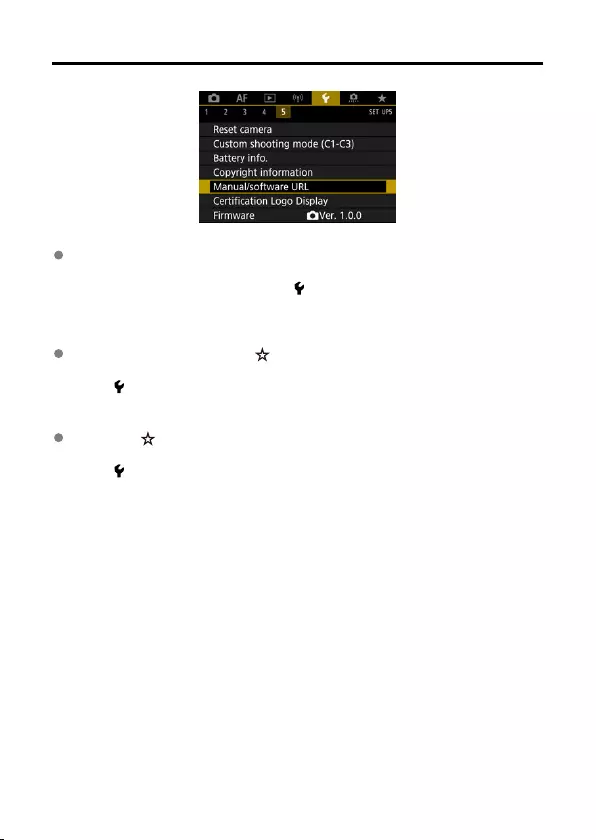
Other Information
Manual/software URL
To download instruction manuals, select [ : Manual/software URL] and scan the
displayed QR code with a smartphone. You can also use a computer to access the
website at the URL displayed and download software.
Certification Logo Display
Select [ : Certification Logo Display] to display some of the logos of the camera’s
certifications. Other certification logos can be found on the camera body and packaging.
Firmware
Select [ : Firmware] to update the firmware of the camera, lens, or other compatible
accessories in use.
800

Custom Functions/My Menu
You can fine-tune camera functions and change the functionality of buttons and dials to suit
your shooting preferences. You can also add menu items and Custom Functions that you
adjust frequently to My Menu tabs.
•Tab Menus: Customization
•Custom Function Setting Items
•Tab Menus: My Menu
•Registering My Menu
801

Tab Menus: Customization
Custom Functions 1
(1) Exposure level increments
(2) ISO speed setting increments
(3) Speed from metering/ISO Auto
(4) Bracketing auto cancel
(5) Bracketing sequence
(6) Number of bracketed shots
(7) Safety shift
Custom Functions 2
(1) Same expo. for new aperture
(2) AE lock meter. mode after focus
(3) Restrict shooting modes
(4) Set shutter speed range
(5) Set aperture range
802
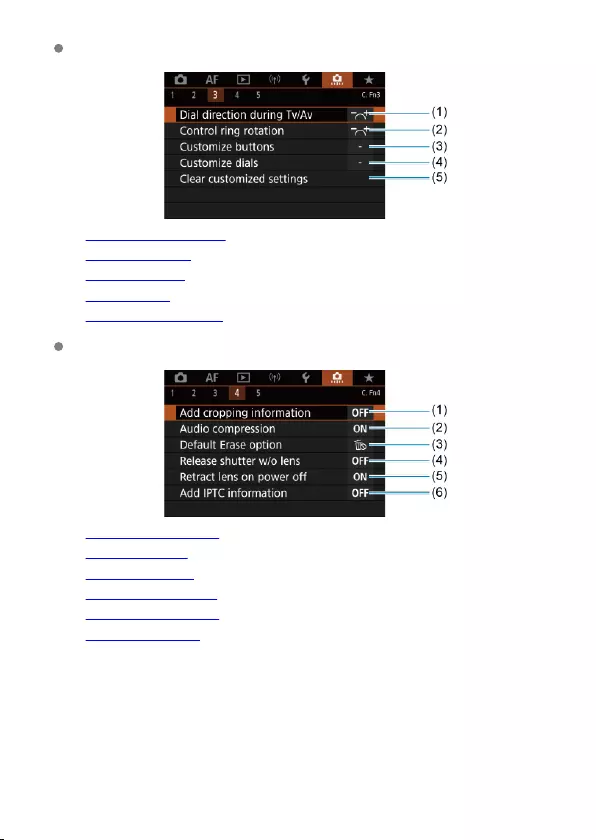
Custom Functions 3
(1) Dial direction during Tv/Av
(2) Control ring rotation
(3) Customize buttons
(4) Customize dials
(5) Clear customized settings
Custom Functions 4
(1) Add cropping information
(2) Audio compression
(3) Default Erase option
(4) Release shutter w/o lens
(5) Retract lens on power off
(6) Add IPTC information
803
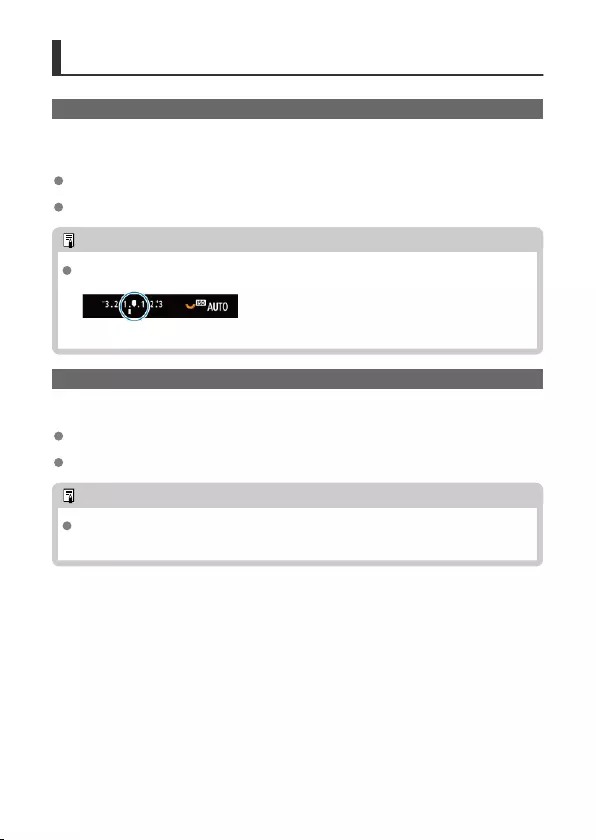
C.Fn1
Exposure level increments
You can specify to use 1/2-stop increments as the increments for shutter speed, aperture
value, exposure compensation, AEB, flash exposure compensation, and FEB.
1/3: 1/3-stop
1/2: 1/2-stop
Note
Display when set to [1/2-stop] is as follows.
ISO speed setting increments
You can change the manual ISO speed setting increment to a whole stop.
1/3: 1/3-stop
1/1: 1-stop
Note
Even if [1-stop] is set, ISO speed will be automatically set in 1/3-stop increments
when ISO Auto is set.
806
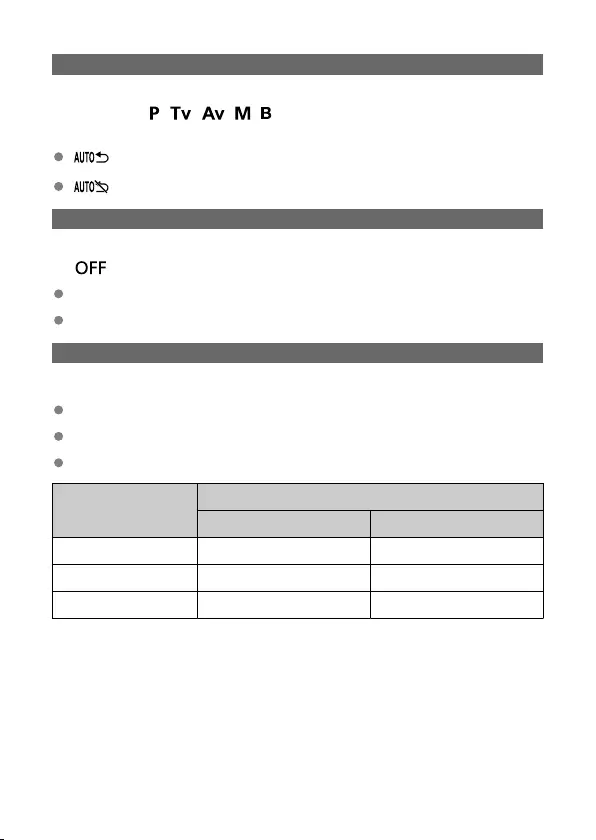
Speed from metering/ISO Auto
You can set the ISO speed status after the metering timer ends in cases where, for ISO
Auto operation in [ ]/[ ]/[ ]/[ ]/[ ] mode, the camera has adjusted the ISO speed
during metering or during the metering timer.
: Restore Auto after metering
: Retain speed after metering
Bracketing auto cancel
You can specify to cancel AEB and white balance bracketing when the power switch is set
to < >.
ON: Enable
OFF: Disable
Bracketing sequence
The AEB shooting sequence and white balance bracketing sequence can be changed.
0−+: 0, -, +
−0+: -, 0, +
+0−: +, 0, -
AEB
White Balance Bracketing
B/A Direction M/G Direction
0: Standard exposure 0: Standard white balance 0: Standard white balance
−: Underexposure −: Blue bias −: Magenta bias
+: Overexposure +: Amber bias +: Green bias
807

Number of bracketed shots
The number of shots taken with AEB and white balance bracketing can be changed.
When [Bracketing sequence] is set to [0, -, +], the bracketed shots will be taken as shown
in the following table.
3: 3 shots
2: 2 shots
5: 5 shots
7: 7 shots
(1-stop/step increments)
1st Shot 2nd Shot 3rd Shot 4th Shot 5th Shot 6th Shot 7th Shot
3: 3 shots Standard (0) −1 +1
2: 2 shots Standard (0) ±1
5: 5 shots Standard (0) −2 −1 +1 +2
7: 7 shots Standard (0) −3 −2 −1 +1 +2 +3
Note
If [2 shots] is set, you can select the + or − side when setting the AEB range. With
white balance bracketing, the second shot is adjusted toward the negative side for
the B/A or M/G direction.
808
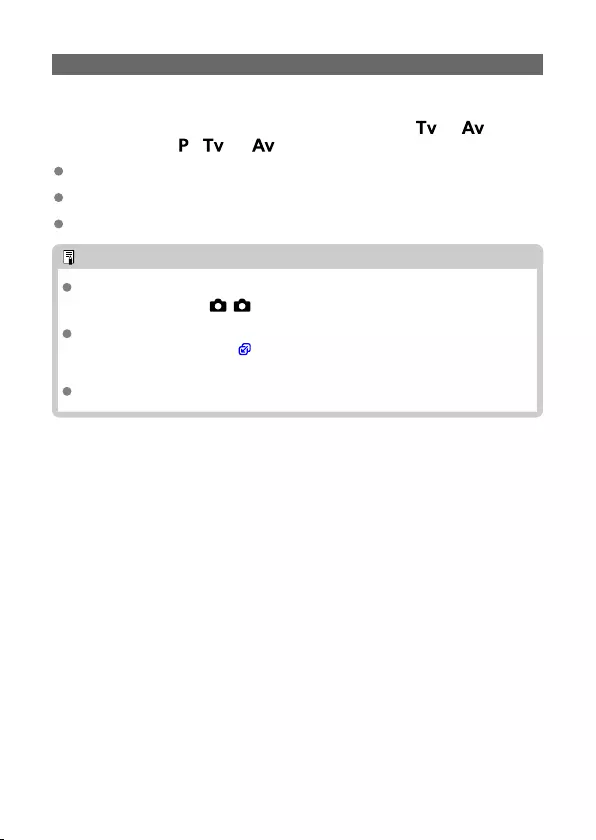
Safety shift
If the subject brightness changes and the standard exposure cannot be obtained within the
autoexposure range, the camera will automatically change the manually selected setting to
obtain the standard exposure. [Shutter speed/Aperture] applies to [ ] or [ ] mode.
[ISO speed] applies to [ ], [ ], or [ ] mode.
OFF: Disable
Tv/Av: Shutter speed/Aperture
ISO: ISO speed
Note
Safety shift overrides any changes to [ISO speed range] or [Min. shutter spd.]
from default settings in [ : ISO speed settings] if standard exposure cannot
be obtained.
The minimum and maximum limits for the safety shift with the ISO speed are
determined by [Auto range] ( ). However, if the manually set ISO speed exceeds
the [Auto range], the safety shift will take effect up or down to the manually set
ISO speed.
Safety shift will take effect as necessary even when flash is used.
809

C.Fn2
Same expo. for new aperture
The maximum aperture value may decrease (the lowest f/number may increase) in [ ]
mode (manual exposure shooting) with ISO speed set manually (except when set to ISO
Auto) if you (1) Change lenses, (2) Attach an extender, or (3) Use a zoom lens with a
variable maximum aperture value. This function prevents the corresponding underexposure
by adjusting ISO speed or shutter speed (Tv value) automatically to maintain the same
exposure as before (1), (2), or (3).
With [ISO speed/Shutter speed], the ISO speed is automatically adjusted within the ISO
speed range. If exposure cannot be maintained by adjusting ISO speed, shutter speed (Tv
value) is automatically adjusted.
OFF: Disable
ISO: ISO speed
ISO/Tv: ISO speed/Shutter speed
Tv: Shutter speed
Caution
Does not respond to changes in effective aperture value from changes in
magnification when macro lenses are used.
Cannot provide the same exposure as before (1), (2), or (3) if [ISO speed] is set
and the exposure cannot be maintained at speeds set in [ISO speed range].
Cannot provide the same exposure as before (1), (2), or (3) if [Shutter speed] is
set and the exposure cannot be maintained at speeds set in [ : Set shutter
speed range].
Note
Also responds to changes in the highest f/number (minimum aperture).
The original exposure setting is restored if you perform (1), (2), or (3) with [ISO
speed], [ISO speed/Shutter speed], or [Shutter speed] set and do not adjust ISO
speed, shutter speed, or aperture value before returning the camera to the original
state, before (1), (2), or (3).
Shutter speed may change to maintain exposure if the ISO speed increases to an
expanded ISO speed when [ISO speed] is set.
810

AE lock meter. mode after focus
For each metering mode, you can specify whether to lock the exposure (AE lock) once
subjects are in focus with One-Shot AF. The exposure will be locked while you keep
pressing the shutter button halfway. Select metering modes for AE lock and add a
checkmark [ ]. Select [OK] to register the setting.
Restrict shooting modes
1. Select [ : Restrict shooting modes].
2. Select [Enable].
3. Press the < > button.
811
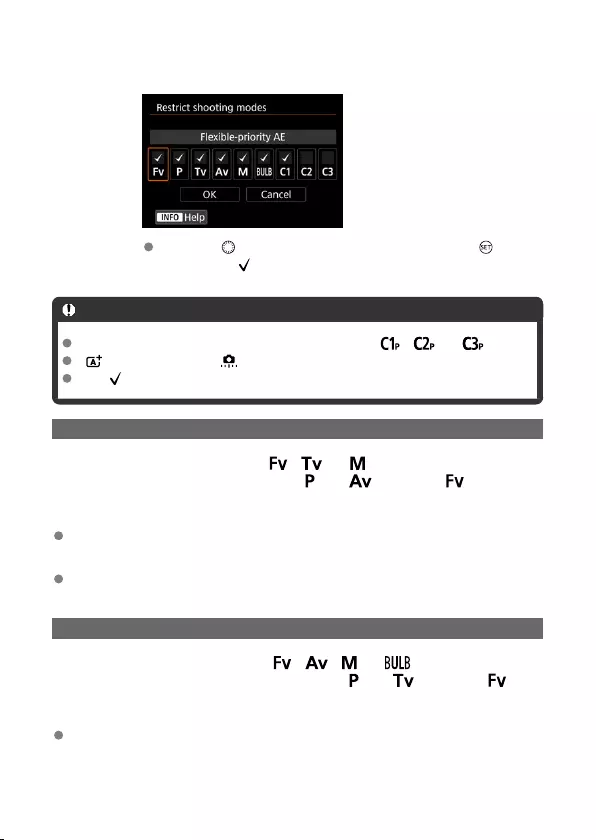
4. Select a shooting mode.
Turn the < > dial to select shooting modes, then press < > to add
a checkmark [ ].
Caution
Restricted shooting mode settings are not registered to [ ], [ ], or [ ].
[ ] is not available with [ : Restrict shooting modes] set to [Enable].
The [ ] mark cannot be cleared from all nine modes at the same time.
Set shutter speed range
You can set the shutter speed range. In [ ], [ ], or [ ] mode, you can set the shutter
speed manually within your specified range. In [ ] and [ ] mode, or in [ ] mode with
shutter speed set to [AUTO], the shutter speed is set automatically within your specified
range (except for movie recording). Select [OK] to register the setting.
Lowest speed
Can be set in a range of 30 sec.–1/4000 sec.
Highest speed
Can be set in a range of 1/8000 sec.–15 sec.
Set aperture range
You can set the aperture value range. In [ ], [ ], [ ], or [ ] mode, you can set the
aperture value manually within your specified range. In [ ] and [ ] mode, or in [ ] mode
with the aperture value set to [AUTO], the aperture value is set automatically within your
specified range. Select [OK] to register the setting.
Max. aperture
Can be set in a range of f/1.0–f/64.
812

Min. aperture
Can be set in a range of f/91–f/1.4.
Note
The available aperture value range varies depending on the lens’s minimum and
maximum aperture value.
813
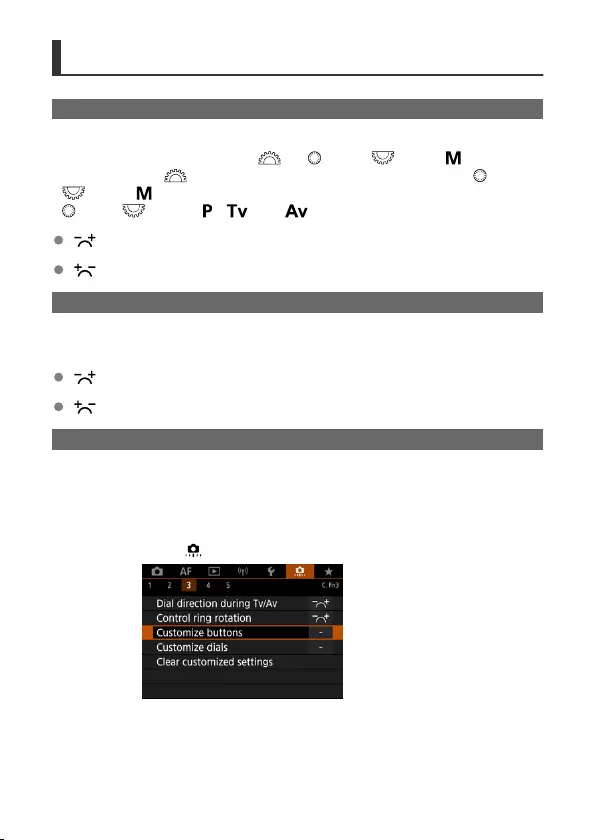
C.Fn3
Dial direction during Tv/Av
Dial turning direction when setting the shutter speed and aperture value can be reversed.
Reverses the turning direction of the <>, < >, and < > dial in [ ] shooting
mode and only the <> dial in other shooting modes. The direction of the < > and
< > dial in [ ] mode matches the direction to set exposure compensation with the
< > and < > dials in [ ], [ ], and [ ] modes.
: Normal
: Reverse direction
Control ring rotation
RF lens and mount adapter control ring turning direction when setting the shutter speed and
aperture value can be reversed.
: Normal
: Reverse direction
Customize buttons
You can assign frequently used functions to camera buttons that are easy for you to use.
Different functions, for use when shooting still photos or movies, can be assigned to the
same button.
1. Select [ : Customize buttons].
814
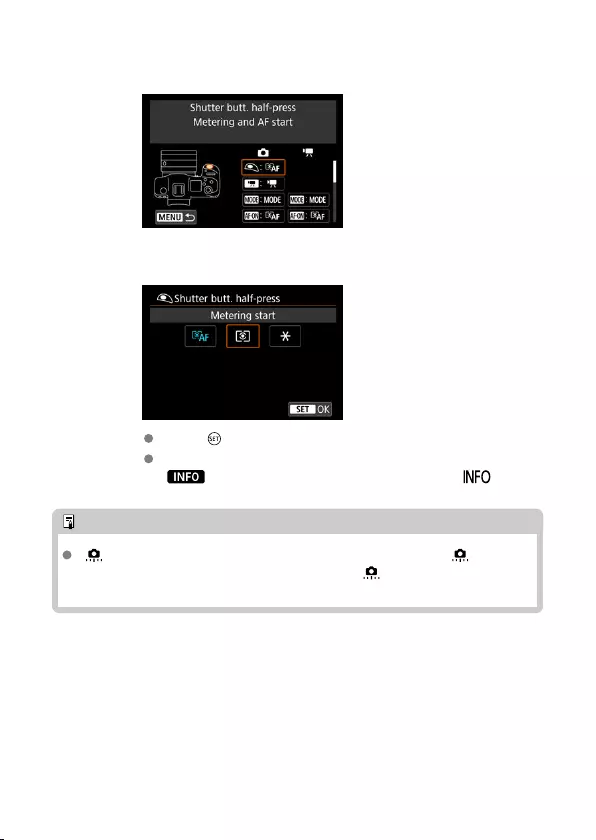
2. Select a part of the bar.
3. Select a function to assign.
Press < > to set it.
You can configure advanced settings for functions labeled with
[ ] in the lower left of the screen by pressing the < > button.
Note
[ : Customize buttons] settings are not cleared even if you select [ : Clear all
Custom Func. (C.Fn)]. To clear the settings, select [ : Clear customized
settings].
815

Functions available for customization
AF
●: Default ○: Available for customization
Function
● ● 〇〇〇〇
Metering and AF
start
〇〇〇〇〇〇 ●〇 〇
AF stop
〇〇〇〇 ●〇〇〇〇〇
AF point selection
〇
Direct AF point
selection
〇〇〇〇〇〇〇〇〇 ●
Set AF point to
center
〇〇〇〇〇
Switch to
registered AF
func.*1
〇〇〇〇〇〇〇〇〇〇
Direct AF method
selection*1
〇〇〇〇〇〇〇〇〇〇
One-Shot AF
Servo AF*1
〇〇〇〇〇
Eye Detection
AF*1
〇〇〇〇〇〇〇〇〇〇
Touch & drag AF
〇〇〇〇〇〇〇〇〇〇
Eye detection
〇〇〇〇〇〇〇〇〇〇
Peaking
816
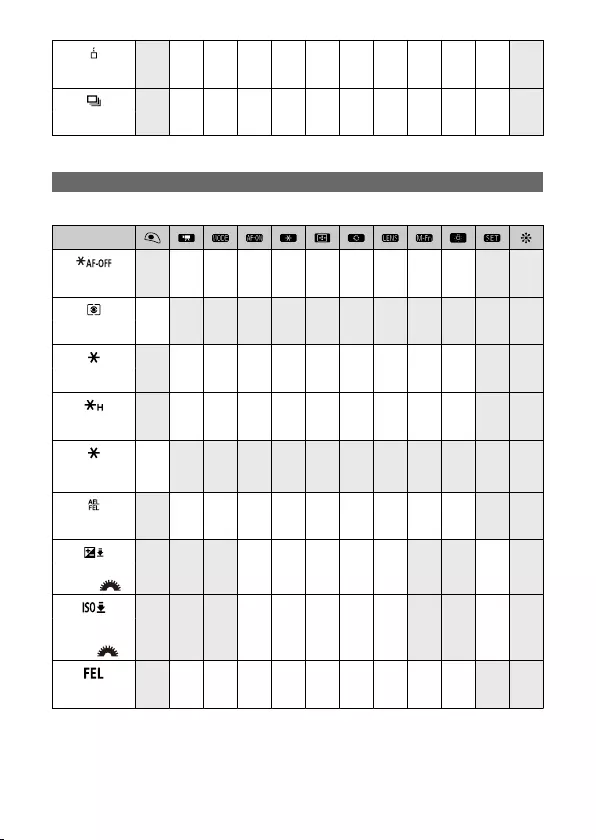
〇〇〇〇〇〇〇〇〇〇
Focus guide
〇〇〇〇〇〇〇〇〇〇
Drive mode*1
* 1: Cannot be assigned as a function available in movie recording.
Exposure Compensation
●: Default ○: Available for customization
Function
〇〇〇〇〇〇〇〇〇
AE lock, AF stop
〇
Metering start
〇〇〇●*3 〇〇〇〇〇
AE lock
〇〇〇〇〇〇〇〇〇
AE lock (hold)
〇
AE lock (while
button pressed)*1
〇〇〇●*4 〇〇〇〇〇
AE lock/FE lock*1
〇〇〇〇〇 〇
Expo comp (hold
btn, turn )
〇〇〇〇〇 〇
Set ISO
speed(hold
btn,turn )
〇〇〇〇〇〇〇〇〇
FE lock*1
* 1: Cannot be assigned as a function available in movie recording.
*3: Default in movie recording.
* 4: Default in still photo shooting.
817
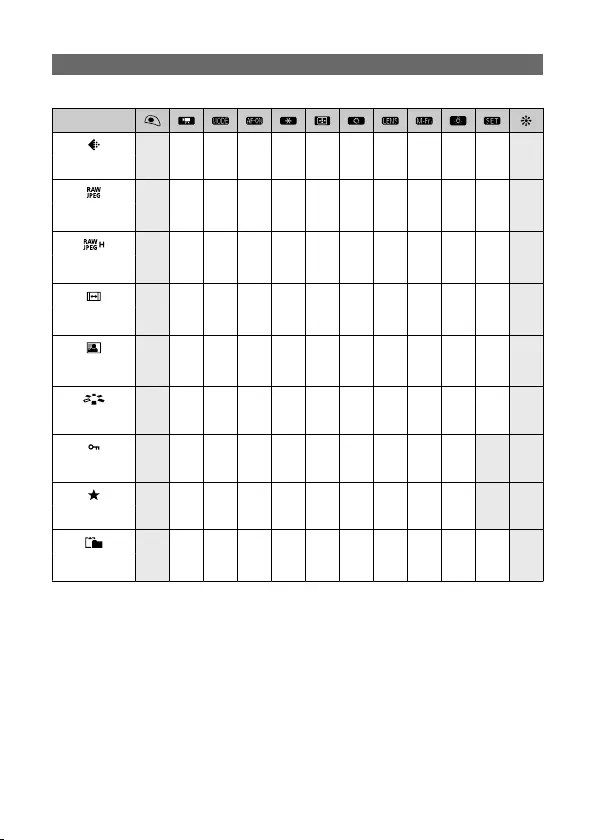
Image
●: Default ○: Available for customization
Function
〇〇〇〇〇〇〇〇〇〇
Image quality*1
〇〇〇〇〇〇〇〇〇〇
One-touch image
quality setting*1
〇〇〇〇〇〇〇〇〇〇
One-touch image
quality (hold)*1
〇〇〇〇〇〇〇〇〇〇
Still img aspect
ratio
〇〇〇〇〇〇〇〇〇〇
Auto Lighting
Optimizer
〇〇〇〇〇〇〇〇〇〇
Picture Style
〇〇〇〇〇〇〇〇〇
Protect
〇〇〇〇〇〇〇〇〇
Rating
〇〇〇〇〇〇〇〇〇〇
Record func
+card/folder sel.
* 1: Cannot be assigned as a function available in movie recording.
818

Movies
●: Default ○: Available for customization
Function
〇〇〇〇〇〇〇〇〇
Zebra pattern*2
●〇〇〇 〇〇〇〇
Movie recording
〇〇〇〇〇〇〇〇〇
Pause Movie
Servo AF
* 2: Cannot be assigned as a function available in still photo shooting.
Operation
●: Default ○: Available for customization
Function
〇〇〇〇〇〇〇〇〇〇
Flash function
settings*1
〇〇〇〇〇〇〇 ●〇 〇
Dial function
settings
〇
Short press: LCD
illumination
Long press: LCD
info switching
●
Short press: LCD
info switching
Long press: LCD
illumination
〇〇〇〇〇〇〇〇〇
LCD panel
illumination
〇〇〇〇〇〇〇〇〇
LCD panel info
switching
〇●〇〇〇〇〇〇〇
Shooting mode
settings
819
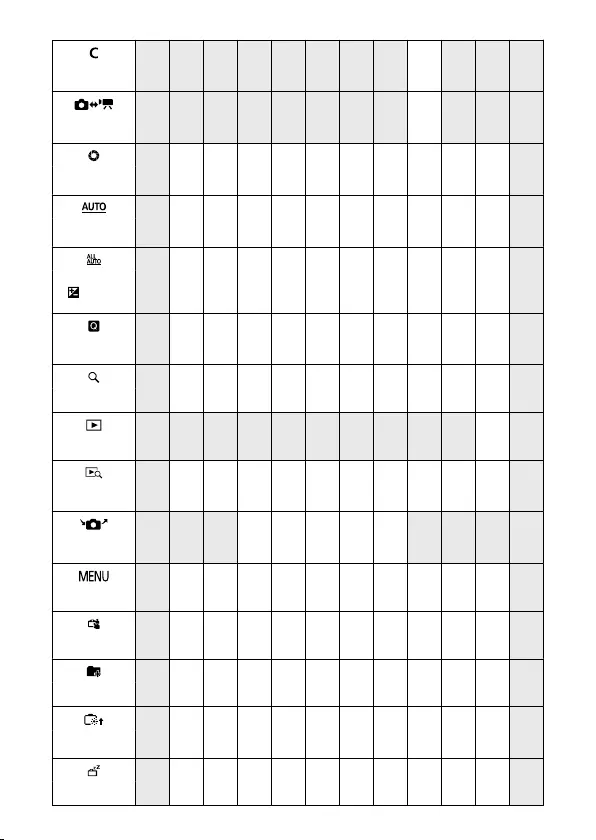
〇
Switch to Custom
shooting mode
〇
Still ←→ movie
switching
〇〇〇〇〇●*4 〇〇〇〇
Depth-of-field
preview*1
〇〇〇〇〇〇〇〇〇〇
Reset selected
item in Fv mode*1
〇〇〇〇〇〇〇〇〇〇
Reset Tv/Av/
/ISO in Fv
mode*1
〇〇〇〇〇〇〇〇〇〇
Quick Control
screen
〇〇〇〇〇〇〇〇〇〇
Magnify/Reduce
〇
Image replay
〇〇〇〇〇〇〇〇〇〇
Magnify images
during playback
〇〇〇〇〇
Register/recall
shooting func*1
〇〇〇〇〇〇〇〇〇〇
Menu display
〇〇〇〇〇〇〇〇〇〇
Touch Shutter*1
〇〇〇〇〇〇〇〇〇〇
Create folder*1
〇〇〇〇〇〇〇〇〇〇
Maximize screen
brightness (temp)
〇〇〇〇〇〇〇〇〇〇
Display off
820
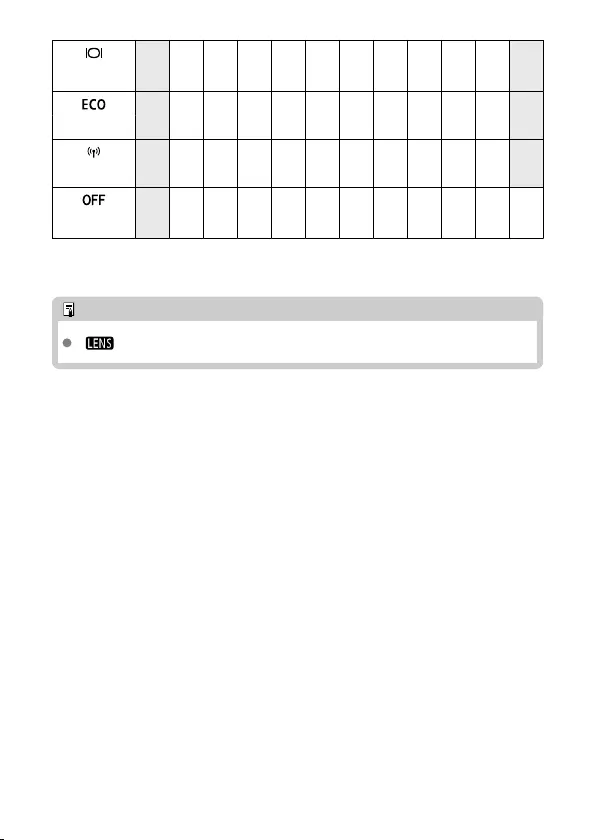
〇〇〇〇〇〇〇〇〇〇
Switch between
VF/screen
〇〇〇〇〇〇〇〇〇〇
Eco mode
〇〇〇〇〇〇〇〇〇〇
Wi-Fi function
〇〇〇〇〇〇*3 〇〇〇〇 ●
No function
(disabled)
* 1: Cannot be assigned as a function available in movie recording.
*3: Default in movie recording.
* 4: Default in still photo shooting.
Note
[ ]: “AF stop button” on Image Stabilizer-equipped super telephoto lenses.
821

Customize dials
Frequently used functions can be assigned to the <>/< >/< >/< > dials.
1. Select [ : Customize dials].
2. Select a part of the bar.
3. Select a function to assign.
Press < > to set it.
You can configure advanced settings for functions labeled with
[ ] in the lower left of the screen by pressing the < > button.
822

Note
[ : Customize dials] settings are not cleared even if you select [ : Clear all
Custom Func. (C.Fn)]. To clear the settings, select [ : Clear customized
settings].
823
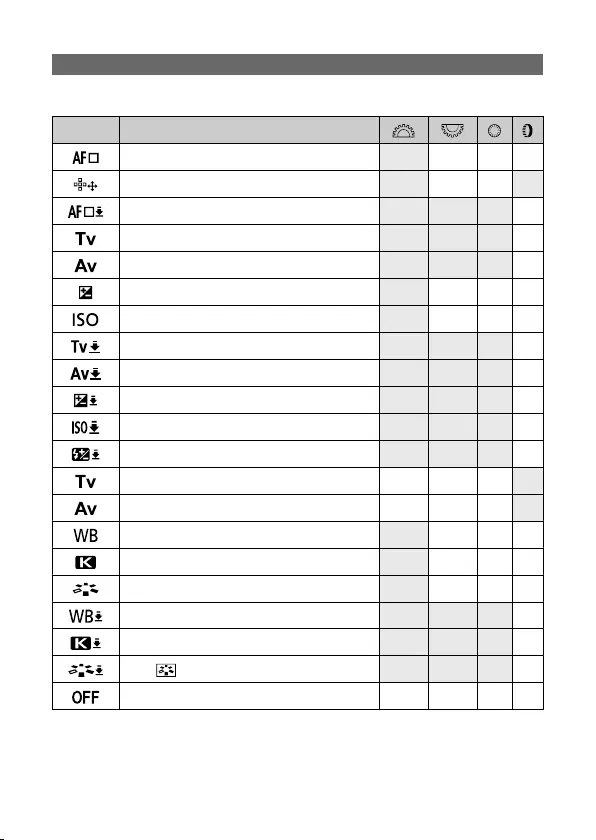
Functions available for dials
●: Default ○: Available for customization
Function
Select AF method ○ ○ ○
Direct AF point selection ○ ○
AF method (hold meter. btn) ○
Change shutter speed ○
Change aperture value ○
Exposure compensation ○ ○ ○
Set ISO speed ● ○ ○
Change shutter spd. (hold meter. btn) ○
Change aperture (hold meter. btn) ○
Exposure comp. (hold meter. btn) ●
Set ISO speed (hold meter. btn) ○
Flash exp comp (hold meter.btn) ○
Shutter speed setting in M mode ● ○ ○
Aperture setting in M mode ○ ○ ●
White balance selection ○ ○ ○
Select color temperature ○ ○ ○
Picture Style ○ ○ ○
Select WB (hold meter. btn) ○
Color temp. (hold meter. btn) ○
Select (hold meter. btn) ○
No function (disabled) ○ ○ ○ ○
824

Note
< > and < > dials cannot be customized in [ ] mode.
< >: Control ring on RF lenses and mount adapters.
825
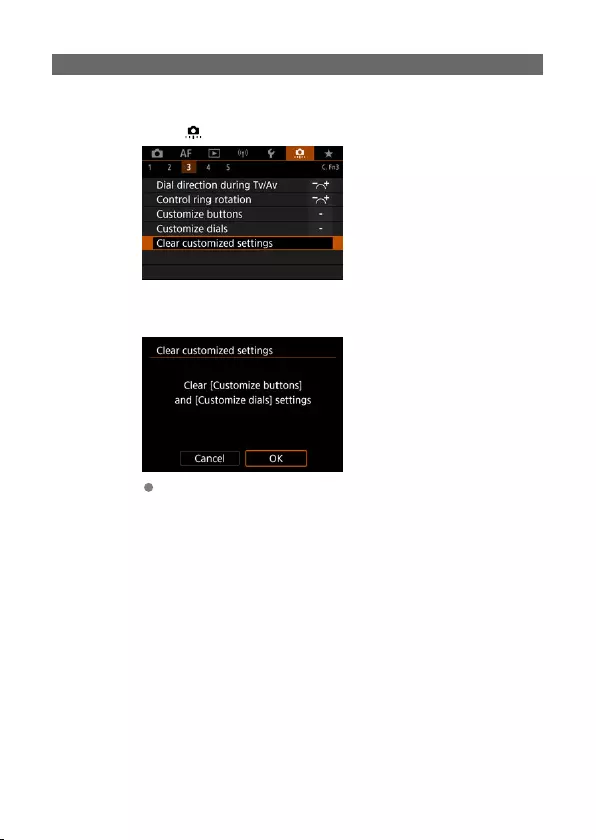
Clear customized settings
1. Select [ : Clear customized settings].
2. Select [OK].
[Customize buttons] and [Customize dials] are restored to defaults.
826

C.Fn4
Add cropping information
Adding cropping information displays vertical lines for the aspect ratio specified in shooting,
so that you can compose shots as if shooting with a medium- or large-format camera (6×6
cm, 4×5 inch, and so on).
When you shoot, instead of cropping images recorded to the card, the camera adds aspect
ratio information to images for cropping in the Digital Photo Professional (EOS software).
You can import images to Digital Photo Professional on a computer and easily crop images
to the aspect ratio set at the time of shooting.
OFF: Disable
6:6: Aspect ratio 6:6
3:4: Aspect ratio 3:4
4:5: Aspect ratio 4:5
6:7: Aspect ratio 6:7
5:6: Aspect ratio 10:12
5:7: Aspect ratio 5:7
Caution
Cropping information can only be added when [ : Cropping/aspect ratio] is
set to [Full-frame].
JPEG or HEIF images are not saved at the cropped size if you use the camera to
process RAW images with cropping information ( ). In this case, RAW processing
produces JPEG or HEIF images with cropping information.
Note
Vertical lines indicating your specified aspect ratio are displayed on the screen.
827
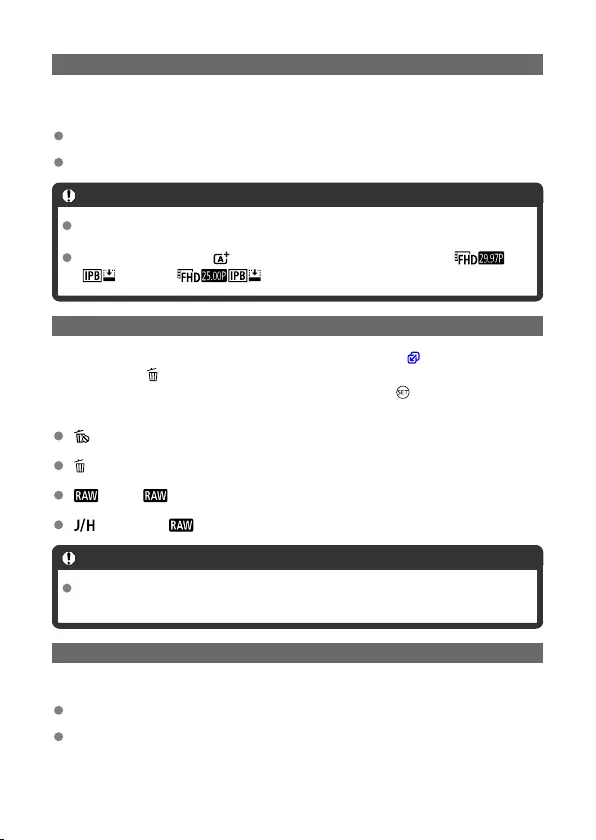
Audio compression
Sets audio compression for movie recording. [Disable] allows higher audio quality than
when audio is compressed, but file sizes are larger.
ON: Enable
OFF: Disable
Caution
Editing movie files recorded with [Disable] and then saving them with compression
will also compress the audio.
Audio is compressed in [ ] mode when [Movie rec quality] is set to
(NTSC) or (PAL), even if [Disable] is selected.
Default Erase option
You can set which option is selected by default in the erase menu ( ), which is accessed
by pressing the < > button during image playback or during review after shooting.
By setting an option other than [Cancel], you can simply press <> to erase images
quickly.
: [Cancel] selected
: [Erase] selected
: [Erase ] selected
: [Erase non- ] selected
Caution
Be careful not to erase images accidentally when an option other than [Cancel] is
set.
Release shutter w/o lens
You can specify whether shooting still photos or movies is possible without a lens attached.
OFF: Disable
ON: Enable
828
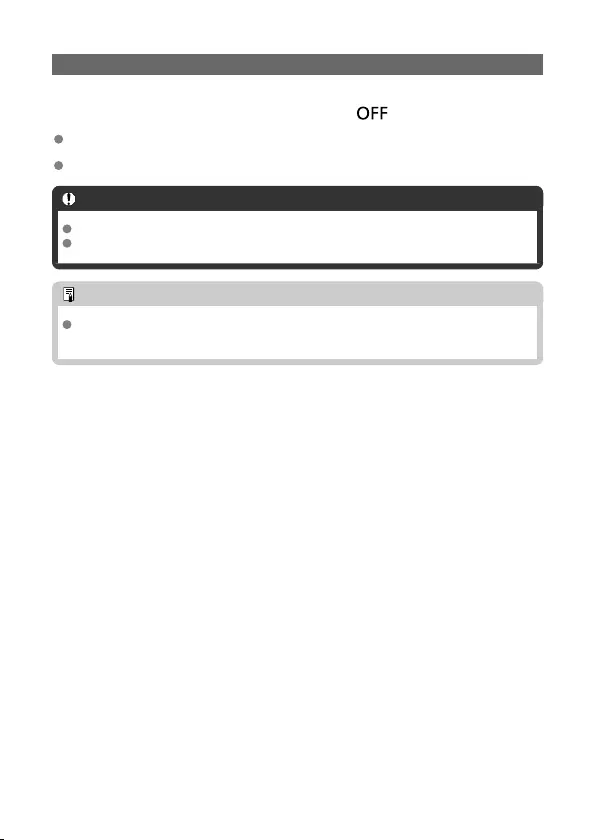
Retract lens on power off
You can set whether to retract gear-type STM lenses (such as EF40mm f/2.8 STM)
automatically when the camera’s power switch is set to <>.
ON: Enable
OFF: Disable
Caution
With auto power off, the lens will not retract regardless of the setting.
Before detaching the lens, make sure that it is retracted.
Note
When [Enable] is set, this function takes effect regardless of the lens’s focus mode
switch setting (AF or MF).
829

Add IPTC information
Registering IPTC (International Press Telecommunications Council) information to the
camera from EOS Utility (EOS software) enables you to record (add) this information to
JPEG/HEIF/RAW still photos at the time of shooting. This is helpful in file management
and other tasks using the IPTC information.
For instructions on registering IPTC information to the camera and details on the
information you can register, refer to the EOS Utility Instruction Manual.
OFF: Disable
ON: Enable
Caution
IPTC information is not added when you record movies.
Note
During playback, you can check whether IPTC information was added.
You can use Digital Photo Professional (EOS software) to check IPTC information
in images.
IPTC information registered to the camera is not erased if you select [ : Clear all
Custom Func. (C.Fn)] ( ), but the setting changes to [Disable].
830

C.Fn5
Clear all Custom Func. (C.Fn)
Selecting [ : Clear all Custom Func. (C.Fn)] clears all Custom Function settings except
[Customize buttons] and [Customize dials].
Note
Performing [ : Clear all Custom Func. (C.Fn)] does not clear settings
configured in [ : Customize buttons] and [ : Customize dials]. To clear the
settings, select [ : Clear customized settings]. Note that although information
added using [ : Add IPTC information] is retained, the setting changes to
[Disable].
831
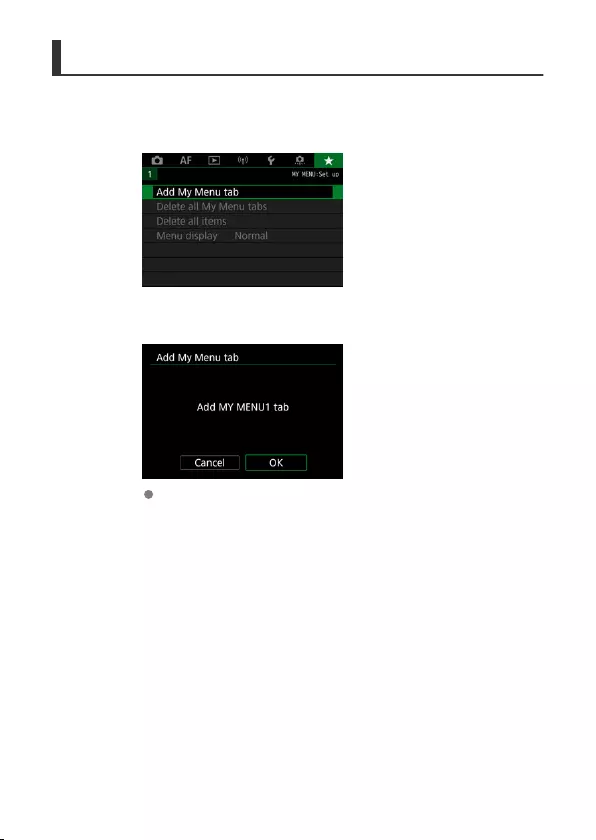
Creating and Adding My Menu Tabs
1. Select [Add My Menu tab].
2. Select [OK].
You can create up to five My Menu tabs by repeating steps 1 and 2.
834
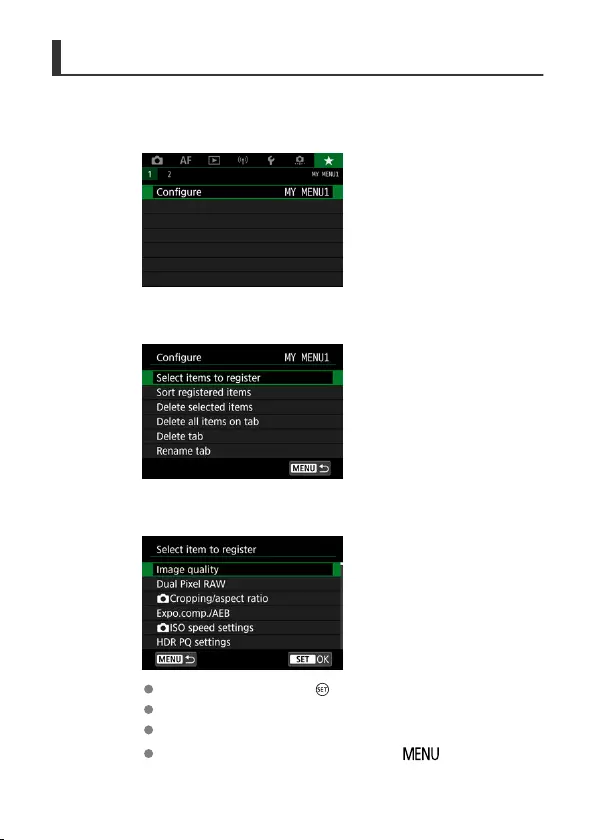
Registering Menu Items on My Menu Tabs
1. Select [MY MENU*: Configure].
2. Select [Select items to register].
3. Register the desired items.
Select an item, then press < >.
Select [OK] on the confirmation screen.
You can register up to six items.
To return to the screen in step 2, press the < > button.
835
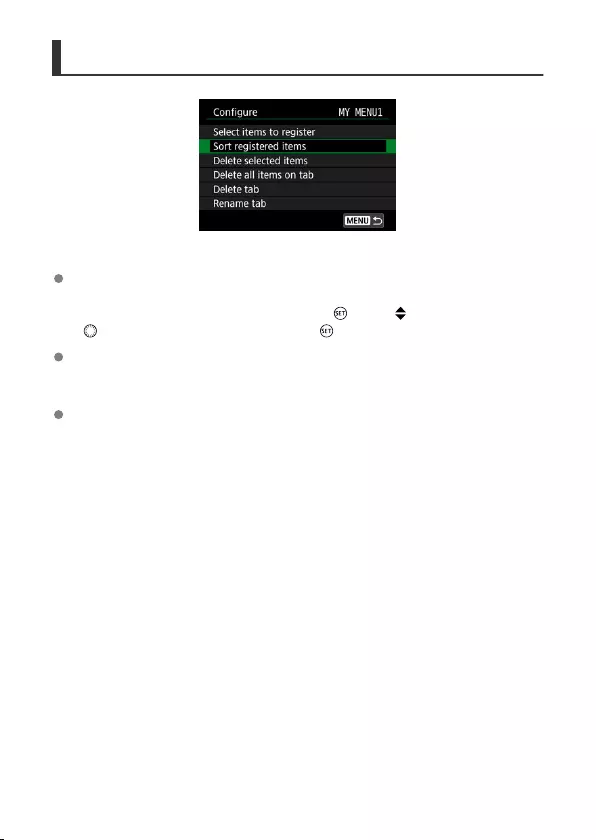
My Menu Tab Settings
You can sort and delete items on the menu tab, and rename or delete the menu tab itself.
Sort registered items
You can change the order of the registered items in My Menu. Select [Sort registered
items], select an item to rearrange, then press <>. With [ ] displayed, turn the
< > dial to rearrange the item, then press < >.
Delete selected items/Delete all items on tab
You can delete any of the registered items. [Delete selected items] deletes one item at
a time, and [Delete all items on tab] deletes all the registered items on the tab.
Delete tab
You can delete the current My Menu tab. Select [Delete tab] to delete the [MY MENU*]
tab.
836
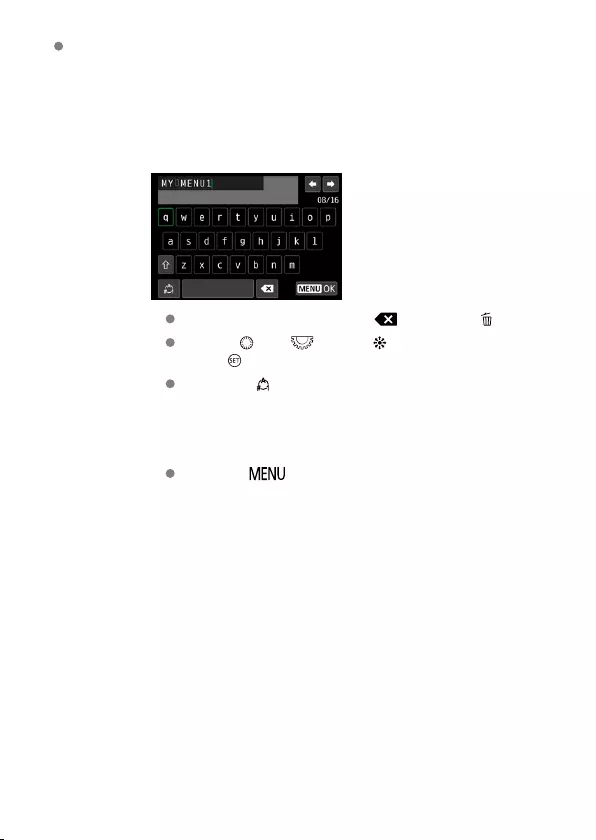
Rename tab
You can rename the My Menu tab from [MY MENU*].
1. Select [Rename tab].
2. Enter text.
To delete single characters, select [ ] or press the < > button.
Use the < > or < > dial or < > to select a character, then
press < > to enter it.
By selecting [ ], you can change the input mode.
3. Confirm input.
Press the < > button, then select [OK].
837
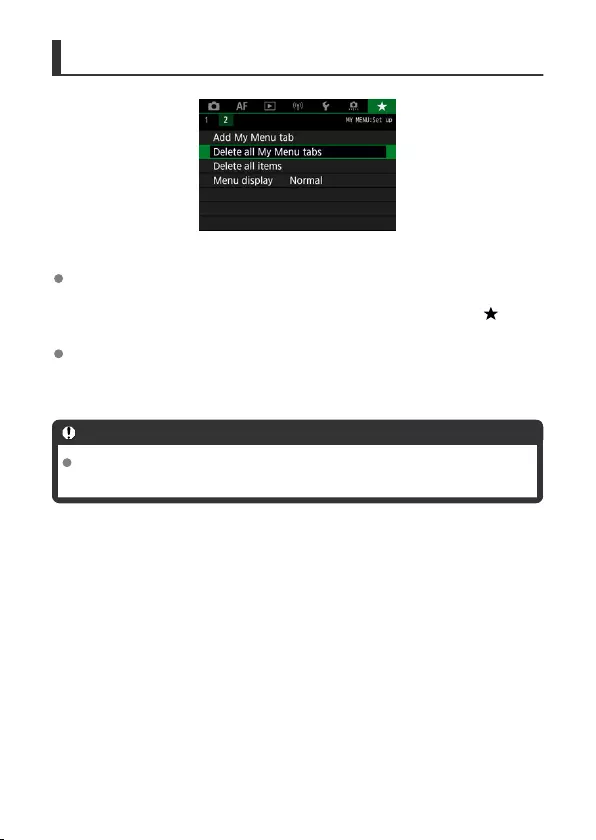
Deleting All My Menu Tabs/Deleting All Items
You can delete all the created My Menu tabs or My Menu items registered on them.
Delete all My Menu tabs
You can delete all My Menu tabs you created. When you select [Delete all My Menu
tabs], all the tabs from [MY MENU1] to [MY MENU5] will be deleted and the [ ] tab will
revert to its default.
Delete all items
You can delete all the items registered under the [MY MENU1] to [MY MENU5] tabs. The
tabs themselves will remain. When [Delete all items] is selected, all the items registered
on all the created tabs will be deleted.
Caution
Performing [Delete tab] or [Delete all My Menu tabs] will also delete tab names
renamed with [Rename tab].
838
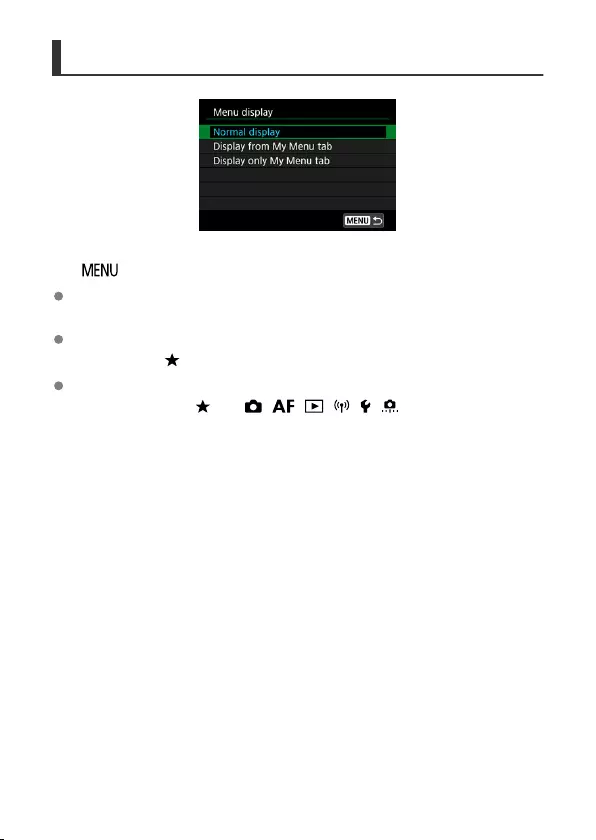
Menu Display Settings
You can select [Menu display] to set the menu screen that is to appear first when you press
the < > button.
Normal display
Displays the last displayed menu screen.
Display from My Menu tab
Displays with the [ ] tab selected.
Display only My Menu tab
Restricts display to the [ ] tab ([ ]/[ ]/[ ]/[ ]/[ ]/[ ] tabs are not displayed).
839

Reference
This chapter provides reference information on camera features.
•Importing Images to a Computer
•Using a USB Power Adapter to Charge/Power the Camera
•Using a Battery Grip
•Troubleshooting Guide
•Error Codes
•System Map
•ISO Speed in Movie Recording
•Information Display
•EF Lenses Supporting 12 Shots/Sec. Continuous Shooting
•Specifications
840
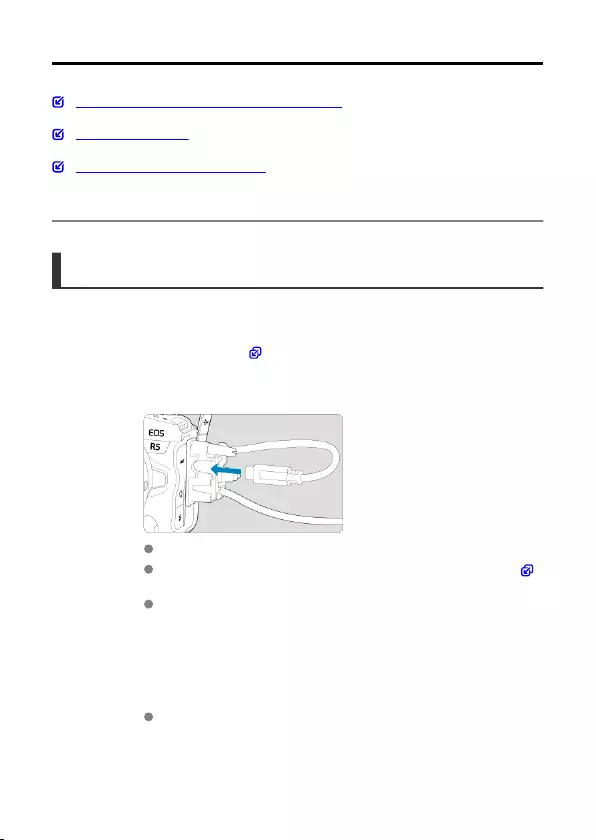
Importing Images to a Computer
Connecting to a Computer with an Interface Cable
Using a Card Reader
Connecting to a Computer via Wi-Fi
You can use EOS software to import images from the camera to a computer. There are
three ways to do this.
Connecting to a Computer with an Interface Cable
1. Install EOS Utility ( ).
2. Connect the camera to the computer.
Use the interface cable included with the camera.
When connecting the cable to the camera, use the cable protector ( )
and insert the plug in the digital terminal.
Insert the other end of the cable into the computer’s USB terminal
(Type-C).
3. Use EOS Utility to import the images.
Refer to the EOS Utility Instruction Manual.
841

Caution
With a Wi-Fi connection established, the camera cannot communicate with the
computer even if they are connected with an interface cable.
842

Using a Card Reader
You can use a card reader to import images to a computer.
1. Install Digital Photo Professional ( ).
2. Insert the card into the card reader.
3. Use Digital Photo Professional to import the images.
Refer to the Digital Photo Professional Instruction Manual.
Note
When downloading images from the camera to a computer with a card reader
without using EOS software, copy the DCIM folder on the card to the computer.
843
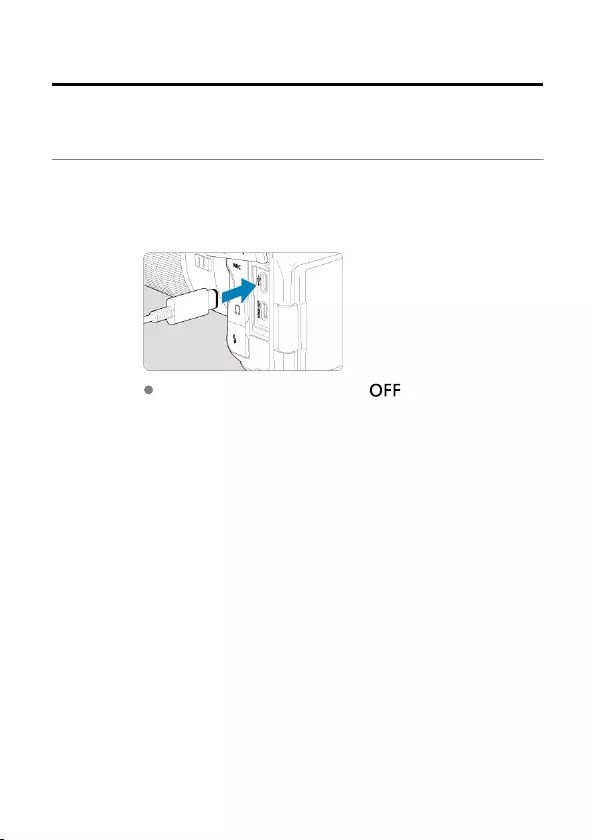
Using a USB Power Adapter to Charge/Power the
Camera
Using USB Power Adapter PD-E1 (sold separately), you can charge Battery Pack LP-E6NH
or LP-E6N without removing it from the camera. The camera can also be powered. Note
that Battery Pack LP-E6 cannot be charged this way.
Charging
1. Connect the USB power adapter.
With the camera power switch set to < >, insert the USB power
adapter plug fully into the digital terminal.
845
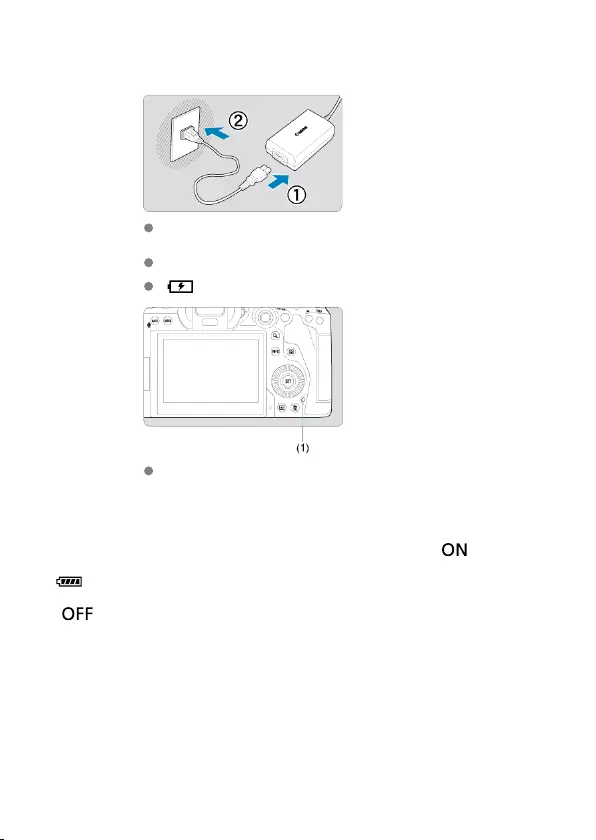
2. Connect the power cord.
Connect the power cord to the USB power adapter and plug the other
end into a power outlet.
Charging begins, and the access lamp (1) is lit in green.
[ ] is displayed on the LCD panel.
When charging is finished, the access lamp turns off.
Supplying power
To power the camera without charging, set the camera power switch to <>. However,
batteries are charged during auto power off.
[ ] is displayed on the LCD panel and screen while the camera is powered.
To change from powering the camera to charging, set the camera power switch to
< >.
846

Caution
The camera cannot be powered unless a battery pack is in it.
When batteries are depleted, the adapter charges them. In this case, power is not
supplied to the camera.
To protect the battery pack and keep it in optimal condition, do not charge it
continuously for more than 24 hours.
If the charging lamp fails to light up or a problem occurs during charging (shown by
the access lamp blinking in green), unplug the power cord, reinsert the battery, and
wait a few minutes before plugging it in again. If the problem persists, take the
camera to the nearest Canon Service Center.
The charging time required and the amount charged vary depending on ambient
temperature and remaining capacity.
For safety, charging in low temperatures takes longer.
The remaining battery level may decline when power is supplied to the camera. To
avoid running out of battery power, use a fully charged battery when shooting at
regular intervals.
847
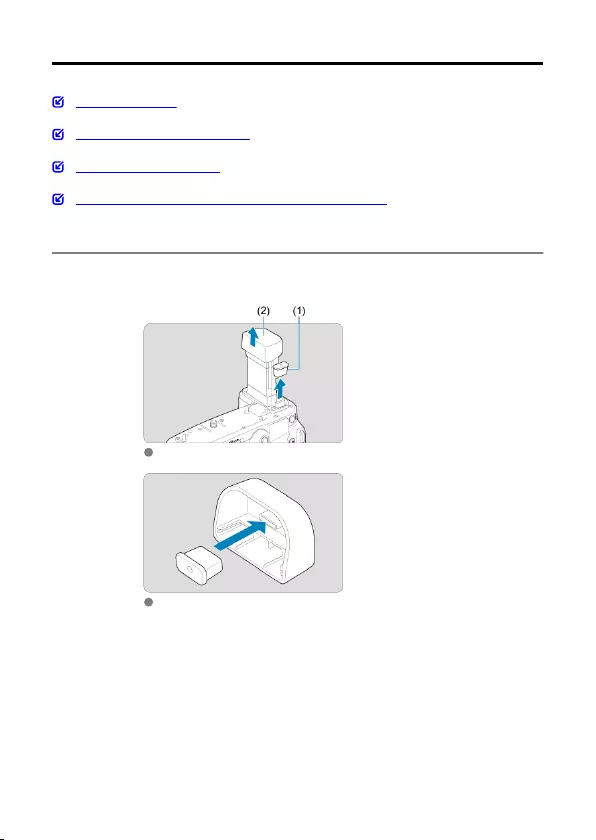
Using a Battery Grip
Attaching Batteries
Using a Household Power Outlet
Button and Dial Operations
Using a USB Power Adapter to Charge/Power the Camera
Equipped with buttons and dials for vertical shooting, Battery Grip BG-R10 is an optional
camera accessory that can power the camera with two batteries.
1. Remove the contact covers.
Remove contact covers (1) and (2) on the battery grip.
Attach the battery grip contact cover (1) to (2) to store them.
848
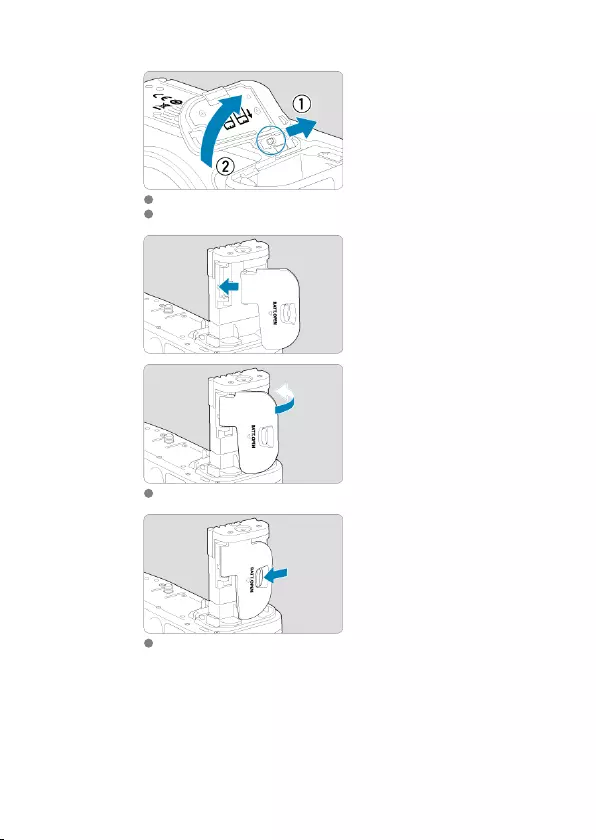
2. Remove the battery compartment cover.
Turn off the camera before removing the battery.
Remove the battery compartment cover from the camera.
Attach the cover to the battery grip.
To remove the cover, slide the lever to release it, following the
attachment procedure in reverse.
849
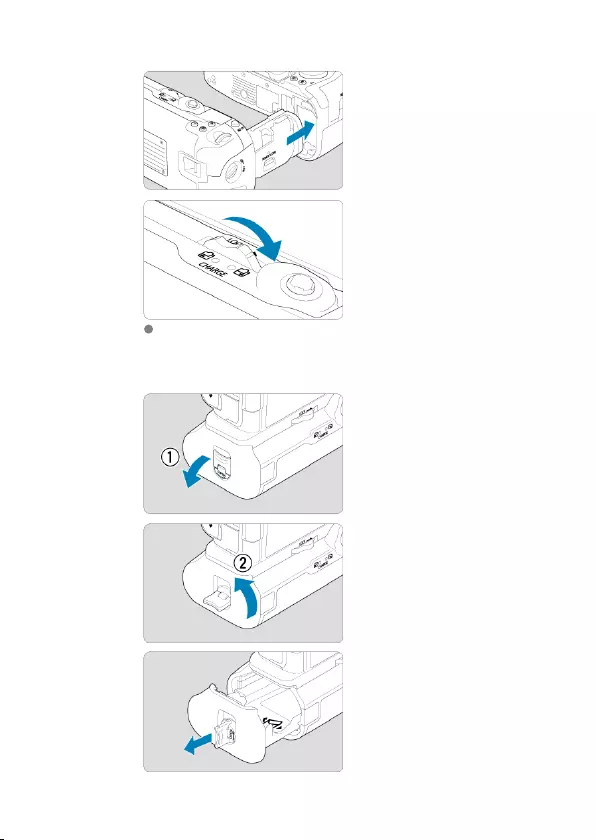
3. Attach and lock the battery grip.
Insert the battery grip in the camera and turn the release dial to lock it
in place.
4. Remove the battery magazine.
850

Caution
When reattaching the battery compartment cover to the camera, attach it opened to
at least 90°.
Do not touch the camera or battery grip contacts.
851
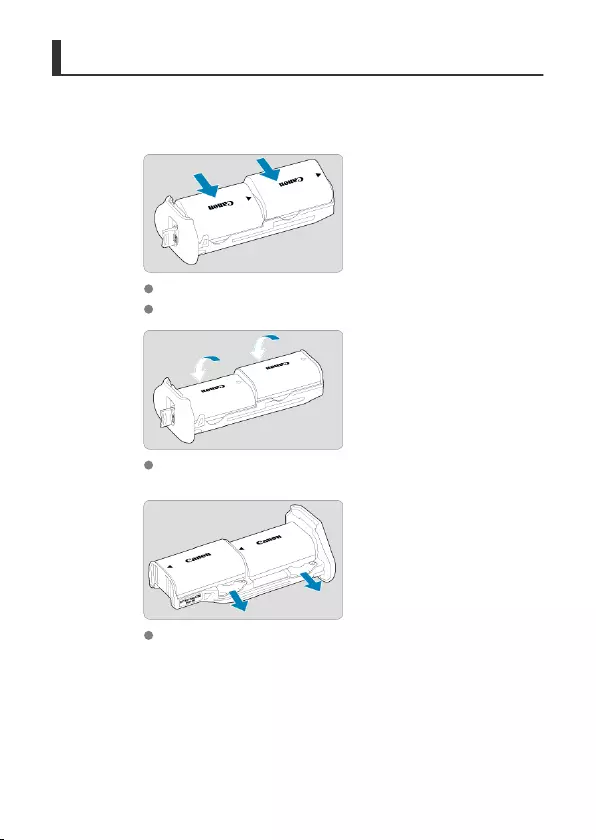
Attaching Batteries
1. Attach the batteries.
Insert the batteries as shown.
When only one battery is used, it can be inserted in either position.
To secure the batteries, push in the direction of the arrows until they
click into place.
To remove the batteries, press the battery magazine lever in the
direction of the arrow.
852
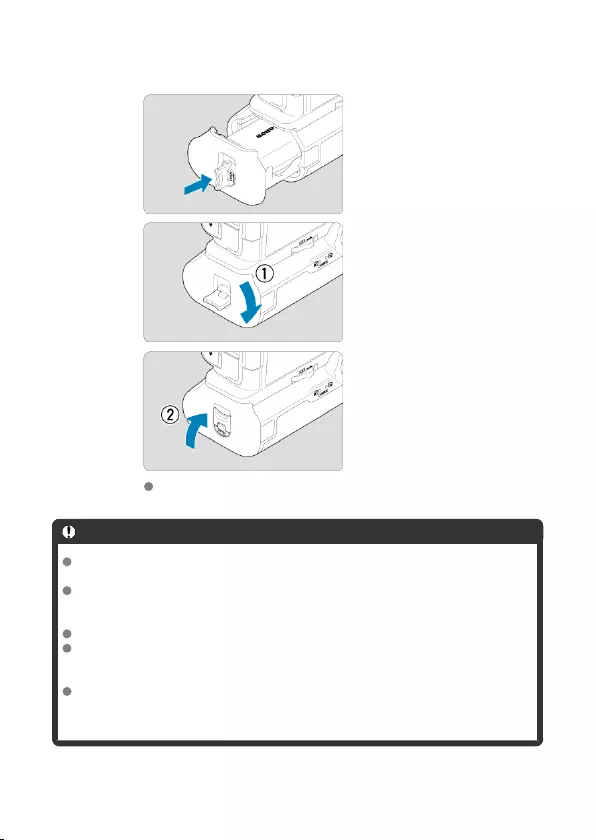
2. Attach the battery magazine.
Insert the battery magazine all the way in to secure it.
Caution
When attaching batteries, make sure the electrical contacts are clean. Wipe off any
dirt on the contacts with a soft cloth.
Attach batteries after attaching the battery grip to the camera. If the battery grip is
attached to the camera with batteries already attached, it may prevent correct
display of battery check results.
Before removing the battery grip, turn the camera off and remove the batteries.
Reattach the protective covers for the camera and battery grip contacts after
removing the battery grip. If the battery grip will not be used for some time, remove
the batteries.
If a battery communication error message is displayed when a battery grip is
attached, follow the instructions in the message. If the camera loses power,
reinstall the battery magazine and restart the camera.
853
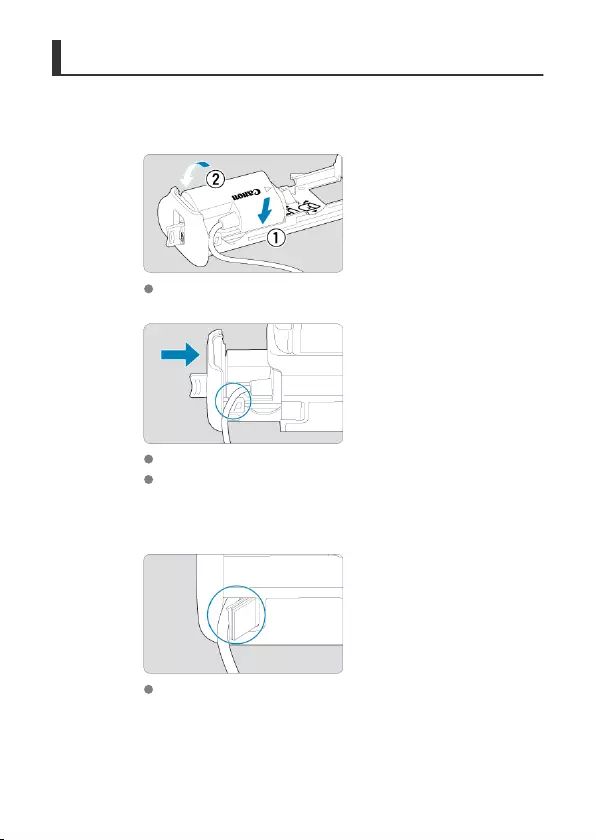
Using a Household Power Outlet
1. Attach the DC coupler.
Attach DC Coupler DR-E6 (sold separately) the same way as the
batteries.
Pass the DC coupler cord through the battery magazine cord groove.
Insert the battery magazine all the way in to secure it.
2. Attach the battery magazine.
Guide the end of the cord out of the cord hole.
854
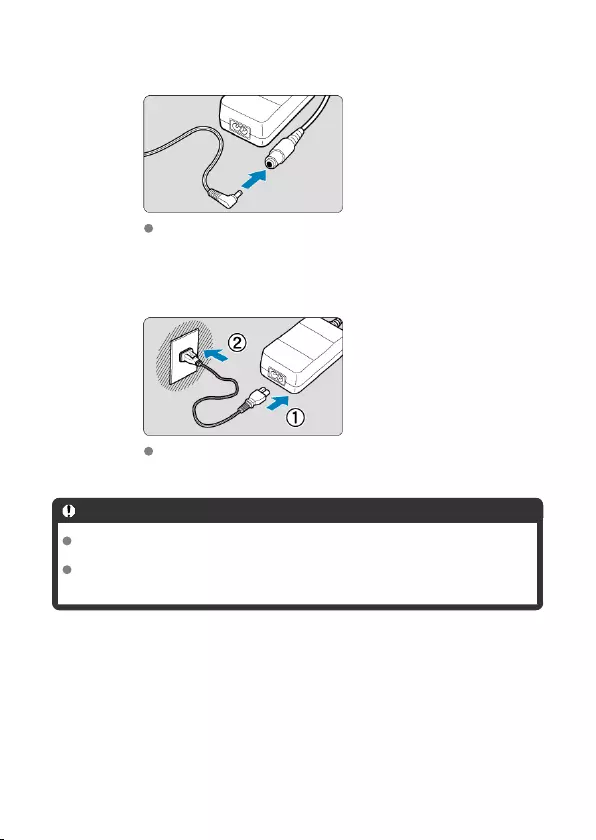
3. Connect the DC coupler to the AC adapter.
Fully insert the DC coupler plug into the socket of AC Adapter AC-E6N
(sold separately).
4. Connect the power cord.
Connect the power cord to the AC adapter and insert the power plug
into a power outlet.
Caution
While the camera is on, do not connect or disconnect the power cord or socket,
and do not remove the battery magazine.
Avoid getting the DC coupler cord caught between the battery grip and battery
magazine.
855

Button and Dial Operations
To use the buttons and dials, turn the vertical-grip on/off switch (4) to ON.
The buttons and dials are used the same way as corresponding buttons and dials on the
camera.
(1) Shutter button
(2) < > Multi-function button
(3) < > Main dial
(4) Vertical-grip On/Off switch
(5) < > Multi-controller
(6) < > Magnify/Reduce button
(7) < > AF point selection button
(8) < > AE lock/FE lock button
(9) < > AF start button
(10) < > Quick control dial 2
856
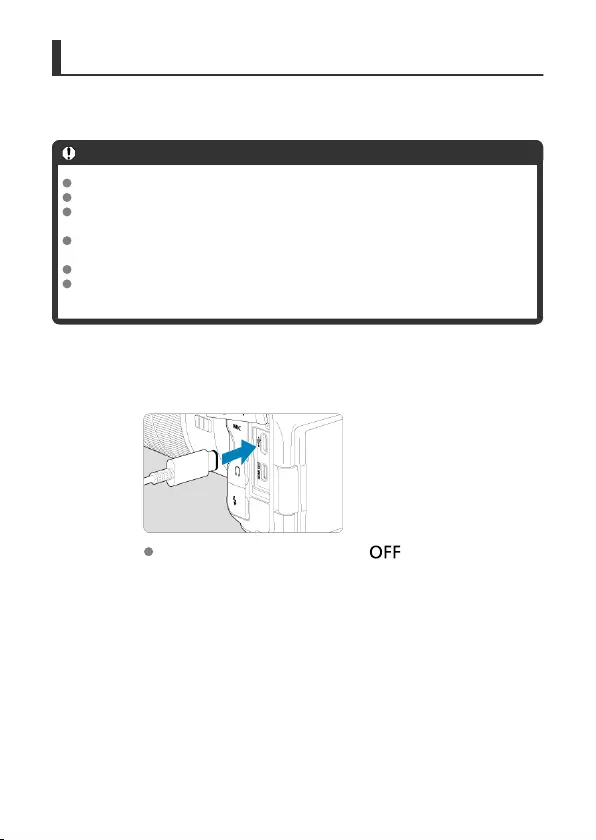
Using a USB Power Adapter to Charge/Power the Camera
Using USB Power Adapter PD-E1, you can charge Battery Pack LP-E6NH or LP-E6N
without removing it from the battery grip. The camera can also be powered.
Caution
LP-E6NH and LP-E6N can be charged together.
Otherwise, you can charge a single LP-E6NH or LP-E6N battery at a time.
LP-E6 cannot be charged this way. No battery will be charged if LP-E6NH or
LP-E6N is attached at the same time as LP-E6.
The battery is not charged if LP-E6NH or LP-E6N is loaded when DC Coupler
DR-E6 is connected.
Charging stops if you operate the camera.
When batteries are depleted, the adapter charges them. In this case, power is not
supplied to the camera.
Charging
1. Connect the USB power adapter.
With the camera power switch set to < >, insert the USB power
adapter plug fully into the camera’s digital terminal.
857
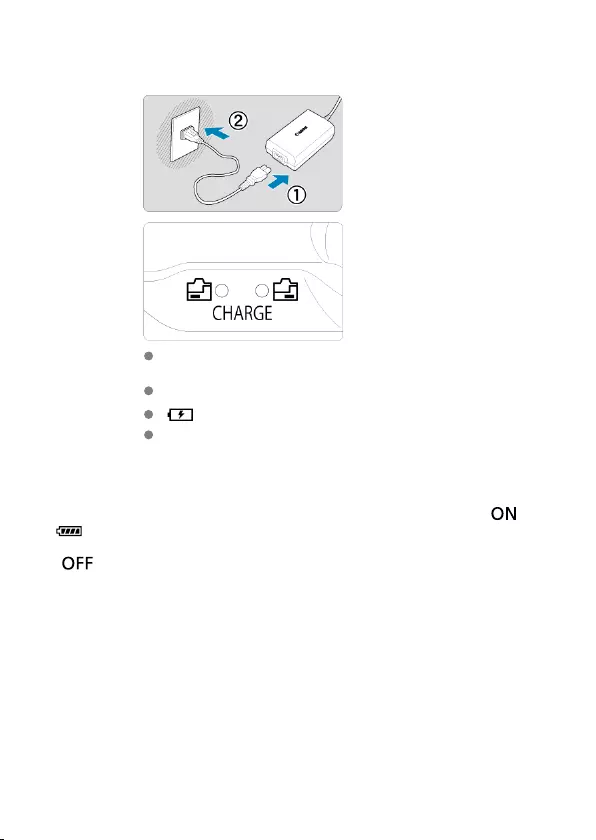
2. Charge the battery.
Connect the power cord to the USB power adapter and plug the other
end into a power outlet.
Charging begins, and the charge lamp lights up.
[ ] is displayed on the LCD panel.
When charging is finished, the charge lamp turns off.
Supplying power
To power the camera without charging batteries, set the camera power switch to <>.
[ ] is displayed on the LCD panel and screen while the camera is powered.
To change from powering the camera to charging, set the camera power switch to
< >.
858

Caution
To protect the battery pack and keep it in optimal condition, do not charge it
continuously for more than 24 hours.
If the charging lamp fails to light up or a problem occurs during charging (shown by
the charge lamp blinking), unplug the power cord, reinsert the battery, and wait a
few minutes before plugging it in again. If the problem persists, take the camera to
the nearest Canon Service Center.
The charging time required and the amount charged vary depending on ambient
temperature and remaining capacity.
For safety, charging in low temperatures takes longer.
The remaining battery level may decline when power is supplied to the camera. To
avoid running out of battery power, use a fully charged battery when shooting at
regular intervals.
859

Troubleshooting Guide
Power-related problems
Shooting-related problems
Problems with wireless features
Operation problems
Display problems
Playback problems
Sensor cleaning problems
Computer connection problems
If a problem occurs with the camera, first refer to this Troubleshooting Guide. If this
Troubleshooting Guide does not resolve the problem, take the camera to the nearest Canon
Service Center.
Power-related problems
Batteries cannot be charged with the battery charger.
If the battery’s remaining capacity ( ) is 94% or higher, the battery will not be charged.
Do not use any battery packs other than a genuine Canon Battery Pack LP-E6NH/
LP-E6N/LP-E6.
In case of charging or charger issues, see Charging the Battery.
The charger’s lamp blinks at high speed.
If (1) the battery charger or battery has a problem or (2) communication with the battery
failed (with a non-Canon battery pack), the protection circuit will stop charging, and the
charge lamp will blink in orange at a constant high speed. In the case of (1), unplug the
charger’s power plug from the power outlet, reattach the battery, wait a few minutes, and
then reconnect the power plug to the power outlet. If the problem persists, take the
camera to the nearest Canon Service Center.
The charger’s lamp does not blink.
If the internal temperature of the battery attached to the charger is high, the charger will
not charge the battery for safety reasons (lamp off). During charging, if the battery’s
temperature becomes high for any reason, charging will stop automatically (lamp blinks).
When the battery temperature goes down, charging will resume automatically.
860
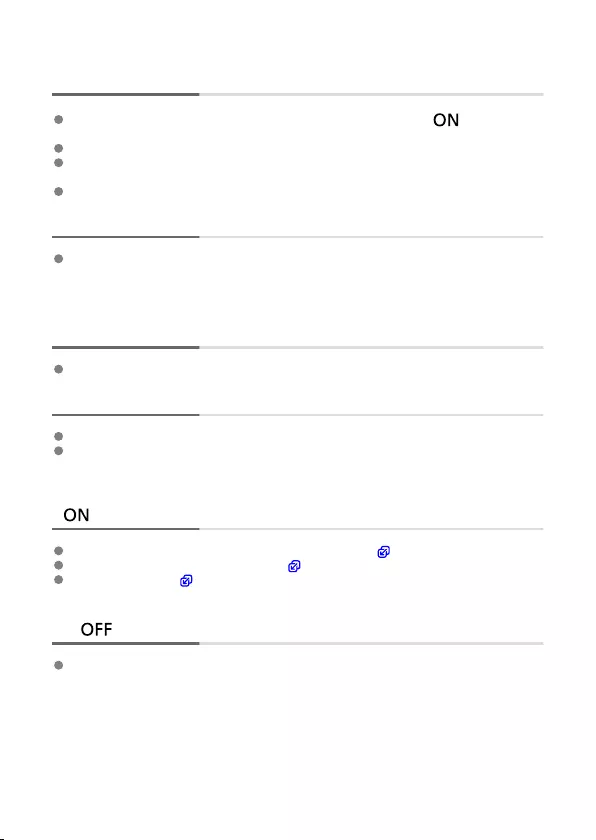
Batteries cannot be charged with the USB power adapter (sold
separately).
Batteries are not charged while the camera power switch is set to < >. However,
batteries are charged during auto power off.
Battery Pack LP-E6 cannot be charged.
Batteries are not charged when their remaining capacity is already approx. 94% or
higher.
Operating the camera will stop charging in progress.
The access lamp blinks during charging with the USB power adapter.
In case of charging problems, the access lamp blinks in green and a protective circuit
stops charging. In this case, unplug the power cord, reattach the battery, and wait a few
minutes before plugging it in again. If the problem persists, take the camera to the
nearest Canon Service Center.
The access lamp is not lit during charging with the USB power adapter.
Try unplugging the USB power adapter and plugging it in again.
The camera cannot be powered with the USB power adapter.
Check the battery compartment. The camera cannot be powered without a battery pack.
Check the remaining battery level. When batteries are depleted, the adapter charges
them. In this case, power is not supplied to the camera.
The camera is not activated even when the power switch is set to
< >.
Make sure the battery is inserted properly in the camera ( ).
Make sure the card slot cover is closed ( ).
Charge the battery ( ).
The access lamp still lights or blinks even when the power switch is set
to <>.
If the power is turned off while an image is being recorded to the card, the access lamp
will remain on or continue to blink for a few seconds. When the image recording is
complete, the power will turn off automatically.
861
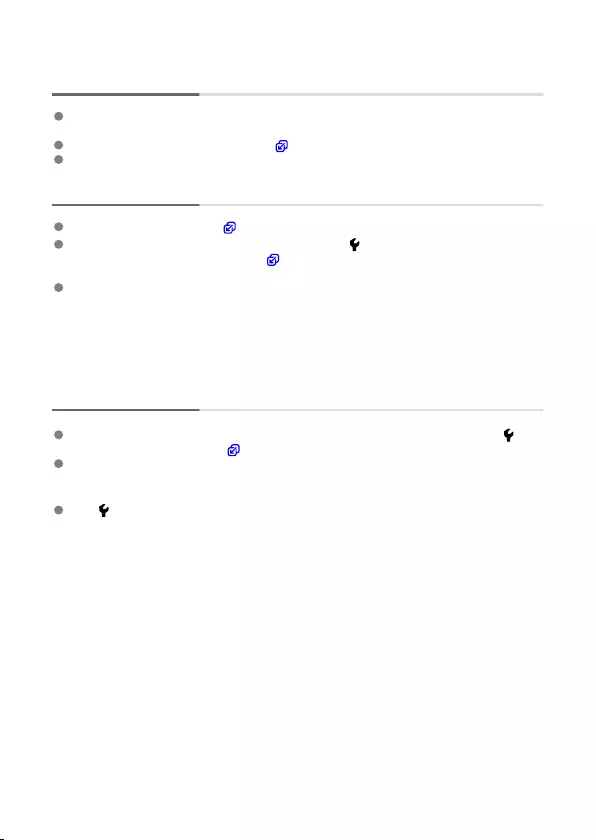
[Battery communication error. Does this battery/do these batteries
display the Canon logo?] is displayed.
Do not use any battery packs other than a genuine Canon Battery Pack LP-E6NH/
LP-E6N/LP-E6.
Remove and install the battery again ( ).
If the electrical contacts are dirty, use a soft cloth to clean them.
The battery becomes exhausted quickly.
Use a fully charged battery ( ).
The battery performance may have degraded. See [ : Battery info.] to check the
battery recharge performance level ( ). If the battery performance is poor, replace the
battery with a new one.
The number of available shots will decrease with any of the following operations:
• Pressing the shutter button halfway for a prolonged period
• Activating the AF frequently without taking a picture
• Using the lens’s Image Stabilizer
• Using the wireless communication functions
The camera turns off by itself.
Auto power off is in effect. To deactivate auto power off, set [Auto power off] in [ :
Power saving] to [Disable] ( ).
Even if [Auto power off] is set to [Disable], the screen and viewfinder will still turn off
after the camera is left idle for the time set in [Display off] or [Viewfinder off] (although
the camera itself remains on).
Set [ : Eco mode] to [Off].
862
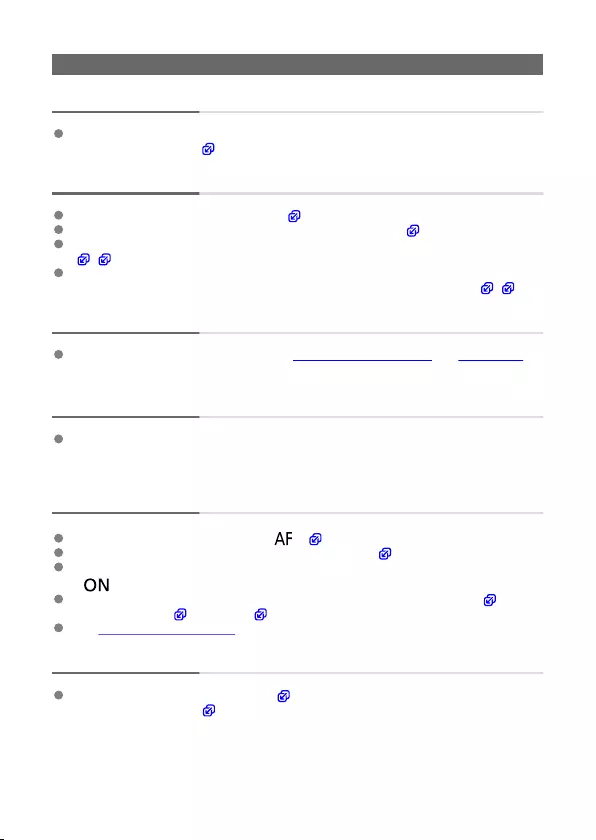
Shooting-related problems
The lens cannot be attached.
To attach EF or EF-S lenses, you will need a mount adapter. The camera cannot be
used with EF-M lenses ( ).
No images can be shot or recorded.
Make sure the card is properly inserted ( ).
Slide the card’s write-protect switch to the Write/Erase setting ( ).
If the card is full, replace the card or delete unnecessary images to make space
( , ).
Shooting is not possible if the AF point turns orange when you attempt to focus. Press
the shutter button halfway again to refocus automatically, or focus manually ( , ).
The card cannot be used.
If a card error message is displayed, see Inserting/Removing Cards and Error Codes.
An error message is displayed when the card is inserted in another
camera.
Since SDXC cards are formatted in exFAT, if you format a card with this camera and
then insert it into another camera, an error may be displayed and it may not be possible
to use the card.
The image is out of focus or blurred.
Set the lens’s focus mode switch to < > ( ).
Press the shutter button gently to prevent camera shake ( ).
With a lens equipped with an Image Stabilizer, set the Image Stabilizer switch to
< >.
In low light, the shutter speed may become slow. Use a faster shutter speed ( ), set a
higher ISO speed ( ), use flash ( ), or use a tripod.
See Minimizing blurred photos.
I cannot lock the focus and recompose the shot.
Set the AF operation to One-Shot AF ( ). Shooting with the focus locked is not
possible with Servo AF ( ).
863

The continuous shooting speed is slow.
High-speed continuous shooting may be slower depending on the battery level, ambient
temperature, flicker reduction, shutter speed, aperture value, subject conditions,
brightness, AF operation, type of lens, use of flash, shooting settings, and other
conditions. For details, see Selecting the Drive Mode or Still photo file size / Number of
possible shots / Maximum burst for continuous shooting.
The maximum burst during continuous shooting is lower.
Shooting intricate subjects such as fields of grass may result in larger file sizes, and the
actual maximum burst may be lower than the guidelines in Still photo file size / Number
of possible shots / Maximum burst for continuous shooting.
Even after I change the card, the maximum burst displayed for
continuous shooting does not change.
Estimated maximum burst indicated in the viewfinder does not change when you switch
cards, even if you switch to a high-speed card. Maximum burst listed in Still photo file
size / Number of possible shots / Maximum burst for continuous shooting is based on
the standard Canon test card, and the actual maximum burst is higher for cards with
faster writing speeds. For this reason, estimated maximum burst may differ from actual
maximum burst.
High-speed display is not available during high-speed continuous
shooting.
Refer to the high-speed display requirements in High-Speed Display.
Some image quality options are not available with cropped shooting.
/ / / image quality options are not available when [1.6x (crop)] is set, or
with EF-S lenses.
The aspect ratio cannot be set.
Aspect ratios cannot be set for EF-S lenses ([1.6x (crop)] is set automatically).
Aspect ratios cannot be set when [ : Add cropping information] is set to an option
other than [Disable].
ISO 100 cannot be set for still photo shooting.
The minimum speed in the ISO speed range is ISO 200 when [ : Highlight tone
priority] is set to [Enable] or [Enhanced].
864

Expanded ISO speeds cannot be selected for still photo shooting.
Check the [ISO speed range] setting under [ : ISO speed settings].
Expanded ISO speeds are not available when [ : Highlight tone priority] is set to
[Enable] or [Enhanced].
Expanded ISO speeds are not available when [HDR shooting ] in [ : HDR
PQ settings] is set to [Enable].
Even if I set a decreased exposure compensation, the image comes out
bright.
Set [ : Auto Lighting Optimizer] to [Disable] ( ). When [Low], [Standard], or
[High] is set, even if you set a decreased exposure compensation or flash exposure
compensation, the image may come out bright.
I cannot set the exposure compensation when both manual exposure
and ISO Auto are set.
See M: Manual Exposure to set the exposure compensation.
Not all the lens aberration correction options are displayed.
With [Digital Lens Optimizer] set to [Standard] or [High], [Chromatic aberr corr] and
[Diffraction correction] are not displayed, but they are both set to [Enable] for
shooting.
[Digital Lens Optimizer] is not displayed in movie recording.
Images are not displayed after shooting in multiple-exposure shooting.
When [On:ContShtng] is set, images are not displayed for review after capture, and
image playback is not available ( ).
Using flash in [ ] or [ ] mode lowers the shutter speed.
Set [Slow synchro] in [ : External Speedlite control] to [1/250-1/60sec. auto] (or
[1/200-1/60sec. auto]) or [1/250 sec. (fixed)] (or [1/200 sec. (fixed)]) ( ).
The flash does not fire.
Make sure any flash units are securely attached to the camera.
865
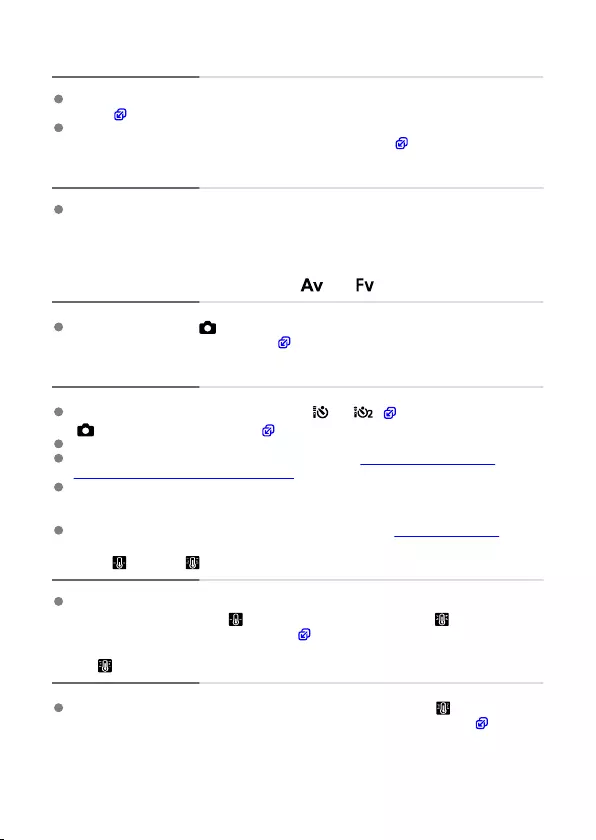
The flash always fires at full output.
Flash units other than EL/EX series Speedlites used in autoflash mode always fire at full
output ( ).
When the flash Custom Function setting for [Flash metering mode] is set to [TTL flash
metering] (autoflash), the flash will always fire at full output ( ).
Flash exposure compensation cannot be set.
If flash exposure compensation is already set with the Speedlite, flash exposure
compensation cannot be set with the camera. When the Speedlite’s flash exposure
compensation is canceled (set to 0), flash exposure compensation can be set with the
camera.
High-speed sync is not available in [ ] or [ ] mode.
Set [Slow synchro] in [ : External Speedlite control] to an option other than [1/250
sec. (fixed)] (or [1/200 sec. (fixed)] ) ( ).
Remote control shooting is not possible.
In still photo shooting, set the drive mode to [ ] or [ ] ( ). In movie recording, set
[ : Remote control] to [Enable] ( ).
Check the position of the remote control’s release timing switch.
If you are using Wireless Remote Control BR-E1, see Remote Control Shooting or
Connecting to a Wireless Remote Control.
Infrared remote controllers such as the RC-6 cannot be used for remote control shooting
when the camera is paired via Bluetooth with a smartphone or wireless remote control.
Set [Bluetooth settings] to [Disable].
To use a remote control for time-lapse movie recording, see Time-Lapse Movies.
A white [ ] or red [ ] icon is displayed during shooting.
It indicates that the camera’s internal temperature is high. Image quality of still photos
may be worse when a white [ ] icon is displayed. Display of a red [ ] icon indicates
that shooting will soon stop automatically ( ).
A red [ ] icon is displayed during movie recording.
It indicates that the camera’s internal temperature is high. If the red [ ] icon is
displayed, it indicates that the movie recording will soon stop automatically ( ).
866
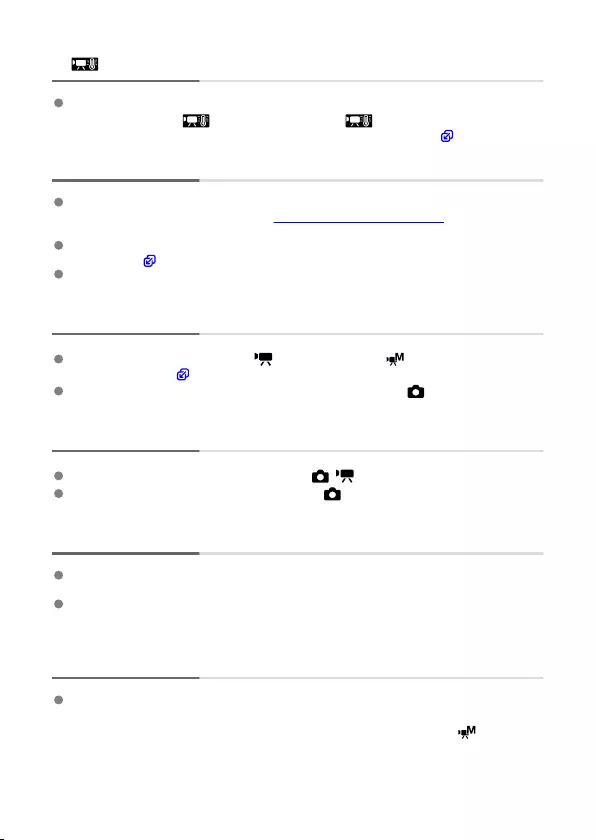
A [ ] icon is displayed during movie recording.
It indicates that the camera’s internal temperature is high. Movie recording is not
possible as long as [ ] is displayed. Display of [ ] during movie recording also
indicates that the camera will turn off automatically in approx. 3 min. ( ).
Movie recording stops by itself.
If the card’s writing speed is slow, movie recording may stop automatically. For details
on cards that can record movies, see Card performance requirements. To find out the
card’s writing speed, refer to the card manufacturer’s website, etc.
Perform low-level formatting to initialize the card if the card’s writing or reading speed
seems slow ( ).
Recording stops automatically once your movie reaches 29 min. 59 sec. (or 7 min. 29
sec. for a High Frame Rate movie).
The ISO speed cannot be set for movie recording.
ISO speed is set automatically in [ ] recording mode. In [ ] mode, you can manually
set the ISO speed ( ).
The minimum speed in the ISO speed range is ISO 200 when [ : Highlight tone
priority] is set to [Enable] or [Enhanced].
Expanded ISO speeds cannot be selected for movie recording.
Check the [ISO speed range] setting under [ : ISO speed settings].
Expanded ISO speeds are not available when [ : Highlight tone priority] is set to
[Enable] or [Enhanced].
The exposure changes during movie recording.
If you change the shutter speed or aperture value during movie recording, the changes
in the exposure may be recorded.
Recording a few test movies is recommended if you intend to perform zooming during
movie recording. Zooming as you record movies may cause exposure changes or lens
sounds to be recorded, or loss of focus.
The image flickers or horizontal stripes appear during movie recording.
Flickering, horizontal stripes (noise), or irregular exposures can be caused by
fluorescent lighting, LED lighting, or other light sources during movie recording. Also,
changes in the exposure (brightness) or color tone may be recorded. In [ ] mode,
using a slower shutter speed may reduce the problem. The problem may be more
noticeable in time-lapse movie recording.
867

The subject looks distorted during movie recording.
If you move the camera to the left or right (panning) or shoot a moving subject, the
image may look distorted. The problem may be more noticeable in time-lapse movie
recording.
Sound is not recorded in movies.
Sound is not recorded in High Frame Rate movies.
A time code is not added.
Time codes are not added when you record High Frame Rate movies with [Count up] in
[ : Time code] set to [Free run] ( ). Additionally, no time code is added to HDMI
video output ( ).
Time codes advance faster than the actual time.
Time codes in High Frame Rate movie recording advance 4 sec. per second ( ).
I cannot take still photos during movie recording.
Still photos cannot be taken during movie recording. To shoot still photos, stop recording
the movie, then select a shooting mode for still photos.
I cannot record movies during still photo shooting.
It may not be possible to record movies during still photo shooting if operations such as
extended Live View display increase the camera’s internal temperature. Turn off the
camera or take other measures, and wait until the camera cools down.
In [ ] shooting mode, lowering the [ ] movie recording quality may enable movie
recording.
In shooting modes other than [ ], lowering the [ ] movie recording quality may
enable movie recording.
Cannot record movies.
Format (initialize) the card with this camera ( ).
Use an SDXC card as card [ ] when the movie recording method is set to [ ] or
[ ].
The camera vibrates.
Image stabilization by the camera may make the camera seem to vibrate. This does not
indicate damage.
868

Problems with wireless features
Cannot pair with a smartphone.
Use a smartphone compliant with Bluetooth Specification Version 4.1 or later.
Turn on Bluetooth from the smartphone settings screen.
Pairing with the camera is not possible from the smartphone’s Bluetooth settings screen.
Install the dedicated app Camera Connect (free of charge) on the smartphone ( ).
Pairing with a previously paired smartphone is not possible if pairing information
registered for another camera remains on the smartphone. In this case, remove the
camera’s registration retained in the Bluetooth settings on the smartphone and try
pairing again ( ).
Wi-Fi functions cannot be set.
If the camera is connected to a computer or another device with an interface cable,
Wi-Fi functions cannot be set. Disconnect the interface cable before setting any
functions ( ).
A device connected with an interface cable cannot be used.
Other devices, such as computers, cannot be used with the camera by connecting them
with an interface cable while the camera is connected to devices via Wi-Fi. Terminate
the Wi-Fi connection before connecting the interface cable.
Operations such as shooting and playback are not possible.
With a Wi-Fi connection established, operations such as shooting and playback may not
be possible. Terminate the Wi-Fi connection, then perform the operation.
Cannot reconnect to a smartphone.
Even with a combination of the same camera and smartphone, if you have changed the
settings or selected a different setting, reconnection may not be established even after
selecting the same SSID. In this case, delete the camera connection settings from the
Wi-Fi settings on the smartphone and set up a connection again.
A connection may not be established if Camera Connect is running when you
reconfigure connection settings. In this case, quit Camera Connect for a moment and
then restart it.
869

Operation problems
Settings change when I switch from still photo shooting to movie
recording or vice versa.
Separate settings are retained for use when shooting still photos and recording movies.
I cannot adjust settings with < >, < >, < >, < >, < >, or < >.
Press the < > button to release the Multi-function lock ( ).
Check the [ : Multi function lock] setting ( ).
Touch operation is not possible.
Make sure [ : Touch control] is set to [Standard] or [Sensitive] ( ).
A camera button or dial does not work as expected.
In movie recording, check the [ : Shutter btn function for movies] setting ( ).
Check the [ : Customize buttons] and [ : Customize dials] settings ( ).
870
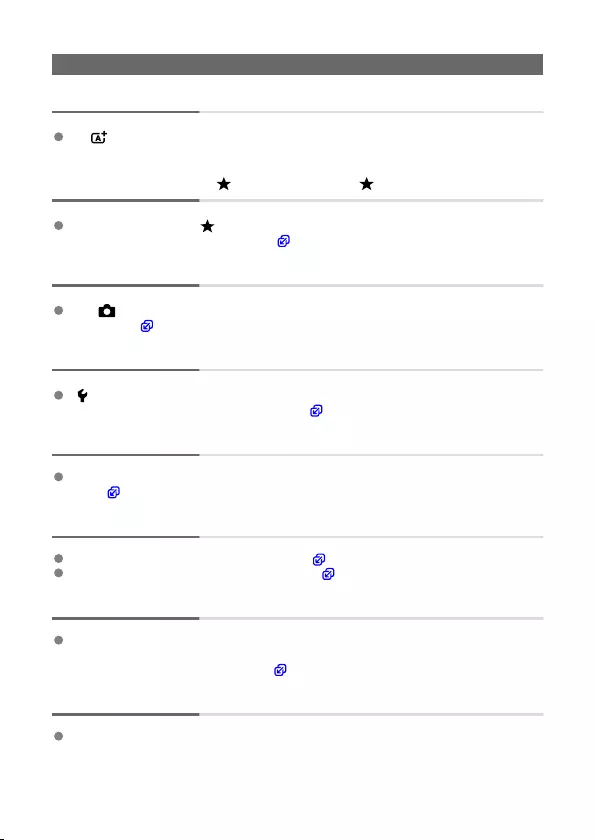
Display problems
The menu screen shows fewer tabs and items.
In [ ] mode, some tabs and items are not displayed. Tabs and items on the menu
screen also vary for still photos and movies.
The display starts with [ ] My Menu, or the [ ] tab alone is displayed.
[Menu display] on the [ ] tab is set to [Display from My Menu tab] or [Display only
My Menu tab]. Set [Normal display] ( ).
The file name’s first character is an underscore (“_”).
Set [ : Color space] to [sRGB]. If [Adobe RGB] is set, the first character will be an
underscore ( ).
The fourth character in the file name changes.
[ : File name] is set to [*** + image size]. Select either the camera’s unique file name
or the file name registered in User setting 1 ( ).
The file numbering does not start from 0001.
If the card already contains recorded images, the image number may not start from
0001 ( ).
The shooting date and time displayed are incorrect.
Make sure the correct date and time are set ( ).
Check the time zone and daylight saving time ( ).
The date and time are not in the image.
The shooting date and time do not appear in the image. The date and time are recorded
in the image data as shooting information. When you print photos, this information can
be used to include the date and time ( ).
[###] is displayed.
If the number of images recorded on the card exceeds the number the camera can
display, [###] will be displayed.
871

The screen does not display a clear image.
If the screen is dirty, use a soft cloth to clean it.
The screen display may seem slightly slow in low temperatures or may look black in
high temperatures, but it will return to normal at room temperature.
872
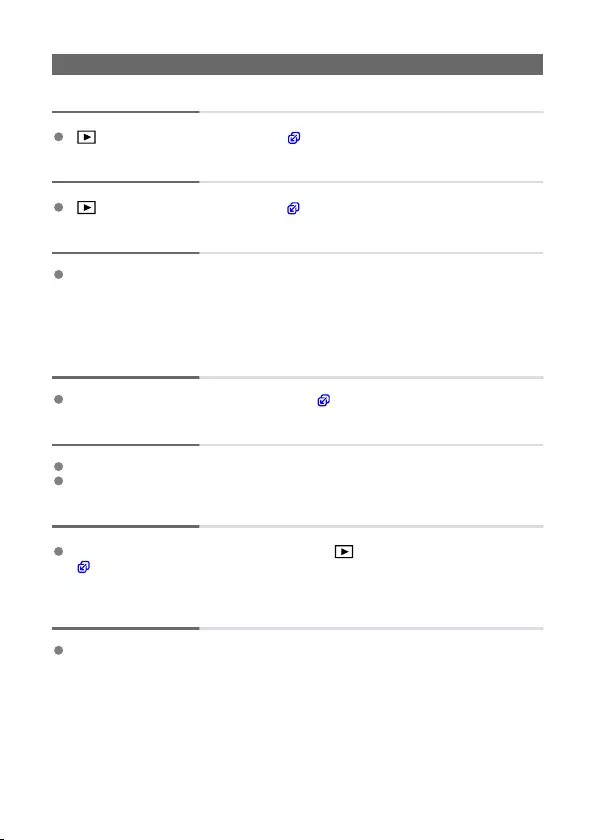
Playback problems
Part of the image blinks in black.
[ : Highlight alert] is set to [Enable] ( ).
A red box is displayed on the image.
[ : AF point disp.] is set to [Enable] ( ).
During image playback, the AF points are not displayed.
AF points are not displayed when the following types of images are played back:
• Images taken with Multi Shot Noise Reduction applied.
• Cropped images.
• Images from HDR shooting with [Auto Image Align] set to [Enable].
The image cannot be erased.
If the image is protected, it cannot be erased ( ).
Still photos and movies cannot be played back.
The camera may not be able to play back images taken with another camera.
Movies edited with a computer cannot be played back with the camera.
Only few images can be played back.
The images have been filtered for playback with [ : Set image search conditions]
( ). Clear the image search conditions.
Mechanical sounds or sounds of camera operations can be heard
during movie playback.
The camera’s built-in microphone may also record mechanical sounds of the lens or
sounds of camera/lens operations if AF operations are performed or the camera or lens
is operated during movie recording. In this case, using an external microphone may
reduce these sounds. If the sounds are still distracting with an external microphone, it
may be more effective to remove the external microphone from the camera and position
it away from the camera and lens.
873
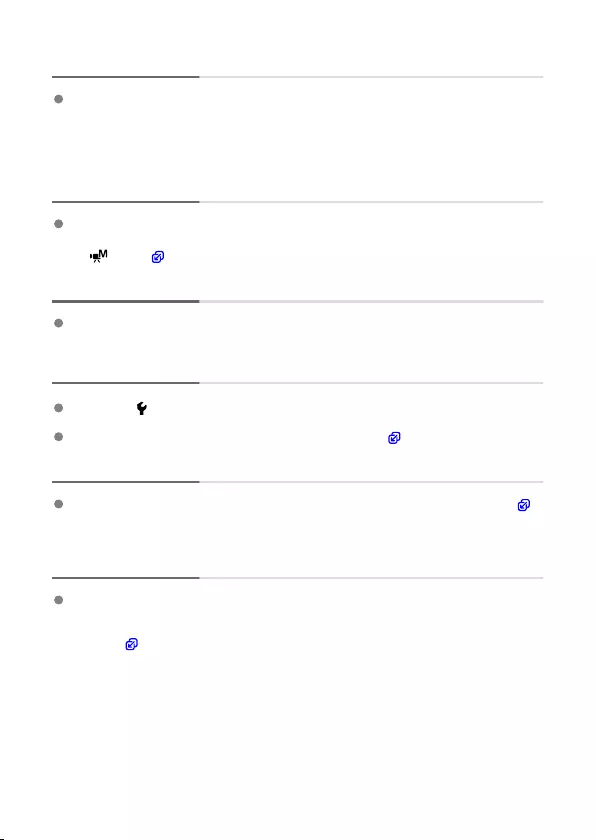
Movie playback stops by itself.
Extended movie playback or movie playback under high ambient temperature may
cause the camera’s internal temperature to rise, and movie playback may stop
automatically.
If this happens, playback is disabled until the camera’s internal temperature decreases,
so turn off the power and let the camera cool down a while.
The movie appears to freeze momentarily.
Significant change in the exposure level during autoexposure movie recording may
cause recording to stop momentarily until the brightness stabilizes. In this case, record
in [ ] mode ( ).
The movie is played in slow motion.
High Frame Rate movies are recorded at 29.97 fps or 25.00 fps, so they are played in
slow motion at 1/4 speed.
No picture appears on the television.
Make sure [ : Video system] is set to [For NTSC] or [For PAL] correctly for the video
system of your television.
Make sure the HDMI cable’s plug is inserted all the way in ( ).
There are multiple movie files for a single movie recording.
If the movie file size reaches 4 GB, another movie file will be created automatically ( ).
However, if you use an SDXC card formatted with the camera, you can record a movie
in a single file even if it exceeds 4 GB.
My card reader does not recognize the card.
Depending on the card reader used and the computer’s operating system, SDXC cards
may not be correctly recognized. In this case, connect the camera to the computer with
the interface cable, then import the images to the computer using EOS Utility (EOS
software, ).
874

Images cannot be resized or cropped.
This camera cannot resize JPEG images, RAW images, or frame-grab images from
8K or 4K movies saved as still photos ( ).
This camera cannot crop RAW images, images captured with [HDR shooting ]
in [ : HDR PQ settings] set to [Enable], or frame-grab images from 8K or 4K movies
saved as still photos ( ).
Dots of light appear on the image.
White, red, or blue dots of light may appear in captured images if the sensor is affected
by cosmic rays or similar factors. Their appearance may be reduced by performing
[Clean now ] under [ : Sensor cleaning] ( ).
Sensor cleaning problems
The shutter makes a sound during sensor cleaning.
Although there is a mechanical sound from the shutter during cleaning after [Clean now
] is selected, no image is recorded to the card ( ).
Automatic sensor cleaning does not work.
Repeatedly turning the power switch < > and < > within a short period may
prevent the [ ] icon from being displayed ( ).
875

Computer connection problems
I cannot import images to a computer.
Install EOS Utility (EOS software) on the computer ( ).
Make sure the main EOS Utility window is displayed.
If the camera is already connected via Wi-Fi, it cannot communicate with any computer
connected with an interface cable.
Check the version of the application.
Communication between the connected camera and computer does not
work.
When using EOS Utility (EOS software), set [ : Time-lapse movie] to [Disable] ( ).
876

Error Codes
(1) Error number
(2) Cause and countermeasures
If there is a problem with the camera, an error message will appear. Follow the on-screen
instructions.
If the problem persists, write down the error code (Errxx) and request service.
877
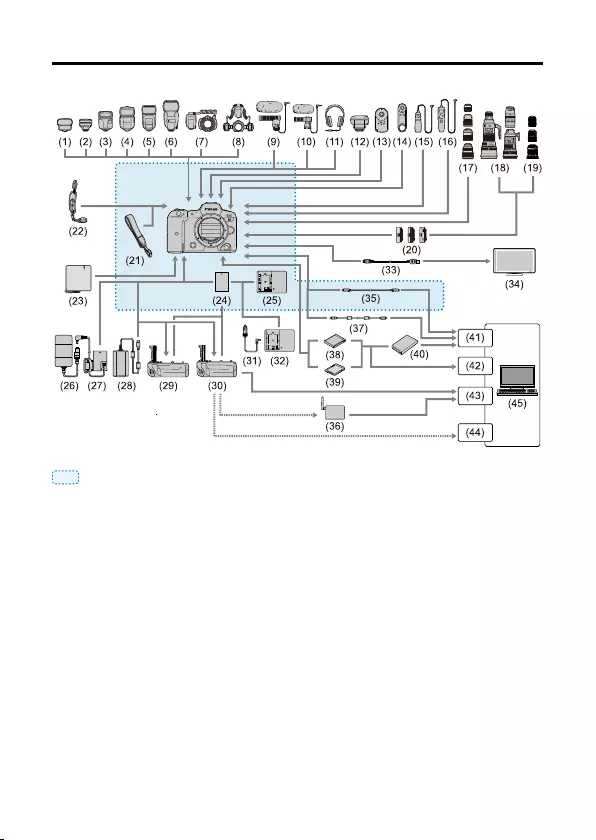
System Map
: Bundled accessories
878

(1) Speedlite Transmitter ST-E2
(2) Speedlite Transmitter ST-E3-RT
(3) Speedlite EL-100
(4) Speedlite 430EX III-RT/430EX III
(5) Speedlite 470EX-AI
(6) Speedlite 600EX II-RT
(7) Macro Ring Lite MR-14EX II
(8) Macro Twin Lite MT-26EX-RT
(9) Directional Stereo Microphone DM-E1
(10) Stereo Microphone DM-E100
(11) Headphones
(12) GPS Receiver GP-E2
(13) Remote Controller RC-6
(14) Wireless Remote Control BR-E1
(15) Remote Switch RS-80N3
(16) Timer Remote Controller TC-80N3
(17) RF lenses
(18) EF lenses
(19) EF-S lenses
(20) Mount Adapter
(21) Strap
(22) Hand Strap E2
(23) Protecting Cloth PC-E1/E2
(24) Battery Pack LP-E6NH*1
(25) Battery Charger LC-E6
(26) AC Adapter AC-E6N*2
(27) DC Coupler DR-E6*2
(28) USB Power Adapter PD-E1*3
(29) Battery Grip BG-R10
(30) Wireless File Transmitter WFT-R10
(31) Car Battery Cable CB-570
(32) Car Battery Charger CBC-E6
(33) HDMI cable*7
(34) TV/monitor
(35) Interface Cable IFC-100U (approx. 1 m/3.2 ft.)*4, 5
(36) Wireless LAN access point
(37) Interface Cable IFC-400U (approx. 4 m/13.1 ft.)*4, 6
(38) CFexpress card
(39) SD/SDHC/SDXC memory cards
(40) Card reader
(41) USB port
879

(42) Card slot
(43) Ethernet port
(44) Wireless LAN adapter
(45) Computer
*1: Battery Pack LP-E6N/LP-E6 can also be used.
* 2: AC Adapter Kit ACK-E6 can also be used.
* 3: Charging with USB Power Adapter PD-E1 is only available for LP-E6NH/LP-E6N (not LP-E6).
* 4: Camera and computer end: USB Type-C.
* 5: The transmission rate when IFC-100U is used is equivalent to SuperSpeed USB (USB 3.1 Gen 1).
* 6: The transmission rate when IFC-400U is used is equivalent to Hi-Speed USB (USB 2.0).
* 7: Use a cable no longer than 2.5 m (8.2 ft.). The camera end is Type D.
880
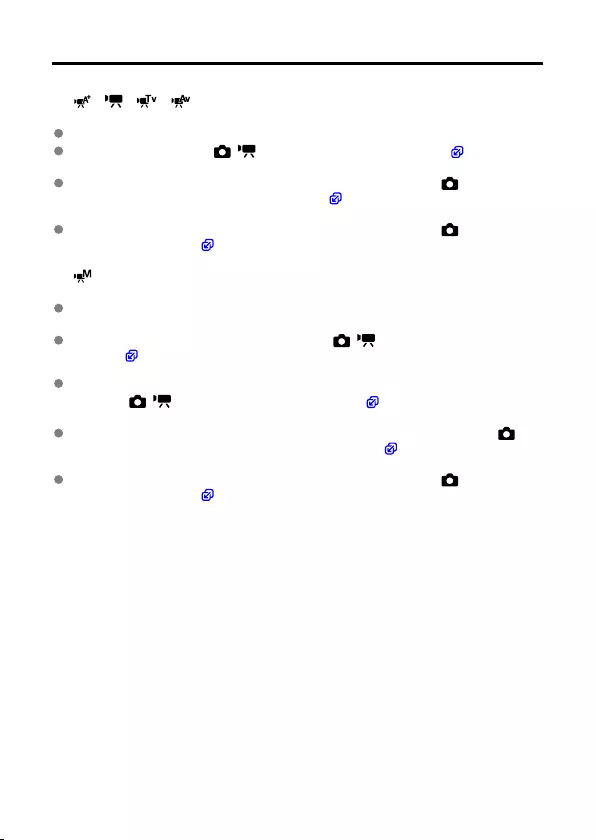
ISO Speed in Movie Recording
In [ ]/[ ]/[ ]/[ ] mode
ISO speed is set automatically in a range of ISO 100–25600.
Setting [Max for Auto] in [ : ISO speed settings] to [H (51200)] ( ) expands the
maximum speed in the automatic setting range to H (equivalent to ISO 51200).
The minimum speed in the automatic setting range is ISO 200 when [ : Highlight
tone priority] is set to [Enable] or [Enhanced] ( ). The maximum limit is not
expanded, even when expansion is set in [Max for Auto].
The minimum speed in the automatic setting range is ISO 400 when [ : Canon Log
settings] is set to [On] ( ).
In [ ] mode
With ISO speed set to [AUTO], ISO speed is set automatically in a range of ISO 100–
25600.
When ISO Auto is set, setting [Max for Auto] in [ : ISO speed settings] to [H
(51200)] ( ) expands the maximum speed in the automatic setting range to H
(equivalent to ISO 51200).
ISO speed can be set manually in a range of ISO 100–25600. Setting [ISO speed
range] in [ : ISO speed settings] to [H (51200)] ( ) expands the maximum
speed in the manual setting range to H (equivalent to ISO 51200).
The minimum speed in the automatic or manual setting range is ISO 200 when [ :
Highlight tone priority] is set to [Enable] or [Enhanced] ( ). Even when ISO speed
expansion is set, the maximum limit will not be expanded.
The minimum speed in the automatic setting range is ISO 400 when [ : Canon Log
settings] is set to [On] ( ). ISO 100–200 represents an expanded ISO speed (L).
881
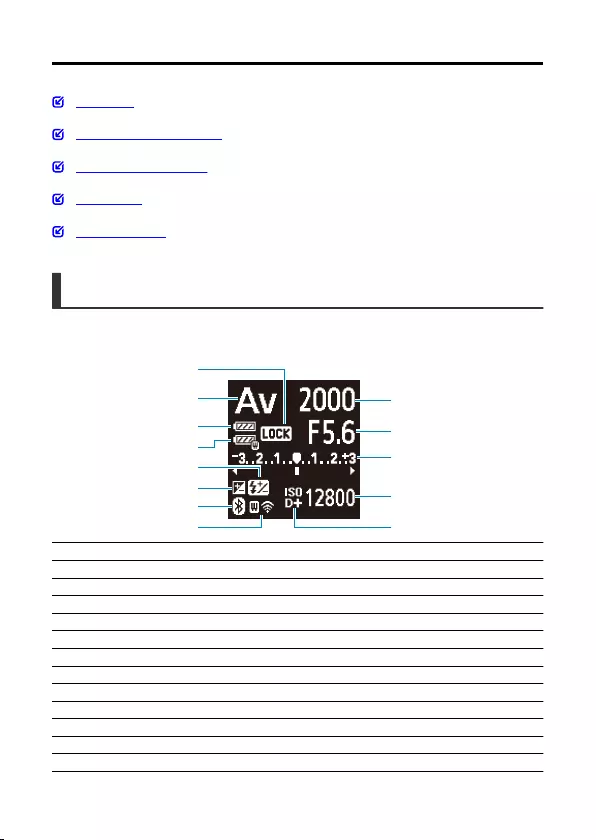
Information Display
LCD Panel
Still Photo Shooting Screen
Movie Recording Screen
Scene Icons
Playback Screen
LCD Panel
Still photo/movie standby screen 1
(3)
(5)
(7)
(6)
(9)
(8)
(10)
(11)
(12)
(13)
(2)
(1)
(4)
(1) Multi-function lock
(2) Shooting mode
(3) Battery level
(4) WFT battery level
(5) Flash exposure compensation
(6) Exposure compensation
(7) Bluetooth function
(8) Wi-Fi function/WFT status (wireless)/WFT status (wired)
(9) Shutter speed
(10) Aperture value
(11) Exposure level indicator/Exposure compensation amount/AEB range
(12) ISO speed
(13) Highlight tone priority
882

Still photo standby screen 2
(3)
(4)
(5)
(7)
(6)
(8)
(9)
(2)
(1)
(1) Drive mode
(2) AF method
(3) AF operation
(4) Card slot
(5) Movie recording mode
(6) White balance
(7) Metering mode
(8) Picture Style
(9) Movie recording quality
883

Movie standby screen 2
(2)
(3)
(4)
(5)
(6)
(1)
(1) AF method
(2) Image Stabilizer (IS mode)
(3) Card slot
(4) White balance
(5) Canon Log
(6) Movie recording time available
884

Movie recording in progress
(1)
(2)
(1) Elapsed recording time
(2) Recording in progress/External recording in progress (10-bit, via HDMI)
885
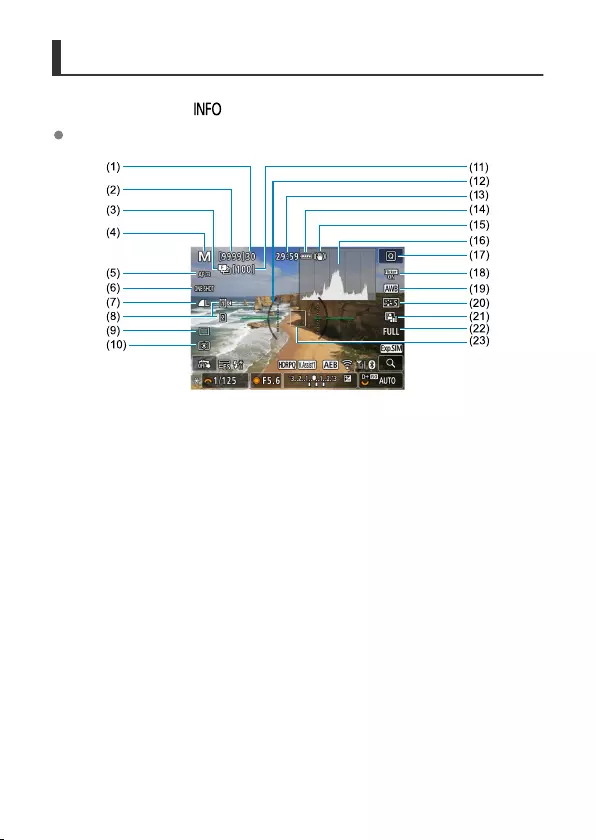
Still Photo Shooting Screen
Each time you press the <> button, the information display will change.
The display will show only the settings currently applied.
886

(1) Maximum burst
(2) Number of available shots/Sec. until self-timer shoots
(3) Focus bracketing/HDR/Multiple exposures/Multi Shot Noise Reduction/Bulb timer/Interval
timer
(4) Shooting mode
(5) AF method
(6) AF operation
(7) Image quality
(8) Card
(9) Drive mode
(10) Metering mode
(11) No. of remaining shots for focus bracketing, multiple exposures, or interval timer
(12) Electronic level
(13) Movie recording time available
(14) Battery level
(15) Image Stabilizer (IS mode)
(16) Histogram (Brightness/RGB)
(17) Quick Control button
(18) Anti-flicker shooting
(19) White balance/White balance correction
(20) Picture Style
(21) Auto Lighting Optimizer
(22) Still photo cropping/Aspect ratio
(23) AF point (1-point AF)
887
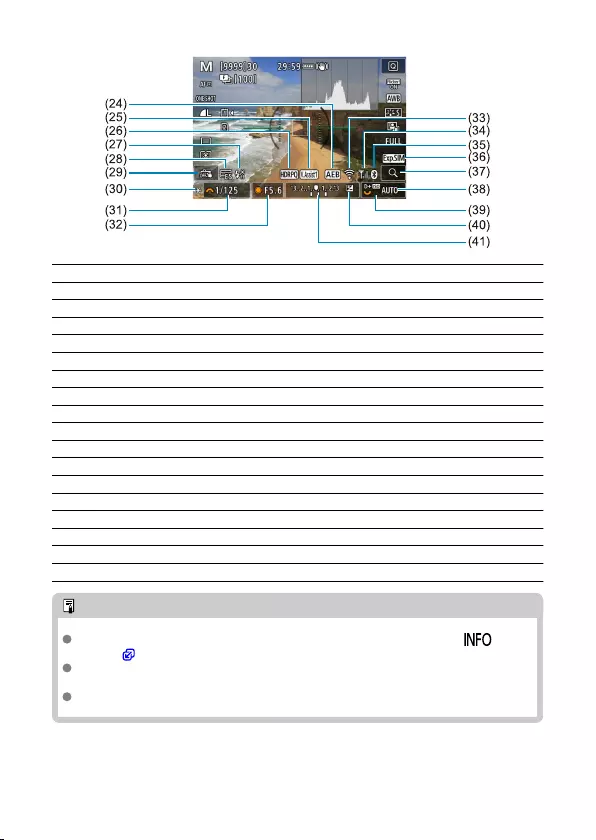
(24) AEB/FEB
(25) View Assist
(26) HDR PQ
(27) Flash ready/FE lock/High-speed sync
(28) Electronic shutter
(29) Touch Shutter/Create folder
(30) AE lock
(31) Shutter speed/Multi-function lock warning
(32) Aperture value
(33) Wi-Fi function
(34) Wi-Fi signal strength
(35) Bluetooth function
(36) Exposure simulation
(37) Magnify button
(38) ISO speed
(39) Highlight tone priority
(40) Exposure compensation
(41) Exposure level indicator
Note
You can specify the information displayed in response to pressing the < >
button ( ).
The electronic level is not displayed when the camera is connected via HDMI to a
television.
Other icons may be displayed temporarily after setting adjustments.
888
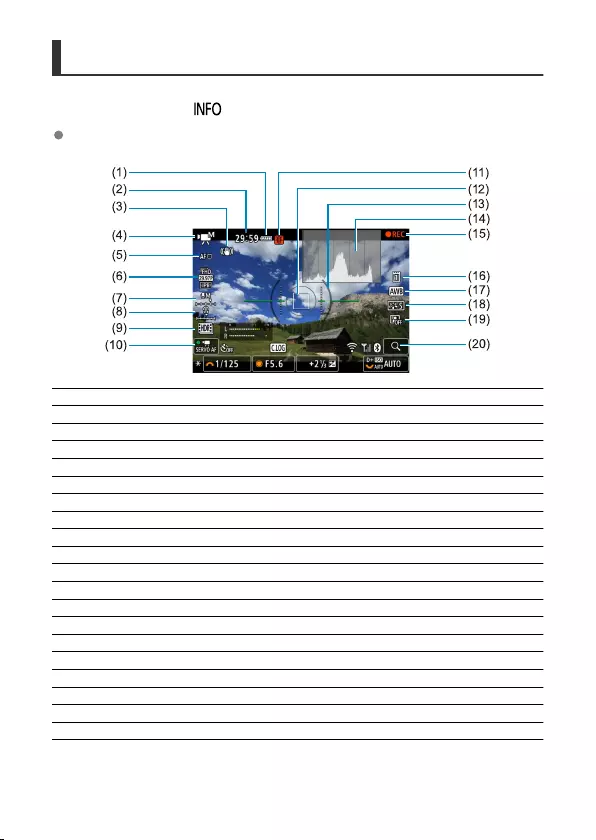
Movie Recording Screen
Each time you press the <> button, the information display will change.
The display will show only the settings currently applied.
(1) Battery level
(2) Movie recording time available/Elapsed recording time
(3) Image Stabilizer (IS mode)
(4) Shooting mode
(5) AF method
(6) Movie recording size
(7) Audio recording level (manual/line input)
(8) Headphone volume
(9) HDR movie
(10) Movie Servo AF
(11) Temperature warning
(12) AF point (1-point AF)
(13) Electronic level
(14) Histogram (Brightness/RGB)
(15) Movie recording in progress
(16) Card for recording/playback
(17) White balance/White balance correction
(18) Picture Style
(19) Auto Lighting Optimizer
(20) Magnify button
889
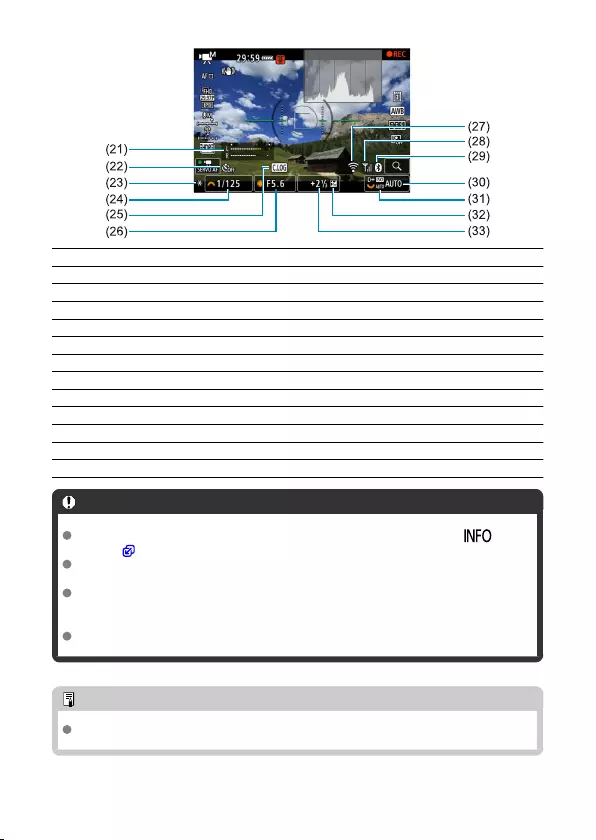
(21) Audio recording level indicator (manual/line input)
(22) Movie self-timer
(23) AE lock
(24) Shutter speed
(25) Canon Log
(26) Aperture value
(27) Wi-Fi function
(28) Wi-Fi signal strength
(29) Bluetooth function
(30) ISO speed
(31) Highlight tone priority
(32) Exposure compensation
(33) Exposure level indicator (metering levels)
Caution
You can specify the information displayed in response to pressing the < >
button ( ).
The electronic level is not displayed when the camera is connected via HDMI to a
television.
The electronic level, grid lines, and histogram cannot be displayed during movie
recording (and if they are currently displayed, recording a movie will clear the
display).
Time available per recording changes to elapsed time after movie recording begins.
Note
Other icons may be displayed temporarily after setting adjustments.
890
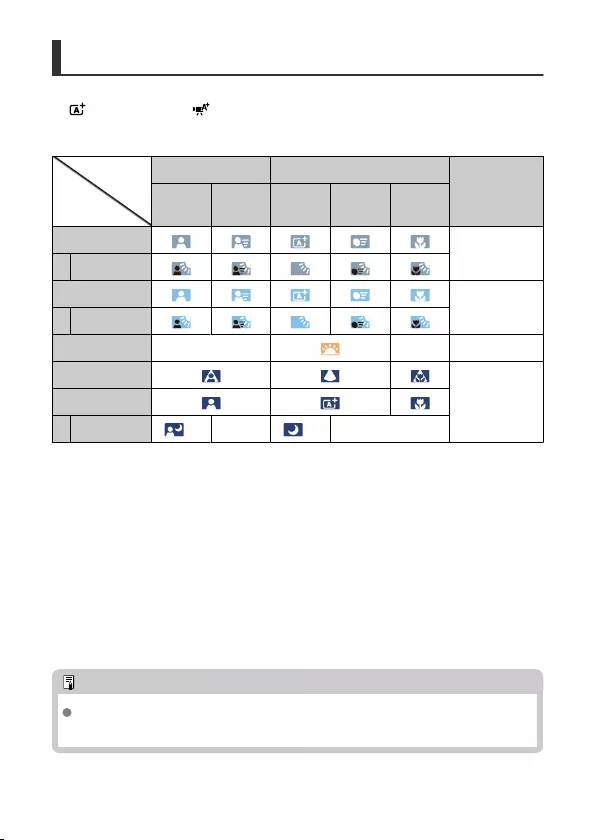
Subject
Background
Scene Icons
In [ ] shooting mode or [ ] recording mode, the camera detects the type of scene and
sets all settings accordingly. The detected scene type is indicated in the upper left of the
screen.
People*1 Subjects Other Than People
Background
Color
In
Motion*2
Nature/
Outdoor
Scene
In
Motion*2 Close*3
Bright
Gray
Backlit
Blue Sky Included
Light blue
Backlit
Sunset *4 *4 Orange
Spotlight
Dark blueDark
With Tripod*1 *5*6 *4 *5*6 *4
* 1: An icon for subjects other than people/animals is displayed in time-lapse movie recording.
* 2: Not displayed during movie recording.
* 3: Displayed when the attached lens has distance information. With an extension tube or close-up
lens, the icon displayed may not match the actual scene.
* 4: Icons of scenes selected from those that can be detected are displayed.
* 5: Displayed when all the following conditions apply.
The shooting scene is dark, it is a night scene, and the camera is mounted on a tripod.
* 6: Displayed with any of the following lenses.
• EF300mm f/2.8L IS II USM
• EF400mm f/2.8L IS II USM
• EF500mm f/4L IS II USM
• EF600mm f/4L IS II USM
• Image Stabilizer lenses released in and after 2012.
*Slower shutter speeds are used when the conditions in both *5 and *6 apply.
Note
For certain scenes or shooting conditions, the icon displayed may not match the
actual scene.
891

Playback Screen
Basic information display for still photos
(1) HDR output status/View Assist
(2) Bluetooth function
(3) Wi-Fi signal strength
(4) Wi-Fi function
(5) Battery level
(6) Current image no./Total images/No. of images found
(7) Shutter speed
(8) Aperture value
(9) Exposure compensation amount
(10) Already sent to a computer/smartphone
(11) Voice memo
(12) Rating
(13) Image protection
(14) Card no.
(15) Folder no.-File no.
(16) Image quality/Edited image/Cropping/Frame Grab
(17) ISO speed
(18) Highlight tone priority
892

Caution
If the image was taken by another camera, certain shooting information may not be
displayed.
It may not be possible to play back images taken with this camera on other
cameras.
893
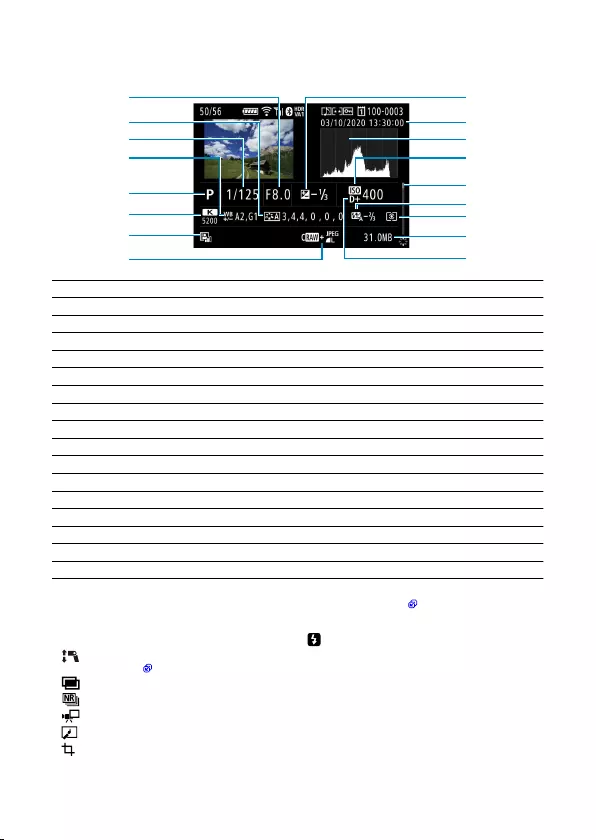
Detailed information display for still photos
(2)
(1) (9)
(10)
(11)
(12)
(13)
(14)
(15)
(16)
(17)
(4)
(5)
(6)
(7)
(8)
(3)
(1) Aperture value
(2) Picture Style/Settings
(3) Shutter speed
(4) White balance correction/Bracketing
(5) Shooting mode/Multiple exposure/Frame Grab
(6) White balance
(7) Auto Lighting Optimizer
(8) Image quality/Edited image/Cropping
(9) Exposure compensation amount
(10) Shooting date and time
(11) Histogram (Brightness/RGB)
(12) ISO speed
(13) Scroll bar
(14) Flash exposure compensation amount/Bounce/HDR shooting/Multi Shot Noise Reduction
(15) Metering mode
(16) File size
(17) Highlight tone priority
*For images captured in RAW+JPEG/HEIF shooting, indicates RAW file sizes.
* Lines indicating the image area will be displayed for images taken with the aspect ratio set ( ) and with RAW or RAW+JPEG
set for image quality.
*For images with added cropping information, lines are shown to indicate the image area.
* During flash photography without flash exposure compensation, [ ] will be displayed.
*[] indicates images shot with bounce flash photography.
*An icon for the effect ( ) and the dynamic range adjustment amount is displayed for images captured in HDR shooting.
* [ ] indicates images captured in multiple-exposure shooting.
* [ ] indicates images processed with Multi Shot Noise Reduction.
*[] indicates test shots for time-lapse movies.
*[] indicates images created and saved by performing RAW image processing, resizing, cropping, or frame-grabbing.
*[] indicates images cropped and then saved.
894

Detailed information display for movies
(2)
(1)
(8)
(7)
(6)
(4)
(5)
(3)
(1) Movie playback
(2) Movie recording mode/High Frame Rate mode
(3) Image size
(4) Frame rate
(5) Compression method
(6) Image Stabilizer (IS mode)
(7) Recording time/Time code
(8) Movie recording format
* For simplicity, explanations are omitted for items that are also included in basic/detailed information display for still photos,
which are not shown here.
Note
During movie playback, “*, *” is displayed for the [Fineness] and [Threshold]
parameters of [Sharpness] in [Picture Style].
895

EF Lenses Supporting 12 Shots/Sec. Continuous
Shooting
The following EF lenses support 12 shots/sec. continuous shooting in [ ] drive mode.
EF24mm f/2.8 IS USM
EF28mm f/2.8 IS USM
EF35mm f/1.4L II USM
EF35mm f/2 IS USM
EF40mm f/2.8 STM
EF50mm f/1.8 STM
EF85mm f/1.4L IS USM
EF200mm f/2.8L II USM
EF300mm f/2.8L IS II USM
EF400mm f/2.8L IS III USM
EF500mm f/4L IS II USM
EF600mm f/4L IS II USM
EF600mm f/4L IS III USM
EF8-15mm f/4L Fisheye USM
EF11-24mm f/4L USM
EF16-35mm f/2.8L III USM
EF16-35mm f/4L IS USM
EF24-70mm f/2.8L II USM
EF24-70mm f/4L IS USM
EF24-105mm f/4L IS II USM
EF24-105mm f/3.5-5.6 IS STM
EF70-200mm f/2.8L IS III USM
EF70-200mm f/4L IS USM
EF70-200mm f/4L IS II USM
EF70-300mm f/4-5.6L IS USM
EF70-300mm f/4-5.6 IS II USM
EF100-400mm f/4.5-5.6L IS II USM
EF200-400mm f/4L IS USM Extender 1.4X
896

EF-S24mm f/2.8 STM
EF-S35mm f/2.8
EF-S10-18mm f/4.5-5.6 IS STM
EF-S15-85mm f/3.5-5.6 IS USM
EF-S18-55mm f/3.5-5.6 IS STM
EF-S18-55mm f/4-5.6 IS STM
EF-S18-135mm f/3.5-5.6 IS USM
EF-S18-135mm f/3.5-5.6 IS STM
EF-S55-250mm f/4-5.6 IS STM
897

Specifications
Type
Type: Digital single-lens non-reflex AF/AE camera
Lens mount: Canon RF mount
Compatible lenses: Canon RF lens group
*Using mount adapter EF-EOS R: Canon EF or EF-S lenses (excluding EF-M lenses)
Lens focal length: Same as the focal length indicated on the lens
* Using EF-S lenses: Approx. 1.6 times the indicated focal length
Image sensor
Type: CMOS sensor
Screen size Approx. 36.0×24.0 mm
Effective pixels*1*2 Max. approx. 45.0 megapixels
Dual Pixel CMOS AF Supported
* 1: Rounded to the nearest 100,000.
*2: Using RF or EF lenses. The effective pixel count may be lower with certain lenses and image
processing.
Recording system
Image recording format: Compliant to Design rule for Camera File system 2.0 and Exif
2.31*
* Supports time difference information
Image type and extension
Image type Extension
Still photos
JPEG JPG
HEIF HIF
RAW
CR3Dual Pixel RAW
C-RAW
Movies
ALL-I, IPB MP4
RAW CRM
898
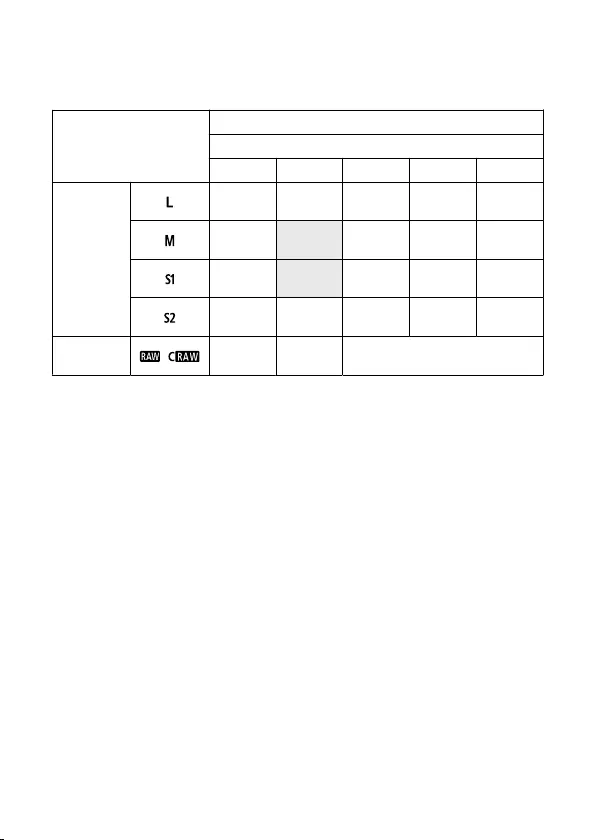
Still photo recording
Still photo pixel count
Image quality
Recorded pixels
Aspect ratio
3:2 1.6x (crop)*1 1:1 4:3 16:9
JPEG
HEIF
Approx. 44.8
megapixels
(8192×5464)
Approx. 17.3
megapixels
(5088×3392)
Approx. 29.8
megapixels
(5456×5456)
Approx. 39.8
megapixels
(7280×5464)
Approx. 37.7
megapixels
(8192×4608)
Approx. 22.5
megapixels
(5808×3872)
Approx. 15.0
megapixels
(3872×3872)
Approx. 19.9
megapixels
(5152×3872)
Approx. 19.0
megapixels
(5808×3264)
Approx. 11.6
megapixels
(4176×2784)
Approx. 7.8
megapixels
(2784×2784)
Approx. 10.3
megapixels
(3712×2784)
Approx. 9.8
megapixels
(4176×2344)
Approx. 3.8
megapixels
(2400×1600)
Approx. 3.8
megapixels
(2400×1600)
Approx. 2.6
megapixels
(1600×1600)
Approx. 3.4
megapixels
(2112×1600)
Approx. 3.2
megapixels
(2400×1344)
RAW /
Approx. 44.8
megapixels
(8192×5464)
Approx. 17.3
megapixels
(5088×3392)
Approx. 44.8 megapixels
(8192×5464)
* Values for recorded pixels are rounded off to the nearest 100,000th.
*RAW images are generated at 3:2, with information added about the specified aspect ratio, and JPEG
images are generated at the specified aspect ratio.
* 1: Angle of view of approx. 1.6 times the focal length.
899
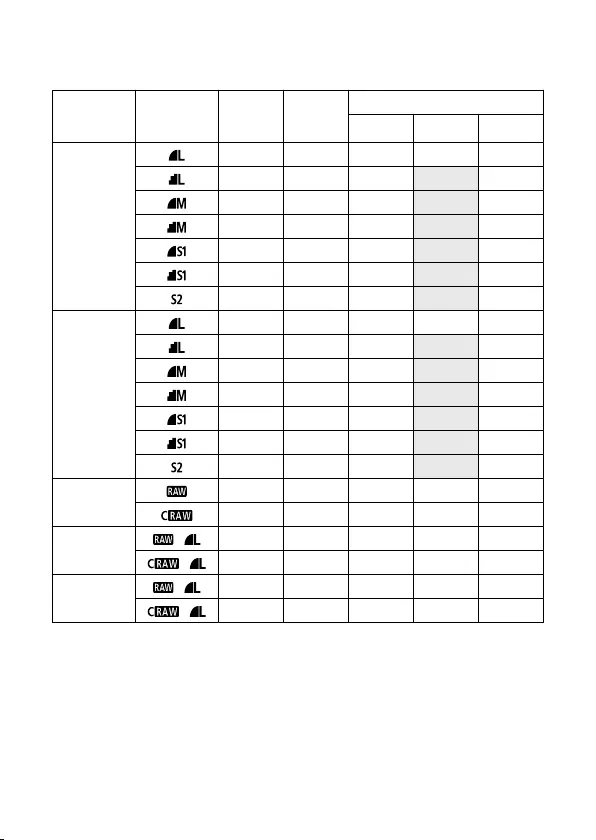
Still photo file size / Number of possible shots / Maximum burst for continuous
shooting
Image quality File size
[Approx. MB]
Possible
shots
[Approx.]*1
Maximum burst [Approx.]*5
SD card*1 SD card*1
[Hi-speed]
CFexpress
card*2
JPEG*4
13.5 2240 190 350 350
6.8 4450 260 350
7.8 3860 320 350
4.1 7330 290 350
4.7 6420 330 350
2.6 11360 330 350
1.8 16790 340 350
HEIF*3
13.4 2240 190 280 280
10.0 2970 210 330
8.3 3580 310 310
6.3 4730 350 360
5.1 5710 340 360
4.0 7330 360 350
1.8 14480 340 360
RAW*4
45.4 670 66 87 180
21.9 1440 130 260 260
RAW+JPEG*4
+ 45.4+13.5 520 64 79 160
+ 21.9+13.5 870 100 130 240
RAW+HEIF*3
+ 45.4+13.4 480 61 74 90
+ 21.9+13.4 780 110 140 140
* 1: The number of possible shots and maximum burst (SD card) apply to a UHS-I compliant 32 GB SD card
based on Canon testing standards. The number of possible shots and maximum burst (SD card [Hi-speed])
apply to a UHS-II compliant 32 GB SD card based on Canon testing standards.
*2: The number of shots available and maximum burst (CFexpress card) apply to a 325 GB CFexpress
card conforming to Canon testing standards.
* 3: Available when [HDR PQ] for HDR shooting is set to [Enable].
* 4: When [HDR PQ] for HDR shooting is set to [Disable].
* 5: With mechanical shutter or electronic 1st-curtain shutter, shot at approx. 12 fps.
* File size, number of possible shots, and maximum burst vary depending on shooting conditions (including
1.6x crop/aspect ratio, subject, memory card brand, ISO speed, Picture Style, and Custom Function).
900

Movie recording
Movie recording format: MP4, RAW
Estimated recording time, movie bit rate, and file size
Canon Log: Off, HDR PQ: Off
Movie recording size
Total recording time (Approx.) Movie bit
rate
(Approx.
Mbps)
File size
(Approx.
MB/min.)
64 GB 256 GB 1 TB
8K DCI
29.97 fps
25.00 fps
24.00 fps
23.98 fps
RAW 3 min. 13 min. 51 min. 2600 18668
ALL-I 6 min. 26 min. 1 hr. 42 min. 1300 9309
IPB 18 min. 1 hr. 12 min. 4 hr. 42 min. 470 3373
8K UHD
29.97 fps
25.00 fps
23.98 fps
ALL-I 6 min. 26 min. 1 hr. 42 min. 1300 9309
IPB 18 min. 1 hr. 12 min. 4 hr. 42 min. 470 3373
4K DCI 59.94 fps
50.00 fps
ALL-I 9 min. 36 min. 2 hr. 21 min. 940 6734
IPB 36 min. 2 hr. 27 min. 9 hr. 35 min. 230 1656
4K DCI
4K DCI Fine
29.97 fps
25.00 fps
24.00 fps
23.98 fps
ALL-I 18 min. 1 hr. 12 min. 4 hr. 42 min. 470 3373
IPB 1 hr. 10
min. 4 hr. 40 min. 18 hr. 17 min. 120 869
4K DCI 119.88 fps
100.00 fps ALL-I 4 min. 18 min. 1 hr. 10 min. 1880 13447
4K UHD 59.94 fps
50.00 fps
ALL-I 9 min. 36 min. 2 hr. 21 min. 940 6734
IPB 36 min. 2 hr. 27 min. 9 hr. 35 min. 230 1656
4K UHD
4K UHD Fine
29.97 fps
25.00 fps
23.98 fps
ALL-I 18 min. 1 hr. 12 min. 4 hr. 42 min. 470 3373
IPB 1 hr. 10
min. 4 hr. 40 min. 18 hr. 17 min. 120 869
4K UHD 119.88 fps
100.00 fps ALL-I 4 min. 18 min. 1 hr. 10 min. 1880 13447
Full HD
59.94 fps
50.00 fps
ALL-I 47 min. 3 hr. 8 min. 12 hr. 14 min. 180 1298
IPB 2 hr. 18
min. 9 hr. 14 min. 36 hr. 6 min. 60 440
29.97 fps
25.00 fps
23.98 fps
ALL-I 1 hr. 33
min. 6 hr. 12 min. 24 hr. 16 min. 90 655
IPB 4 hr. 30
min. 18 hr. 2 min. 70 hr. 27 min. 30 226
29.97 fps
25.00 fps
IPB
(Light)
11 hr. 35
min.
46 hr. 23
min.
181 hr. 13
min. 12 88
Time-lapse
movies
8K
29.97 fps
25.00 fps ALL-I
6 min. 26 min. 1 hr. 42 min. 1300 9298
4K 18 min. 1 hr. 12 min. 4 hr. 43 min. 470 3362
Full HD 1 hr. 34
min. 6 hr. 19 min. 24 hr. 41 min. 90 644
901

Canon Log: On or HDR PQ: On
Movie recording size
Total recording time (Approx.) Movie bit
rate
(Approx.
Mbps)
File size
(Approx.
MB/min.)
64 GB 256 GB 1 TB
8K DCI
29.97 fps
25.00 fps
24.00 fps
23.98 fps
RAW 3 min. 13 min. 51 min. 2600 18668
ALL-I 6 min. 26 min. 1 hr. 42 min. 1300 9309
IPB 12 min. 50 min. 3 hr. 15 min. 680 4875
8K UHD
29.97 fps
25.00 fps
23.98 fps
ALL-I 6 min. 26 min. 1 hr. 42 min. 1300 9309
IPB 12 min. 50 min. 3 hr. 15 min. 680 4875
4K DCI 59.94 fps
50.00 fps
ALL-I 8 min. 34 min. 2 hr. 13 min. 1000 7164
IPB 24 min. 1 hr. 39 min. 6 hr. 30 min. 340 2443
4K DCI
4K DCI Fine
29.97 fps
25.00 fps
24.00 fps
23.98 fps
ALL-I 18 min. 1 hr. 12 min. 4 hr. 42 min. 470 3373
IPB 49 min. 3 hr. 18 min. 12 hr. 57 min. 170 1227
4K DCI 119.88 fps
100.00 fps ALL-I 4 min. 18 min. 1 hr. 10 min. 1880 13447
4K UHD 59.94 fps
50.00 fps
ALL-I 8 min. 34 min. 2 hr. 13 min. 1000 7164
IPB 24 min. 1 hr. 39 min. 6 hr. 30 min. 340 2443
4K UHD
4K UHD Fine
29.97 fps
25.00 fps
23.98 fps
ALL-I 18 min. 1 hr. 12 min. 4 hr. 42 min. 470 3373
IPB 49 min. 3 hr. 18 min. 12 hr. 57 min. 170 1227
4K UHD 119.88 fps
100.00 fps ALL-I 4 min. 18 min. 1 hr. 10 min. 1880 13447
Full HD
59.94 fps
50.00 fps
ALL-I 36 min. 2 hr. 27 min. 9 hr. 35 min. 230 1656
IPB 1 hr. 33
min. 6 hr. 12 min. 24 hr. 16 min. 90 655
29.97 fps
25.00 fps
23.98 fps
ALL-I 1 hr. 2
min. 4 hr. 9 min. 16 hr. 16 min. 135 977
IPB 3 hr. 3
min.
12 hr. 13
min. 47 hr. 45 min. 45 333
29.97 fps
25.00 fps
IPB
(Light)
5 hr. 1
min. 20 hr. 7 min. 78 hr. 37 min. 28 202
Time-lapse
movies
8K
29.97 fps
25.00 fps ALL-I
6 min. 26 min. 1 hr. 42 min. 1300 9298
4K 18 min. 1 hr. 12 min. 4 hr. 43 min. 470 3362
Full HD 1 hr. 3
min. 4 hr. 12 min. 16 hr. 27 min. 135 966
* Bit rate indicates video output only, audio is not included.
*Movie recording is interrupted if the maximum recording time per movie, 29 min. 59 sec., is exceeded.
(Time is different for High Frame Rate movies.)
* 8K movie recording (RAW, DCI, UHD) has restrictions on possible recording time due to the temperature
rise. Max possible recording time is approx. 20 min. (at room temperature).
* 4K 60 p movie cropped recording has restrictions on possible recording time due to the temperature rise.
Max possible recording time is approx. 25 min. (at room temperature).
902

* Sound is not recorded for approx. the last two frames when the compression method for movie recording
quality is IPB or IPB Light (audio: AAC) or [ :Audio compression] is set to [Enable]. Moreover, the
video and sound may be slightly out of sync when movies are played back in Windows.
903

Card performance requirements (Movie recording) [Write/read speed]
Movie recording size
CFexpress card SD card
8bit / 10bit 8 bit 10 bit
8K
8K RAW RAW
Refer to the
Canon website
—
8K
ALL-I —
IPB
Video Speed
Class 60 or
higher
Video Speed
Class 90 or
higher
4K
119.88 fps
100.00 fps ALL-I —
59.94 fps
50.00 fps
ALL-I —
IPB
Video Speed
Class 30 or
higher
Video Speed
Class 60 or
higher
Other than above
ALL-I
Video Speed
Class 60 or
higher
Video Speed
Class 60 or
higher
IPB UHS Speed
Class 3 or higher
UHS Speed
Class 3 or higher
Full HD
59.94 fps
50.00 fps
ALL-I UHS Speed
Class 3 or higher
UHS Speed
Class 3 or higher
IPB SD Speed Class
10 or higher
UHS Speed
Class 3 or higher
Other than above
ALL-I UHS Speed
Class 3 or higher
UHS Speed
Class 3 or higher
IPB SD Speed Class
6 or higher
SD Speed Class
6 or higher
IPB (Light) SD Speed Class
4 or higher
SD Speed Class
4 or higher
Time-lapse
movies
8K
ALL-I
—
4K
Video Speed
Class 60 or
higher
Video Speed
Class 60 or
higher
Full HD UHS Speed
Class 3 or higher
UHS Speed
Class 3 or higher
* With Movie cropping set to [Disable], Movie digital IS set to [Off].
904

Built-in and external microphones
Built-in microphone: Monaural microphone
External microphone: 3.5 mm diameter stereo mini jack
Recording media
Recording media:
CFexpress card
SD card
* Compatible with UHS-II
Viewfinder
Type: OLED color electronic viewfinder
Screen size: 0.5 inch
Dot count: Approx. 5,760,000 dots
Magnification / angle of view: Approx. 0.76× / Approx. 35.5° (with 50 mm lens at infinity, –
1 m–1)
Coverage: Approx. 100% (at L image quality, an aspect ratio of 3:2, and approx. 23 mm
eyepoint)
Eyepoint: Approx. 23 mm (at –1 m–1 from eyepiece lens end)
Dioptric adjustment: Approx. –4.0 to +2.0 m–1 (dpt)
Screen
Type: TFT color, liquid-crystal monitor
Screen size: 3.2 inch (Screen aspect ratio of 3:2)
Dot count: Approx. 2,100,000 dots
Angle of view: Approx. 170° vertically and horizontally
Coverage: Approx. 100% vertically and horizontally (at L image quality and an aspect ratio
of 3:2)
Brightness adjustment: Possible (7 levels)
Color tone adjustment: Warm tone / Standard / Cool tone 1 / Cool tone 2
Touch-screen: Capacitive sensing
LCD panel
Type: Reflective memory LCD
Display format: Dot-matrix display
Dot count: 128×128 dots
HDMI output
HDMI video / audio output: HDMI micro OUT terminal (Type D) / CEC not supported
HDMI output resolution: Auto / 1080p
* HDMI output of 8K movies not supported.
905

Autofocus
Focusing method: Dual Pixel CMOS AF
Focusing operation
Still photo shooting Movie recording
AF operation
One-Shot AF
Servo AF
(AI Focus AF)
*Set automatically in A+ mode
One-Shot AF
Movie Servo AF
Manual focus Supported Supported
Lens compatibility based on AF area: Refer to the Canon website
Number of AF zones available for automatic selection
AF area Horizontal: Approx. 100%, Vertical: Approx. 100%
Number of AF
zone
Still photos Max. 1053 zones (39×27)
Movies Max. 819 zones (39×21)
* May vary depending on settings.
Selectable positions for AF point
AF area Horizontal: Approx. 90%, Vertical: Approx. 100%
Number of
positions
Still photos Max. 5940 positions (90×66)
Movies Max. 4500 positions (90×50)
* When selected using the Multi-controller.
Focusing brightness range (in still photo shooting): EV –6 to 20 (With an f/1.2 lens*,
center AF point, One-Shot AF, at 23°C / 73°F, ISO 100)
*Except RF lenses with a Defocus Smoothing (DS) coating
Focusing brightness range (in movie recording)
8K EV –3 to 20 * With an f/1.2 lens, center AF point, One-
Shot AF, at 23°C / 73°F, ISO 100.
*Except RF lenses with a Defocus
Smoothing (DS) coating.
4K/Full HD EV –4 to 20
906

Exposure control
Metering functions under various shooting conditions
Item Still photo shooting Movie recording
Metering sensor 384 zone (24×16) metering using image sensor output signals
Metering mode
Evaluative
metering Yes
Yes
*When faces are detected with [
+Tracking]
Partial metering Yes: (Approx. 6.1%) of the screen
Spot metering Yes: (Approx. 3.1%) of the screen
Center-weighted
average Yes Yes
*When no faces are detected
Metering brightness range (At
23°C / 73°F, ISO 100) EV –3 to 20 EV –1 to 20
ISO speed (recommended exposure index) in still photo shooting
Manually set ISO speed in still photo shooting
Normal ISO speed ISO 100–51200 (in 1/3-stop, 1-stop increments)
Expanded ISO speed (equivalent) L (50)
H (102400)
* For [ :Highlight tone priority], the available ISO speed range is ISO 200 to 51200.
*Expanded ISO cannot be set for HDR mode or during HDR PQ shooting.
ISO speed range settings in still photo shooting
ISO speed range ISO speed
Minimum L (50)–51200 (in 1-stop increments)
Maximum ISO 100–H (102400) (in 1-stop increments)
* Expanded ISO speeds are noted as being “equivalent” to these speeds.
ISO Auto range settings in still photo shooting
Auto range ISO speed
Minimum ISO 100–25600 (in 1-stop increments)
Maximum ISO 200–51200 (in 1-stop increments)
907
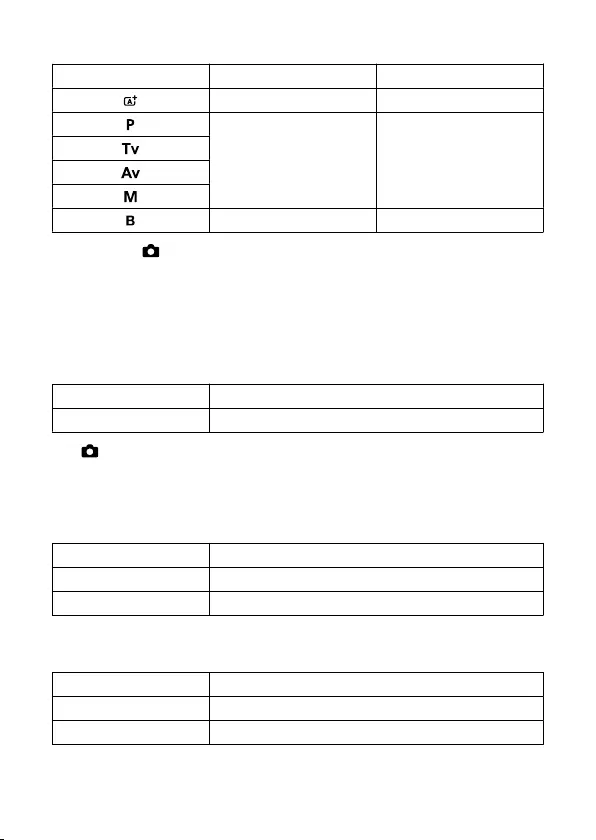
ISO Auto details in still photo shooting
Shooting mode No flash Using flash
ISO 100–12800 ISO 100–6400*3
ISO 100*1*2–51200*2 ISO 100*1*2–6400*2*3
ISO 400*4 ISO 400*4
* 1: ISO 200 when [ :Highlight tone priority] is set to [Enable] or [Enhanced].
*2: Varies depending on [Maximum] and [Minimum] of [Auto range].
* 3: ISO 1600 when using a lens that is not compatible with “Variable control of maximum ISO Auto limit for
E-TTL”.
* 4: If outside the setting range, changed to the value most close to ISO 400.
Variable control of maximum ISO Auto limit for E-TTL: Supported
ISO speed for movie recording
Manually set ISO speed in movie recording
Normal ISO speed ISO 100–25600 (in 1/3-stop, 1-stop increments)
Expanded ISO speed (equivalent) H (51200)
* For [ :Highlight tone priority], the available ISO speed range is ISO 200 to 25600.
*Expanded ISO cannot be set during RAW movie recording.
* Cannot be manually set below ISO 400 for RAW movies when Canon Log is specified.
* Expanded ISO cannot be set during HDR PQ movie recording.
* Cannot be manually set above ISO 12800 for High Frame Rate movies.
ISO speed range settings in movie recording
ISO speed range ISO speed
Minimum ISO 100–25600 (in 1-stop increments)
Maximum ISO 100–H (51200) (in 1-stop increments)
* Expanded ISO speeds are noted as being “equivalent” to these speeds.
ISO Auto range settings in movie recording
Item ISO speed
Max for Auto ISO 6400–H (51200)
(Time-lapse movie) Max for Auto ISO 400–25600
* Expanded ISO speeds are noted as being “equivalent” to these speeds.
908

Shutter
Still photo shooting
Type: Electronically controlled focal-plane shutter
Shutter mode
Mechanical shutter
Electronic 1st curtain
Electronic shutter
Shutter speed
When [Mechanical] or [Elec. 1st-
curtain] is set 1/8000–30 sec., Bulb
When [Electronic] is set 1/8000–0.5 sec.
X-sync speed
Mechanical shutter 1/200 sec.
Elec. 1st-curtain 1/250 sec.
Movie recording
Type: Rolling shutter, using the image sensor
Shutter speed:
1/4000–1/25* sec.
* Varies by frame rate. For details, see exposure control details.
Movies with manual exposure / Tv mode recording: 1/4000–1/8* sec.
* Varies by shooting mode and frame rate.
* 1/125 sec. (NTSC) or 1/100 sec. (PAL) with [High Frame Rate] set to [Enable].
909

Image stabilization (IS mode): Provided
External flash
Sync contacts: Hot shoe: X-sync contact
*Max. flash sync speed: 1/250 sec. with elec. 1st-curtain, 1/200 sec. with mechanical shutter.
Drive
Drive mode and continuous shooting speed
Drive modes Mechanical shutter Electronic 1st curtain Electronic shutter
Single shooting Yes Yes Yes
High-speed continuous shooting+ Max. approx. 12 shots/sec.
Max. approx. 20 shots/
sec.
*Lenses other than EF-S
lenses
High-speed continuous shooting Max. approx. 6.0 shots/
sec.
Max. approx. 8.0 shots/
sec.
Low-speed continuous shooting Max. approx. 3.0 shots/sec.
Self-timer:10 sec / remote control Yes
Self-timer:2 sec / remote control Yes
Playback
Item Still photo Movie
Magnify zoom display 1.5x–10x (15 levels)
AF point display Yes
Grid display Off / 3×3 / 6×4 / 3×3+diag
Rating
OFF / ★ to ★★★★★
Select images / Select range / All images in folder / All images on card / All
found images
Image search Search conditions
Rating / Date / Folder / Protect / Type of file
Protect Select images / Select range / All images in folder / Unprotect all images in
folder / All images on card / Unprotect all images on card / All found images
In-camera RAW image processing Supported
Resizing Supported
Cropping Supported
910

Frame grab from 8K / 4K movies
Individual frames in 8K / 4K movies recorded with the camera can be saved as JPEG still
photos*1.
8K
DCI Approx. 35.4 megapixels (8192×4320)
UHD Approx. 33.2 megapixels (7680×4320)
4K
DCI Approx. 8.8 megapixels (4096×2160)
UHD Approx. 8.3 megapixels (3840×2160)
* 1: From HDR PQ movies, saved in HEIF format.
*Extracted still photos cannot be resized or cropped within the camera.
* Frame grab is not available for movies recorded with [Canon Log] set to [On].
Print order (DPOF): Compliant with DPOF Version 1.1
Customization (C.Fn)
Custom Function: 22 Custom Functions are settable
External interface
Digital terminal
Terminal type: USB Type-C
Transmission: SuperSpeed Plus USB (USB 3.1 Gen 2) equivalent
Applications:
For computer communication
For in-camera charging / powering the camera with USB Power Adapter PD-E1
HDMI output terminal: HDMI micro OUT terminal (Type D)
External microphone input terminal: Compatible with the 3.5 mm diameter stereo mini
plug
Headphone terminal: Compatible with the 3.5 mm diameter stereo mini plug
Remote control terminal: N3 type terminal
911

Power source
Battery
Compatible battery packs LP-E6NH/LP-E6N/LP-E6
Quantity used 1
USB battery charging and camera power: Using USB Power Adapter PD-E1
AC power source
AC adapter AC-E6N
DC coupler DR-E6
Possible shots
Configuration Shooting method Battery Temperature
Battery life (Approx. number of shots)
Smooth Power saving
Camera body
only
Screen
LP-E6NH
23°C / 73°F 320 490
0°C / 32°F 310 470
Viewfinder
23°C / 73°F 220 320
0°C / 32°F 200 310
Eco mode
(Screen) 23°C / 73°F 550 700
Battery grip
BG-R10 used
Screen
Two LP-E6NH
batteries 23°C / 73°F — 970
One LP-E6NH
battery 23°C / 73°F — 480
Viewfinder Two LP-E6NH
batteries 23°C / 73°F — 640
Wireless File
Transmitter
WFT-R10 used
Screen One LP-E6NH
battery*1 23°C / 73°F — 480
Viewfinder One LP-E6NH
battery*1 23°C / 73°F — 310
* With fully charged batteries
*1: Used as a battery for the camera
912

Available operating time
Conditions of use Temperature Available operating
time
Time available for bulb exposure 23°C / 73°F Approx. 4 hr. 40 min.
Time available for Live View shooting 23°C / 73°F Approx. 3 hr. 50 min.
Time available for
movie recording
*Movie Servo AF:
Disable
8K RAW movies (29.97 fps)
23°C / 73°F Approx. 1 hr. 20 min.
0°C / 32°F Approx. 1 hr. 10 min.
8K DCI
IPB (Standard)
29.97 fps / 25.00 fps
23°C / 73°F Approx. 1 hr. 10 min.
Full HD
23°C / 73°F Approx. 2 hr. 20 min.
0°C / 32°F Approx. 2 hr. 10 min.
Time available for
Time-lapse movie
shooting
Full HD, shooting
interval: 5 sec.
Screen: On 23°C / 73°F Approx. 5 hr. 10 min.
Screen: Off 23°C / 73°F Approx. 6 hr. 40 min.
Time available for
continuous playback Movies (Normal playback) 23°C / 73°F Approx. 2 hr. 50 min.
* With a fully charged LP-E6NH
Battery information
Remaining capacity In 1% increments
5-level indicator
Number of shots Supported
Recharge performance 3 levels
Battery registrations Supported (up to 6)
Battery information Serial number, remaining capacity when removed, date
913

Dimensions and weight
Dimensions
(W)×(H)×(D) Approx. 138.5×97.5×88.0 mm
(W)×(H)×(D) Approx. 5.45×3.84×3.46 in.
* Based on CIPA guidelines.
Weight
Body (including battery and memory
card) Approx. 738 g Approx. 26.03 oz.
Body only Approx. 650 g Approx. 22.93 oz.
* Weighed without body cap.
Operating environment
Operating temperature: 0–+40°C / 32–104°F
Operating humidity: 85% or less
914

Wi-Fi (Wireless LAN) communication
Compliance standards
Wi-Fi compliance standards Transmission method Maximum link speed
IEEE802.11b DS-SS modulation 11 Mbps
IEEE802.11g
OFDM modulation
54 Mbps
IEEE802.11n 72.2 Mbps
IEEE802.11a 54 Mbps
IEEE802.11ac 86.7/200/433.3 Mbps
Transmission frequency (Center frequency)
2.4 GHz band
Frequency 2412 to 2462 MHz
Channels 1 to 11 ch
* Specifications vary by country/region.
5 GHz band
Frequency 5180 to 5825 MHz
Channels 36 to 165 ch
* Specifications vary by country/region.
Authentication and data encryption methods
Connection method Authentication Encryption
Camera access point
WPA2-PSK AES
Open Disable
Infrastructure
Open
WEP
Disable
Shared key WEP
WPA-PSK TKIP
AES
WPA2-PSK
915

Bluetooth
Compliance standards: Bluetooth Specification Version 5.0 compliant (Bluetooth Low
Energy technology)
Transmission method: GFSK modulation
All data above is based on Canon testing standards and CIPA (Camera & Imaging
Products Association) testing standards and guidelines.
Dimensions and weight listed above are based on CIPA Guidelines (except weight for
camera body only).
Product specifications and appearance are subject to change without notice.
If a problem occurs with a non-Canon lens attached to the camera, contact the
respective lens manufacturer.
916

Trademarks and Licensing
Trademarks
About MPEG-4 Licensing
Accessories
Trademarks
Adobe is a trademark of Adobe Systems Incorporated.
Microsoft and Windows are trademarks or registered trademarks of Microsoft
Corporation in the United States and/or other countries.
App Store and macOS are trademarks of Apple Inc., registered in the U.S. and other
countries.
Google Play and Android are trademarks of Google LLC.
IOS is a trademark or registered trademark of Cisco in the U.S. and other countries and
is used under license.
QR Code is a trademark of Denso Wave Inc.
HDMI, HDMI logo, and High-Definition Multimedia Interface are trademarks or registered
trademarks of HDMI Licensing LLC.
The Wi-Fi CERTIFIED logo and the Wi-Fi Protected Setup mark are trademarks of the
Wi-Fi Alliance.
The Bluetooth® word mark and logos are registered trademarks owned by Bluetooth
SIG, Inc. and any use of such marks by Canon Inc. is under license. Other trademarks
and trade names are those of their respective owners.
All other trademarks are the property of their respective owners.
917

About MPEG-4 Licensing
“This product is licensed under AT&T patents for the MPEG-4 standard and may be used for
encoding MPEG-4 compliant video and/or decoding MPEG-4 compliant video that was
encoded only (1) for a personal and non-commercial purpose or (2) by a video provider
licensed under the AT&T patents to provide MPEG-4 compliant video. No license is granted
or implied for any other use for MPEG-4 standard.”
THIS PRODUCT IS LICENSED UNDER THE AVC PATENT PORTFOLIO LICENSE FOR
THE PERSONAL USE OF A CONSUMER OR OTHER USES IN WHICH IT DOES NOT
RECEIVE REMUNERATION TO (i) ENCODE VIDEO IN COMPLIANCE WITH THE AVC
STANDARD (''AVC VIDEO'') AND/OR (ii) DECODE AVC VIDEO THAT WAS ENCODED BY
A CONSUMER ENGAGED IN A PERSONAL ACTIVITY AND/OR WAS OBTAINED FROM
A VIDEO PROVIDER LICENSED TO PROVIDE AVC VIDEO. NO LICENSE IS GRANTED
OR SHALL BE IMPLIED FOR ANY OTHER USE. ADDITIONAL INFORMATION MAY BE
OBTAINED FROM MPEG LA, L.L.C. SEE HTTP://WWW.MPEGLA.COM
*Notice displayed in English as required.
918

Accessories
Use of genuine Canon accessories is recommended
This product is designed to achieve optimum performance when used with genuine Canon
accessories. Therefore, using this product with genuine accessories is highly recommended.
Canon shall not be liable for any damage to this product and/or accidents such as
malfunction, fire, etc. caused by the failure of non-genuine Canon accessories (e.g., a
leakage and/or explosion of a battery). Please note that repairs arising out of the malfunction
of non-genuine accessories will not be covered by the warranty for repairs, although you
may request such repairs on a chargeable basis.
Caution
Battery Pack LP-E6NH is dedicated to Canon products only. Using it with an
incompatible battery charger or product may result in malfunction or accidents for
which Canon cannot be held liable.
919

















































